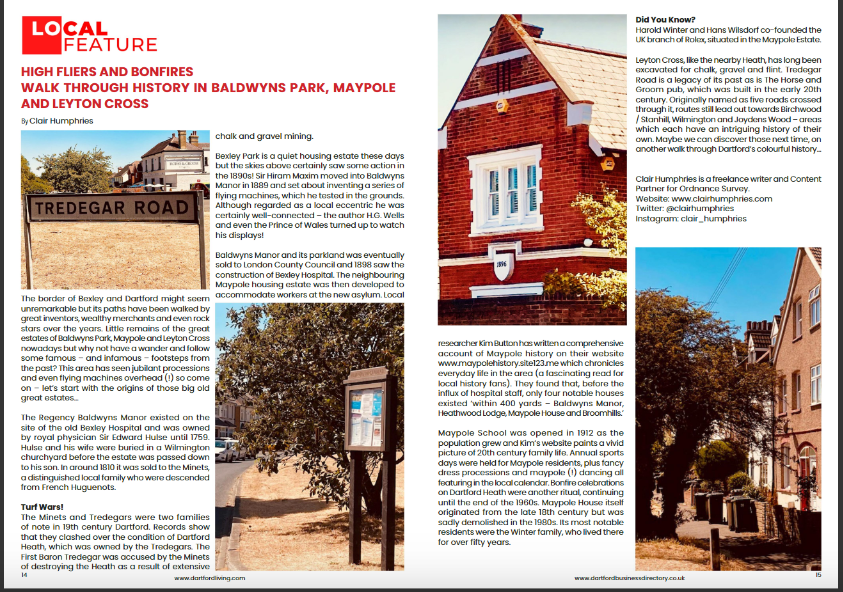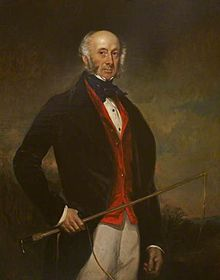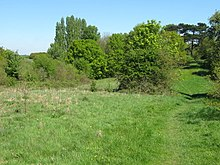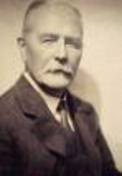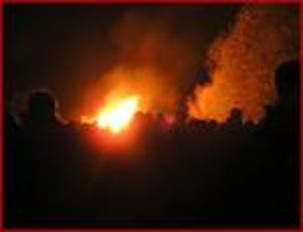Maypolehistory
The history of the area known as Maypole Estate, Dartford Heath - and surrounding areas including Joydens Wood, Wilmington, Leyton Cross, Wansunt and Coldblow.
Here you will find many historical facts about the area.
The construction / migration from an original site http://maypolehistory.wikifoundry.com was nearly complete. That site has now been decommissioned by the providers.
Last updated 4th September 2025 - Lee Smith - additional info re growing up on Maypole.
Contact us on maypoleontheweb2@aol.co.uk. (Go to the E Mail symbol top right for a link)
We are also on Facebook https://www.facebook.com/groups/1992
About Us
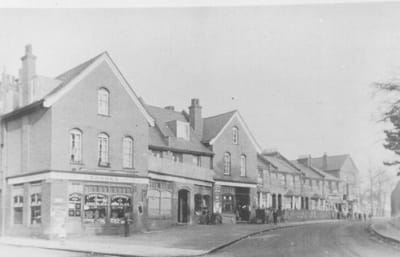
My research has been ongoing for over 30 years. I am delighted that you have found this website. By all means use any information you find here and on my original site that is useful to you. That is the main purpose of my labours. If you want to straight copy and paste anything on to another website / article / document then please, all we ask is that you acknowledge the origin.
Contact us on maypoleontheweb2@aol.co.uk
Kim Button
In memory of my Maypolian childhood friends who are no longer with us - David and Chris Richardson, Peter Garman, Michael Morand, Malcolm Knight, Peter Walker, Gary Jewel, Alan Gregory and Lawrence Andrews.
Content Page
PAGES
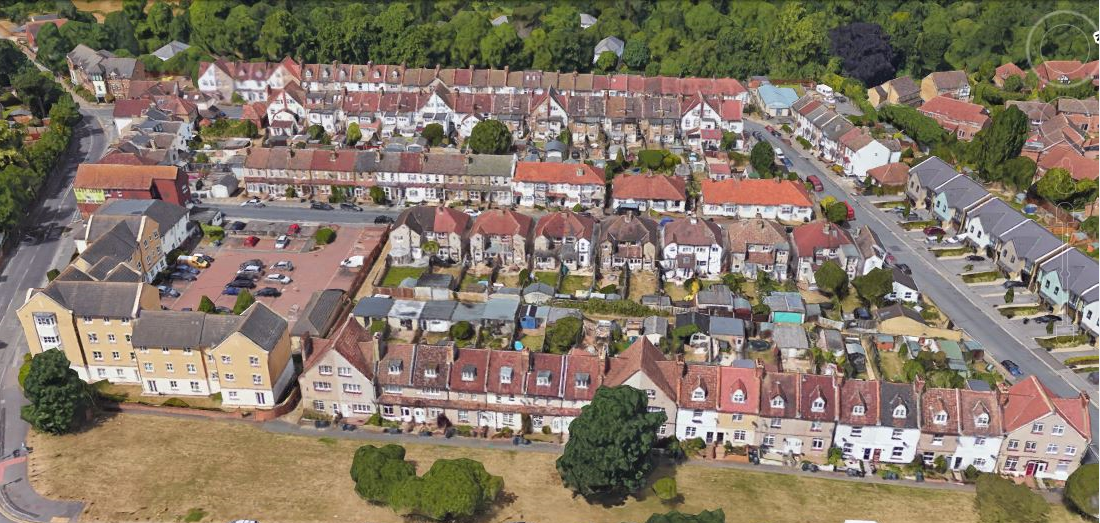
Dartford Living Magazine - September 2022 - Maypole Featured
Geographical area and time scale of research
Memories from those who lived in Bygone times in the Maypole area - under reconstruction and 95% complete.
The Roman settlement in Joydens Wood
Sir Hiram Stevens Maxim and his flying machine
Bowmans Lodge and the Royal Society of Kentish Bowmen
Dartford Heath and Leyton Cross
Confrontation on Dartford Heath, March 1st. 1452
Dartford Heath - Gruesome Goings on - murder, death and foul play
Dartford Heath photos from 'Maypole Chippy' 1969
Maypole House - memories of Janet Cushion Nee Winter
Broomhills and Grosvenor Cottage
Heathwood Lodge, Dartford Heath
The early Maypole Housing Estate
The annual children's procession and Sports Day
Maypole School - details of many pupils from 1913 to the 1960s have now been added
Airship Disaster R38 and a Maypole man killed
Charlie Lawrence died as a P.O.W. - a black boy
Elsey Fish and Chip Shop - Dartford Road
Rolex watch factory - Heathend Road
Photo's - transport if a bygone age
Photo's - the journey from Bexley village
Memories of 'Old Maypolians' - under reconstruction - 12th October 2021
Joydens Wood - memories of Bill Young
Joydens Wood - Silver Birch Close
Joydens Wood - Birchwood Drive
Joydens Wood - Joydens Wood Road
Joydens Wood - the Summerhouse
The Bexley Covenantors - by Richard Wight
Dartford living september 2022 - Maypole feature
Dene Holes
Dene Holes
Many deep narrow shafts dug in the chalk soil have been found over much of the South East of England, including that land inhabited by the Cassii. These are commonly known as 'Dene Holes'. This name is believed to have come from the Saxon 'Deon Tigh' - Harvest Home. As the name suggests, and for many years, it was believed that these holes were dug for the purpose of storing gathered grain crops. Legend carried a suggestion that the Dene Holes would have been filled with the supervision of Druids and, according to their way, possibly at night time and with 'much ritual'. It can be understood why this romantic legend was perpetuated !
A publication written by R. F. Le GEAR dated 1992 establishes the real reason for these holes. The purpose was for extracting the chalk that lay beneath and under the Thames Sand. The holes date from before Roman times and were mined right up until the turn of the 20th century. The earth under the fields was known to be acidic. Since before Roman times it has been known that chalk is alkaline. The spreading of the chalk on to fields - known as 'chalking' or 'marling' - replacing the calcium lost through rainfall - fertilised and made the earth 'sweeter'. The holes were dug beside fields where the chalk could be easiest used. That is why there are collective groups of them.
Chalk also had other uses viz.; building purposes ( footings ), burning to form lime for lime mortar and repairing roads. R. F. LeGEAR describes that the Dene hole method of obtaining chalk had much to recommend it. A small shaft at the edge of a field would not require the removal of a large area of overburden as in open cast mining, and the shaft would not interfere with farming operations and could easily be blocked off when mining ceased. He goes on to say that a question that the reader could ask is .... " why dig a shaft say 50ft deep when the chalk occurs near the surface a few hundred yards away ?..." The answer is that the chalk was probably on someone else's land. Also the farmers preferred chalk from a depth claiming it was 'fatter'. This has some truth as chalk near the surface has certain associated elements leached out. The most common way of sealing an exhausted Dene hole was to throw a bush or tree stump down the neck of the hole and then fill with earth etc.
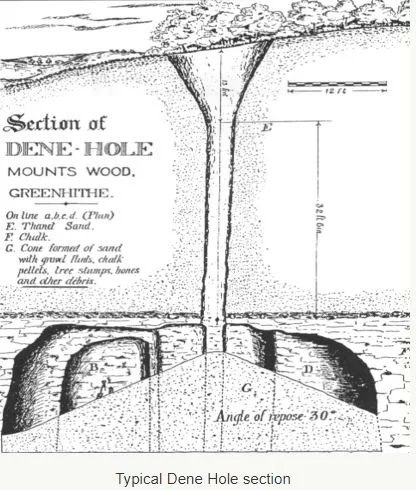
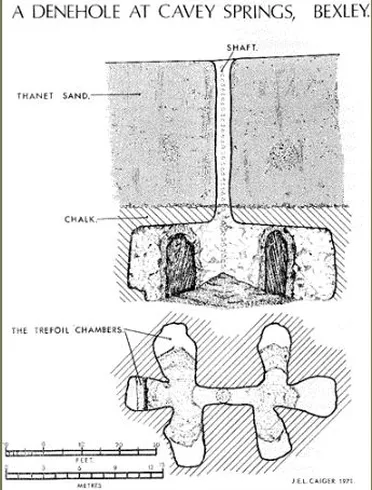
As years have gone by the wood has rotted and the fill material has fallen to the chambers below leaving a dangerous gaping hole. These chasms still appear from time to time and make the local news. Gravel and sand lie under Dartford Heath therefore, apart from a couple of them found near Crayford, no Dene Holes exist there.
Celts, Romans and more
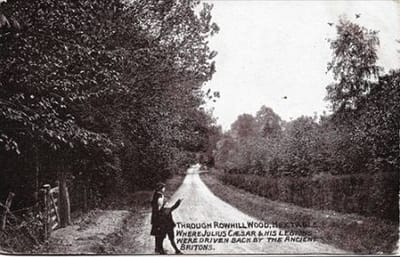
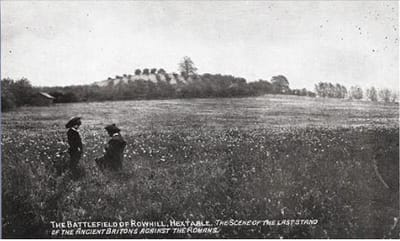
" The city of the Cassii was somewhat in the shape of an irregular triangle, and commenced at the southern point at Stanhill, in the Parish of DARTFORD, and extended directly north westward to Stankey"
( STANKEY was the name for an area occupying the land situated at the junction of DARTFORD Road and Baldwyns Park, and is referred to as such in the Ordnance Survey Map of 1869. ) The most common building material at that time would have been what is now referred to as 'Bio degradable' i.e. wood, mud, wattle, straw etc. As a result, there is nothing obvious to indicate its' original site and existence. The common Celtic house was round with a huge conical roof. The floor might have been of neat clay, the roof made of wood covered in thatch. The short walls would have been of wattle. The Celts were believers in settling in wooded areas , fencing off the outside and then erecting their houses and animal pens within. The Greek geographer STRABO referring to these 'Towns' (or 'Oppida' as Caesar named them) described them thus:
" Forest thickets are their 'cities'. They fence round a wide clearing with felled trees and here they make themselves huts and keep their cattle "
Julius Caesar led his second invasion to Britain in 54 BC and, in this area, (according to local historian DUNKIN) made an advance as far as RUE HILL (ROWHILL).
" Rue Hill is evidently a corruption of the Celtic word ' Tyrru' "
This hill still stands high and proud along Rowhill Road - just to the east of Birchwood Road between Hook Green Lane and Puddledock Lane. Legend has it that it is thanks to CASWALLEN that this was the highest point in the area - for it is purported that this natural mound was enlarged and heightened by his people. (The Ordnance Survey map of 1883 confirms a British Camp existed at this location). This then, by some form of weak definition was a Hill Fort. Legend also has it that CAESAR attacked and defeated CASWALLEN (or part of his tribe) and made his own camp at ROWHILL. CASWALLEN regrouped and within a day or so counter attacked and successfully drove off the Romans. This may be another way of saying the Romans decided they had had eoughof Wilmington and decided to march somewhere else !
The below describes an ancient British Road that still runs through Joydens Wood and which is still in evidence today. It describes at least two fortresses of this city of CASWALLEN, namely TYRRU and STANKEY. One could not be blamed for assuming that there was also another fortress at its' most southerly corner, forming a triangle of defence, at STANHILL. DUNKIN describes thus:
" The great road continued over hill and dale to the city of Cassii, which it entered at the south eastern extremity ( Stanhill ) : and by Caudens Wood ( Joydens Wood ? ) proceeded to North Cray, Prior to its' entrance it threw off two branches, one to the chief fortress, Tyrru and another to Stankey, the extreme northern point of the city "
Mike Still writes -
Cassivellaunus’ stronghold was approached after the Romans had crossed the Thames and these days it is more often associated with sites at Wheathampstead or Hexton, both in Hertfordshire, although its precise location is still unknown.
The Cassivellaunus episode is from the second of Julius Caesar’s two punitive expeditions of 55 and 54BC whereas the real Roman conquest by Claudius was in AD43. The only known local action at that time was the forced crossing of the Medway apparently followed by the attack on Colchester. This is assuming that you accept the usual story that they landed at Richborough whereas some people now say that they might have landed in a friendly area near Chichester and then advanced through Sussex before reaching Colchester! For Kent-wide information on the adaptation of the locals following the conquest there is ‘The Cantiaci’ by Alec Detsicas. For local Iron Age archaeology you could look at Dartford District Archaeological Group’s ‘Under Your Feet’.
The road named Baldwyns Park, and now on the site of Stankey Wood, was built c1927. I am told that just prior to this development this 'road' was a single track leading towards the thatched, six sided cottage in Tile Kiln Lane. ( A previous name for Tile Kiln Lane was Pot Kiln Lane
Further reading on the specific area of Leyton Cross can be found here https://www.wikizero.com/en/Leyton_Cross.
The Roman settlement in Joydens Wood
Roman settlement in Joydens Wood
Courtesy of the Joydens Wood Remembered Group on Facebook - Rhona Lee
This is a plan of the excavations of the Roman Settlement in JW which took place between 1951 and 1953 and which was situated at the lower end of what is now Spurrell Avenue and Bankside. As can be seen there was a large bank along one side ... maybe this was how Bankside Close got its name. Bankside Close was known as Roman Camp before it was officially named (thanks Bella Smith for that last interesting fact)
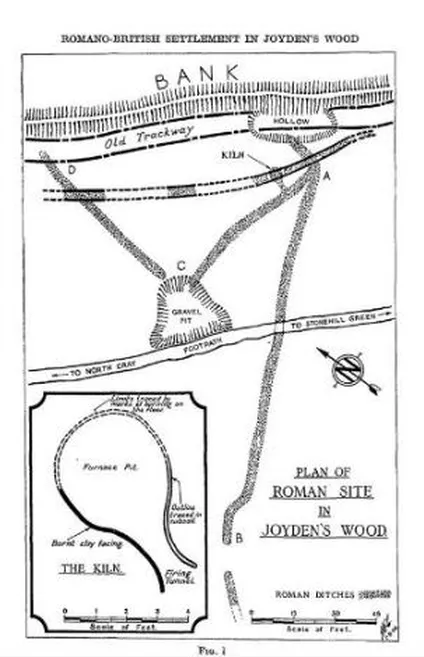
Baldwyns Manor
Below maps - courtesy of Facebook Bexley Borough The Bygone Years - 1799 showing Baldwyns and surrounding areas.....
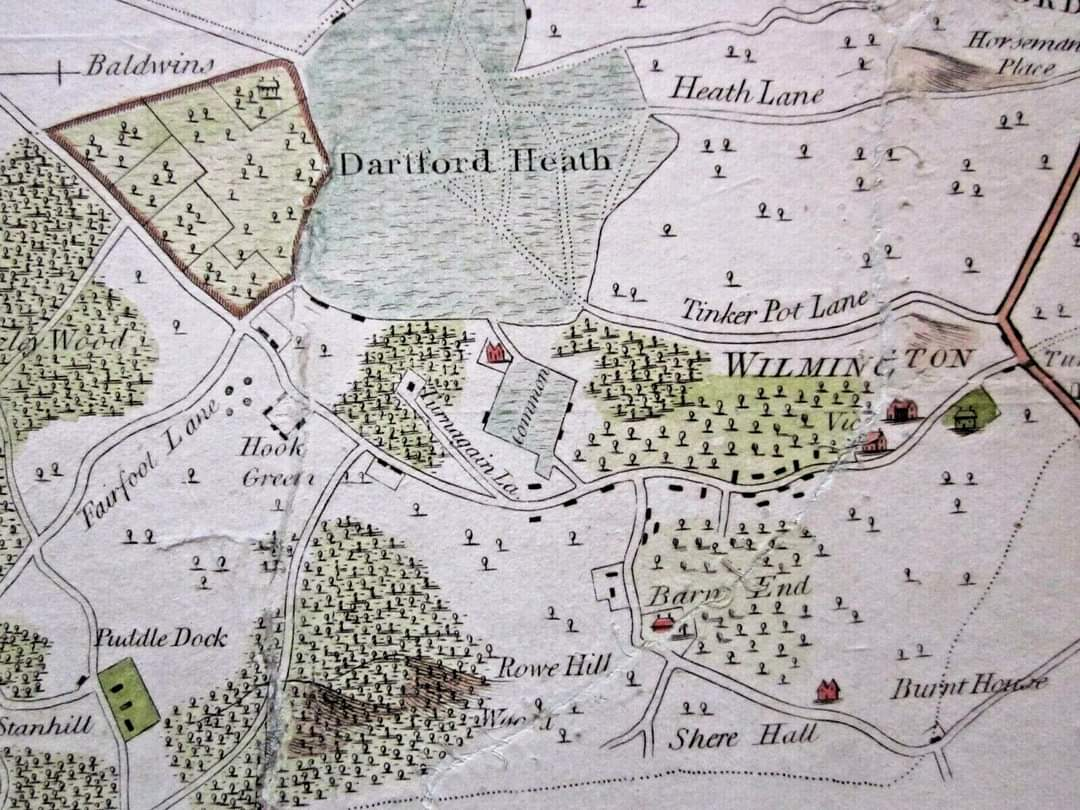
 Below map dated 1799 - courtesy of the British Library - showing Baldwins Manor House
Below map dated 1799 - courtesy of the British Library - showing Baldwins Manor House

Below - OS Map1800s - courtesy 'A Vision of Britain through time'
www.visionofbritain.org.uk/
![[Untitled] [Untitled]](https://static.s123-cdn-static-c.com/uploads/1523176/2000_5badf12036618.jpg)
Below - Baldwyns Manor c1894 showing the rails on which Sir Hiram Maxim's aeroplane once ran
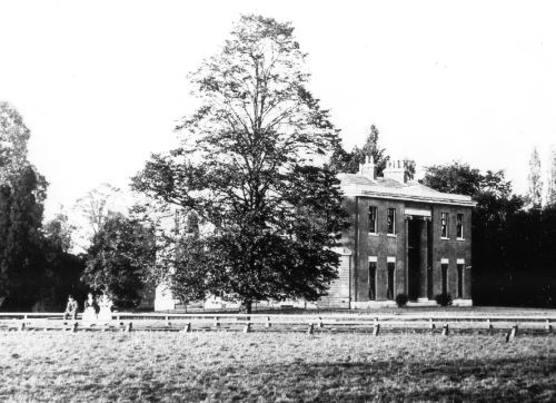
Baldwyns Manor now stands in Calvert Drive in the new Bexley Park. The original building has now been converted into a multi occupancy residence. The renovations have been sympathetic and the building still retains its Regency appearance. This has been the family seat and residence of some heavyweight occupants.
Records as far back as the reign of King John (c 1200) show that some of the lands in the locality, including those of Baldwyns Manor (The site of where Bexley Hospital once stood) were possessed by the Abbots of Lesnes (Erith / Belvedere area). The name BALDWYNS appears to originate from one of it's early owners - Sir John BAUDE and the adoption of the name BAUDIWINS. However, little appears to be known of the man himself.
Taken fromThe History and Topographical Survey of the County of Kent: Volume 2
Author Edward Hasted
Year published 1797
Pages 286-328
'Parishes: Dartford', The History and Topographical Survey of the County of Kent: Volume 2 (1797)
"BALDWINS is a seat and reputed manor, situated at the extremity of this parish, at the south-west corner of Dartford heath. This place was antiently in the possession of Sir John Baude, a man of an honorable family in this kingdom, of whom it acquired the name of Baudiwins, which it keeps at present, the difference of the language of the times only excepted. This place afterwards came into the possession of the abbot and convent of Lesnes, who were possessed of lands in this parish as early as king John's reign; (fn. 41) they in the 1st year of king Henry VIII. held it with other lands adjoining, of the manor of Temple Dartford, by the yearly rent of 2s. 5d. and fuit of court.
In the 16th year of king Henry VIII. on the suppression of this abbey, the revenues of it were granted to cardinal Wolsey, for the better endowment of his college, vulgarly called Cardinal college, in Oxford. But four years afterwards, when the cardinal was cast in a præmunire, this, among the other estates of that college, which for want of time had not been firmly settled on it, were forfeited to the king, and became part of the royal revenue, where it did not continue long; for that king, in his 23d year, granted it, by the name of the manor of Baudwyns, and other lands and premises thereto belonging, in exchange for other lands, to Eton college, near Windsor, to which the inheritance of this seat and manor now belongs. (fn. 42)
The Adams's were formerly lesses of this estate under the college, it was afterwards held by Lovelace, and then by Sir Edward Hulse, bart. who being eminently distinguished in his prosession, as a physician, was so created in 1739. He was the eldest son of Edward Hulse, M. D. by Dorothy, daughter of Thomas Westrow, esq. and married Elizabeth, daughter of Sir Richard Levett, lord mayor in 1700, by her he had three sons, Edward, who succeeded him in title, and settled in Hampshire; Westrow, who died before him; and Richard, of whom further mention will be made hereafter; and a daughter Elizabeth, married to John Calvert, esq. of Hertfordshire. Several years before his death he retired to Baldwins, where he died in 1759, and was buried in Wilmington church-yard, bearing for his arms, Argent 3 piles, one issuing from the chief between the others reversed sable, being the arms likewise of the families of this name in Cheshire, Kent and Berkshire. At his death he bequeathed his interest in this estate, with the freehold lands adjoining, to his second son, Richard Hulse, esq. who resided here, and added much to the improvements his father had made to this seat, and the grounds belonging to it, which he inclosed with paling as a paddock in 1768. He served the office of sheriff in 1768, but on his removing to Blackheath in 1783, he sold his interest in it to Arnold Nesbit, esq. who resided here, and in 1791 alienated it to Simon Frazer, esq. a director of the East-India company, who is the present possessor, and resides in it. Mr. Fraser's daughter married Alexander lord Selton, who died here in 1793".
Records show that, some two hundred years later, BAUDIWINS was still owned by the Abbey in 1509 - the first year of the reign of King Henry VIII. In the 16th year of his reign he dissolved the Abbey and all revenues from it's lands etc.. including Baudiwins went to Cardinal WOLSEY (1525). Following disagreement 4 years later with the Church all revenues went to the crown. 3 years after that King HENRY VIII granted the lands in the name of the MANOR OF BALDWYNS ( in exchange for others near Windsor ) to ETON COLLEGE. I can find no reference at this stage to a Manor House or other such seat of Manorial power in the lands of Baldwyns.
The lands known as the 'Manor of Baldwyns' have been leased by that college to various owners including ADAMS, LOVELACE and Sir Edward HULSE. The latter became the Kings physician in 1739 and was married to Elizabeth, daughter of Sir Richard LEVETT, who was Lord Mayor in 1700. Records show that he retired to BALDWYNS in 1759 - "several years before his death "- indicating a reference to an actual constructed Manor House.HULSE was buried in Wilmington Churchyard. It appeared that he owned BALDWYNS, as his will shows that he bequeathed the lands to his second son Richard HULSE who also resided at the Manor. Richard served as SHERIFF in 1768.
Below - Sir Edward HULSE
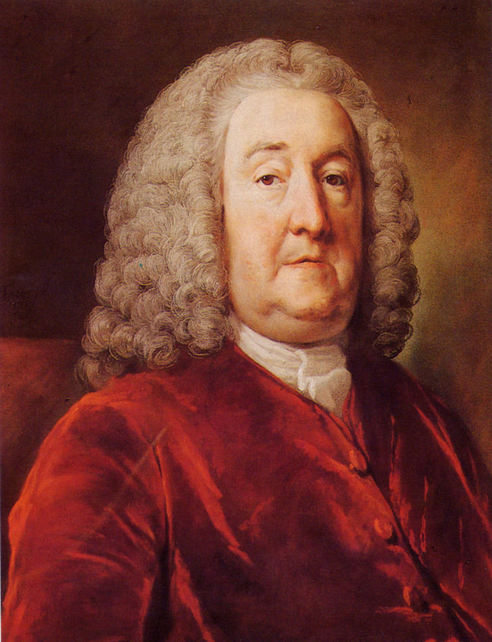
In 1783 he moved to Blackheath, London and sold his interest to Arnold NESBITT Esq. who then took up residence there. It is interesting to note that in 1791 the Manor was 'alienated' to Simon FRAZER Esq., who was a director of the EAST INDIA COMPANY. (See the chapter on the 'Toxophilites' re BOWMANS LODGE) The information above 13 showing the history between the time of Sir John BAUDE and the time of FRAZER was written contemporaneously to the life of the latter, as it showed him still in residence. FRAZERS' daughter married Alexander Lord SELTON who died at the Manor in 1793 - presumably whilst FRAZER was still alive. A map of Kent dated 1769 (HASTED) shows the Manor House of 'BALDINGS' as the family seat of Richard HULSE Esq. This is the first record that I have seen referring to an actual MANOR HOUSE.
The MINET period
Link to the early MINET / Dover connection
Isaac MINET became owner of BALDWYNS - probably about c1810. Records show that his four children were not born at Baldwyns. They were born between the years 1803 - 1807 and their registrations of birth showed an address of 13 Austin Friars. Isaac became High Sheriff of Kent in 1827 and died at Baldwyns on 14th March 1839 aged 72 years being buried at Westerham some 8 days later. This is a reference to an actual MANOR HOUSE.
Baptism record of Isaac MINET 6th December 1767
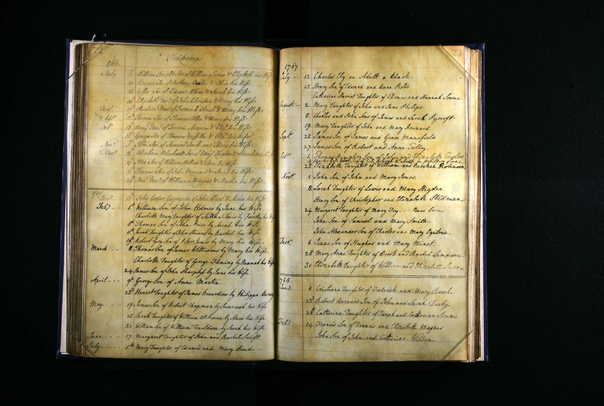
We are reliably informed that the below Isaac portrait is of the original Isaac - the original Huguenot immigrant Isaac Minet 1660 - 1745.
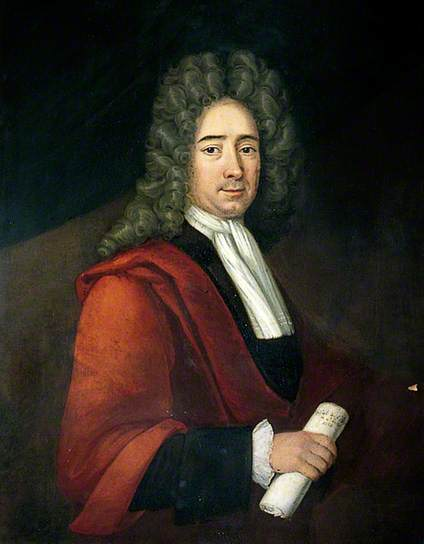
Of Isaac's children, Charles was the eldest - being born on 27th June 1803. The Wilmington Tithe map of 1842 shows that the lands were in the possession of Thomas MINET. There is reference in the Dartford Reference Library to an incident that occurred in 1846 when a Mr Richard SALMON took issue with Susan MINET about her closing a pathway across her land that led from Wilmington to Bexley. Mrs MINET's pathway can be seen clearly on a map in the British Museum dated 1799. He calculated the extra distance to walk was now 257 rods. The original being 158. The path was opened up and is now called Tile Kiln Lane. Charles died at Baldwyns on 27th February 1874 - some 3 years after the death of his wife Leah. He was buried at Wilmington Churchyard - even though his wife was buried at St. Leonard's, where she died.
A recent discovery on the internet reveals a Separation Petition by Leah MINET against Charles for his adultery in 1860. Presumably this led to divorce and why Leah was buried elsewhere. See below images.
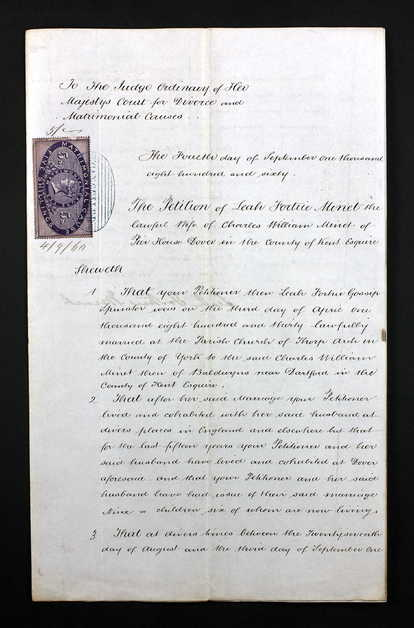
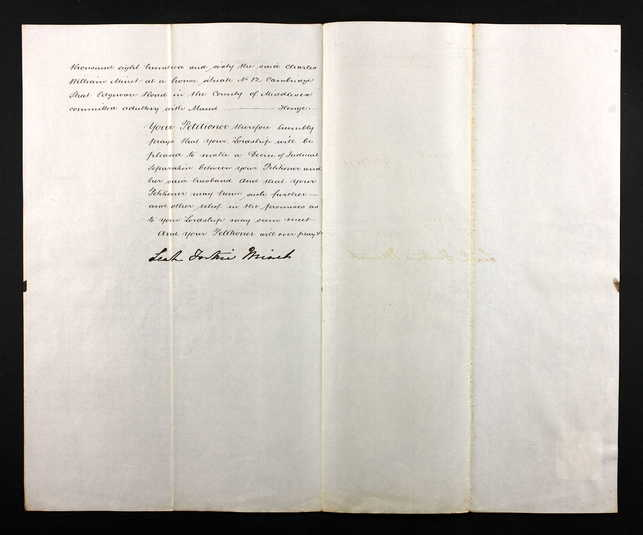
There is a loose reference to the sale of Baldwyns by the MINET family to a consortium in about 1850 which may indicate financial problems for them - this information comes from a sketchy, and unqualified, brief history manually typed and produced by an unknown author for Bexley Hospital.
Another famous connection to the Baldwyns Estate was Sir Charles William Dunbar Staveley. He married Susan Millicent MINET - the daughter of Charles MINET in 1864. They had several children, including Admiral Cecil Minet STAVELEY father of Admiral of the Fleet Sir William Doveton Minet Staveley. STAVELY's army career was long and distinguished. He fought in the Crimean War at The Alma and Balaclava. He later commanded the troops in the western district for five years from 1 January 1869, and in the autumn manoeuvres of 1871 round Aldershot, one of the three divisions was under him. He was Commander-in-Chief at Bombayfrom 7 October 1874 to 7 October 1878, with the local rank of lieutenant-general, which became his substantive rank on 29 April 1875. On 1 October 1877 he became general. He was given the colonelcy of the 36th foot on 2 February 1876, and transferred to his old regiment, the 44th (which had become the first battalion of the Essex Regiment), on 25 July 1883. He received the GCB on 24 May 1884. He had been placed on the retired list on 8 October in the previous year. He died at Aban Court, Cheltenham, on 23 November 1896, and was buried at Brompton Cemetery, London on 27 November.
Below - Sir Charles STAVELY
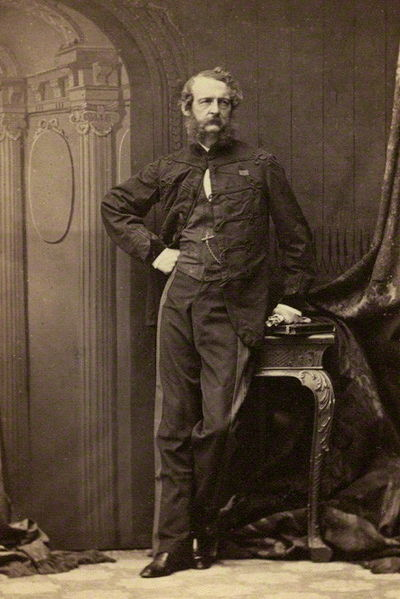
Below - extract from the South Eastern Gazette March 28th 1874 reporting on the loss of Charles MINET
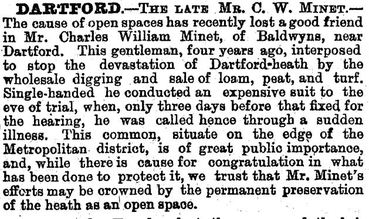
Probate of Charles MINET
(If money doubles in value every ten years (rule of thumb) then his estate at just under £40,000 would now be worth over £80,000,000 at today's value).

Further Probate in 1923

Owen Fortrie PARKER born 1879 in New Zealand was the son of Delia Jane PARKER nee MINET and Orfeur George PARKER and the grandson of Charles and Leah MINET. George died in 1922 so it may well have been in trust until Owen's father died ?
In 1874, just following his death, Charles MINET was hailed by the local press as the 'Champion of the People of Dartford'. At the time of his death he was in the middle of a Civil Court action whereby he challenged Lord TREDEGAR and his manorial rights to remove, at will, any amount of natural resources from the Heath. The land was being scarred and littered by such excavations. He won the case posthumously and, no doubt, was responsible for preserving much of the beauty of the heath for a further 50 years until its' dissection by the building of the A2 Rochester Way c.1926 and the eventual scarring made by the newer A2 (M) in 1970. The court case itself must have been expensive as the newspaper reports show many witnesses / affidavits (78 recorded in the cutting) were sworn. The pamphlet showing the auction of the Manor of Baldwyns indicates that it took place on Friday 26th May 1876 at ‘2 O'clock precisely’, at the Mart, Tokenhouse Yard, near the Bank of England. This auction occurred as the result of an order of the High Court of Chancery and with the approbation of the Judge in MINET v TUBBS 1874 M.70. It was as a direct result of the death of Charles. This could have been the result of a mixture of death duties, debts and/or contracts with the defendant TUBBS - see indented paragraph below. In this instance in 'MINET v TUBBS', TUBBS was the married name of one of Charles' daughters,. Fanny Celia MINET. She was born on 3rd April 1831. and married a Robert TUBBS on 26th September 1861. Robert came from St Leonards. It was 10 years later, and at St. leonards, on 5th November 1871 that Celias' mother, Leah, died and where she was buried. It seems strange that the only MINET buried at Wilmington churchyard was the last head of the Baldwyns Manor - Charles in 1874. He lies buried in a solitary and ( for his status in life ) a somewhat insignificant grave. Without confirmation, it would appear that there was some disharmony, or contract, perhaps, in the family. It may have been that there was a contract of financial status existing between Robert TUBBS and his father in law that had to be settled out of the estate upon the death of Charles or just as likely the probate of his will. As stated his wife lies buried in the home town of TUBBS - presumably the plaintiff (and son in law).
The pamphlet describes the Manor of Baldwyns as comprising three lots. These were headed 'BALDWYNS - MAYPOLE FARM and ROWHILL WOOD/ROWHILL FIELD'. It appears that the sale was not successful on this day due to the fact that not all three lots were sold on the day of Auction. The reserve price was £34,000 The manicured grounds of Baldwyns Manor finally fell from grace when the construction of the Asylum began c1896. In my memory, and certainly from the 1950s, this imposing Manor House has always been called 'The Mansion' and had for most of the time been used by the Occupational Therapy Unit of Bexley Hospital. The view from this house before the hospital was built must have been very gracious. The surrounding land of the Manor House was laid out as park land spilling away from the front, eastwards towards the direction of Wilmington and Rowhill. From its' pillared front door, the hill of Rowhill must have been very obvious to any visitor or resident of Baldwyns Manor at the time. There was a long drive from the current gates of the hospital sweeping round to the Manor House. The Manor House was adapted for hospital use after 1898. From an O.S. map of around this time it appears that the original house had an adjoining / closely situated additional building to the north - to the right as you view facing the front. Presumably this was the location of the 'Out Offices' referred to in the pamphlet. These 'Offices' comprised of a dairy, with a store room over, a wash house, with a laundry over, a brew house, a well house and a knife house. There were detached stables with five stalls, a harness room with hay and store rooms over and a coach house for three carriages.
Extract from the Dartford Express dated 25th July 1874
"In Chancery: MINET v. TUBBS-Kent-The beautiful Freehold Residential Estate, distinguished as Baldwyns, extending over about 841 acres in the parishes of Dartford, Wilmington and Bexley, a short distance only from the ancient and interesting market town of Dartford, about a mile away from Bexley and Crayford and only 14 by road from London, in a neighbourhood proverbially healthy and picturesque, and with excellent railway facilities by the North Kent Line, by which the City and West End are reached in little more than half an hour. It comprises a capital Mansion, with suitable attached and detached offices of every description, desirable for the occupation of a family of distinction, approached by a carriage drive, with ornamental entrance lodges, beautiful pleasure grounds, gardens, and orchards, surrounded by a richly timbered park, ornamental woods , plantations, and adjacent meadow land, through which are delightful walks of considerable extent and immediately adjoining is the farm known as Stonehill, farm buildings, and numerous enclosures of productive land, also several cottages for labourers. The woodland, which includes the well known Ruxley-Heath, Rowhill and Joydens Woods, is well adapted for the rearing of preservation game, and affords excellent shooting, and several packs of hounds hunt the district. The property presents unusual attractions as the site of the ancient city of Caswallon, and from the interesting remains of encampments and excavations made by our Celtic ancestors found thereon; while in addition to its present residential advantages, it possesses extensive frontages of Dartford Heath and the high road, immediately available for building purposes, and by a judicious widening of the intersecting road leading from Bexley to Wilmington, a further very extensive building element would be developed, and many sites for the erection of residences which, from the beauty of the situation, the close proximity to Bexley and Dartford, and the facility of railway access, must sooner or later be required".
A further advertisement of auction:-
THE SOUTH EASTERN GAZETTE, MONDAY, MAY 15, 1876
“I n t h e H i g h Co u r t o f J u s t i c e , C h a n c e r y D i v is i o n : M i n e t v. T u b b s .”
KENT. The beautiful FREEHOLD RESIDENTIAL ESTATE distinguished as B a l d w y n s , extending over about 750 acres, situate adjoining Dartford-heath, in the parishes of Dartford, Wilmington, and Bexley, a short distance only from the ancient and interesting market town of Dartford, about a mile from Bexley and Crayford, and only 14 miles by road from London, in a neighbournood proverbially healthy and singularly picturesque, and with excellent railway ■ facilities by the North Kent Line, by whioh the • City and West-end are reached in little more than half-anhour. I t comprises a capital mansion, with suitable attached and detached offices, desirable for the occupation of a family, approached by a carriage drive, vwith entrance lodges, beautiful pleasure grounds, gardens, and orchards, surrounded by a richly-timbered park, ornamental woods, plantations, and adjacent meadow land, through which are delightful walks and drives of. considerable extent, also a bailiff’s house and several cottages for labourers. The woodland, whioh includes the well-known Ruxleyheath, Row-hill, and Joyciens Woods, is well adapted for the rearing and preservation of game, and affords excellent shooting, and several packs of hounds hunt the district. The property presents unusual attractions, as the site of the ancient city of Caswallon, and from the interesting remains of encampments and excavations made by our Celtic ancestors found thereon, while, in addition to its present residential advantages, , it possesses extensive frontages to Dartford-heath and the high road, immediately available for building purposes, and by a judicious widening of the intersecting road leading from Bexley to Wilmington, a further very extensive building element would be developed, and many sites created for the erection of residences, which from the beauty of the situation, the close proximity to Bexley and Dartford, and the facility of railway access, must sooner or later be required.
MESSRS. N O R T O N , T R I S T , W A T K E Y , & Co. R E in stru c te d to offer the above PROPERTY for SALE by AUCTION, a t the M a r t , L o n d o n , on F r i d a y , M a y 26 , at Two o’clock precisely, in lots, under a Decree of the High Court of Chancery made in the above cause, and with the approbation of the Judge to whose Court the cause is a ttached. L o t 1 will comprise the MANSION, pleasure grounds, gardens, woods, and plantations, containing together about 565 a . 2 r . 5 p ., the principal portion of which is in hand. , , - L o t 2 .—MAYPOLE FARM, opposite lot l, and bounded by Dartford-heath, comprising bailiff’s house and outbuildings, three c o tta g e s , and several enclosures of undulating land ornamented, with a thriving wood, containing altogether about 5 2 a . Or. 2 0 p ., and presenting a beautiful site for the t rection of a residence. L o t 3 — ROW-HILL WOOD and ROW-HILL FIELD , comprising some capital wood land and acc o m m o d a tio n arable land, close to lot 1 , adjoining lands belonging to Capt. Sawyer, General HaLe, and others, and containing together 1 3 3 a , Or. 1 2p ., let to Mrs. S. M. Brooks. P a r tic u la r s and plans may be had of Messrs. D a w e s and S o n s , Solicitors, Angel-court, Throgmorton-street; Messrs. M a r s h and D a w e s , Auctioneers, Devizes; Messrs. M u r t o n and W e b b , Tunstall, near Sittingbourne ; at the Bull Hotel, D artford; at the M a rt; aud of the Auctioneers, 62, Old Broad-street, London, E.C.
BALDWYN’S MANSION, DARTFORD HEATH. About a mile from the Bexley Station, on the Loop Line to Dartford. 50 valuable Oil Paintings, Landscape, and Copper Plate Engravings, principally by old masters, and will include pictures by Rubens, Holbein, Morland, Nasmyths, Wouseman’s, Rysdale’s, Zuccarelle, D. Roberts, R.A. M r. D A N N H AS received instructions to SEL'Ij by AUCTION, at the M a n s i o n , on W e d n e s d a y , 7th J u n e , 1876, and two following days, at Twelve for One o’clock each day, rare OLD CHINA, bronzes, clocks, elegant Indian screen, cabinets, workB of art, 500ozs. of plate and plated articles, 18 dozens of fine old Port, 6 dozens old E ast India Madeira, drawingroom suite, contents of dining, morning-rooms, and library, linen, books, the appendages of 13 bed chambers. May be viewed the day previous to the sale, by catalogues only, a t 6d. each, to be had'of Mr. J a s . H i c k - e o r d , New City-chambers, No. 121, Bishopsgatestreet, London ; and of the Auctioneer, E state, and Land Agent, Bexley. Note.—F irst day, bed-chambers and linen ; second day, pictures, ‘prints, plate, old china hird day, reception-rooms, wine, glass, books.
Remainder of lots not originally sold - extract from South Eastern Gazette May 14 1877 Sale of Maypole Farm etc
![]()
I n t h e H i g h C o u r t o f J u s t i c e (C h a n c e r y D i v i s i o n ) .— M i n e t v . T u b b s .
KENT. The Remaining Portions of the B ALDWYNS ESTATE, situate in the parishes of Dartford and Wilmington, adjoining Dartford-heath, about a mile from Bexley and Crayford, and only a short dit-tance from the maiket-town of D artford; the whole comprising about 185 acres. MESSRS. NORTON, TRIST, W A TN EY , & Co., Having disposed of the principal portion'of the Estate, A RE in s tru c te d to offer th e above PROPERTY for SALE by AUCTION, a t the M a r t , L o n d o n , on F r i d a y , J o n e 8th, a t Two o’clock precisely, in two lots, under a Decree of the High Court of Chancery, made in the above cause, and with the approbation of the Judge to whose Court the cause is attached :•— L o t 1.—MAYPOLE FARM, a very attractive little Freehold Property, situate opposite the Baldwyns Estate, and bounded on one side by Dartf’ord-heath. I t comprises a compact dwelling-house, with outbuildings, garden, two good cottages, and several enclosures of undulating land, ornamented with a thriving wood, and presenting a beautiful site for the erection of a residenoe. I t has also an extensive frontage to the high road, immediately available for building purposes, and contains altogether about 52 acres, with possession. L o t 2 —ROW H ILL WOOD and ROW H ILL FIELD , situate near to lot 1, comprising some capital wood land, well adapted for the rearing and preservation of game and affording exoellent shooting, '’also an enclosure of accommodation arable land, having an extensive frontage to the road, adjoining lands belonging to Capt. Sawyer, General Hulse, and others, and comprising about 133 acres. Particulars and plans may be had of Messrs. D a w e s and Sous, Solicitors, - 9, Angel-court, Throgmortonstre e t; Messrs. M a r s h and D a w e s , Auctioneers, Devizes; Messrs. Mu r t o n and W e b b , Tunstall, near Sittingbourne; a t the Bull Hotel, Dartford ; at the M a r t ; and of the Auctioneers, 62, Old Broad-street, E.C
1882 - sale of Clayton Croft and Freehold Property known as MAYPOLE
South Eastern Gazette
THE SOUTH EASTERN GAZETTE, MONDAY, MAY 1 1882
CLAYTON-CROFT, DARTFORD-HEATH, A proverbially healthy looality near to Hulsewood, H eatheide, Broomfields, and W ilm ington-hall, a convenient distanoe from Bexley, Crayford, and D artford Stations on the N orth K en t Railway. M r . D A N N H AS received instructions to SELL by AUCTION, on M o n d a y , the 5th day of J u n e , 1882, a t Twelve for One o’clook, a t the A u c t i o n M a r t , near the B ank of England, London, E .C. F R E E H O L D PR O PE R T Y , comprising a handsom e Residence, suitable for a fam ily, having all neoessary aocommodation, coach-house and stabling, and su rrounded by about three aores of land laid out in pleasure grounds, law ns, and p lantation in full bearing, kitchen garden, &o. ; together w ith about three acres of plantation land adjoining, having a frontage of about 680ft. to D artford-heath and peculiarly adapted for the ereotion of first-class residences. F R E E H O L D PR O PE R T Y , known as M a y p o l e , im m ediately contiguous to B a ld w in 's P ark, being a valuable enclosure of building land, on the w est aide of D artford-heath, com prising 9a. 2r. 26p. of arable land w ith a cottage, and having an im p o rtan t frontage of about 1,330ft. to D artford-heath and Bexley-roads, su itable for the ereotion of first-class residences. Clayton-oroft may be viewed seven days previous to th e sale, between the hours of Eleven and F our o’olock, by orders only to be obtained a t the Auctioneer’s offices. P artioulars, w ith plans, m ay be obtained of F . G i b s o n , E sq., Solioitor, Sittingbourae ; a t the plaoe of sale ; and of the A uctioneer and E sta te A gent, Bexley, K ent.___________________ __
The original gatehouse(s) presumably were on or near the site of the current (and enlarged with the new housing development) Lodges. The pair of gate houses that exist today (and redeveloped) are isometric and were most certainly originally built as part of the hospital and the original (s) demolished. There was still an outbuilding right up to c.1994 - detached from the East Lodge - that I suspect dated back to the original gatehouse to the manor. The Planning Application for Hiram Maxims Flying Machine rails, dated 1894, shows one gate house on the site of the current East Lodge with an outbuilding. This original outbuilding appeared to be constructed to a design that is not replicated in any other part of the hospital and to be made from older materials. (However there was a similar building in the original enclosed 'Gardens' area near the Manor House used as a potting shed.) This gatehouse outhouse was constructed mainly from timber with a central brick chimney. The brickwork appeared much older than any other within the hospital complex. It is possible then that this outbuilding dated back to the early 18th century and to the time of the original gatehouse. I can remember in the 1950s that the hospital still had the status of an Asylum and had very large, tall green iron gates that were closed when not in use.
Geographical area and time scope of research
Below is the geographical centre area of our original research - but now we incorporate Joydens Wood, Wansunt, Coldbow, Rowhill, Baldwyns Park and the borders of Leyton Cross and Wilmington.
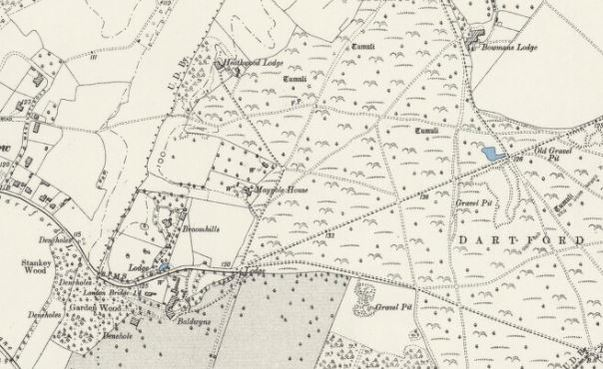
The modern history of the Maypole Housing Estate and it's neighbouring areas really only goes back to the turn of the 19th / 20th centuries. The Maypole housing estate was built to house the workers of the new asylum - which had been built on the grounds of the old Baldwyns Country Estate. The asylum was completed in 1898 and eventually housed some 2,500 patients. That was the catalyst for the expansion of house building. Prior to that there were only four substantial residences within 400 yards of the housing estate boundaries. They were Baldwyns Manor, Heathwood Lodge, Maypole House / Farm and Broomhills. Until 1898 the ground on which the Maypole Housing Estate now stands was heath-land, comprising gorse, heather, broom, shrubs and fern. It also was the site of the ancient animal pound, upon which was built later, the Maypole Primary School - now Academy Court. The prehistory of the Maypole Housing Estate is covered as it will be of interest to the casual reader and give an insight into the character of the area and why it attracted so much construction. It may serve to provide some reason as to when and why the area developed in the way that it has.
Baldwyns Manor - Chronolgy
c.1200
Land owned by Sir John BAUDE - from where the name 'BALDWYNS' originates.
1509 Lands owned by the Abbots of Lesnes
1525 Lands owned by Cardinal Thomas WOLSEY
1529 Lands confiscated from Cardinal WOLSEY by King HENRY VIII 1603 Lands exchanged by King HENRY VIII with Eton College for other lands. Lands then leased by Eton College to ADAMS
1739 Lands then ? owned / leased to Sir Edward HULSE
1759 Manor House recorded - referred to as retirement place for Edward HULSE.
1759 Richard HULSE (Second son to Edward) took over estate from his father.
1768 Lands enclosed by Richard HULSE who greatly improved the estate.
1783 Richard HULSE moves from Baldwyns to Blackheath and sells his share in the estate to Arnold NESBITT.
1783 Owned by Arnold NESBITT
1788 Simon FRAZER ( Director of East India Company ) shown as living at Baldwyns.
1791 Estate shown as being 'alienated' to FRAZER by NESBITT
1793 Lord Alexander SELTON dies at Manor. He was husband of Elizabeth FRAZER - daughter of Simon FRAZER.
c.1808 Estate now owned freehold by Isaac MINET and his wife Susannah.
1839 Isaac dies at the Manor.
1874 Charles MINET - son of Isaac - dies at Baldwyns and estate administration granted to Geraldina - ?his daughter
c.1876 Lands purchased by ? L.C.C. in preparation for the new Asylum.
1878 John Gotch HEPBURN - wealthy local businessman - tenant of the Manor.
1889 Sir Hiram MAXIM tenant of the Estate.
1891 Henry HOUSE and family (American) shown as staying at Manor (Father and son both mechanical engineers ? Guest of Sir Hiram, who was also American by birth).
1892 First trials of aeroplane in the grounds.
1894 Mans very first flight in a 'heavier than air' machine 31st July
1898 Construction of Bexley Hospital commences.
1996 Bexley Hospital reshaped and majority demolished
Baldwyns Manor - Sir Hiram MAXIM
Below - plaque at Maypole School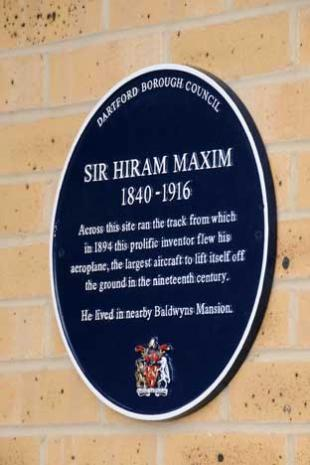
When Charles MINET died in 1874 Baldwyns Manor House and Estate had to be sold. The Manor eventually came into the hands of the London County Council. Between the years 1876 and 1898 it was leased to various tenants. One of these tenants was Sir Hiram MAXIM. He rented the Manor from about 1889 until probably c.1896. ( It is not clear as to the exact dates because the waters are muddied by the discovery that John GOTCH HEPBURN was shown in residence in the Census of 1881 and a local newspaper cutting shows liquidation of his firm and auction of his contents in the Manor in 1893 ) With regards HEPBURN a centenary document for Madam OSTERBERGS College shows him as purchasing a house called 'Oakfield' in Oakfield Lane in 1895. It may well be that he sub let Baldwyns to MAXIM ? It was at Baldwyns manor that MAXIM continued his experiments with flying machines. It was in 1891 that he began his work, in earnest, on the first flying machine. He built a large hangar near the manor house ( South west by several yards ) where the flying machine was developed and stored. The Planning Application to the London County Council of 1894 shows the site of the hangar and the path of the rail tracks that it was to run on. They ran from just south of the house, out of the hangar, South Eastwards, towards the direction of Birchwood Road just north of its' junction with Tile Kiln Lane. The rails measured 1800 feet in length and were eventually widened to an amazing 35 feet. When MAXIM wheeled the centre section out of the hangar, he attached the wings. He called these wings 'Aeroplanes'. The total wingspan of the craft was 104 feet. The Wellington Bomber used in the second World War had a wingspan of only 86 feet 2 inches.
The hangar - and part of the flying machine just outside the hangar
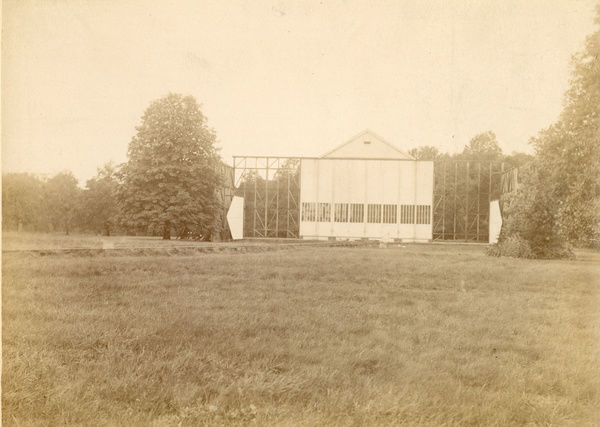

The first propelled flight of man in a machine heavier than air was witnessed at Baldwyns in 1894 - but it was not 'free flight'.
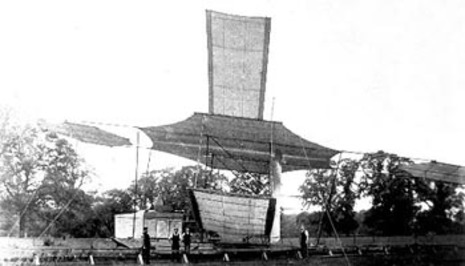
Maxim's Flying Machine c1894
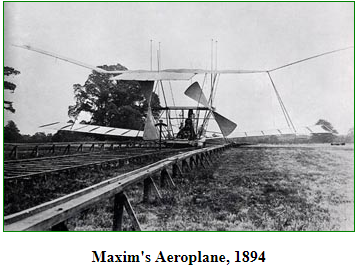
The machine was so unwieldy that it had to be tethered to rails. Height of take off, therefore, was restricted. The Aeronautical Society witnessed and acknowledged this achievement but as it was not 'free flight' it made few headlines. On the night of the Census of 1891 records show that there were two other engineers staying at the Manor House at the same time as Hiram. They were father and son Henry HOUSE (Senior and junior) Father was aged 50yrs and the son was aged 27yrs. Both had their wives with them. Mary was aged 49yrs - the mother of Henry Junior. Vera was aged 21yrs and married to Henry Junior. The family came from Connecticut, America. Hiram, was also American by birth and spent his early years in Massachusetts - the State bordering Connecticut. It is more than likely, not just coincidence, that these visitors were engineers - and thus they may have been able to assist him in the project of flight that was so important to him.
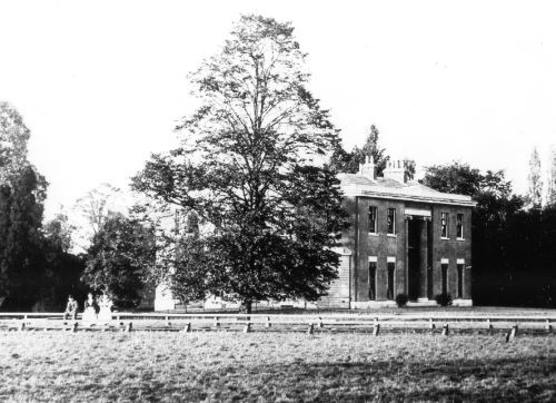
The rails outside Baldwyns Manor on which the Aeroplane ran
Regarding MAXIM, the following was found in the Bexley Records Office written by Susan ILLOT:
" He was born in the USA in 1840 to a French Huguenot family. As a result of growing up in a frontier settlement he developed into a very different character to the typical nineteenth century philanthropic engineer. He was a non drinking, non smoking agnostic with a tremendous capacity for hard work. He despised slackness and insobriety; but who was also a picaresque individual, an accomplished card player with a fondness for boxing and wrestling.
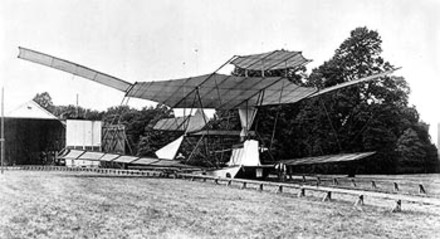
The aeroplane approaching the hangar just outside Baldwyns Manor - which lies to the right hand side, out of view.
Below Sir Hiram Maximn (with beard) and crew 1894 at Baldwyns. Taken from the Baldwyns Manor side towards Tile Kiln Lane direction
note the left hand open door of the hangar in the background.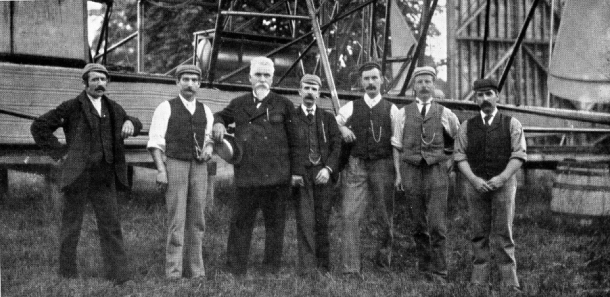
He came to Europe for the Paris Exhibition in 1881 to represent the United States' first electric lighting company who were exhibiting his electric regulator. He then came on to Britain to investigate our electrical industry and it was while staying in London that he made drawings for an automatic machine gun. The innovation of Maxims' gun was that it was the recoil of the weapon which supplied the energy to insert a fresh cartridge in the barrel and to detonate this cartridge in turn. The first Maxim gun fired 666 times a minute and this model was later followed by a larger gun firing 400 times a minute, nicknamed the pom pom by African Natives.
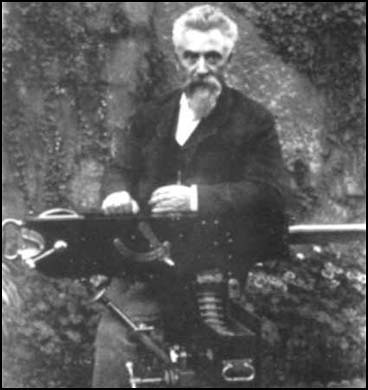
Hiram Maxim with his machine gun
Hiram firing his gun
Maxim approached VICKERS, a steel company to manufacture his gun and so in 1884 The Maxim Gun Co. Ltd was formed with Albert VICKERS as chairman and production was started in their works in Crayford. Maxim then came to live in Stoneyhurst, Crayford and he gave lectures in the neighbourhood, substituting corks for bullets in his demonstrations.
These talks must have provided a lively alternative to the more usual lantern slide evenings or smoking concerts.
Sir Hiram was also well known for his aeronautical experiments for although he designed a helicopter as early as 1872 he did not construct his first aeroplane until 1892 when trials were held in Baldwyns Park.
This aircraft was105 feet wide with 17 foot long propellers, fitted with 2 X 362 hp. steam engines and weighed about 2 tons. The machine ran along railway tracks and Maxim proved that it could lift a weight of 2.5 lbs per square foot when moving through the air at 40 m.p.h. It crashed safely to the ground, eagerly watched by hundreds of spectators. Sir Hiram never developed the idea any further having proved his point he continued devising all manner of ingenious items which included an explosive similar to gelignite, various gas machines, engine governors and even a medical inhaler to relieve the chest condition from which he suffered in old age." Hiram MAXIM was knighted in 1901. He was also interested in and did work on aerial navigation. He died at Sydenham in 1916. He was, in every sense, an 'Avid Inventor'.
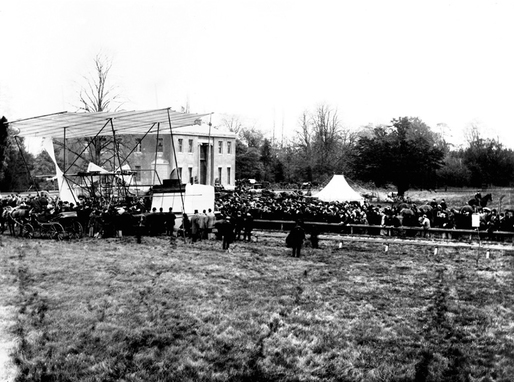
Picture of unknown origin and may be subject to copyright Sir Hiram Maxim's flying machine on display 1894
Useful links
Sir Hiram Stevens Maxim
SIR HIRAM MAXIM
1840-1916
When Charles Minet died in 1874 the Baldwyns Manor House and Estate had to be sold. The Manor eventually came into the hands of the London County Council. Between 1876 and 1898 it was leased to various tenants. One of these tenants was Sir Hiram Maxim. He rented the Manor from about 1889 until probably c.1896. ( It is not clear as to the exact dates because John Gotch Hepburn was shown in residence in the Census of 1881 and a local newspaper cutting shows liquidation of his firm and auction of his contents in the Manor in 1893 ) With regards Hepburn a centenary document for Madam Osterberg’s shows him as purchasing a house called 'Oakfield' in Oakfield Lane in 1895. It may well be that he sub let it to Maxim ?
Sir Hiram Maxim with his machine gun
It was at Baldwyns manor that Maxim continued his experiments with flying machines. It was in 1891 that he began his work in earnest on the first flying machine. He built a large hangar near the manor house ( South west by several yards ) where the flying machine was developed and stored. The Planning Application to the London County Council of 1894 shows the site of the hangar and the path of the rail tracks that it was to run on. They ran from just south of the house, out of the hanger, South Eastwards, towards the direction of Birchwood Road just north of its' junction with Tile Kiln Lane.
The rails measured 1800 feet in length and were eventually widened to an amazing 35 feet. When Maxim wheeled the centre section out of the hangar, he attached the wings. He called these wings 'Aeroplanes'. The total wingspan of the craft was 104 feet. The Wellington Bomber used in the second World War had a wingspan of only 86 feet 2 inches.11
The first propelled flight of man in a machine heavier than air was witnessed at Baldwyns on Tuesday 31st July 1894 - but it was not 'free flight'.
The machine was so unwieldy that it had to be tethered to rails. Height of take off, therefore, was restricted. The Aeronautical Society witnessed and acknowledged this achievement but as it was not 'free flight' and it made few headlines.
On the night of the Census of 1891 records show that there were two other engineers staying at the Manor House at the same time as Hiram. They were father and son Henry House (Senior and junior) Father was aged 50yrs and the son was aged 27yrs. Both had their wives with them. Mary was aged 49yrs - the mother of Henry Junior. Vera was aged 21yrs and married to Henry Junior. The family came from Connecticut, America. Hiram, was also American by birth and spent his early years in Massachusetts - the State bordering Connecticut. It is more than likely - not just coincidence - that these visitors happened to be engineers - and thus they may have been able to assist him in the project of flight that was so important to him.
Regarding Maxim, the following was found in the Bexley Records Office written by Susan Illot:
" He was born in the USA in 1840 to a French Huguenot family. As a result of growing up in a frontier settlement he developed into a very different character to the typical nineteenth century philanthropic engineer. He was a non drinking, non smoking agnostic with a tremendous capacity for hard work. He despised slackness and insobriety; but who was also a picaresque individual, an accomplished card player with a fondness for boxing and wrestling.
He came to Europe for the Paris Exhibition in 1881 to represent the United States' first electric lighting company who were exhibiting his electric regulator. He then came on to Britain to investigate our electrical industry and it was while staying in London that he made drawings for an automatic machine gun. The innovation of Maxims' gun was that it was the recoil of the weapon which supplied the energy to insert a fresh cartridge in the barrel and to detonate this cartridge in turn. The first Maxim gun fired 666 times a minute and this model was later followed by a larger gun firing 400 times a minute, nicknamed the pom pom by African Natives.
Maxim approached VICKERS, a steel company to manufacture his gun and so in 1884 The Maxim Gun Co. Ltd was formed with Albert VICKERS as chairman and production was started in their works in Crayford. Maxim then came to live in Stoneyhurst, Crayford and he gave lectures in the neighbourhood, substituting corks for bullets in his demonstrations. These talks must have provided a lively alternative to the more usual lantern slide evenings or smoking concerts.
Sir Hiram was also well known for his aeronautical experiments for although he designed a helicopter as early as 1872 he did not construct his first aeroplane until 1892 when trials were held in Baldwyns Park.
This aircraft was105 feet wide with 17 foot long propellers, fitted with 2 X 362 hp. steam engines and weighed about 2 tons. The machine ran along railway tracks and Maxim proved that it could lift a weight of 2.5 lbs per square foot when moving through the air at 40 m.p.h. It crashed safely to the ground, eagerly watched by hundreds of spectators. Sir Hiram never developed the idea any further having proved his point he continued devising all manner of ingenious items which included an explosive similar to gelignite, various gas machines, engine governors and even a medical inhaler to relieve the chest condition from which he suffered in old age."
The crashed craft putting an end to his experiments at Baldwyns – the Scots Pines to the right of the picture border Oakfield Lane and remnants still exist today.
Hiram Maxim was knighted in 1901. He was also interested in and did work on aerial navigation. He died at Sydenham in 1916 just as the Battle of the Somme was ending. His machine-guns had mown down thousands on both sides. He is buried in West Norwood Cemetery, south London. He was, in every sense, an 'Avid Inventor'. Maxim was knighted in 1901. He died in 1916
Ochalt Manor
During the late 13th and early 14th centuries, a large house lay in close proximity to where Baldwyns Manor now stands. This has been recorded by I E MORRIS in her pamphlet 'Baldwyns Park and Joydens Wood'.
"During this time a hall and outbuildings, together with a large square earthwork very near to Baldwyns, were built, lived in for a very short time and then deserted. It has been suggested that this was the site of Ochalt manor house - a manor which was known to exist somewhere in this area. The structures were where Spurrell Avenue and Chalet Close are now, and was probably only lived in between about 1280 and 1320. There has been speculation as to why it was deserted after such a short period. There was nothing in the excavated evidence to suggest destruction by fire or a sudden natural calamity - unless an outbreak of a pestilent disease destroyed the settlement.
Failure of the water supply or bad farming practices on the sandy soil have also been offered as explanations but whatever the cause the capital messuage, as a good size house would have been called in those days, gradually fell into decay. After some initial robbing of the site it lay comparatively undisturbed until a recent series of archaeological digs uncovered some of its secrets. The main building was rectangular. It was 62 feet long and 30 feet wide. It had been built of timber with a tiled roof. The floor was of the Thanet sand which is typical of this area. An outbuilding attached to the South West corner was probably thatched and could possibly have been a cattle byre or stable.
The hearth was 7' square and was the usual platform of broken tiles set on edge. A modern rubbish pit had destroyed most of the floor of another timber building. In 1934 Mr HOGG had decided that it was most probably a mediaeval cottage for there were signs of both human and animal occupation. A building excavated by F. C. Elliston Erwood in 1925 is believed to have been a lodge for a cart and a further structure studied by Mr. Caiger and Mr Tester was made up of features which indicated an oven or kiln. A well with an upper opening of 3' 9" was over 100' deep when Mr F.C. Spurrell looked at it but by 1958 it had been filled to a depth of 75'. Several styles of roof were found in such a position as to be able to date them accurately to the 13th or early 14th century. They were all of a reddish hue and one curved tile indicated that a dove cote may have been in the vicinity".
Courtesy of Facebook Joydens Wood Remembered group - Rhona Lee
The discovery of medieval buildings in Joydens Wood.In 1957 an emergency investigation were undertaken by P.J. Tester and J.E.L. Caiger within a well-known square earthwork,situated at the corner of the junction of Joydens Wood Road and Summerhouse Drive. The excavations were quickly undertaken, with help from their friends and a few members of the Kent Archaeological Society, due to the sites impending destruction by the house building planned to take place there.
The main result of the works was the discovery of chalk and flint footings of a medieval hall flanked by two smaller buildings and a well. The positions of the buildings relative to the earthworks and two other structures revealed by previous excavators, carried out in the 1920's and 30's, are shown on the first diagram. The landowners who permitted the digging were Mr. J. Stevens and Mr. A. Seagust.
The medieval hall ( a rectangular building, 62 ft. long and 30 ft. wide externally ) may very likely have been the manor house of the lost Manor of Ocholt which belonged to the Abbey of Lesnes, the ruins of the latter are situated in Abbey Wood.
The well was almost certainly related to the medieval occupation of the site, in spite of a persistent popular belief in its Roman origin. Eighty years earlier it was noted by F. C. J. Spurrell to have been over 100 ft. deep, though by 1958 it had been filled to 75 ft. The upper part of the shaft, which was 3 ft. 9 in. in diameter, was steined with flints for a depth of 26 ft. in order to retain the Thanet Sand through which it passed before entering the underlying chalk. A great deal of the lower part of the original steining had collapsed into the shaft in recent times. No doubt this well was the chief source of fresh water for the medieval settlement.
A remarkable feature was the apparent shortness of the period of occupation of these buildings. This was established to be c.1280-1320 through analysis of pottery pieces found on the site. Why the settlement was deserted is not certain; failure of the water supply, rapid impoverishment of the sandy soil in the surrounding fields or the Black Death (1348) are possible explanations. Nothing was found to suggest destruction by fire or similar calamity.
Unneven patches of brownish-green glaze occurring on the underside of roof tiles ( a great quantity of which where discovered about a foot below the land surface at the time) suggested they were likely to have been made locally. Lenses Abbey owned a tile kiln on the adjoining Manor of Baldwyns in the early 16th century and Tile Kiln Lane takes its name from this fact. The third diagram shows drawings of a few of the tiles found. Some of the pottery sherds found were identified as belonging to 'grey ware' produced in the Limpsfield area of Surrey; such Limpsfield ware was supplied to London and northern Kent, having also been found at nearby sites Cray House and Eynsford Castle. Other finds other than pieces of tiles and pottery (from cooking pots, dishes and jugs) included fragments of painted glass, iron nails and an iron door bolt.
Below - site of excavations.
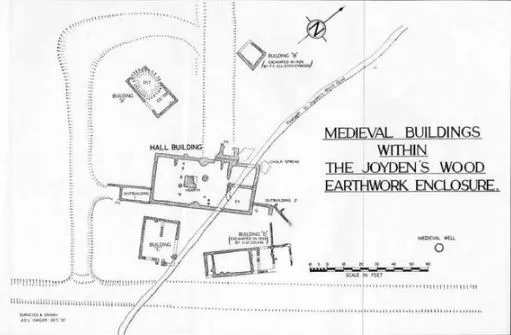
Below - site in detail
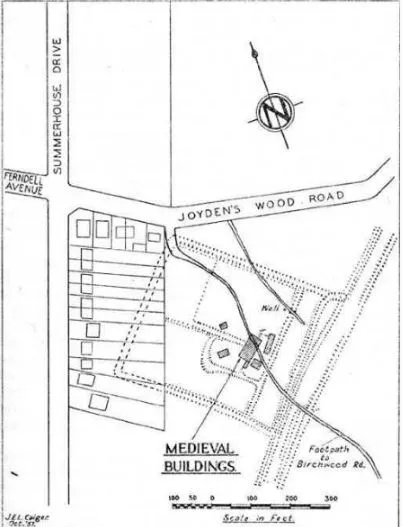
As it is today
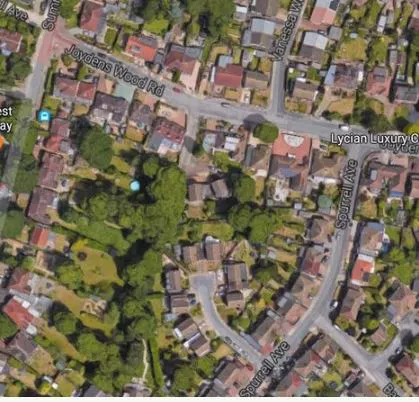
Napoleonic Army Camp
DARTFORD CAMP
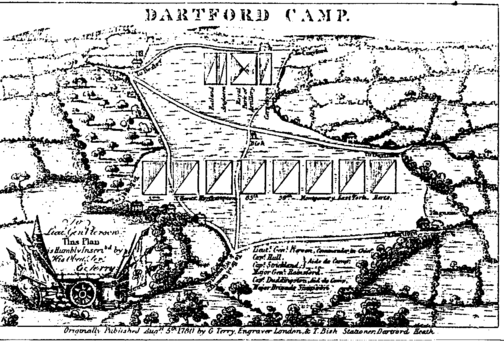
Above - plate showing Regiments of Camp c 1778-1780 on Dartford Heath
The above engraving (G. Terry) may well be the same as mentionedin the British Museum
(www.britishmuseum.org/research)
Biographical details
Garnett Terry (printmaker; British; Male; 1746? - 1817)
Address
29 Paternoster Row, 1770 62 Paternoster Row, 1776-1777 54 Paternoster Row, Cheapside, 1777-1796 20 City Road, 1797-1798 Artillery Place, Finsbury Square, 1817 Bibliography
Information from Laurence Worms (Sources: Chubb. IGI. Alfred W. Light: 'Bunhill Fields: written in honour ...' (London, 1913), pp.220-221. Maxted. Tooley. )
Biography
Printmaker, map-engraver, banknote engraver, printer, jeweller and bookseller. Engraved seven maps for 'Taylor & Skinner's survey and maps of the roads of North Britain or Scotland' 1776; George Taylor & Andrew Skinner, A map of the county of Louth (4-sheet) 1778; the general map and most if not all of the maps for George Taylor & Andrew Skinner: 'Taylor and Skinner's maps of the roads of Ireland ...' 1778; Richard Cowl, '... this plan of the borough of Plymouth ...' 1779; for Paul Rapin de Thoyras: 'The history of England' 1784-1789; for Harrison: Atlas 1787, etc.
Although said to be aged 73 at his death in 1817, he is almost certainly to be identified with the Garnet Terry, son of Garnet and Frances Terry, baptised at Holy Trinity, Gosport, Hampshire on 21 Nov 1746. Apprenticed (Tinplate Workers Company ) to William Weaver 1761 (£21); married Elizabeth Farrell 8 Oct 1769 (St. Mildred Poultry, London); married again Rebecca Beech 16 Jul 1792 (St. Andrew by the Wardrobe, London). Trading as 'Garnet Terry & [Richard] Batley' 1770. Member of St. Martin's Lane Academy. Examples of his own trade-cards survive (HealCollection), also bookseller's labels promising 'most money given for curious old Hebrew, Greek and Latin Books of Divinity' (Ken Spelman catalogue 1993 - item 415) or 'books in all languages bought and sold' (Guildhall Library; Banks collection); a further Guildhall trade-card describes him as an 'engraver and printer in colours'. Testified as a witness in an Old Bailey trial in 1776, and again as an expert witness at a number of trials for forgery between 1798 and 1805, stating in 1799 that 'I am the engraver employed by the Governor and Company of the Bank of England, I engrave the plates for the one and two pound notes'. This official role contrasts with radical political views expressed in a number of satirical prints of the 1770s, and with the Rev. William Huntington's description of Terry as 'a leveller, and for all things common'. He became a follower of Huntington in the 1780s, publishing a number of his works and earlier apocalyptic text,s as well as devising at least three large-scale millenarian prints (see F. Carey (ed.), The Apocalypse and the Shape of Things to Come, exhibition catalogue, BM, 1999, pp. 217-18 and nos. 15 and 16). At his own expense he built a nonconformist meeting-place in Curtain Road, Shoreditch, where he preached for many years. Died 31 Jul 1817 (said to be aged 73); buried Bunhill Fields. Bequeathed over £6,000 to his chapel, etc. Apprentices: Larkin How 1770; Thomas King 1772; Vincent Woodthorpe 1778; Thomas Foot 1778; Joseph Saunders (turned over to Terry 1785). Three trade cards in Heal Collection. Heal,59.157 advertises "Terry. Engraver. 54 Paternoster Row, Cheapside." Heal,59.159 advertises "Sold by G. Terry, 54. Paternoster Row. St. Pauls. Most money for Libraries or Parcels of curious old Hebrew, Greek & Latin Books of Divinity. Geat [sic] choice of new & old Bibles. Books bought, sold or Exchang'd. Books neatly Bound. New and old Books of Divinity." Heal's annotations on mount similar to above. Heal,59.160 advertises "Terry, Engraver, 29 Paternoster Row, Cheapside, London. NB. Portraits Painted." Heal's annotations on mount sinilar to above. Billhead in Heal Collection (Heal,59.158) states "To Garnet Terry, Engraver & Jeweller, No. 54 Pater Noster Row, Cheapside." and is dated "London March 16th, 1780." Heal's annotations on mount: "Engraved very many Tradesmen's Cards 1780-'93. Compare trade-card of same address in A.H. Collection. Chubb's 'Printed Maps' gives him: - at 62 Paternoster Row until 1777. 54 Paternoster Row 1777-'96. 20 City Road, 1798."
Also Known As
Terry, Garnett; Terry & Batley
Below showing proximety of where Maypole Estate was to be built
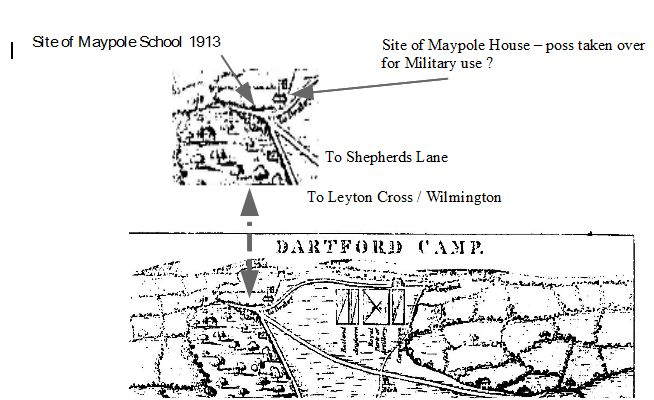 |
With regards to the Heath it is interesting to note that in 1780, whilst Great Britain was under fear of attack from France and Spain, there was a large temporary encampment of soldiersbased upon it. This camp lasted for a few years and the local neighbourhood benefited, hugely, in trade with the soldiers. This camp eventually swelled in numbers to approximately 8,000 soldiers. Remember, these weren't soldiers in camouflage - they would have presented any observer with a blaze of colour. The soldiers would have been under canvas and these tents would have been in neat rows. A contemporary plate, published by T BISH, showed that the Camp was situated between what is now Heath Lane and the vicinity of the gates of Baldwyns Manor (Bexley Hospital). At the height of the camp and situated towards the centre of the heath there was a shop for supplying the troops with stationery and small stores - T. BISH. (The contemporary map of the heath showing the camp also showed their 'shop') The 'Suttling' House - a merchant who follows army camps - stood near Bowmans Lodge and was kept by Mr POWELL of the Granby, Dartford.
The Magazine was situated near the end of Oakfield Lane. There were similar camps at Coxheath, Kent and at Warley Common in Essex. All three camps were uprooted at daybreak on 27th July 1780 and there was then performed a grand review of these troops held by their commanders. These included Lieutenant - General PIERSON (and who had just returned from America and fighting in the War of Independence) Lord AMHERST, Colonel St. LEGER, other commanders and their respective military attendants. After detailing their :-
'manual exercise, platoon, grand and subdivision street and bush firing' the entire army comprising 4 divisions and their artillery then marched off the heath and made their way to Gravesend.
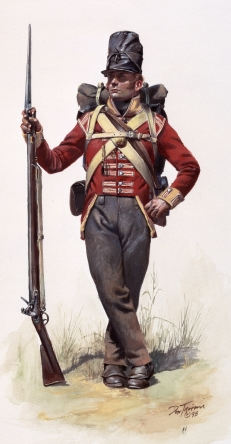
Typical uniform of British Soldier at the time of the camp on Dartford Heath
The other two aforementioned camps also made their way, respectively, to Gravesend and Tilbury. As a show of force the entire strength was conveyed across the Thames and back within 8 hours. Reports at the time indicate this huge spectacle was witnessed by many people. The 4 divisions then marched back to Dartford Heath and were dismissed at 8.15 p.m. to great applause. "The nobility and gentry who attended (this return) were afterwards entertained by a play called 'The Recruiting Serjeant', performed by the officers and their ladies, in a large marquee; after which, the general entertained them with a supper , and some of the noble visitors did not leave the camp until Sunday".
It was on Sunday evening, 6th August 1780 that there developed a violent quarrel at the camp between a soldier of the 52nd regiment and one of the Northamptonshire militia which 'occasioned a battle in front lines'. Colonel STRAUBENZIE of the 52nd endeavoured to quell the disturbance and was 'exceedingly ill treated'. It was with difficulty that the two regiments were prevented from 'making common cause with the combatants'. One man had his ear cut off; another lost two fingers and some had several 'very dangerous wounds from swords, bayonets etc.' This was the end for the camp. The location must have made it difficult to impose strict military discipline and in September 1780, the camp broke up - to the 'infinite regret of the belles of the neighbourhood'. It is reported that their trade was greatly missed and that 'Desolation reigned around' when they had gone.
Below - British Army tent from Napoleonic era.
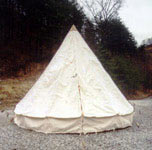
On the evening preceding the break up of the camp a select party of Officers were invited to take a farewell supper with the Ladies of the neighbourhood. One of the attending ladies - a Miss THORPE - reported that "they broke not the bread of cheerfulness, it was but the ghost of gaiety;- for what availed the attendance beaux, to whom our 'Good night' might be forever! and their morning salute accompanied with the groan of (moving) forges - and - still more dismal sound that of departing regiments!" It has been said that traces of this once colourful encampment could still be made out by persons walking on the heath right up until 1840 or so - some 60 years after it's demise. Holes and craters on the heath where tents, marquees and earthworks etc. once were, could still be seen.
I can certainly remember, as a boy, playing in the once abundant heather on the heath in the late 1950s / early 60s and of rolling around in the small circular indentations in evidence at the time. Presumably some of these were the remains of the above described encampments. At the time we imaginative boys thought that they were bomb craters - a relic of more recent military action. Several of the older residents from the estate, however, confirm that they were there before the last war. For generations, a favourite playing place for local children living on Maypole Estate was a hollow on the heath. This is situated on the opposite side of Denton Road to where the Rolex Watch Company is and on the opposite side of Denton Road to where Maypole House once stood. As children, we always knew it as 'THE CAMP HOLE'. The late Winnie BLACKMAN stated that children in the 1920s also used this name for the hollow. Does it have some connection with the Napoleonic military encampment of 1780 ?
Bowmans Lodge
THE TOXOPHILITES AND BOWMANS LODGE
( THE ROYAL SOCIETY OF KENTISH BOWMEN )
1785 - 1802
Not far from Maypole Estate and on the edge of Dartford Heath, closest to Crayford, lies a road called Bowmans Road. This is a cul-de-sac road that once bordered an old sand and gravel pit. It lies at the top of the hill off Station Road, Crayford. A short way further up Station Road, coming towards Maypole Estate and bordering the Heath itself, lies Swan Lane. This borders the north side of the football pitch and cricket ground on the Crayford side of the old A2 (Rochester Way) adjoining Denton Road. As one travels up Swan Lane from Crayford, towards the direction of Shepherds Lane, there is to be seen a new house on the left. This occupies the site of an older house which I remember quite well. It was a rambling, slate roofed, dilapidated building with fading, cracked, green paintwork and shabby curtains. I remember that this house was on the edge of the sandpit which lay to the rear of the house. I am led to believe that at some time the 'Heath Keepers' may have been housed there. The adjacent pit was eventually used to bury Dartford's' rubbish and was completely filled by about c.1974. The old house was finally pulled down c. 1978 and the new one built some time thereafter.
Below - aerial view of location of site of Bowmans Lodge

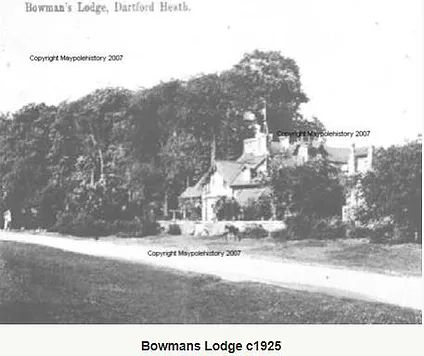
The original house was called Bowmans Lodge and two hundred years ago was the regular meeting place of the Royal Society of Kentish Bowmen. This Society was instituted by Mr. J. E. MADOX in 1785 when he was once resident at Mount Mascal in North Cray. This is where the first meetings were held. At the formation only eleven gentlemen enrolled their names, but in 1786 their numbers increased to thirty. In 1787 the meetings were transferred to Bowmans Lodge and they would meet opposite the lodge to practice their sport. It is interesting to note that of the original members their is a reference to Simon FRAZIER and S. FRAZIER junior. This person is also referred to, in this account as having been once an occupier of Baldwyns Manor. In 1787 the membership totalled sixty one.
They would meet every Saturday morning on the heath during the months of May, June, July and August. Shortly after the transfer to Bowmans Lodge the Prince of Wales became a patron and the numbers swelled to one hundred and twenty three. Extract from DUNKIN History and Antiquities of Dartford:- " The heath became the favourite resort of youth and beauty assembled to behold the splendid costume of the members, and witness their skill in archery, particularly on target days.
In January 1789 His Royal Highness having been elected President issued an order for the following uniform to be worn by every member of the society :-
A grass green coat with buff linings, a buff waistcoat and breeches; black collar uncut velvet in winter; tabby silk in summer, with yellow buttons according to pattern sent to NUTTINGS, 16 King Street, Covent Garden. By the established rules, a white dimity waistcoat and breeches might be worn at all meetings, but the uniform coat was indispensible, together with an R.K.B. button with a gold loop to a black round hat, and small black feather, without which no member was allowed to shoot. The fine for non conformity was 7s 6d .
The meetings were accompanied by appointed standard bearers in full costume. Every target day the entire gathered membership would walk in a procession to the allotted ground
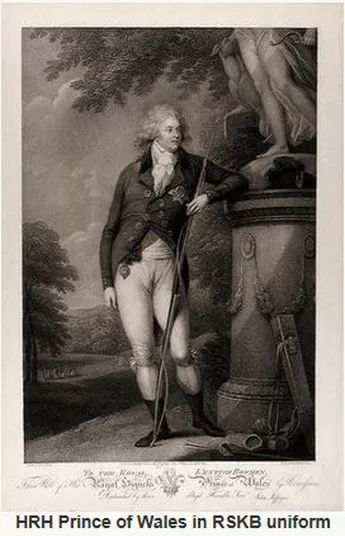
Every member on election would pay ten guineas. The annual subscription was £1 11s 6d. In addition he would pay one guinea yearly for his four largest dinners. The greatest part of the society ungallantly professed celibacy; for in a splendidly bound manuscript book of their accounts is an entry, wherein each member engaged to pay a "stipulated fine of £100 upon committing matrimony " The house was traditionally said to have been the scene of many midnight revels and orgies.
Prior to the break up of the society in 1802 the members fitted up one of the rooms in which they frequently acted plays and other dramatic pieces, to which the inhabitants of the neighbourhood were invited by tickets. They also gave a grand ball on Shooters Hill, at which most of the gentry attended - the three daughters of Sir John D Y K E of Lullingstone Castle attended this. It is purported that a large mirror once belonging to the Prince of Wales (which had once come from this house) was presented to the landlord of the Bull Inn at Dartford
Death of FOOKS - who lived there after the Toxophilites - as reported in the South Eastern Gazette August 12th 1899
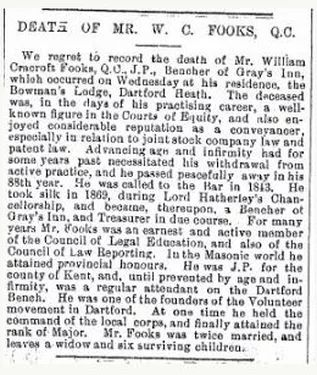
Court case regarding damage to one of Fooks' trees - South Eastern Gazette June 17th 1876
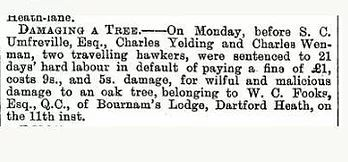
The below courtesy of James Smith from Facebook 'Dartford Remembered' page. Possibly c1960s.
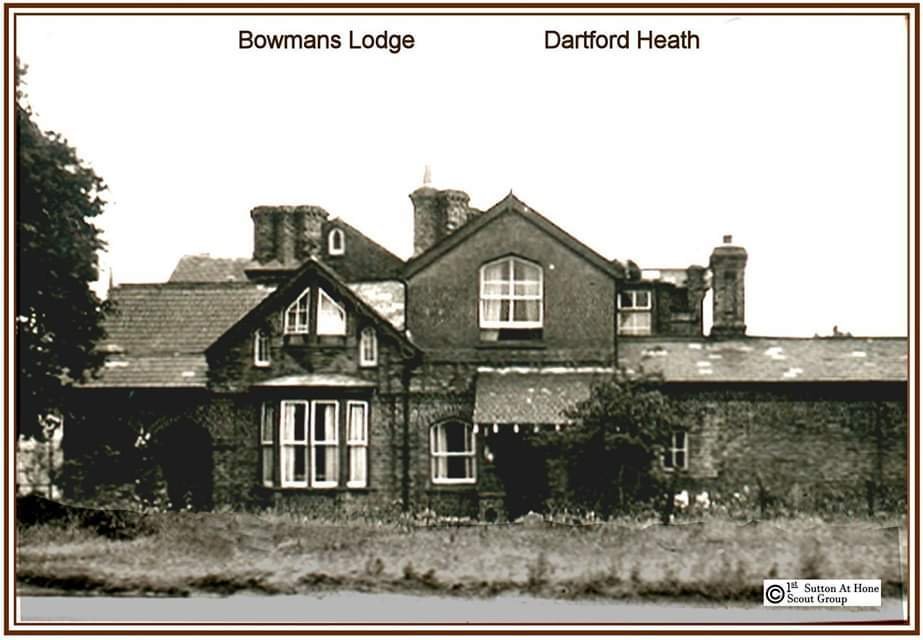
Dartford Heath and Leyton Cross
There wasn't originally going to be a page on the heath - but it featured so much in the history of the Maypole Estate that we shall begin one . . . .
Leyton Cross is temporarily hyperlinked further down the page.
The below is courtesy of Wikipedia - extracted 7/10/2018
"Prehistoric barrows, and Stone Age and Bronze Age artefacts have been discovered on Dartford Heath in some abundance.[2][3]
The heath has been important to local people since medieval times as common land;[1] it therefore escaped enclosure during the late 18th and early 19th centuries, however during this period the heath was owned by the Tredegars and it was heavily excavated for granite, chalk and other natural resources. Many pits and holes were observed in the 1830s, some "[15 or 20] fathoms deep. At the mouth and thence downward they were narrow, like the tunnel of a chimney or the passage of a well, but at the bottom enlarged; and some had several rooms or partitions, strongly vaulted and supported with pillars of chalk".[4]
Sir Charles Morgan Robinson Morgan (1792–1875), 1st Baron Tredegar, owner of Dartford Heath
They were believed to have originally been dug for the removal of chalk, which was used in building, and in fertilising agricultural land. In his History and Antiquities of Dartford, John Dunkin quoted historian Edward Hasted, “on the authority of Tacitus”, that it was “most probable that some of them were used as secret hiding places by our Saxon ancestors, for their wives, children, and goods, in times of civil war or foreign invasion”. He added that (by 1844) “most of [the holes] are now stopped up, and thus accidents which heretofore occurred both to man and beast, are prevented”.
Dunkin noted that the 1st Baron Tredegar, the lord of the manor and owner of the heath, had restricted the public’s right of way, though his tenants were allowed to graze cattle there. In 1832 a special Court Baron was held to temporarily grant to the church wardens of Dartford, in trust, some acres of common waste land on the heath for the employment (by himself) of local poor persons, and to affirm that for, much of the remainder of the heath, the public should be given right of common. However, extensive granite, chalk and turf extractions continued until the Law of Property Act 1925 severely restricted the right of lords of the manor to deface common lands as they saw fit; at which time Courtenay Morgan, 1st Viscount Tredegar, sold the heath to Dartford Urban District Council and much of the excavation works in the area ceased.
Large dips and mounds are still visible as a result of this work[5] and its associated industries. In the 19th century, towards the north of the heath, a series of parallel mounds known as the Glory Bumps were left after the extraction of clay for use in brickworks.[6]
The first recorded local cricket match took place at Bowman's Lodge in 1723;[7] and the Society of Royal Kentish Bowman, whose members included the future King George IV, met here between 1785 and 1802.[8] The nearby area is still known as Bowmans.
Soldiers were stationed on Dartford Heath in 1779-80,[9] and again during World War Two when a Royal Artillery anti-aircraft regiment was stationed there - the camp's tarmac roads are still in evidence.[10][11]
The heath today[edit]
Footpath leading from Old Bexley Lane into a south-western corner of the heath.
Since 1925 the heath has largely maintained its shape and character, except for the areas destroyed by the building of the first Dartford bypass (Princes Road), circa 1930, and the A2 dual carriageway in 1973, which cut off Leyton Cross and the southernmost parts of the heath from the north.
The heath contains three ponds (Donkey Pond, Woodland Pond and North Pond), though they have occasionally dried up in recent years, and a variety of habitats: including acid grassland, broadleaved semi-natural woodland (including oak, birch, hawthorn), heather and gorse, as well as open grassland.[12] Dartford Heath is used as a local recreation area, particularly for cyclists and dog walkers, but can be adversely affected by proximity to the local refuse and recycling centre on Old Rochester Way, which sometimes leaves windblown rubbish along nearby roads.
Management is required to maintain the heath's traditional horticulture. Efforts are centred around reduction of scrub encroachment, fire prevention, and trials to re-instate heath vegetation. The site is in a Countryside Commission stewardship scheme.[13]
While skateboarding and other pastimes have long been banned,[14] the heath was for some 80 years a designated model aircraft flying area. However permission was revoked in 2003 after a teenager died from head injuries when she was accidentally struck by a plane."[15][16]"
-------------------------
Info about Leyton Cross and the anti aircraft site from Wikipedia
--------------------------
Below - a view of the heath looking towards the Bexley Asylum c 1910. Note the trees on the right. This is the site of where houses were built along an unmade road called 'The Dell'. The child sitting in the centre of the image is probably just to the left of where Denton Road ran and is now in the middle of the new A2 - well, built in 1970 ! - and probably in the centre of the footbridge now over the A2
"Bexley Asylum" from Dartford Heath Postcard - picture Tony Kinson courtesy of the Bexley Hospital website
Nurses home not in foreground of tower - therefore pre 1928.
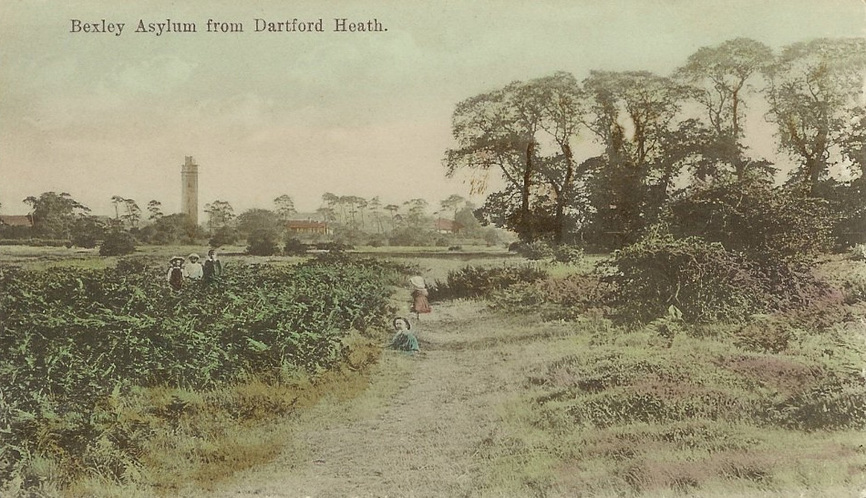
Below - similar shot from the driveway to Maypole House c1930 - nurses home below tower built c1928.
Photo courtesy Brian Porter

Below - Denton Terrace in background - courtesy Brian Porter
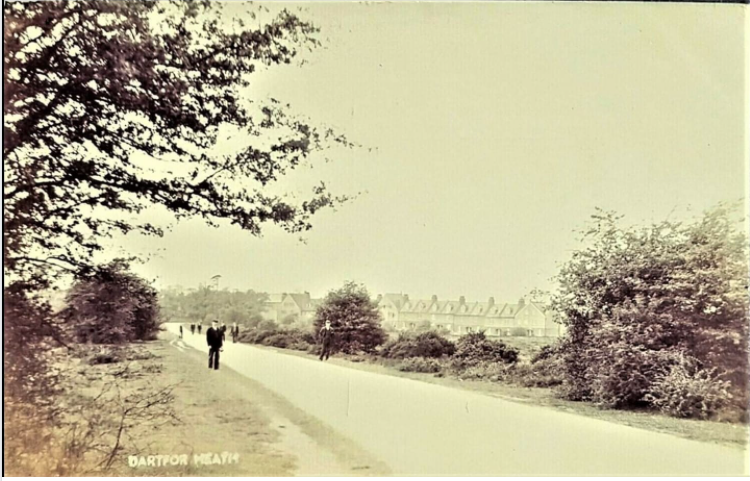
Below - Brick Hill Wood, Dartford Heath - location now known to be just North of the Dartford Golf Course and South of Heathclose Road.
Courtesy of Brian Porter![[Untitled] [Untitled]](https://static.s123-cdn-static-c.com/uploads/1523176/2000_5bae43393501d.jpg) Below - Heathside, Dartford Heath courtesy of the late Brian Porter. The building to the left is Gravel Pit Cottage(s)
Below - Heathside, Dartford Heath courtesy of the late Brian Porter. The building to the left is Gravel Pit Cottage(s)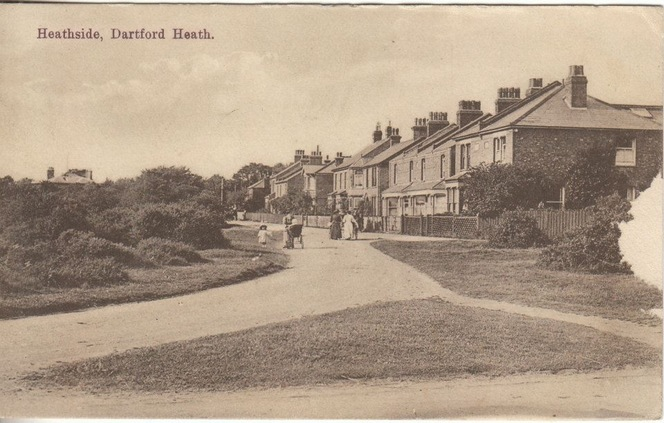
DARTFORD HEATH - A CHRONOLOGY
(Most of the initial information supplied on fact sheet from Dartford Library)
1660 On May 29th an address was given by King Charles II in a ceremony held on Dartford Heath. After this event had taken place several regiments of horse, under the leadership of General MONCK , escorted the King to London (DUNKIN p.386).
1723 Dartford played a cricket match against Tonbridge on the heath.
1726 Newspaper article relating to a dispute over a cricket match on the Heath between 'Chinkford' (Chingford?) and Dartford in the year of 1724. Kindly supplied by Perran Newman from publication Highways and Byeways in Kent by Jerrold (1907)
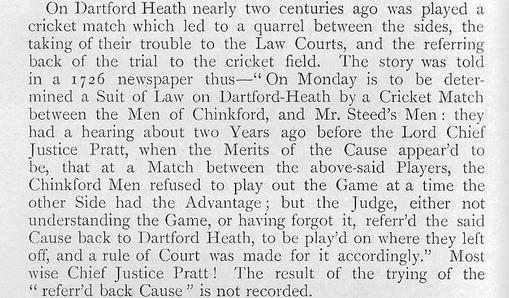
1780 The Army Camp - referred to in the Napoleonic Army Cmp.
1782 Charles SEYMOUR'S Topographical Survey of Kent reveals that Dartford was noted for its great cricket matches
1787 Royal Society of Kentish Bowmen moves from North Cray to Bowmans Lodge on the north side of the heath - later referred to.
c.1797 Reported that the heath comprised approx. 500 acres
1811 A customary tariff of 4d. per load of gravel and 6d. per hundred turf's was levied each time materials were removed from the heath.(Presumably paid to MORGAN - Lord TREDEGAR - who had manorial rights to the heath)
1832 An area of the heath was granted to the Churchwardens for the employment of the poor. An area on the east side of the heath was to have been enclosed but the plan was abandoned.
c.1844 Dartford Heath comprised 329 acres, 3 rods and 9.5 perches.
Below - Gypsies on the heath 1869
Copyright unknown
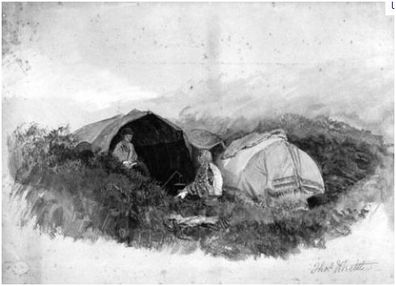
c.1874 Restriction limited to the amount of natural materials that could removed from the heath in any one year. Natural materials ( gravel, loam, turf, sand, peat etc. ) could only be supplied to residents of Dartford, Wilmington , Bexley and Crayford. This is already covered in the chapter relating to the history of Baldwyns and is described in the action taken by MINET v TUBBS.
1882 In 1882 a letter was published in The Star expressing concern at the general state of the heath which attracted visitors from Plumstead, Woolwich, Greenwich and other parts of London, as well as the local people. The letter mentioned efforts made by Lord TREDEGAR and local inhabitants to raise sufficient funds to pay for the services of a keeper. A keeper was appointed to discourage the unauthorised extraction of gravel, peat, loam and turf. It was reported that the loam was being dug out and carted to places as far away as Hertfordshire.
Below - The Gravel Pits - unknown date
Copyright unknown
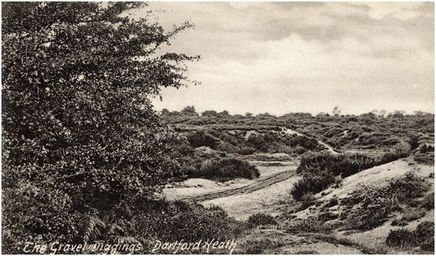
Below - the sandpits - note Leyton Cross houses in the background
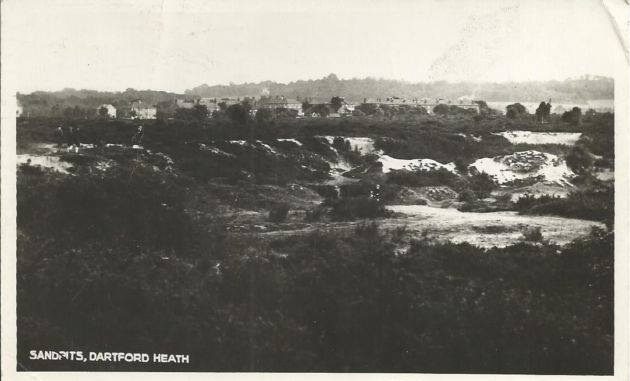
Below (Courtesy of the late Brian Porter)
THE MOLES HOLE
We believe that the map below this photograph shows the location.
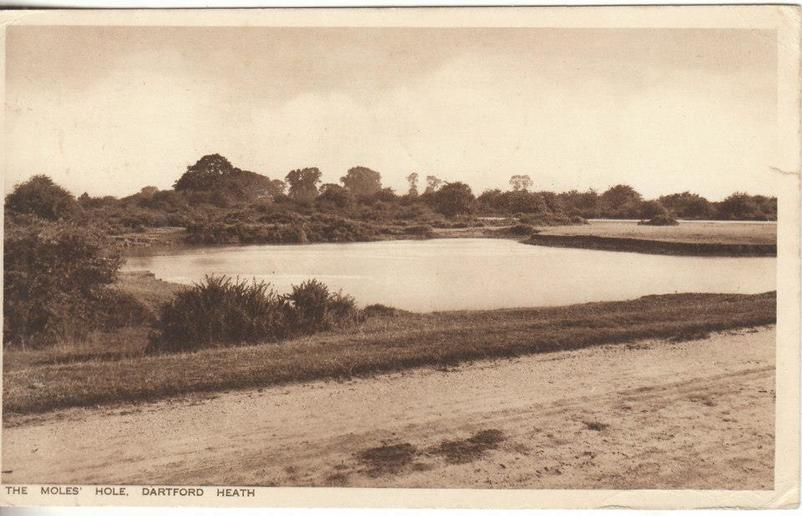
The below O S Map dated 1898 showing a blue 'pond' believed to be The Moles Hole.
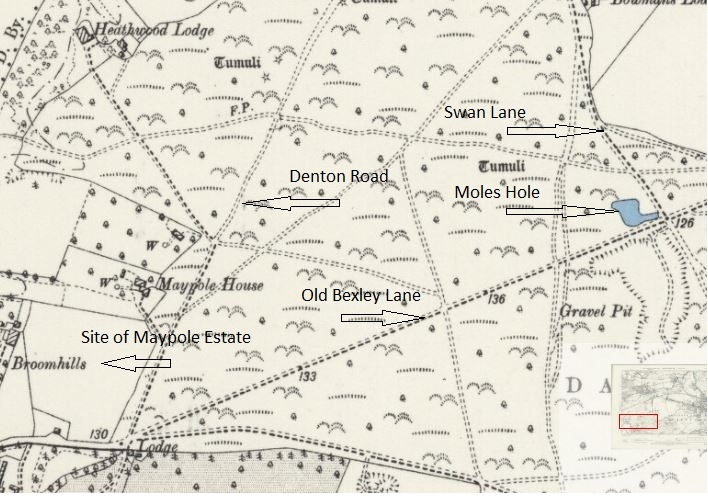
Below from Brian Porter - note Bexley Hospital Tower in background. The angle of the shot indicates the photograph was taken in the vicinity of Heath Close and the 'Glory Bumps' gravel workings.
![[Untitled] [Untitled]](https://static.s123-cdn-static-c.com/uploads/1523176/2000_5bae42fbe07a9.jpg)
1907 A geological excursion to Crayford and Dartford Heath was organised on Saturday, May 11th 1907. A report states that this excursion mentions the mounds found on Dartford Heath. These mounds were investigated by the late well known archaeologist, F. C. J. SPURRELL ( presumably in the late 19th century ) but nothing was found inside them. The excursion report proposed the idea that because implements, hearths and gold ornaments had been found nearby, some connection might exist between the mounds and a prehistoric settlement on the heath ( this has never been proven C.R.B.).
1925 In 1925 Dartford Urban Council obtained Manorial Rights from Lord TREDEGAR for the sum of £1000. This was, no doubt, influenced by the Law of Property Act 1925. This Act limited the amount of 'Common Land' owned by a Lord of the Manor to be fenced off and used for monetary gain etc. Once the Heath was no longer economically profitable, it would no doubt, have been a financial burden to the owner. Therefore the charitable act of selling it to the Dartford Council was a very reasonable option.
1927 Bye Laws relating to Dartford Heath were introduced.
1930 - murder on the heath.
1934 H. F. BURTON, F.S.A. of University College London and L. C. TOMLIN excavated a number of mounds on Dartford Heath in the summer of 1934. Nothing of historic interest was found, but their excavations proved fairly conclusively that the 'earthworks' and 'hut circles' belonged to the late 18th. century ( The Army Camp ? )
1935 Survey of features on Dartford Heath by E. L. MANN and D. G. GRANT-KING. ( Museum Collection )
1939 - 1944 Anti aircraft guns were installed on Dartford Heath near Leyton Cross
1940- Dartford Heath Anti Aircraft camp Leyton Cross
3
1970 In 1970 plans were drawn up to convert Dartford Heath into a 'Country Park'. At this time the heath comprised 340 acres. 1971 In 1971 the North Kent Wildlife Preservation Society were involved with plans to establish a 'Nature Park' at Dartford Heath. 1987 Plans are being considered to increase the appreciation and use of Dartford Heath.
Below - Horse and Groom Public House, Leytons Cross - date unknown
Courtesy of the late Brian Porter
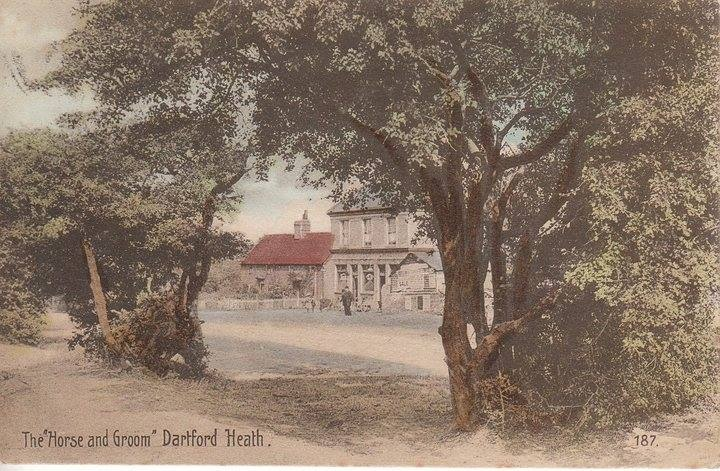
Donkeys on the Heath 1924 - courtesy Audrey Hughes
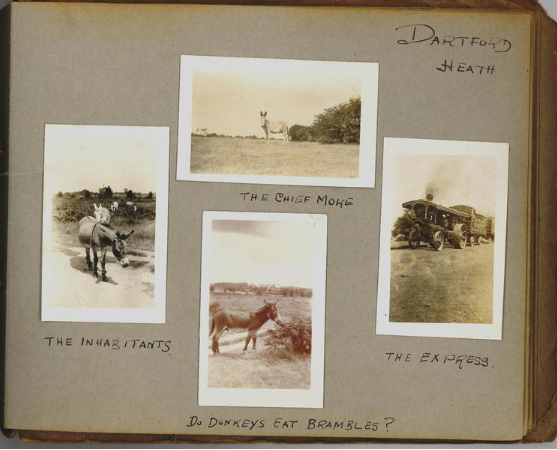
Below is a red roofed building - quite possibly 'Gravel Pit Cottages'
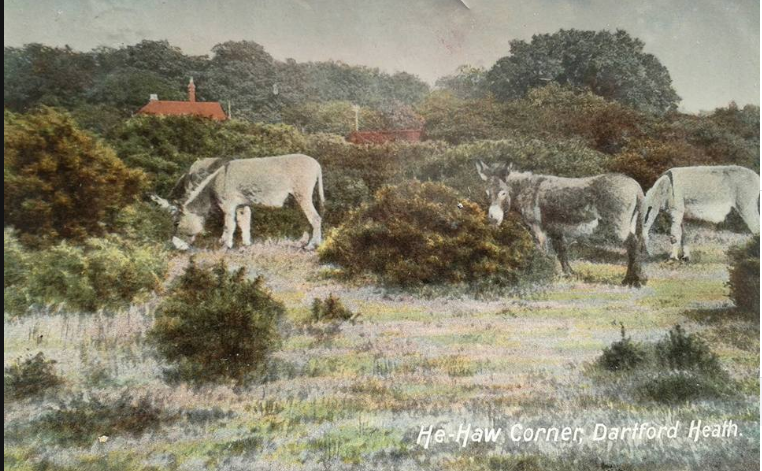
Below courtesy of Brian Porter - undated

THE DELL
Below - The Dell c1930s path leading up to the road called The Dell
Copyright unknown
![[Untitled] [Untitled]](https://static.s123-cdn-static-c.com/uploads/1523176/2000_5bae42fb11b52.jpg)
Below - another view c1930s looking towards Coldblow Crescent and the Stile
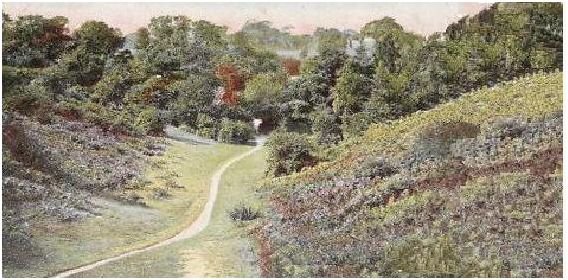
THE PADDOCK (WOLFE'S GLEN)
Below - Wolfe's Glen. Known by locals as 'The Paddock'. To the right of the photo and over the brow would have been the old A2 and then the Gun Club. To the left would have been the hill towards Heathwood Lodge. Straight ahead would have been in the direction of Hall Place, Bexley. Behind the camerman would be in the direction of Denton Road - near the junction with the old A2.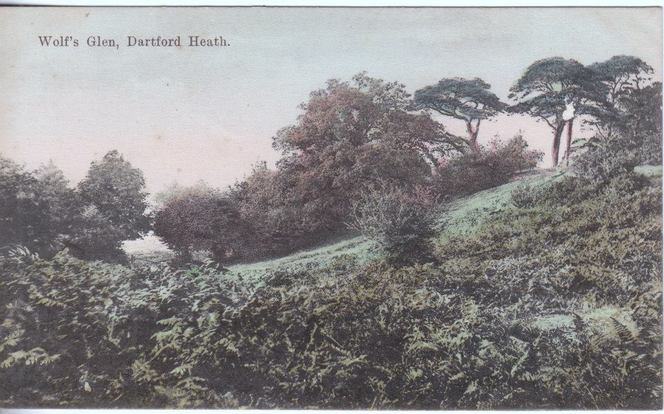
Below -
Possibly the same view as above c1890 ? But definitely described as Dartford Heath.
(Possibly 'The Dell', towards Coldblow, Bexley ? or 'The Paddock' looking towards the location of the Black Prince)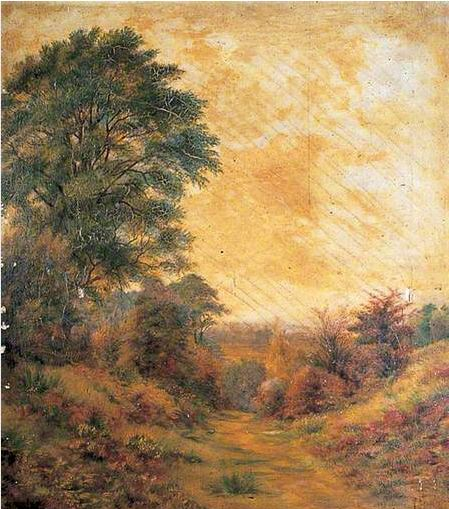
Below Dartford Heath (Unknown location) by Youens c1892
possibly Rowhill or Bexleyheath in the background.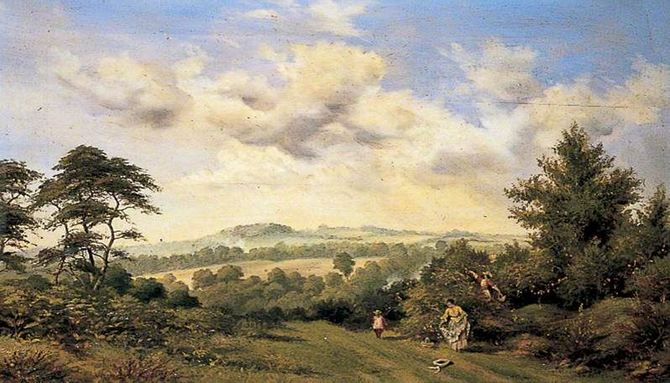
Below Dartford Heath - Chance Spring Woods by Youens 1893
These woods were just north of Madam Osterbergs College (Now West Kent College, Oakfield Lane)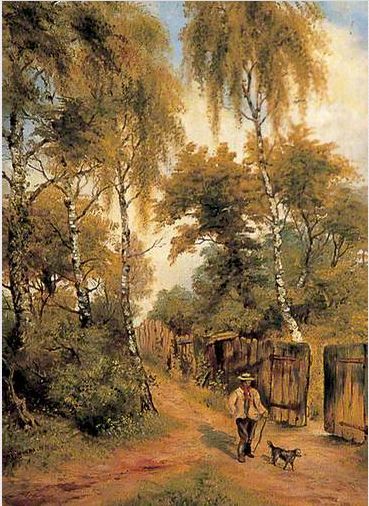
Below - the old Rochester Way on Dartford Heath. Denton Road to the left (towards Maypole Estate) and the road to the right to wards Crayford. Bexley to the rear. Lord Mayor of London's coach and horses Charter Day September 13th 1933 - courtesy of Christine Johnson - Facebook 'Dartford Remembered'
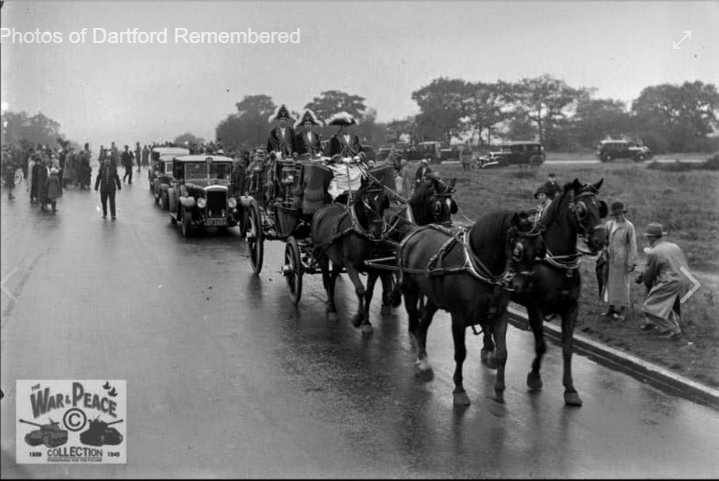
c1940s / early 50s - Tea Stall on the heath - situated on land opposite entrance to the Dell. It was owned and run by Mr and Mrs Houlton from Baldwyns Road, Dartford.
Courtesy of Denny Chandler
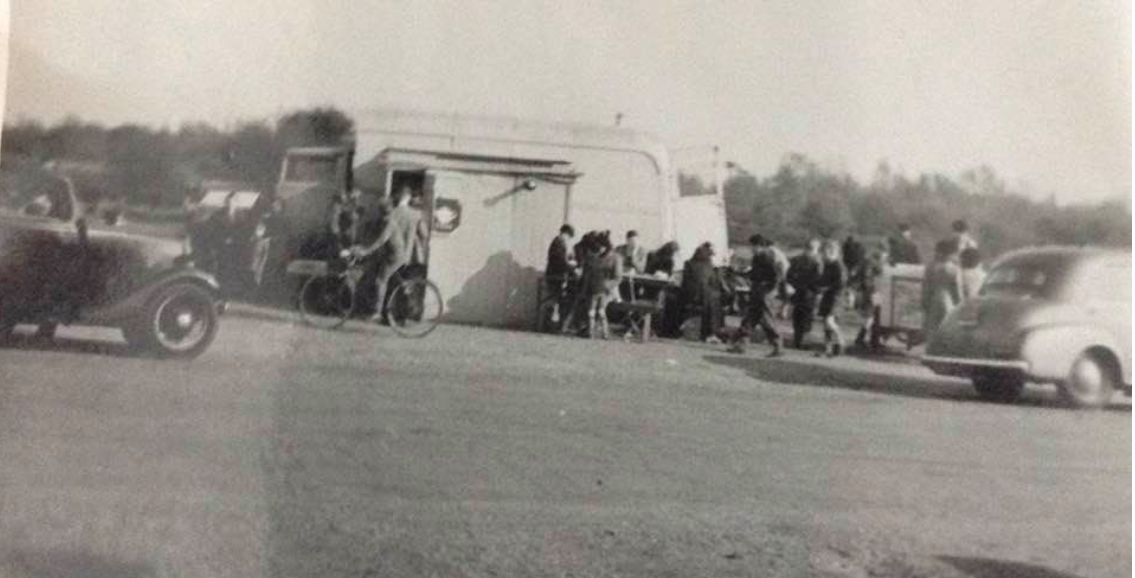
Dartford Heath - the Glory Bumps
The Glory Bumps
The Glory Bumps (and they are glorious for riding bikes / pushing your zimmer over) still exist on the heath near Heathclose Road and Shepherds Lane. The story goes that they are the last frantic remnants of those excavating sand and gravel from the heath. Instead of digging a quarry - the quickest method, it is also said, was to dig a trench and toss the spoils to one side. See the reference to Baldwyns as it was Charles MINET, back in c1874, who took the Lord of the Manor to Court to stop destruction of the heath by such methods.
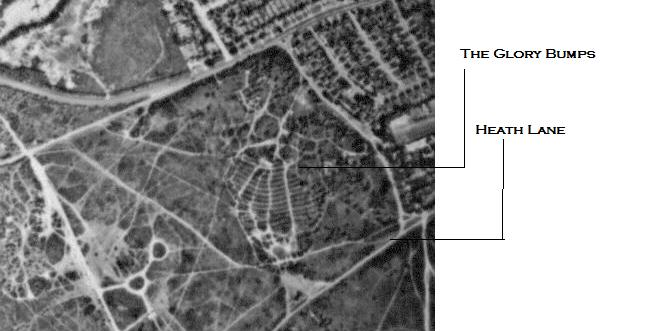
The above photo (taken May 61) clearly shows the lines of excavations forming what is now called the Glory Bumps
In the years following closure as a quarry they provided an expansive playground for children from all over the West Dartford area, including those from the Maypole Estate.
John Burton (one of our readers) advises:
Lee Smith was asking what caused the glory Bumps , In the 1840's My wife's 2nd great grandfather .Thomas Smith was a Brickmaker On Dartford Heath, They needed Brick Earth ,a mixture of sandy clay to make the bricks, to obtain this they dug away the top soil 18"-24 "thick ,they piled this up in banks behind them , they worked in rows, once exposed they removed the brick earth ,up to 6' thick , when they had worked the row , they moved forward again removing the top soil again placing it behind them , a bit like double digging , and there you have the glory bumps usualy in. quite striaght rows, if you look carefully.
Just down the road in Upper Heath Lane about where the garage is today was a Public House called The Brickmakers Arms,Which my wife's 2 nd great grandmother Tabitha Reynolds was the licencee.
Brickmaking was thirsty work and no doubt, on a hot day they had a bit too much to drink , therefore explaining the sometimes uneven bumps. She had 9 Children by Thomas Smith but never married him , but it seems a stable relationship, their children were all called Reynolds Smith as a Surname , on his death at an early age of 56 he left all his children and Tabitha a tidy sum and his brickmaking business in trust for the benifit of his Family ,being run by his son William Reynolds Smith , who died in 1916 .,It continued on as a Gravel Extraction company for a few years after this along side Upper Heath Lane where Vale Road is Today untill the gravel ran out .
So now you know Lee , and maybe YOU are one of these SMITH'S. Thomas Smith is Buried in St Paulinus Church Crayford, Tabitha and his children ar mentioned on the head stone .The Brickworks was on the site now occupied by DARTFORD GOLF COURSE.
Little did those Brickmakers know how much joy they have given to countless thousands of children riding their bikes across those bumps
Dartford Heath - The Dell
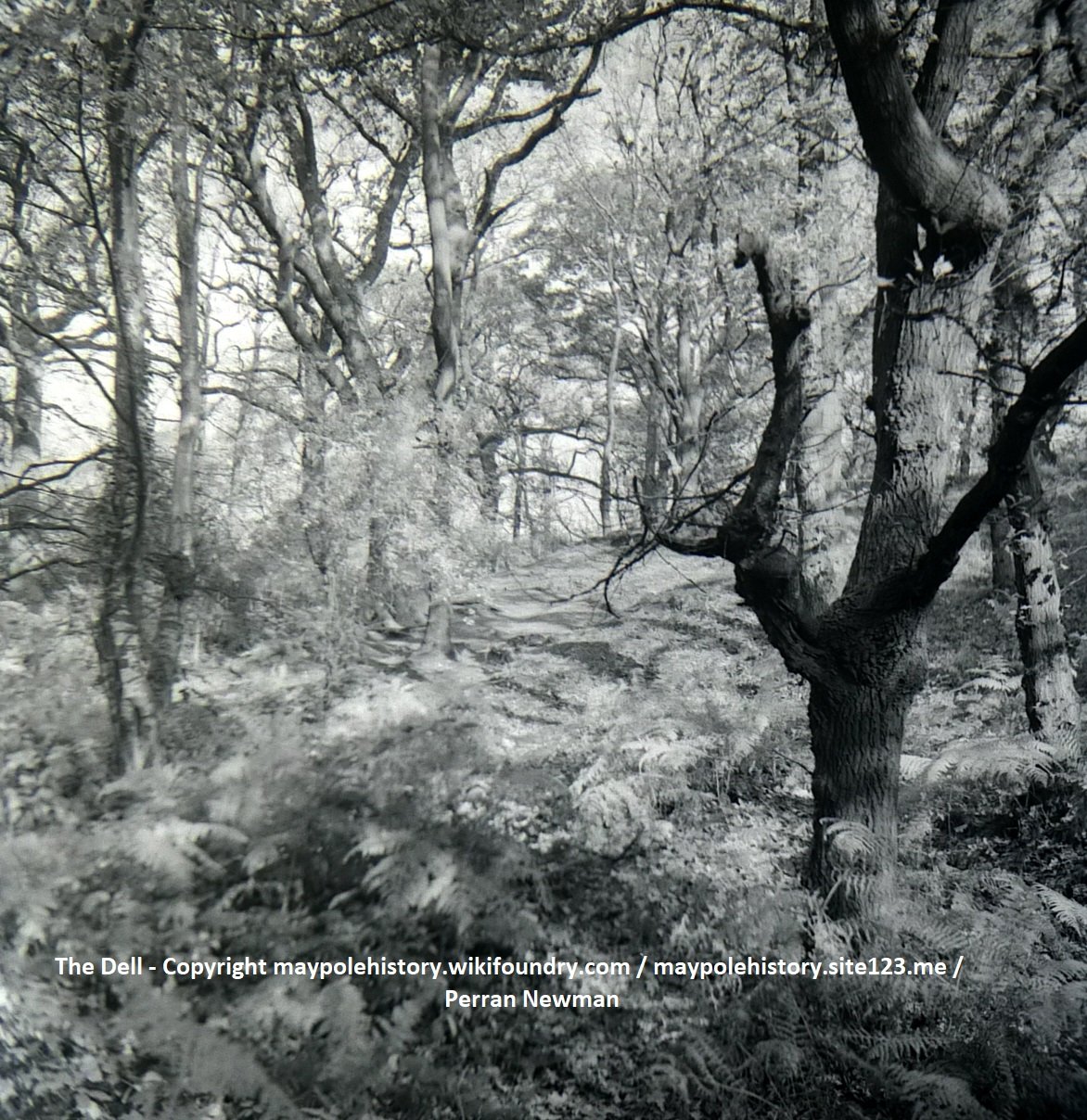 Above - The Dell in the 1950s. Supplied by Perran Newman
Above - The Dell in the 1950s. Supplied by Perran Newman
The valley of the Dell still exists in an almost 'untouched' way. It lies East to West between the stream (that runs North to South from Baldwyns Park towards the A2) and towards the direction of Denton Road. It formed part of what was once a main footpath from Bexley to Dartford over the heath. The earliest Ordnance Survey maps confirm this. The Valley has only been heavily tree lined since c1940s. Before then it was mainly heather, grass, shrub, fern, broom and gorse. This was owing to the fact that the heath was common land and grazed. Early Edwardian postcards also evidence how well used this area was for recreational purposes. The Great Storm of October 1987 did much to reduce the volume of trees but it is now nearly back to it's former glory.
Below - location of the valley of the Dell - most photos below were taken from the left point of the triangle looking left towards Coldblow and Wansunt.
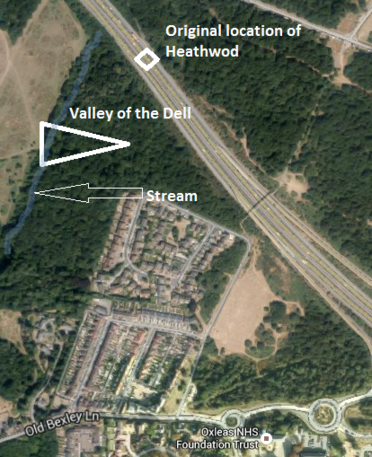
The video footage below is a walk down the path from the direction of the old sandy road which once led from Denton Road to Heathwood Lodge. The old sandy road was once wide enough to facilitate the delivery of coal in lorries etc to the large Victorian residence. Certainly until the late 60s vehicles still drove up and down allowing passengers to either picnic or canoodle ! The sandy road is no longer distinguishable. All that is left now is a very narrow path inching between high bushes. This video was taken in Spring 1988 - just after the Great Storm of October 1987. There is much debris and - uncanny sunlight from above !
This end of the Dell is the furthest end from the stile which crosses the stream between Coldblow and The Heath and the opening still scene is pointing in the same direction as that of the photograph below.
Below three images
The valley of the Dell cearly 1900s. Looking towards Coldblow. The stile over the stream still exists (though not the original) and lies roughly where the light patch is in the middle of the trees.
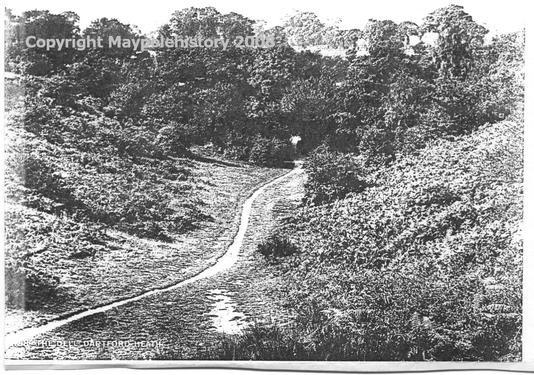
![[Untitled] [Untitled]](https://static.s123-cdn-static-c.com/uploads/1523176/2000_5bb894625f697.jpg)
Above photo courtesy of Brian Porter
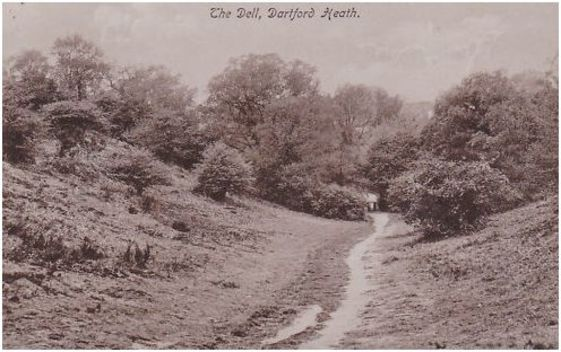
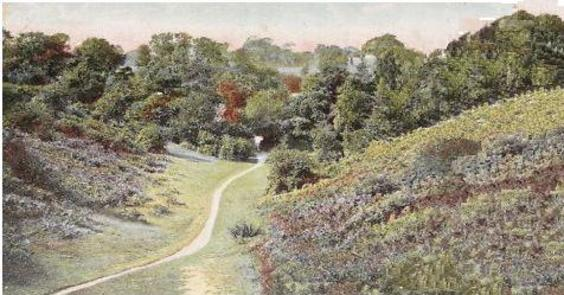
Below courtesy of Brian Porter
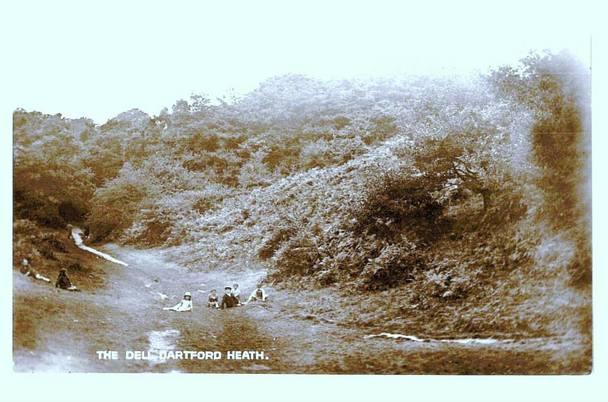
Below courtesy of Brian Porter
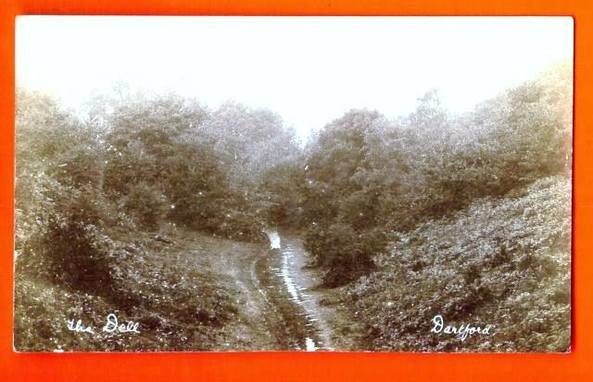
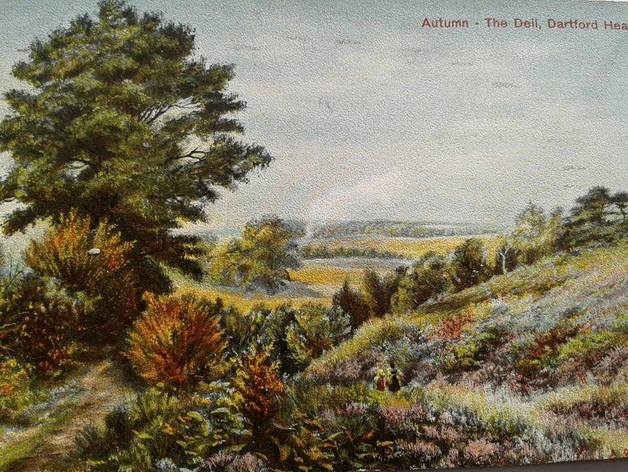
The below is a painting by Youens c1892 of a scene from Dartford Heath - could this be the Dell or the Paddock ? It matches the contours and general vegetation of the time
![[Untitled] [Untitled]](https://static.s123-cdn-static-c.com/uploads/1523176/2000_5bb8948dcc896.jpg)
Below - shot taken (c. early 20th century) looking away from the stile and towards where the above photos were taken from
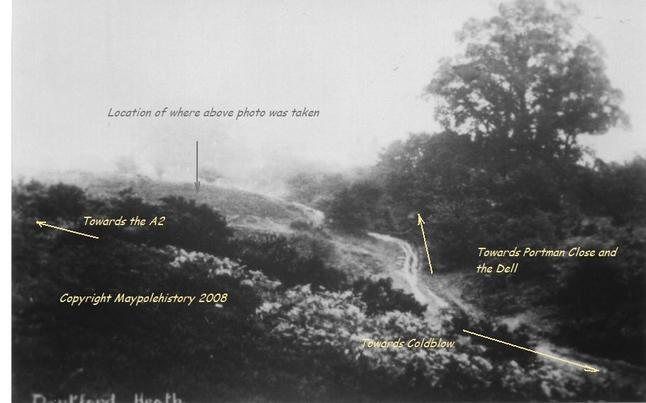
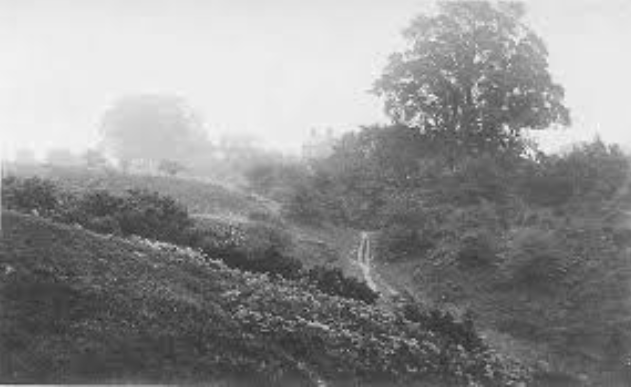
Below (c1950s) showing the large tree in the photo above
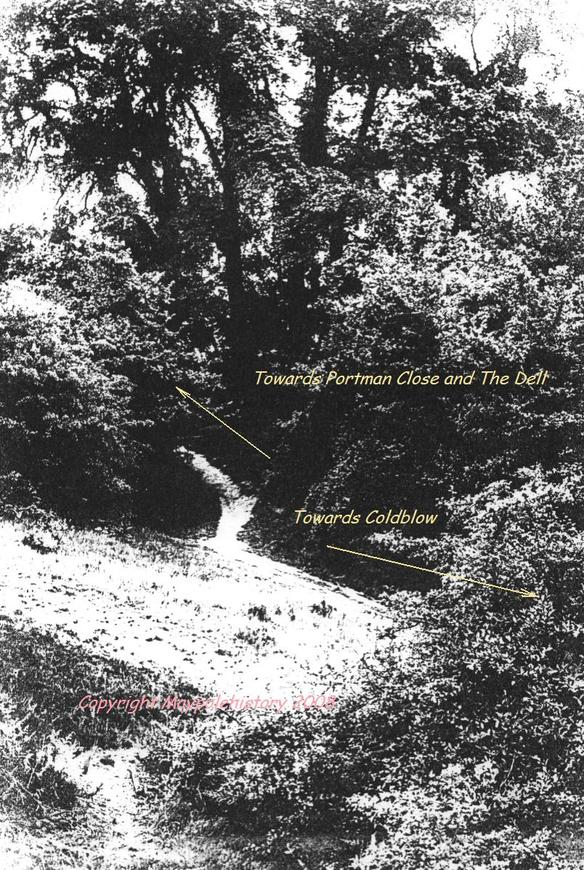
Below - The Dell 1950s looking East - image supplied by Perran Newman. The far hill, straight ahead and clear (now covered in brambles, bushes and trees) was a favourite place for children to make slides in the snow and ice of harsher winters gone by. We played well into the dark as the snow had luminosity all of it's own !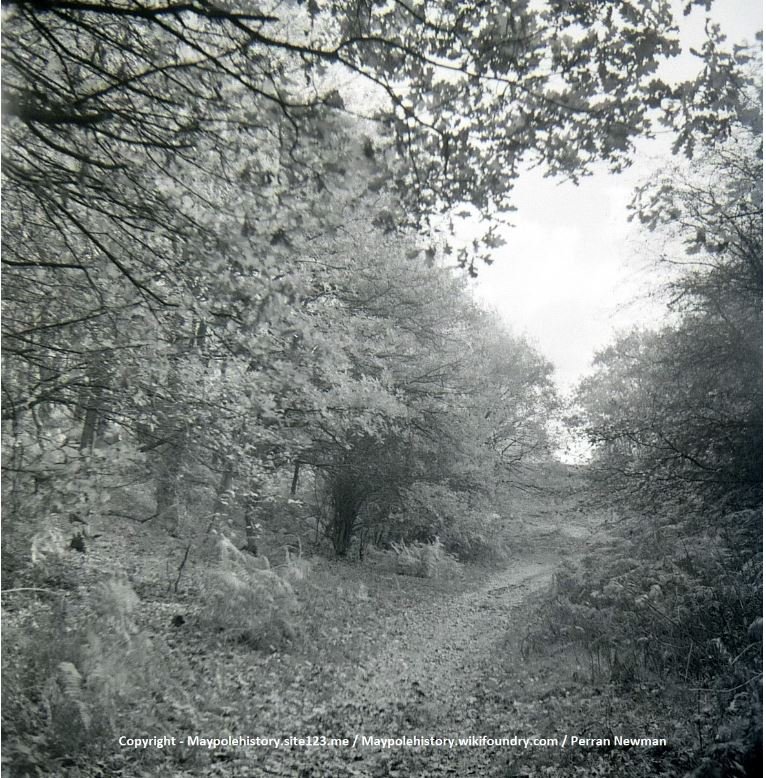
Below 1988 - the Spring after the Great Storm - at the foot of the three hills running up to Portman Close and Denton Road direction. 1. Towards the A2 - first path 2. Middle path (now overgrown) 3. and 4. Middle path and path to Portman Close
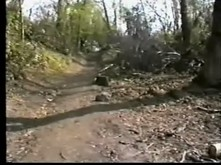

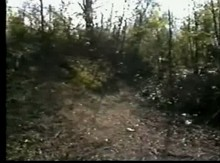
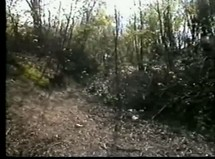
Below taken 1988 - original rope placed in the fork of an upper bough where children of the 1950s / 1960s swung out across the Dell. The black rope was the original.
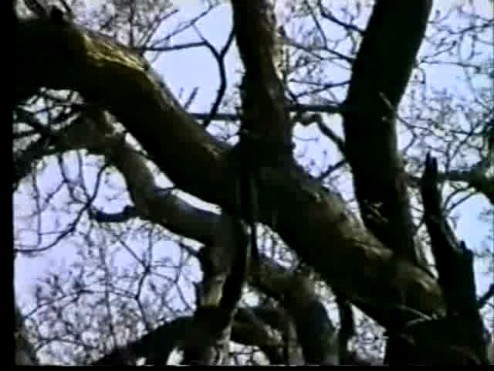
Below taken 2005 with additional ropes
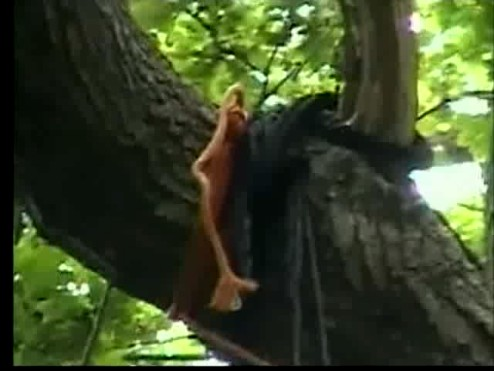
Below the base of the tree
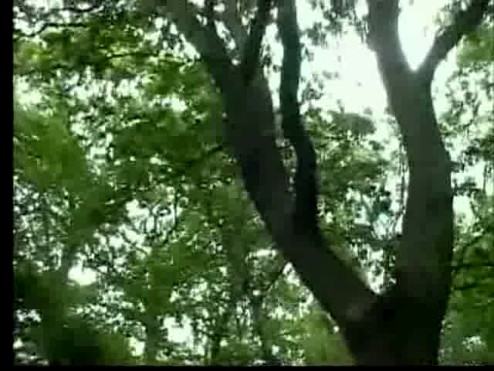
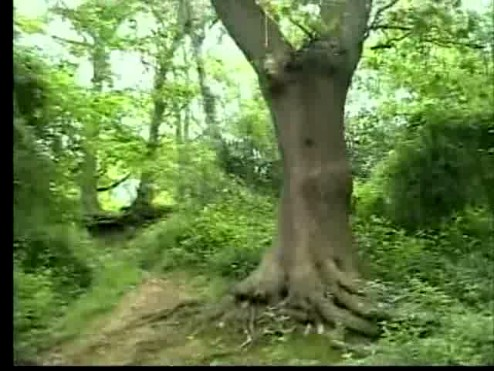
Below - taken April 2018 and the one below that nearly 40 years previously
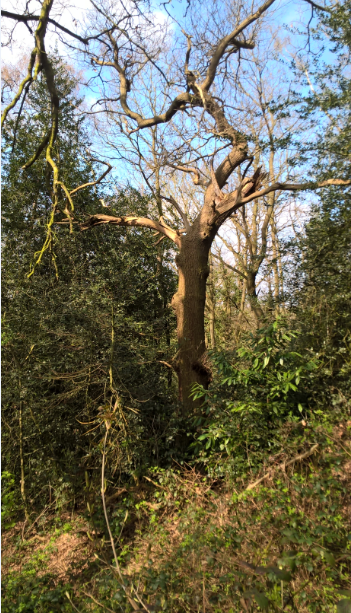
Below . . . . . . and in April 2018 - probably some 70 years after the first rope - a rope still remains !!!!
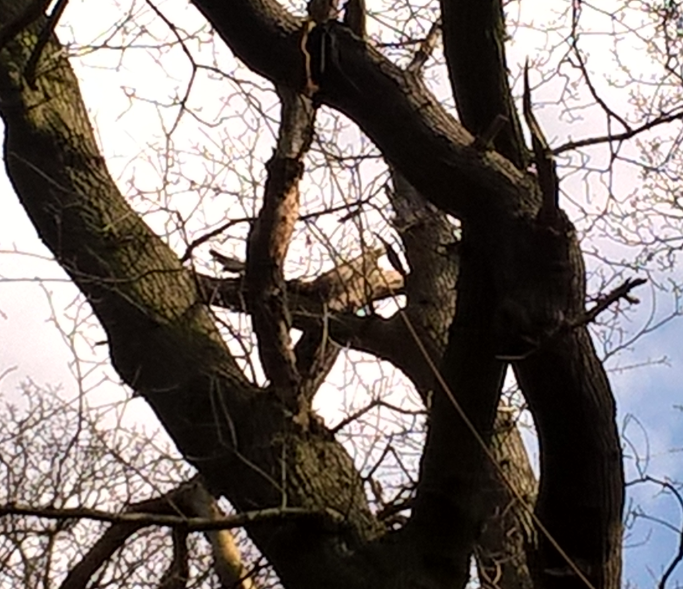
Below - courtesy of Fred Perkins, same tree and taken many, many years ago in 1969.
![[Untitled] [Untitled]](https://static.s123-cdn-static-c.com/uploads/1523176/2000_5bb894804dbfe.jpg)
The Dell - the old houses
The road called the Dell once formed part of the Baldwyns Manor Estate. The lands of Baldwyns Manor were auctioned off c1874 and partitioned in preparation for development.
Below - kindly supplied by Nigel Goldup - The Dell in winter before the 'Old Houses' were demolished looking towards Denton Road and the heath - date unkown.
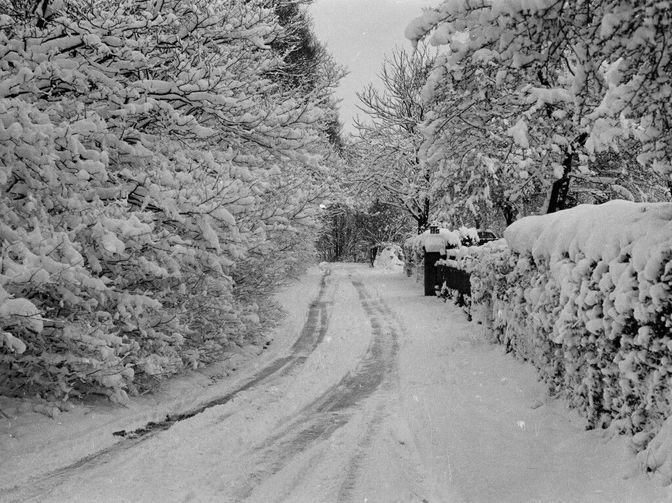
Before the modern houses of The Dell, Portman Close and Heathwood Walk there were the properties of Maypole House and four large houses. Before them there was just Maypole Farm.
Directly below shows the large houses x 3 1907
Below that shows the large houses x 4 which existed c1961 - from left to right 'Hillington' 'Brackenhurst' 'Hawthorn Dene' and 'Elm Lodge'
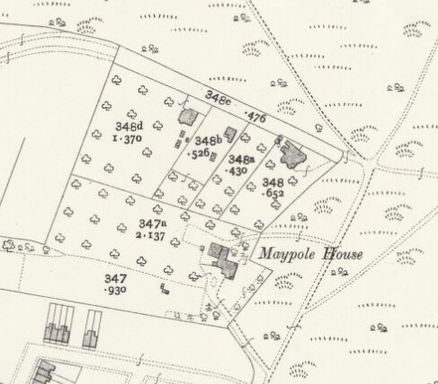
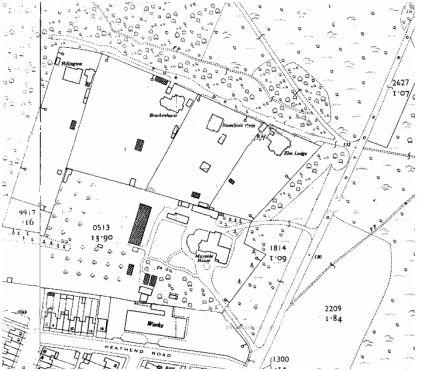
The four large houses fronted the current road called The Dell. That original road was an unmade road. The four large houses were very detached and had spacious gardens. The residents, by the very fact that they occupied them, were of a social stata above those who lived on the Maypole Housing Estate. By and large, and to most accounts, there was little fraternisation between those living on the Estate and those living in Maypole House and the Dell. Personal accounts reveal that gardeners, cleaners and domestic staff were employed from the Maypole Estate to service the needs of those living in the aformention properties. Some children from these large houses did attend Maypole School - but generally for short periods until they could be placed - or relocated - somewhere in the Public School system.
Below image kindly supplied by Nigel Goldup - undated.
The Dell - looking away from the direction of Denton Road. The front of old houses would have stood behind the boundary walls to the left.
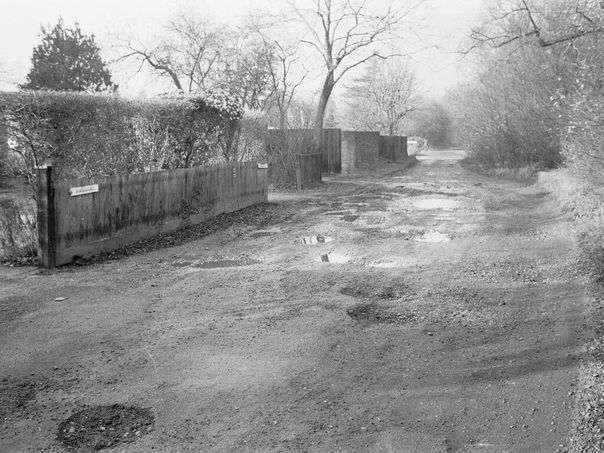
Below image kindly supplied by Nigel Goldup - undated.
The Dell - looking towards the direction of Denton Road. The old houses would have stood behind the boundary walls to the right.
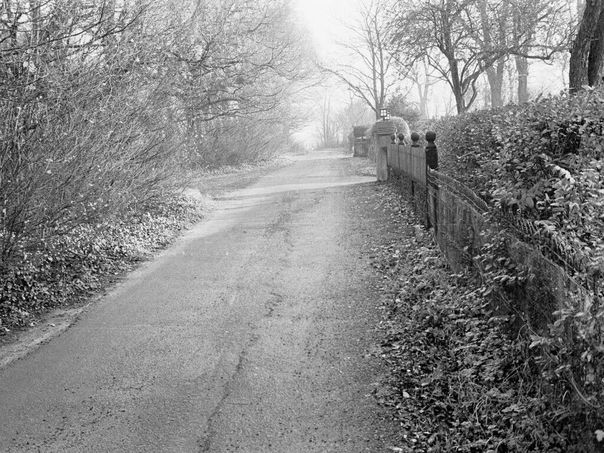
Below photo (Courtesy of Brian Porter) is a view from the heath looking towards Maypole Estate and see the Hospital Tower in the background. The rear of the cameraman would be in the direction of Crayford / the old A2. There is a line of 'demarcation' shown in the photo running from left to right. This was the old sandy lane leading to Heathwood situated in the direction of the right of the photo.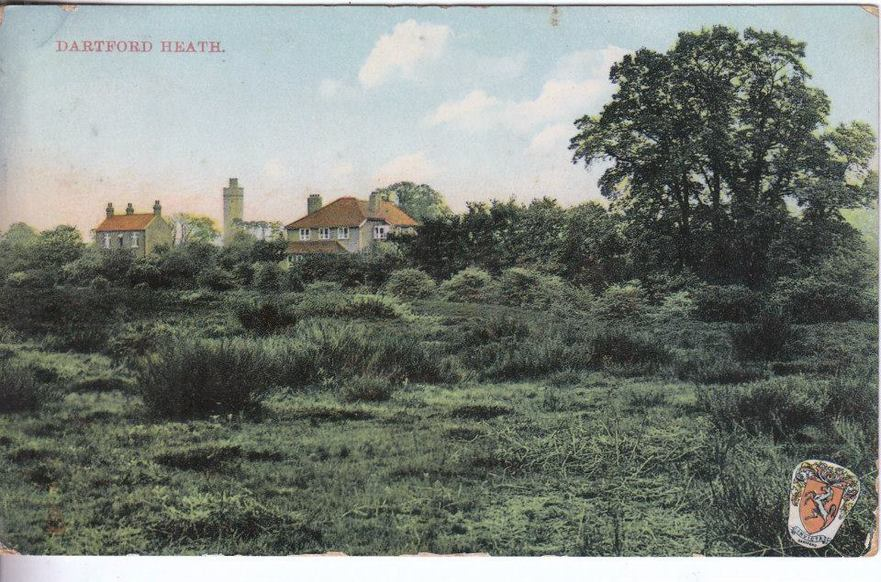
Elm Lodge
was the first house to be built in the Dell (OS Map 1890). According to the later OS Map of 1897 it still remained as the only house in that location. The voters register of 1900 shows the occupant / owner as Frank FELL who had an address of 3 Broad Street Buildings, Liverpool Street, London EC. Records show he had a shared interest in Elm Lodge and 11 acres of the Maypole Estate. It turns out they were developers and owned a share in the sub divided plots of the land where the housing estate was to be. His name is shown on title deeds of properties to be developed shortly after that time in Beaconsfield Road and Denton Terrace at roundabout that time.
The Kelly's Directory of 1911 shows a change of occupancy to the Rev. John BROWNHILL and as being the Chaplain of Bexley Asylum. During an interview with the late Winnie BLACKMAN c1991, she referred to the Rev BROWNHILL as a man she contemporaneously knew when she was a child. She said that children of the estate had heard a rumour that the Rev had a son who was 'deranged' and that the Rev had him locked up in the house ! This may have been sparked by the fact thast he was the Chaplain of Bexley Asylum. As a result, she said that local children were afraid to pass the house. She never expanded on the topic.
The 1911 census shows that there was a son aged 22yrs who 'Helped in the garden'. This is neither an occupation or a means of living so there may be some truth in what has been said about the capacity of the son.
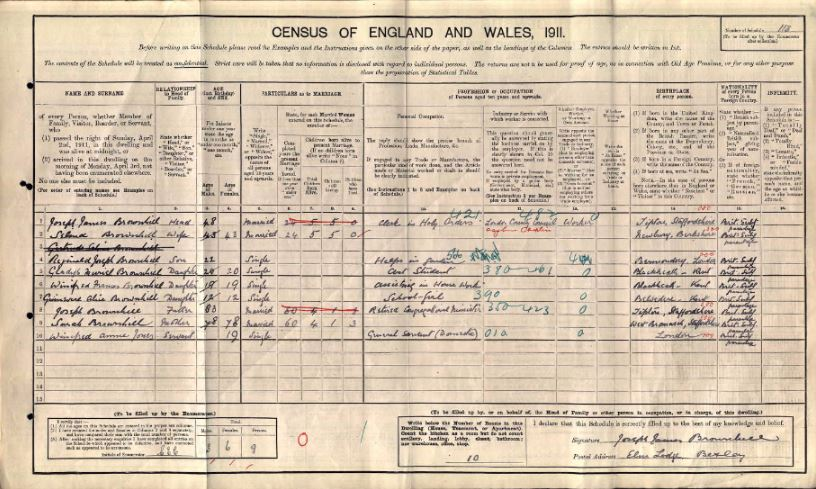
The next occupancy, according to the same directory in 1927, was Walter Frederick ESSE. The Voters register of 1937 showed the following, with the same family name, as living there - Frank, Mildred, Minnie, Frederick, Walter. Also Mabel FURNELL. The 1945 Voters shows just Walter and Minnie ESSE as living there.
The Maypole School Register then shows the next family living there as being the HUTCHISON family. Records of that register dated below reveals the following information
1954 - Diane HUTCHISON as being a pupil at the school and her father as being William
1956 - Charles HUTCHISON as being a pupil at the school and the father as being William
1967 - Vctoria HUTCHINSON as being a pupil at the school and and the father as being William
In the 1960s, William HUTCHISON / HUTCHENSON / HUTCHESON was often seen daily walking to and from his house along Denton Road. He suffered Parkinsons Disease and had difficulty in his movements. It is purported that he was once a high ranking officer in the army.
The Voters Register of 1958 shows Daphne, Jennifer and William HUTCHESON as being resident. The same register of 1968 shows Daphne and William as living there. Beyond 1968 we have no further records. The house was demolished to make way for the new development in the early 1970s.
.Hawthorn Dene.
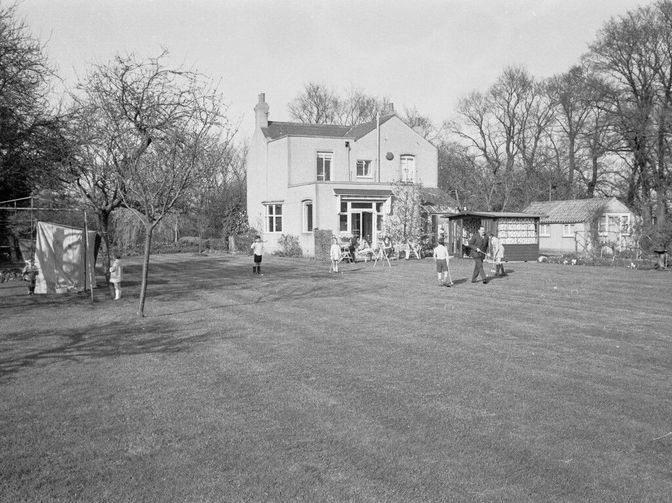
Above image kindly supplied by Nigel Goldup - undated.
The Voters Register (VR) of 1937 shows the following as living there - Olive BETHANY and John WARD. The 1945 VR shows the following as living there - Elsie and Stanley KENDRICK. The 1958 and 1968 VRs show the follwing as living there - Alice and Archibald WARR. Beyond 1968 we have no further records. The house was demolished to make way for the new development in the early 1970s.
Brackenhurst.
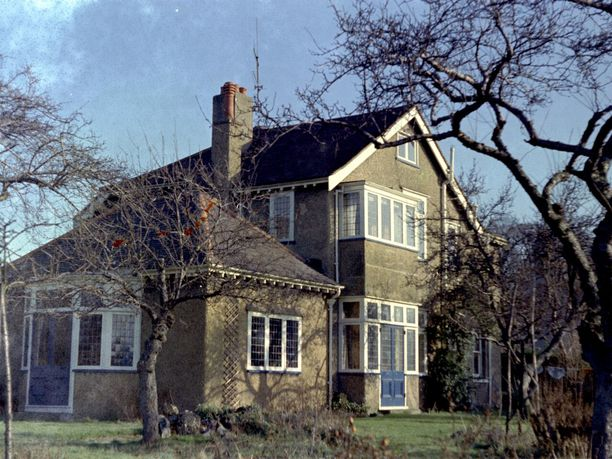
Above image kindly supplied by Nigel Goldup - undated.
The VR of 1937 shows the following as living there - Lorna, Arthur, Mary and Sylvia PAULIN. The 1945 VR shows Arthur and Mary PAULIN and Adelaide BOLTON as living there. The 1958 VR shows Erica and Sylvia CORNISH and John MEEK as living there. Piano lessons were taught by Mrs CORNISH at the house. The 1968 VR shows Erica, Marion and Sylvia CORNISH and John MEEK as living there. Beyond 1968 we have no further records. The house was demolished to make way for the new development in the early 1970s. It is interesting to note that the Maypole School Register (MSR) of the 1940s shows pupils, Bernice and Eric CORNISH, as living at Suffolk Lodge, Wansunt Road, Bexley. These names then crop up in the VRs of the 1950s as living at Brackenhurst.
The 1910 OS Map shows the above built - but not the below indicating the below was the last house to be built in the road.
.
Hillington.
The VR of 1937 shows Ronald, Willhemina and William ELLIS-BROWN as living there. The 1938 Kellys Directory shows William BROWN, Kenneth, Willhemina and William ELLIS-BROWN as living there. The VR of 1968 shows April and James CORNISH as living there. The 1976 VR shows April, Guy, Hazel, James and Jeffrey CORNISH as living there. Question - were they relatives of the occupants next door at Brackenhurst ? We are reliably told they are not.
Dartford Heath - Gruesome goings on
1868 Man sentenced to one month imprisonment for Indecent Conduct
(Extract South Eastern Gazette)
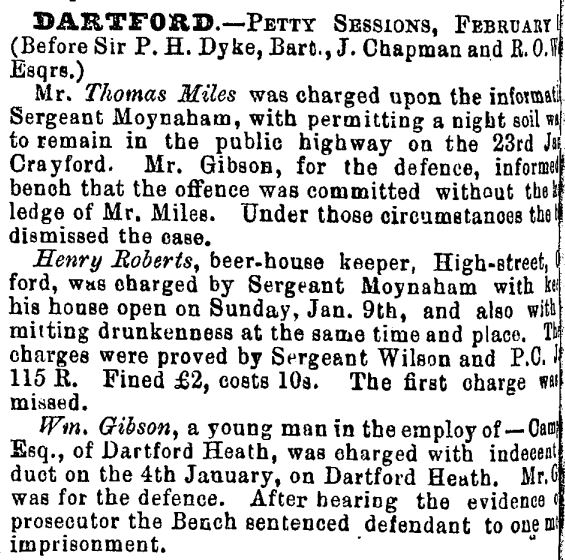
1874 Assault and conviction at Magistrates
South Eastern Gazette Monday 6th July 1874
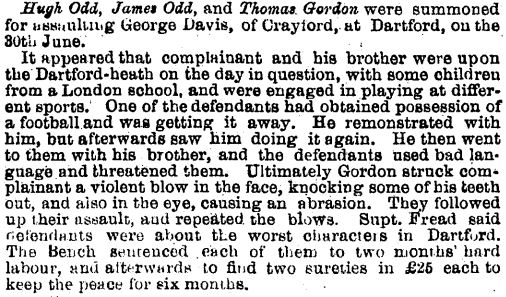
Murder on Dartford Heath
April 11th 1930
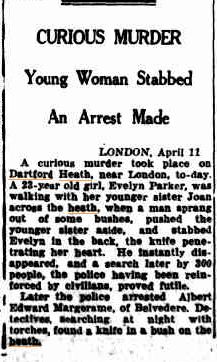

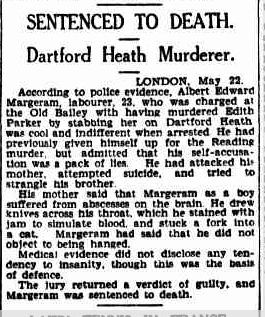
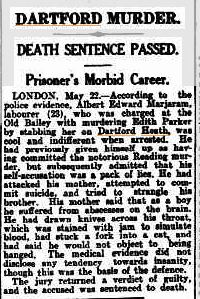
Below - the murderer
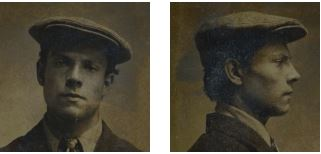
The fountain near where the murder took place - Heathclose junction with Heath Lane
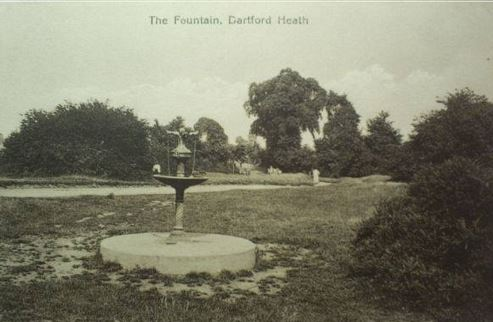
This link takes you to a more descriptive account and location of the murder
Student's Body Found
Newspaper cutting dated Thursday 5 September 1929 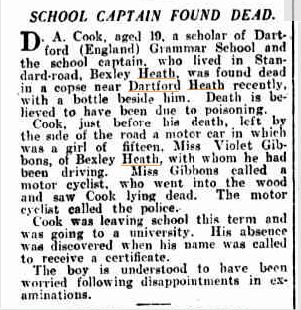
1853 December 13th from same Newspaper
Two brothers assault the third after a Poaching Incident
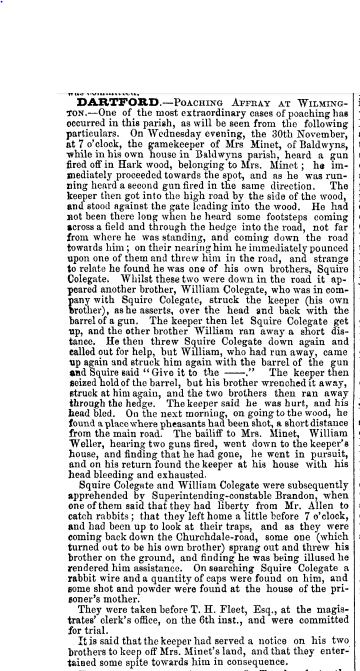
Confrontation on Dartford Heath, on March 1st. 1452
Confrontation on Dartford Heath, on the morning of March 1st. 1452
The below (and very comprehensive) narrative has been supplied by Bob Newberry.
The reasons for the confrontation on Dartford Heath, on the morning of March 1st. 1452, can with some justification be traced back to the preceding century and the reign of King Edward III. King Edward III was arguably one of the most successful English Kings and fathered many children. It is important to remember this last point as it had a major impact on decades to come.
As was the law of the land, Edwards’s eldest son should have become King on Edwards’s demise. However, his eldest son (the Black Prince) was already dead from one of these medieval bloody pox’s that seem so prevalent. The crown therefore passed to Richard, Edward III’s grandson (son of the Black Prince of course).
Richard II was a disaster, both indolent and capricious. He was almost certainly homosexual and elevated his ‘favourites’ to much high positions and showering them with gifts whilst at the same time insulting many of the established nobles of the land.
In 1399, Lord Henry Bolingbroke could take no more. Whilst Richard II was in Ireland, Henry staged a successful coup and became King Henry IV. He justified his action as his father was John of Gaunt, Duke of Lancaster, third son of Edward III. Thereafter, this line of succession was known as the Lancastrian.
The most significant thing about this ‘coup’ was that for the first time since the Norman Invasion some centuries earlier, God’s own anointed, King of England had been deposed. As it happens, Henry IV developed some sort of debilitating illness shortly after (probably leprosy) and didn’t reign for many years. Many people saw this as a sign of God’s wrath and were nervous at the upsetting of the natural order. But now the damage had been done however. If you were utterly convinced of your own unassailable royal bloodline, felt slighted (and it was very easy for a medieval lord to feel slighted) and you had ten thousand armoured soldiers marching behind, you might think seriously what your options were regarding the throne.
Things settled down for a while with Henry IV’s son, Henry V. This pin up boy won everlasting fame by knocking seven bells out of the French which played well with the home crowd and Londoners felt free to beat up those whom they perceived to be ‘foreign’. Actually, Henry V was not a pin up boy; he had a lurid scar down the side of his face from a war wound at the battle of Shrewsbury in 1404.
Henry V died young, succumbing yet again to the good old bloody flux, so his son Henry (VI) came to the throne at the ripe old age of 1.After years of infighting over the regency, causing many simmering feuds to come, Henry VI became of age and to be able to rule in his own right. Unfortunately, history started repeating itself. In an age where the main qualifications to be a medieval King, was to be a ruthless warlord and distrust everybody to keep self serving nobles in check, Henry had none of these qualities. He was deeply religious and spent long periods in silent contemplation or prayer. He much preferred architecture, spending prodigious amounts of money on building colleges at Eton and Cambridge. He loved hunting and writing poetry. More important, he abhorred warfare, being physically sick at the site of blood. During his ‘watch’, England lost all of its conquests in France except for the coastal strip round Calais. Henry preferred spending money on building projects to that of raising armies. The average medieval noble was prickly, easily offended and self-entitled. Nobles who had previously had free license to exhaust their male testosterone by killing, raping and burning their way through France were bitter and angry, now confined to England, over lands and revenue lost. It was a powder keg waiting to explode.
Henry VI trusted everyone and hated confrontation; he wanted everyone to ‘get on’. His way of dealing with dispute was to give parties involved, generous titles, gifts and lands, hoping they would just go away. Obviously these resources are finite, but that wasn’t a problem for Henry, he would carry on giving out titles and land when other people already held the same benefice’s, thus ensuring more confusion and rancour. In effect, he was just lighting more blue touch papers.
Now, 80 years on, there were many descendants of the sons (and daughters) of Edward III, made much more confusing by frequent intermarrying. Many of these cherished their bloodlines and felt slighted and angered if their right to be the most powerful was endangered in any way. One of the most powerful was Richard, Duke of York, a descendant of Edward III’s second son, name of Lionel (note –second son, topping Henry VI’s, third son of Edward III’s line of succession).
Because the King was so easily swayed by those around him, anyone outside this circle could easily feel slighted and not getting their just recognition.
And thus, we come to the confrontation between the Lancastrians and the Yorkist’s at Dartford Heath on 1st March 1452. At what point Richard, Duke of York crossed over from righting his perceived ‘wrongs’ to thinking ‘Do you know what? I have the better bloodline and I would make a better King!’ we don’t know. It is probable at this time he just wanted to be within the inner circle of the King. A couple of years before, the Men of Kent had rebelled against the week royal authority. Under the leadership of a rather enigmatic figure called Jack Cade, in their thousands they poured across Dartford Heath and Blackheath. Fighting their way over old London Bridge they caused mayhem in the city for three days, even managing to breach the Tower. Shortly after, Jack cade and his ragtag army defeated a royal army sent against them at Sevenoaks. Richard, Duke of York had clearly moved his forces to the South East in an attempt to engage these rebellious forces and increase his own power base.
Nothing really came of the Dartford Heath confrontation, but a similar stand off occurred a couple of years later in 1455 at St Albans. This time however, the meeting quickly dissolved into open warfare and the Wars of The Roses commenced. Richard, Duke of York was victorious and took the opportunity to carry out general ‘cull’ of the King’s closest advisors. Richard now became the man who pulled the strings. In effect, the defacto ruler of England.
After this, there were many ups and downs in the fortunes of the two parties. Richard, Duke of York was killed in the battle of Wakefield and his son Edward then became puppet master. Soon tiring of the charade, Edward incaserated Henry VI in the Tower. For a the only period in England’s history, we actually had two concurrent kings, Edward IV and Henry VI. Henry VI was almost certainly murdered by Richard, Duke of Gloucester, later to be the infamous Richard III. Still, at least it wasn’t the bloody flux or a red hot poker!
The Lancastrians subsequently won out with Henry VII (basically last man standing after 30 years of bloodletting) and starting the Tudor Dynasty. The Tudor claim to the throne was pretty tenuous to put it mildly. Not often shown on films or TV programmes is that well into the time of six wives Henry VIII, he was much concerned by Yorkist plots.
I’ll leave you with one final thought. If you were a medieval knight, it took a long time to put on your armour and take it off. You also needed assistance. If you are in your armour in an area of danger and you feel the need of a comfort break, what are you going to do? A squire had more to do than polish his lords sword.
Bob Newberry
Dartford Heath photos from 'Mr Chippy'
Some really good shots taken in 1969 - thank you Maypole Chippy !!
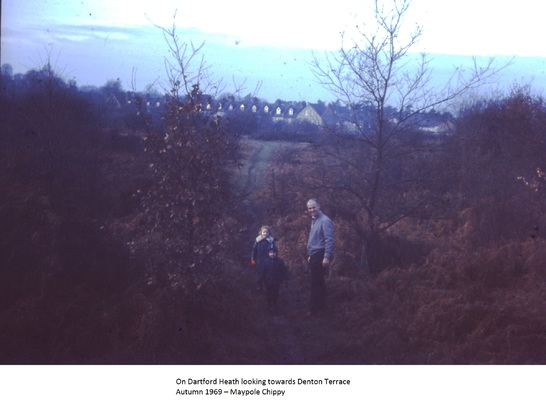
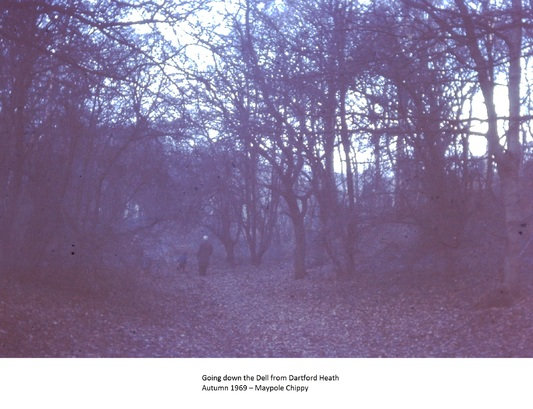
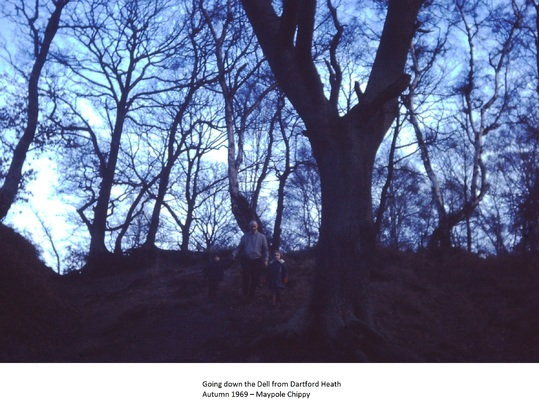
From Maypoleman - the above photo is of a tree that has featured in the memory of many boys (and possibly girls) from the Maypole Estate as it had a rope swing renowned for its dangerous aspect as it carried any 'swinger' up to 50 feet above the steep slope it was situated on. The tree is featured in the pages on the Valley of the Dell.
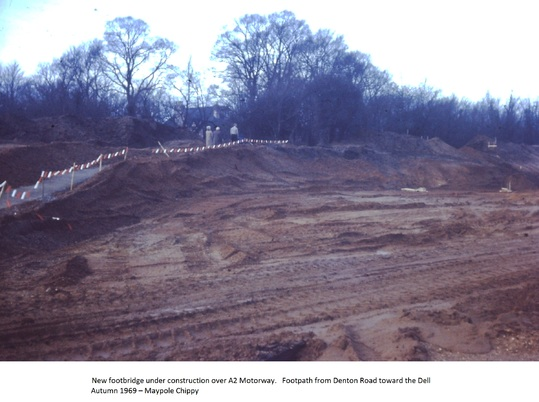
Below is one of the road bridges (Old Bexley Lane) over the A2 and NOT a footbridge as described
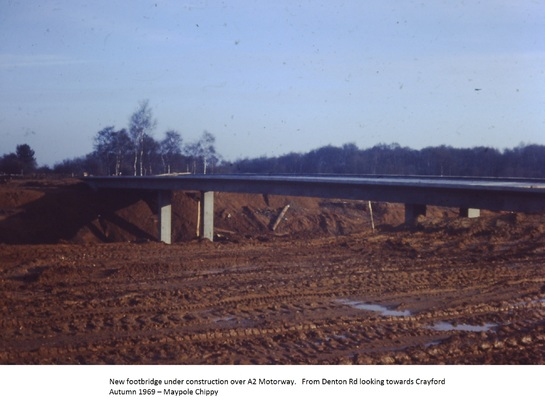
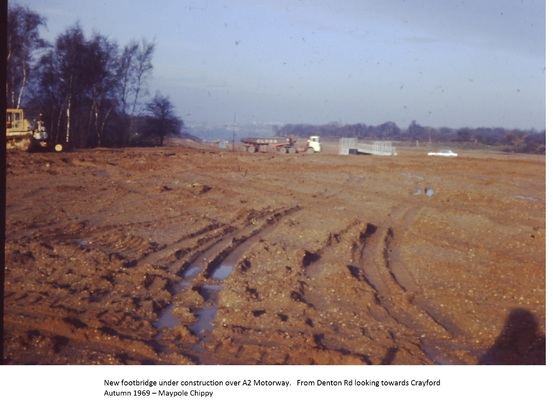
Construction of new A2 1969-1970
The 'New' A2 had been considered for a long time in replacing the old A2 -built c1921-1923. Large trenches and bore holes were sunk on the heath many years before construction of the New A2 to see what lay beneath. The New A2 dissected further the expanse of natural heathland and, in so may ways, destroyed the essence of the heath for ever.
Below images kindly supplied by Nigel Goldup and centre on the area of the footbridge at the end of 'The Dell'
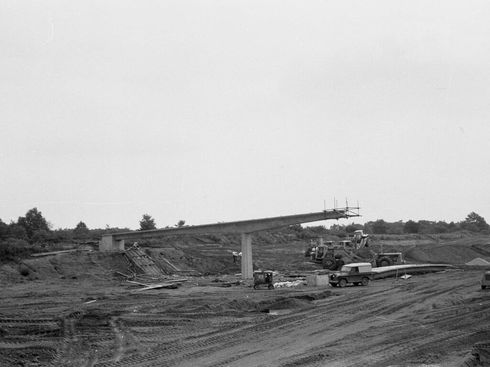
Below - from footbridge location looking towards Bexley - area of the valley of 'The Dell' to the left.
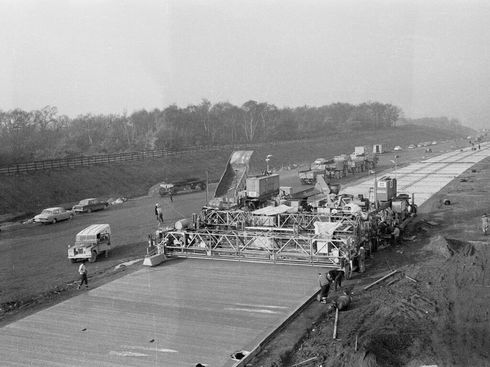
Below - from footbridge location looking towards Bexley / Crayford / old A2 direction.
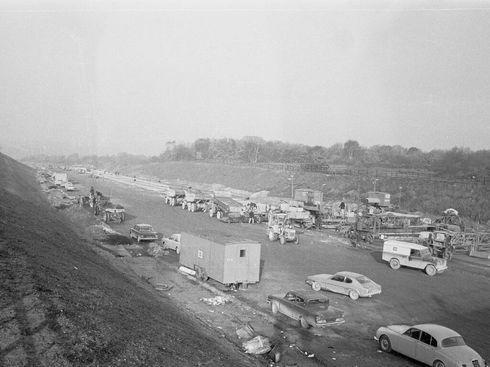
Below - from location of footbridge looking towards the area of the old A2 / Crayford.
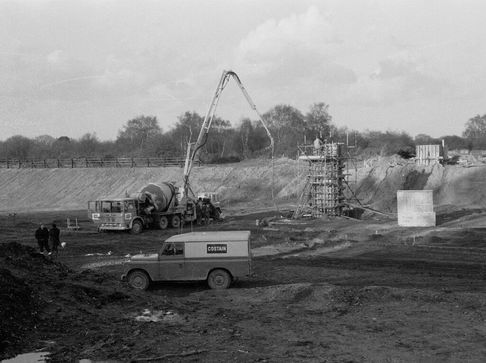
Below two images from Rhona Lee - Leyton Cross.
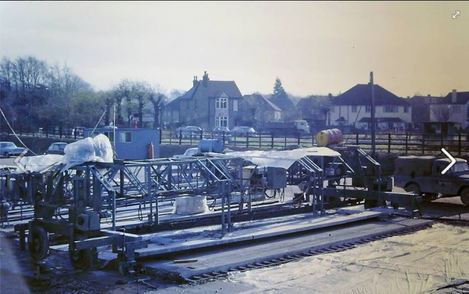
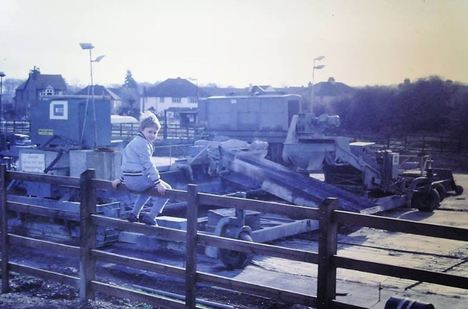
Below - somewhere on the heath - the new A2 under construction. 1969. ©️ Dartford Library and taken from Facebook Dartford Remembered. Probably Leyton Cross with the Old Bexley Lane to the immediate left in the direction of the old Bexley Hospital. The old army camp and sandpits to the right.
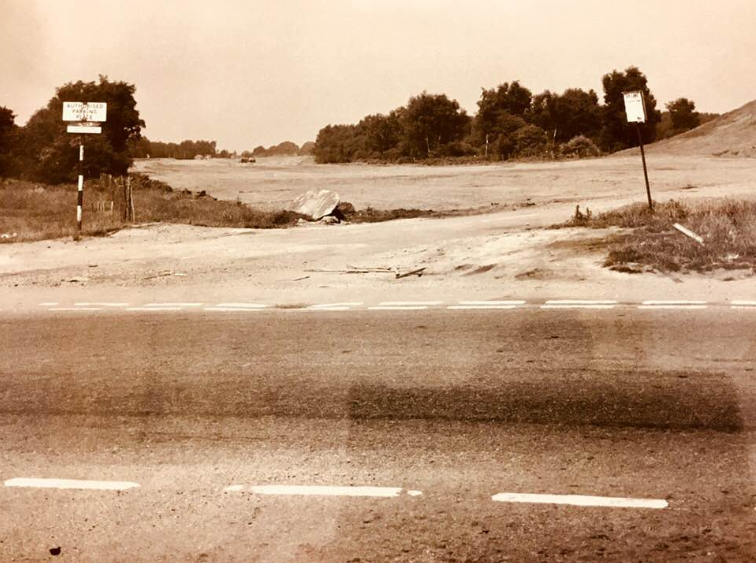
Maypole House
MAYPOLE HOUSE
The map by HASTED dated 1778 shows the site of Maypole House as being developed. The house was originally situated to the west of Denton Road, behind what was (until recently) the ROLEX watch complex and on land occupied by what is now Portman Close. The lands once formed part of the Baldwyns Estate. The Census of 1841 does not refer to Maypole Farm or House - it is fairly certain, however, that this is an inadequacy in the records themselves. The Census of 1861 shows the site had three separate occupancies.
Below OS map of 1934 shows location of Maypole House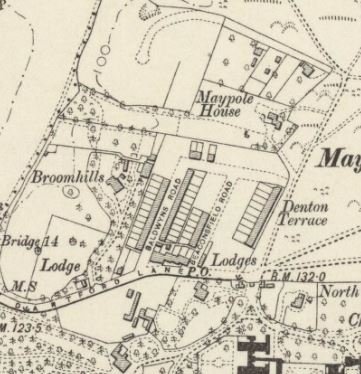
(Jan 2014 - Recent information about the Winter family and flying trophy connections - click here)
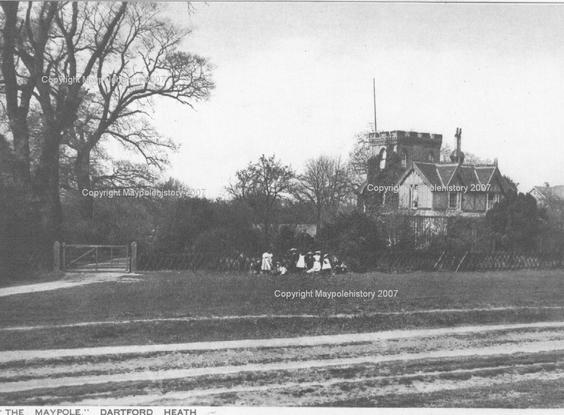
Maypole House from Denton Road (Unmade track) in Edwardian times.
The road was sometimes named as the 'cinder road' as craters were sometimes filled with the ashes / clinkers from the hearths.
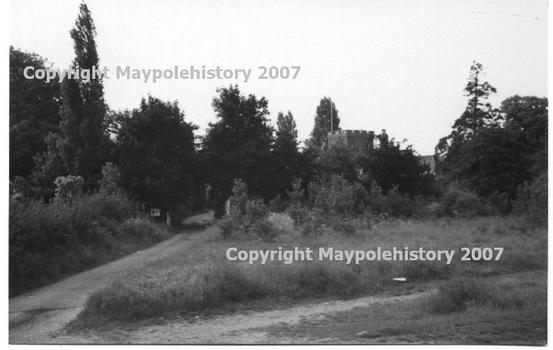
same location 60 yrs on and just prior to demolition c1982
and as it looks in 2008 - shame about the houses, cut down trees, lamp post and car - and . . . . . .
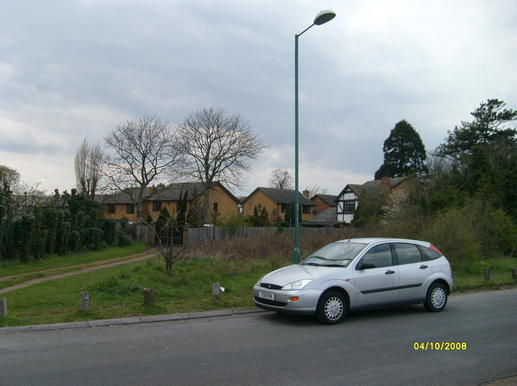
The Census of 1861 shows the site had three separate occupancies. See below
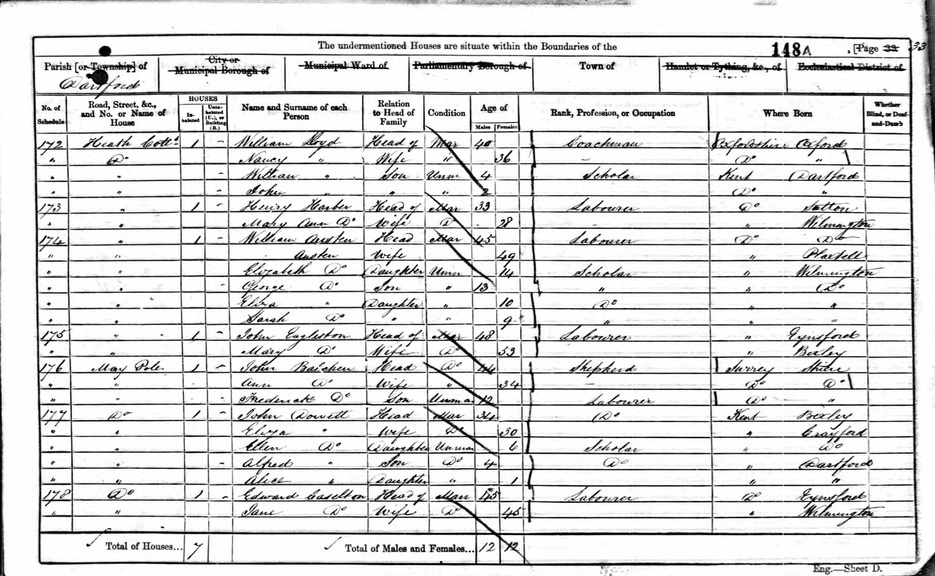
Maypole (1) The occupant and head of the family at Maypole (1) is shown as being: John BATCHEN (or BALCHEN) aged 44 years and married to Ann aged 34 years. His employment was shown as being a shepherd. No doubt his flock once roamed the heath. They had a son, Frederick aged 12 years. He is shown as being employed as a labourer.
Maypole (2) The occupant and head of the family at Maypole (2) is shown as being John DOWETH aged 34 years, a labourer. He was married to Eliza aged 30 years. They had three children; Ellen aged 6 years, Alfred aged 4 years and Alice aged 1 year.
Maypole (3)
The occupant and head of the family at Maypole (3) is shown as being John CASELTON aged 45 years, a labourer. His wife was Jane and she was also aged 45 years. They had four children; Edward aged 13 years, Ellen aged 8 years, Sarah aged 3 years and William aged 10 months.
The O.S. map of 1869 also shows the site developed. The house is shown as being within an area of cultivated land bordered by what is now Heathend Road to the south, The Dell to the north, Denton Road to the east and the stream at the bottom of the allotments of Coldblow to the west.
The pamphlet advertising the sale of Baldwyns Manor by auction on Friday May 26th 1876 at two o'clock shows lot two as 'Maypole Farm' and as being one of the three lots comprising the whole. It describes Maypole Farm as 'A very Attractive Little Freehold Property'. It comprised 'A compact dwelling house' (Occupied by the bailiff, containing five rooms with garden) It was advertised as having 'Extensive frontage to the High Road' (Dartford Lane - latterly Old Bexley Lane). It was also advertised as 'A beautiful site for the erection of a residence'. It contained 52 Acres and Twenty Perches. Within that land were 'Bank Orchard Field, Walkers Wood, Hilly Field, Fruit Plantation, Two Cottages (One on two tenements and Gardens) Lodge and Broomfields and House and Garden' The successful sale of the complete Baldwyns Manor estate took place a couple of years later and the original lands once forming the Manor complete were broken up. Baldwyns Park proper was sold to the L.C.C. for the Asylum.
The other lands (Rowhill Wood and Rowhill Field and Maypole Farm) were sold to separate buyers. Developers were around in those days, too ! The Census of 1881 refers to Maypole House and shows the head occupant as being Edwin BALDWIN - a herbalist farmer of 25 acres and aged 38 years and married to Ida aged 32 years. They had four children; Edwin Jnr. aged 3 years, Percy aged 2 years, Ida Jnr. aged one year and Florence aged 4 months . The census shows that Edwin BALDWIN employed 3 men and two boys. Sleeping at the abode on the night of the census were also members of his wifes family; Henry and Alice AULEN and their daughter, Iris, aged 1 year.
The above paragraph indicates that the lands of Maypole Farm (House) were only half the size of those mentioned in the 1874 pamphlet of Auction. This may indicate that the area of Walkers Wood may have been sold off to other owners and this is where Heathwood Lodge was to be built. The Census of 1891 shows that Maypole House was under new management. Mary ALEXANDER now lived in Maypole House. She was shown as a widow aged 56 years and 'Living on her own means'. She employed Alfred JENNER aged 60 years as her General Groom and Alice STACEY aged 20 years, and single, as her General Domestic. The following are cited as living there in the 1891 Census -
The Heath. Maypole Cottage.
WARDEN. James. Wid.72. Market Gardener.B.Kent.Eynesford.
Rosina.Dau.36.B.Kent.Wilmington.
Alice.Dau.29.B.Kent.Wilmington
The Heath. Maypole House.
ALEXANDER. Mary.Single. 36.Living on own means.B.Kent.Bromley
Alfred JENNER. M. 60. Gardener & Groom.B.Sussex.Battle.
Alice S.STACEY. Single.20.Gen Serv.B.Dartford.
The next occupant for the House is shown in KELLYs Directory of 1911 as being Alan George FINCH. Following him in the same directory was Charles KNIGHT who is shown as living there in 1918. Vera KNIGHT was known to the late Winnie BLACKMAN as being a lady who 'Rode horses on Dartford Heath'. Kelly's Directory of 1927 shows that a Mrs WAKEMAN resided at the house. The Maypole School Register ( MSR ) of 1928 shows that Ida NORMAN aged 5 years attended and lived at Maypole House. Her guardian was shown as being Mrs NORMAN. Normally the father is always shown as being the guardian in the register and it is not so in this case. Therefore it is possible that Mrs NORMAN would have been staff at the house.
1911 Census

The MSR of 1939 shows that three BROOKE children attended and lived at Maypole House. Their father is shown as being Kenneth. Their last school is recorded as being Hollinsend at Sheffield. The children remained at the school for only two months before leaving the district. Presumably their father was also staff.
The Voters Register ( VR ) of 1937 shows the new occupiers as being Constance, Harold and Richard WINTER. This family was to remain there for nearly 50 years until the house and lands were eventually sold for development c 1982. The same VR of 1937 shows that Sidney and Elsie WARR resided in the Coach House at Maypole House. The MSR of 1940 shows that John WARR aged 5 years attended the school and that his father was Sidney. The address is confirmed as being the same.
Also shown in the same VR as living at Maypole House was a Robert Ernest CAMERON. (Any connection with BROOMHILLS ?) The WINTER family were responsible for selling part of their land (formerly known as the Daisy Meadow) bordering with Heathend Road - for housing the ROLEX watch development. It has been reported that there were two sad deaths in the WINTER family whilst they lived at Maypole House. I have not confirmed either as being absolute fact but both were subject of local talk at the time. In c1970 Mr Richard WINTER (Snr) was found dead in the grounds. He had been the subject of a tragic shooting incident. No other persons were reported to have been involved. An Obituary appeared in 1970 where he was shown as Managing Director of the Rolex Watch Co. Ltd.
The other death was in the previous decade. It is recorded that that one of his sons (Michael John Winter) was subject of another tragic accident at a party. It is recorded (unconfirmed source) that death 'was by his own hand' and location given was 127 Upton Road, Bexeyheath 16th May 1965 aged 17 yrs. Below is an extract from Public Records - Index of Wills and Probate.

Memories of the House by a family member are also contained in a sub-page - click here.
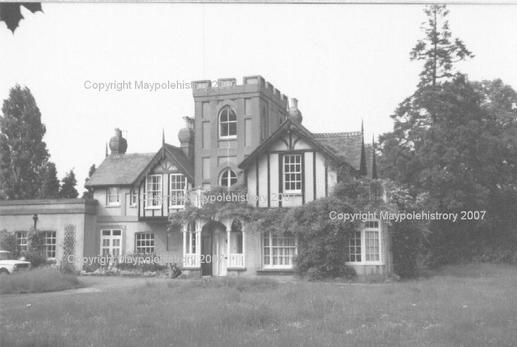
Above - Maypole House prior to demolition c1982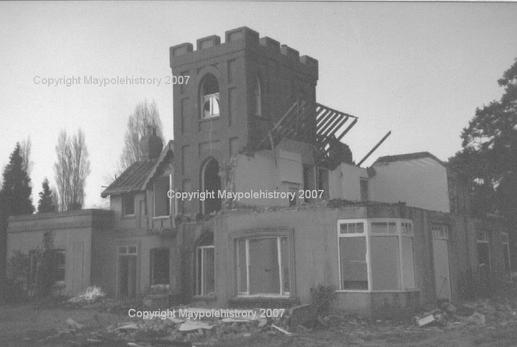
Above - under demolition c1982
Below - donated by Sue Collins - the winter of 1963
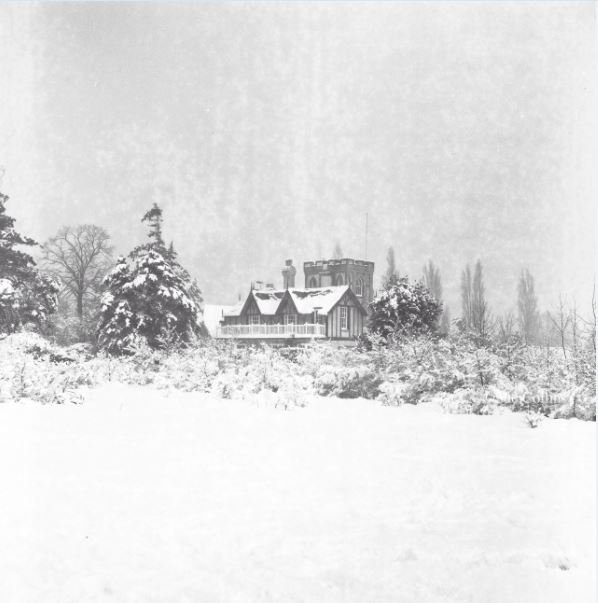
The below photos have been sent in by Richard Wight - who has recovered and lovingly restored orignal items from Maypole House and now has them in his own - bringing history back to life !
The original front door of Maypole House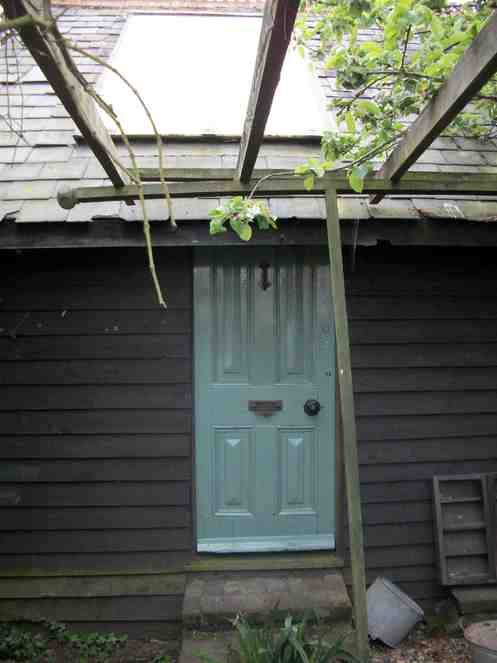
Below - an original internal door from Maypole House which once led from the garage to the house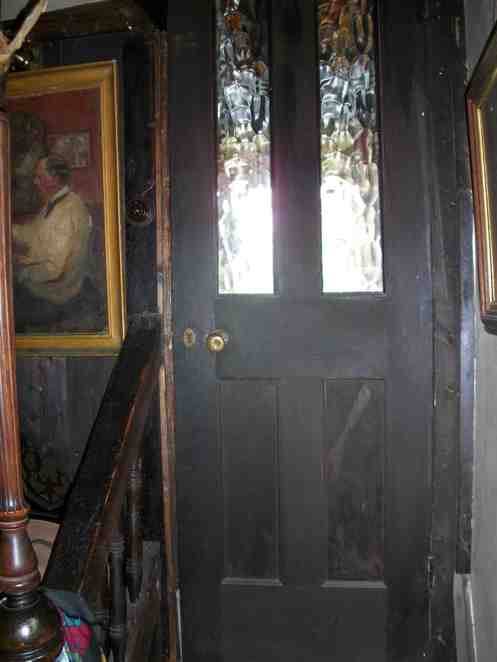
Below - an outbuilding door rescued from Maypole House demolition day !!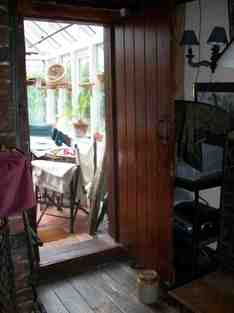
Below - an original 'Bakolite' light switch from Maypole House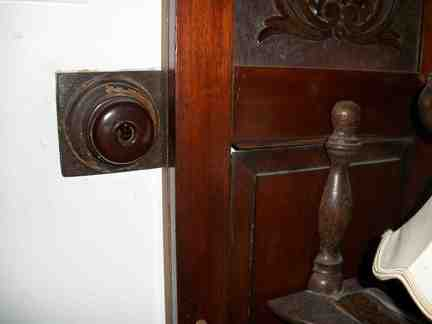
Below brackets that supported the cloakroom basin at Maypole House, now supporting the Kitchen shelf over Rayburn.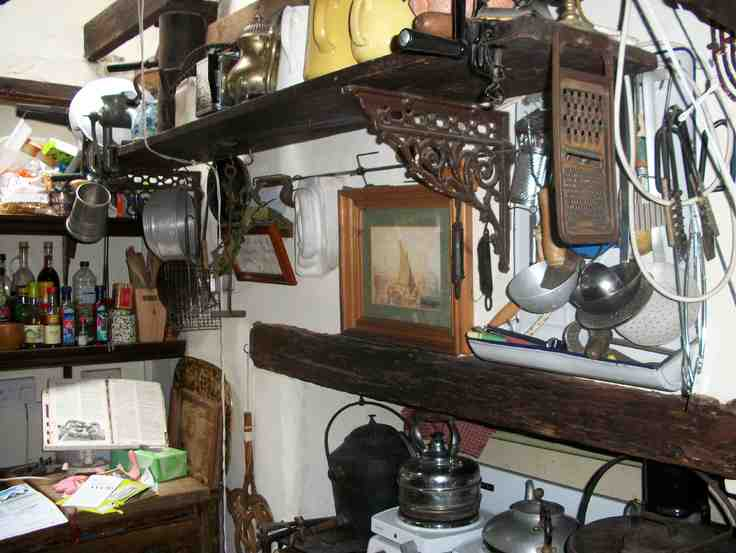
Maypole House memories from Janet CUSHION nee WINTER
Harold and Constance Winter owned Maypole House from c. 1937. I understand he was a jeweller in Birmingham, where my father Harold Oscar (Bunny) was born. I am not sure at what point he started up the UK arm of Rolex with a chap called Wilsdorf. They brought up four children: Margaret, Robert, Richard and Harold Oscar. Richard was also a Director of Rolex. All four children pre-deceased their parents. Margaret had a daughter Janice who lives in the Midlands. Robert had epilepsy and lived much of his life in a Leonard Cheshire Home. Richard and Dorothy had three children: Richard Anthony, Michael and Christine. Bunny had four children: Janet, Colin, Peter and Derek.
Christine now lives in Norfolk, and Richard Anthony (Tony) lives in East Sussex. Michael suffered a tragic accident at a party when he was 17. I do not know the circumstances. Margaret died in Belgium; Robert had epilepsy and finally died of cancer in his 50's; Richard died in the grounds of Maypole House, and my father died of leukaemia aged 51. Dorothy died in 1997. She was living in Bexley having left Maypole House prior to its demolition.
My knowledge of Maypole House is sketchy, because my father took us to America twice - 1949 to 1951 and 1955 to 1962 and our visits in between those times were confined to Christmases and other family occasions. I did however find my name on the Maypole School register c. 1951 - just after we returned from America the first time. Tony went to school in Kent but also went to Maypole School in 1947. When we returned from America in 1951 we very briefly lived in the flat above what were originally the stables at Maypole House. Most of my memories are of greenhouses smelling of tomatoes, the cricket pavilion and the orchards. My father married Valerie Kennard, and her brother Derek was for many years the Sales Director at Rolex. My father's work at the Foreign Office took us to America in 1949 and then to the Cotswolds and GCHQ in c. 1953. Then we emigrated to California in 1955, returning to England in 1962. I still have a framed photograph of Maypole House on my wall and in its heyday it was a magical place. Maypole House is a very mixed bag of emotions and memories.
The Winter family flying trophy / car racing connection
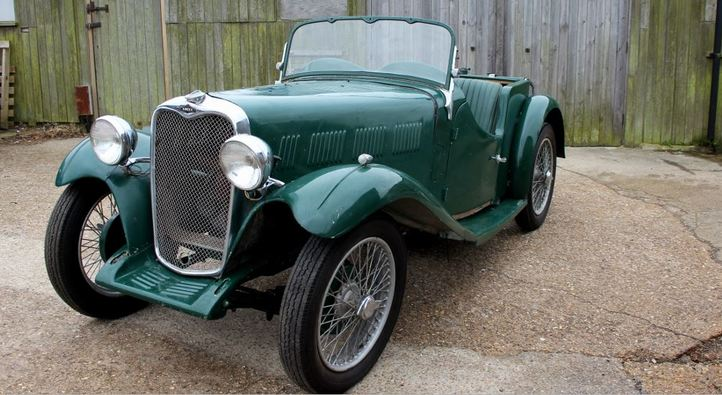
1935 Singer owned by Mrs Constance Winter in that year
Thankfully, a random web-surfer came across the Winter family on this web-site. Carl Davy has sent information and a picture of a car he currently owns and is restoring.
The picture does not appear on some iPads / tablets at this stage so will be re-attached soonest. It can be viewed if you go to 'photos' - found in the top bar of this page.
Have any readers any information about the connection with the Winter Family and the flying / racing car connection? If so please E Mail us at the E Mail address on the Home Page.
The following information has been supplied - permission has been given to also add a photograph of this classic sports car
Attached is a side view of the car. It is a 1935 Singer 9 Le Mans 'Special Speed' 2 seater. It was registered to Constance Winter of Maypole House in 1935. The Special Speed came out that year celebrating motorsport successes - so Constance had one of the very first of this model. Very much the 'must have' car of that year.
Constance Winter was married to Harold Winter.
Kings Cup Race
Harold Oscar Winter and an R A Winter listed in Kings Cup Air Race.
The 'Flight' Magazine dated August 10th 1939 reported that the aeroplane race was to be held at Birmingham Airport on Saturday 2nd September 1939 - the day before Britain declared war on Germany. Listed in those taking part were the following:- Harold Oscar Winter entering the plane, a 'Comper Swift' with engine D H Gipsy III. The pilot was shown as being R. A. WInter. It has also been discovered that an R.A. Winter was serving with the R.A.F. in 1939 with 247 Squadron. That source of information shows that this R A Winter from 247 Squadron died in 1970. Are these the same Winters that lived in Maypole House - we think so. So, if any of you out there have any supporting information on the aero connection or about the car / racing connection do let us know.
Below is a Rolex advert from March 1940 - 6 months into WWII
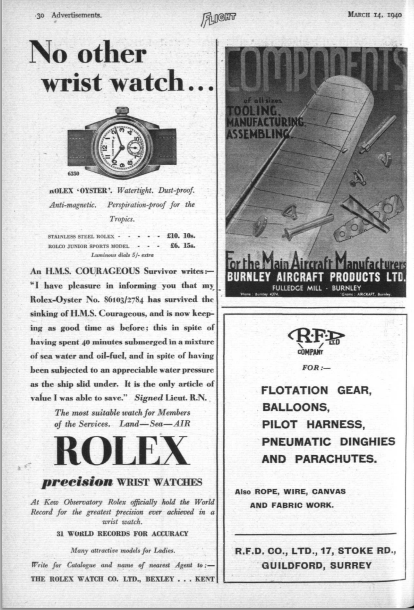
Carl has discovered some 'titbits' about the connection of the Winter family and the Rolex Watchmakers.
The Singapore Free Press - 17th September 1946 Page 3
"400,000 miles to sell watches. A young ex fighter pilot R.A. Winter of Bexley, Kent, plans to fly more than 400,000 miles in the next 5 years, equivelant to more than 16 times round the earth. His firm of Swiss watch manufacturers has arranged with the British Overseas Airways Corporation an itinerary which will enable him to visit every city."
The Straits Times 11th September 1950 Page 4
"DINNER PARTY - Mr R.A. Winter representative of Montres Rolex S.A., Geneva, was entertained to dinner by the Borneo Company Ltd. at the Tai Tong Restaurant, Happy World. Among the guests were:- H Senna, G.P.M. De Silva, K.A. Richard DeSilva, and representatives of the Chee Kong Store, Tuck Chong Watch Company, Cheong Hing Watch Company, Yong Kwee Co., Chin King Store and Woo Hing Brothers."
Carl has also discovered information regarding the 'winding up' of the 'Rolex Holding 'London' Company' in 1966 when Richard Winter was the Chairman. Viz.:-
The London Gazette - 19th July 1966 :-
"At an Extraordinary General Meeting of the above named company duly convened and held at Maypole House, Bexley, in the County of Kent, on the 5th day of July 1966 at 5.30 p.m., the Subjoined Special Resolution was duly passed:
That the Company be wound up voluntarily and that Cedric Hinton Fleetwood Reynolds of Danes Inn House, 265 Strand, London W.C.2 be and he is hereby appointed Liquidator for the purposes of such winding up".
Broomhills and Grosvenor Cottage
BROOMHILLS
and
BROOMHILLS LODGE
including Grosvenor Cottage
****** This page contains Video footage ******
Below - the area as it once was - courtesy of Google Earth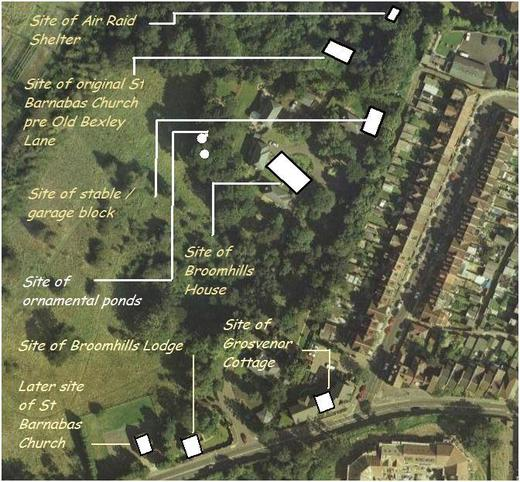
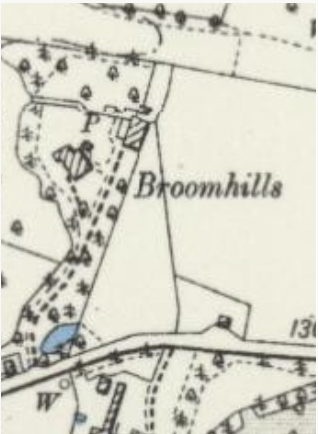
Above - Ordnance Survey c1880 of Broomhills - note blue pond
Broomhills was the name of a large and prestigious house which once stood in the grounds now occupied by Broomwood Close. The original entrance gate had a lodge house to the west of its narrow, tree and shrub lined drive. Both the Lodge and Broomhills, itself, were demolished over the period 1996 -1997. The O.S. map of 1869 shows the lands of Broomhills as being undeveloped. A new house has been built (c2000)on the site of the old Broomhills Lodge.
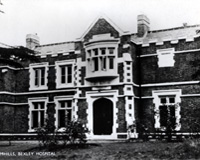
Above courtesy from the below website
http://www.bexleyhospital.co.uk/memories.html
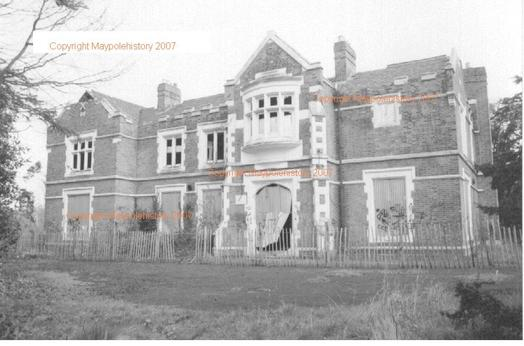
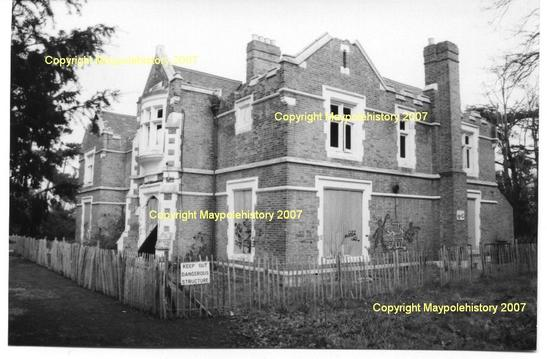
Broomhills in state of dereliction c1996
The above image shows a white square on the front of the house just above the lower storey window. The white square was a carved or raised depiction/relief of a thistle. For years I thought this had something to do with the Camerons who latterly lived there - Cameron being Scottish and a thistle being linked with Scotland. Research shows that the first occupant Mr Glynn had another address listed called 'Thistlewood' - a house in Dalston, Cumberland. I now believe that he had a hand in the design and the laying of the stone when the house was first constructed.
Below - video of Broomhills - 1988
Below - enhanced still (or not as the case may be !!) from video 1988 in Broomhills field looking towards Broomhills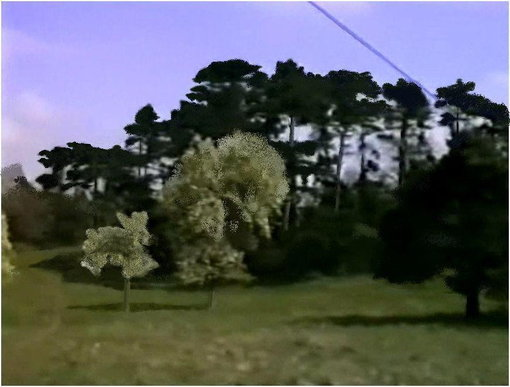
and below - 22 years later in 2010 - the Haymeadow now Heathland
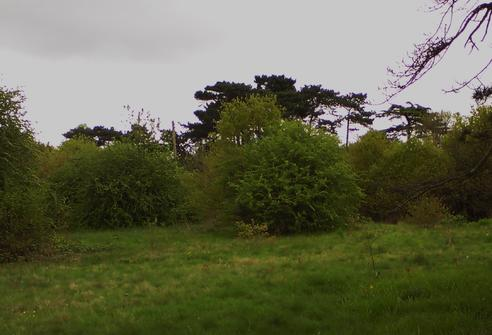
The pamphlet published especially for the auction sale of Baldwyns in 1876 refers to: Maypole Farm - with Lodge and Broomfields. Perhaps this is where the name Broomhills originated. It seems likely then that the lands of Broomhills originally once formed part of the Maypole Farm plot of the Baldwyns Estate. (There is an established house called Broomfields - a distance of a mile or so away to the east at the top of the hill in Common Lane, Wilmington near the junction with Parsonage Lane and is, most probably, not connected)
The Census of 1881 shows the site of Broomhills occupied by the GLYN family. The head of the family was Lewis GLYN, aged 31 yrs and he was married to Mary aged 26 yrs. He was a Barrister at Law. At that time they are shown on the census as having two children Mary, aged 4 yrs and Harry, aged 5 yrs. Title deeds to 27 Beaconsfield Road dated 1879 mention Lewis GLYNN. This would then indicate that the house was built and occupied sometime between the years 1869 and 1879. The census of 1871 shows Lewis GLYN as the nephew of Charles GIBSON - a solicitor and staying with the family at 37 West Hill, Dartford on the night of the census. He is shown as being aged 21yrs and a Law Student - quite possibly at his uncles firm.
Census from 1871

This census shows the uncle as Charles and the aunt as Jane. Ancestry reveals that Jane was nee SCAIFE. Charles died in Manor Gate, Wilmington 26 January 1895. Jane died 25 February 1907 at Cumberland.
Some of the older residents of Maypole Estate remembered the field in front of the old house as 'GLYNS FIELD'. In 1881 Fanny GLYN also lived there. She was the younger unmarried sister of Lewis. The staff of Broomhills are listed on that census as being:- Alice LUCAS aged 19 yrs - the housemaid Rose LUCAS aged 17 yrs - the nurse (presumably to the two little children) Elizabeth NEWMAN aged 50 yrs and unmarried - the cook / domestic All three were single. It may be deduced that Rose and Alice were sisters as they were both born in Leatherhead, Surrey. Broomhills Lodge was the name of the lodgehouse to Broomhills and, as already stated, lay on the main road between Maypole Estate and the 'Dip'.
The Census of 1891 shows that 'The Lodge House', Dartford Lane, housed the TUTHILL family. (The electoral register of 1900 confirms that this 'Lodge House' does refer to Broomhills Lodge). The census of 1891 also shows the head of the household as being George TUTHILL and he was employed as 'Coachman Groom'. He was aged 40 yrs and married to Kate who was aged 42 yrs. They were shown as having three children, namely Mary, Robert and Peggy aged 9 yrs, 7 yrs and 3 yrs respectively. Thomas TUTHILL was shown as also being there aged 33 yrs - the brother of George.
The Glyn family benevolence to the residents of the Maypole Estate
The lands of Broomhills were often opened up for certain events being conducted by those living in the Maypole. This was a tradition carried on by the next inhabitants - the Cameron's. Follow this link for further information.
Death of three GLYN children
Wilmington Church yard evidences the tragic death of two of the GLYN family viz: Harold Herbert Glyn (son of Lewis) died at Broom Hills, Bexley. 26.12.1898 aged 21yrs. Donald Lewis Glyn (presumably another son of Lewis) died and buried at sea 20.3.1899 aged 17yrs.
The below information refers to another tragic GLYN death - courtesy of information from Kings Canterbury Roll of Honour
| Lieutenant Richard Spencer GLYN | |
| 1st Battalion East Kent Regiment (The Buffs) Date of birth: 3rd of October 1893 Date of death: 20th of October 1914 Killed in action aged 21 Commemorated on the Ploegstreert Memorial Panel 2 | 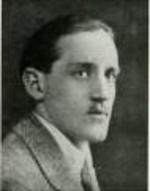 |
| He was born at Dartford, Kent on the 3rd of October 1893, the second son of Lewis Edmund Glyn KC and Mary E Glyn of Broom Hills, Bexley, Kent and of 'Thistlewood', Dalston in Cumberland. He attended the Junior King's School from April 1904 and the King's School Canterbury from January 1907 to July 1910, where he was a member of the Officer Training Corps. He was fond of shooting and fishing. 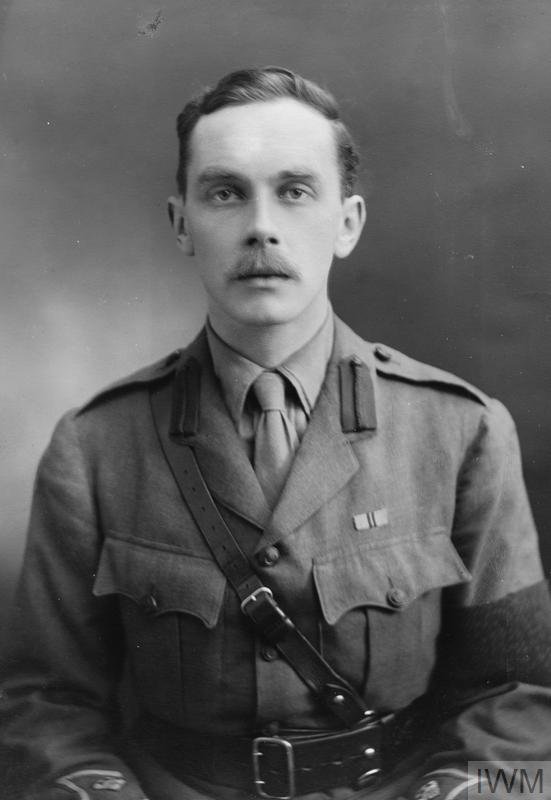 On leaving school he became a law student at the Middle Temple in London but took a commission as a Probationary 2nd Lieutenant in the 3rd Battalion East Kent Regiment, Special Reserve of Officers, on the 13th of May 1911 being confirmed in that rank on the 20th of January 1912. He was promoted to Lieutenant on the 20th of January 1913. On the 7th of September 1914 he landed in France where he took part in the Battle of the Aisne. On the morning of the 20th of October the 1st Battalion were holding the line at the railway crossing east of Bas Champs near Chateau De Flandres at Radinghem. The day began with very heavy artillery fire from the German artillery with large calibre shells followed by an infantry attack during which the battalion commander Colonel Hasler was badly wounded. By 3pm the battalion was in great danger of being surrounded as the Germans forced the British units either side of them to withdraw. At 3.35pm and again at 4 pm the new commanding officer Major McDouall sent messages back that the situation was very serious. His machine gun had been destroyed and C Company of the battalion had been overrun on the left of his position. At 4.50pm he received a message to hold the line "at all costs" and the headquarters party of the battalion built a barricade across the village which they defended until the promised help arrived at 7pm. During the fighting Lieutenant Glyn was shot through the heart while directing the fire of his men and killed instantly. He is commemorated on the Old Bexley War Memorial. | |
Below Broomhills Lodge in state of dereliction prior to demolition c1997
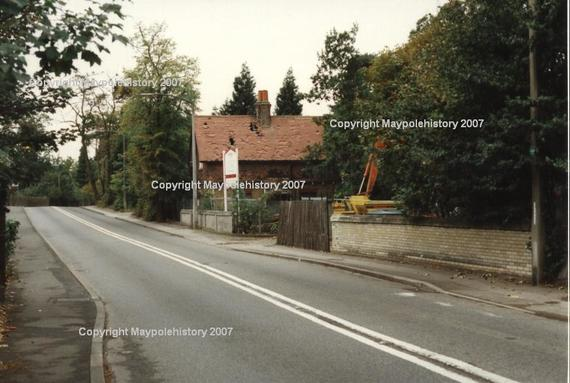
Video in 1988 of the Lodge . . . .
How it looks now . . . .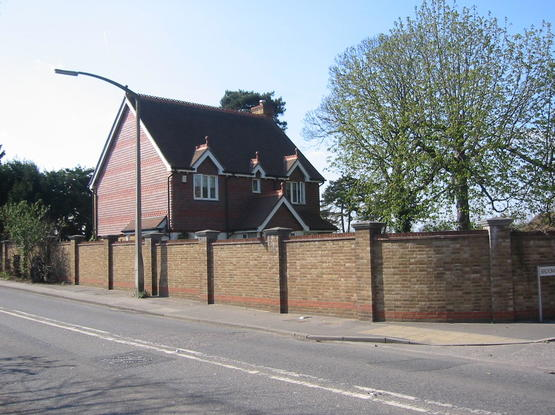
Below - courtesy of Google Earth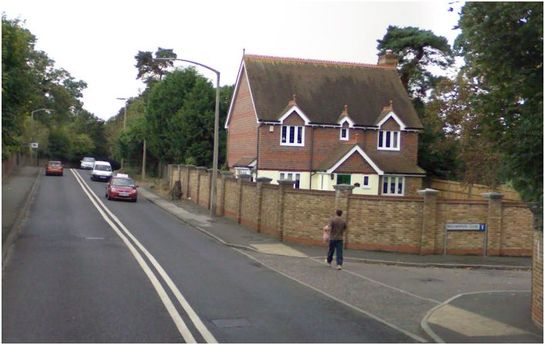
The 1891 O.S. map also shows the site of the Lodge developed. I believe that GLYNN had a stake in other land where the Maypole Estate now stands. Whether he arrived by them through purchase of Broomhills or by further speculation I am not sure. For instance, title deeds to 27 Beaconsfield Road show that in 1878 the land on which it now stands named Lewis Edmund GLYNN as being in a covenant, together with Frederick George GIBSON. Frederick George GIBSON was an uncle of Lewis born 1834 - died 1929 and was the brother of Charles Reginald as shown earlier in the census records of 1871.
In 1878 the land was partitioned and another name entered the equation; that of Charles Reginald GIBSON - an uncle of Lewis. In 1879 there was further partition showing Frederick GIBSON, Edward Robert JENNINGS and Frank FELL. GLYNNs' name is no longer mentioned and I believe that he sold his interest in the Beaconsfield Road site to the developers GIBSON, JENNINGS and FELL. It is therefore possible to imagine that Lewis GLYNN may have bought the freehold of BROOMHILLS and Maypole Estate, in whole, or if not, in part.
Broomhills Lodge census 1911 - TUTHILL family
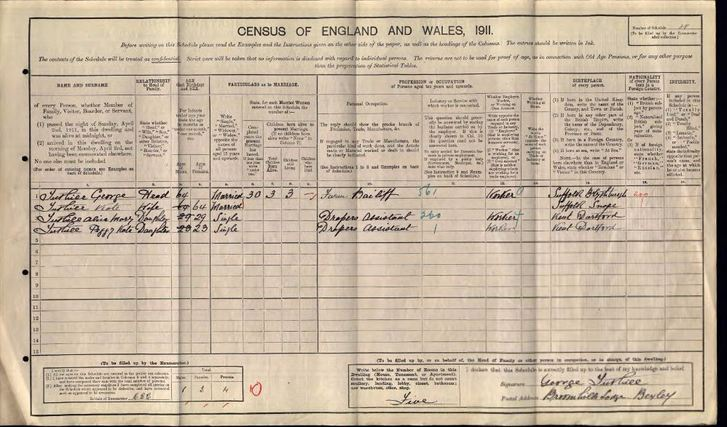
Records show that the GLYN family were resident there until at least 1914 - see Annual Procession and Sports Day. The 1911 census shows the family at Broomhills. However, a census dated 1901 shows the GLYN family at Thistlewood, Penrith, Cumberland. It would seem they may have had two prestigious properties. Lewis GLYN is shown as dying at Thistleton in 1919 aged 69 yrs.
1911 Census
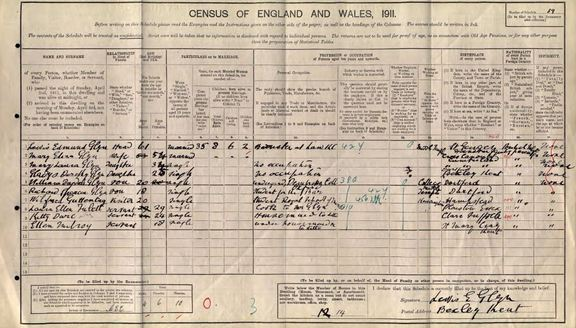
Lewis GLYN is shown as dying in 1919 and leaving an estate worth £29222 18s 4d - at todays value this is worth over £15,000,000

1911 Census shows the WESTON family as residing. Occupation as a 'Traveller - photo engraver'

The 1937 electoral register also shows that the CAMERONS owned Grosvenor Cottage as well - an Edwardian detached family residence once situated on the northern side of Old Bexley Lane and adjacent to the west of the junction with Baldwyns Road.
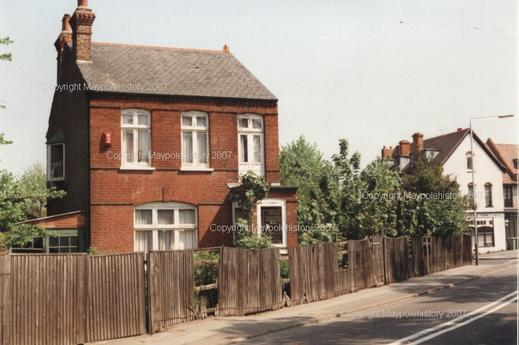
Grosvenor Cottage c 1996
and as it looks now with the new 'Grosvenor Mansions' on it's site.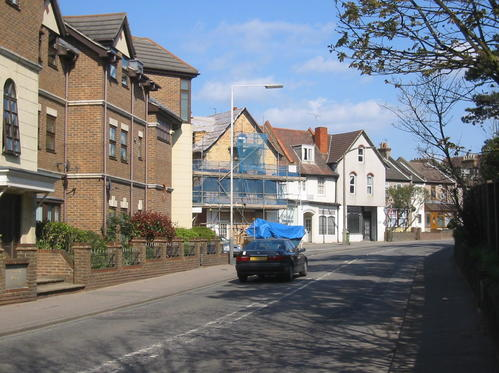
The electoral register of the same year shows Joseph CAMERON in residence at Broomhills. Also living there were Elsie BONNER and Margaret BENNETT - presumably staff. The same electoral register shows Frances CAMERON - his wife - at the nearby Grosvenor Cottage. The electoral register of 1945 shows Joseph CAMERON and Elsie BONNER still at Broomhills itself, with Frances, his wife and John, his son, at Grosvenor Cottage. Joseph died in 1949. Although GLYNNS Field had been used for haymaking during the CAMERONS stay I can only ever remember it during the 60s / early 70s as being used by the Bexley Hospital for the grazing of their cows. BROOMHILLS and its lands were owned at that time by Bexley Hospital for the use of tending short stay patients.
Joseph CAMERON died on 19th November 1949 leaving in his Will £59362 and 10d. At today's values (2016) this is over £3,000,000. See below. He was buried at St Mary's Bexley 4 days later.

I believe the house and grounds were sold to the hospital by the CAMERONS c.1959. The narrow drive to Broomhills (virtually on the same drive currently to Broomwood Close) was bordered to the west (field side) by mature horse chestnut trees. As a schoolboy, I can vividly remember harvesting the immense crop of 'conkers' they would bare every Autumn. I remember in the late 1950s that the Lodge was used to house the hospital farm pigman and his family. Bexley Hospital had a large farm and made good use of GLYNNS Field. One of my earliest recollections of the Lodge was as a young boy c.1961 visiting the family who lived there. I can distinctly remember that they had a son who suffered cerebral palsey. Despite this, he was a very happy child. Later (c 1966) the Lodge was used then and thereafter for housing medical staff. I think it was last inhabited c 1982.
Below is a photograph taken c1957 donated by Susan DENISON who was the daughter of the pigman who lived in Broomhills. It shows Maypoleman and Susan in the garden of Broomhills Lodge. In the background is Broomhills Field where the cows from Bexley Hospital were placed in the late 50s - late 60s.

Other childhood memories of Broomhills range from catching frogs in the ornamental ponds, situated westerly of the house, to the unearthing of an air raid shelter at the Northwest and using it as a base 'camp' for us local boys in 1967. Most of our childhood activities in the grounds were conducted using stealth and cunning as they were strictly priyvate. It was not for use as a playground by the 'oiks' from the housing estate! Another building I remember to the north west of the grounds was an old concrete, round shouldered Nissen type hut. Presumably during the war it had been used for some related purpose or another but in my time it housed the cows.
Below - video of the frog ponds where we children secretly caught tadpoles and newts back in the early 1960s - apologies for the soundtrack added in a vacuum of ability back in 1988 !
The air raid shelter referred to earlier was situated right to the Northeast of the boundary and close to the Maypole Institute. It probably could have slept 8 or 10 people at a push, and was quite substantial. There are traces of it still. Mrs Dorothy HERF (nee CAMERON) told me that her father, Joseph CAMERON, arranged for it to be built. She also tells me that he was surprised when he began to build it to find traces of an earlier building there. Apparently he used the footprint and walls of the existing remains for his shelter. The brick walled outline construction still remains under tipped rubbish. Was it an ice house at one time ? A boiler house for the greenhouses ? A brick kiln ? Maybe we will never know.
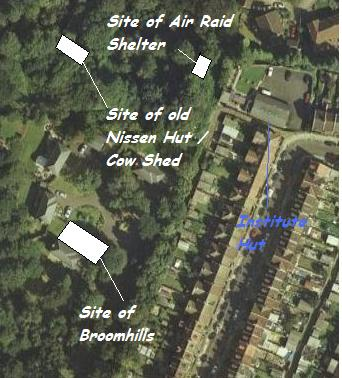
She was unable to say what the original building had once been. I remember that the two end corners opposite the two small entrance doors were rounded as opposed to squared. Could this have been an 'Ice House' - or was it too far from the main building ? Could it once have been a brick kiln ? An aerial photograph c1925 shows the outline of a narrow construction running from the direction of where the stables once were towards the Maypole House boundary (to the rear of the Institution hut). I have been told (Mr Alfred PETERS) that there was once a long greenhouse on this site. Could the original brickwork of the shelter have been some form of boiler house to heat the greenhouse ?
A fascinating little anecdote attached to the story to the outbuildings is the fact that several people have told me (Including the late Gordon LENNOX) that the stables ( later the garages ) had a small turn table mounted in the floor. This enabled any vehicle within to have been turned on its axis - drive in forwards and drive out forwards !! I can remember these outbuildings - as they backed on to the rear alleyway of the houses and gardens in Baldwyns Road. Even though I scampered all over these garages as a child I cannot really remember this turntable, for I suppose it must have been well before my time.
Below - Old Bexley Lane looking towards Baldwyns Road and Bexley c 1994. Clearly shows the side of Grosvenor Cottage behind wooden fence.
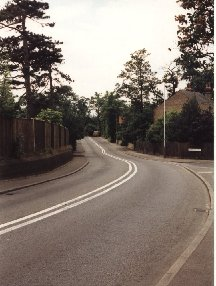
and as it looks now with the new developments . . . .
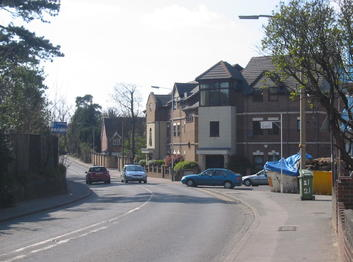
The spacious house of Broomhills has now been demolished ( November 1996 ) and new houses have been built. The road is now called Broomwood Close. The Lodge (demolished 1997) and Grosvenor Cottage (demolished 1996) also have gone. There is a complex of flats on the site of Grosvenor Cottage called ‘Grosvenor Manor’. GLYNNS Field is now open to the public as some kind of pathetic reparation for loss of recreational land in 1970 when the A2 was built on Dartford Heath. The once very secret places outlying Broomhills and guarded under its protection, are now very exposed and quite unkempt.
Grosvenor Cottage (Rear) in state of demolition
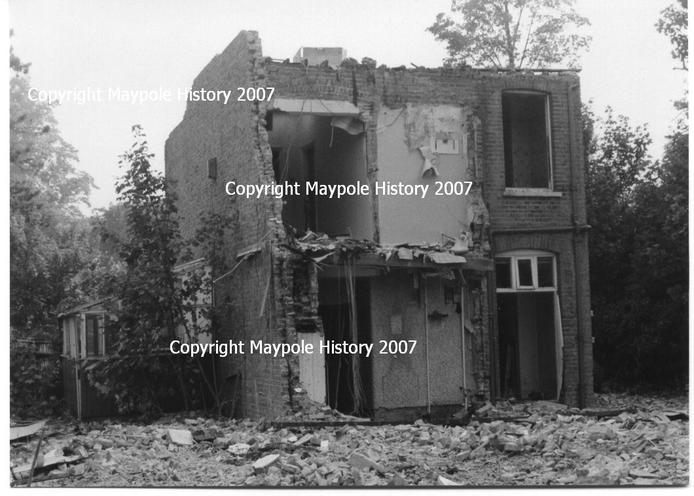
Heathwood Lodge, Dartford Heath
Below O.S. map published 1909 showing location of Heathwood Lodge
Heathwood Lodge once stood in the middle of where the new A2 now runs. It was situated on the high ridge of 'Walkers Wood', between the valley of the Dell and the next valley once referred to by the older residents of the estate as the 'Second Valley' The rear of the house faced the direction of Hall Place.
There are three distinguishable valleys running like fingers, horizontally between the Maypole Estate and the old A2. These were referred to as such by local children in the 20s viz.: (Disregarding the valley that lay within the private lands of Maypole House) the Dell was the first, the next (within the private grounds of Heathwood Lodge) the second and the third (adjacent to the old A2) became latterly known to local children, including myself, (c 1960) as the 'Paddock'. Records show that before and, perhaps in the early days of the estate, this last valley was known as 'Wolfes Glen'. In the 18th Century if one stood where Denton Road now is and looked into Wolfes Glen towards Bexley there would have been an uninterrupted view along that valley to Hall Place.
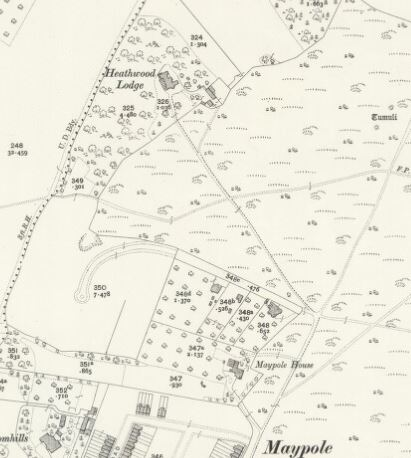
The below is kindly supplied by Ed Wainer
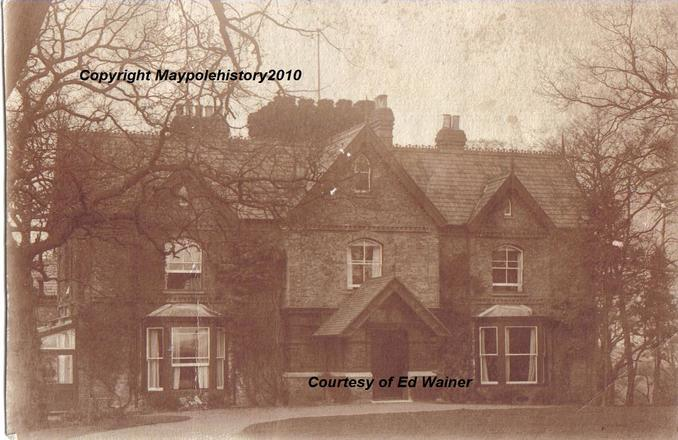
Ed's recollections of his time at Heathwood . . . . . .
"It started with a bang - quite literally. My father fought and was disabled in the First World War. He was not actually discharged from military hospital until 1920 and consequently took little part in the second. He was, however, because of his disability, allowed the use of a car and it was in this car, a very battered Hillman, that he collected us from rural Cheshire in the winter of 1944 to bring us down to live with him again at Heathwood. We had spent most of the war years apart as he had been transferred by his company to the factory in Erith and felt it too dangerous for us to accompany him whilst the bombing was still on. We had spent those years oblivious of the sights and sounds of the fighting. When we were approaching the heath, we encountered a very thick fog which got worse and worse the closer we got.; Eventually it became too dangerous to drive any further and we pulled into a pub for some refreshment and to decide what to do next. I remember it vividly as it was my first experience of bottled lemonade! When the bottle was opened I marveled at the stream of bubbles coming to the surface and the taste to me was exquisite. My mother was all for staying overnight at the pub but my father's will prevailed and we started out on foot with a suitcase of overnight things.
I wonder that he found his way at all as the fog was so thick but eventually we moved on a path over some heath, passed though some big white gates and along a gravel drive until we were suddenly overshadowed by what appeared, to a small boy, to be the most enormous building. Though the porch and the front door and into the cold dark house.
We were getting undressed to go to bed when it happened. The most enormous explosion that rattled the windows fit to bursting. We children were really scared as it came totally without warning and was something previously unknown to us. My father explained that it must have been one of the new V2's which arrived totally unannounced. There was nothing more, so we went to bed.
My father returned to the pub the next morning only to discovered where the thing had landed. The car was only superficially damaged but the pub much more so. Perhaps it was a happy omen for the contented years at Heathwood which followed.
We didn't own the property. It was actually owned by Captain James and his wife who retained part of the house for their own use. The Jameses were very private people and to tell the truth we hardly knew they were there. I was discouraged from playing on what must have been the west side of the house (where the conservatory was) but this was no problem at all as there were fourteen acres of woodland altogether. There used to be more I had been told, but the old Dartford by-pass trimmed some of it off. I can recall visiting the James's side of the house on only two occasions - the first to the conservatory, which had a black and white squared marble floor at the time, and the second time to their kitchen which was warm and cosy as there was an Aga installed.
There was a lodge and a garage in addition to the house. The lodge was occupied by another couple. I don't remember their names for certain but Whitehead seems to ring a bell. I was never without an air gun at that time. First a Diana, which was quite tiny and suited my size at the time. after, I graduated to a BSA Major; a real air rifle and my pride an joy. As you can imagine, I spent a lot of time outside. I remember all the squirrels drays, the smell of the gorse on the heath during the summer and the annual fires where kindly firemen allowed us to "help" and hang around the fire engines. One of my most exciting memories were the Bren gun carriers which appeared from time to time and the one occasions we were given a ride by the soldiers!
There was also a sort of grassy bank on which the scouts used to camp every year. We used to visit whilst we were there. Whether that encouraged my later joining the local cub pack, I can't recall. I do remember on one occasion they were stirring what appeared to be custard in a big pot over the fire. It tuned out to be scrambled egg!
We were at Heathwood for VE Day. Great excitement with a bonfire and my cousin, who was staying with us, managed to get hold of some fireworks; the first I'd ever seen. We were also there for the winter of 1947. What a brilliant winter that was. Snow feet deep on the ground for months. A man at my father's factory made us a toboggan. Very professional looking with gave us hours of fun. Less fun for my parents, I'm afraid. When the thaw did come all the pipes had burst. They were mainly lead and offered little resistance to freezing. The bathroom was up in the tower and we had no water there for days.
It was in 1974 that I took my wife and kids to see the fantastic house I used to live in. I warned them that it was likely to be derelict as it hadn't been lived in for years. Imagine my surprise when it wasn't there at all. All that was there was a very large cutting carrying the new road - a great disappointment".
Horror of all Horrors at Heathwood - a cautionary tale from childhood days from Richard Wight.
Heathwwod House, when derelict, was very creepy. There would be noises emanating from the upstair rooms. The old curtains, long in tatters would be blowing through the broken panes of glass so it was aptly nicknamed. We would occasionally say "Let's go over to the haunted house and see what's going on". We would scare each other by going in when it was still standing as sometimes the older boys would be in there smoking and having a laugh.
We would climb the stairs with great trepidation just waiting for something or someone to pounce !!! Needless to say, we never went near after darkness fell.
I must have been about eleven and I was with Anthony Wilkinson who lived in Coldblow Cresent. It would have been c1960 when we were walking in the grounds of the old house.
When, all of a sudden, the ground beneath me gave way and I fell headlong into a cellar !!!
Un beknowing to me there were angle irons protruding from the walls with shaped pointed ends that wine kegs would have been hung on or such like.
Ouch, one went into my right leg !!! my jeans weren't torn but it was one hell of an injury as when I rolled my jean leg up I could see into the open wound, I still have the scar to this day.
I limped back to Cold Blow and my friend's mother took a look and nearly fainted, she telephoned Mr Henderson, the news agent in the dip who I worked for. He drove up and carried me to his car and then home, Mrs Gemmell (Owen's mum) was summoned who was a midwife and upon inspection was taken to the cottage hospital in Bexleyheath, down the Broadway near the Red House.
When I was wheeled into the surgery and jeans removed the gash ran from one side to the other of my leg in a V shape !!! I was promptly stitched up and after some time taken home.
Bandaged with a terrible limp I once again became Chester in the Dartford school playground.
So, what is the moral of this tale, don't stray over building sites!
Richard
--------------------
As stated, Heathwood Lodge was situated at the top of the natural ridge in Walkers Wood, with the rear facing towards the direction of Hall Place, Bexley. It had its own long and quite sandy lane that ran from Denton Road at its junction with where The Dell is now, North westerly towards the direction of Hall Place. The lane was probably about half a mile long and wide enough to take a horse and cart or, as in later years, a lorry. Personally, I can only just remember the house - and as being in a state of ruin. As a young boy in the early 60s I remember being warned by my parents not to enter the deserted, dilapidated and dangerous structure. When I went in - as I was bound to do - it was as described by them. It was probably last inhabited in the mid 1950s. There is no record in the Voters Register of 1958 of this building or register of inhabitants.
The house itself, I remember, was a substantial Victorian detached country residence surrounded by wooded gardens that contained many of the obligatory Victorian rhododendron bushes, so fashionable in those times. Some still remain. I believe that the majority of 'Walkers Wood' belonged to Heathwood Lodge. I remember there was also an orchard to the North of the house (In the Second Valley) containing apple, pear and plum trees. In the 1960s, although the trees were, by then, very much abandoned, I remember picking the fruit. Near to the main house, to the North West, were stables and a small cottage. This cottage presumably housed the groom / gardener / handyman employed by the occupants of the larger house.
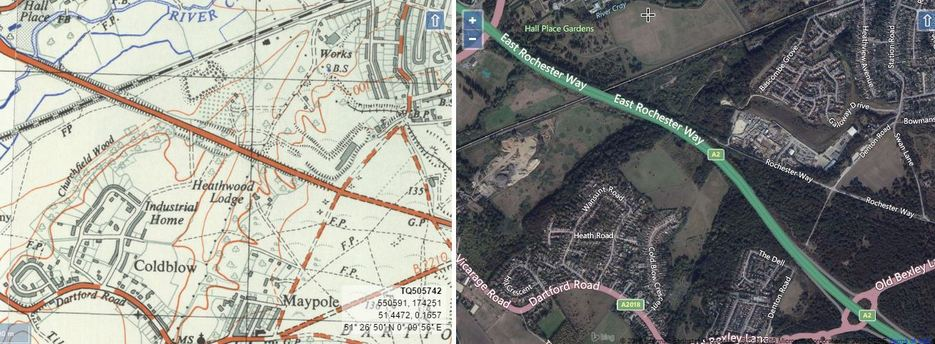
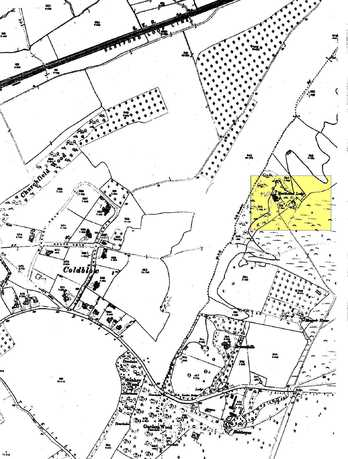
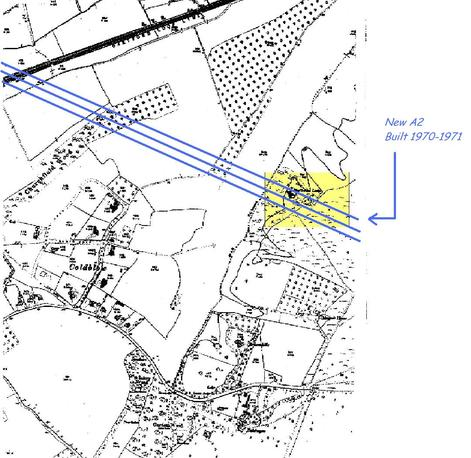
First above is OS Map 1890 showing Heathwood Lodge and directly above with A2 built c1969-1971 superimposed
in blue
The lands of HEATHWOOD LODGE - being in Walkers Wood - once formed part of the Baldwyns Estate until c1874 -1876. The Ordnance Survey map of 1876 shows that there were no buildings erected on the site at that time. The Electoral Register of 1887 shows the premises occupied. This dates the building to somewhere between c1876 and c1887. The first known residents I have found recorded are the HESKETHs. Everard HESKETH was the head of the family and was known as a prominent civil engineer by trade. HESKETH PARK in East Dartford was named after him. The Census of 1891 names the staff employed at the house under the employment of Everard HESKETH - then aged 37 yrs. There was Clara BENHAM, aged 34 yrs (the married cook) who shared her duties with Jessie LICKFIELD who was aged 29 yrs and single. Mary MITCHELL, a single 30 yr. old, was the housemaid. The same register shows that there were 8 persons there on the night of the census.
Everard Hesketh
The Census of 1891 on micro fiche is listed in such a way as to indicate that Heathwood Lodge was the smaller cottage referred to earlier as being within the grounds of Heathwood. The head of this family at the time is shown as being Edward FULLER aged 35 yrs and employed as the head gardener. He was married to Ellen aged 37 yrs and they were the parents of Kate and Edith aged 11 yrs and 12 yrs respectively.
Census of 1891 for 'Heathwood'.
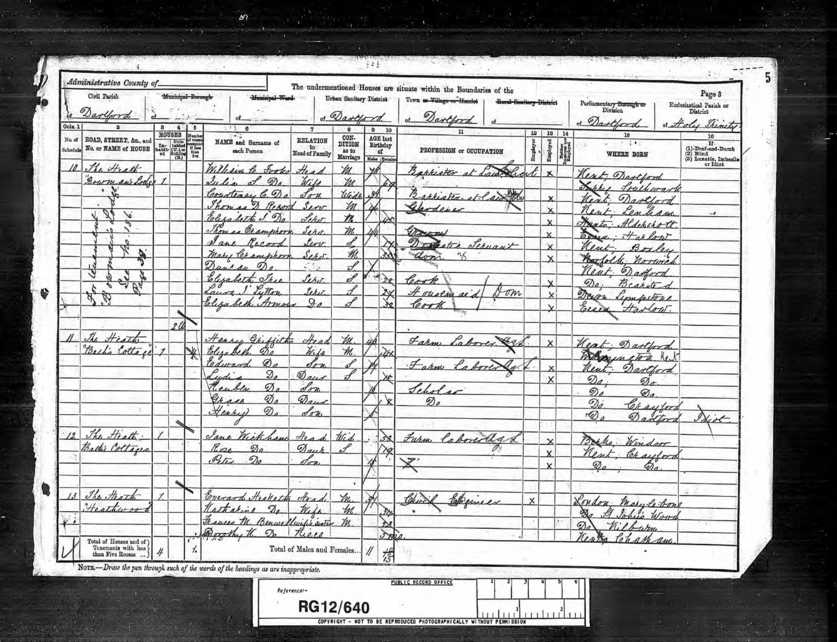
1891 census showing the FULLER family in the smaller cottage
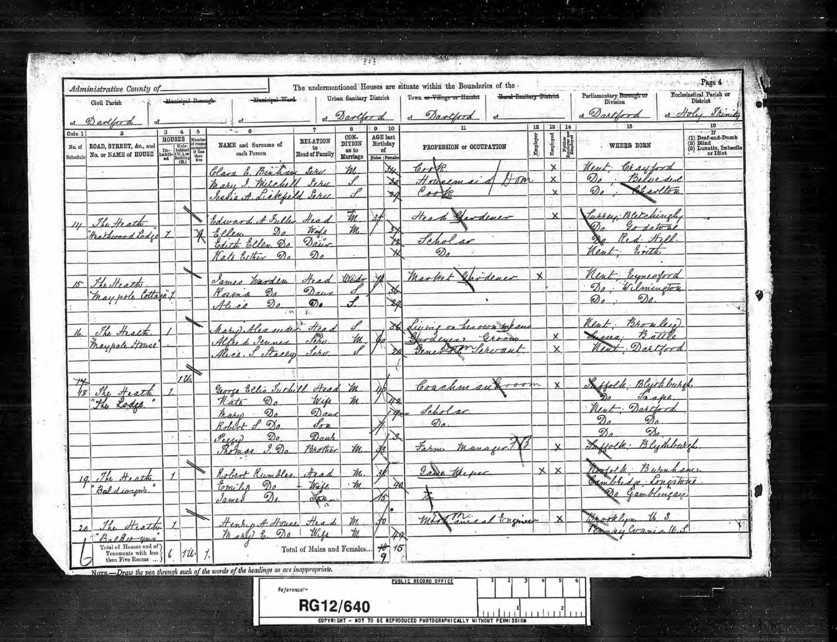
It appears that Heathwood later became known as Heathwood Lodge and the old Heathwood Lodge then became known as Heathwood Cottage. This appears to have occurred after 1911 as the Electoral Register of 1900 and 'KELLY'S REGISTER' of 1911 still show the names as still being the former. However the Electoral Register of 1937 names the buildings as they were later to become known.
1911 census of the smaller cottage in the grounds of Heathwood Lodge - the much larger house.
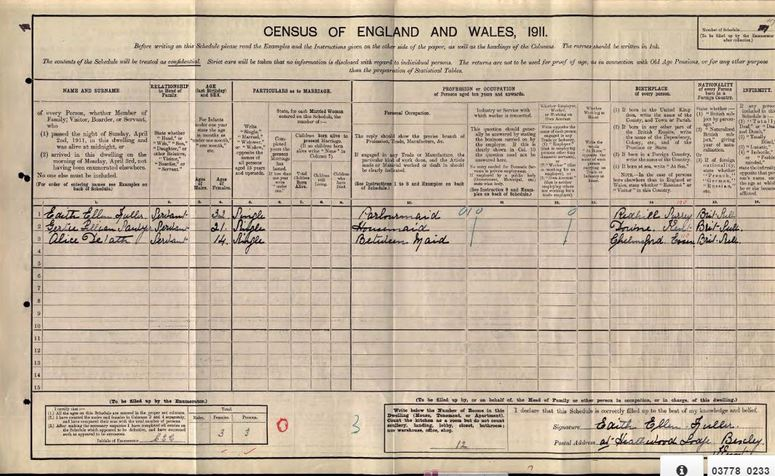
The 1891 Census from another source also includes the following information - contradicting the micro fiche record as cited above and showing the main house as containing the EVERARDS and the cottage as containing only 4 persons - so pick the bones out of that !
WICKHAM.
Jane. Wid. Farm Labourer.B.Berks.Windsor.
Rose. Dau.19.B.Kent.Crayford.
Peter.Son.15.B.Kent.Crayford.
The Heath. Heathwood.
HESKETHS.
Everard.37.Civil Engineer.B.London.Marylebone.
Katherine.Wife. 34.B.London.St John's Wood.
Frances M.BENWELL.Wifes Sister.M.23.B.London.Kilburn
Dorothy K.BENWELL.Niece. 3mths. B.Kent.Chatham
Clara E.BENHAM. M.34.Cook.B.Kent.Carayford.
Mary J.MITCHELL. 30. Housemaid.B.Kent.Belvedere
Jessia A.LICKFIELD. 29.Cook.B.Kent.Charlton
The Heath. Heathwood Lodge.
Following on from the HESKETH family the next known occupant to be shown on my records relates to a Rev Charles WRIGHT - as on the Electoral Register of 1900. He was still there in 1911. The late Joyce SMITH nee BEARCROFT, a previous resident of the Estate recalls that her aunt - her mothers sister - Charlotte GEORGE was employed as a cook at the house c. 1901. The GEORGE family lived at 28 Baldwyns Road at the time. She would have been employed by the occupant, as mentioned above, at the time - the Rev Charles WRIGHT.
Below is an advert dated 1906 from the South eastern Gazette for a 'good cook'. Apply to a Mrs WRIGHT. Did Charlotte GEORGE take up the position - or leave, creating a vacancy ?
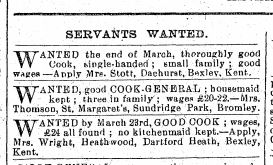
1904 June 28th - advertisement for sale of Heathwood Lodge £3000
South Eastern Gazette
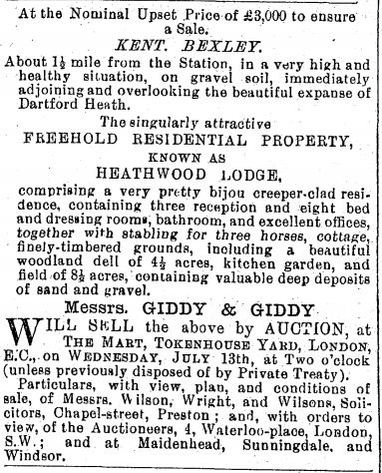
The Electoral Register of 1937 then show the names of the houses as changed and the occupants as being the JAMES family. It appears the family still had an interest in the place in 1945 - along with another couple - Alice and James WAINER. A previous resident of the Maypole Estate - Mr Phillip RUMBELOW - remembers as a boy, having 'tea' at Heathwood - the home of Captain JAMES c1939. Mr RUMBELOW states that he attended Eltham College along with the son of Captain JAMES - Colin? He remembers being greeted in the porch area by a large and noisy parrot. The large house was finally knocked down c 1962 to make way for the new A2, eventually being built in 1970.
Electoral Register of 1937
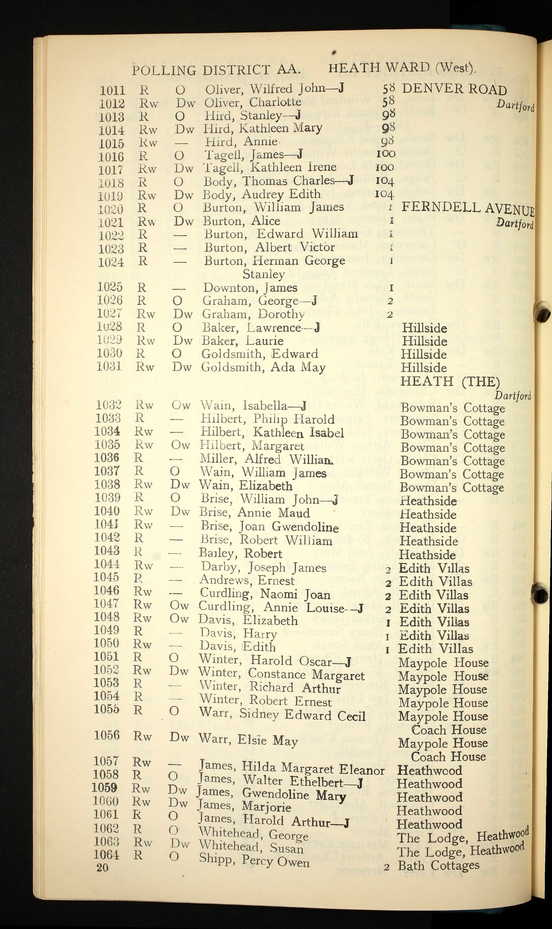
So far, the only occupants apart from the Fuller's that I have found living in the cottage were George and Susan WHITEHEAD. He is shown in the Electoral Register as being there until its destruction in 1968. I remember him as a gentle, silver haired, rather short man who always rode a bicycle and constantly wore a green beret. It appears that he was an avid cyclist in his younger days.
I remember as a teenager in 1967 going into his empty, derelict house. I retrieved from the loft of the cottage some unopened ‘Cycling Touring Club’ magazines that had been posted to him at that address, still sealed in envelopes and never read. The post marks date back to 1926 or so. I still have them. This indicates his occupancy from at least 1926 to 1967. Susan WHITEHEAD is shown in the voters register of 1958 but not, as is her husband, in that of 1968. The electoral register of 1937 shows the JAMES family as being in residence at the large house. There was Harold, Gwendoline, Hilda, Marjorie and Walter. The electoral register of 1945 shows multi occupancy. There were Ada and Francis COLE, James and Alice WAINER, and Margaret DAVIES. Hilda JAMES still lived there. This is the last record I have of the large house being occupied.
Below - original contemporary sketches by Maypoleman as a 14 yr old of Heathwood Cottage summer 1967
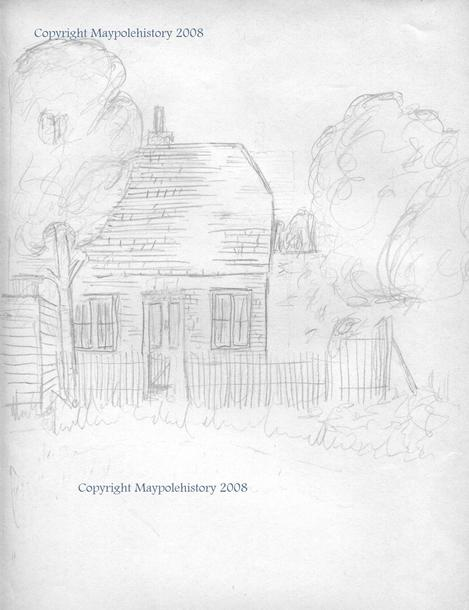
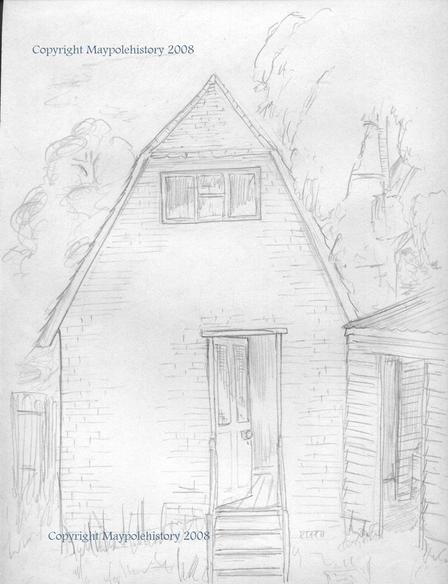
During my study of the area I have often considered how strange and sad it is that the larger, and more elegant houses only had a lifespan of some 80 years or so. The more humble terraced houses of the Maypole Estate still remain (after over nearly120yrs of occupancy) intact and very much alive and in use. Popular now for first-time buyers and were valued in the region of £200,000 upwards, until the recent downturn.
The early Maypole Housing Estate
THE EARLY MAYPOLE HOUSING ESTATE
Portman Close and Heathwood Walk stand on the site of where Maypole House once was, which in turn existed on the site of where Maypole Farm had been. Maypole Farm was originally situated on land that once formed part of the BALDWYNS Estate and was sold at auction in c.1876. Kept up so far ? Then we will continue . . . . .

Maypole from the air c1925
The eventual purchaser of the Baldwyns Manor and Parkland section of the Baldwyns Estate was the London County Council ( L.C.C.) This was the site chosen as suitable for the construction of an 'Asylum for the Insane'. The Maypole housing estate was developed and constructed to house the workers of the asylum.
There were shops built along the Bexley Lane facing the new hospital to supply the residents of the estate. There appears to have been a building on the site of Maypole Cafe (O.S. MAP 1869) for some time prior to the estate being built. At this moment we are endeavouring to discover its origin and identity. Evidence indicates that the parcel of land on which the housing estate now stands was bought by property developer(s) and not the L.C.C. (See chapter on BROOMHILLS).
A sketch plan dated 31st July 1897 shows that a Hotel was proposed on the site of the current three story building to the east of the mouth of Beaconsfield Road at the junction with Old Bexley Lane. This original plan mentions Messrs JENNINGS and FELL and indicates that they were involved with the building proposals of Denton and Beaconsfield Roads. Further information confirms that this is the case and that Jennings and Fell were land developers. They are mentioned in conveyance documents together with the owners of Baldwyns Manor who owned vast stretches of land in the area. That information refers to a transaction dated 1877.
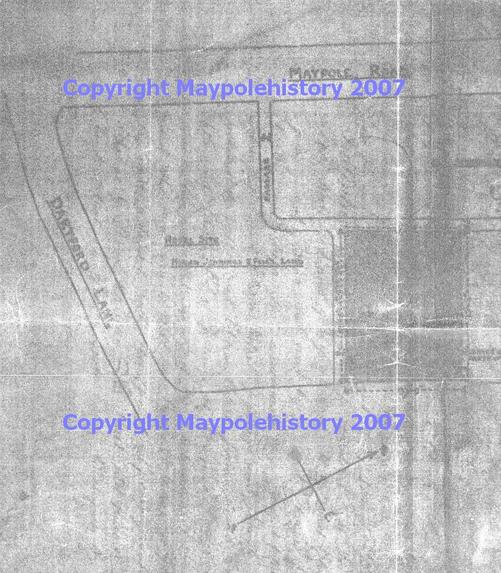
Above - Copy of blueprint showing proposed site of Hotel - on site of the later Maypole School c1899
Below - the profile (from the rear) of the original (and current) building to which is referred 'Proposed Hotel' does, in fact, resemble a half finished building which could quite well have been the beginnings of an hotel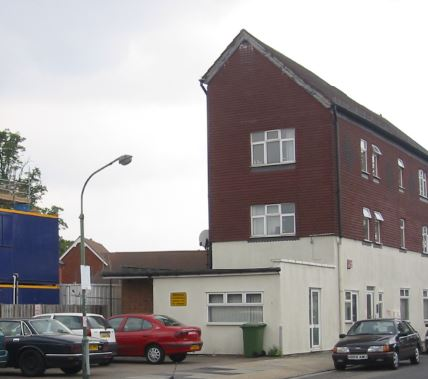
A lease dated August 1897 shows that the properties known as 2, 3, 4, 5, 6 and 7 Ivy Villas (Later to be called 14, 15, 16, 17, 18, 19 Dartford Lane then Old Bexley Lane) had just been erected and were leased to Frederick Vine who once owned the Post Office. He was referred to as a Builder in the documents. See the page on Ivy Villas.
The theory of private developers is also supported by the fact that the housing estate was constructed in fits and starts. It is understood that the CAMERONS who lived in Broomhills (c.1923 - 1959 ?) owned part of the estate and Mr Joseph CAMERON was responsible for the construction of several houses on the western side (51 - 63?) (Info from Phillip RUMBELOW and David CRUICKSHANK) of Baldwyns Road and towards the bottom of the road that adjoins Heathend Road.
Most, if not all, of the occupants of the original housing estate rented their terraced houses and most worked at the asylum. It is apparent that the lands of Maypole House and the housing estate were then made quite separate at the turn of the century.
There is a story that the first new house to be built on the Maypole housing estate, was Grosvenor Cottage on the Bexley Lane.
Below - Grosvenor Cottage c1996
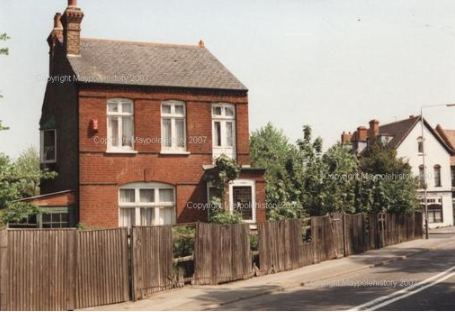
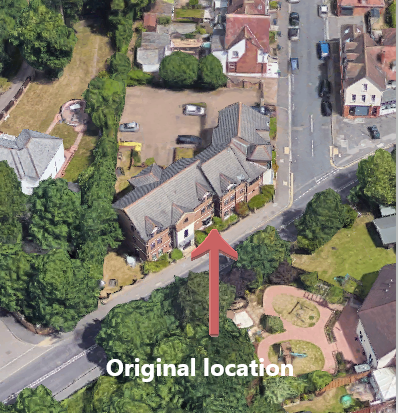
Before her death in 1995, one of the original occupants of the estate (Miss Eugenie SKEVINGTON) informed one of our team that this was the family home of the first contractor to start building on the estate. She maintained that one of the reasons for his residence there was so that he could overview the construction of the new Maypole dwelling complex. We have since been informed (by the late Naomi COSSHALL nee CURDLING) that it was constructed by Mr Joseph CAMERON for his daughter, Dorothy. The earliest record we have at this stage of occupation is the Electoral Register of 1937, showing Frances (Wife of Joseph) and John (Son of Joseph) CAMERON in residence.
The electoral register of 1900 shows that some of Baldwyns Road - certainly the even numbers in total - had been built and some were occupied. The same went for Denton Terrace. Maypole School was built in 1912 and opened in 1913 under the headship of James Frederick SNELL with Miss Ida MCCURDY reportedly as infants’ mistress. A Victorian O.S. map shows that the school is situated on land that had previously been the site of the local pound for the animals that once freely roamed the heath. It appears that Beaconsfield Road (Originally referred to as Maypole Road (early plans showing ‘Maypole Hotel’) and later as Beaconsfield Terrace (Mr Alfred PETERS)) was built just after Baldwyns and Denton. This is borne out by a photograph showing Denton Terrace from the front view and the buildings directly behind as the rear of houses in Baldwyns Road. If Beaconsfield Road had been built then this would have formed a physical barrier and would have shown in the photograph. It appears that from the date of construction of Beaconsfield Terrace (c1901) until about 1934 numbers 2 to 24 stood on their own.
To the front was the school, a green and the rear gardens of Denton Terrace. Number 24 was an 'end of terrace', flanked by the green, which extended to the rear gardens of Baldwyns Road. This meant that one could stand in Heath End Road and have an uninterrupted view of the school and the majority of its northern wall. Until about 1932 'The Green', as referred to above, was the 'playground' for local kids.
1902 Sale of plots of land for building - the enlargement of Maypole Estate is conceived.
South Eastern Gazette April 26th
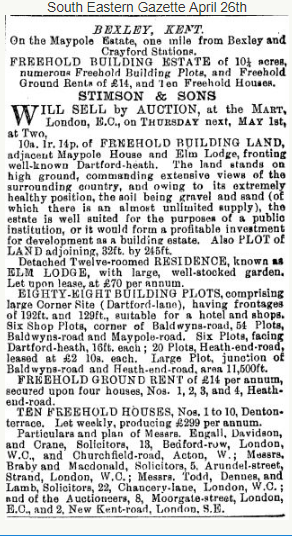
The annual bonfire on 'bonfire night' was held there. Further development of the estate then continued. Houses were constructed (odd numbers) opposite Beaconsfield Terrace and the even numbers were extended to Heath End Road. Rose Cottage, which once stood alone, was now surrounded.
The Electoral Register of 1937 shows Beaconsfield Road complete.
Below - - - - - Map showing the basic locations of sites in the early / mid years of the Maypole Estate
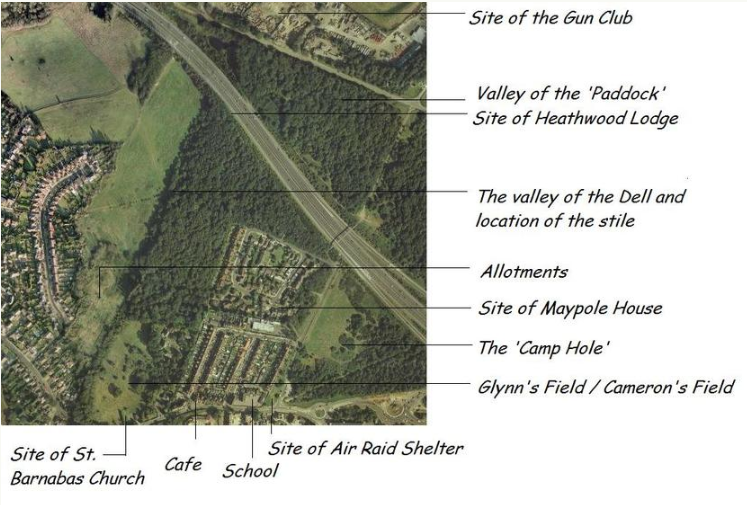
Ivy Villas, Old Bexley Lane
Recently discovered records (courtesy of Gary O'Connor - 'Maypole Born') show that Ivy Villas - those 6 houses between the Old Post Office situated at the junction with Beaconsfield Road and the first original shop premises - were amongst the first houses to be built. Plans on a lease dated 1897 show the villas in place, and around them the 'proposed roads' of Baldwyns and Beaconsfield. Old Bexley Lane is shown as Dartford Lane - the name of the road changed later.
On the land on the other side of Ivy Villas (Bexley Side - West), four shops were built. These were called 20, 21, 22, 23 Park View, Dartford Lane later of Old bexley Lane.
Eventually, the Post Office on the East end of Ivy Villas next to No. 2 Ivy Villas became 13 Dartford Lane (latterly Old bexley Lane). The tall building to the east of the Junction with Beaconsfield Road became known as 12 Dartford Lane (latterly Old bexley Lane).
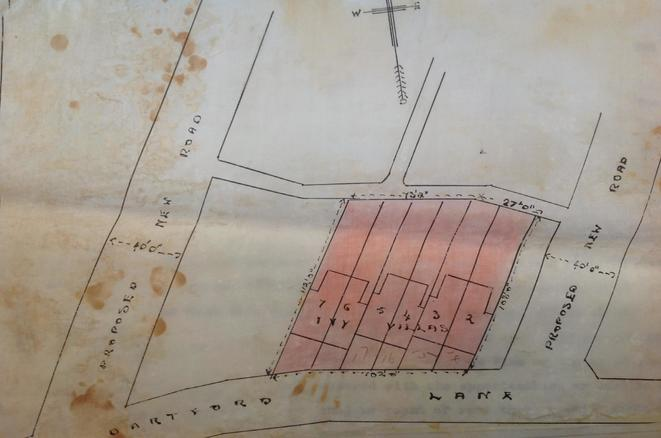
A lease dated 11th August 1897 showed that the 6 premises - referred to as 2, 3, 4, 5, 6 and 7 Ivy Villas - were leased to Frederick Vine from the freeholders, Edwin Jennings and Frank Fell, for a period of 99 years. Frederick Vine was described as a Builder from 3 Milton Villas, Carnarvan Road, South Woodford, Essex. He eventually owned / ran the Post Office for something like 50 years from the date of first construction.
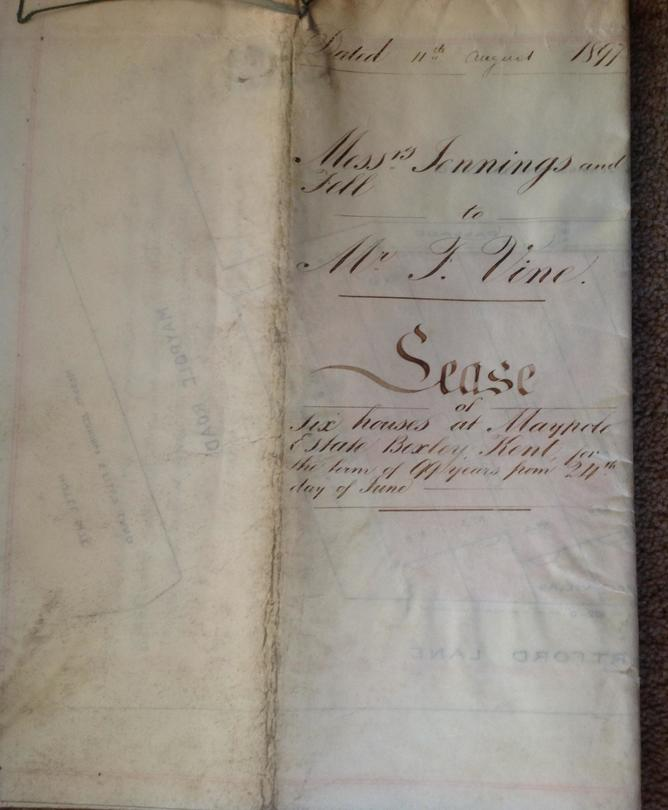
A Conveyance dated 23rd September 1897 then shows that the properties as described above were subject of transfer from Jennings and Fell to J Billington Booth Esq of Preston, Lancashire - a Justice of the Peace. It would seem that, for some considerable time, the freehold of all 6 properties 'en bloc' - and subsequent leasing - remained in place for several decades, all belonging to one freeholder or another.
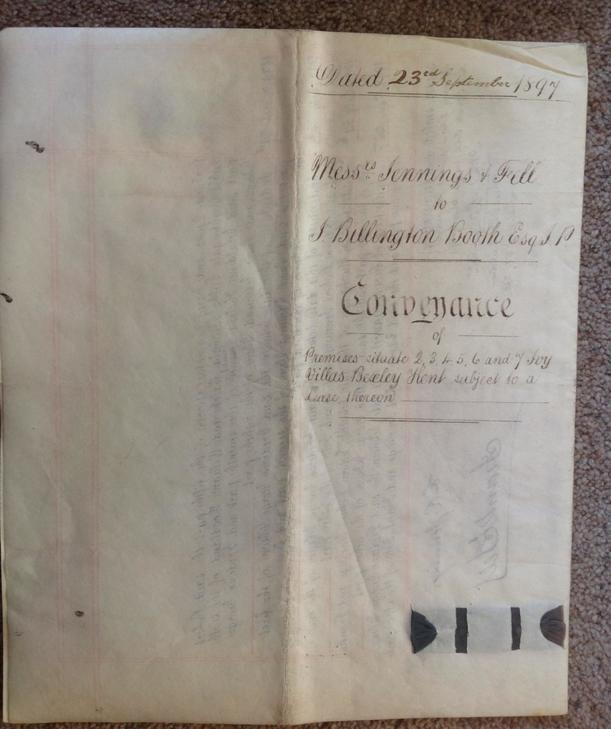
So, the numbering of Old Bexley Lane (Dartford Lane) in 1897 was 2, 3, 4, 5, 6 and 7 Ivy Villas. The Post Office was not shown on the plan and the margin of land between 2 Ivy Villas and Beaconsfield Road was just shown as 'Jennings and Fells land'. No building was shown or described. This land, presumably, was going to be called 1 Ivy Villas, as the Villas started at No.2 - why 2 ? On the opposite side of Beaconsfield Road was a piece of land described as the 'site of a proposed Hotel'. Heaven knows what this was going to be numbered or named as - eventually it became a shop adjoining the land set aside for the first Maypole School. The idea of a hotel was dropped.
At some stage later the houses referred to as 'Ivy Villas' then became part of Old Bexley Lane - then being numbered 14, 15, 16, 17, 18 and 19 Old Bexley Lane. It is a mystery as to where the preceding numbered properties were or where they were believed to be or proposed to be. Just to add more confusion, the Mental Asylum was generally known as 1 Old Bexley Lane.
Later documents dated 1955 and 1958 show that the 'en bloc' status of the 6 properties had by then fallen into singular ownership and had become quite separate to each other.
The Maypole Institute (Hut)
The below is, at worst, 'hearsay' and, at best, 'local knowledge' - two very dangerous sources of information !
When the Cameron family moved into Broomhills c1920s they became an influential force within the Maypole Community. Seen as general 'Benefactors' by some residents on the estate they did much, in their own way, to try to improve the lot of the local residents. Two main visible and tangible gifts were the provision of two buildings - the St Barnabas Church Hall and the Institute 'Hut' - both on land donated for the use by residents.
The Institute 'Hut' is believed to have been purchased from the Woolwich Armaments factory at the Arsenal. These 'Huts' would have been readily available once the First World War was over. The hut has remained in situ ever since erection c1920. A Committee was formed in order to manage it's use and affairs. The land, in itself, was unsuitable in it's original form for the building of houses as it lay on a very steep slope, downhill towards the lands once owned by Maypole House. The hut actually sat on a plateau just big enough for purpose. There was only a narrow margin of land before it fell away in a steep downwards slope. The land has since been filled in and now forms a car park. Over the years the hut has been a focal point for meetings, entertainment, a youth club and an overspill class room for Maypole School during the 1950s and 1960s. It is now used as a Licensed Club.
Below - the official opening of the Club and Institute Hut May 1921 - courtesy of Facebook Group 'Bexley Archives'
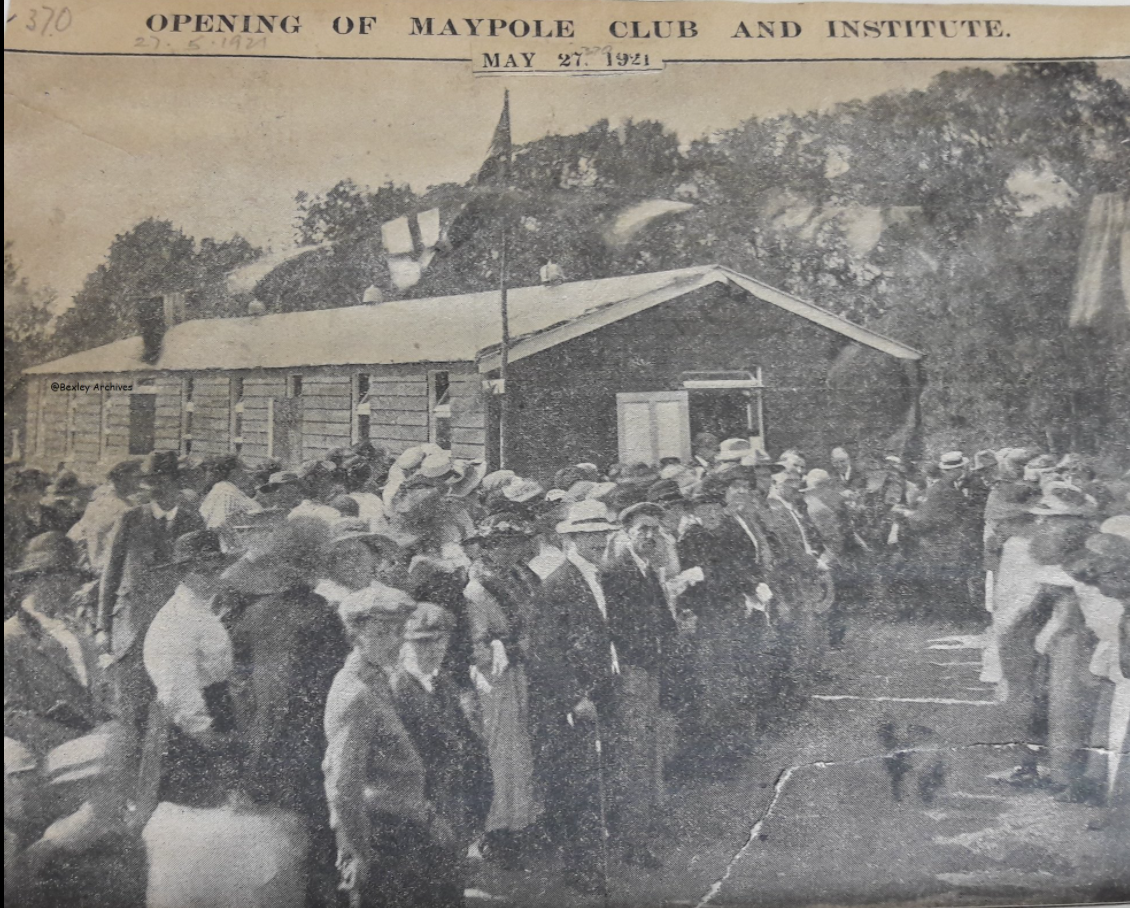 Below is a photograph (Courtesy of William Beck) taken in 1922 outside the front door facing
Below is a photograph (Courtesy of William Beck) taken in 1922 outside the front door facing 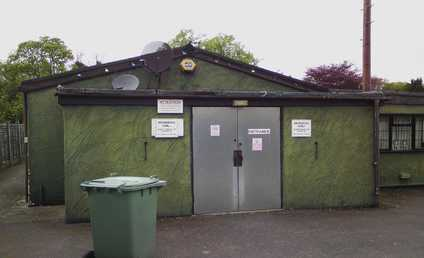
Below with original cast from 1922 superimposed
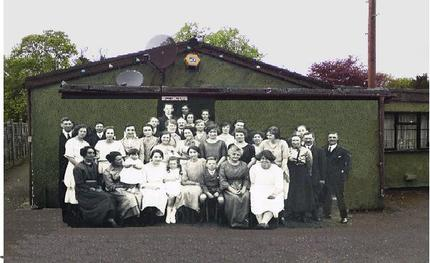
A Fire Station was once within the grounds of the Institute - see below OS Map 1938
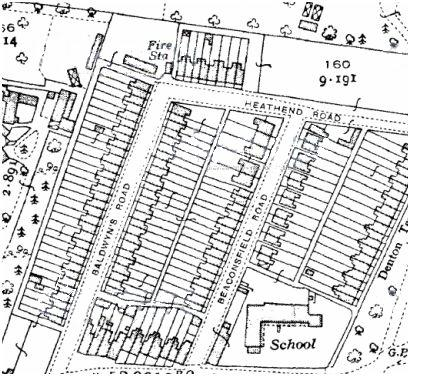
Below is the Fire Engine and some crew
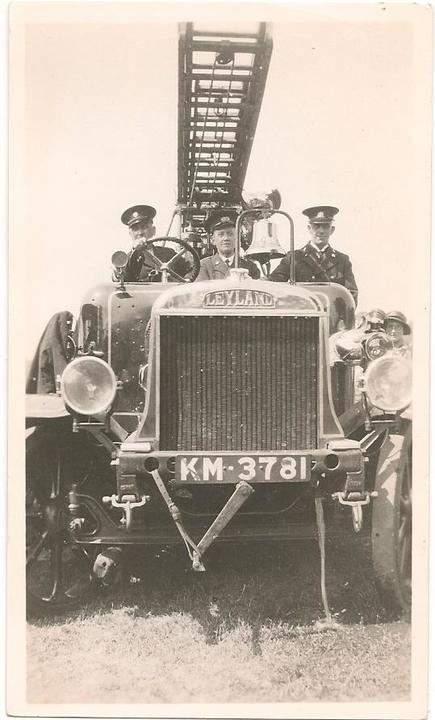
Below two images (Courtesy of Sheila Lusher nee Houlton) are of a childrens event c1946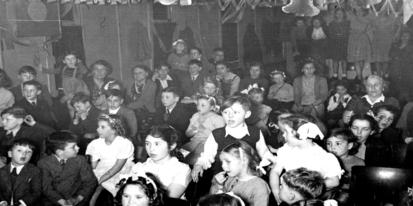
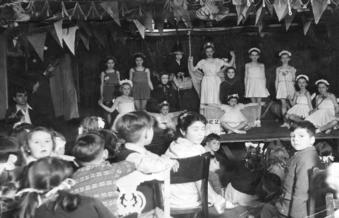
Below
cl947 a pantomime (Snow White and the Seven Dwarfs) at the Institute Hut in Baldwyns Road. It was the highlight of our lives then, and all put together by Joan Houlton. "Actors" right to left.
Nancy Beck, Dorothy Whitehead, Barbara Whitehead, Pat Flett, Sonia Windmill, Audrey Houlton, Joan Houlton, Marion Parker (Stephen NZ sister) Betty Cruickshank, Pat Richardson (me) Barbara Houlton, Janice Scott (dec'd)
FRONT ROW Roberta Cruickshank and Sheila Houlton.
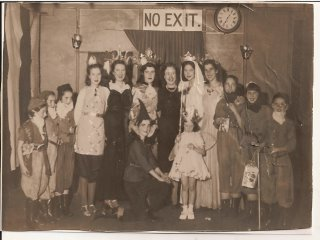
The below (Courtesy of the late Wendy Blackler nee Saunders) is of the Institute Football Club c 1921. Her father is second from left, top row.
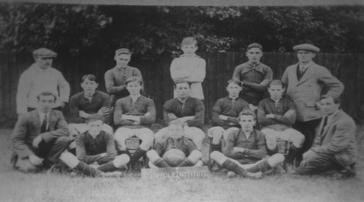
Below the Maypole Institute Football Club 1921-1922
Supplied by Alun George and he says about the picture
" "I have recently found a photograph of The Maypole Institute for the season 1921-1922 amongst my late father’s personal effects. This is a different photograph to the one already displayed on your site. My grandfather, Walter Leonard George is the gentleman kneeling front left with the jacket and tie on. I know that at this time he lived at 22 Baldwyns Road, Bexley, Kent and 1922 is the year that my father was born".
Further information is that the man in the hat top left is Mr HOGAN.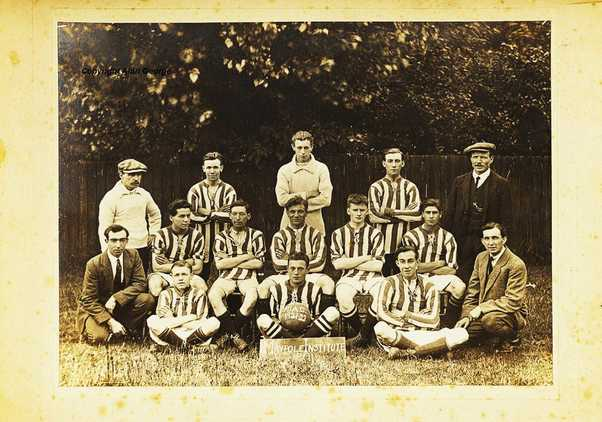
The annual Maypole Procession and Sports Day
THE MAYPOLE CHILDREN'S PROCESSION AND SPORTS DAY
In 1910 there started an annual procession that marched from Maypole Estate to 'GLYNs Field' or, as it later became known, 'CAMERONs Field', Broomhills. The event was held during the summer school holidays and was exclusively for the benefit of the local children. It was a time of festival and fun for everyone living on the estate and a chance for them to get together. Each year a 'Committee' was elected to organise and run the event. This event finally melted away in the 1960s.
Below is 'Glyns Field' / 'Camerons Field' / 'Broomhills Field' where the sports days took place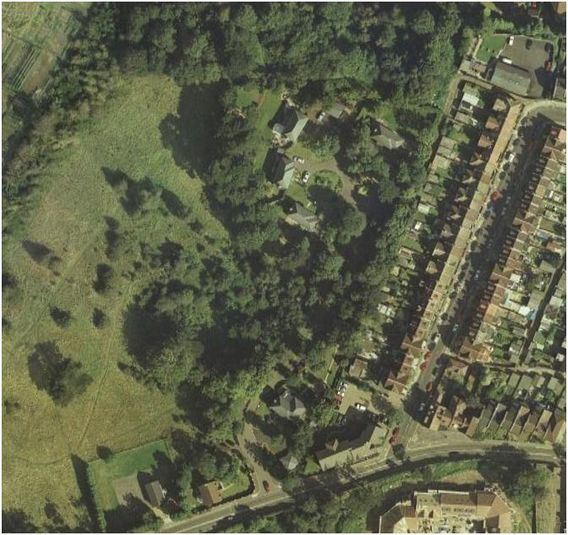
The occasion was pre-empted by much excitement and preparation by both children and adults alike. Costumes were made for the 'Masquerade and Fancy Dress'. Games had to be organised and devised for the 'Sports' that were to follow the procession. Food and drink had to be prepared for consumption in 'Broomhills Hall'. Great care was taken to ensure that children of all ages, sex and ability could take part - from the 100 yards, to the 'egg and spoon' and 'three legged' races. There were even 'tug o war' contests held separately for both boys and girls. Prizes were awarded in every category and the 'Committee' made sure that all children - even absent ones - received a prize of some sort.
There were speeches and live music was performed on a gaily decorated stage. The research and subsequent labour of love into the history of the Maypole Estate was fired originally upon seeing two sepia coloured photographs, supplied by the late Winnie BLACKMAN. They depicted a procession of children and adults in all manner of costume marching along the Old Bexley Lane c1919.
Miss BLACKMAN was unable to give me any details as to the year of the photographs or the names of any of the faces thereon. On countless occasions since first seeing them, I have imagined those little children and their proud parents marching up the lane. Driving along the same stretch of road now, 80 years or so on, it is difficult for me not to see them, still. Faintly laughing and softly transparent, they march in slow time and forever young.
It was 8 years since originally seeing those photographs that I had the pleasure of speaking to another elderly ex resident - Mrs Ruth Entwhistle nee LENNOX (Sister of the late Gordon Lennox). During her recollections she pulled out a copy of a newspaper cutting dated 31st July 1914. The cutting is reproduced below. Upon closer examination the description began to strike a chord. I took the cutting home and closely inspected the photographs supplied by Winnie. It was with hope and later great exuberance that I realised the event described in the cutting was undoubtedly the same event that had been captured on film all those years ago.
I could now date the photographs - and put names to some of the faces that had been frozen in time. The newspaper cutting brings to life the mood and feeling of the event. It faithfully reproduces an account of the day.
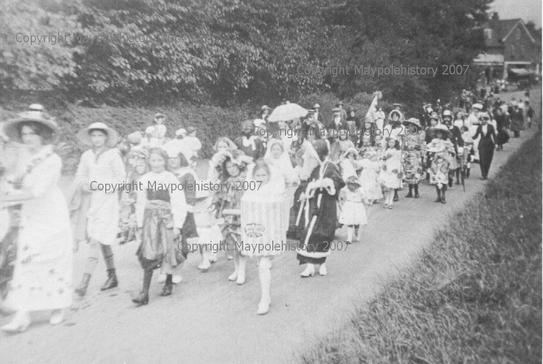
Photograph above taken on Saturday 25th July 1914
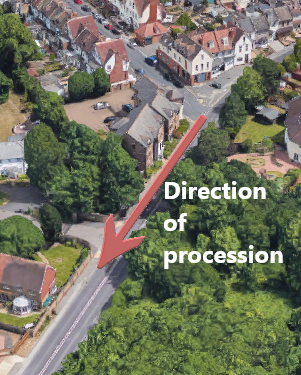 and below same location in 1997
and below same location in 1997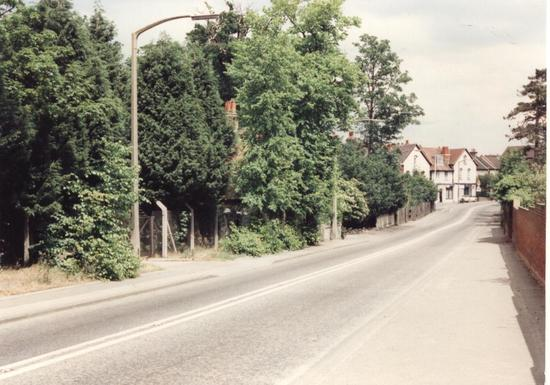
and now, below, 100 years later . . . .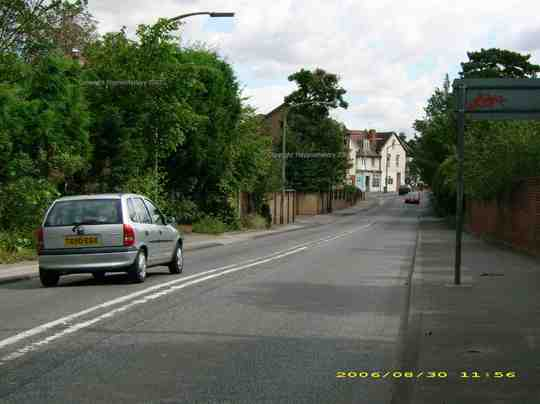
Below c 2008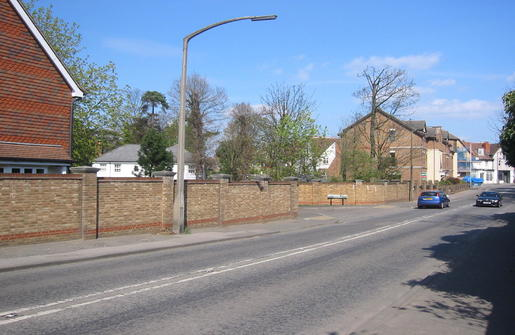
Below - April 2018 and old shop fronts right at the back still there !
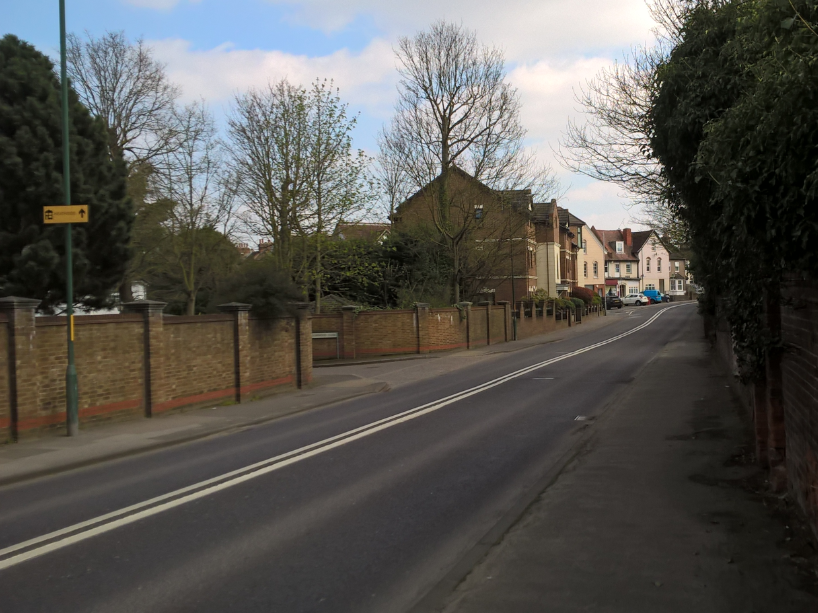
Newspaper cutting July 31st 1914
********************************************************************************************************
MAYPOLE DAY
FUN AND FROLIC
LET LOOSE
"A lady in male attire representing the Town Crier went round the Maypole Estate at midday . . . . . . . . . proclaiming 'the day of (days?)' to the residents who had been looking forward with great interest to what has now become an annual institution. With a powerful bell and a loud voice she warned all and sundry of the penalties that they would incur 'by order' unless they turned up alive and ready to share in the merriment. It was the fourth anniversary of the masquerade and sports and proved a great success, thanks to the active spirits who made the arrangements. Everybody concerned entered with zest into the fun and frolic, the children enjoying themselves, of course, most of all. Mr and Mrs J SAUNDERS . . . . . . as chairman of the committee . . . . . . . . . . . secretary and Mrs C Parker, treasurer. The committee, divided into two sections, had charge of the sports and superintended the tea which was provided by Dartford Co-operative Society in the Hall of 'Broomhills' by kind permission of Mr Lewis E GLYNN, a field being reserved for the gala. Members of the general committee were Messrs, Lockyer, McDonald, G Rose, Tucker, Waterman, F Piper, Parker, Saunders, Speck, Lucas, Oakley, Lynn, Dearsley, Wellspring, Burt, Row, F Parker, Spittles, Fielder, Taylor, and Loveland. Mr F Piper was chairman of the sports committee, Messrs. Piper and Tucker ...ing the handicappers, and their assistants Messrs. Rose, Lucas, Oakley and Taylor.
The Fancy Parade
Mrs Gray as "Town Crier" preceded the parade, which introduced singularly grotesque as well as artistic contrivances in fancy dress. No fewer than thirty-one prizes were given of the value of £12, the Misses Glynn judging . . . . . . . The successful competitors were:-
Fancy dress, home made --- 1, Girlie Baxter, Irish Colleen; 2, Norah Thomson, powder puff; 3 Elsie Partridge, flower girl; Nellie Springall, calceolarias; D. Sharman, Marjorie Jibb, Kitty Rowe, Nellie Partridge, and Mabel Welch.
Advertisements --- 1, Nellie Warr, Reckitt's Blue; Ivy James, Cadburys Chocolate; 4 Jack Room, cherry blossom; 6, Polly Skevington, Neaves Food; Dolly Colgate, Winnie Elliman, and T Elliman
Comic dresses --- 1, Frank Piper, Mephistopheles; 2, Colegate and Bush, prehistoric men; 3, Freddie Piper, soldier; 4, Mary Rowe, bricklayers labourer; 5, Harold James, John Bull; 6, Arthur Springate, pierrott; 7, Bobby Waterman, organ grinder; 8, Sidney Burke, red, white and blue.
Cycles --- 1, Ronnie Wellspring; 2, Norah Clark, rickshaw; 3, Lily Burke, decorated perambulator; 4, Willie Saunders, Sunlight Soap; 5, D Winchcombe, perambulator; 6, Ivy Gray, jockey on donkey.
Among others Mr W. J. Gray as a Scotsman in kilts, was prominent.Miss F Phil. . . . . Mr. F. Dearsley as the Mad Hatter; Mrs Burke, a nurse with perambulator; Miss Cataline Gray, Zebra grate polish; Mrs Russell, Bryant and Mays matches; Mr Spittles, horse and jockey; Elsie Burke, patchwork; Phyllis Elliman, Maypole Tea; . . . . Elliman, soap; Miss Elliman, monk; . . . . . . . . . . . . .Clark in an elaborate cycle device representing harvest; Geo Lennox, canary; Ilma ? Room, fairy; Kitty and May Room, bride and bridegroom; Lillie Partridge, Father Christmas; B. Waterman, organ grinder; Queenie Baxter, Irish Girl; and Miss Jibb representing "black and white" a famous. . .s Whisky. It should be borne in mind that . . . .(ald?) made a rollicking clown and kept the youngsters in constant amusement.
The Sports
Swings, Maypole dances, and a variety of sports were the attractions in the field, and music was supplied by a miniature orchestra consisting of a piano and violins on a gaily painted stage under the direction of Mr Lennox. The committee made a point of giving a prize to every child, including absentees from illness or any other cause. Mrs Glynn distributed the prizes, and, in response. . . . . . . . . . Mr. Glynn expressed his pleasure that they were all friends and neighbours in his grounds on that happy occasion, the success was entirely due to their energetic committee. He hoped to see them all again another year. The committee express their thanks to the donors of prizes. The winners at the sports were as follow:-
Marathon race - - 1, F Dearsley; 2, Fielder; 3 Lynn.
440 yards boys,-- 1, C. Rose; 2, R Baxter; 3, Jibb; 4 W Oakley; 5, W Proudfoot; 6, R Fielders; 7, W Saunders.
100 yards girls, 1, Connie George; 2, E Sherman; 3, N Warr; 4, N. Partridge.
80 yards boys, 1, A. Elliman; 2, Stan George; 3, G. Colegate; 4. P. Skevington.
80 yards girls, 1, Winnie Speck; 2, Mabel Welsh; 3, Alice Blackman; 4, Ruby wellspring
70 yards boys, 1, A Taylor; 2, L. Marsh; 3, F. Piper; 4, L. Partridge.
70 yards girls, 1, . . . . . . . 2, Ivy James; 3, Alice Wood; 4, Mabel Burt.
High jump, 1, C. Jibb; 2, W. Proudfoot; 3, C. Rose; 4, C. Burt
Balloon race, 1, Nellie Warr; 2, Elsie Marsh; 3, Marjorie Jibb; 4, Elsie Barber.
45 yards boys, 1, Tommy Warr; 2, W. Taylor; 3, A Lockyer; 4, H James.
45 yards girls, 1, J. Mason; 2, E. Smith; 3, N. Sprighall; 4, N. Wood
25 yards boys, 1, P Ivy; 2, S. Burt; 3, L. Colegate; 4, J. Hogan.
25 yards girls, 1, C. Elliman; 2, N. Thompson; 3, Jessie Taylor; 4, D. Barber.
Three legged race, 1. Cliff. Rose and Clem. Burt;2, F. Hogan and P. Skevington; 3, C. Jibb and Rex Baxter.
Egg and spoon, 1, B. Taylor; 2, Elsie Sherman; 3, Nellie Partridge; 4, D. Henn.
Potato race, 1, Sydney George; 2, H. Lennox; 3, .Stanley George; 4, Frank Piper.
Skipping race, 1, Winnie Speck; 2, Mabel Welsh; 3, C. McKean; 4, Alice Blackman.
Sack Race, 1, C. Jibb; 2, W. Bush; 3, Stanley George; 4, Rex Baxter.
Needle and thread, 1, Connie George; 2, Elsie Sherman; 3, Ethel Colegate; 4, Winnie Speck.
Boat race, 1, D. Taylor; 2, C. Parker; 3, J. Proudfoot; 4, H. Proudfoot; 5, E. Dolton; 6, W. Sherman; 7, Fred Piper; 8, P. Lynn and C. Ivy (tie).
Obstacle race, 1, H. McKean; 2, F. Smith; 3, G. Speck; 4, F. Cutler.
. . . . . (Cardea's Special ?) 100yards, girls over 14 -- 1, Olive Jibb; 2, O. Baxter; 3, F. Hambling.
Tug of war -- Boys, T.Dolton, C. Dolton, C. Burt, S. Parker, R. English, J. Lynn, J. Mandy, G. Lennox, R. Woods, T. Ford, C Chantry, H. Ringrose, J. McDonald.
Tug of war --Girls, E. Sandford, W. Elliman, E. Burt, D. Burt, L. Burt, E. Longley, J. Webb, A. Woods, M. Clark, V. James, A. Dolton, Mary Parker, J. Wickins, Q. Wickins, B. Ford, V. Mason, A. Sherring, M. Wood, G. Winchcombe, F. Winchcombe, M.Row, W. Blackman, E. Stevens, H. Shaw, K. Russell, E. Chantry, M. Parker, A. Ford.
Maypole Dancers -- May Parker, Nellie Warr, Elsie Barber, Alice Blackman, Connie George, Elsie March, Emma Sandford, Nellie Partridge, Florrie Baxter, Marjorie Jibb, Rosie Bush, Minnie Colgate, Gladys Ivy, Elsie Partridge
******************************************************************************************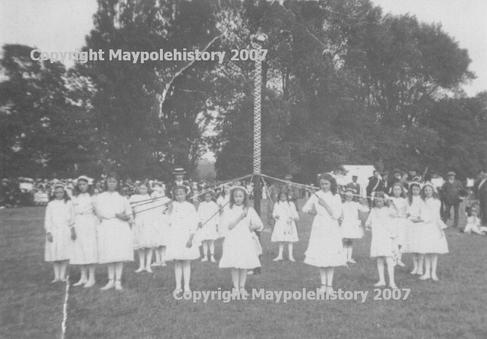
Maypole dancers - possibly from same year (1918) photo above
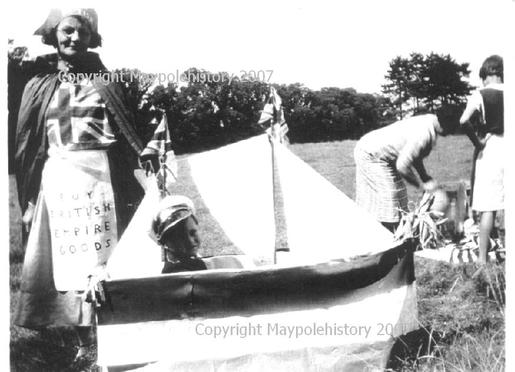
Fancy Dress competition 1935 Broomhills - Gordon Lennox in the boat.
Courtesy of the late Gordon Lennox
and below - same location / trees 53 years later.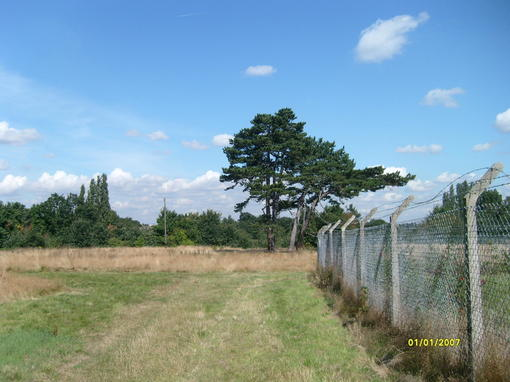
Below - procession Baldwyns Road, July 1954. Mr Cruickshank far left and Mrs Potter (nurses uniform), Courtesy of Penny Smith
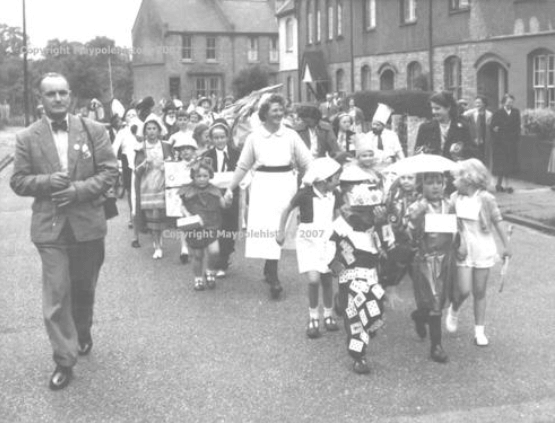
From Paul Lindridge on Facebook. He adds more information viz:-
The lady looking down behind Mrs Potter is his mother and she was looking at him (Paul Lindridge or his twin brother), John. John Parker is in the photograph and he had a twin sister, Jean Parker. Jean married and moved to Cornwall where she still is with her family. John Parker was tragically killed when he was a teenager, in a motorcycle accident in the 1960s on the A2 on Dartford Heath. John Parkers mum and dad (Nancy and Norman) also moved to Cornwall but have sadly both passed on.
Below - as it is 50 years on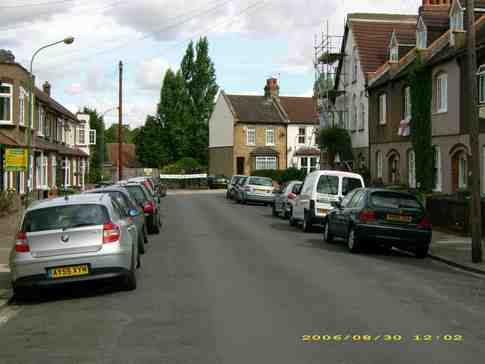
Below - as it was c1910 - courtesy of Brian Porter
![[Untitled] [Untitled]](https://static.s123-cdn-static-c.com/uploads/1523176/2000_5baf8a4639793.jpg)
Again in July 1954 below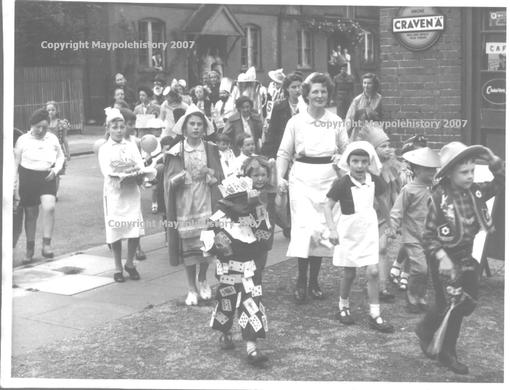
Above - same procession as above but outside the cafe - note the conscripted soldier in uniform
Photograph courtesy of Penny Smith
Below as it is now . . . . 50 years on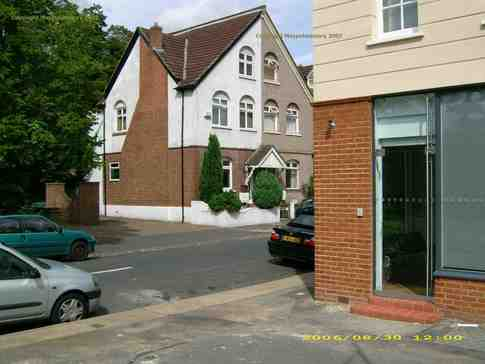
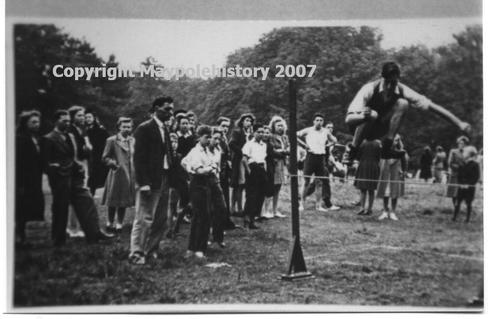
Sportsday Broomhills 1950s - Gordon Lennox high jump ? 'Buster' - tall man, Wendy Saunders to the left of him. 'Dickie' Balcombe (possibly Johnny Seymour ?) to the left of Wendy (hands in pockets) ?
Photo courtesy of the late Wendy Saunders
Three legged race sportsday Broomhills 1950s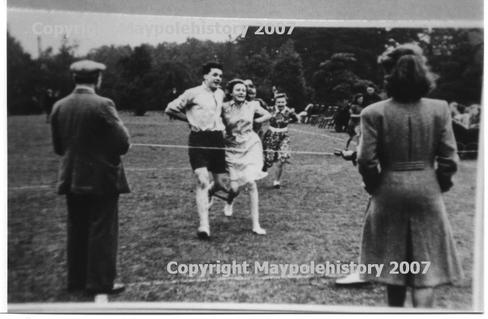
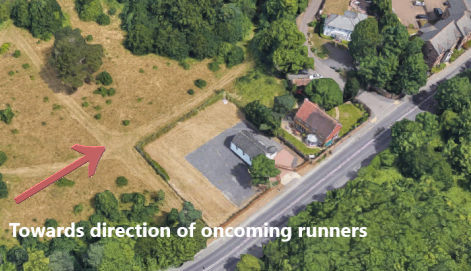
and below as it looks in 2010
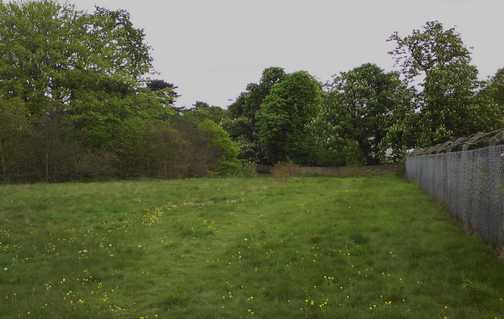
Cross Country run c 1955 . . . . .
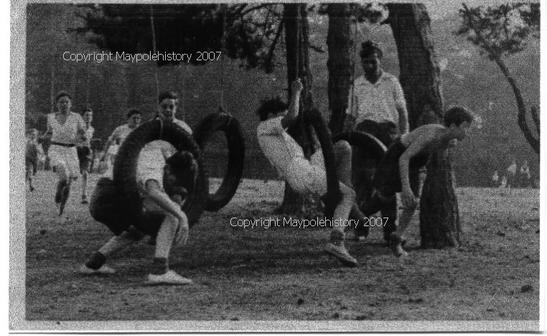
Cross country Broomhills c1955 ?. Believe man standing is 'Buster' from Denton Terrace. Can you identify any others?
and below as it looks in 2008 . . . . .
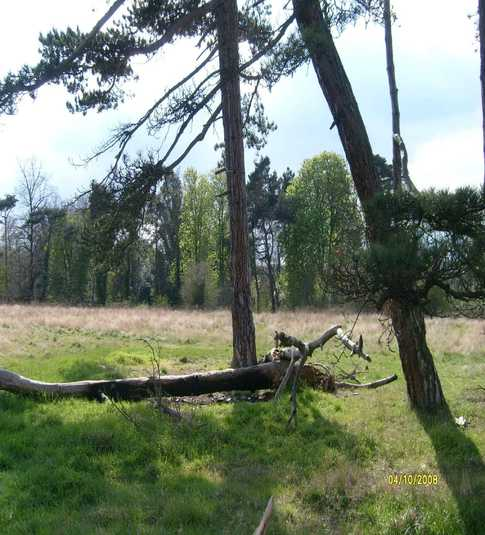
From Lee Smith - photos of the procession in 1951.... do we have a community spirit like that in your street? I haven't seen it since the Jubilee . . . . . .
Baldwyns Road - man in short trousers - the father of Lee Smith
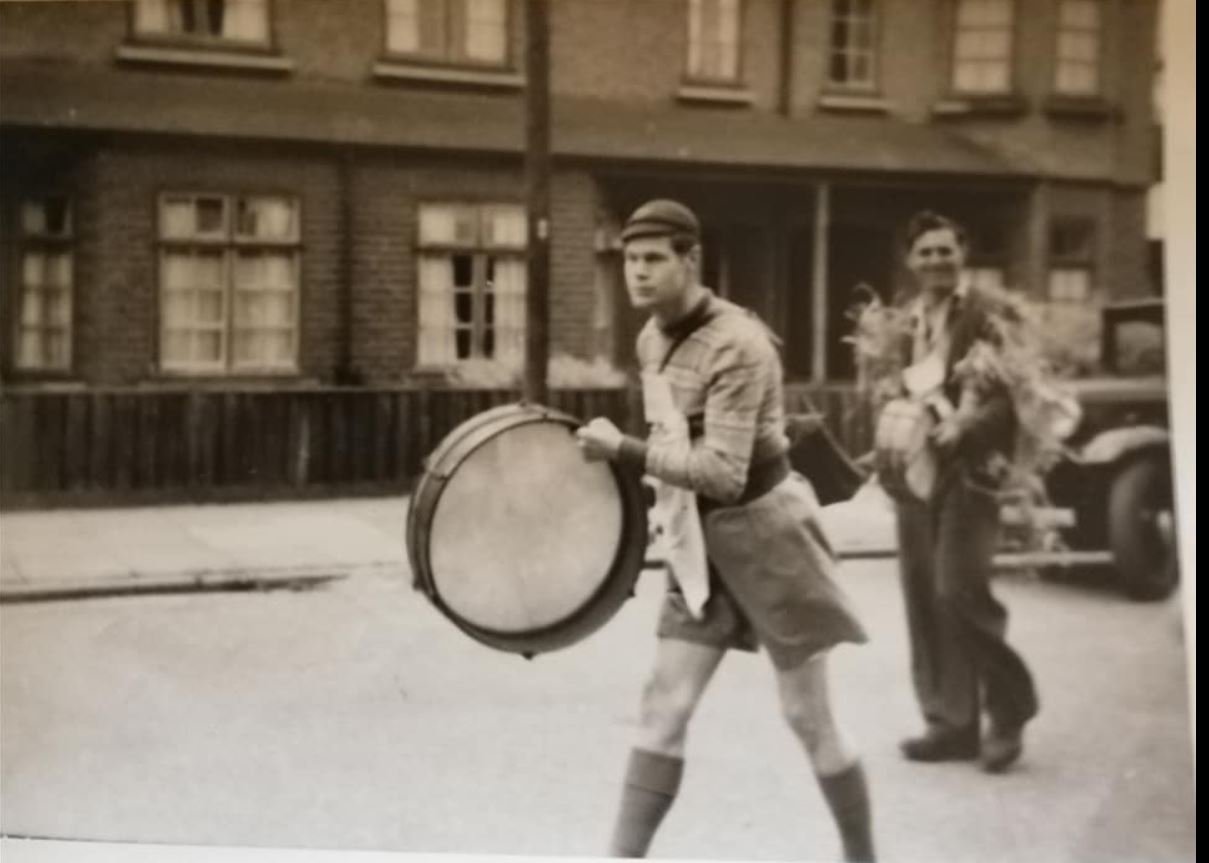
Below - Baldwyn's Road and the Maypole Club and Institute Hut
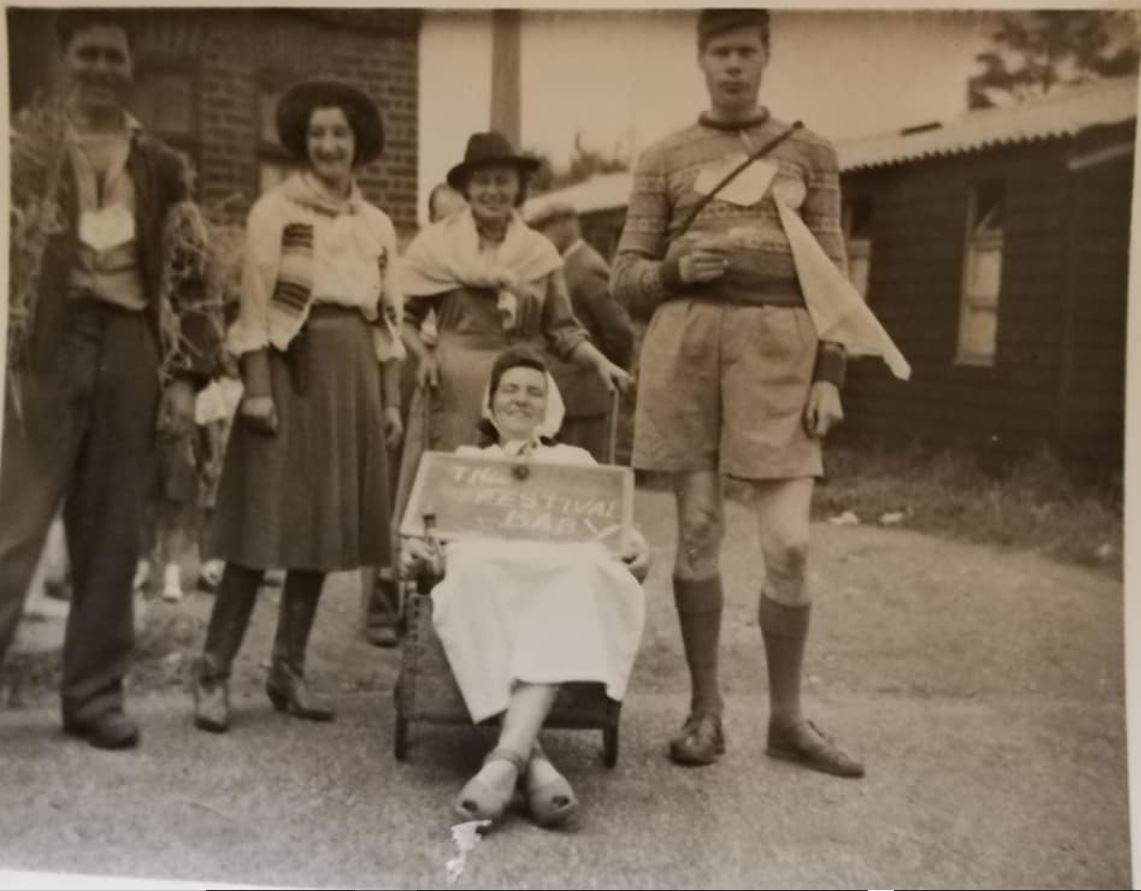
Below - Baldwyns Road looking g towards direction of the Maypole Institute Hut
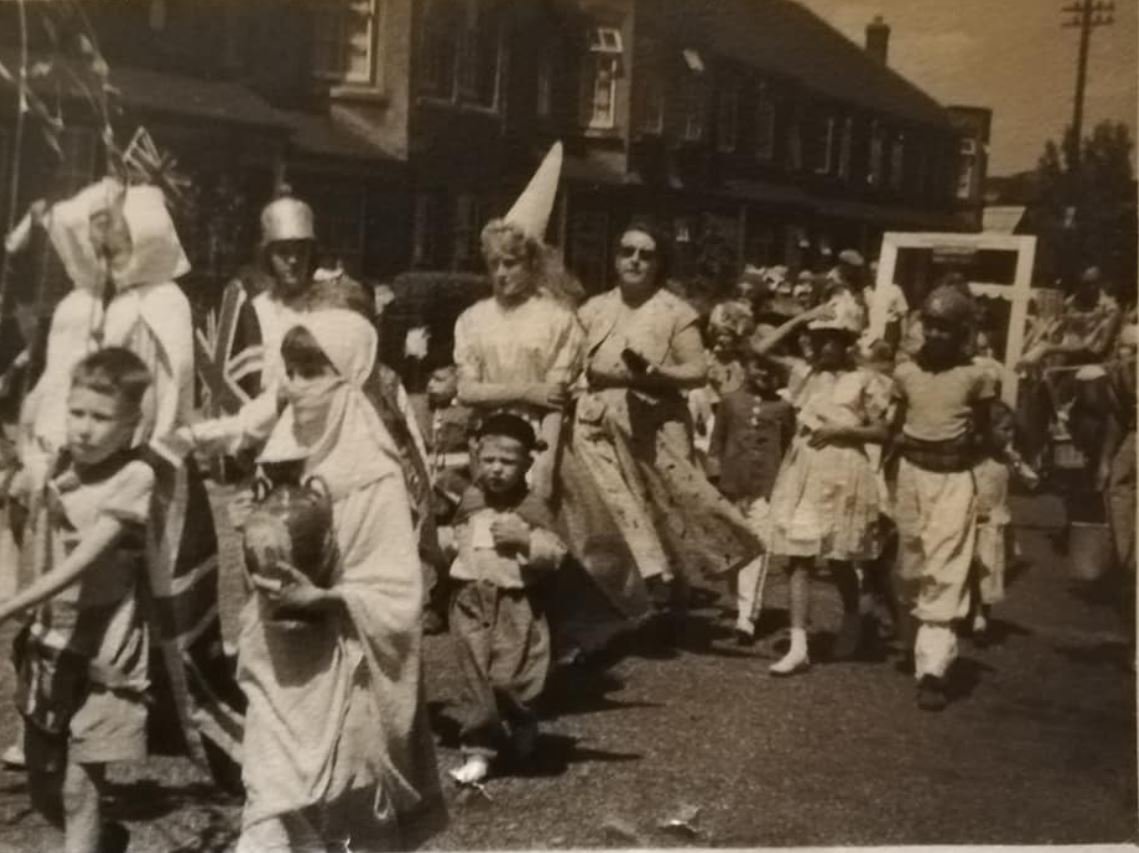
Bonfire Night
E Mail from the late Steve Parker has started this new page . . . . . .
Talking to my Grandchildren about Guy Fawkes night, got thinking about the great nights we used to have just after the war 1946,47,48,49,50.
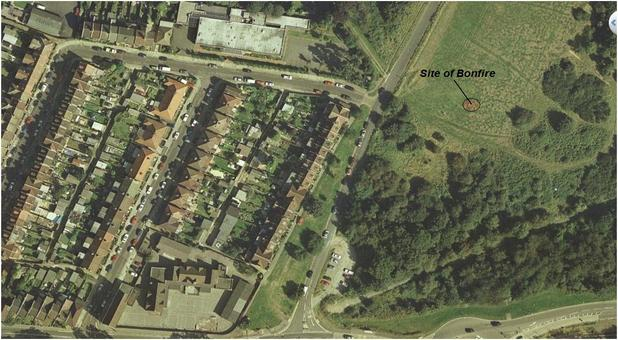
The kids on the Maypole (of which I was one), used to start collecting rubbish for the bonfire weeks before the fifth, the fire was situated on the edge of the heath at the top of Heathend Rd. All the Maypole residents would be involved & save their rubbish,by the time of the big night everyone would turn out for the lighting & fireworks, of which there were plenty & bangers were bangers in those days & I'm not talking sausages!! One person who needs a mention was Herbie Richardson who always had some big rockets & Roman candles, ( or were they redundant flares?). Whatever they were he always put on a good show. When the adults started to wander home we kids would start our midnight feast of baked spuds, they always tasted better than any other time.
I must also mention Mr. Pope who would give rides to the kids on his pony. Great times & I can't recall anyone getting hurt, just a few minor burns. Anyone else remember these nights. Steve Parker
From Kim Button - Well, Steve - these are my memories of the time around Guy Fawkes night . . . . .
My ‘window of time’ as a kid was between c1963 and 1967. We would start collecting for the bonfire a couple of weeks prior to the 5th. After school and at weekends we would knock on doors of the houses on the estate and ask if they had anything to burn. It wasn’t seen so much of a danger then - especially when we knew most of the residents, anyway. We would use all sorts of trolleys, contraptions and old prams to ferry the stuff over to the heath. We would always go around in little groups as some of the stuff could turn out to be quite bulky or heavy. My little gang at that time were:- the late David Richardson, Philip Read, the late Peter Walker, the late Mike Moran, Tony Smith, John Barrett, Robert Hogan, Alan and Barry Booth, Terry Warner, Michael Mckeough, Edward Ginn, Penny Smith, Alan MacLean and Philip Hayward. Most of us lived on the estate but some came from Baldwyns Park and Coldblow.
The main reason we youngsters laboured so hard was for the money we could earn ! Some residents took every opportunity to rid themselves of anything burnable (and not so burnable) and there were times when we would take complete demolished sheds, entire privet hedges, bushes, shrubs, furniture, doors, fences etc. If they were generous, the resident would give us three or four bob or thereabouts (15-20 pence in today’s money). Doesn’t seem a lot but this was more than our individual weekly pocket money - well worth it. This money would be shared out equally at the end of the day among the kids doing the job. A good Saturdays work could earn each of us about 5 shillings each (25 pence). Therefore, this was about two weeks pocket money in one day. At that time a packet of 20 cigarettes was about 3/9d - three shillings and nine pence (about 17 pence) so we felt very lucky. Sadly, some of us started smoking at 14. We felt it made us look so much older and was a really ‘trendy’ thing to do in those days. I wish I had never started. I have now stopped (March 2013).
As the bonfire grew and grew in height and girth so we would actually ‘sculpture’ it. Our ambitions normally exceeded the reality and most of the bonfires I remember had large circumference bases - in anticipation for a really high monster. So, as the 5th neared we would then gather up the looser stuff and create a thinner and higher fire. One of the greatest pleasures for us was to build little ‘camps’ in the fire. We would use all sorts of imagination and items to build our little ‘dens’. We would use wood, lino, carpet, rugs, plywood, old doors, hardboard, motor cycle sidecars - anything. Some of these habitats were quite ‘roomy’ and when lit, added to the burning process by creating open pockets allowing flames to accelerate. Some people would take advantage of the opportunity and throw old mattresses on to it - these were filled with wire springs so were not really suitable - however . . . . . put two or three on top of each other and - hey presto - you have a fantastic trampoline !
As the 5th came nearer and nearer so our collections of small fireworks grew as well. Us boys weren’t interested in the pretty stuff - we wanted bangs. Bangers were usually 1d each.

Better ones were the 2d or 3d ‘Cannons’. These were just larger bangers. The best bangs came from ‘Aerial Bombshells’. They were about 1/6d each. (7 and1/2 pence in today’s money). They were fat, dumpy bangers. Some of us crazier kids would put them into sawn off scaffold poles and ‘fire’ them. Elf and safety would have had a field day.
Below 1930s posters
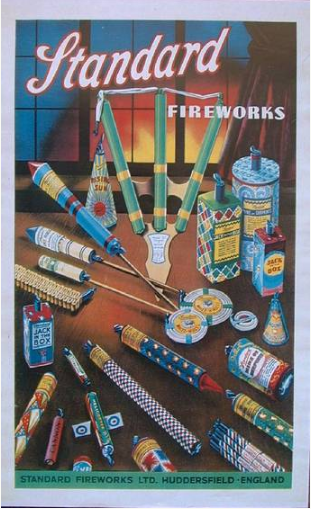
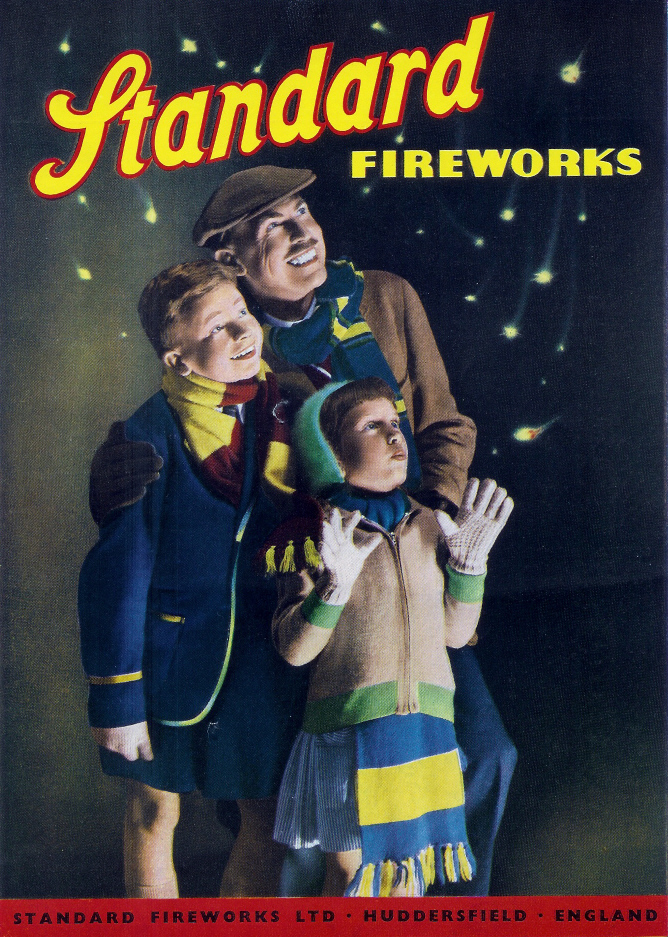
The actual night of the bonfire we just couldn’t wait for it to get dark. It always seemed the ritual that ‘Buster’ from Denton Terrace had the privilege of lighting the bonfire. It would burn and burn furiously for hours, surrounded by many families all going ‘ooh and aah’ as people would light their fireworks. As Steve has said the best part was putting spuds or chestnuts in the embers.
The following day it would still be smoking and we would pile up the leftovers to make yet another fire. Great days. This practice of the bonfire on the heath ceased c1970 when the old Maypole School started to use the heath as their sports field. Several attempts were made to build more bonfires but they were quickly dismantled and taken away by the Council. End of an era.
If anyone else has any memories of this annual event please E Mail us at the site.
Maypole School
This page contains video footage
Over 100 years ago the doors opened in February 1913 to the first pupils . . . .
The doors finally closed in July 2002
It was announced in the South Eastern Gazette on 1st October 1910 that a much needed school was going to be built once completion of the purchase of the land had taken place.
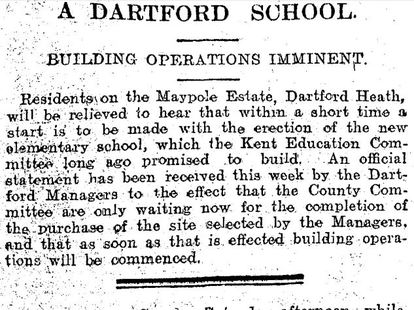
Read Mr Alfred Peters story and it will enlighten you to the early years of the school . . .
Below - courtesy of Michael Jennings - two photos - class from the 1960s . . .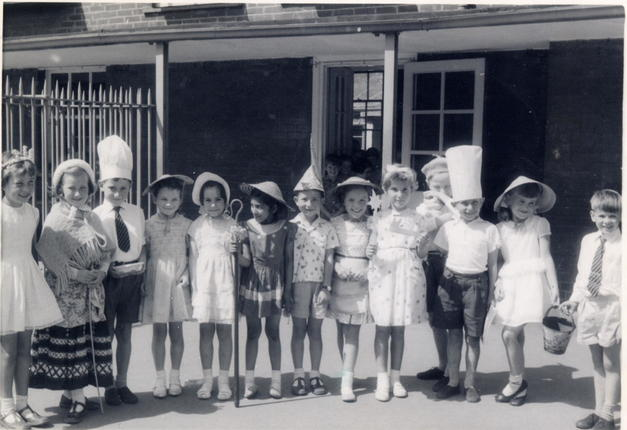
David Hamid is 'Little Boy Blue' (the lad in the very middle with the hat) whilst 'Ron' Gosling is the lad wiping his nose ! David attended between the years 1960-1963.
David Hamid is now described by Wikipedia as . . . . .
The Rt. Rev. David Hamid (born 18 June 1955) has been the Anglican Suffragan Bishop in Europe since 2002. Born in Scotland, to Scottish and Burmese parents, Hamid holds dual British and Canadian citizenship. He was educated at Nelson High School, Ontario, McMaster University and Trinity College Toronto. After ordination he was curate at St Christopher’s, Burlington, Ontario, and then rector of St John’s in the same city. Following this he was mission co-ordinator for Latin America and the Caribbean for the Anglican Church of Canada and then (his last post before his ordination to the episcopate), the Director of Ecumenical Affairs and Studies of the Anglican Communion. He is married to Dr Colleen Hamid, a medical researcher, and has two sons, Jonathan and Michael.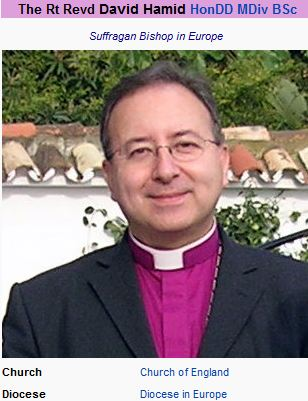
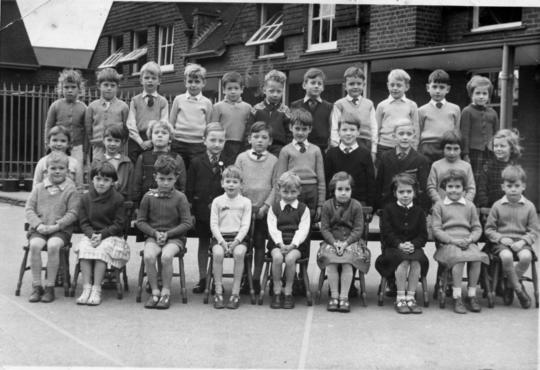
Below is believed to contain some of the same class a year or two later
supplied by Barry Booth
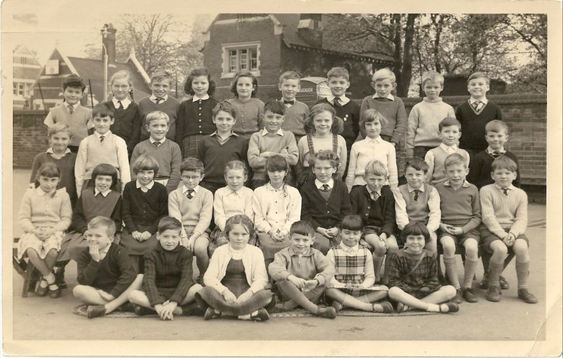
and the names of the above participants
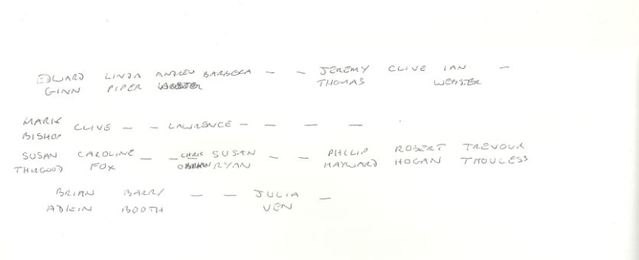
From Phillip Warren - he remembers class names as:
Names of pupils (in the picture attached) follow but please note, I'm putting DK if I can't personally name them (even where someone else has). Spelling definitely not guaranteed.
Philip's school attendance..
I started at Maypole in September 1961 (1st year juniors)
September 1962 (2nd year juniors)
September 1963 (3rd Year)
September 1964 (Transferred to Joydens Wood Primary School for 4th Year juniors)
September 1965 (1st year secondary school at Swanley Comprehensive)
-----------
Below two photographs courtesy of Barbara JOSS
The photo with the bike in the backgroud and the open school windows is probably 1960. The other with the telephone box is one year later 1961.
So the first one: DK means I can't remember the name...
Top Row: DK ,, DK ,DK(but I did sit next to him all year) Elizabeth Worcester, Jackie Rumble, Jennifer Hankey ,ElainePrice, Nigel ,Richard, Owen Gemmell
Second Row:Lesley Williams, Patrick,Robert Merriman , David, Barbara ,Barbara Thomas(me) ,Sarah Groom, DK ,Rob, Vivien,
Third Row : Judith, DK, Heather,Janet, DK, Judith,DK, Maxime Penny,Christine Russell
Fourth Row: Ronald,Derek,Simon, Alan Parnell, Anthony.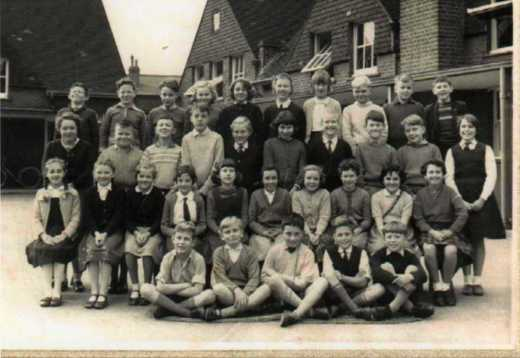
Here are the names for the second photo, the one with the telephone box.
Back Row: Katherine,Derek,Simon,Ronald,?Peter Hooton,Owen Gemmell,Elaine Price,Jennifer Hankey,Nigel,Christine Russell
Second Row: Vivian,Barbara Thomas(me) Rob,DK,Patrick,Sarah Groom,David,Rob Merriman,Barbara,Lesley Williams,Jackie Rumble
Seated: Alan Parnell,Richard Wright,Antony Wilkinson, Penny,DK,DK,Keith Walmesley,Elizabeth Worcester,DK,Judith,Janet Hayman,Linda
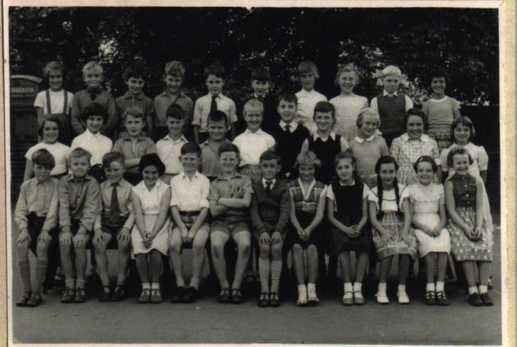
The below 2 x photographs supplied by Ian Gregory - exact dates unknown but early 60s
Photograph below - Maypole school
Front row 3rd from left - Alan Gregory
3rd row far left - Christopher Giles ?
3rd row 3rd from left - Penelope Mercer
Comments from me - I am far left, bottom row. Alan Gregory died in 2000 aged 47 yrs.
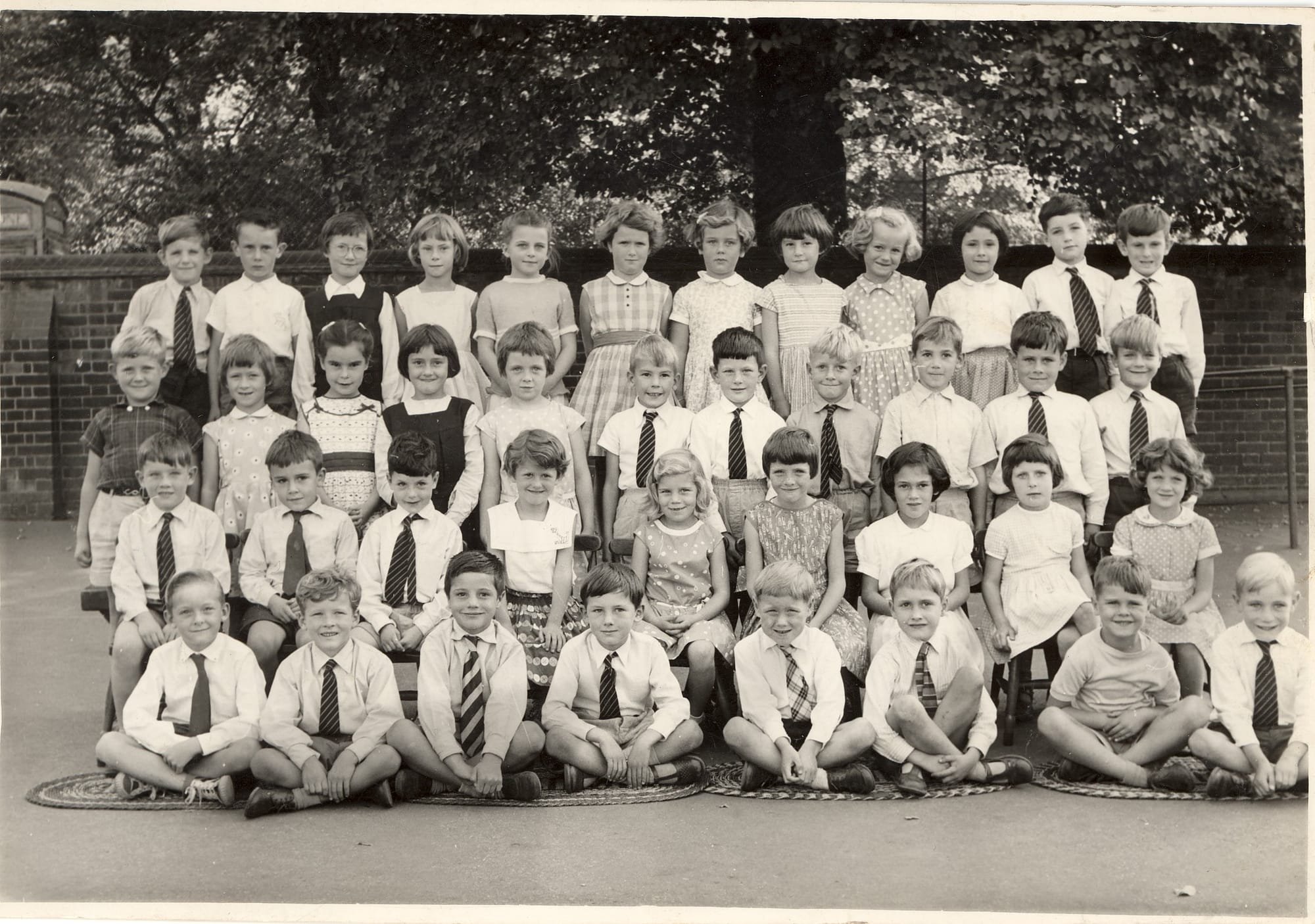
Above photo - from memory of Kim Button
Bottom row
Left to right - Kim Button, Roger Payne?, Alan Gregory - - - - Gary Jewel
Photograph below - Maypole school
2nd row far right - the late Alan Gregory
3rd row far right Penelope Mercer
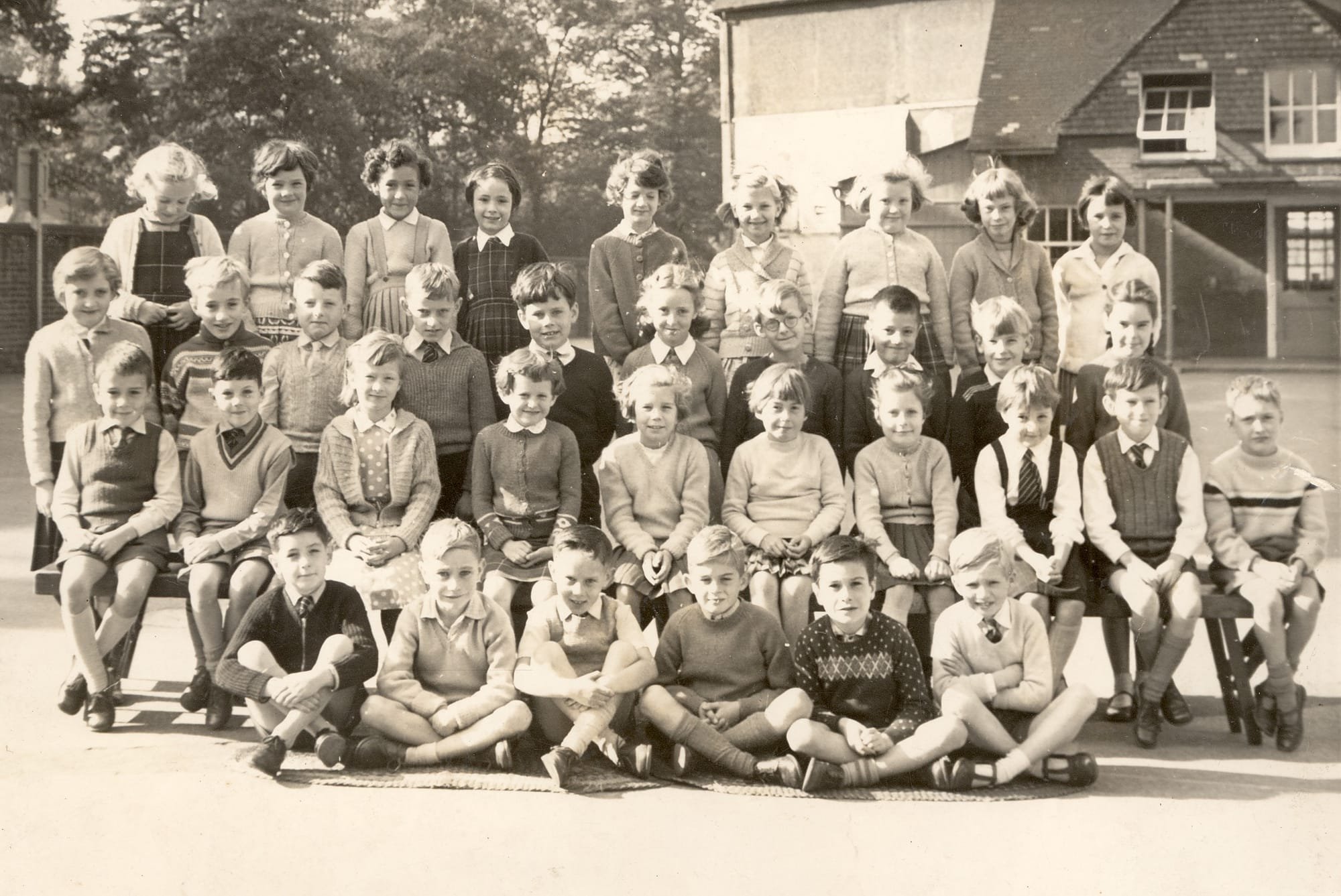
The below from Richard Wight courtesy Peter Hooten - taken c1960
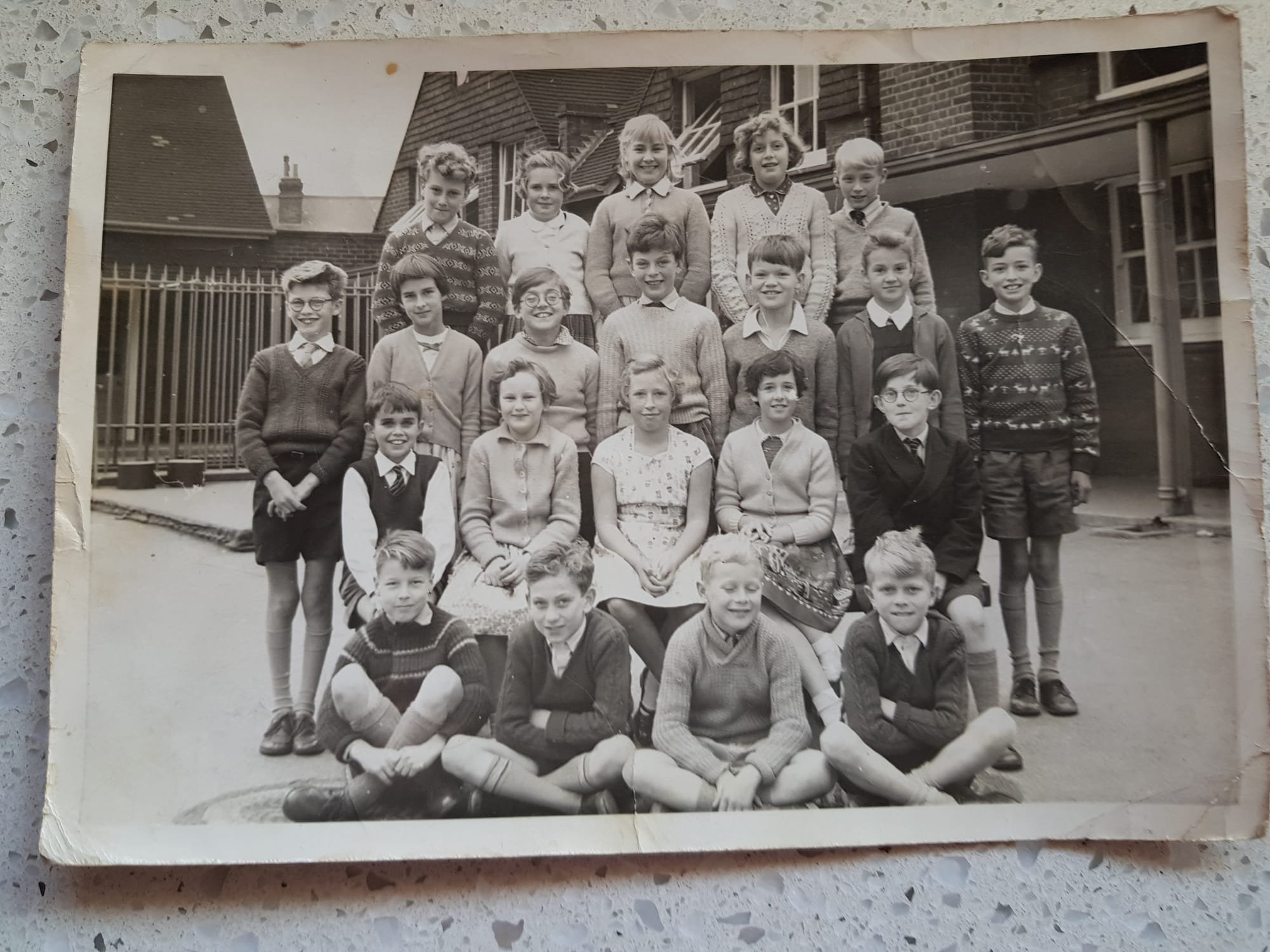
Richard Wight describes the faces
The people I can remember from left to right starting with the back row -
Patrick Hutchinson - his dad was a hospital fireman and they lived at the Broomhill's gate house.
On the other end is Peter Barber who sported a deaf aid that was always feeding back.
Middle row -
Tony Barker- Joydens wood self build site next door to the Hootens.
Catherine Bowyer re Tredigar Road.
David Hunt - lived in Denton Terrace had two brothers, all very good footballers, both their parents worked in the hospital.
Peter Hooten,- sailed single handed to Australia with his wife and young son, on our last get together when he spied me he said ," I have known this guy forever !!" It was he that would carry me around the school on his back when I had the irons on !!!!
We would always collapse in a heap laughing under the veranda !!!
Joan Bourne - do not recall anything about her other than I believe she also hailed from the Joyden's Wood area.
Sandra Mares - lived in a large modern house in Wansent Road.
Judith Adams - Joyden's wood area.
Richard Comboy
Some Pupils names from the registers had been linked to the original site http://maypolehistory.wikifoundry. That site has now been decommissioned by the providers. The next stage is to now reconstitute information lost on that site to this site.
Some pupils 1913 - 1919
Where there is a 'Mrs' 'Miss' in first name - this person is a teacher / staff
Date of Admission
| 1913/02/03RD | SNELL - HEADMASTER | JAMES FREDERICK | |
| 1913/02/03RD | PAYNE - TEACHER | MISS FANNY | |
| 1913/02/03RD | HOLMES - TEACHER | ELIZABETH | |
| 1913/02/10TH | CUTLER | ||
| 1913/02/10TH | FERMINGER | RACHEL | |
| 1913/02/10TH | SPARKS | ETHEL | |
| 1913/02/10TH | SPITALHOUSE | FLORENCE | |
| 1913/02/10TH | BAXTER | PERCY EDWIN CHARLES | |
| 1913/02/10TH | BAXTER | EDWARD REX | |
| 1913/02/10TH | BAXTER | FLORENCE IRENE | |
| 1913/02/10TH | BURT | DOROTHY | |
| 1913/02/10TH | ENGEHAM | MARJORIE | |
| 1913/02/10TH | PROUDFOOT | WILLIAM JAMES | |
| 1913/02/10TH | PROUDFOOT | JOHN ROBERTSON | |
| 1913/02/10TH | PROUDFOOT | HECTOR MACDONALD | |
| 1913/02/10TH | HERBERT | WALTER JOHN | |
| 1913/02/10TH | MARCH | ELSIE WINIFRED | |
| 1913/02/10TH | MARCH | FLORENCE EMILY | |
| 1913/02/10TH | PARTRIDGE | ELLEN ROSE | |
| 1913/02/10TH | PARTRIDGE | ELSIE MAY | |
| 1913/02/10TH | SMITH | DORIS MYRTLE | |
| 1913/02/10TH | BARBER | BEATRICE | |
| 1913/02/10TH | BARBER | ELSIE | |
| 1913/02/10TH | BONIFACE | EBENEZER | |
| 1913/02/10TH | ROLFE | GWENDOLINE | |
| 1913/02/10TH | ROLFE | LILIAN | |
| 1913/02/10TH | WELLSPRING | RUBY | |
| 1913/02/10TH | SAUNDERS | WILLIAM ADOLF | |
| 1913/02/10TH | IVEY | GLADYS DINA A | |
| 1913/02/10TH | ELLIMAN | WINIFRED AN | |
| 1913/02/10TH | ELLIMAN | ALLAN JOHN | |
| 1913/02/10TH | BUSH | ROSE KATHLEEN | |
| 1913/02/10TH | BUSH | DORIS MINNIE | |
| 1913/02/10TH | BUSH | WALTER EDWIN FREDERICK OR FRANK ( FK ) | |
| 1913/02/10TH | BLACKMAN | ALICE | |
| 1913/02/10TH | MENDAY | JAMES | |
| 1913/02/10TH | WOOD | MILLIE | |
| 1913/02/10TH | ROSE | ALEXANDER CLIFF | |
| 1913/02/10TH | DALTON | RICHARD | |
| 1913/02/10TH | DALTON | CHARLES | |
| 1913/02/10TH | DALTON | EDWARD | |
| 1913/02/10TH | SMITH | FREDERICK STINNET | |
| 1913/02/10TH | GEORGE | STANLEY F E | |
| 1913/02/10TH | COLGATE | ETHEL ELEANOR | |
| 1913/02/10TH | COLGATE | MINNIE CONSTANCE | |
| 1913/02/10TH | COLGATE | GEORGE | |
| 1913/02/10TH | GEORGE | CORONETTA | |
| 1913/02/10TH | GEORGE | SIDNEY | |
| 1913/02/10TH | JOHNSON | MABEL EVELYN | |
| 1913/02/10TH | PARKER | ROY | |
| 1913/02/10TH | PARKER | MARJORIE | |
| 1913/02/10TH | PARKER | BARBARA MAY | |
| 1913/02/10TH | TAYLOR | BEATRICE MARY | |
| 1913/02/10TH | TAYLOR | GEORGE JOHN DOUGLAS | |
| 1913/02/10TH | TAYLOR | ALFRED JAMES R | |
| 1913/02/10TH | CHANTREE | ELSIE CATHERINE | |
| 1913/02/10TH | CHANTREE | JOHN CHARLES | |
| 1913/02/10TH | ENGLISH | DOROTHY MARY | |
| 1913/02/10TH | ENGLISH | REGINALD W J | |
| 1913/02/10TH | PARKER | CYRIL JOHN | |
| 1913/02/10TH | MACDONALD | JACK ALFRED WM | |
| 1913/02/10TH | JIBB | CYRIL HARRY | |
| 1913/02/10TH | JIBB | MARJORIE PHYLLIS | |
| 1913/02/10TH | WELLS | HELEN MARGARET | |
| 1913/02/10TH | LENNOX | HARRY | |
| 1913/02/10TH | SANFORD | AMEY ELLEN | |
| 1913/02/10TH | COOK | WILLIAM | |
| 1913/02/10TH | COOK | FREDERICK JOHN | |
| 1913/02/10TH | COOK | ELLEN MAY | |
| 1913/02/10TH | ROBSON | LILY | |
| 1913/02/10TH | ROBSON | FLORENCE | |
| 1913/02/10TH | ROBSON | NELLIE | |
| 1913/02/10TH | ROBSON | FRANK | |
| 1913/02/10TH | WRIGHT | ARTHUR | |
| 1913/02/10TH | FIELDER | ROBERT VICTOR EDWARD | |
| 1913/02/10TH | FIELDER | ALBERT ARTHUR EDWARD | |
| 1913/02/10TH | EADE | IRENE MINNIE | |
| 1913/02/10TH | ROW | MARY | |
| 1913/02/10TH | LANGTON | ELSIE | |
| 1913/02/10TH | KNIPE | ALBERT LINDON | |
| 1913/02/10TH | LYNN | DOROTHY | |
| 1913/02/10TH | WARR | ALICE CLARE | |
| 1913/02/10TH | LYNN | ALBERT HERBERT | |
| 1913/02/10TH | COOPER | MILLICENT | |
| 1913/02/10TH | COOPER | MILLICENT | |
| 1913/02/10TH | NCKEANE | HONORAH | |
| 1913/02/10TH | HODSON | MARGARET | |
| 1913/02/10TH | TAYLOR | MARY | |
| 1913/02/10TH | HARMAN | SHEILA | |
| 1913/02/10TH | KENISTON | ALICE | |
| 1913/02/10TH | SMITH | EMILY | |
| 1913/02/10TH | SPITALHOUSE | CATHERINE | |
| 1913/02/10TH | LEADER | ROSE | |
| 1913/02/10TH | OSBORNE | ESTHER | |
| 1913/02/10TH | COOK | AMY | |
| 1913/02/10TH | MACE | NELLIE | |
| 1913/02/10TH | HARMAN | DORIS | |
| 1913/02/10TH | MCKEANE | MARION | |
| 1913/02/10TH | SPIERS | ELLEN | |
| 1913/02/10TH | BECK | MARY | |
| 1913/02/10TH | FERMINGER | NELLIE | |
| 1913/02/10TH | CLARK | VIOLET | |
| 1913/02/10TH | HODSON | NELLIE | |
| 1913/02/10TH | HARMAN | ENA | |
| 1913/02/10TH | ARTHUR | ARTHUR | |
| 1913/02/10TH | SPECK | WINIFRED HILDA | |
| 1913/02/10TH | DALTON | RICHARD | |
| 1913/02/10TH | LANGTON | AMY | |
| 1913/02/10TH | CHUTER | WALTER ERWIN | |
| 1913/02/10TH | CHUTER | JOSEPH STANLEY | |
| 1913/02/10TH | SPRINGALL | NELLIE | |
| 1913/02/10TH | BURKE | ELSEY | |
| 1913/02/10TH | WOOD | LILY | |
| 1913/02/10TH | LENNOX | GERALD | |
| 1913/02/11TH | CHUTER | EMILY ADA | |
| 1913/02/11TH | BLOOMFIELD | WILFRED CLEMENT | |
| 1913/02/11TH | SPECK | GLADYS MAY | |
| 1913/02/11TH | JAMES | HAROLD ALFRED | |
| 1913/02/11TH | BROOKWELL NEE PEGG | MRS KATY | |
| 1913/02/12TH | POYNTY | FLORENCE | |
| 1913/02/12TH | POYNTY | LIZZIE EMA ( EMC ) | |
| 1913/02/12TH | BLACKMAN | WINIFRED | |
| 1913/02/12TH | MENDOZA (TEACHER) | GABRIEL | |
| 1913/02/17TH | GUNNER | FRANK JAMES | |
| 1913/02/17TH | HART | COLIN JOHN | |
| 1913/02/17TH | MARTIN | CHARLES | |
| 1913/02/17TH | WICKENS | IVY | |
| 1913/02/17TH | MCKEANE | HILDA | |
| 1913/02/17TH | CUTLER | FLORENCE | |
| 1913/02/17TH | PIPER | FREDERICK JAMES CHARLES | |
| 1913/02/24TH | COTERILL | MARY | |
| 1913/02/24TH | COTERILL | MARY | |
| 1913/02/13th | GRAY | CATLING RAWLINGS | |
| 1913/02/13th | WATERMAN | CAROLINE J | |
| 1913/03/03RD | HIGGS | BEATRICE LILLY | |
| 1913/03/03RD | HIGGS | J R | |
| 1913/03/06TH | MCCOLL | JANETTE FRASER | |
| 1913/03/10TH | DILLON | ALICE MARY | |
| 1913/03/10TH | DILLON | ELEANOR MARGARET | |
| 1913/03/31ST | WEBB | JESSIE | |
| 1913/04/01ST | BARBER | ALBERT GEORGE | |
| 1913/04/14TH | ROW | KITTY | |
| 1913/04/14TH | HUBBARD | WILLIAM ERNEST | |
| 1913/04/21ST | HUBBARD | EVELYN | |
| 1913/04/21ST | ROSE | PERCY | |
| 1913/04/21ST | DAVIS | MARY | |
| 1913/04/21ST | DAVIS | AMY | |
| 1913/05/05TH | RUSSELL | KATHLEEN | |
| 1913/06/02nd | GOODRICH | EDITH | |
| 1913/06/02nd | SHERMAN | ELSIE | |
| 1913/06/02ND | WRIGHT | DORIS | |
| 1913/06/02ND | HENN | ETHEL V | |
| 1913/06/02ND | HOGAN | KATHERINE | |
| 1913/06/02ND | FORD | BEATRICE | |
| 1913/06/02ND | MASON | JESSIE | |
| 1913/06/02ND | SMITH | EDNA | |
| 1913/06/02ND | ROSE | CICELY | |
| 1913/06/02ND | RATTEE | OLIVE | |
| 1913/06/02ND | KING | BEATRICE | |
| 1913/07/07th | LONGLEY | ETHEL | |
| 1913/07/28th | SKEVINGTON | PERCY T D | |
| 1913/09/07TH | BISHOP | EDWIN JOHN | |
| 1913/09/08th | ROLF | GWENDOLIN | |
| 1913/09/08th | WOODS | WILLIAM | |
| 1913/09/08th | HOLMES | MATILDA MORDON | |
| 1913/09/08th | LYNN | JOSEPH | |
| 1913/09/08th | MOORE | LESLEY CECIL | |
| 1913/09/08th | SKEVINGTON | EUGENE | |
| 1913/09/08th | CUTLER | KATE | |
| 1913/09/08th | WICKENS | OLIVE | |
| 1913/09/08th | WEBB | FLORENCE | |
| 1913/09/08th | BRAZIER | DORIS | |
| 1913/09/08th | MARCH | LESLIE | |
| 1913/09/08th | IVEY | CECIL | |
| 1913/09/08th | PAYNE | LEONARD | |
| 1913/09/08TH | WINCHCOMBE | GLADYS | |
| 1913/09/08TH | PROUDFOOT | AGNES | |
| 1913/09/08TH | LYNN | PERCY | |
| 1913/09/08TH | HOLMES | ELIZABETH | |
| 1913/09/15TH | CURD | ALBERT GEORGE | |
| 1913/09/29TH | FORD | JAMES | |
| 1913/09/29TH | SHERMAN | WALTER | |
| 1913/09/29TH | GRAY | IVY | |
| 1913/10/06TH | WOODS | ALBERT EDWARD | |
| 1913/10/06TH | WELLSPRING | RONALD | |
| 1913/10/27TH | SMITH | MARGARET | |
| 1913/10TH/02ND | BURT | MABEL | |
| 1913/11/10TH | KENISTON | ALICE | |
| 1913/11/10TH | LEADER | ROSE | |
| 1913/11/10TH | FERMINGER | NELLIE | |
| 1913/11/10TH | FIRMINGER | RACHEL | |
| 1913/11/17TH | MACE | NELLIE | |
| 1913/12/08TH | PINKNEY (TEACHER) | KATHLEEN | |
| 1913/12/10TH | COOPER | MILLICENT | |
| 1913/12/15TH | BURT | CECIL | |
| 1913/12/15TH | BURT | LENA FANNY | |
| 1914/01/05TH | BEES | ELSIE SARAH | |
| 1914/01/05TH | BEES | HAROLD BERTRAM | |
| 1914/01/05TH | WRIGHT | MURIEL ELLEN | |
| 1914/01/05TH | WRIGHT | STANLEY JAMES | |
| 1914/01/05TH | WRIGHT | REGINALD GEORGE | |
| 1914/01/05TH | ROOME | JOHN FREDERICK | |
| 1914/01/05TH | LUNN | VERA ELIZABETH | |
| 1914/01/05TH | SMITH | GURNEY BALDWYN | |
| 1914/01/05TH | PINKNEY | KATHLEEN | |
| 1914/01/12TH | TAYLOR | MARY | |
| 1914/01/12TH | SMITH | LINSEY ELIZABETH | |
| 1914/01/26TH | COTTERILL | MARY | |
| 1914/03/02ND | LEATON | LILIAN OLIVE | |
| 1914/03/10TH | GARNER | SALLY OR JOHN | |
| 1914/03/10TH | GARNER | ERNEST EDWARD | |
| 1914/03/17TH | BROOKWELL NEE PEGG | MRS KATY | |
| 1914/03/23RD | DALTON | ALICE | |
| 1914/03/23RD | DALTON | EMILY | |
| 1914/03/24TH | LEADER | ROSE | |
| 1914/03/30TH | COTTERILL | MARY | |
| 1914/03/30TH | SLADE | EMMIE | |
| 1914/03/30TH | SLADE | GEORGE | |
| 1914/03/30TH | SHAW | HANNAH | |
| 1914/03/30TH | SHAW | VIOLET | |
| 1914/03/30TH | RING | GLADYS | |
| 1914/03/31ST | BOLT | NELLIE WINIFRED | |
| 1914/04/01ST | WILCOX | VIOLET LAURA | |
| 1914/04/20TH | KING | KATHERINE FRANCES | |
| 1914/04/20TH | GEORGE | WINIFRED | |
| 1914/04/21ST | ISTED | EAVER WILHELMINA | |
| 1914/04/27TH | GEORGE | WILHELMENA PHYLLIS | |
| 1914/04/27TH | LENNOX | MABEL | |
| 1914/04/27TH | ELLIMAN | CICELY | |
| 1914/05/04TH | HOGAN | HORACE ARTHUR | |
| 1914/05/04TH | COLGATE | ERNEST | |
| 1914/05/04TH | MASON | ADELAIDE | |
| 1914/05/11TH | STRAWSON | REGINALD J | |
| 1914/05/11TH | DYSON | CONSTANCE MAY | |
| 1914/05/12TH | THOMPSON | NORA | |
| 1914/05/18TH | SHAW | VIOLET | |
| 1914/05/25TH | STEVENS | ETHEL | |
| 1914/05/27TH | HENN | WILLIAM WALTER | |
| 1914/06/03RD | WILLIAMS | ANTHONY TOM | |
| 1914/06/03RD | WILLIAMS | MARJORIE | |
| 1914/06/03RD | WILLIAMS | NANCY SYBIL | |
| 1914/06/03RD | WILLIAMS | JACK | |
| 1914/06/03RD | SISSONS | WILLIAM | |
| 1914/06/03RD | SISSONS | WINNIE | |
| 1914/06/03RD | BROWN | IRENE | |
| 1914/06/03RD | GREEN | CLARA | |
| 1914/06/08TH | LONGLEY | ETHEL | |
| 1914/06/15th | MOORE | LESLIE CECIL | |
| 1914/06/29TH | WEBB | FLORENCE | |
| 1914/07/07TH | HENN | FLORENCE EDITH | |
| 1914/07/13TH | SMITH | ALFRED | |
| 1914/07/20TH | SHAW | HANNAH | |
| 1914/07/20TH | DAVIS | AMY | |
| 1914/07/20TH | RINGROSE | HARRY | |
| 1914/09/04TH | BENNETT | GLADYS | |
| 1914/09/07TH | BONIFACE | EBENEZER | |
| 1914/09/07TH | WOODS | WILLIAM | |
| 1914/09/07TH | CUNNINGHAM | PHYLLIS | |
| 1914/09/07TH | RIVETT | IVY FRANCIS | |
| 1914/09/07TH | RIVETT | PHILLIP WILLIAM | |
| 1914/09/07TH | LEADBEATER | PHILLIP HERBERT | |
| 1914/09/07TH | OSBORNE | HERBERT WILLIAM | |
| 1914/09/07TH | HOGAN | WILLIE | |
| 1914/09/07TH | WICKENS | WALTER | |
| 1914/09/07TH | WICKENS | GEORGE | |
| 1914/09/07TH | PARKER | SIDNEY | |
| 1914/09/07TH | ROSE | ALBERT | |
| 1914/09/07TH | LINFORD | HEDLEY | |
| 1914/09/07TH | PARTRIDGE | LIONEL | |
| 1914/09/07TH | LENNOX | JACK | |
| 1914/09/07TH | LYNN | HARRY | |
| 1914/09/07TH | WATERMAN | ROBERT | |
| 1914/09/07TH | PIPER | FRANK | |
| 1914/09/07TH | SMITH | ALFRED MARNAMY | |
| 1914/09/07TH | WARR | THOMAS | |
| 1914/09/07TH | WINCHCOMBE | FLORENCE | |
| 1914/09/07TH | SMITH | IVY | |
| 1914/09/07TH | ELLIMAN | PHYLLIS | |
| 1914/09/07TH | JAMES | IVY | |
| 1914/09/07TH | BURT | MABEL | |
| 1914/09/07TH | WOOD | ALICE | |
| 1914/09/07TH | SHERRIM | ALICE | |
| 1914/09/07TH | CHANTREE | ROBERT JAMES | |
| 1914/09/07TH | ROOME | EILEEN | |
| 1914/09/07TH | JAMES | VIOLET ROSALIND | |
| 1914/09/07TH | EASTWOOD | FRANCES MARY | |
| 1914/09/14TH | DAVIS | MARY | |
| 1914/09/14TH | MITCHELL | ENID WINIFRED | |
| 1914/09/14TH | SPRINGALL | ARTHUR | |
| 1914/09/21ST | MURRAY | RODERICK HENRY | |
| 1914/10/12TH | WOOD | HORACE | |
| 1914/11/03RD | FRENGOVE SRENGROVE TRENGROVE | CECIL HAROLD | |
| 1914/11/16TH | LEADER | ROSE | |
| 1914/11/16TH | MACE | NELLIE | |
| 1914/11/16TH | MACE | DAISY | |
| 1914/11/16TH | RATTEE | GEOFFREY | |
| 1914/11/24TH | FIELDER | ALICE MAY | |
| 1914/11/30TH | COOPER | MILLICENT | |
| 1914/12/07TH | NAUTET | VICTOR | |
| 1914/12/08TH | BOND AND WRITTEN ABOVE IS HOLDSWORTH | DOROTHY | |
| 1914/12/14TH | SISSONS | WILLIAM | |
| 1914/12/14TH | LEADER | WILLIE | |
| 1914/12/14TH | SISSONS | MINNIE | |
| 1914/12/14TH | FINDLAY | ALBERT A | |
| 1914/12/14TH | FINDLAY | PERCY JACK | |
| 1914/12/14TH | MASON | VERA MARGARET | |
| 1915//01/11TH | LEADER | ROSE | |
| 1915//01/11TH | NAUTET | VICTOR | |
| 1915/01/05TH | MACE | DAISY | |
| 1915/01/11TH | TURNER | GRACE | |
| 1915/01/11TH | TURNER | LOTTIE | |
| 1915/01/11TH | MITCHELL | SUSIE | |
| 1915/01/11TH | CAREY | LOUISA | |
| 1915/01/11TH | DEJAEGHER | EUGENE | |
| 1915/01/11TH | DEJAEGHER | JEAN | |
| 1915/01/11TH | TURNER | ERNEST R | |
| 1915/01/11TH | DALTON | THOMAS | |
| 1915/01/11TH | BUSH | JOHN | |
| 1915/01/11TH | THEOBALD | DOROTHY | |
| 1915/01/11TH | BURKE | SIDNEY | |
| 1915/02/15TH | KING | THOMAS ARTHUR | |
| 1915/02/15TH | KING | ELIZABETH MAY | |
| 1915/03/01ST | SPINK | MARJORIE | |
| 1915/03/03RD | FINDLAY | EDWARD STEPHEN | |
| 1915/04/12TH | WHIBLEY | ARTHUR WILLIAM | |
| 1915/04/12TH | JAMES | KATHLEEN THERESA | |
| 1915/04/12TH | SMILES | MAY | |
| 1915/04/12TH | SIMS | BERYL ROSE | |
| 1915/04/19TH | WICKENS | ALBERT THOMAS | |
| 1915/04/26TH | ARTHUR | GORDON D M | |
| 1915/05/17TH | FORD | ALEXANDRA MAY | |
| 1915/05/31ST | RUSSELL | ARCHIBALD | |
| 1915/05/31ST | BARBER | DORIS OLIVE | |
| 1915/06/01ST | EVANS | PEGGIE | |
| 1915/06/07th | WHIBLEY | ERIC JOHN | |
| 1915/06/07th | WHIBLEY | CYRIL PETER | |
| 1915/06/25TH | WINCHCOMBE | DORIS L | |
| 1915/08/03RD | SPARROW | MARGARET ELLEN | |
| 1915/08/03RD | TAYLOR | ROY WILLIAM ROBERT | |
| 1915/08/03RD | COLGATE | CHARLES | |
| 1915/08/03RD | MACDONALD | HENRY F | |
| 1915/08/03RD | SIMS | ALEX | |
| 1915/08/03RD | LOCKYER | ALFRED | |
| 1915/08/03RD | SMITH | LESLIE BARNABY | |
| 1915/08/03RD | STOKES | LOTTIE | |
| 1915/08/03RD | KING | WINIFRED EMILY | |
| 1915/08/03RD | GRIMSHAW | DOROTHY | |
| 1915/08/03RD | MCIVER | EVA | |
| 1915/08/03RD | BLACKMAN | ALICE | |
| 1915/08/17TH | ALDOUS | EDWARD GEORGE | |
| 1915/08/30TH | MAY | RICHARD EDMUND | |
| 1915/08/30TH | SEAL | NORA ALICE | |
| 1915/08/30TH | MAY | ALICE | |
| 1915/10/01ST | PINKNEY | MISS KATHLEEN | |
| 1915/10/04th | COOMBS | STANLEY EDWARD | |
| 1915/10/06th | ABBOTT | HENRY LEONARD | |
| 1915/10/06th | ABBOTT | SIDNEY WILLIAM | |
| 1915/10/06th | ABBOTT | FREDERICK GEORGE | |
| 1915/10/25TH | WARREN | VIOLET | |
| 1915/10/25TH | COLGATE | LEONARD FRANK | |
| 1915/11/01ST | HERBERT | WALTER | |
| 1915/11/06TH | LOCKYER | HARRY JAMES | |
| 1915/11/08TH | CASTERMANS | ADRIENNA | |
| 1915/11/08TH | SUNAWAY | NELLIE MAY | |
| 1915/11/10TH | PIPER / PENFOLD WRITTEN ABOVE | FRANCIS OLIVE | |
| 1915/11/15TH | BROOKS | DAVID JAMES | |
| 1915/11/15TH | LEADER | ROSE | |
| 1915/11/25TH | HOLMES | MISS E F | |
| 1915/11/25TH | FOSTER NEE HOLMES | MRS E F | |
| 1916/01/10TH | SMITH | SIDNEY | |
| 1916/01/11TH | HICKS NEE HIGGS | ||
| 1916/01/15TH | TRENGOVE | VERA | |
| 1916/02/01ST | WINGETT | MISS FLORENCE | |
| 1916/02/07TH | LUCAS | DAISY | |
| 1916/02/14TH | TUCKER | CYRIL GEORGE | |
| 1916/02/14TH | SALMON | MRS J M | |
| 1916/03/13TH | GEE | IVY | |
| 1916/05/01ST | PIPER | ALAN WALTER | |
| 1916/05/01ST | SPARROW | DOREEN REBECCA | |
| 1916/05/01ST | ALDOUS | ALFRED ALEXANDER | |
| 1916/05/01ST | THOMPSON | ERIC CUTHBERT | |
| 1916/05/22ND | DREW | WILLIAM HOWARD | |
| 1916/05/22ND | MURRAY | DORIS LOUISE | |
| 1916/05/22ND | SPECK | QUEENIE MARY | |
| 1916/05/22ND | MARCH | HAROLD EDGAR | |
| 1916/05/22ND ? | ABBEY | OLIVIA MARIE | |
| 1916/06/05TH | HENN | CHARLES | |
| 1916/06/05TH | HAYNES | MISS GLADYS | |
| 1916/07/24TH | WHITE | FREDERICK EDWARD | |
| 1916/07/24TH | WOOLDRIDGE | ERNEST | |
| 1916/07/24TH | WOOLDRIDGE | HORACE | |
| 1916/07/24TH | KOOLC | LOUIS | |
| 1916/07/24TH | PEEBLES | CHARLES ALFRED | |
| 1916/07/24TH | FRANCIS | MABEL EDITH | |
| 1916/07/24TH | SHERMAN | POLLY BESSIE | |
| 1916/07/24TH | EASTON | ETHEL MARY A | |
| 1916/07/24TH | GREEN | HAROLD | |
| 1916/07/24TH | LENNOX | NORAH | |
| 1916/07/24TH | SMITH | ELSIE F | |
| 1916/07/24TH | SMITH | MURIEL | |
| 1916/08/01ST | TAYLOR | THORA MAY | |
| 1916/08/14TH | SMALL | NORAH | |
| 1916/09/25TH | EASTWOOD | JOHN ERNEST | |
| 1916/09/25TH | ENGLISH | RICHARD HOWARD | |
| 1916/09/25TH | WRIGHT | JOHN OSBORNE | |
| 1916/09/25TH | MANLEY | ADA | |
| 1916/09/26TH | ROWE | WINIFRED | |
| 1916/09/26TH | SMILES | KATHLEEN MARY | |
| 1916/10/02ND | EMMERSON | CONSTANCE W | |
| 1916/10/09TH | EDWARDS | NORAH LOUISE | |
| 1916/10/09TH | EDWARDS | ETHEL MARY | |
| 1916/10/10TH | OLIVER | REGINALD DRISCOLL | |
| 1916/10/16TH | SPARROW | NANCY | |
| 1916/10/23RD | HOUGHTON | OLIVE LONGDEN | |
| 1916/10/23RD | WOOD | MAUD ANNIE | |
| 1916/10/30TH | FLETCHER | ARTHUR JOHN | |
| 1916/10/30TH | FLETCHER | NELLI BEATR | |
| 1916/10/30TH | FLETCHER | EMILY | |
| 1916/11/06TH | FIELD | FREDERICK GEORGE | |
| 1916/11/06TH | FIELD | WILLIAM | |
| 1917/01/08TH | ALLEN | DOROTHY NAOMI | |
| 1917/01/22ND | JELLIEMAN | JOHN | |
| 1917/01/22ND | RATTEE | HILDA | |
| 1917/02/07TH | POYNTY | LIZZIE E M | |
| 1917/02/12th | OLIVER | ESTELLE KATHLEEN | |
| 1917/02/12TH | KING | WINIFRED EMILY | |
| 1917/02/26TH | KNAPP | HEINRICH | |
| 1917/02/26TH | KNAPP | HANNAH | |
| 1917/02/26TH | KNAPP | CLARA | |
| 1917/03.26TH | SPRINGETT | DORIS EMILY | |
| 1917/03/12TH | EASTWOOD | ARTHUR J | |
| 1917/03/19TH | SMITH | DORIS M | |
| 1917/03/19TH | TUCKER | CYRIL GEORGE | |
| 1917/04/16TH | RIVETT | EDITH MAUD | |
| 1917/04/23RD | WATERMAN | NANCY LILLIAN | |
| 1917/04/23RD | RUSSELL | DOROTHY BEAT | |
| 1917/04/23RD | FIELDER | DORIS | |
| 1917/04/23RD | ELLIMAN | ARTHUR DAVID | |
| 1917/04/23RD | TUCKER | WALTER | |
| 1917/04/23RD | PIPER | FREDERICK JAMES CHARLES | |
| 1917/04/23RD | PIPER | FRANK | |
| 1917/04/23RD | PIPER | ALAN WALTER | |
| 1917/04/30TH | LUCAS | DAISY | |
| 1917/04/30TH | LUCAS | DAISY | |
| 1917/05/07TH | RUSSELL | ETHEL MARY | |
| 1917/05/07TH | RUSSELL | VERA ROSA | |
| 1917/05/07TH | WILLIS | NORAH | |
| 1917/05/07TH | HOGAN | ERNEST HENRY | |
| 1917/05/10TH | DREW | MRS CLARA | |
| 1917/06/04TH | MCCORMICK | REGINALD GEORGE | |
| 1917/06/06TH | HAYWARD | NORMAN | |
| 1917/06/18TH | WHITE | DAISY | |
| 1917/06/25TH | KING | ALFRED DAVID | |
| 1917/08/08TH | OAKLEY | JOHN GORDON | |
| 1917/08/10TH | THOMAS | FLORENCE | |
| 1917/08/13TH | COPPICK | NORA ( LEANORAH ) | |
| 1917/08/13TH | COPPICK | ELLEN | |
| 1917/08/13TH | HAM | ANDERSON FRANK | |
| 1917/08/13TH | BERTEN | YVONNE RENEE | |
| 1917/08/13TH | TURNER | ERNEST EDWARD | |
| 1917/08/13TH | LUCAS | KATHLEEN | |
| 1917/08/13TH | WICKENS | ROBERT WILLIAM | |
| 1917/08/20TH | FORD | WALTER ERNEST | |
| 1917/08/21ST | STURROCK | KATHLEEN ELLEN | |
| 1917/08/27TH | BERTEN | PIETER | |
| 1917/08/27TH | ARTHUR | GORDON D M | |
| 1917/09/24TH | RAWLINGS | ALFRED JOHN HOLLY | |
| 1917/09/24TH | DREW | MRS CLARA | |
| 1917/09/29TH | TITLEY | MARIAN DORA | |
| 1917/10/09TH | WOODS | FREDERICK BERNARD | |
| 1917/10/15TH | CLOSSE | JEANNE | |
| 1917/10/15TH | BLACKMAN | FRANK ERNEST | |
| 1917/10/16TH | JAMES | FREDERICK WILLIAM | |
| 1917/10/22ND | SIMS | BERYL ROSE | |
| 1917/10/22ND | SIMS | ALEXANDER | |
| 1918/01/07TH | WINCHCOMBE | FLORENCE | |
| 1918/01/21ST | LOCKYER | WILLIAM EDWARD | |
| 1918/01/21ST | LOCKYER | DOROTHY PHYLLIS | |
| 1918/01/21ST | LOCKYER | ALFRED | |
| 1918/01/21ST | LOCKYER | HARRY JAMES | |
| 1918/01/29TH | KING | FREDERICK GEORGE | |
| 1918/02/04TH | COLGATE | VERA MARY | |
| 1918/02/04TH | BAXTER | FLORENCE MAY | |
| 1918/02/25TH | ELLIMAN | SIDNEY HAROLD | |
| 1918/04/29TH | WRIGHT | HORACE FRANK | |
| 1918/07/29TH | ENGLISH | ZENA MARY | |
| 1918/07/29TH | SAUNDERS | VERA N | |
| 1918/07/29TH | CURD | EDITH ANNIE | |
| 1918/07/29TH | SMITH | JOYCE ROSEBOURNE | |
| 1918/08/26TH | SMITH | ELLA | |
| 1918/08/26TH | WAKELING | ELSIE LILY | |
| 1918/08/26TH | WAKELING | CHARLES ARTHUR | |
| 1918/08/26TH | WAKELING | REGINALD SIDNEY | |
| 1918/09/02ND | MCCOY | ARTHUR | |
| 1918/09/09TH | WAKELING | STANLEY FREDERICK | |
| 1918/10/07TH | HARNDEN | ERNEST WILLIAM | |
| 1919/01/06TH | BAKER | WINIFRED VIOLET | |
| 1919/02/18TH | FRANCIS | HENRY WILLIAM | |
| 1919/04/08TH | BARKE | RONALD CUTHBERT | |
| 1919/04/29TH | HILBERT | KATHERINE | |
| 1919/04/29TH | PARSONS | FLORENCE MAY | |
| 1919/05/? | EDWARDS | NORAH LOUISE | |
| 1919/05/? | EDWARDS | ETHEL MARY | |
| 1919/05/05TH | KING | OLIVE MARJORIE | |
| 1919/06/02ND | MUNDY | ALICE DOROTHY | |
| 1919/06/30TH | ROWE | WINIFRED | |
| 1919/08/11TH | WATERMAN | EDITH MAY | |
| 1919/08/11TH | KING | FLORENCE ELSIE | |
| 1919/08/18TH | SANFORD | LEONARD GRAHAM | |
| 1919/08/18TH | KING | JESSIE GWENDOLINE | |
| 1919/08/28TH | WRIGHT | DOUGLAS VIVIAN P | |
| 1919/09/01ST | WICKENS | HILDA FLORENCE | |
| 1919/10/06TH | MEACHAM | WILLIAM MONS | |
| 1919/11/17TH | DOTTERILL | CHARLES | |
| 1919/12/01ST | ONGLEY | MARJORIE ETHEL | |
| 1919/12/03RD | ONGLEY | EDNA FLORENCE | |
| 1919/12/03RD | ONGLEY | JOAN MARGARET | |
| 1919/12/08TH | MEACHAM | LAWRENCE LOUS |
Some pupils 1920-1929
Where there is a 'Mrs' 'Miss' in first name - this person is a teacher / staff
Date of Admission
| 1920/01/05TH | LUCAS | BETTY | |
| 1920/01/121TH | BROOKS | BEATRICE | |
| 1920/01/26TH | GREEN | WILLIAM | |
| 1920/01/26TH | GREEN | ERNEST | |
| 1920/02/02ND | CASSELTON | GWENDOLINE | |
| 1920/03/08TH | MUNDY | ROBERT | |
| 1920/03/08TH | BEARCROFT | SIDNEY | |
| 1920/03/15TH | BARRETT | ALBERT | |
| 1920/04/? | KING | FLORENCE | |
| 1920/04/20TH | BURKE | SIDNEY | |
| 1920/07/13TH | HENN | CYRIL | |
| 1920/09/06TH | WINTER | SYBIL | |
| 1920/09/06TH | PENFOLD | WALTER | |
| 1920/09/06TH | COLGATE | EDITH M | |
| 1920/09/06TH | ROSE | BERYL | |
| 1920/09/06TH | KING | JESSIE | |
| 1920/10/12TH | READ | ALICE | |
| 1920/10/12TH | READ | LENA | |
| 1920/10/18TH | BARRETT | ALBERT | |
| 1920/11/30TH | BROOKS | ROSE | |
| 1921/01/10TH | EVEREST | ALICE | |
| 1921/01/10TH | EVEREST | HERBERT | |
| 1921/01/17TH | HAMPSHIRE | IVY | |
| 1921/01/24TH | GOSLING | THOMAS | |
| 1921/01/24TH | GOSLING | HERBERT | |
| 1921/01/24TH | WICKENS | FREDERICK | |
| 1921/01/24TH | FORD | EDITH | |
| 1921/01/31ST | DYSON | CYRIL | |
| 1921/05/02ND | WALLER | IVYLENE | |
| 1921/05/02ND | SMITH | EDWARD | |
| 1921/05/10TH | FIELDER | WILLIAM | |
| 1921/05/18TH | KENNERSON | IRIS | |
| 1921/06/14TH | CLIFFE | ||
| 1921/07/11TH | PENFOLD | WALTER | |
| 1921/08/30TH | TREADWELL | RONALD | |
| 1921/09/05TH | FACKRELL | CHRISTIAN | |
| 1921/09/06TH | TUCKER | KATE | |
| 1921/10/10TH | FINCH | KATHLEEN | |
| 1921/11/07TH | GRIMSHAW | KATHLEEN M | |
| 1921/11/07TH | LAWFORD | DORIS IVY | |
| 1922/01/09TH | SCHILLING | ALFRED | |
| 1922/01/11TH | SUTTON | EDITH | |
| 1922/04/05TH | WELLINGTON | WILLIAM | |
| 1922/04/25TH | PEARSON | FREDERICK | |
| 1922/04/25TH | WINTER | BASIL | |
| 1922/05/15TH | BEARCROFT | SIDNEY | |
| 1922/09/05TH | KING | ROBERT | |
| 1922/10/09TH | BROOKS | ROSE | |
| 1922/10/16TH | WOOLDRIDGE | HAROLD K | |
| 1922/11/13TH | JUPP | BLANCHE | |
| 1923/01/09TH | LUCAS | IAN | |
| 1923/01/10TH | LONGDEN | JESSIE | |
| 1923/01/15TH | MCCONNELL | MARY | |
| 1923/01/22ND | HUGGETT | LILIAN MAY | |
| 1923/03/01ST | CAPPS | MRS MILDRED | |
| 1923/03/05TH | HIBBERT | GEORGE | |
| 1923/03/05TH | HIBBERT | WALTER | |
| 1923/03/05TH | HIBBERT | CATHERINE | |
| 1923/05/23RD | JONES | MARY | |
| 1923/05/28TH | THROPP | FRANK | |
| 1923/09/04TH | WALLIS | JOAN | |
| 1923/10/08th | ALLMAN | FREDERICK | |
| 1923/10/22ND | MENDAY | MARY | |
| 1924/01/08TH | FOX | COLIN | |
| 1924/01/08TH | FOX | IAN | |
| 1924/01/10TH | HAMPSHIRE | GLADYS | |
| 1924/01/14TH | BEARCROFT | SIDNEY | |
| 1924/01/17TH | SMITH | JOAN | |
| 1924/01/21ST | WALLIS | GRAHAM | |
| 1924/01/21ST | COLGATE | THOMAS | |
| 1924/01/BETWEEN 14TH AND 17TH ? | LENNOX | RUTH | |
| 1924/02/19TH | JUPP | BLANCHE | |
| 1924/03/24TH | MEACHAM | SYBIL | |
| 1924/03/24TH | LAWRENCE | CHARLES | |
| 1924/03/25TH | RIPPER | JENNIE | |
| 1924/04/01ST | SPRINGATE | ROYCE | |
| 1924/04/10TH | JUPP | BLANCHE | |
| 1924/04/29TH | RUSSELL | BENJAMIN | |
| 1924/05/01ST | ALLMAN | WILLIAM | |
| 1924/05/01ST | ROOME | KITTY | |
| 1924/05/05TH | MORGAN | VIOLET | |
| 1924/05/12TH | WINCHCOMBE | MABEL | |
| 1924/05/20TH | JUPP | BLANCHE | |
| 1924/06/11TH | BEARCROFT | WILLIAM | |
| 1924/06/16TH | WALLIS | ROSIE | |
| 1924/07/07TH | WALLIS | STANLEY | |
| 1924/07/07TH | HEATH | GLADYS | |
| 1924/09/02ND | WEBBER | DOROTHY | |
| 1924/09/02ND | HEATH | WINIFRED | |
| 1924/09/02ND | WAIN | WILLIAM | |
| 1924/09/02ND | FROST | DENNIS | |
| 1924/09/02ND | WICKENS | LEONARD | |
| 1924/09/02ND | WICK | WILLIAM G B | |
| 1924/09/03RD | JAMES | WILLIAM | |
| 1924/09/08TH | HUNTINGTON | EILEEN | |
| 1924/09/15TH | BRYANT | WINIFRED | |
| 1924/09/16TH | JONES | LAURA | |
| 1924/09/22ND | WILLIAMS | DOROTHY | |
| 1924/09/23RD | BEARCROFT | RICHARD W | |
| 1925/01/06TH | EASTWOOD | HARVEY | |
| 1925/01/06TH | GEORGE | RAYMOND | |
| 1925/04/21ST | WALLIS | KENNETH | |
| 1925/04/21ST | FORD | THOMAS | |
| 1925/04/21ST | TUCKER | RONALD | |
| 1925/04/21ST | SHIPP | ARTHUR | |
| 1925/04/21ST | BROOKS | MARGARET | |
| 1925/04/27TH | WALLER | BERNARD | |
| 1925/05/04TH | HUGHES | JOSEPH | |
| 1925/06/22ND | OAKES | EMILY ANNIE | |
| 1925/09/01ST | MENGE | JOAN MAUD | |
| 1925/09/01ST | BALL | IRENE | |
| 1925/09/01ST | SMITH | PHYLLIS | |
| 1925/09/01ST | HAMPSHIRE | RAYMOND | |
| 1925/09/01ST | LUCAS | COLIN | |
| 1925/09/07TH | RUSSELL | MARGARET | |
| 1925/11/11TH | MAY | MARJORIE | |
| 1926/01/06TH | KING | VIOLET | |
| 1926/01/26TH | PARKER | ROSALINE | |
| 1926/02/02ND | FIELDER | BARNARD | |
| 1926/03/02ND | PEARCE | KENNETH | |
| 1926/03/02ND | PEARCE | RONALD | |
| 1926/04/13TH | BORASH | DORIS | |
| 1926/04/13TH | HOBBS | NELLIE | |
| 1926/04/13TH | LEMMING | BERYL | |
| 1926/04/19TH | WALLIS | VERA | |
| 1926/04/26TH | COOPER | VINCENT | |
| 1926/04/26TH | HAMPSHIRE | RAYMOND | |
| 1926/04/27TH | FRENCH | MARION | |
| 1926/05/10TH | PETERS | ALFRED | |
| 1926/06/17TH | SONNEX | AUDREY | |
| 1926/06/28TH | DALE | LESLIE | |
| 1926/09/07TH | HOLLAND | FRANCES | |
| 1926/09/07TH | COLES | QUEENIE | |
| 1926/09/07TH | BEARCROFT | DENNIS | |
| 1926/09/07TH | BLOOMFIELD | SIDNEY | |
| 1926/09/07TH | COLGATE | NELLIE | |
| 1926/09/07TH | TUCKER | IRENE | |
| 1926/09/07TH | BEARCROFT | RICHARD | |
| 1926/09/13TH | BROTHERHOOD | LESLIE | |
| 1926/09/20TH | TURNER | RONALD | |
| 1926/09/27TH | ALLMAN | MAY | |
| 1926/10/04TH | BROOMFIELD | EUGENIA E | |
| 1926/10/18TH | PALMER | PERCY | |
| 1926/11/01ST | ROBINSON | JOHN | |
| 1926/11/23RD | WOODINGTON | LOTTIE | |
| 1926/12/13TH | BROTHERHOOD | WILLIAM | |
| 1927/01/11TH | BOWEN | PAUL | |
| 1927/01/11TH | EDWARDS | EILEEN | |
| 1927/01/12TH | TURNER | FRANK | |
| 1927/01/24TH | MALONEY | JOSEPHINE | |
| 1927/02/04TH | GROUT | MRS RUTH | |
| 1927/04/26TH | BORASH | DENNIS | |
| 1927/04/26TH | WICKENS | MYRTLE | |
| 1927/04/26TH | SHIPP | DORIS | |
| 1927/05/23RD | WYATT | ETHEL | |
| 1927/05/24TH | HOLLIER | HETTIE | |
| 1927/06/13TH | MAY | BARBARA | |
| 1927/06/20TH | WHITE | DOUGLAS | |
| 1927/06/20TH | WHITE | FRANCES | |
| 1927/09/06TG | WRIGHT | JEAN | |
| 1927/09/06TH | SMITH | COLIN | |
| 1927/09/06TH | PETERS | RONALD | |
| 1927/09/06TH | CURD | ERIC | |
| 1927/09/07TH | HENN | RUBY | |
| 1927/10/17TH | NORBURY | EDNA | |
| 1927/10/31ST | BEDWELL | WILLIAM | |
| 1927/10/31ST | BEDWELL | LESLIE | |
| 1927/10/31ST | OAKES | EMILY | |
| 1928/01/10TH | BESSANT | JOAN | |
| 1928/01/10TH | HUMPHRIES | EDMUND | |
| 1928/01/10TH | TURNER | HAZEL | |
| 1928/01/30TH | PETERKEN | HAROLD | |
| 1928/0110TH | BEARCROFT | JOYCE | |
| 1928/03/05TH | HANNAH | BEATRICE | |
| 1928/04/17TH | WAIN | MURIEL | |
| 1928/04/17TH | MEACHAM | NORMAN | |
| 1928/04/17TH | COLGATE | WINIFRED | |
| 1928/04/23RD | WRIGHT | JEAN | |
| 1928/06/27TH | WEBB | KENNETH | |
| 1928/06/27TH | WEBB | MAUREEN | |
| 1928/06/27TH | BEVAN | KATHLEEN | |
| 1928/06/27TH | BEVAN | GWENDOLIN | |
| 1928/07/09TH | HEYWOOD | FLORENCE | |
| 1928/09/04TH | WALLIS | JOYCE | |
| 1928/09/04TH | TULETT | JOAN | |
| 1928/09/04TH | EDWORTHY | MARGARET | |
| 1928/09/04TH | PEARCE | STANLEY | |
| 1928/11/15TH | NORMAN | IDA | |
| 1929/01/07TH | GOSLING | RONALD | |
| 1929/02/04TH | HARRIS | RAYMOND | |
| 1929/02/20TH | CLOUGH | MRS M G | |
| 1929/02/20TH | SUMPNER | MISS E J | |
| 1929/04/15TH | EDEN | HILDA | |
| 1929/04/22ND | CANDLER | JOAN | |
| 1929/04/22ND | PEEL | EDNA | |
| 1929/04/29TH | ALBERTINI | ANTHONY V | |
| 1929/05/27TH | BRIGGS | GILIAN | |
| 1929/06/11TH | VAIL | ERNEST | |
| 1929/07/15TH | MILLER | VIRGINIA | |
| 1929/07/15TH | MILLER | CHARLES | |
| 1929/09/02ND | HOBBS | MARY | |
| 1929/09/02ND | PETERS | JOAN | |
| 1929/09/02ND | TURNER | ERIC | |
| 1929/09/11TH | MAY | AUDREY | |
| 1929/10/28TH | BARRATT | LANCE | |
| 1929/11/11TH | NANKIVELL | PAMELA | |
| 1929/11/11TH | NANKIVELL | ROY | |
| 1929/11/11TH ? | WEBB | KENNETH | |
| 1929/11/11TH ? | WEBB | MAUREEN |
Some pupils 1930 - 1939
Date of Admission
| 1930/01/07TH | CANDLER | NELLIE | ||
| 1930/01/07TH | MILLS | EDWARD | ||
| 1930/01/07TH ? | OAKES | EMILY | ||
| 1930/04/28TH | WALLIS | STELLA | ||
| 1930/04/28TH | NANKIVELL | WALLEEN | ||
| 1930/04/28TH ? | NORMAN | IDA | ||
| 1930/04/29TH | BROWN | VERA | ||
| 1930/04/29th | BREWER | JOHN | ||
| 1930/05/05TH | FROST | MRS L G | ||
| 1930/06/02ND | SLY | GWENDOLINE | ||
| 1930/09/01ST | COLGATE | SIDNEY | ||
| 1930/09/01ST | HIGHAM | BARBARA | ||
| 1930/09/30TH | VIN E | DOROTHY | ||
| 1930/10/27TH | THORNTON | NORMAN | ||
| 1931/01/05TH | PAYNE | ERIC | ||
| 1931/02/16TH | CLARKE | VERA JOAN | ||
| 1931/04/27TH | GLOVER | GERALD | ||
| 1931/04/27TH | WRIGHT | MAUREEN | ||
| 1931/05/04TH | ANDERSON | BERTRAM | ||
| 1931/05/04TH | ANDERSON | EILEEN | ||
| 1931/05/27TH | GOSLING | ERNEST | ||
| 1931/06/01ST | GRAHAM | WINIFRED | ||
| 1931/06/01ST | GRAHAM | DONALD | ||
| 1931/06/01ST | GRAHAM | JUNE | ||
| 1931/06/02ND | MEADOWS | JOYCE | ||
| 1931/06/02ND | MEADOWS | IVAN | ||
| 1931/09/07TH | WRIGHT | PETER | ||
| 1931/09/07TH | HOGAN | CYRIL | ||
| 1931/09/07TH | DALTON | FLORENCE | ||
| 1931/09/17TH | PRATT | EDNA | ||
| 1931/09/21ST | CAWTHORN | GORDON | ||
| 1931/09/28TH | EDWARDS | ISOBEL | ||
| 1931/0921ST | WOODARD | WILLIAM | ||
| 1931/0921ST | WOODARD | ROSINA | ||
| 1931/0921ST | WOODARD | ALFRED | ||
| 1931/0921ST | WOODARD | JAMES | ||
| 1931/10/05TH | WINCHCOMBE | MARJORIE | ||
| 1931/10/05TH | HEARNE | JOSEPHINE | ||
| 1931/12/02ND | NORTH | WILLIAM | ||
| 1932 ? | SMILES | OLIVE | ||
| 1932/01/04TH | JARVIS | MRS HENRIETTA | ||
| 1932/02/09TH | DAVIS | BARRY | ||
| 1932/04/11TH | HAZELL | JAMES | ||
| 1932/04/11TH | DALTON | FRANK | ||
| 1932/04/12TH | SMITH | PAULINE | ||
| 1932/04/18TH | PORTAS | ALICE | ||
| 1932/04/18TH | PORTAS | ETHEL | ||
| 1932/04/25TH | RIVERS | ARTHUR | ||
| 1932/05/23RD | SKEVINGTON | RUBY EVA | ||
| 1932/05/23RD | SKEVINGTON | VIOLET IVY | ||
| 1932/06/08TH | CROUCH | EILEEN | ||
| 1932/06/13th | HOGAN | DAPHNE | ||
| 1932/06/20TH | WALLIS | DOUGLAS | ||
| 1932/09/05TH | CHAPMAN | RUTH MARGARET | ||
| 1932/09/05TH | CLARKE | BARBARA | ||
| 1932/09/05TH | WISEMAN | JOYCE | ||
| 1932/09/06TH | SIMONS | MARJORIE | ||
| 1932/09/26TH | WHITHINGHAM | BRIAN | ||
| 1932/10/10TH | ELLIOTT | MURIEL | ||
| 1932/10/31ST | LAING | GORDON | ||
| 1933/02/13TH | MILNE | MR | ||
| 1933/02/15TH | SHEEHAN | MISS M M | ||
| 1933/02/20TH | TURNER | GRACE | ||
| 1933/02/21ST | DAWSON | MISS F L | ||
| 1933/02/27TH | SHEEHAN | MISS M M | ||
| 1933/04/25TH | WAIN | ELIZABETH | ||
| 1933/05/08TH | FAIRBEARD | QUEENIE | ||
| 1933/09/18TH | GLOVER | JEAN | ||
| 1933/09/18TH | COLGATE | HAROLD | ||
| 1933/09/18TH | HOGAN | JUNE | ||
| 1933/09/18TH | HUNT | CHARLES | ||
| 1933/09/18TH | HUNT | DOUGLAS | ||
| 1933/09/18TH | NEVILLE | ANN | ||
| 1933/09/18TH | CHURCHILL | MARJORIE | ||
| 1933/09/19TH | LINES | MARGARET | ||
| 1933/09/19TH | LINES | BARBARA | ||
| 1933/09/19TH | ZIMMERMAN | CARL | ||
| 1933/10 | TURNER | HAZEL | ||
| 1933/10/23RD | EMBLETON | DESMOND | ||
| 1933/10/23RD | WINGRAVE | DEREK | ||
| 1933/11/21ST | HARCOURT | CHARLES | ||
| 1934 | ||||
| 1934/01/08TH | WALLACE | ALEXANDRA | ||
| 1934/01/29TH | STEVENS | NATALIE | ||
| 1934/03/05TH | NORTH | MURIEL | ||
| 1934/03/12TH | BANNISTER | LILIAN | ||
| 1934/03/12TH | BANNISTER | SYLVIA | ||
| 1934/03/19TH | VINE | DOROTHY | ||
| 1934/05/28TH | SPOONER | ETHEL | ||
| 1934/07/19TH | PEARSON | COLIN | ||
| 1934/09/17TH | CHIPPERIELD | DOREEN | ||
| 1934/09/17TH | HUGHES | COLIN | ||
| 1934/09/17th | SHOOSMITH | BARBARA | ||
| 1934/09/18TH | VASEY | ANTHONY | ||
| 1934/10/08TH | BULGER | CHRISTINA | ||
| 1934/10/08TH | WARWICK | MAVIS AMELIA | ||
| 1934/11/19TH | TAPLEY | EVELYN IVY | ||
| 1934/12/17TH | CHALLIS | VICTOR | ||
| 1934/12/17TH | CHALLIS | MOSES | ||
| 1935/01/07TH | NEVILLE | ANN | ||
| 1935/01/07TH | VOOGHT | NANCY | ||
| 1935/01/07TH | VOOGHT | MARJORIE | ||
| 1935/01/07TH | WITCHELL | DOUGLAS | ||
| 1935/01/07TH | NEVILLE | RICHARD | ||
| 1935/01/07TH | SPOONER | DAISY | ||
| 1935/01/08TH | TRUMAN | SHEILA | ||
| 1935/03/25TH | CRUICKSHANK | LEONARD | ||
| 1935/03/25TH | CRUICKSHANK | HELEN | ||
| 1935/03/25TH | CRUICKSHANK | JANET | ||
| 1935/04/29TH | ROEBUCK | REGINALD | ||
| 1935/04/29TH | WINGRAVE | DOREEN | ||
| 1935/04/29TH | PERKINS | JEAN | ||
| 1935/04/29TH | SHORT | MISS AMY | ||
| 1935/04/30TH | HENERY | MELVILLE | ||
| 1935/04/30TH | HENERY | KENNETH | ||
| 1935/06/17TH | ROBERTS | STELLA | ||
| 1935/06/17TH | WEST | DENNIS | ||
| 1935/06/17TH | NEWBURY | DERRICK | ||
| 1935 September 1935/09/09TH | COLLINS MEDHURST | RAYMOND FRANK | ||
| 1935/09/09TH | CHIPPERFIELD | FREDERICK | ||
| 1935/09/09TH | NEVILLE | JOAN | ||
| 1935/09/09TH | WICK | PAMELA | ||
| 1935/09/09TH | COUCHMAN | HELEN | ||
| 1935/09/16TH | BARRETT | JOAN | ||
| 1935/09/16TH | BARRETT | MOLLY | ||
| 1935/09/16TH | BOOTMAN | RODERICK | ||
| 1935/09/16TH | TURNER | SIDNEY | ||
| 1935/09/16TH | CHIPPERFIELD | DOREEN | ||
| 1935/10/01ST | GASPAR | EVELYN | ||
| 1935/11/18TH | ROMSON OR RORISON | IAN | ||
| 1936/01/06TH | COWLEY | FRANCIS | ||
| 1936/01/08TH | RALPH | HILDA | ||
| 1936/03/10TH | FULLER | WINIFRED | ||
| 1936/03/10TH | FULLER | KENNETH | ||
| 1936/03/10TH | FULLER | GERALD | ||
| 1936/03/16th | RIVERS | JOAN LILIAN | ||
| 1936/04/20TH | LENNOX | GORDON | ||
| 1936/04/20TH | BOOTMAN | JOHN | ||
| 1936/04/20TH | CRUICKSHANK | DAVID | ||
| 1936/04/27TH | GREY | KENNETH | ||
| 1936/05/04TH | ADAMS | HUGH | ||
| 1936/05/04TH | CHALLIS | JOHN | ||
| 1936/06/15TH | TURNER | IRENE | ||
| 1936/06/22ND | BURTON | JUNE | ||
| 1936/09/14TH | POPE | LESLIE | ||
| 1936/09/29TH | FRENCH | DORIS | ||
| 1936/09/29TH | CORKE | RUTH | ||
| 1936/10/07TH | SHEPHERD | MISS | ||
| 1936/11/23RD | SYMONS | MRS | ||
| 1936/12/01ST | SMITH | MRS ANNE | ||
| 1937/01/04TH | WARNER | KATHLEEN | ||
| 1937/01/04TH | WARNER | JOAN | ||
| 1937/01/04TH | ALLEN | MISS RUTH | ||
| 1937/01/28TH | CARTER | MAISIE | ||
| 1937/01/28TH | CARTER | BETTY | ||
| 1937/02/24TH | HAWKINS | DENNIS | ||
| 1937/04/12TH | CHIPPERFIELD | BETTY MAY | ||
| 1937/07/12TH | LENNON | THOMAS | ||
| 1937/07/12TH | LENNON | MARY ELIZABETH | ||
| 1937/09/13TH | MILLS | LEONARD | ||
| 1937/09/13TH | MILLS | GLADYS | ||
| 1937/09/13TH | GLOVER | ALEX | ||
| 1937/09/13TH | SALE | MISS | ||
| 1937/09/13TH | CHIPPERIELD | BETTY | ||
| 1937/10/04TH | WEAVER | JOHN | ||
| 1938//05/23RD | ALLISON | MAURICE | ||
| 1938/02/14TH | WRIGHT | PAMELA | ||
| 1938/04/25TH | CHIPPERFIELD | DOREEN | ||
| 1938/04/25TH | POPE | ANGELA | ||
| 1938/04/25TH | PASSINGHAM | DENIS | ||
| 1938/04/27TH | WILLIS | WINIFRED | ||
| 1938/06/28TH | FLEMING | BRIAN | ||
| 1938/09/12TH | BALCOMBE | RICHARD | ||
| 1938/09/12TH | CRUICKSHANK | ELIZABETH | ||
| 1938/09/12TH | WHITTINGHAM | BERNARD | ||
| 1938/09/12TH | BARRETT | JESSE | ||
| 1938/12/05TH | HOLTON | AUDREY | ||
| 1939/01/09TH | CHALLICE | NORMAN | ||
| 1939/01/09TH | PARKER | MARION | ||
| 1939/01/09TH | COLLINS | MAUREEN | ||
| 1939/01/16TH | BROOKE | JOHN | ||
| 1939/01/16TH | BROOKE | JANICE | ||
| 1939/01/16TH | BROOKE | RICHARD | ||
| 1939/02/20TH | AYSCOUGH | URSULA | ||
| 1939/04/17TH | BUTTON | BERNARD | ||
| 1939/04/18TH | KING | JOAN | ||
| 1939/06/20TH | TYE | JAMES | ||
| 1939/09/19TH | MARKES | GABRIELLE | ||
| 1939/10/30TH | RICHARDSON | HAZEL | ||
| 1939/BETWEEN 18/4/39 AND 20/6/39 | SAUNDERS | GWENDOLI |
Some pupils 1940- 1949
Date of Admission
| 1940/01/01ST | WHITEHEAD | DONALD | |
| 1940/01/01ST | PASSINGHAM | SYLVIA | |
| 1940/01/05TH | MARTIN | MRS | |
| 1940/01/16TH | TURNER | MRS ROSA | |
| 1940/01/29TH | THOMPSON | WILLIAM | |
| 1940/02/02ND | LACE | MRS A S | |
| 1940/02/02ND | SAMWORTH | MRS I M | |
| 1940/03/04TH | PATTENDEN | MRS I | |
| 1940/04/01ST | TURNER | ERNES | |
| 1940/04/01ST | STEVENS | ANNIE | |
| 1940/04/01ST | CLEVERLY | JOHN | |
| 1940/04/02ND | METCALF | MICHAEL | |
| 1940/04/08TH | PURKISS | KENNETH | |
| 1940/04/15TH | WARR | JOHN | |
| 1940/05/01ST | ATTWOOD | MRS | |
| 1940/05/20TH | HEASELDEN | MRS F S | |
| 1940/09/01ST | GREGORY | ALICE ELLEN | |
| 1940/09/01ST | MENTER | MISS JEAN | |
| 1940/09/30TH | SNOWDEN | JAMES | |
| 1940/10/08TH | HAYWARD | STANLEY | |
| 1940/11/05TH | WOOD | MISS | |
| 1941/01/06TH | FLETT | CLAIRE | |
| 1941/02/11TH | BAKER | ROSEMARY | |
| 1941/03/10TH | BOTTOMLEY | DEREK | |
| 1941/04 | CLARK | EDWIN | |
| 1941/04/21ST | MASTERS | MARJORIE | |
| 1941/04/21ST | POPE | SYLVIA | |
| 1941/04/21ST | HOULTON | BARBARA | |
| 1941/04/21ST | SEMARK | BRIAN | |
| 1941/04/28TH | DAVIES | PATRICIA | |
| 1941/05/19TH | TREVELLION | JOAN | |
| 1941/05/26TH | COLE | ERNEST | |
| 1941/09/01ST | CUSSENS | MISS ALICE | |
| 1941/09/15TH | WARWICK | MARGARET | |
| 1941/09/15th | HOGAN | MICHAEL | |
| 1941/09/15th | WHITEHEAD | BARBARA | |
| 1941/09/15th | CLARK | YVONNE | |
| 1941/09/15th | BARRETT | WILLIAM | |
| 1941/09/15th | COLLINS | BARRY | |
| 1941/09/16TH | WEBB | PAUL | |
| 1941/09/22ND | SNOWDEN | STANLEY | |
| 1941/11/04TH | SHAW | ROBERT | |
| 1941/11/14TH | TAYLOR | MISS ELIZA | |
| 1941/11/17TH | DENNIS | ROSEMARY | |
| 1941/11/17TH | DENNIS | RODNEY | |
| 1941/11/17TH | CRUICKSHANK | ROBERTA | |
| 1941/12/01ST | BOTTOMLEY | DEREK | |
| 1942/01/05TH | FLITTON | MRS A M | |
| 1942/02/12TH | WINMILL | SONYA | |
| 1942/02/24TH | POTTER | NORMAN | |
| 1942/03/02ND | NEASHAM | HARRY | |
| 1942/04/13TH | LYNNE | PATRICIA | |
| 1942/04/13TH | WHIBLEY | ANGELA | |
| 1942/04/13TH | PERKINS | FREDERICK | |
| 1942/04/13TH | SAUNDERS | WILLIAM | |
| 1942/05 | MASTERS | MICHAEL | |
| 1942/05/04TH | WEAVER | JOHN | |
| 1942/05/04TH | RAYNOR | JUDITH | |
| 1942/05/18TH | PARKER | BRYAN | |
| 1942/05/18TH | BALL | CARLTON | |
| 1942/06/08TH | BEARCROFT | TERENCE | |
| 1942/06/08TH | BEARCROFT | HAZEL | |
| 1942/06/20TH | LYRIE | MISS A S | |
| 1942/07/13TH | PEACOCK | JEAN | |
| 1942/08/31ST | RICHARDSON | PATRICIA | |
| 1942/08/31ST | SNOWDEN | MARY | |
| 1942/08/31ST | MILSUM | NICHOLAS | |
| 1942/08/31ST | WOOLDRIDGE | DAVID | |
| 1942/08/31ST | WHITEHEAD | DOROTHY | |
| 1942/08/31ST | MILTON | IRIS | |
| 1942/09/01ST | JESSOP | MISS MARIE | |
| 1942/09/01ST | BARR | MISS JEANNIE | |
| 1942/09/07TH | EVANS | PAMELA | |
| 1942/09/07TH | EVANS | SHARLAND | |
| 1942/09/07TH | EVANS | DEREK | |
| 1942/09/07TH | BURKE | PATRICIA | |
| 1942/09/22ND | WYATT | ANTHONY | |
| 1942/09/22ND | GATES | THOMAS | |
| 1942/10/06TH | LOGAN | AMARIS | |
| 1943/01/11TH | FLETT | JANET | |
| 1943/01/11TH | PERKISS | THELMA | |
| 1943/01/18TH | DAVIS | MARY | |
| 1943/04/12TH | FOSTER | BARBARA | |
| 1943/05/03RD | RALPH | ROSEMARY | |
| 1943/05/03RD | AYSCOUGH | THOMAS | |
| 1943/05/03RD | WICKENS | COLIN | |
| 1943/05/05TH | WILSON | ROBERT | |
| 1943/07/05TH | WRIGHT | FRANCIS | |
| 1943/08/30TH | FOSTER | RICHARD | |
| 1943/08/30TH | PIPER | DOROTHY | |
| 1943/08/30TH | POPE | ALAN | |
| 1943/08/30TH | TAYLOR | VERONICA | |
| 1943/08/30TH | CORNISH | THELMA | |
| 1943/08/30TH | HIXON | RITA | |
| 1943/09/01ST | DUDLEY | MISS IRIS | |
| 1944/01/10TH | SCOTT | JANICE | |
| 1944/01/24TH | HANCOCK | MISS | |
| 1944/04/17TH | POOLE | KATHLEEN | |
| 1944/06/12TH | EYNON | VALERIE | |
| 1944/09/04TH | WHIBLEY | RAYMOND | |
| 1944/09/04TH | STOCKFORD | JEAN ANN | |
| 1944/09/21ST | LOTT | DEREK | |
| 1944/10/23RD | GURNEY | ROBIN | |
| 1944/10/30TH | WAINER | MAUREEN | |
| 1944/10/30TH | WAINER | EDMUND | |
| 1944/11/27th | GATES | JOHN | |
| 1945/0/08TH | TUCKER | DAVID | |
| 1945/01/22ND | BECK | NANCY | |
| 1945/02/01ST | MORDEN | JOHN | |
| 1945/02/13TH | WILSON | BARRY | |
| 1945/06/18TH | BALL | CARLTON | |
| 1945/09/10TH | CUMINGS | MAUREEN | |
| 1945/09/10TH | SNOWDEN | MARY | |
| 1945/09/12TH | HUNT | AVRIL | |
| 1946/01/31ST | ANDREWS | COLIN | |
| 1946/04/29TH | SMITH | JACQUELINE | |
| 1946/04/29TH | COLLINS | DONALD | |
| 1946/05/20TH | DYSON | GEOFFERY | |
| 1946/07/08TH | CADMAN | PETER | |
| 1946/09/09TH | GARROOD | LESLIE | |
| 1946/09/09TH | GARROOD | MICHAEL | |
| 1946/09/09TH | WICKENS | ROBIN | |
| 1946/09/09TH | WOOLDRIDGE | EDWARD | |
| 1947/01/06TH | BABIAK | STEPHANIE | |
| 1947/01/06TH | GARROOD | KENNETH | |
| 1947/01/06TH | VASS | PATRICIA | |
| 1947/04/21ST | BEDWELL | BARRY | |
| 1947/05/01ST | SNOWDEN | ELIZABETH | |
| 1947/09/08TH | WINTER | RICHARD | |
| 1947/09/08TH | BECK | WILLIAM | |
| 1947/09/08TH | MOSSES | DAVID | |
| 1947/09/08TH | PASSINGHAM | HUGH | |
| 1947/09/08TH | WHIBLEY | MAUREEN | |
| 1947/09/08TH | LOTT | EVELYN | |
| 1947/09/08TH | RALPH | VALERIE | |
| 1947/12/08TH | BARRETT | MICHAEL | |
| 1947/12/16TH | SLADE | CAROL | |
| 1948/01/05TH | HOULTON | SHEILA | |
| 1948/03/01ST | RICHARDSON | SYLVIA | |
| 1948/04/13th | BROCK | MICHAEL | |
| 1948/04/26TH | WINMILL | MERLYN | |
| 1948/05/24TH | SCOTT | MALCOLM | |
| 1948/06/14TH | CHANT | BRENDA | |
| 1948/09/06TH | WHIBLEY | MARTIN | |
| 1948/09/06TH | PROUDFOOT | MAVIS | |
| 1948/09/06TH | TAYLOR | TRINA | |
| 1948/09/06TH | ELSEY | ANTHONY | |
| 1948/09/13TH | DRUCE | SHIRLEY | |
| 1948/09/13TH | WILSON | HELEN | |
| 1948/09/14TH | POPE | GEORGE | |
| 1949/01/10TH | FLETT | EDWIN | |
| 1949/01/10TH | LYNNE | WILLIAM | |
| 1949/01/10TH | LUCKER | ALLEN | |
| 1949/03/22ND | GRIFFIN | HAZEL | |
| 1949/03/22ND | GRIFFIN | VICTOR | |
| 1949/04/25th | HUNT | ROBIN | |
| 1949/04/25TH | BARRETT | COLIN | |
| 1949/05/13TH | MEADEN | TERESA | |
| 1949/06/13TH | EVANS | JANET | |
| 1949/09/06TH | CORNISH | BERNICE | |
| 1949/09/06TH | BEDWELL | DERICK | |
| 1949/09/06TH | CONNOLLY | IRIS | |
| 1949/09/06TH | WHIBLEY | BRENDA | |
| 1949/09/06TH | RIVERS | BARBARA | |
| 1949/09/06TH | WHIBLEY | ANN | |
| 1949/09/12TH | HALL | CYNTHIA | |
| 1949/09/26TH | DUNN | VIVIEN |
Some pupils 1950- 1957
1950/01/10TH CLARKE ANTHONY
| 1950/02/28TH | COWARD | PETER | |
| 1950/04/25TH | FOWLE | WILLIAM | |
| 1950/04/25TH | MILES | CHRISTINE | |
| 1950/06/05th | BALCOMBE | PHILLIP | |
| 1950/06/05TH | SMITH | LEE | |
| 1950/09/05TH | APPLEGATE | ROGER | |
| 1950/09/05TH | DYSON | DOREEN | |
| 1950/09/05TH | CRUICKSHANK | LOUISE | |
| 1950/09/05TH | MOSSES | ANTHONY | |
| 1950/09/05TH | GRANT | JANET | |
| 1950/09/05TH | HENDERSON | LESLEY | |
| 1950/09/05TH | DYSON | ROGER | |
| 1950/10/01ST | POTTER | ANTOINETTE | |
| 1950/10/01ST | POTTER | CHRISTINE | |
| 1951 | GRANGER | PHILLIP | |
| 1951/01/09TH | MOSSES | CHRISTINE | |
| 1951/01/09TH | TAYLOR | PETER | |
| 1951/01/09TH | TAYLOR | DAVID | |
| 1951/01/09TH | LIBBERT ( SIBBERT ? ) | RICHARD | |
| 1951/01/15TH | PARKER | JEAN | |
| 1951/01/15TH | PARKER | JOHN | |
| 1951/01/23RD | POTTER | ELAINE | |
| 1951/03/12TH | CRADDOCK | PETER | |
| 1951/04/11TH | CONNELLY | SUSAN | |
| 1951/05/22ND | ZAMBRA | MICHAEL | |
| 1951/06/04TH | SMITHSON | JEAN | |
| 1951/09/06TH | PAYNE | EDWARD | |
| 1951/09/06TH | PORTER | GRAHAM | |
| 1951/09/06TH | BALCOMBE | FREDERICK | |
| 1951/09/06TH | PAYNE | JOHN | |
| 1951/09/06TH | HENDERSON | JILL | |
| 1951/09/06TH | RADZAR RADZAN ? | HELEN | |
| 1951/09/06TH | WINTER | JANET | |
| 1952/04/09TH | REYNOLDS | ANGELA | |
| 1952/04/29TH | ASHMAN | JACQUELINE | |
| 1952/04/29TH | DUNN | JACQUELINE | |
| 1952/05/05TH | ELLIMAN | PAUL | |
| 1952/05/05th | KNIGHTSBRIDGE | GAIL | |
| 1952/06/09TH | READ | EARLE | |
| 1952/06/09TH | READ | ROGER ?? BROTHER TO EARLE NAME UNKNOWN | |
| 1952/06/09TH | SHAW | DOROTHY | |
| 1952/06/09TH | BABIAK | CLIVE | |
| 1952/09/04th | DAVIES | DIANA | |
| 1952/09/04TH | NEALE | BEVERLEY | |
| 1952/09/04TH | HUNT | DONALD | |
| 1952/09/09TH | COOPER | JOHN | |
| 1952/11/26TH | BUTCHER | CHRISTOPHER | |
| 1952/11/26TH | BUTCHER | DAVID | |
| 1953/01/06TH | SCOTT | JANET | |
| 1953/01/06TH | COOPER | WILLIAM | |
| 1953/01/06TH | PETERKEN | MARGARET | |
| 1953/01/06TH | RADZAR | LINDA | |
| 1953/01/06TH | REEVES | JOHN | |
| 1953/02/03RD | ELLIOTT | JANET | |
| 1953/04/21ST | CADMAN | MARGARET | |
| 1953/04/21ST | WINTER | MICHAEL | |
| 1953/04/21ST | DENNIS | TIMOTHY | |
| 1953/04/21ST | DENNIS | MICHAEL | |
| 1953/04/24TH | BALL | SYLVIA | |
| 1953/06/04TH | WILLIAMS | LYNN | |
| 1953/06/04TH | WHIBLEY | BERYL | |
| 1953/09/09TH | ARMILL - ARNULL ? | ANNA | |
| 1953/09/09TH | KNIGHTBRIDGE | VICKI | |
| 1953/09/09TH | PULLEN | CHRISTINE | |
| 1953/10/06TH | COWAN | BEVERLEY | |
| 1953/10/06TH | WARNER | SANDRA | |
| 1953/10/12TH | HARRISON | SUSAN | |
| 1954/01/07TH | MOSSES | SUSAN | |
| 1954/01/07TH | MCKEOUGH | DAVID | |
| 1954/02/08TH | HUTCHISON | DIANE | |
| 1954/03/29TH | BARRETT | RONALD | |
| 1954/04/28TH | MOSSES | GILLIAN | |
| 1954/06/29th | BABIAK | CLIVE | |
| 1954/09/03RD | TURNER | LYNNE | |
| 1954/09/13TH | WITNEY | THOMAS | |
| 1955/01/06TH | POTTER | RONALD | |
| 1955/01/06TH | WILLIAMS | LESLEY | |
| 1955/02/14th | READ | LAURENCE | |
| 1955/04/26TH | PIPER | DOROTHY | |
| 1955/04/26TH | BUTTON | RAYMOND | |
| 1955/04/26TH | GEMMELL | ROBERT | |
| 1955/09/07TH | MACDONALD | MELVYN | |
| 1955/09/07TH | HUNT | DAVID | |
| 1955/09/07TH | FERRARI | SIMON | |
| 1955/09/07TH | WIGHT | RICHARD | |
| 1955/09/12TH | LEFEUVRE | JANE | |
| 1955/09/12TH | LEFEUVRE | ELIZABETH | |
| 1955/10/03RD | MCLEAN | IANN | |
| 1955/10/03RD | MCLEAN | STUART | |
| 1955/11/02ND | WHITTLE | LAWRENCE | |
| 1956/01/10TH | ELLIMAN | JOHN | |
| 1956/05/28TH | CONBOY | KEVIN | |
| 1956/05/28TH | CONBOY | RICHARD | |
| 1956/05/29TH | REEVES | MICHAEL | |
| 1956/09/06TH | HUTCHISON | CHARLES | |
| 1956/10/16TH | GRAY | MARGARET | |
| 1957//06/17th | PENDERGAST | HELEN | |
| 1957/01/10TH | GARMAN | PETER | |
| 1957/01/14TH | WINTER | MARIE | |
| 1957/01/14TH | VIAGAPPAN | ANNAMANI | |
| 1957/03/04TH | HAWKES | KEITH | |
| 1957/04/08TH | HUNT | DAVID | |
| 1957/07/16TH | PARNELL | BARRY | |
| 1957/07/16TH | PARNELL | ALAN | |
| 1957/09/10TH | PATTERSON | JEREMY | |
| 1957/9/10TH | STERN | ANDREW | |
| 1957/9/10TH | AUSTEN | ALAN | |
| 1957/9/10TH | REEVES | RAYMOND | |
| 1957/9/10TH | READ | PHILLIP | |
| 1957/9/10TH | SMITH | KAREN | |
| 1957/9/11TH | PENDEGAST | MICHAEL | |
| 1957/9/11TH | PATTERSON | MELISSA |
Some pupils 1958-1968
Date of admission
| 1958/01/07TH | STURROCK | JILL | |
| 1958/01/07TH | GROSSMAN | JACQUELINE | |
| 1958/01/07TH | ASLETT | JOHN | |
| 1958/01/07TH | ASLETT | ROSALINDA | |
| 1958/01/07TH | BUTTON | KIM | |
| 1958/01/07TH | ASLETT | REGINALD | |
| 1958/01/07TH | HUNT | BRIAN | |
| 1958/03/04TH | RUMBLE | JACQUELINE | |
| 1958/03/04TH | RUMBLE | GENE | |
| 1958/03/10TH | HUTCHINSON | WILLIAM | |
| 1958/03/10TH | HUTCHINSON | PATRICK | |
| 1958/04/23RD | OHARA | GILLIAN | |
| 1958/04/23RD | GREGORY | ALLAN | |
| 1958/04/23RD | WEBB | DAVID | |
| 1958/04/23RD | MCKEOUGH | MICHAEL | |
| 1958/04/23RD | JEWELL | GARY | |
| 1958/04/23RD | FISHPOOL | PETER | |
| 1958/04/23RD | MERCER | PENELOPE | |
| 1958/04/23RD | STUBBERT | MIRIAM | |
| 1958/04/23RD | PAYNE | ROGER | |
| 1958/04/23RD | GILES | CHRISTOPHER | |
| 1958/04/23RD | STEVENSON | JEREMY | |
| 1958/04/28TH | RYAN | SALLY | |
| 1958/06/02ND | COOPER | STEPHEN | |
| 1958/09/09TH | BRISTOW | CAROL | |
| 1958/09/09TH | WHITEHOUSE | DAVID | |
| 1958/09/09TH | PRICE | DAVID | |
| 1958/09/09TH | BRADLEY | MARK | |
| 1958/09/09TH | MILES | WILLIAM | |
| 1958/09/09TH | GIBBONS | DAVID | |
| 1958/09/09TH | COOK | SUSAN | |
| 1958/09/09TH | DEERE | COLIN | |
| 1958/09/09TH | PIPER | LINDA | |
| 1958/09/09TH | WARNER | TERENCE | |
| 1958/09/09TH | HAYWARD | PHILIP | |
| 1958/09/09TH | KNIGHT | MALCOLM | |
| 1958/09/09TH | GINN | MARTIN | |
| 1958/09/10TH | PATTERSON | FAITH | |
| 1958/11/25TH | BENNETT | LESLEY | |
| 1959/01/07TH | IRELAND | BARBARA | |
| 1959/01/12TH | SPRATT | COLIN | |
| 1959/01/12TH | SPRATT | MALCOLM | |
| 1959/04/16TH | PARNELL | LYN | |
| 1959/04/16TH | GINN | EDWARD | |
| 1959/04/16TH | STEERE | PENELOPE | |
| 1959/09/10TH | PENDERGAST | MICHAEL | |
| 1959/09/10TH | SMITH | ANTHONY | |
| 1959/09/10TH | GOSLING | RONALD | |
| 1959/09/10TH | RYAN | SUSAN | |
| 1959/09/10TH | HAWKES | MARTIN | |
| 1959/09/10TH | BOOTH | BARRY | |
| 1959/09/10TH | SIMS | ROBERT | |
| 1959/09/10TH | FOX | CAROLINE | |
| 1960/01/06TH | PATTERSON | MAXWELL | |
| 1960/01/06TH | MCLEAN | ALLAN | |
| 1960/01/06TH | GRAVES | GWENDOLIN | |
| 1960/01/08TH | RANSON | ROY | |
| 1960/03/01ST | DAVIES | MARILYN | |
| 1960/06/20TH | AUSTIN | FAY | |
| 1960/09/08TH | BARRETT | JOHN | |
| 1960/11/11TH | BOLCH | YVONNE | |
| 1961/01/05TH | MCKEOUGH | LINDA | |
| 1961/02/06TH | SYMES | ANDREW | |
| 1961/04/20TH | MORAND | MICHAEL | |
| 1961/04/24TH | DAY | TERENCE | |
| 1961/11/01ST | PLUNKETT | ROBERT | |
| 1962/02/19TH | FLETCHER | JOHNATHAN | |
| 1962/02/19TH | FLETCHER | ADRIAN | |
| 1962/05/01ST | GRAVES | PETER | |
| 1962/05/14TH | HODGSON | PHILLIP | |
| 1962/05/14TH | HODGSON | MARK | |
| 1962/05/21ST | BRITTON | ALLARD | |
| 1962/06/18TH | RICHARDSON | PAUL | |
| 1962/06/18TH | RICHARDSON | DAVID | |
| 1962/06/18TH | RICHARDSON | CHRISTOPHER | |
| 1962/09/06TH | WALLER | JEAN | |
| 1962/09/06TH | WALLER | VALERIE | |
| 1963/01/08TH | SMITH | JULIE DIAN | |
| 1963/01/08TH | BRITTON | CAROLINE | |
| 1963/04/24TH | FOX | JEAN | |
| 1963/09/10TH | PARKER | NEVILLE | |
| 1963/09/10TH | SIMON | MARCIA | |
| 1963/09/10TH | COKER | KENNETH | |
| 1963/09/10TH | RUSSELL | BEVERLEY | |
| 1963/09/10TH | WOOD | SIDNEY | |
| 1963/09/23RD | WARREN | STEVEN | |
| 1963/11/05TH | BRITTEN | JUDITH | |
| 1964/01/07TH | MILLIGAN | GARY | |
| 1964/04/15TH | MORAND | VALERIE | |
| 1964/09/10TH | CHALICE | CHERYL | |
| 1965/01/06TH | PARKER | AILENE | |
| 1965/09/08TH | MORAND | CLARE | |
| 1965/09/08TH | BILLINGHAM | DEBRA | |
| 1966/01/06TH | RAINE | GEOFFREY | |
| 1966/01/06TH | WARREN | ROBERT | |
| 1966/01/06TH | BARRETT | JULIE | |
| 1966/04/26TH | COKER | ANN | |
| 1966/04/26TH | MATTHEWS | SHARON | |
| 1966/04/26TH | POTTER | DEBORAH | |
| 1966/04/26TH | SHANLEY | STEPHANIE | |
| 1966/0426TH | ARMSTRONG | DENISE | |
| 1966/09/07TH | MCKINNERNY | JACQUELINE | |
| 1966/09/07TH | SIMON | CHRISTINE | |
| 1967/01/09TH | YOUNG | ROBERT | |
| 1967/01/09TH | HUTCHESON | VICTORIA | |
| 1967/04/10TH | TUERINA | FRANCES | |
| 1967/04/10th | GIBBONS | JOHN | |
| 1967/04/10th | GIBBONS | ROBERT | |
| 1967/06/12TH | ROBERTS | PAUL | |
| 1967/06/12TH | ROBERTS | PETER | |
| 1967/06/12TH | ROBERTS | MARK | |
| 1967/09/06TH | TAYLOR | STEVEN | |
| 1967/09/06TH | SIMON | MARCUS | |
| 1967/09/06TH | RIKJE | ANIRA | |
| 1968/01/04TH | TOVELL | JANE |
Bus stop outside Maypole School 1935 - courtesy of the London Transport Museum.
Bus/coach passenger shelter at Dartford Heath, showing wooden bench seat, bus route map, and small roundel on exterior side panel. Photographed by Topical Press, 15 Feb 1935 Dartford Heath, Dartford, Kent Image no: U16813
Note the trees in the background - they existed until c1966. Also behind the bus stop an Air Raid shelter was built 1939-1940 - demolished in the 1980s
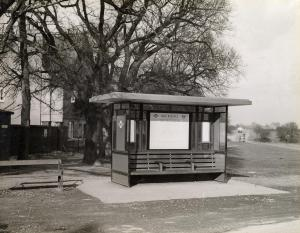
Below - the site as it looks now
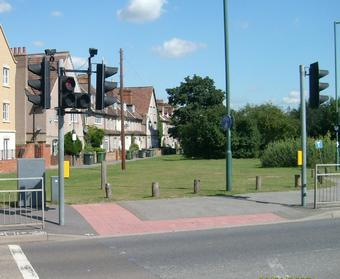
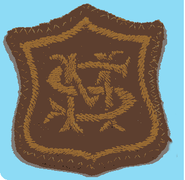
Below courtesy of Google maps . . . . .
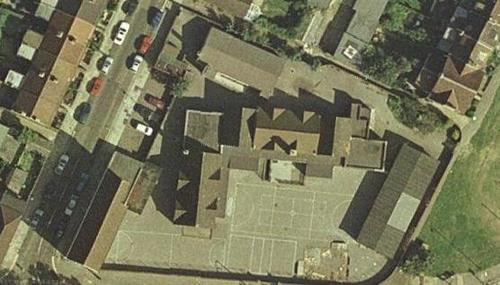
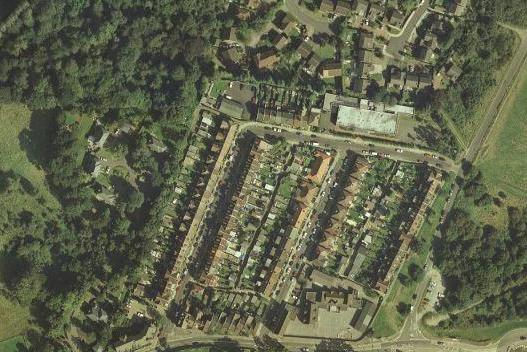
Below - the side gate towards Old Bexley Lane c2005
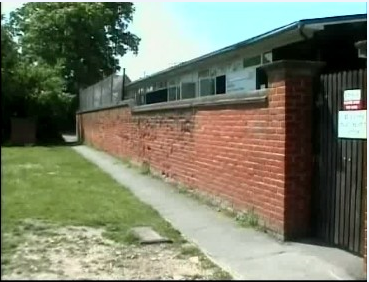
and how it looks in 2018
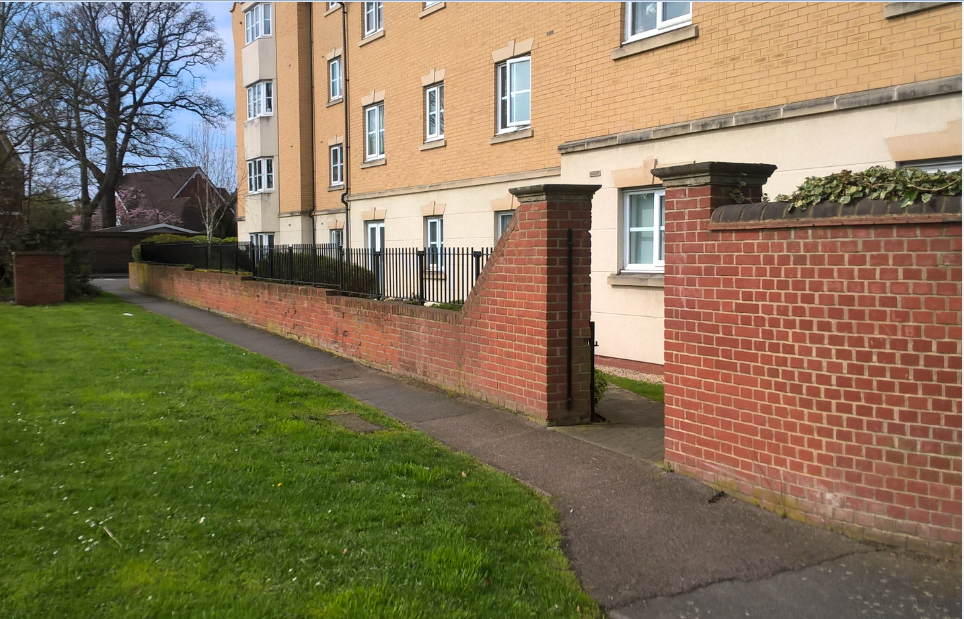
Below - Class of 1923 with Mr SNELL on the right - can anyone name any of the children ??
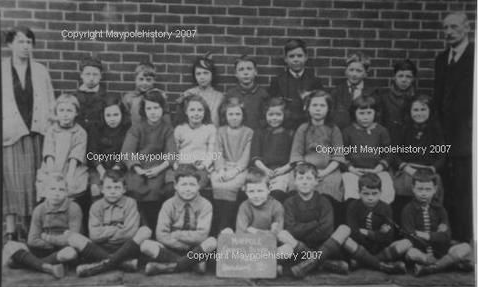
Maypole School was built in 1912. The Macmillan School Register ( MSR ) of attendance shows that the first pupils filed in on 10th February 1913. The red brick buildings and the high red brick walls around them survived for over 85 years. Nearly five generations of local children have been educated there. Most, if not all, of the children from Maypole Estate were to attend and receive instruction within their formative years. James Frederick SNELL was appointed to be the first headmaster of Maypole School. He was 37 years old upon taking up his post. He was to remain as headmaster for the next 22 years until his retirement in September 1935. He died 29 November 1964 as the below extract from the Wills Register shows

The contemporary KELLY's Directory of local professionals showed the first mistress was Miss Ida McCURDY. This has not been supported, however, by the Macmillan register or anyone that I have spoken to. It may be just an omission from that register. The first mistress on the day of opening is shown in the register as being Miss Fanny PAYNE aged 23 years. She was accompanied a week later by Mrs Katy BROOKWELL aged 27 years (who only stayed, originally, for two weeks). and shortly after by Gabriel MENDOZA aged 22 years. The following month Miss Beatrice HIGGS also aged 22 years joined the staff - and so it began.
The very first pupil in the register is shown as being Percy BAXTER from 13 Denton Terrace aged 13 years. The next two were his brother Edward aged 10 years and his sister Florence aged 8 years - who sadly died 5 years later in 1918 whilst still registered as a pupil at the school. These were the very first three of the first 111 pupils to be recorded in the register as being welcomed on the first day of opening. On 24th March 1920, Percy and his brothers Edward Rex and Daniel William travelled to Australia. They departed from London on the ship Berrima (P&O Line) when Percy was aged 20 - on the passenger list he is listed as a Fitter. Percy died in Australia aged 83 years in 1983.
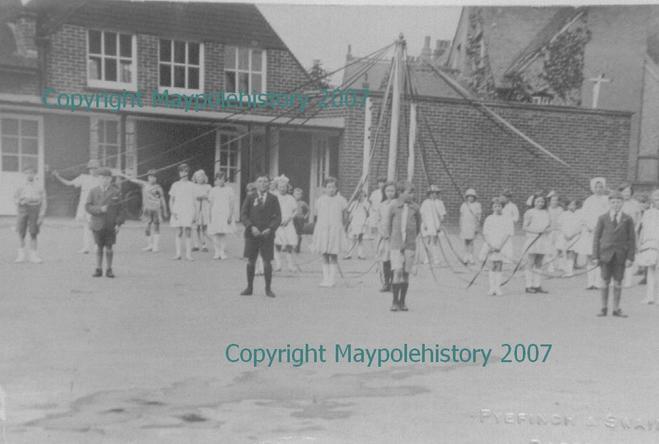
Maypole Dancing c 1920 - Can anyone identify any of the children ??
By December in that inaugural year the register showed 187 entries for admission and readmission. There were a number of departures - but it would be safe to say that there were approximately 150 children at the school in December 1913. In that month the following 5 teachers were in their posts; Fanny PAYNE, Beatrice HIGGS, Elizabeth HOLMES, Kathleen PINKNEY and J R HIGGS. They were overseen, as already mentioned, by the headmaster Mr SNELL. Originally, a number of children from outlying areas such as Crayford and Bexley Village also attended Maypole. Manor Gate - a large house facing the heath in Common Lane at Leyton Cross - was another catchment source. Mr MAIDMENT was shown to be the guardian of at least 53 children from Manor gate who attended the school within the first two years (1913-1915). Manor Gate was probably used at that time by the Local Authority as a childrens home. In the 1970s/1980s it was used as a rehabilitation centre for those with psychiatric problems and addictions. It is now a care home for the elderly. Manor Gate is a large detached residence constructed probably in the mid Victorian era.
The O.S. Map of 1869 shows that there is a building on the site named 'Claytons Croat' This may be one and the same or possibly an older house, now demolished to make way for Manor gate. The children from Manor gate must have walked daily, both in file and clusters, across the heath in comparative safety. Motor cars were not so common. The horse and cart and the pony and trap were still predominant along the road to Bexley. Not a sodium street light in sight and not the sound of a car to be heard for miles.
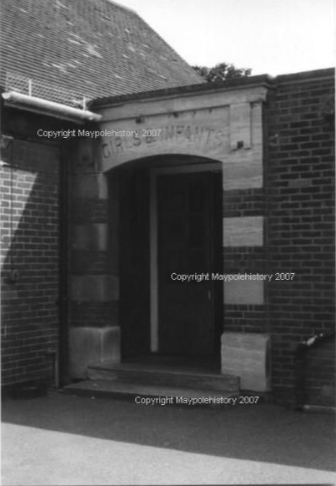
The familiar 'Girls and infants' passageway.
It was a time before motorway drone and before the sound of busy, fractious helicopters flying overhead. It was a time when you could almost hear nature breath. Even in my short time, I now view the heath as a reflection of what it once was . To me, it appears that nature occasionally splutters into life and coughs at season change - but most of the time it wheezes out an existence, manacled relentlessly by the tarmac spiders' web of mother motorway and the tentacles of its' insidious feeder roads. The once dominant heathers that wore a mantle of purple hue to welcome the early summer have all gone. On a sweltering summers day you could once hear the hissing of the broom and gorse or the popping of their seed sacks. Not now, for it is all overshadowed by the sound of the A2.
Below - letter sent to every school child from the King following the end of World War II
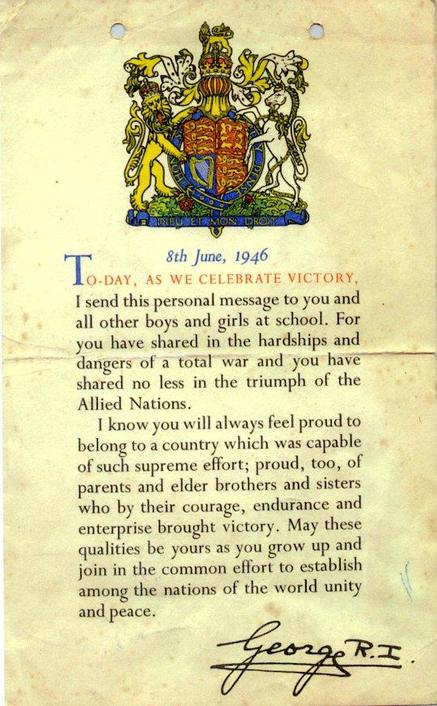
The late Mr Alfred PETERS, (the Fireman's' son who once lived in West Lodge, Bexley Hospital) remembered the heath c 1926. He descibed it to me “as an expanse of heather from the school - all the way down Denton Road to the Crayford side. From the school, vision was interrupted only by the odd silver birch and hawthorn“. He also describes classes in the school at this time as averaging 40 children in number. The school day was 0900hrs - 1200hrs, 2 hours lunch break and then 1400hrs - 1600hrs. The child mortality rate through the decades is reflected in the registers of the school. The following children died whilst registered as pupils at the school and recorded in the MacMILLAN Regsiters:-
Name Address Date last attended and remarks in register
WOOD MILLIE aged 12 yrs of 8 BALDWYNS ROAD 1917/01/8TH - DECEASED
BAXTER FLORENCE IRENE aged 14 yrs of 13 DENTON TERRACE 1918/10/22ND - DEATH
SMITH SIDNEY aged 6 yrs of ROSE COTTAGE BEACONSFIELD ROAD 1919/02/14TH - DEATH
HOGAN KATHERINE aged 11yrs of 30 BALDWYNS ROAD 1919/04/06TH - DEATH
HENN RUBY MARGARET aged 4 yrs of 5 BALDWYNS ROAD 1927/12/23RD - DEATH
GOSLING RONALD LESLIE aged 4 yrs of 24 BALDWYNS ROAD 1929/02/11TH - DEATH
HUNT DOUGLAS HAROLD aged 9 yrs of WOODVIEW TILE KILN LANE 1934/02/02ND - RUN OVER AND KILLED ON THE ROAD.
See extract from St Mary Church burial records 1934

STEVENS ANNIE aged 9 yrs of 26 CLIVE AVENUE 1944/07/13TH - KILLED BY FLYING BOMB see extract from Civilian Deaths register 1944. There were 16 deaths recorded in this one single explosion.

see below burial register for Crayford

WILSON HELEN LOUISE aged 6 yrs of 10 TILE KILN LANE 1950/07/25TH - DECEASED
LIBBERT (SIBBERT?) RICHARD ALLEN aged 5 yrs of 10 HILL CRESCENT 1951/06/08TH - DIED UNDER ANAESTHETIC 11th June 1951
DENNIS MICHAEL JOHN aged 10 yrs of 153 TILE KILN LANE 1954/05/11TH - DECEASED TUMOUR OF THE BRAIN
MILES CHRISTINE MAVIS aged 11 yrs of 22 PARK VIEW (OLD BEXLEY LANE) 1954/07/23RD - IN HOSPITAL - DECEASED AUGUST
1956 extract from burial record - dates do not easily correlate- could there have been an inquest preventing immediate burial or could there have been a very long hospital stay prior to death and she had last attended in 1954 ?.

"Death devours lambs as well as sheep" - proverb
The above entry relating to Douglas HUNT in 1934 now bears out a story told to me by Mr Phillip RUMBELOW, a previous resident of the estate. He stated that he remembered a tragic road traffic accident. Two brothers were walking along Old Bexley Lane towards the 'Dip' (A local name for the junction with Baldwyns Park) Their father was a Postman. He had recently been given a Post Office van to drive. The brothers were walking along the top of a ridge of earth that formed a bank against the high wall of the Hospital Gardens. As they were near the vicinity of St Barnabas Church they spotted their father driving his Post Office van. In the excitement at seeing their father one of them slipped (or slid down) the bank and under the wheels. I believe that this was Douglas. Mr RUMBELOW stated that the boys' father never recovered from the tragedy. This is supported by the fact that the School Register shows that the younger brother, Charles, was removed some four months later - having 'left the district'. If the above is incorrect then we offer our most sincere apologies
Another of the above entries relating to Christine MILES refers to a child who had a tragic ailment - in that one side of her body grew normally - and the other did not. She eventually died from this condition. (Wendy SAUNDERS)
Below - programme for 1963 Summer Concert
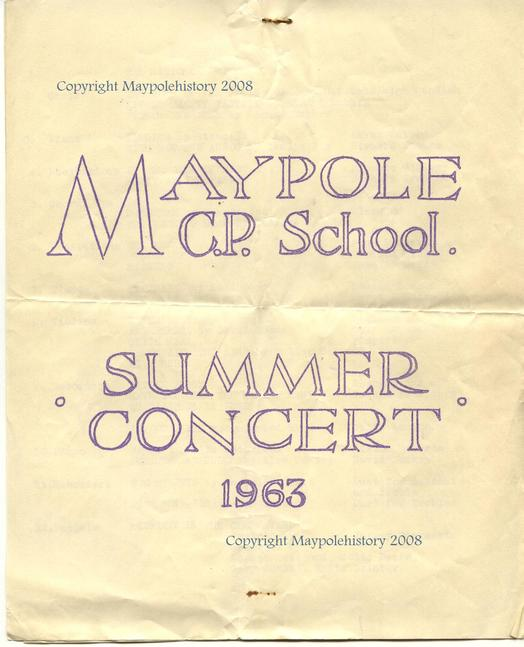
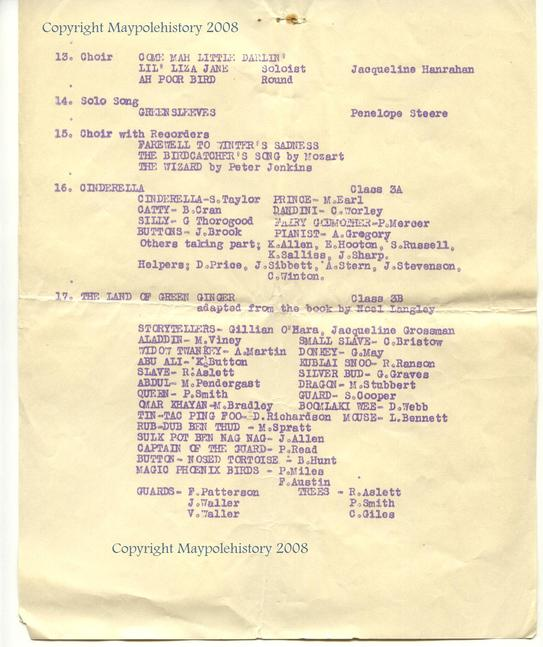
Link to List of some pupils 1958-1968
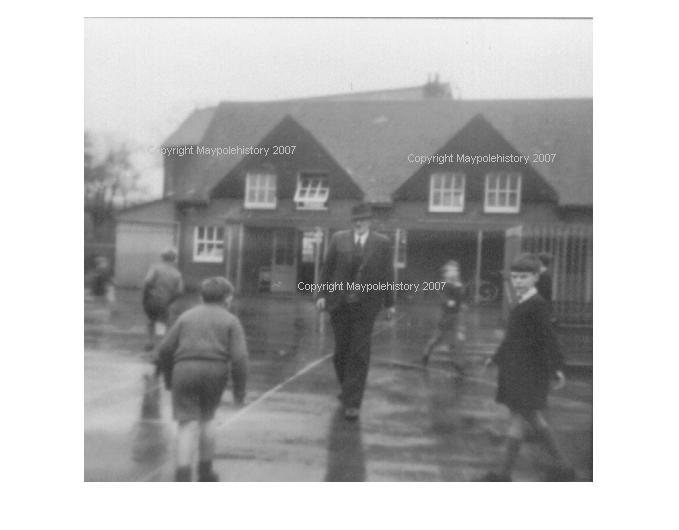
George Stockford Caretaker c1960-1965 (Born 22nd July 1896 and died 29th December 1981)
The 1911 Census showed at the age of 15 yrs he was living in Chislehurst with his mother, who was aged
44 yrs and she had been widowed. They took in lodgers to help with the finances.
and below same location c2002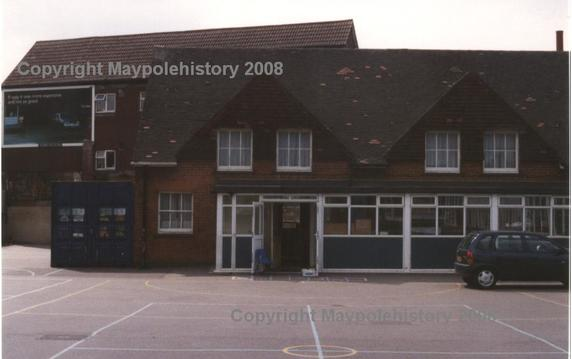
and below under demolition 2005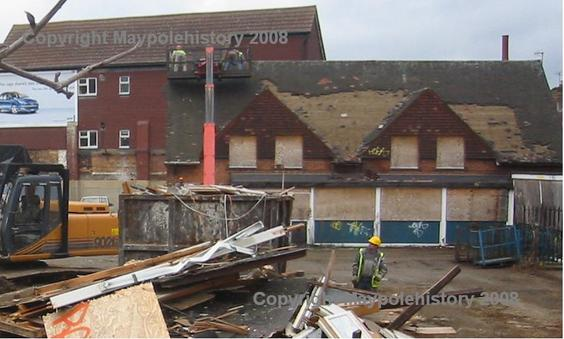
and below - gone . . . . .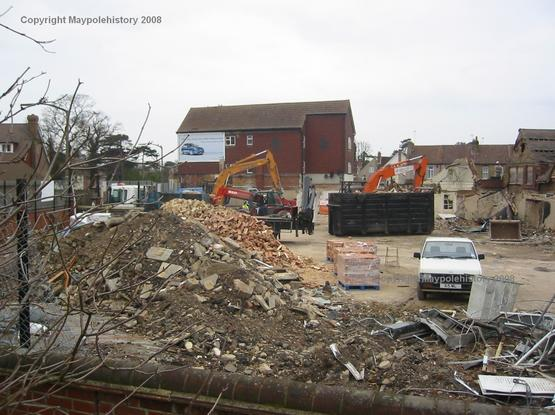
From the 'History of the Rolling Stones' another piece of trivia about the school ' Formed in 1962, The Rolling Stones have become one of the world's most recognized and enduring bands. Mick Jagger and Keith Richards first crossed paths at Dartford Maypole County Primary School. A decade later the two had become avid fans of blues and American R&B, and shared a mutual friend in musician Dick Taylor. Jagger and Taylor were jamming together in Little Boy Blue and the Blue Boys. Richards would soon join the group and become expelled from Dartford Technical College for truancy '.
The school was demolished in 2005 and is now a housing complex.
Video of school - summer prior to closure
Below - being demolished
Below - video of demolition and as was
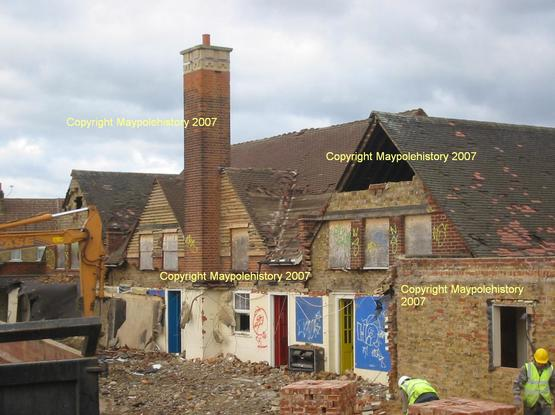
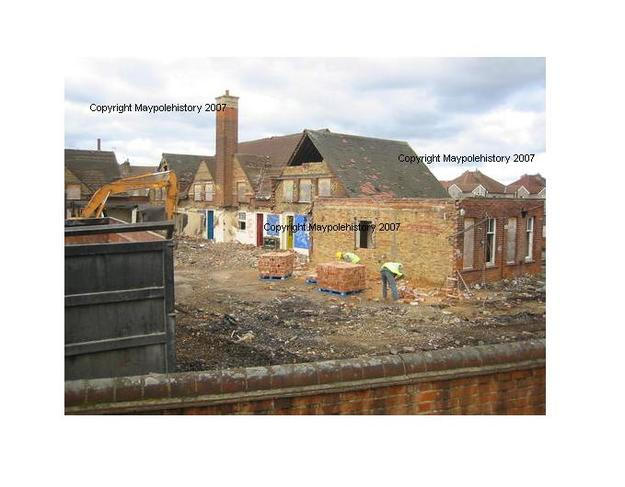
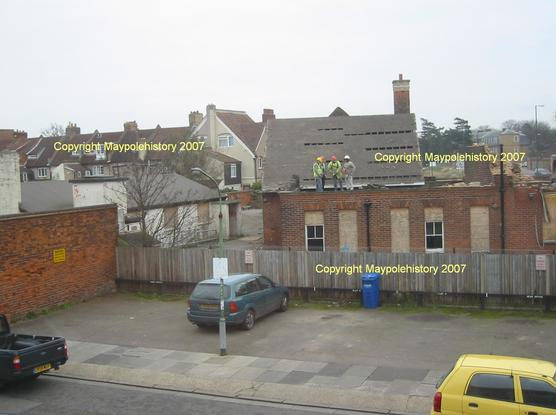
The new complex under construction 2005
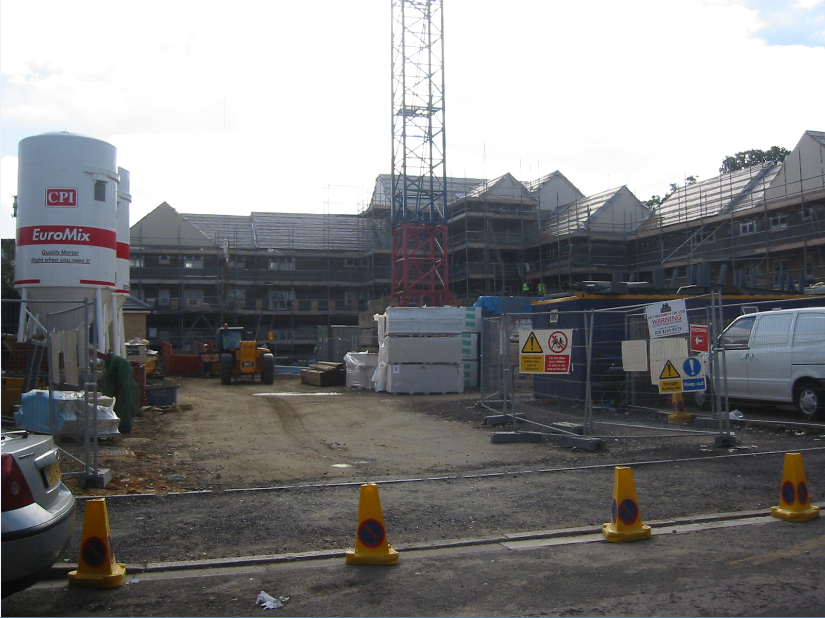
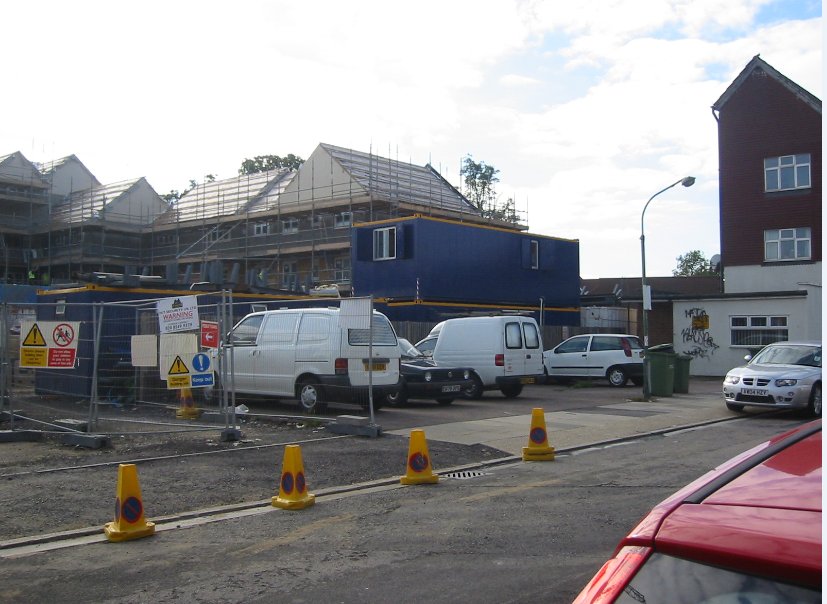
And as it looked immediately after completion . . . . .
Below from Beaconsfield Road just prior to demolition 2003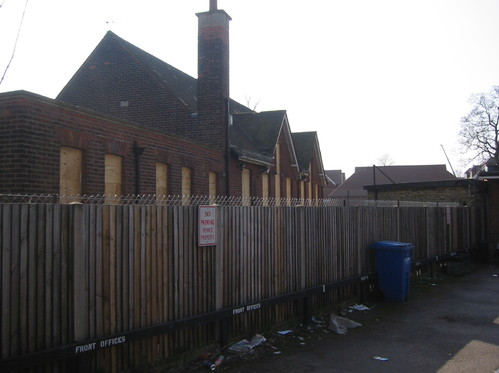
Below in 2010
The below written by Vince Cross summarises the experience most kids had of his era
Let me take you back to a time long before the personal computer, when the Austin/Morris Mini was a gleam in Alex Issigonis’ eye, when television screens were 12 inches diagonally (and in someone else’s house!) when no one but their own nearest and dearest knew or cared about John Lennon and Macca. I’m talking 1956. The year I first pitched up at the Maypole C.P.School on Dartford Heath’s dusty fringe.
Mum, Dad and me had arrived in Summerhouse Drive the previous year, going upmarket from our semi in Barnehurst. There were a lot more trees in Bexley. The top of the road was still an unmade rutted track although some of the houses, like ours, had already been there for more than twenty years. The designs for the new Joydens Wood estate were making their way through the Council’s planning committees. The 50’s housing boom would begin among the greenery with enterprising self-build projects for those with the D.I.Y skills of TV’s Barry Bucknell. At the end of our long back garden The North Kent Sun Club kept prying eyes away from its naturist activities by hanging curtains in the trees. Our car was a 1930 Riley with running boards and no heating. With a tear in his eye Dad passed it on to a bloke with a shed on Bexley station drive for a fiver or so. Petrol cost just three and threepence a gallon then. Work out the price per litre, compare it with what you pay at the pump now, and weep with him.
My mum reckoned the walk to school at three-quarters of a mile. Since I baulked at the first school dinner I tried (did I have good taste, or was I just a fussy eater?) she found herself doing the trip four times a day. Down leafy Summerhouse Drive, along Tile Kiln Lane at the back of the Mental Hospital, turning right at the hexagonal toll house into Baldwyns Park where Hiram Maxim allegedly once tried to get an airplane airborne with the aid of a set of rails. Then right at the T-junction by Mr. Henderson’s shop and up the hill past St. Barnabas’ white clapboard church into the little hamlet opposite the hospital gates on the corner of the Heath. A lady fell under the 401 bus there one day. Was it accident or design? In that neighbourhood you could never be quite sure. Despite the fact that many of the unshaven, sad old men seemed to emerge from the gates with their trousers undone, the hospital inmates caused no difficulties to us children. Or maybe no one ever saw fit to enlighten me about the bad things that did go on. These days the close juxtaposition of the two institutions would result in lurid newspaper stories and a public enquiry.
Later on, when Mum had started running her small nursery school, presumably to stop herself going bonkers while Dad was away each day earning the family’s money in W.1, the walk to school by myself became a bit of a trial. I was small, fair-haired, timid, physically weak, and fair game. If a Maypole brown and gold cap was going to get thrown over a wall, it was obviously going to be mine. And I was naturally going to take it to heart, whereas the kid who threw it wasn’t going to give a damn. Very gradually and painfully, I began to acquire something approaching self-confidence. It still rankles that the very first time I took matters into my own hand, landing a very satisfying crunching blow on a tormentor’s nose, his mum complained to my mum. The incident occurred just by the scrubby mound outside the school gates where there’d been a World War 2 air-raid shelter. I can’t remember what occasioned the assault, but it drew more blood than I’d reckoned on. Some of the time after that, he and I were mates, but he was better at football than me.
In my last year or two at the school I would persuade someone to go the long way home via the Heath and the allotments opposite Henderson’s. In my head this was transgressive behaviour. I had a gnawing fear that either a teacher or my parents would learn of it and punish me. Oh yes, I was a wimp, all right, give or take the occasional unexpected right jab. It’s interesting to look at the rest of one’s life, and see how patterns of behaviour persist and recur…
The school’s perimeter was bounded by a high orange-red brick wall. There was a gate which led onto the older boys’ playground. If you were in Class 4 it was there you played ‘British Bulldog’at morning break. Ball games weren’t generally allowed: too many windows. The older girls had their own play-space too, on the far side of the two mobile classrooms which sat on the Heath side of the playground. The main school buildings formed an ‘L’ shape. Two of the classrooms had a partition which could be slid aside to make a small school hall. In the angle of the ‘L’, a corridor ran through to the infant classrooms at the back where their school assembly was conducted, and where lunch was served. A verandah ran along the length of the ‘L’ offering shade from the wind and rain. The caretaker was a rough and ready ‘heart of gold’ sort of bloke – was his name Mr. Stockford? - with the kind of deeply weathered skin you rarely see now. When you look at images of such folk on old photographs, say on a working narrow boat, you think maybe it’s a trick of the light or the method by which the photo was taken, but not so. He looked that way because of decades of grimy work in the open air, every day, all weathers.
The tarmac surface of the school’s playground and I became well acquainted. I don’t know whether I fell over more than most children, but my knees were permanently scabbed and scarred by regular contact between it and me. One craze of the times was to contrive ‘races’ between ‘Dinky Toy’ or ‘Corgi Toy’ models of Grand Prix racing cars. Stirling Moss, and then Jim Clark and Graham Hill were the driver-heroes of the day, and we pushed our replica Ferraris, BRMs and Lotuses down the slope of the playground as far as we could with them at the imaginary controls. My wheels were never well-enough oiled to win. Nor were my conkers somehow ever sufficiently hardened in the oven to last more than the first couple of contacts in that autumn competition. Although he never went to the Maypole, the late Tony Brise, who was Graham Hill’s young and successful Formula 1 protégé was a classmate at Eltham College. We never knew that he was already a karting champion while he was at school. To me he was just the kid who had asthma far worse than I did.
The school did very poorly for P.E. and games. There was no dedicated teacher of the subject that I remember, and apart from token physical jerks in the playground and the very occasional game of rounders in our last year or two, there was little to make us ‘wind of change’ kids fit. Once a week during winter we would troop off to the Crayford side of the Heath to play desultory games on the pitches over there, divided into A,B,C and D teams. There was little in the way of coaching, and no incentive to improve. The school football team seemed to play one or two matches a year versus Oakfield Lane or Wentworth. When I was in Class 3 we beat Oakfield courtesy of a scrappy goal from Simon Ferrari. Subsequently when we’d both gone to Eltham, he and I became friendly and I then discovered he was no better at football than me. But at the Maypole I languished unconsidered on the D team’s right wing, chasing the ball as hard as my asthma would allow. I was cricket mad, but there was nowhere safe to play within reach, and no one else seemed to share my passion for the game. They did try to teach us to swim, from time to time putting us on a coach to Rowhill School in Hextable where there was a pool. The route took us through the narrow confines of Puddledock Lane. We looked forward to the journey because there was always the chance of the bus getting stuck or forcing perilous reverses from oncoming cars and trucks. I now know that the dense chlorination of the pools of that era would only have exacerbated my wheezing. I never learned to swim satisfactorily, although I think I once came third in picking the brick off the floor of the swimming pool at the annual ‘swimming gala’. I think I’ve never really been given the credit I deserve for that.
Was there actually any maypole dancing? I don’t remember any, although ‘country dancing’ was a regular feature of summer activities. Some things haven’t changed in primary schools. The peace of our back garden in Northampton was disturbed at the end of the summer term 2012 by a much amplified though elderly record player churning out the same crackly tunes that accompanied our doh-c-doh’ing in 1960. One summer there was a fete on the Heath where we danced and then so did an adult group to show us how it ought to be done. Purists would have been grossly offended. The dancers were women, and I chiefly remember the event for the shocking glimpses of stocking-top it afforded as skirts flew and flounced to ‘Red River Valley’ and the Cumberland Square Eight.
The headmistress of the Maypole school in my day was Mrs.Chambers. Under her leadership the Maypole was a relatively enlightened place. There were rumours that someone had once been given ‘the slipper’, but no definite evidence to that effect. People did have their legs smacked for really outlandish acts of insubordination, but not me (how smug is that?), and actually I think it was a reasonably rare occurrence. After all we were mostly very nice middle-class children. Mrs Chambers was evidently an Anglican (I remember her saying she would have liked an altar in the room where assembly was held, which as a Baptist boy I found rather shocking), and I now suspect her of being somewhat shy. She didn’t herself take any lessons and I don’t remember a conversation with her personally, although we probably swapped a few words before I left for ‘big school’. The only other thing I know about her was that she lived close to Leyton Cross.
The infant teachers I remember with mixed emotions. There was one against whom I still hold a grudge. She thought she heard me talking in class and wouldn’t believe me when I pleaded that she was mistaken. My injured innocence only raised Miss Sant to new heights of ire. On the other hand Miss Loten, Karen Loten, I think, had a beautiful face and a beguilingly soft Northern Irish accent.I was very taken. Likewise with Miss Tillyard, my form-teacher in Class 2,who was a thoroughly modern miss, short permed hair, pretty and slim, with tight skirts in the 1959 style to a little below the knee. My friend Rosemary said she thought they were ‘cruel’. Simon later confessed to dark and intimate fantasies about her.
Once out of the infants, we were passed into the kindly hands of Mrs Hunt in Class 1, where I began to flourish academically for the first time. Then came Miss Tillyard in Class 2 (parodied by my dad as Miss Tiltyard –well, there is one by Eltham Palace!) Then a succession of very good male teachers in Classes 3 and 4 – this was a primary school with no less than three men, so by contemporary standards how lucky were we! First lovely and amusing Mr. Beresford, who was the deputy head-teacher, then the rather austere and somewhat younger Mr. Hembury after Mr. Beresford had been snapped up to be the Head of another school, and finally the avuncular and cultured Mr Rawlings who looked after us through our 11+ exams and out the other side into the world of the swingin’ sixties.
The music in the school was in the excellent hands firstly of Mrs Cridge (abundant with glasses, red lipstick, and dark pageboy hair) and then Mr. Tagell. Concerts were long, as primary school concerts often are. There was a lot of singing and much recorder playing, and I got the chance to have proper piano lessons and even to try my hand at the fiddle in what must have been an excruciating-sounding school band. Thank heavens my hands at last started to work with a degree of independence on the keyboard, and after an uncertain start one of the directions of my life was set. I never could get to grips with the violin: it always felt uncomfortable and unnatural. Rosemary and I played recorder duets at the Crayford Music Festival even after we’d left the Maypole. Corelli, I think. The adjudicator said nice things.
But one of the worst emotional experiences of my life occurred in a Maypole concert. Playing a simple Beethoven Ecossaise, I looked down at my hands, lost my place in the music, and stopped. I was devastated. It’s left me to this day with a bad relationship between my memory and the music I play. Even if I know something inside out (I was going to say ‘like the back of my hand’) I need the music and lyrics in front of me. Mr Tagell may not have been the best piano teacher, but he was a great encourager. Once in Class 4 he took four of us in his Austin A40 all the way (!) to Maidstone for a County Music Festival. We’ve lost a measure of trust and opportunity between children and adults over fifty years.
I know they tried to get us to develop an artistic sense: I remember charcoal drawing a tulip with the fiery Miss Pepper (was that really her name?). However it’s one of the things that now amazes me: nowhere in either of my schools did anyone really fire my interest in the visual. Art education was invariably unimaginative. What a paradox and what a pity! One of the teachers left the comment on one of my reports ‘Messy, but improving!’ It inhibited me for years. Likewise I don’t remember drama of any sort beyond the tableaux of a nativity play. Presumably whereas there was talent amongst the teaching staff musically (even Mr. Rawlings tried us out on some music appreciation in Class 4), there was no thespian enthusiasm.
I had no trouble with the maths and English of the 11+ exam, but the spatial (‘intelligence’!) tests floored me, and it took some coaxing and coaching by my parents to get me through. Once we’d survived this ordeal, the rest of the final year was spent engaged in project work. It was a golden time, exploring the world in a more relaxed way: I still have some of what we did then. Quite a few of us, both boys and girls, were lucky enough to pass the 11+. Most followed Mick Jagger’s footsteps to the Dartford schools, though I think Jimmy Crawford went to Chislehurst and Sidcup, and I opted for the blue and gold of Eltham. Before we left we even went on a proper day’s outing to Portsmouth by train, a sign of the changing nature of Britain It was a treat born of a new prosperity, a forerunner of today’s school expeditions which almost routinely take pupils on exotic language exchanges and sports tours to Australia and Argentina.
Dartford Heath was a wonderful place. It split the catchment area. Some children like Rosemary came from its far side near Dartford. Others of us lived at the Bexley end. Particularly before it was divided and diminished by the A2 dual carriageway and its feeder roads, it was a space sufficiently large that one could never get satisfactorily lost whilst it always retained its air of intrigue. There were winding paths, and hills and holes formed by the remains of WW2 military camps. It was a great place to ride a bike, albeit at the risk of frequent punctures. I used to escape there until late in my teens, trying to forget the sadness of my mother’s long illness. One Saturday afternoon I remember lying on my back on the thick grass between the gorse watching aircraft fly overhead on their way to the Biggin Hill Air Show, the sky filled with a procession of Canberras and V-bombers, Spitfires and Tiger Moths.
It’s important to say what there wasn’t at the Maypole. There were no graffiti, were there? Nor were there any ‘Cider with Rosie’ experiences, at least not that I remember or will admit to. I don’t even recall any bad language. It came as a real shock to encounter rude words at Eltham – the ‘School for the Sons of Missionaries’. And there were no confrontations between staff and pupils of the sort that became all too familiar when I joined the teaching profession for a while in the late seventies.
I don’t know that I exactly relished my time at the Maypole School: as a small boy I was too frightened by my first encounters with the world for that. But I now think with enormous affection about that time, my teachers and all those with whom I shared classrooms. I must have spent a great deal of time observing the people around me and learning about life from them: they remain a significant part of me now. They crop up unexpectedly in dreams from time to time, and doubtless form the basis of characters in my writing too. They probably won’t remember me, most of them. I’ve doubtless forgotten some of them too, for which I apologise.
The girls: whose strength of character, kindness and academic competition made good role models for later, more grown-up relationships.
Rosemary, Nina, Marilyn, Monique, June, Christine, Susan, Mary, Carol, Carole, Rosamund, Wendy…
The boys: whose interests and obsessions sparked my own, and whose physicality gradually hardened me to the demands of adult life.
Steve C., Jimmy, Steve E, Robert, Murray, David, Paul, Nicholas, Peter, Richard, Simon, Keith, Graham, Christopher, Anthony, Malcolm B., Malcolm C., Peter, Ian, Vernon, John E.,John W., Adrian…
Our house in Summerhouse Drive has gone now. So has the Sun Club. So has the school. The landscape has changed. But what seems more remarkable and comforting is what remains.
Vince Cross September 2012
www.vincecross.co.uk
Copyright Vince Cross
Airship Disaster R38 Maypole man killed
A tragedy occurred on the afternoon of 24 August 1921 when thousands of people in Hull witnessed the R38 airship explode and plummet into the Humber Estuary.
From Dartford Museum Curator, Dr. Mike Still
‘Among those who lost their lives on the ill-fated airship R38 was Air Craftsman Roy Parker, son of Mr and Mrs Parker of 3 Denton Terrace, Maypole Estate, Dartford Heath. Roy Parker was for some time at the Bexley National Schools, but later went to the Maypole Estate Schools, under Mr F. Snell. (*From the maypolehistory website it shows that the Maypole School Register shows he entered the Maypole School on 13th February 1913. The 1911 Census showed he was aged 10 years when he lived at No. 3 Denton Terrace with his father Henry - an accounts clerk -and his mother Kate together with his other siblings). He joined the Royal Naval Air Service in 1917 and received his instruction at Eastchurch. Before enlisting he was for a time at Vickers’ Crayford Works where he was a great favourite with his mates. He was only 21 in July but had been employed on our largest airships. He went to America last year with Captain Scott in the R34, and after the voyage he received a volume of “The Log of HMA R34” presented by Sir Ernest Hodder Williams in memory of the great achievement. On this voyage he was the youngest member of the crew. When he was home last in July, on the occasion of his coming of age, he spoke to his parents of the voyage he was looking forward to in the R38, but said he doubted “if the Americans would ever get her home”. He apparently had some premonition of a disaster and as a matter of fact he had a narrow escape on her when she recently made a bad landing and was severely damaged. At that time he was in charge of the port aft engine and it is thought he was in that position at the time of the disaster. Great sympathy is felt for his family.’

The other airship on which Parker served, R34, was commanded by Major George Scott and was the first aircraft to fly from east to west across the Atlantic. It also made the return voyage, making it the first aircraft to do that as well. Also, since the ground crew in America didn’t know how to assist an airship in landing, Major E.M. Pritchard jumped by parachute to teach them, making him the first person to reach American soil by air from Europe! This all explains why a souvenir book was given to the crew.
The below link expands on the disaster.
St Barnabas Church
St BARNABAS CHURCH
Lewis GLYNN (see the entry on Broomhills) had erected a wooden building within the grounds of Broomhills and close to the main house. It was used originally as a playroom for his children.
The original was situated near the boundary with the Maypole Institute hut - now renamed the Maypole Social Club. When Joseph CAMERON took up residence (c 1923) at Broomhills he gave permission for this hall to be used as a Mission by local residents of the estate for worship. Access to this hall was by way of the alley that now runs beside the Maypole Social Club and the end house in Baldwyns Road.
Below - aerial photos taken in 1945 of Maypole Estate showing Broomhills and the original and later site of St Barnabas Church
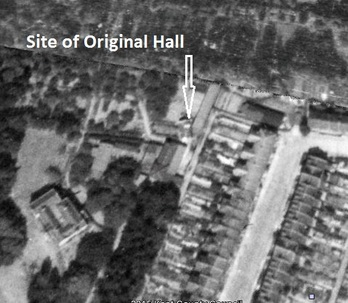
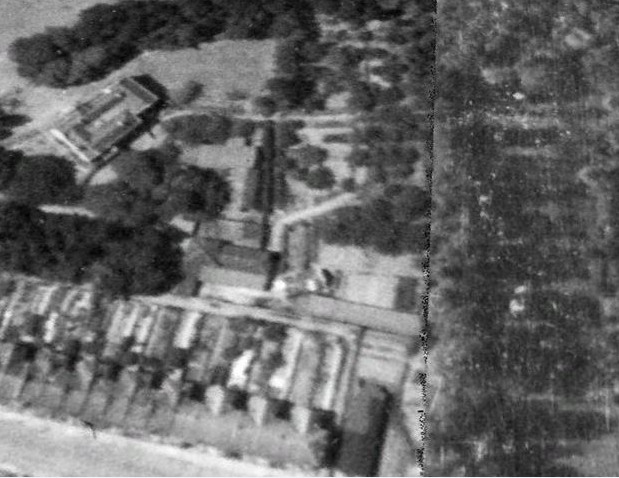
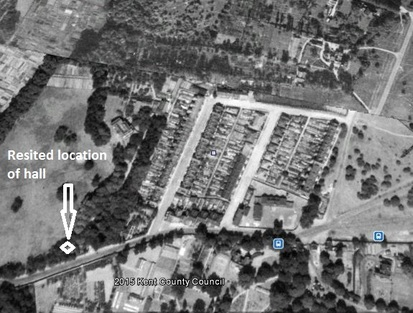
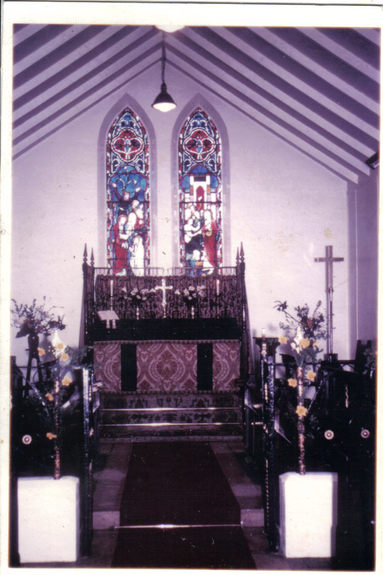
Above - the alter - courtesy of the late Steve Parker
By 1924 the hall was too small for local needs and Joseph CAMERON had it enlarged and refurbished as a Church. At the same time he also had built on a new hall which was for use as a Sunday School. Lewis Edmund GLYNN was still shown as living in Broomhills itself in 1927 (KELLY'S DIRECTORY). By this time he had been awarded the K. C. (A history of St Barnabas Church, however, shows that the CAMERONs owned Broomhills from at least 1923). Joseph CAMERON died in 1949. It was in this year and following his death that his son, John CAMERON, gifted the building of St BARNABAS Church to the Diocese of Rochester. He also donated £250 and gave a plot of land at the side of Old Bexley Lane in 'GLYNNS FIELD' near Broomhills Lodge where the church was to be sited. It was physically moved from the location in Broomhills to the Old Bexley Lane in 1952. It was rededicated on 11th October 1952 by the Bishop of Rochester, Dr. Christopher Chavasse.
Map below showing original location of St Barnabas Hall on OS map published 1950 where the letters 'Ch' are and the newer site along Old Bexley Lane - see map below the below
.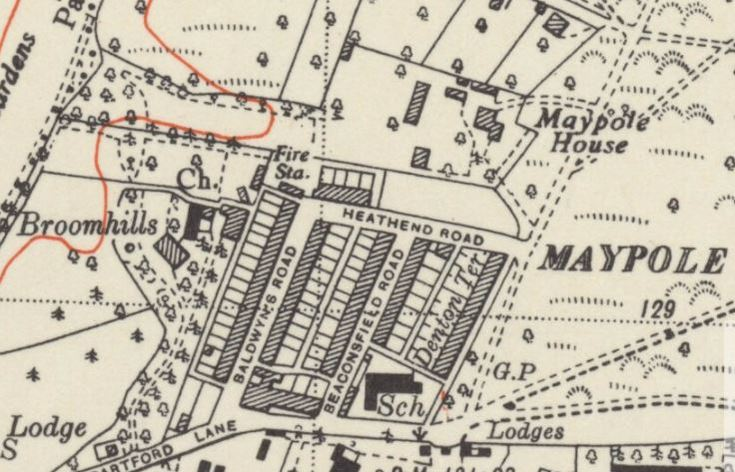
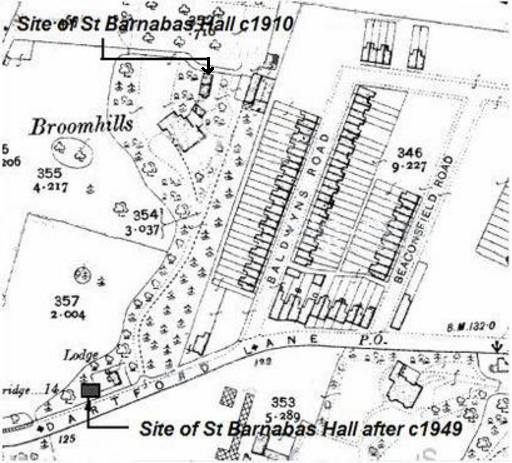
Below - final location of the Church in Old Bexley Lane c1966 (Dartford Lane as described above) - prior to it's demise there in 1971. Photo courtesy of Tony Hollis.
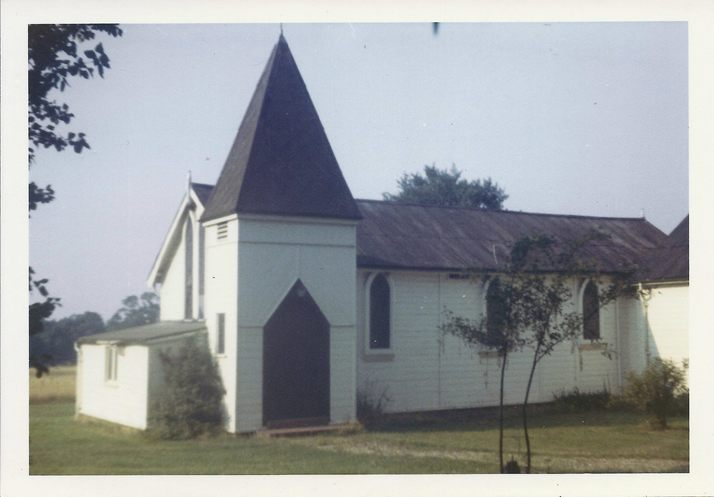
CAMERON HALL 1923 - 1924 A Sunday Evensong was held every week at 6.30 p.m. from 7th January 1923 until 2nd August 1924 with attendance between 50 and 70 people. A congregation of 114 was counted at the anniversary service on 16th March 1924 with the Vicar of St. Marys, the Rev C. Moore M.A. preaching. (Collection £1.4s.1½d)
In 1925 the new Church of St Barnabas was re dedicated as a private chapel by Dr LOWTHER - CLARKE, a former Archbishop of Melbourne and father in law of the Rev. Charles MOORE on Palm Sunday 5th April 1925.
The white wooden church had a spire and a single bell that tolled when calling the faithful to prayer. I can only remember the Church as being where it was last sited, actually on the northern side of Old Bexley Lane and just west of the Broomhills Lodge site. The last Evensong at the old St BARNABAS Church was held on the 6th October 1968. The Church was last used for Church of England worship and closed on the 18th July 1971.
The congregation was rehoused in a new Church at Tile Kiln Lane. Sadly, the aisle and the belfry of the old St BARNABAS were burned down several years later - one hall being the only part still left intact. It is now used for closed worship by another faith. From a photograph I have, I believe that the original MAYPOLE used by the children of the estate - c.1910 to 1950 - was situated very close to the last site of the Church in GLYNNS Field. As a child in the late 50s I remember there were 'sports days' for the children of the estate around the perimeter of the Church and within its grounds. It is difficult for me now not to see the opaque figures of children dancing on this spot, whenever I traverse the field. To me, it is as if it still belongs to them and their time.
Below - another image of the church supplied by Lee Smith
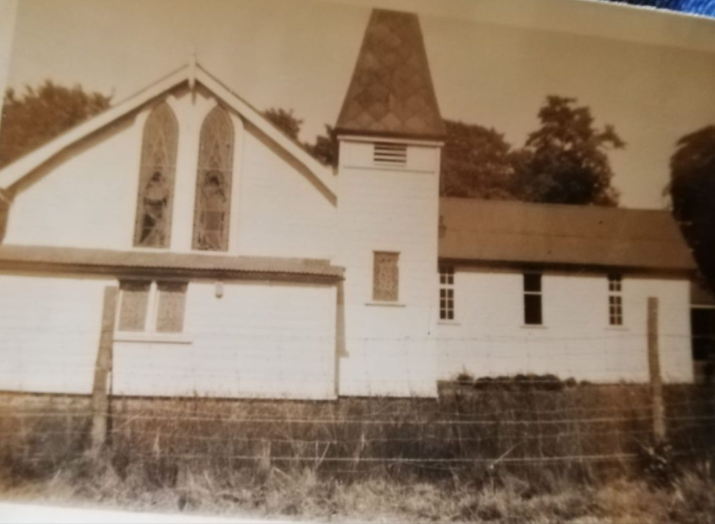
Below - the original St Barnabas lamp now owned and used in working order by Richard WIGHT and image donated by him
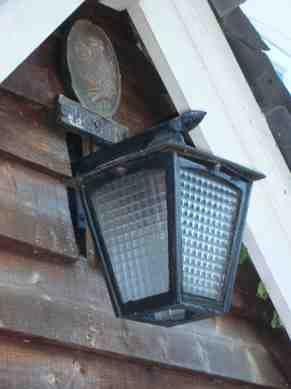
Memories from Steve PARKER re the church and it's original location and Mrs CAMERON
The church was @ the rear of Broomhills, churchgoers would enter the Cameron estate through a gate in the alley @ the back of Baldwyns Rd. & walk straight ahead for about 50 yds. The church hall was to the right running @ right angles from the church where we used to attend Sunday school. I don't remember much about Mr. Cameron except he was a little round man who wore wire framed specs, he had a short walk from the back of the house to the church where he played the organ. He must have been Dorothys grandfather? That can be confirmed by Dorothy, who by the way was in the choir & her mother was always @ church. My wife Valerie remembers a ladies church group being held in the hall once a month & Mrs. Cameron being a prime facilitator. After the church & hall were moved my daughter Ailene used to attend ballet classes at the hall, can't remember the teachers name but she lived in Baldwyns Park. Apart from organising a wedding reception for some friends of ours thats about all I remember.
Before we left for N.Z. 40yrs. ago Mrs. Cameron invited my wife & I & 3 children for afternoon tea, quite a delight, One room was a treasure trove of chiming clocks -- table , grandfather, cuckoo, the whole range. The kids were thrilled to bits when she set off the chimes of many, this was followed by the playing of a pianola? The Winter family I know little. Regards Steve
Below - the hall as it is today.
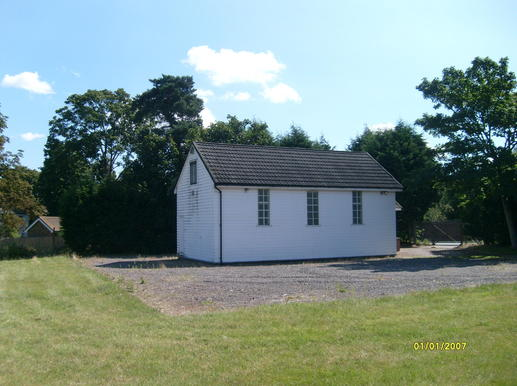
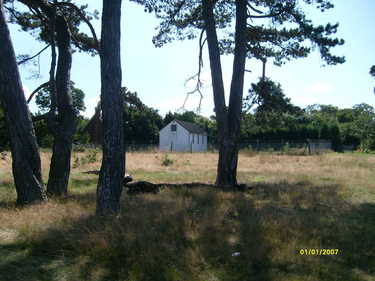
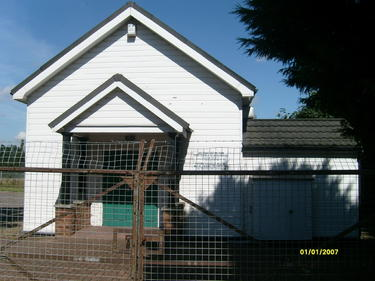
Charlie Lawrence P.O.W. - a black boy.
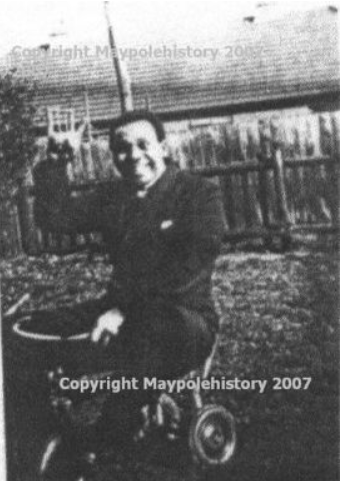
Above - the late Charlie Lawrence - a black boy - (born 28/4/1919) taken in rear garden of George Stockford's house in Baldwyns Road c1937. He was a pupil at Maypole School. The school register shows he started school on 24th March 1924. Has been described by the late George Stockford (Jnr) as a great friend and convivial boy. He lived at 14 Ivy Villas (Next to the Post Office) with his widowed mother. Her husband was killed in WWI when HMS Hogue was sunk by the Germans (20/09/1914).
Click the link for the story of HMS Hogue.
https://youtu.be/7HuGcavqoMg
Archives from the HMS Hogue Roll of Honour - LAWRENCE, Leading Stoker, WILLIAM, 297574. (RFR/CH/B/9794). Royal Navy. . Age 31. Son of John Lawrence; husband of Elizabeth Lawrence, of 14, Ivy Villas, Maypole Estate, Bexley, Kent.
During WWII it was believed that Charlie joined the RAF. Records now show he was a soldier in the Queens Own Royal West Kent Regiment.
Below photograph supplied by Dr. Mike Still, curator of the Dartford Museum

Dr Still has discovered the death registration online (on Ancestry). He indicates:-
The registrar of the local town seems to have insisted on registering every death at the local prisoner of war camp as if the inmates were local residents! Even though the camp was local, the registrar’s information was supplied from Berlin so we can’t know how true it is, but the cause of death is given as jaundice, so presumably Charlie had contracted hepatitis.
Charlie’s birth certificate gives Elizabeth Lawrence as his mother, as expected, but names her husband, who had died four and a half years earlier, as the father! Therefore, since she wasn’t telling the truth to the registrar about this, can we believe that she was even Charlie’s real mother? She may have adopted him to help out another woman. We will never know. Incidentally, she claims to have given birth to Charlie in Denton, east of Gravesend, at a house which she gave as her residential address. However, she is also listed at her Maypole address of 14 Bexley Lane in the street directory for the same year (which may even have been published the previous year). Possibly she had relatives at the Denton address and stayed with them to have the baby.
Charlie’s mother died in early 1940 and he then moved out of 14 Ivy Villas and in with the Stockford family at 48 Baldwyn’s Road, shortly before enlisting and heading off for France with the Army.
The below is submitted by Dr Mike Still - curator of Dartford Museum 23rd March 2021
CHARLES LAWRENCE 1919-1941
30 October 1905 – William Lawrence of Bridgen, Bexley, married Elizabeth Wise who had grown up in Bexleyheath, Crayford and Erith.
10 September 1914 – Elizabeth Lawrence gave birth to a baby girl, Louisa Lawrence.
22 September 1914 – William Lawrence, Leading Stoker in the Royal Navy, was killed when HMS Hogue was sunk by the German submarine U-9.
4 October 1914 – Twelve days after William Lawrence died, Elizabeth took their new born daughter Louisa to be baptised at St Mary’s Church, Bexley. Elizabeth gave her address as 14 Ivy Villas (now in Old Bexley Lane on the Maypole Estate, Dartford).
3 March 1916 – Louisa Lawrence was buried in the Municipal Cemetery, Gravesend, at the age of 17 months. Elizabeth gave her address as 2 Victoria Road (now Empress Road), Denton, now a suburb of Gravesend. This was the home of her married sister, Louisa Clarke.
July 1918 – About 300 African American troops are known to have been present in Gravesend while working at the Swanscombe Cement Factory. They were apparently camped in a field near Gravesend. A newspaper in February 1919 said ‘They were lodged in tents and were frequent visitors to Gravesend. Generally speaking they were a quiet, disciplined lot, and they fraternised very effectively with the people of the neighbourhood.’
28 April 1919 – According to Charles Lawrence’s birth certificate, Elizabeth Lawrence gave birth to him at 2 Victoria Road (now Empress Road), Denton. Elizabeth Lawrence gave this as her residential address although it was actually the home of her married sister, Louisa Clarke. While growing up, Charles was known as the black boy with a white mother. Despite the fact that we have two photographs of Charles, opinions differ as to whether or not he was mixed race. Therefore we can’t be certain that Elizabeth was actually Charles’ birth mother. As for his father, Elizabeth claimed to the registrar that this was William Lawrence, ignoring the fact that William had been dead for four and a half years and had been white. If Charles was mixed race then Elizabeth could have been his birth mother or, as a widow with ‘Mrs’ in front of her name, she could have unofficially adopted him in order to help an unmarried white woman. As for his true father, although it is possible that his father could have been a seaman who had visited Gravesend, it is quite possible that his father was actually one of the African American soldiers who had been based in the Gravesend area nine months before. However, if Charles was not mixed race, then it is difficult to know who his parents could have been, since there would have been relatively few black women in this country at the time.
1919 – Elizabeth Lawrence is listed as living at 14 Bexley Lane (Maypole Estate, Dartford).
24 March 1924 – Charles Lawrence started at the Maypole School, according to the school records.
1935 – Elizabeth Lawrence is listed as the head of the household at 14 Bexley Lane, in the Dartford street directory. She brought up Charles on her own at this address next to the post office on the main road opposite Bexley Hospital. Charles worked locally as a gardener with a ‘Mr Stockford’. This was presumably George Stockford senior who was the gardener at Maypole House. Charles is said to have run a band on the Maypole Estate and to have been well liked by all who knew him.
1939 – Elizabeth Lawrence is listed as the head of the household at 14 Bexley Lane, in the Dartford street directory.
12 February 1940 – Elizabeth Lawrence was buried at St Mary’s Church, Bexley, having died at the age of 56. Charles Lawrence, who would have been 20 years old, went to live at the family home of his friend, George Stockford junior, just round the corner at 48 Baldwyn’s Road, also on the Maypole Estate. Charles had apparently been a member of the Territorials for nearly a year by this time.
April 1940 – Charles Lawrence was sent to France at the beginning of April 1940 with his Territorial unit, the 7th Battalion of the Royal West Kent Regiment. They were only meant to undertake labouring duties and had not been fully trained but were eventually put into the frontline at Albert to hold off the German attack while other troops escaped at Dunkirk.
20 May 1940 – In the confusion of the German advance, Charles Lawrence was separated from his unit and was listed as missing from this date. This was the day on which his battalion was attacked first from the air and then by infantry accompanied by tanks.
26 July 1940 – The Dartford Chronicle announced that Charles Lawrence was listed as missing using information and a photograph received from the Stockford family.
2 August 1940 – The Dartford Chronicle added a footnote to say that it was now known that Charles Lawrence had been captured in France by the Germans and was now a Prisoner of War. His best friend, George Stockford junior, started collecting food from neighbours to send to him. Subsequent events suggest that he was being held in Marienburg Prisoner of War Camp, (Stalag XXB), West Prussia.
19 September 1941 – Charles Lawrence may already have been ill by this time since a fellow prisoner at Marienburg, Jack Collins, recorded in his diary ‘… going away tomorrow, leaving Darky Laurence behind, sorry to lose him’. Despite the misspelling of the surname, it would seem likely that he was referring to Charles Lawrence, although the nickname was often applied to some white people at that time. Collins was being sent to work on a farm and it sounds as if Charles was normally sent on the same work details but was unable to go on this occasion. Unfortunately Collins does not mention Charles anywhere else in his diary.
2 November 1941 – Charles Lawrence died of jaundice at the age of 22 in the camp hospital at Marienburg Prisoner of War Camp, (Stalag XXB), West Prussia (modern Malbork, Poland) at 6.45pm. His death was registered by the registrar of that town and he was first buried in the camp cemetery. We do not know the cause of his jaundice but it could have been a result of hepatitis from insanitary conditions. Other causes could have been gallstones or sickle cell disease. The cause of Charles’ death was never known on the Maypole Estate and rumours spread that he had been shot while trying to escape or had died of pneumonia while working in a salt mine.
30 November 1948 – Charles Lawrence was reburied in the Poznan Old Garrison Commonwealth War Cemetery. It is not known why he was not buried in the Malbork Commonwealth War Cemetery, although he was not the only Marienburg prisoner to be buried in Poznan
Below is record from Military Records
Death Date:Number:Birth Place:Residence:Regiment at Enlistment:Branch at Enlistment:Theatre of War:Regiment at Death:Branch at Death:
| Private |
| 2 Nov 1941 |
| 6346102 |
| Kent |
| Kent |
| 7th Battalion Queen's Own Royal West Kent Regiment |
| Infantry |
| Western Europe Campaign, 1944/45 |
| 7th Battalion Queen's Own Royal West Kent Regiment |
| Infantry |
When he became a German POW. George Stockford (Jnr) proudly remembered collecting food for red cross parcels for him. After all, his dear mate was safe. Not for long.In November 1941 Charlie died. There were two stories floating around as to his death 1) he was shot - we are told whilst trying to escape - that was the usual reason, wasn't it - mmmmmm ? and 2) died of pneumonia after being worked down salt mines. Either way, we suppose this was nothing to do with his colour ? The rumours about his death are in conflict with Dr. Stills entry - the official cause of death.
He is buried in Poland. Two generations lost to two world wars
Mentioned on the Commomwealth War Graves Commission - see below - the Poznan Old Garrison Cemetery is where the remains of the 50 Prisoners of War who were shot after the 'Great Escape' by the Germans now lie.
Shops and Tradesmen
THE SHOPS
OLD BEXLEY LANE
Below 1910 Ordnance Survey Map showing location of original shops
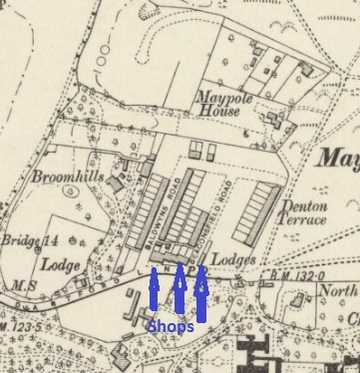
This page contains Video footage
To supply the everyday needs of the residents living on the new estate there was built a 'Parade' of shops. They were built as part of the Maypole Estate and are to be found along the Old Bexley Lane. There are four units 'en bloc' at the most westerly end of the lane at the junction with Baldwyns Road. There are two other independent units that stand to the eastern end, either side of the entrance to Beaconsfield Road. We will run through each shop, in turn, to give an idea as to what was for sale within each, through the decades.
Below - the 'parade' of shops c1920

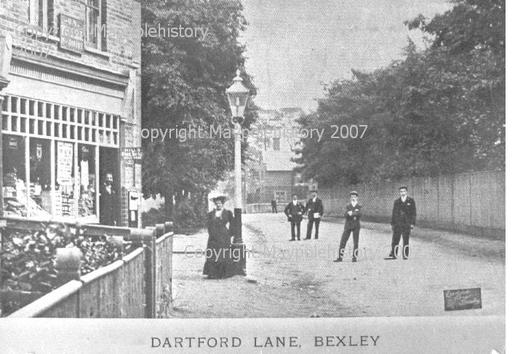
Above Vines Post Office 1904. Mr Vine in doorway and Mrs Vine at the lamp post.
Below c2004. Maypole Stores can be seen just behind the 'Off Licence' sign.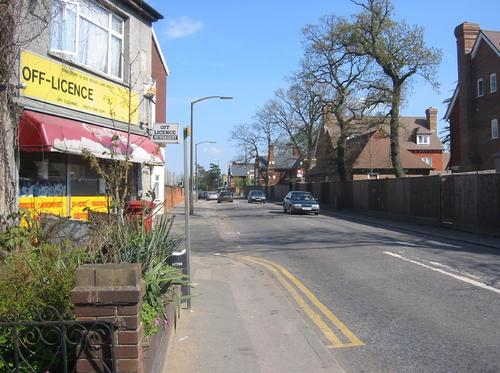
Below - 1936 outside Maypole Stores - the Post Office showing behind the telegraph pole.

We will also give an account, to the best of our ability, as to the names of persons shown on record as being linked with them. There was accommodation above each one - and the reader must not forget that at the time of construction it was the age of renting. Very few could afford to purchase their own accommodation.
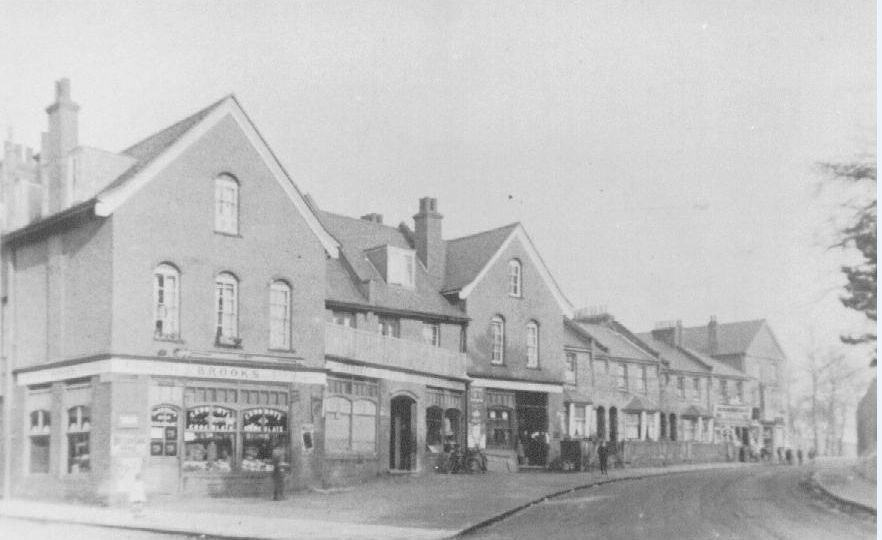
Above - Shops c1920 - note the little girl outside the corner shop - would she be allowed to roam alone these days ? Number 23 is the corner shop / building closest to the photographer.
Below - same location 70 years later.

There was a building on the site of the Cafe as far back as 1806 - see map of 1806 below
Note that there is a building just above the letters l and d in Baldings. This is the site of the cafe. The triangular shape of the land occupied by the premises known as the Cafe are on other maps / plans prior to the construction of the Maypole Estate
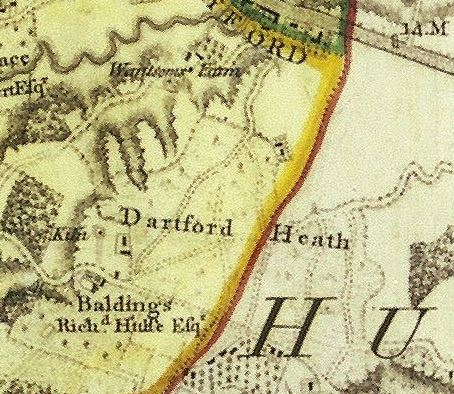
and below . . . as it looked in 2008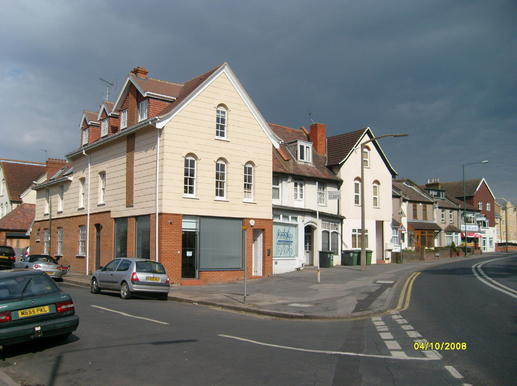
So, the records may show linked names, but they may have been tenants with no business interest. The numbering of properties in Old Bexley Lane has been recorded in various different ways over the years. This has not made identification of each property absolutely simple. It would appear that the following changes have occurred over the decades and the names of occupants recorded as thus:
12 - 19 were originally referred to as 12 - 19 'Ivy Villas' as in the records below
12 - 1918 and 1933 - TURNER - Maypole School Register (MSR)
13 - No record found as yet to this number being refered to as 'Ivy Villas'
14 - 1924 - LAWRENCE - Maypole School Register
15 - 1916 - STOKES - Maypole School Register
16 - 1916 - BURKE - Maypole School Register
17 - 1916 - TAYLOR - Maypole School Register
18 - 1916 - LUCAS - Maypole School Register
19 - 1916 - SIMS - Maypole School Register 20 - 23 ( the parade ) were originally referred to as 'Park View'.
20 - 1913 - GRAY - Maypole School Register - (Greengrocers)
21 - 1916 - BUSH - Maypole School Register
22 - 1916 - JIBB - Maypole School Register
23 - 1916 - BROOKS - Maypole School Register - Corner Shop - Cafe - and now private occupancy.
Numbers 12, 13, 20, 21, 22 and 23 were originally the shops.
Also, since the turn of the century Old Bexley Lane has been called:
Dartford Lane - Ordnance Survey map 1869 and KELLYs Directory 1927 Bexley Lane - Maypole School Register - 1916 and Electoral Register 1937 and Old Bexley Lane - current name.
So, starting at the most easterly end of Old bexley Lane:
12 Old Bexley Lane
Discounting the original Maypole School - now Academy Court - (coming from the direction of Dartford) on the right, is number 12. It stands on the eastern side of the junction with Beaconsfield Road. It is the most substantial original building on the actual estate that still survives and, some say, quite the ugliest. Throughout our research we have not come across any address in Old Bexley Lane with a lower even number than 12. We have often wondered why it is the first even numbered address and the number allotted was 12. Why not 2 ? Bexley Hospital has been referred to as number 1. There are no numbers 2 to 11. It may well be that the site of the school was earmarked for other development, which never materialised.
Number 12 is a 3 storey high, double fronted building. It is a very long and narrow construction. The height and narrowness, together with the virtual windowless eastern elevation facing Academy Court, could lead one to imagine that it is incomplete and awaiting further development to the east. Indeed, the original plans that show the site of this building as one earmarked for the 'Maypole Hotel'. These plans are dated 31st July 1897 and supports the idea that it should have been developed further. These primary plans did not show any place for a school. Interestingly, they also showed that Beaconsfield Road was tentatively named 'Maypole Road'. The plans at the time also referred to Old Bexley Lane as 'Dartford Lane'. The names JENNINGS and FELL appear on the plans. As previously stated, these names also occur on documents relating to later stages of the early development of the estate.
Frank FELL is shown in the Electoral Register of 1900 as living in Elm Lodge (The first original house on the left in The Dell - now demolished). His name also appears in the original title deeds showing partition of land (dated 1900) including where number 27 Beaconsfield Road now stands. The date of construction of number 12 is c1900. Apart from the 'Hotel' theory we have no idea as to why it was built so tall and narrow. One person who contributed (Frank BLACKMAN) believed it was originally built as a 'pub'. In reality its' main and continuous use until c1980, would seem to have been that of a general store, and then as a Hire Firm up until c1982, and then as a Florists up to c1987. The ground floor was then converted into offices by CONISTON builders.
The 1901 Census shows the occupants as Charles C Mitchell (Head) born in Rotherhithe, London. His occupation was shown as a Coffee House Keeper. His wife Susannah was as also shown as being born in Rotherhithe and as being a Coffee House Keeper. They employed three assistants.
![[Untitled] [Untitled]](https://static.s123-cdn-static-c.com/uploads/1523176/2000_5bafa410dc80a.jpg)
Records show that in 1880, when he was married, his profession was shown as a Carpenter. In 1904 Charles MITCHELL emigrated to Alberta, Canada.
The late Winnie BLACKMAN, stated that she remembered, as a child (c1915), the upstairs quarters being used for some sort of bible study by some children of the estate. We have no other record or other evidence to support this at the moment. After the census of 1901 the next census of 1911 does not show the address listed. However, it is believed that the occupants of this house as being Charles (Burt) CURDLING (c1911 - c1953). David TURNER and his son, Ernest were also shown as being there in 1917.They were most probably tenants as no one has referred to them as being shopkeepers.
Below the 1911 census - albeit for 23 Park View (The Cafe ?) is believed to relate to 12 Old Bexley Lane according to local knowledge.
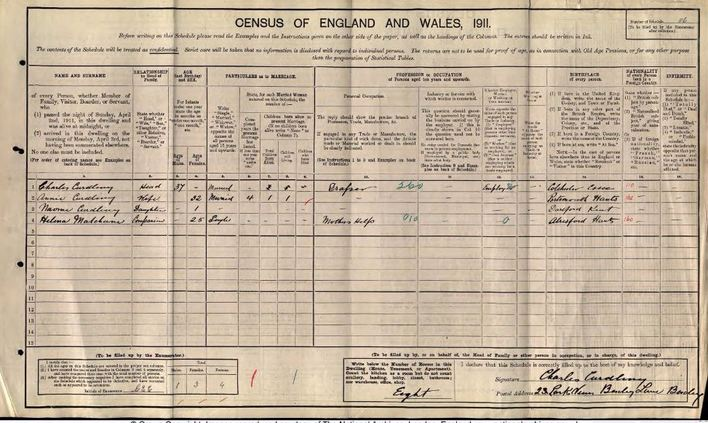
The KELLYs Directory of 1927 names the proprietor as Charles CURDLING but he was known as 'Burt' to the locals. (Gwen Saunders, Frank Blackman, Alfred Peters). A member of the team interviewed his late daughter, Naomi, however, and she stated she was unaware of this nick-name and thought that he was better known as 'Chas'. Naomi sadly died in July 2001. The shop was known to the locals simply as 'CURDLINGS'. He ran a general store that sold foodstuffs and other goods - from clothes, lengths of cloth, tobacco and cigarettes to grocery and sweets. The above census record shows his occupation as a Draper.
Mr CURDLING also ran a car hire business from this shop (Mr Alfred PETERS, Naomi CURDLING). Naomi CURDLING was born c1909 and moved to the address of 1 Edith Villas, Hillcrest Road, Crayford when she was 18 months old. This would have been c1912 and would have been about the time that her father first owned and ran his shop in Old Bexley Lane. It now seems clear that he was not the first shopkeeper at the address. As a child she disliked the name Naomi and always preferred to be called Joan. Hence she was always known as Joan. Before she died she reverted back to Naomi. It's little teasers like this that throw the pack off the scent at times ! She stated that she never had much to do with the estate as she never lived or was schooled there. At the age of 90 (1998) she was still driving and very active and living at 1 Hillcrest Road, Crayford until 2001. She stated that her grandfather had a shop in Lowfield Street, Dartford. This was also called CURDLINGS and would have been at the turn of the 20th Century. This is where her father would have learned his skills. He has been described by several (including Mr Alfred PETERS) residents as a typical Dickension 'Mr Pickwick' character. He was a stout and red cheeked man, and by all accounts, had a matching character. A man of joviality, quick wit and generosity. This was confirmed by Naomi. He held his 50th wedding anniversary in the Maypole Institute Hut and sang 'My Old Dutch' with a very good voice. (Mr Alfred PETERS). Naomi stated that her father was very keen on automobiles and at the time of interview in 1998 she still owned a 1938 Austin - purchased new for her by her father. Mr CURDLING did not live at the store, but across the heath with his wife Annie, in the large Victorian house at 1 Edith Villas in Hillcrest Road, facing the cricket and football pitches.
The 1945 electoral register showed them as living at number 1 Edith Villas together with Annie. In 1926 the ground floor of CURDLINGS is described as long, dark, open and supported by pillars (Alfred Peters) - a very typical Edwardian General Store. The design remained virtually unchanged until the early 1980s. The 1937 Electoral Register (ER) shows that Nellie and William TURNER also lived at the premises - probably as tenants (and probably relatives to David and Ernest, already mentioned) in one of the flats above the shop. The Maypole School Register (MSR) of 1933 shows that William TURNER and his daughter Grace lived at 12 Park View. This is probably another name for the address. Assuming that these are one and the same address, the following are also shown on records as having lived there:-
Date Name Source
1901 MITCHELL Charles - Coffee House Keeper - Census
1911 CURDLING Charles - Draper - local knowledge - untested.
1917 TURNER Ernest MSR = Maypole School Register
1917 TURNER David (Guardian of Ernest) MSR
1923 ALLMAN Frederick aged 5 yrs MSR
1923 ALLMAN Joseph (Father / guardian of Frederick) MSR
1924 ALLMAN William aged 5 yrs MSR
1924 ALLMAN Joseph ( Father / guardian of William) MSR
1926 ALLMAN May Jane aged 4 and a half yrs MSR
1926 ALLMAN Joseph ( Father / guardian of May ) MSR
1930 THORNTON Norman aged 5 yrs MSR
1930 THORNTON Lester ( Parent / guardian of Norman) MSR
1933 TURNER Grace aged 5 yrs MSR
1933 TURNER William ( Father / guardian of Grace ) MSR
1937 TURNER Nellie and William ER= Electoral Register
1945 TURNER Nellie and William ER
1953 WILLIAMS Lynn aged 5 yrs MSR
1953 WILLIAMS Gwylim ( Father / guardian of Lynn ) MSR
1954 BARRETT Ronald aged 5 yrs MSR
1954 BARRETT Lance ( Father / guardian of Ronald) MSR
1958 HOLMES Edith and Robert ER
1958 PROSSER Anthony and Joan ER
1958 ROBERTS Lilly ER
1960 BARRETT John aged 5 yrs MSR
1960 BARRETT Lance ( Father of / guardian of John) MSR
1967 RIKJE Anita aged 7 yrs MSR
1967 RIKJE Halvor ( Father / guardian of Anita ) MSR
1968 BULLARD Donald and Faith ER
1968 ROBERTS Lilly ER
1971 ROBERTS Lilly ER
1971 RIKJE Iris ( Mother of Anita ) ER
Naomi was of the opinion that her father sold the shop in the late 1940s During the time 1955 - 1982 and beyond, the shop was known as 'ROBERTS' (c1955 - c1976) and as being owned by Mr and Mrs ROBERTS - the daughter Vera married Lance 'Spadge' BARRETT who we believe came from Baldwyns Road. She helped run the store and then took over when Lilly became too old to manage.
Chas CURDLING died in 1954 aged 80 years - shown in the Dartford registers.
c1976 - c1980 Taken over by family of Asian origin and then by another white couple who lived on Joydens Wood. c1980 - c1984 The General Store closed as such and was then known as JEDS Hire Shop. They hired out the usual building and engineering hire tools.
c1984 - c1987 Flower Shop c1987 - Date Flats and offices including those of CONISTON Builders who, until recently owned (and may still do) the building.
13 Old Bexley Lane (The Post Office)
Number 13 stands in Old Bexley Lane to the west of the junction with Beaconsfield Road. It had always been a Post Office until c2002. The shop was built, along with the first of the other original houses, c1900. The Electoral Register of 1900 shows Frederick VINE as living there. He was the first proprietor and the shop was always known as 'VINES' - certainly commonly until the 1980s - some use the name still. Frederick VINE ran the shop, along with his wife Catherine. The KELLY's Register of 1918 and 1927 names Catherine as living in Old Bexley Lane, Maypole Estate and running a Post Office and Grocers. It is the only shop that still trades somewhere in the region of its intended and original purpose - once a Post Office and general store, but now a tobacconist / news / sweets corner shop. A hundred years down the line and people still crossed the threshold for stamps, string and letter paper.
The 1901 census shows that Frederick and Catherine had 6 children - Frederick 20yrs, Albert 17yrs, Arthur 15yrs, Daniel 11yrs, Ethel 8yrs, Katie 6yrs and Maria aged 4 yrs. Albert and Daniel are shown in various registers. The latter was a musician and performed on stage and radio in the 1920s \ 1930s in an Act known as 'Vine, Moore and Nevard'. (Frank BLACKMAN, Ruth LENNOX and Winnie BLACKMAN) Albert married Dorothy Joan and later moved into 2 Beaconsfield Road, his mother and father still working, and living at the Post Office. Click here for a video from Pathe News as to Vine, Moore and Nevard act.
Below photo of the trio taken in 1937
Copyright British Pathe
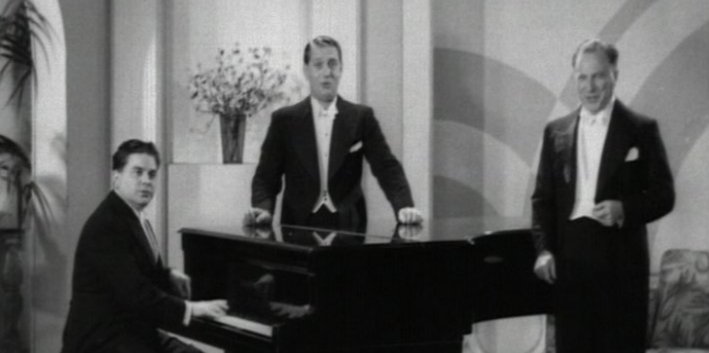
They had a daughter, Dorothy May, who was born on 28th April 1925. She started at Maypole School on 19th March 1934. The register shows that she had last attended a school in Woolwich. This would indicate that Albert left the Post Office, married, lived in Woolwich, then returned to the Estate. The page on Ivy Villas gives a little more information about Frederick Vine.
Below - extract from the 1901 Census

2 Beaconsfield Road is the closest house to the Post Office in that road. Records show that the family of WINCHCOMBE lived there, certainly between the dates 1907 to 1931. Did they share the same address ? It would seem, from what we have been told, that these terraced houses were quite capable of housing two small families at the same time. In 1955 this house still had the basic facilities for two families. There was a sink and tap in the rear bedroom - possibly the 'kitchen / dining' area of an upstairs flat type accommodation. However, there was only one toilet - and this was downstairs. The VINES ran the Post Office for nearly 50 years. The last Electoral Register entry we have bearing their name is in 1945. The next one of 1958 shows no sign of them, either in Beaconsfield Road or at the Post Office. In May 1955 records show that 2 Beaconsfield Road was purchased from a woman called Mrs KIRKHAM.
The petrol and paraffin pumps Frederick VINE sold Paraffin and Petrol from two hand operated pumps installed in the rear garden of the Post Office, facing Beaconsfield Road. The petrol was drawn from the pump and placed into a marked, glass container. It was then gravity fed (poured !) into the tank. In 1926 the price of petrol was elevenpence ha'penny a gallon (just under 5 new pence) (Alfred PETERS)
'The Paper Round' In 1926 Mr Alfred Peters was aged 12 years old. He was the son of the Chief Fireman at Bexley Hospital and lived at the entrance in West Lodge. It was at about this time that he gained the prestigious, and well sought after position of 'paper boy' for 'Bert' VINE. Mr VINE employed three paper boys at the time. Alfred tells me that his round consisted of Cold Blow, Baldwyns Park, Tile Kiln Lane, Summerhouse Drive and Baldwyns Road. None of the boys had bicycles at the time and all deliveries were on foot. The day started at 7.00.a.m. when the papers and magazines were sorted and marked up. Mr Peters remembers that the bag was extremely heavy and would chaffe his knees (short trousers for boys until 14 yrs old was the order of the day !). Morning 'Round' over, he went to school. In those days the school had a lunch break of two hours between 12.00 midday and 2.00 p.m. During this time he would go back to VINES for an hour and do errands. After school, in the evenings he would walk to Bexley Station to collect the evening papers, mark them and deliver them round the estate. On Saturday morning Alfred would deliver the papers and collect the 'paper money'. Upon his return to the Post Office Mr VINE would then count it. If there was any short it would be deducted from the boys' wages. In the afternoon Alfred would sit in the shop and wait for errands to run. He would also measure out the paraffin from the pump in the rear garden. Sunday was an 'easy day' with just the morning round to do. Alfred's' wage was 3s 6d ( 17 new pence ) a week - plus a dozen toffees. Alfred remarked that he was 'well pleased' to eventually hand in his notice to take better employment working as a 'Grocers delivery boy' for Mr SCOTTs High Class Grocery Shop in Bexley Village. He was supplied with a Trade Bike and a weeks' work in the school holiday would fetch 15s ( 75 new pence )
In 1959 the man who ran the shop at the time was a Mr Thomas TAYLOR. He was a Scotsman. He was a large man with a heart to match. His wife was called Grace. It is said that she had a rather serious face and manner. Mr TAYLOR would sometimes give out sweets to the kids on the estate. Sadly, it was not long after this that he suffered a stroke (c 1961) and became instantly bedridden. His speech was also terribly affected. They hurriedly had to sell up. There have been several occupants since. From records, below is a list of some of the occupants of the Post Office:-
Date Name Source
1900 VINE Frederick ER = Electoral Register
1901 VINE Frederick and Catherine Census
1911 VINE """ """
1918 VINE Catherine KELLYS Directory
1925 VINE Burt Frank BLACKMAN
1925 VINE Dan Frank BLACKMAN
1927 VINE Catherine KELLYS Directory
1928 WEBB Kenneth aged 9 yrs MSR = Maypole School register
1928 WEBB Maureen aged 7 yrs MSR
1928 WEBB Ethel L. Parent / Guardian of Kenneth
and Maureen MSR
1937 PHILLIPS Ethel ER
1937 VINE Catherine ER
1937 VINE Douglas Charles ER
1937 VINE Frederick ER
1945 PHILLIPS Edith ER
1945 VINE Daniel C ER
1945 VINE Frederick ER
1945 WEBB Ethel ER
1958 TAYLOR Grace ER
1958 TAYLOR Thomas ER
1968 KINGSLAND Florence ER
1968 KINGSLAND Frederick ER
1976 PATEL Arunkamar ER
1976 PATEL Avantika ER
1976 PATEL Rambhai ER
The 'Parade of Shops' - 20 to 23
20 Old Bexley Lane
Number 20 is the first 'book end' of the small parade, coming from the direction of Dartford. In the 1950s and early 1960s, these premises were run as 'Challices' the greengrocers. They supplied fresh fuit and veg to the Maypole Estate. This was a busy little shop as freezers and fridges in the 1950s / 60s was quite uncommon. The back yard had a half covered area to store the produce. There was also room for a flat back lorry - and one was parked most of the time there. There was a friendly old German Shepherd dog chained out the back. The earliest record of occupation we have of the premises goes back to 1916 when the Maypole School Register showed that Catlin GRAY lived there with her father, William. The Kellys' Register of 1927 shows William GRAY as a shopkeeper. He was a greengrocer. (Winnie BLACKMAN) Records below show the occupation of the premises:-
1911 Census
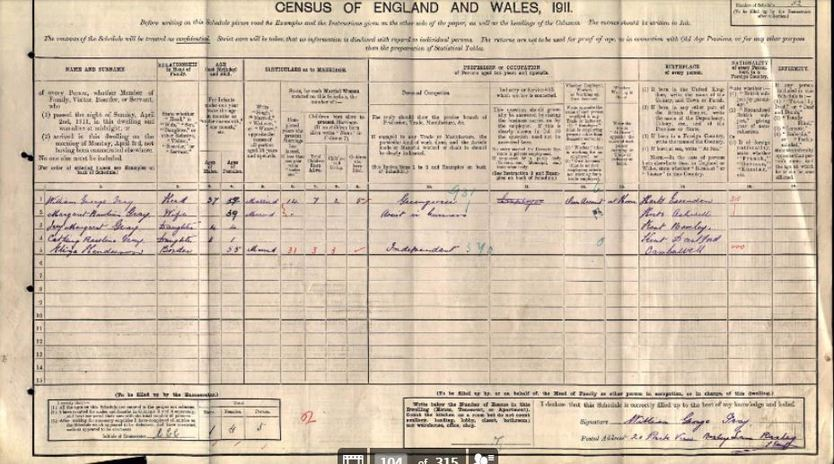
Date Name Source
1901 ALLEN Harry - occupation Butcher. Sarah shown as his wife. There was a 'servant' Mary Oconnor, CENSUS.
1911 GRAY William and family - shown as Greengrocer - Census
1913 GRAY Catling Rawlings aged 6 yrs MSR = Maypole School Register
1913 GRAY William George father of Catling MSR
1936 CHALLIS John Gilbert aged 5 yrs MSR The CHALLICE family ran a greengrocers from these premises.
1939 CHALLICE Norman aged 6 yrs MSR
1936 CHALLIS Phillip Clifford parent of John MSR
1937 CHALICE Phoebe (Wife of Phillip Snr ?) ER = Electoral Register
1937 CHALICE Phillip J ER
1939 CHALLICE Phillip father of Norman MSR
1945 CHALICE Phillip C Snr ER
1945 CHALICE Phoebe ER
1958 CHALICE Phillip Snr ER
1964 CHALICE Cheryl Anne aged 6 yrs MSR
1964 CHALICE Sheila parent of Cheryl MSR
1968 HUDSON D F ER
With regards the first entry of the GRAYs - the MSR shows that Catling GRAY entered school on 13th February 1913. Her sister Ivy entered on 29th September the same year. The father is shown as William for both - but the address changes. Catling is shown as number 20 and Ivy as number 22. I believe that this is a clerical mistake and that the correct address is, in fact, number 20 - the greengrocers. Alfred PETERS - an ex resident - remembers that the RIPLEYS of Darford had a stake in, or ran, the property c1930 - 1939. They still run a greengrocers firm in Dartford (as well?) I have since learned that Phillip CHALLICE was married to one of the RIPLEY daughters (Phoebe ?) and this is where the connection occurs. (Mr Gordon LENNOX - now living in New Zealand) The school register of 1939 shows that CHALLICES had arrived. John was aged 5 years and Norman was aged 3 yrs old at the time. Their father was Phillip. The Challices remained at number 20 until the mid 1960s. The premises then changing use to that of a motor repairers.
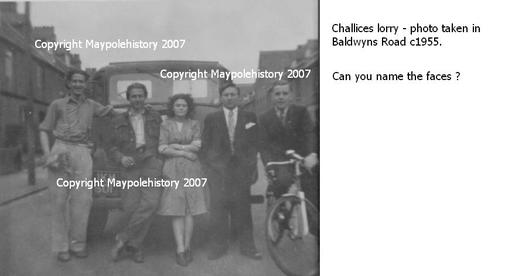
Above Left to Right - Ernie GOSLING, three CHALLICE children and David CRUICKSHANK
The 1970s then saw the change of use to 'Citycrest' Caterers. This firm ceased to trade there c1992. The premises are no longer used as a shop.
21 Old Bexley Lane(Park View) At present, the shop business remains a bit of a mystery, as hard and fast records are very sketchy. Basically, records show that in its' infancy it was Jas COATES butchers. The 1911 Census is below.
1911 Census
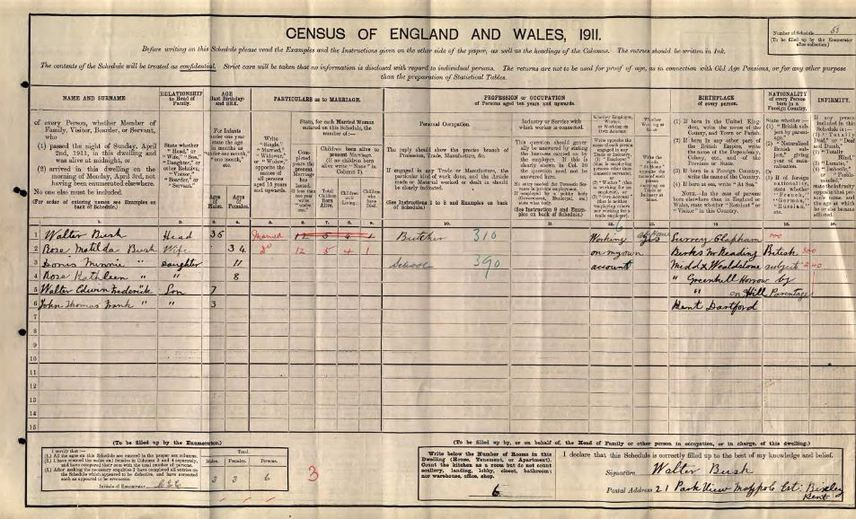
A photograph c1916 shows the shop with 'J COATES' above the window. The 1927 KELLYs Directory shows that Jas COATES was a butcher. Winnie BLACKMAN stated that she remembers COATES the Butchers c1928, next door to GRAYs. The family COATES is not shown in any Electoral Register in our records. In the late 1950s / early 1960s it was a hardware type electrical type battery shop. In the mid 60s to early 1980s it was a bric a brac / antiques / book shop.
Below are the names appearing on records that we have:-
Date Name Source
1901 WALKING Albert - occupation Greengrocer. Wife shown as Sarah. Looks like Thomas and Emily were lodgers. Census.
1911 BUSH Walter and family - Butcher - Census
1913 BUSH Doris Minnie aged 14 yrs MSR = Maypole School Register
1913 BUSH Walter Edwin Frederick, or Frank (FK) aged 9 yrs MSR
1913 BUSH Walter father of Rose, Doris and John MSR
1914 LEADER Willie aged 6 yrs MSR
1915 LEADER Rose aged 13 yrs MSR
1915 WHIBLEY Arthur William aged 12 yrs MSR
1915 BUSH John aged 7 yrs MSR
1915 WHIBLEY Eric John aged 6 yrs MSR
1915 WHIBLEY Cyril Peter aged 4 yrs MSR
1915 WHIBLEY Henry Frank father of Eric Cyril and Arthur MSR
1927 COATES Jas. (Butcher) WINNIE
1937 BROWN Albert Henry ER = Electoral Register
1937 BROWN Kitty ER
1958 BALL Harry F ER
1958 BALL Mary A S ER
The below explains in more depth . . Between 1913 and 1916 the Maypole School Register shows three families as living at the address viz: BUSH, LEADER and WHIBLEY. Early records from the (Maypole School Register) show that the following children lived there in 1915:- John BUSH aged 7 years, Walter Edwin BUSH aged 11 years, Rose BUSH aged 13 years and Doris BUSH aged 16 years - having left the school. The father \ guardian was shown as Walter BUSH. John and Walter are shown as leaving on 7th February 1915 to go to Crayford. Presumably the family moved out then.
In addition, the same register shows the following as living there:-
Willie LEADER aged 10 years (1916) - entered school 1914 - left 1916 - left district
Rose LEADER aged 13 years (1915) - entered school 1915 - left 1915 - left district Another entry in the records shows a Rose LEADER, with the same date of birth, as also being resident at Manor Gate Home, Leyton Cross in 1914. There is no record of parentage for these two little LEADERS. The register shows the following as living there in 1915:- Arthur WHIBLEY aged 12 years - entered school 12th April 1915 Eric WHIBLEY aged 6 years - entered school 7th June 1915 Cyril WHIBLEY aged 5 years - entered school 7th June 1915 Their father was shown as being Henry WHIBLEY Cyril WHIBLEY went on to marry Elsie and live at 15 Baldwyns Road. His children Angela, Maureen, Martin and Ann also went to Maypole School. Eric WHIBLEY went on to marry May and live at 24a Beaconsfield Road. His children Raymond, Brenda and Beryl also went to the school. Albert and Kitty BROWN lived there in 1937. Also in 1937 a newspaper cutting described the sad funeral of a Charlotte GRIMSHAW - a teacher of great renown locally - who lived at 9 Baldwyns Road. She died quite young at the age of 47 yrs. Mentioned in this newspaper cutting were the names of many mourners - including those of Mr and Mrs COATES. This is the only firm reference, in document form, that I have of the family name. Harry and Mary BALL lived there in 1958.
22 Old Bexley Lane(Park View) Again, hard and fast records are less than revealing as to its identity and chronological useage. Information leads me to believe that it was a shoe shop and repairer c1920/1930. The bootmaker was killed in a Road Traffic accident (c1927) outside the Hospital gates when he was run over by a motor cyclist named W BOYCE from Bexley. After this happened, the shop was taken over by the Dartford Cooperative Society. (Alfred PETERS). Mr (Edward) MILES owned the shop (c1950s early 1960s). He sold and repaired shoes and boots. We do not know when he ceased trading and do not know if anyone took over from him. We are told told that he had a daughter, Christine, who had a tragic illness. Apparantly one half of her grew normally and the other side failed to. She died very young. The death is reflected in the Maypole School register. She was born January 1945, entered the school in April 1950 and last attended classes on 23rd July 1954. Reason for leaving - in hospital - deceased August 1956. The below are shown as residing at 22 Old Bexley Lane:-
1911 census

Date Name Source
1901 LEGGE Martin (apt name) occupation Bootmaker. Census.
1911 JIBB / LOVELAND / RANSOM - census
1913 GRAY Ivy aged 13 yrs MSR = Maypole School Register
1913 GRAY William (Father) MSR
1914 JIBB Cyril aged 13yrs MSR
1915 JIBB Marjorie aged 13yrs MSR
1915 JIBB Charles (Father) MSR
1930 BEDWELL Leslie aged 14yrs MSR
1931 BEDWELL William aged 11yrs MSR
1931 BEDWELL Bernard (Father) (Manager of Co-op) MSR \ Alfred PETERS
1932 ANDERSON Bertram aged 11 yrs MSR
1932 ANDERSON Eileen aged 7 yrs MSR
1932 ANDERSON Henry (Father) MSR
1932 CLARKE Barbara aged 4 yrs MSR
1932 CLARKE Frederick (Father) MSR
1936 RALPH HIlda - stayed 2 days MSR
1936 NORTH Winnie (Aunt of Hilda RALPH) MSR
1937 COOPER Amy Florence ER = Electoral Register
1937 COOPER Benjamin ER
1945 COOPERs as above ER
1950 MILES Christine aged 5 yrs MSR
1950 MILES Edward (Father) MSR
1958 CURRY Agnes ER
1958 HARRISON Kathleen ER
1958 MILES Edward ER
1958 MILES May ER
1967 TUERINA Frances MSR
1967 TUERINA Leonard (Father) MSR
1968 TUERINA Leonard ER
1968 TUERINA Patricia ER
1976 MESOUROUNI R ER
1976 WRIGHT Marie D ER
As already stated with this address and the first entry of the GRAYs - the MSR shows that Catling GRAY enterd school on 13th February 1913. Her sister Ivy entered on 29th September the same year. The father is shown as William for both - but the address changes. Catling is shown as number 20 and Ivy as number 22. We believe that this is a clerical mistake and that the correct address is, in fact, number 20 - the greengrocers.
23 Old Bexley Lane(Park View)- Maypole Café
The earliest record we have of the Cafe is a planning application for a Coffee tavern, Maypole Estate for Mr.T.A. Osborne in 1897
The Census records for 1901 show that it was a Shop - run by Margaret HARDY - her husband was a carpenter.
This address until c2000 was the Maypole Cafe. To the Maypole team it is probably the most interesting site remaining on the Maypole housing estate. It is interesting because the current building sits on the footprint of an older one. The Ordnance Survey Map of 1869 shows a building at exactly the same angle to the Old Bexley Lane and with the same triangular frontage. We have yet to establish what the original building was - and this is what is so fascinating. The nearness to Baldwyns Manor indicates the possibility of some link. Could it have been the residence of a bailiff, gamekeeper, a tradesman (blacksmith ?) or a building of recreation or refreshment ?
The original building was there prior to Broomhills, Heathwood and Maypole House. Its' contemporary near neighbours would have been Maypole Farm and Baldwyns Manor. The older residents remember this as BROOKS' shop. Sweets, confectionary and cigarettes were sold. There was a small area set aside as a café. (Alfred PETERS). People of later generations only remember it just as a café. It has a cellar. There were wooden doors in the pavement, facing Old Bexley Lane - like a draymans cellar door outside a public house. Access from the street, originally, would have been for bringing in goods. Whether a cellar existed in the older building and whether there was access from the street we do not know. There is an outbuilding at the very rear and it is constructed as a workshop, complete with chimney ! Considering the date of this latest construction, it is quite feasible to think that the purpose of the outbuildings to this property and that of the Greengrocers at number 20 was for the stabling of horses.
Recollections of Alfred PETERS c1927 reveal that the Cafe was a meeting place for some youngsters. In particular, he recalls that after Carol Singing in the freezing cold with his mates, they would all 'adjourn' to the cafe and have hot pineapple drinks.
Strangely enough, the 1911 Census shows the CURDLINGs as living there ? Yet they have always been associated with No. 12 Old Bexley Lane - CURDLINGs ?
1911 Census
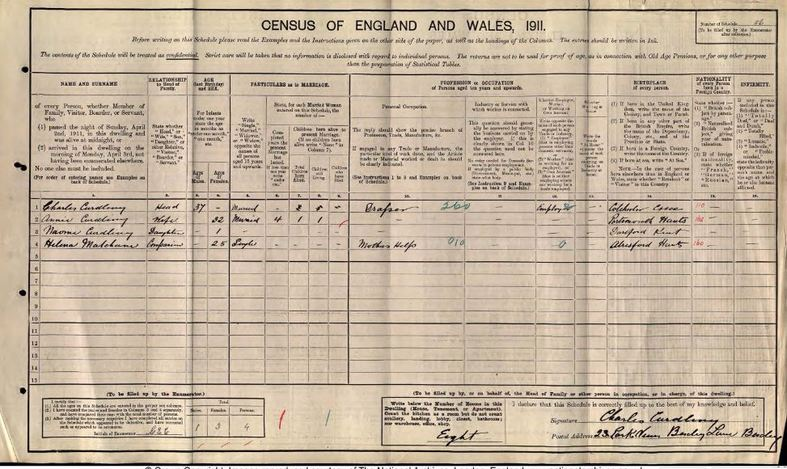
The following have been recorded as living there:-
1901 HARDY William (Carpenter and Joiner). Wife Margaret HARDY - Shopkeeper and Grocer.
1911 CURDLING family - census.
1916 BROOKS David James aged 13 yrs MSR = Maypole School Register
1916 BROOKS Elvey father of David MSR
1922 BROOKS Rose aged 11 yrs MSR
1920 BROOKS Alfred BROOKS Parent / Guardian of Rose MSR
1933 NEVILLE Ann born 23.8.1926 MSR
1933 NEVILLE Guy father of Richard Ann and Joan MSR 1935 NEVILLE Ann born 23.1.1928 MSR
1935 NEVILLE Richard Guy aged 7 yrs MSR
1935 NEVILLE Joan aged 5 yrs MSR
1942 MILTON Iris June aged 9 yrs MSR
1942 MILTON Henry Ernest aged parent of iris MSR
1945 MILTON Lily ER = Electoral register
1945 ROBERTS Derek ER
1945 ROBERTS Ernest C ER
1950 COWARD Peter James aged 9 yrs MSR
1950 COWARD Edna Gladys parent of Peter MSR
1952 REYNOLDS Angela Mary aged 5 yrs MSR
1952 REYNOLDS George parent of Angela MSR
1953 HARRISON Susan aged 4 yrs MSR
1953 HARRISON Dorothy parent of Susan MSR
1968 ASHMADE Albert E ER
1968 ASHMADE Florence ER
1968 BOLTON Frederick E ER
1968 BOLTON Joyce P ER
1976 BOLTON Frederick E ER
1976 BOLTON Patricia J ER
1976 ESHMADE Albert E ER
1976 ESHMADE Florence ER
Fred and Joyce BOLTON lived there until c2000 when the Café was still running - at least 70 years down the line. It is now refurbished and private occupancies.
Read the memories of Barbara Rivers of the shops
Below are two photographs of the 'shops at the 'Dip' c1955
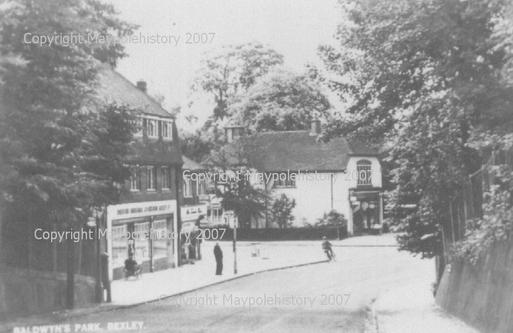
and below - how it looks in 2006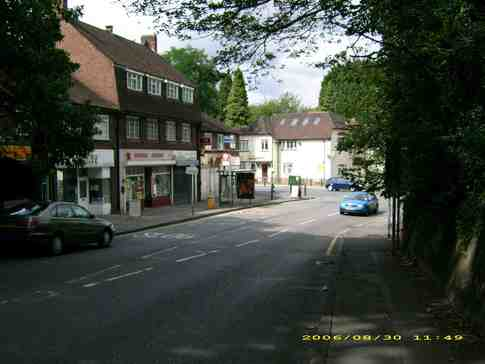
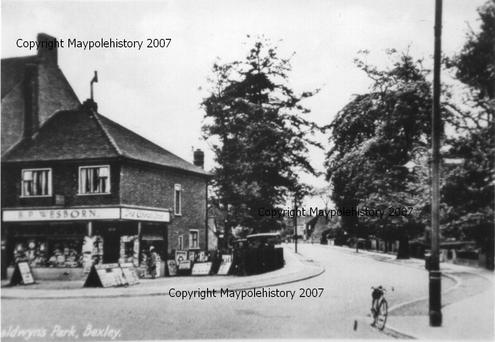
and how it looks in 2006 below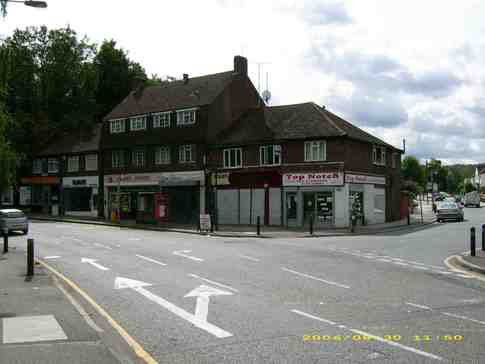
Elsey Fish and Chip Shop - Dartford Road
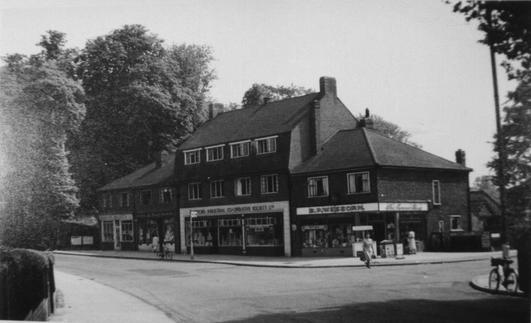
Above - Elseys was far left next to the billboards and fence - taken in c1950s
From "Sampask"
Hi my grandparents Harold and Madeline Elsey owed a Fish and Chip Shop at 1 Dartford Lane, Bexley. Near Sweets the Hairdressers, Chipperfield's and Henderson's. I use to help my beloved grandparents in their shop when I was old enough and loved helping out. I have fond memories of my time there. My grandfather use to deliver to Dorothy Squires and Roger Moore when they were entertaining. I remember my nan said that Rita Loza use to sing I think this was in the 40's/50's apparently she was a very popular singer in her time. I think this was her name! and yes they did have a swimming pool, which must of been unheard of during those times. Again a rarity to have a swimming pool in this day and age let alone in those times. My father Anthony and his brother David use to have a cat called Marmaduke and my dad apparently use to take Marmaduke to the pet show which I believe was a yearly event and he would pick Marmaduke up (who by the way use to weigh a stone! and was a good rat catcher for the shops near by) not brushing him and use to win a prize, I believe money was won and the kids use to tell my grandmother don't let Tony take Marmaduke up to the show again. I believe they won a few times. My grandparents retired in the 70's. My beloved grandfather died when my son was three months old in 1992 and my grandmother died six years ago 2006. The stories that they told my brother and I when we were small and when we were older will always live on. I remember, like yesterday, the excitement of driving from Hampshire to Bexley and driving through the village and going up the hill and going down the dip and seeing my grandparents shop. My grandparents remained in Bexley when they retired. After they retired I use to go and visit the old shop by passing by and remembering the good times, although this is rare now that my grandparents are no longer alive. My grandparents were simply the best!
From "maypole man" - Hi Sampask,
What wonderful and cherished memories you have and how good of you to share them with us. Elseys, was indeed, a very popular fish and chip shop ! I remember - probably back in 1964-65 my friends and I caught a massive - but very ill looking - pike in the river by the Old Mill in Bexley. We carted it off on our trolley - yes we had old trolleys in those days for fun - and up to your grandparents fish shop, believing it must be worth a lot of money. I believe your grandfather - out of kindness - gave us a couple of bob for our troubles and, no doubt, left it out for the dustman or threw it over the hedge for the foxes. Lovely memories of your grandparents
From Sampask - Hi Maypoleman.
I laughed about the pike and yes sounds like my grandad. He probably had a big grin on his face and would of told my nan afterwards.
My grandad was such a kind and generous man. My grandad was known as "Sonny" to his family and "Harry the fish!" My dad Anthony (Tony) Elsey died 15 years ago. He attended the Maypole school with his older brother David and his cousins Stephanie and Clive Babiak. If anyone has any old photo's or memories I would be grateful of having any stories/tales. My dad was a bit of a monkey when it came to school. I remember my nan telling me that the school board master came round to the shop and told her that Tony has been bunking off school and my nan wasn't having it (Dad use to go off to school with his sachtel and then go up Baldwyns Park to the woods and play up there until it was time to come home! rascal). My nan even took him to watch the Rocky Horror Show before she found out. Needless to say he got a good ole ticking off and because the headmaster told my dad that he wouldn't become of anything, dad being dad wanting to prove someone wrong, then came head of the year and won a book which the headmaster had to present him which was "King Solomon's mines" - my mum still has it! So needless to say Dad proved the headmaster wrong! I remember going to visit the Chipperfield's a couple of doors away, going round the back and then up to the front door which had a lot of steps going up to the front door. I lived at the shop until I was 3 months old and my parents moved to Andover where my dad had a job and a house, that was in 1966. We would visit my Nan and Grandad often and would have picnics in the back yard of the shop with our ice creams and jelly. My grandad also worked for Vickers in Crayford and was a Seargent and gun instructor in the Army (Peace time) and also worked at Enfield Lock.
From Stuart Grieve - The singer was Lita Roza, who used to sing with the Ted Heath band.
July 2024 - Below from David Elsey - born in the premises and family ran the business
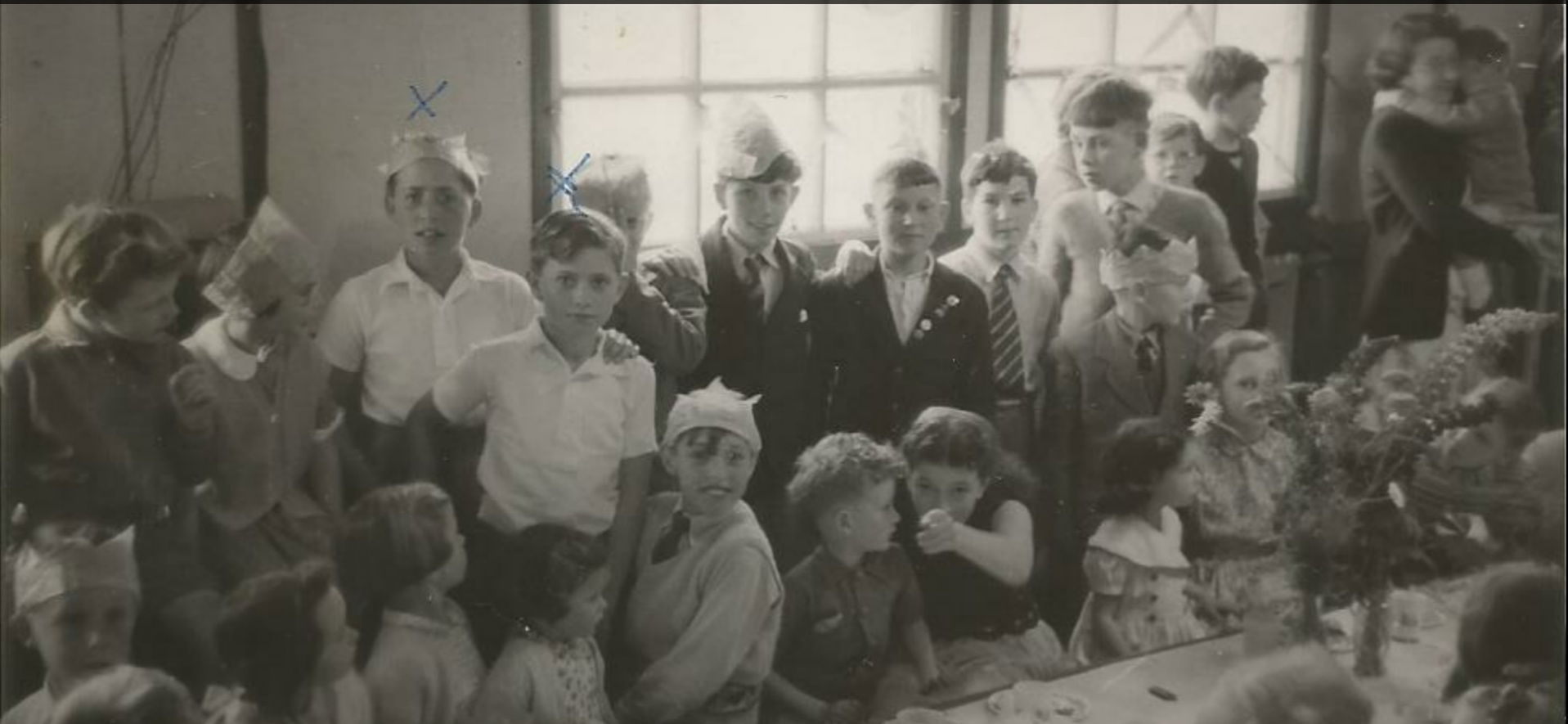
Visited Bexley last week with one of my Tibetan sons, he was curious where I grew up etc.
This photo may have been taken in 1952 (Coronation Elizabeth ll). If so I would have been 11yrs old and my brother 9yrs. Why Mum put crosses on us I have no idea. I noticed the pavilion is no longer wooden panels but built with breeze blocks and moved further away from the site of what was once the tennis courts.
Parents' ex-fish shop at 1 Dartford Road, a complete mess/derelict due to the Asian Take-away having left the premises, likewise the shop next door.
It was here in 3a Dartford Road, Bexley where I was born on the dining room floor behind the Ladies Hairdresser during the War.
Bexley Archives has no record of where the bomb actually dropped in Baldwyns Park, says only in the vicinity?!?
I went up the hill towards the Maypole Estate and saw St Barnabus had disappeared.
What a shock to see this large building (block of flats) where my old school stood. Can remember dancing around the Maypole on the 1st May in the playground. Miss Gaspar (headmistress) was a stickler for tradition, likewise Miss Burr (deputy head).
Went down the alley and saw the school's brick walls were still standing. When did Beaconsfield Road have tar-macadam laid? It was always a dirt road in my time.
Mixed feelings about this trip back in time. I know we need to move on but whether some of the changes are for the better is open to debate.
David Elsey
Baldwyns Park and Pavilion
First - an early view of Baldwyns Park
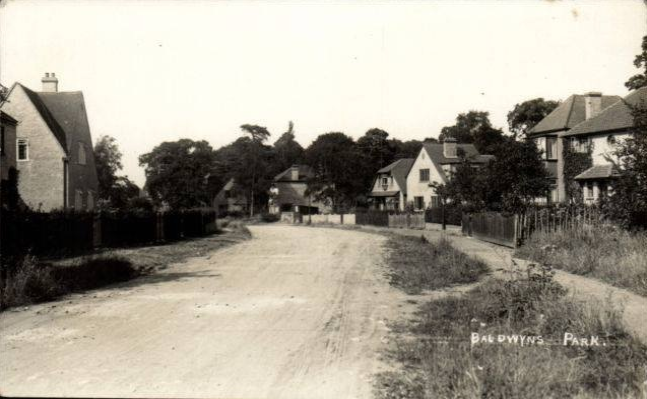
courtesy of Brian PORTER
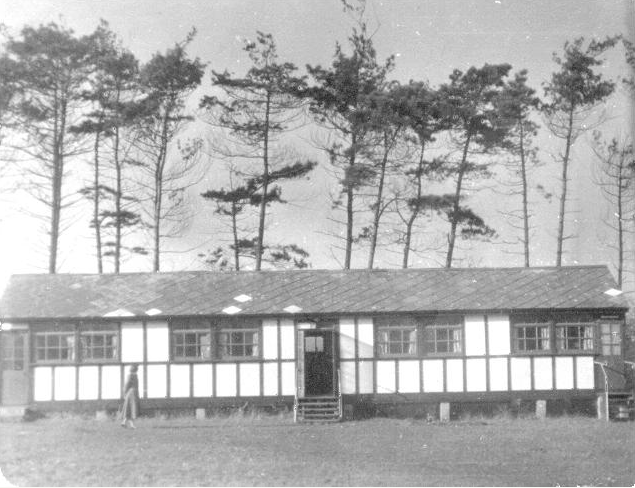
Above - Baldwyns Park Pavillion c 1950 - courtesy Tony Helyar
Below - as it looks now - courtesy of the Baldwyns Freeholders Association
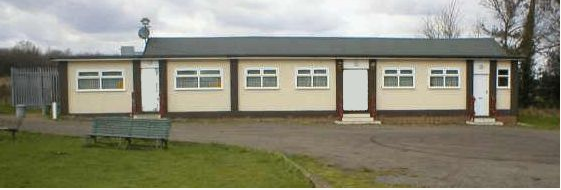
A compilation of memories from contributors . . . . .
First by Tony Helyar . . . . .
Reading Frankie Gemmell’s memories and her mention of going to Baldwyn’s Park pavilion for a few drinks on a Saturday evening remind me of our activities there in the 1940’s and early 1950’s, there was no bar there then. The pavilion was nevertheless the centre of many community activities. There was the very successful Girl Guide group excellently run by Miss Hamilton and Miss Ashbury, I remember the Guides going round the local roads with a wheelbarrow on Saturdays collecting household salvage for the war effort (it wasn’t known as recycling in those days). There was the table tennis club ably managed by Ken Kinniple and Ken Simmons (we played with moderate success in the North West Kent league); a youth club run by Mr. & Mrs. York; the annual horticultural show, stacked with produce from gardens and the nearby allotments, all of which was auctioned after the show by a local professional auctioneer, I believe his name was Gale.
There were regular dances, old time and modern, but probably the most successful venture was the Dramatic Society.
The first public performance by the Baldwyns Dramatic Society at the pavilion was a set of one-act plays given in November 1946. This was followed by a three-act production in April 1947. These shows were so successful that the group went on to produce three or four plays a year right through to 1951. The audiences, drawn entirely from local residents, were always most supportive, on one occasion even having to bring their own chairs. The difficulties posed by the tiny stage, it was no more than twelve-foot square, and an equally tiny single dressing room were overcome by incredible ingenuity and tremendous enthusiasm and with the co-operation of other users of the building. Bob Gemmell (Frankie’s father) and my father built the stage at one end of the pavilion in such a way that it could be taken down after the three day run to provide the space necessary for other activities. The stage footlights doubled as the overhead lighting for the table tennis tables. When funds permitted a small marquee was erected adjacent to the pavilion on show nights to serve as an extra dressing room.
There had at one time been a tennis club based at the pavilion, there was a hard and a grass court there complete with the nets but all sadly neglected. A group of us cleared the hard court, repaired it and the net as best we could and played on it for a couple of seasons. Wimbledon it wasn’t but we had a lot of enjoyment from it and I still have the scar on my knee where I failed in my attempt to jump over the net.
Programme for three one-act plays. Baldwyns Dramatic Society’s first production, November 1946
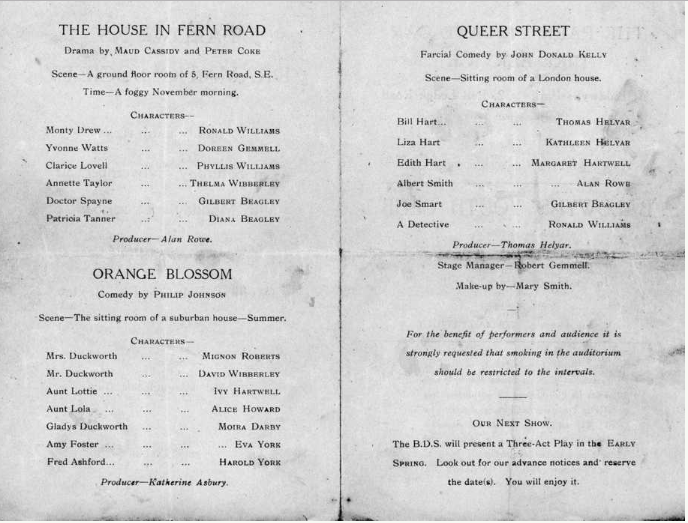
The names of those who were involved in the Baldwyns Dramatic Society:-
| Colin | Allen | |
| Katherine | Ashbury | |
| Alice | Beagley | |
| Diana | Beagley | |
| Gilbert | Beagley | |
| Audrey | Bickley | |
| Michael | Bickley | |
| Myrtle | Brown | |
| Moira | Darby | |
| Joan | French | |
| Doreen | Gemmell | |
| Robert | Gemmell | |
| Hazel | Green | |
| Constance | Hamilton | |
| Joan | Harris | |
| Leonard | Harris | |
| Ivy | Hartwell | |
| Margaret | Hartwell | |
| Kathleen | Helyar | |
| Thomas | Helyar | |
| Tony | Helyar | |
| Alice | Howard | |
| Phylis | Huntley | |
| Charles | Keith | |
| Yvonne | Lawrence | |
| John | Measures | |
| John | Mellor | |
| Beryl | Moody | |
| Gerald | Pelham | |
| Monica | Richardson | |
| Leslie | Roberts | |
| Mignon | Roberts | |
| Alan | Rowe | |
| Roy | Scott | |
| Audrey | Shackell | |
| Mary | Smith | |
| Audrey | Snelson | |
| David | Wibberley | |
| Thelma | Wibberley | |
| Phyllis | Williams | |
| Ronald | Williams | |
| Eve | York | |
| Harold | York |
Extract from Frankie Gemmell . . . .
I remember the Pavilion in Baldwyns Park where a crowd of us used to spend Saturday evenings with a few drinks and dancing.
People I remember from Baldwyn's Park area are, Mary & Richard Wight, Patricia & Terence Palmer, Carole & David Fox, 2 Williams girls who moved to Brazil, Gatehouse family, McManus family, Sheila Miles, cannot remember names of several others. Other people from the Tile Kiln Lane and Summerhouse Drive and then new Joydens Wood Estate, I remember are, Pat Vass, Doreen Hurren, Sue Nye, Sheila Peckham, Russel Pettifer, John Griggs who had a twin brother, Cliff Young (deceased) and family, David Bainbridge, John Parker, Ken Webb, Trevor Moseley, Tony Turner, Terry Seagust, Terry Deegan (had a Monkey Puzzle tree in front garden - lovely), Anthony Gillies, Carole Slade, John Houghton, Roger Fisher, also Carole from Baldwyns Road & Sheila (now Lusher) I am in contact with, both lived on the Maypole but I cannot remember surnames, there were others but I cannot remember the names - if and when they come to me I will e-mail them to you. There was also a round house with a thatched roof, top of Baldwyn's Park just over on the left in Tile Kiln Lane, cannot remember names of people who lived there or the house next door, dont know if round house still there?? After starting work met up with two or three people from the Footscray/Sidcup area who also used to come to the Pavilion in Baldwyns Park on a Saturday evening, Roger Smith, Roger Hogg and "Taffy" but not really connected with the Maypole and area.
A couple more names for you Rob Merriman, Keebles, Nigel Wilson, Tony Barton, Rob Jevons (friend of Owen's). I understand Peter Walker moved into Terry Deegans's house which had the Monkey Puzzle tree in the garden.
Maypole of the 1950s
This page has been constructed from donations by Maypolechippy - real name to follow in the near future we hope !
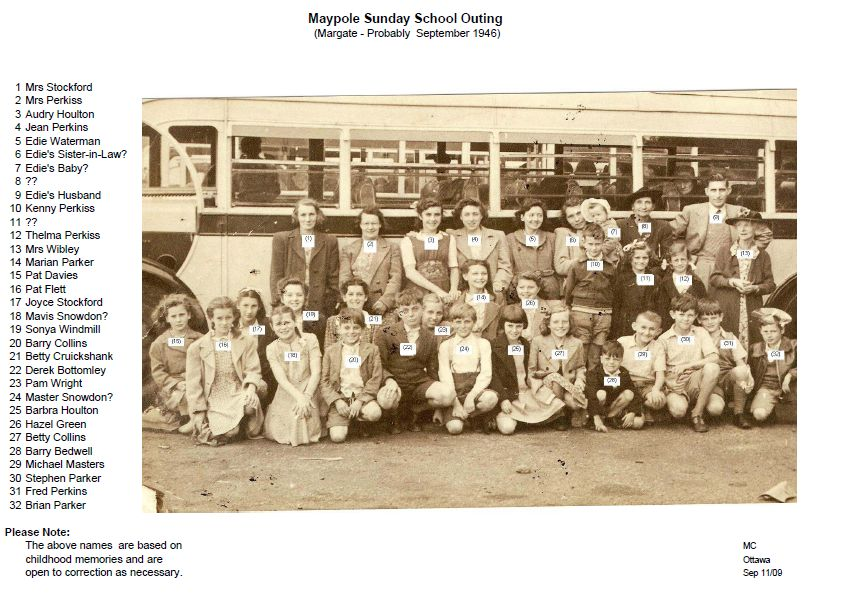
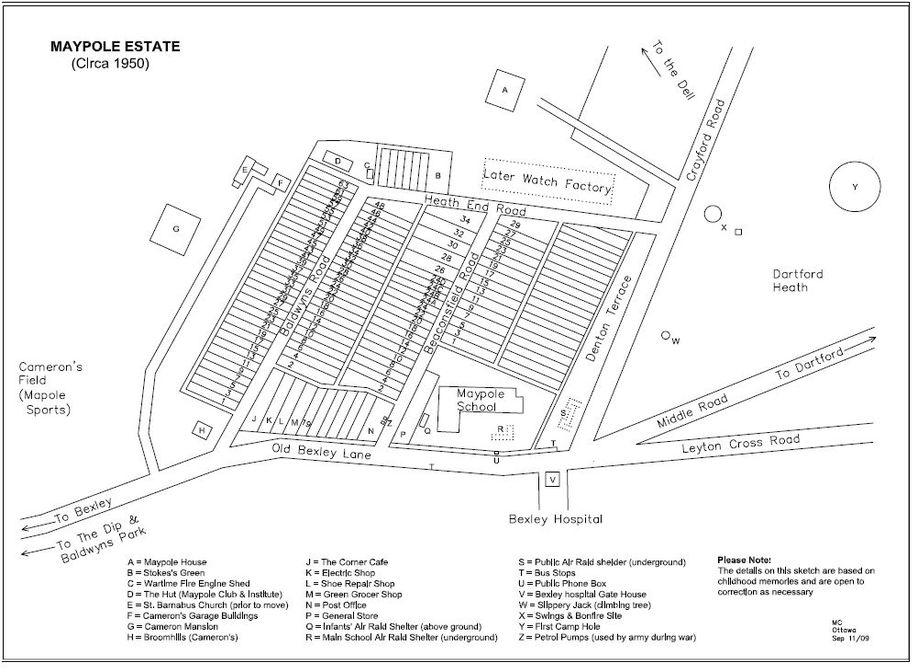
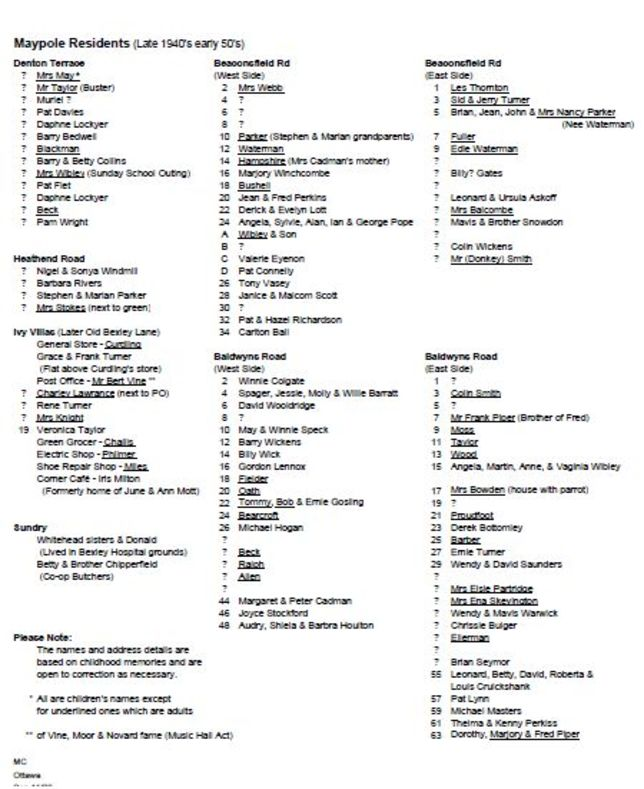
In an E Mail from Maypolechippy "Having left the Maypole in my early twenties (when I got married) and having lived in Canada for the past 42 years, I had naturally lost touch with most things Maypole. My recently widowed sister (who still lives in the Bexley area) visited my wife and me this summer and we had a good time reminiscing about life on the Maypole in the 40’s and 50’s. We had great fun trying to name the other children living on the Maypole at that time, which led to us to develop a list of names and best guesses of their addresses. The result is a sketch of the Maypole as we remember it from that time and an accompanying list of names. We were also interested to see Stephen Parker’s Sunday School Outing photo of which I also have a copy. We tried to fill in the missing names in Stephen’s photo and made a record of them. I would like to share these memories with you in the hope that in their small way they add another snippet the ever evolving recorded history of the Maypole". |
Rolex watch factory - now gone
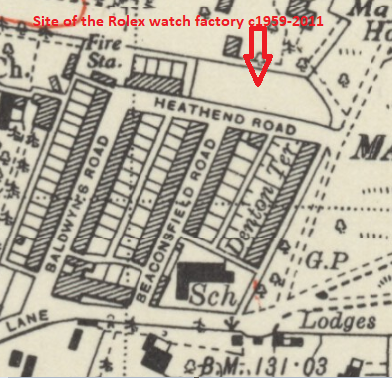
As it was after demolition and then below that, how it is now . . . . .![[Untitled] [Untitled]](https://static.s123-cdn-static-c.com/uploads/1523176/2000_5bb915085fd70.jpg)
The new houses on the Rolex Site February 2013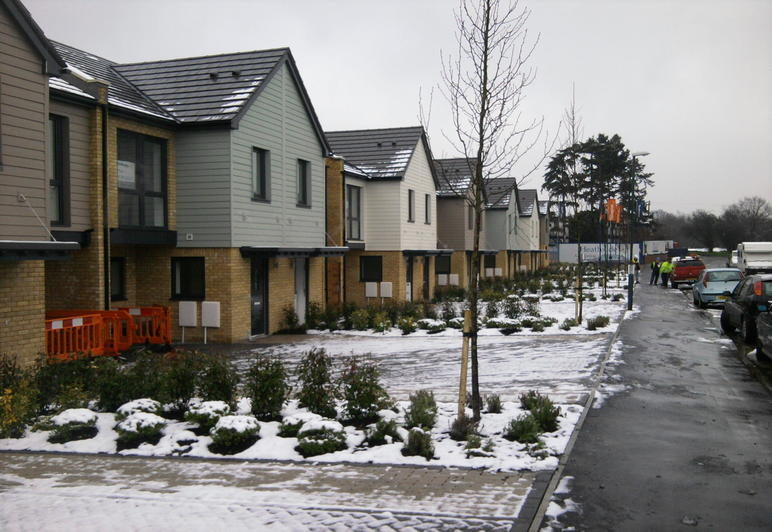
As it was in c1995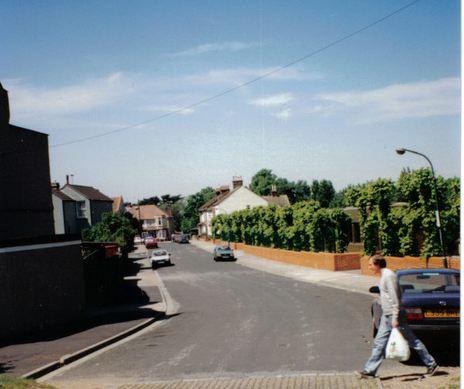
How it was in c2005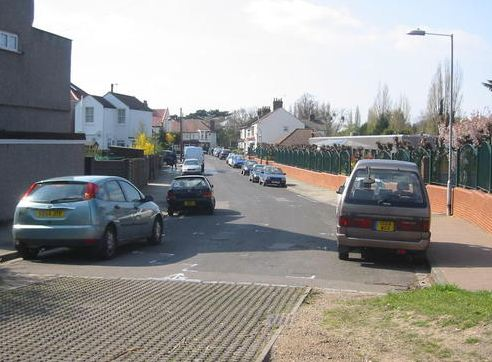
Rolex factory demolished and new building commences - pictures below
May 2012
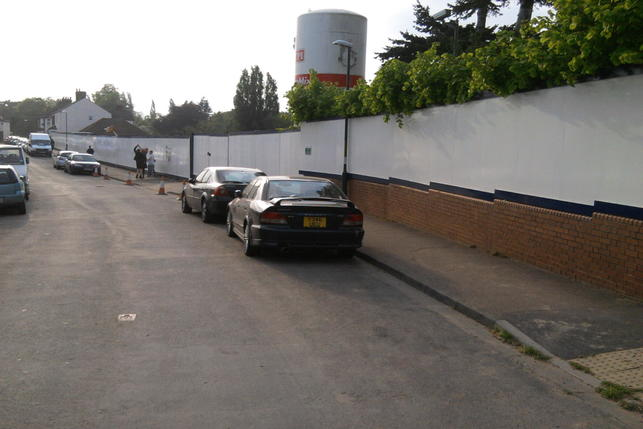
February 2013 below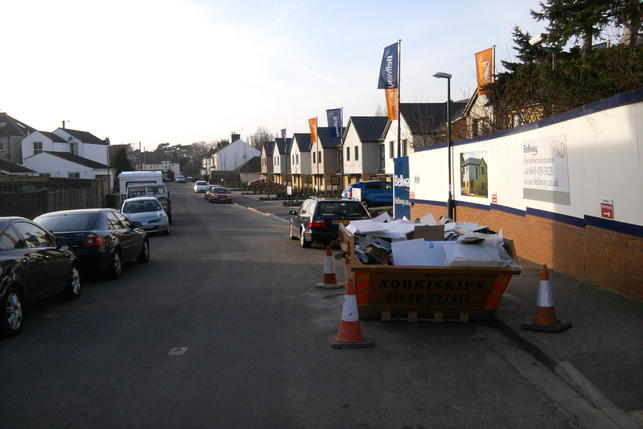
. . . . the foundations go in
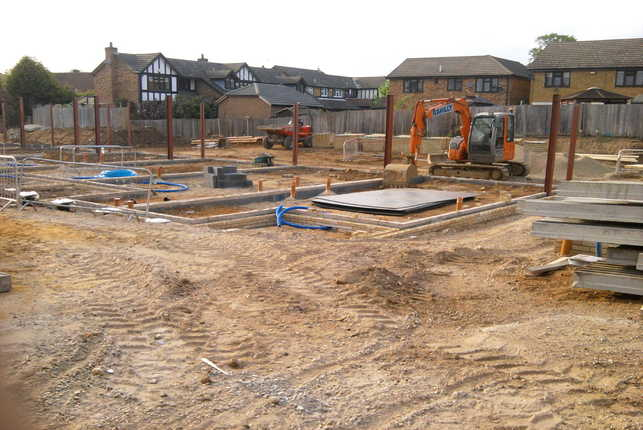
Bexley Hospital photographs
Bexley Hospital really needs to be studied in depth under it's own title. We have not attemptied to do it any justice on this website - so here are a few early photos. We may cover this subject later.
Below - the Nurses home - supplied by Facebook group Bexley Borough The Bygone Years
under construction c1929
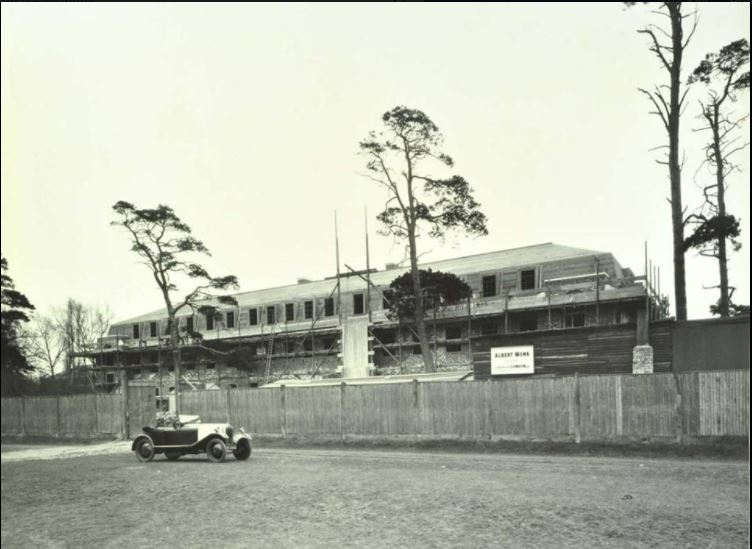
Below - the Nurses home - supplied by Facebook group Bexley Borough The Bygone Years
under construction c1929
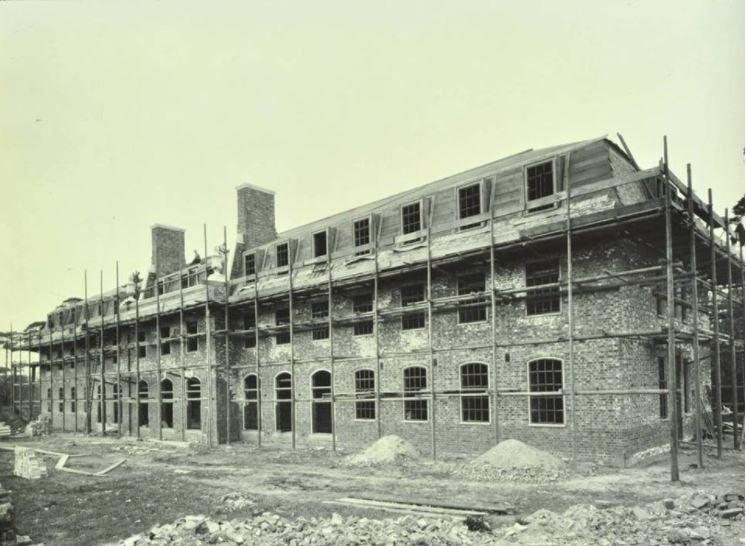
Below - the Nurses home - supplied by Facebook group Bexley Borough The Bygone Years
under construction c1929
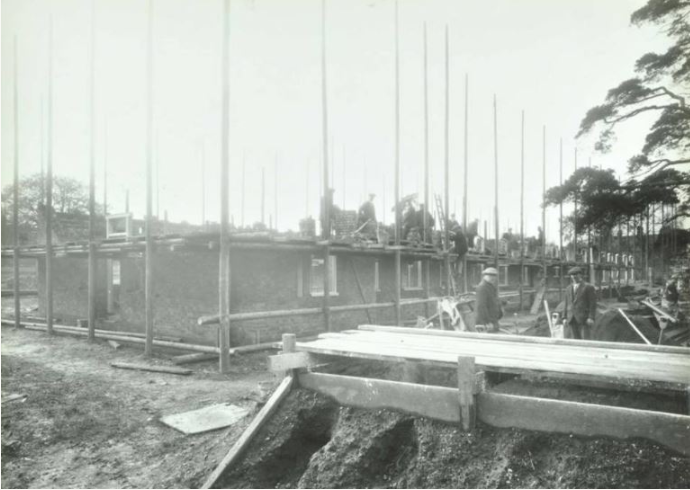
Below - the Nurses home - supplied by Facebook group Bexley Borough The Bygone Years
sitting room c1930
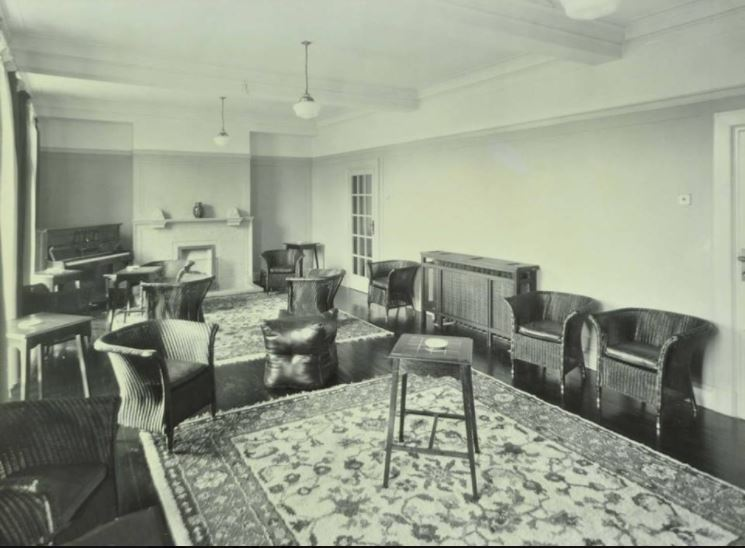
Below - an untitled image found on the internet copyright 'agefotostock' showing a scene near the old chapel and the image below that of a still from an amateur video taken in 2005. Same place. Look at the door and brickwork
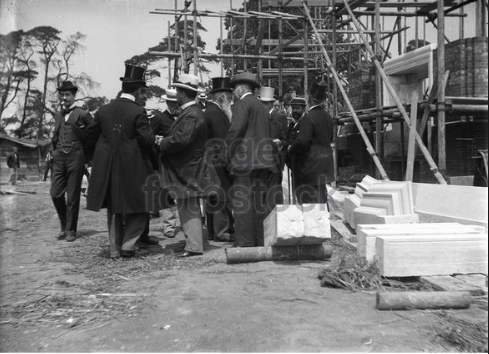
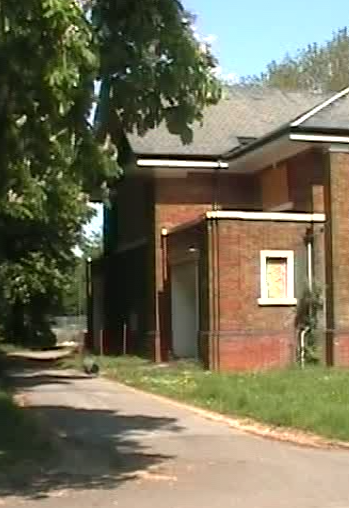
Facing the doors - 2005
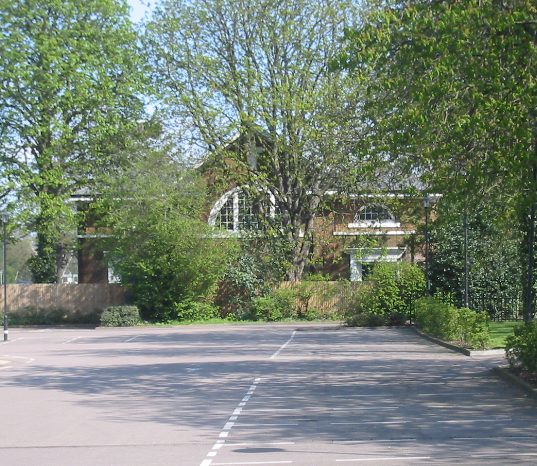
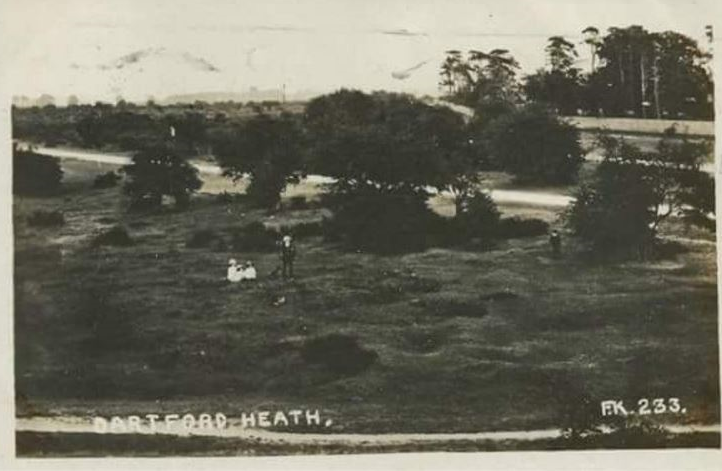
Above - looking towards the Nurses home area from Denton Terrace - undated
Below - towards the Tower from Denton Terrace
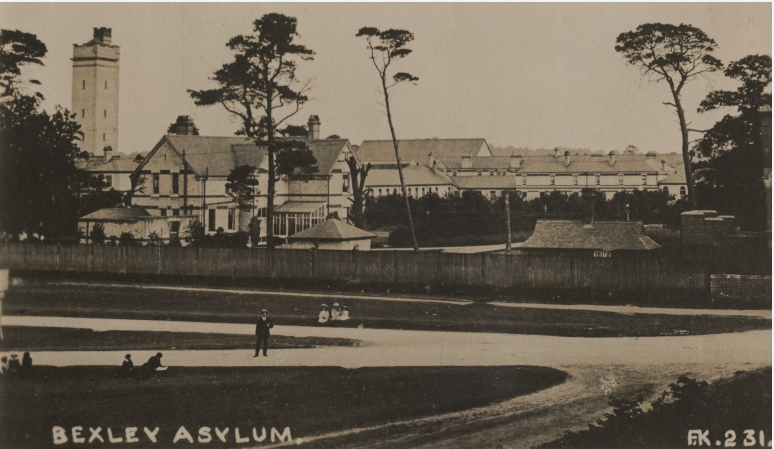
Below- towards the gates from opposite direction
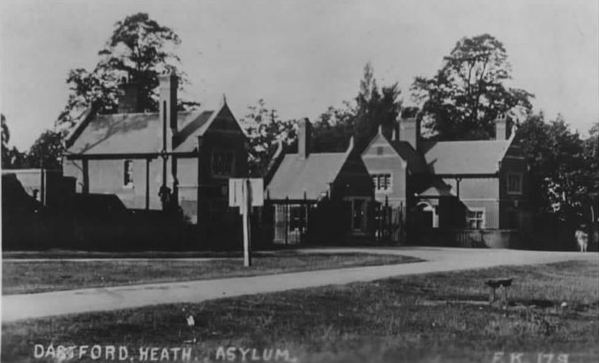
More .....
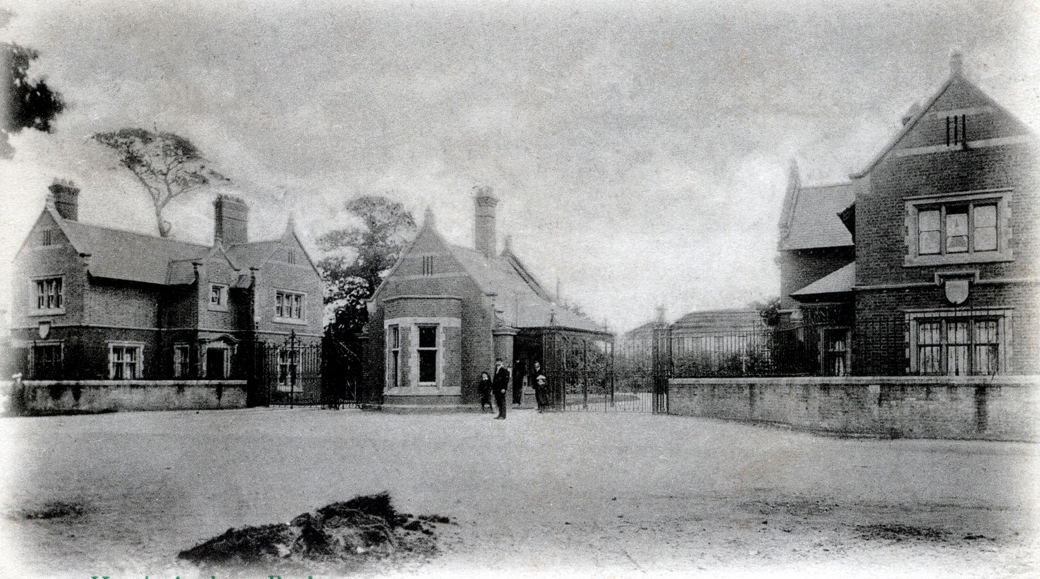
More ...
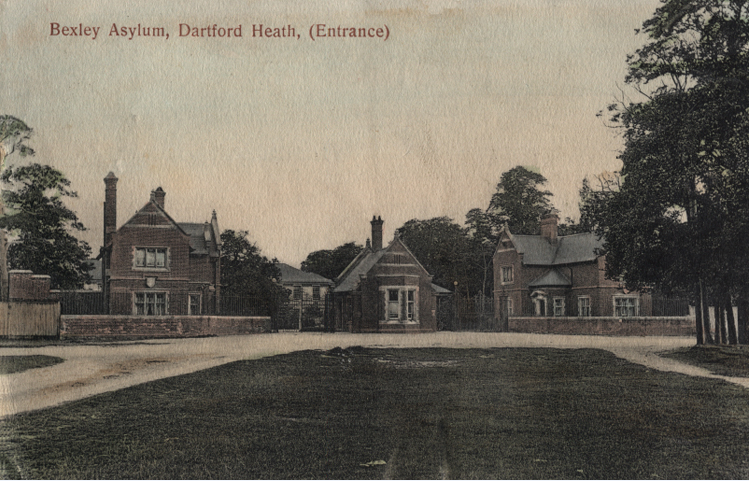
The below images are 'before' and 'after' Bexley Hospital demolished completely to give an idea as to where the 'old' buildings once were . .
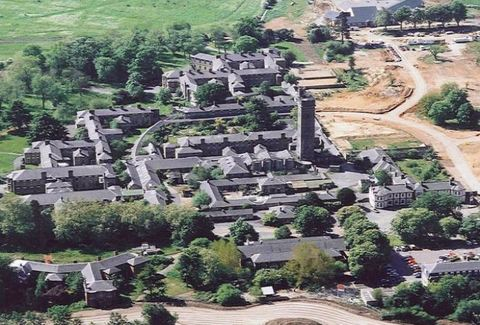
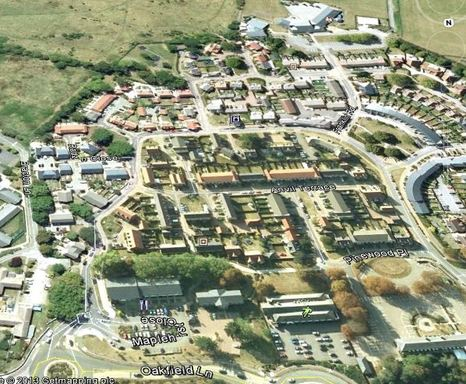
Some of the below have been copied courtesy of Bexley Archives - and we hope we haven't breached any copyright ! Check below link for further information on the area.
Further reading click here for Bexley Hospital
Bexley Local Studies & Archive Centre
............. 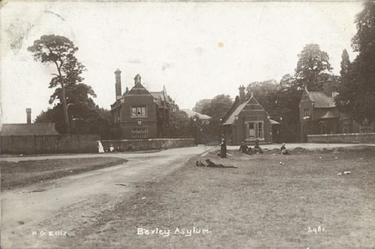 . .
. .
. . . . . . . . . . . . . . . . 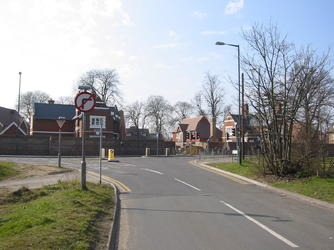
Above the above c 1900 ...................................................................................... Above 2006
Photo's pastimes and places
Below from Sheila HOULTON. The Institute Hut Baldwyns Road . . . . .
Can anyone put names to faces and the year ?
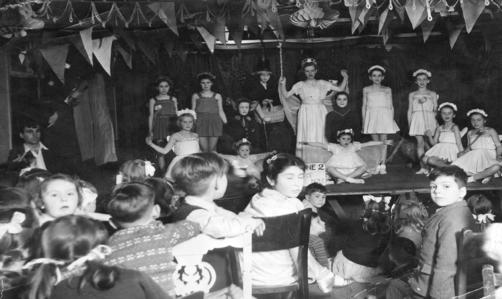
. . . . . below - and another
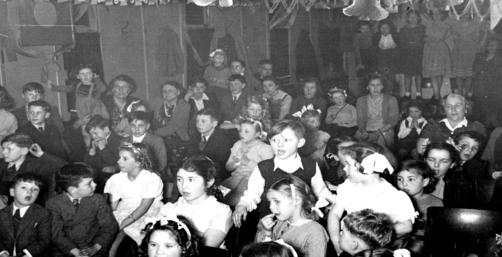
Bexley Hospital outing to Margate 1964 - courtesy of Steven Parker
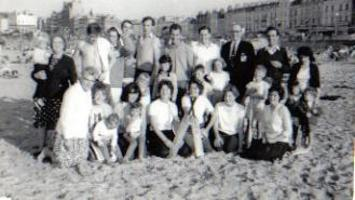
This has shrunk as it has come from New Zealand ! Actually it is only 42kbites so enlargement won't help.
Most of the people in this photo have lived on the Maypole at some time or other.Back row L to R---- Mrs. Barrett Snr. with one of her grandchildren, Jessie Barrett (now in U.S.A.) Ray Wheeler, Louis Cruickshank, ( owned a pub in Eynsford but not now ) Steve Parker,Bill Barrett in shadow, Morris Bridges, lived where Houltons used to live, moved to Leyton Cross. John Borrell, ran the butcher shop down the dip for a while, now in Erith. Bill Proudfoot, Vic Mcdonald, lady on the end ?
Front row L to R--- Lou Proudfoot, two girls with children not sure, Ailene Parker, Joan Mcdonald (nee Barrett ) her daughter Mary standing behind her, Netta Wheeler (nee Cruickshank). behind her my son Neville, girl next to him not sure,Mavis Barrett (nee Proudfoot ) the boy not sure, my wife Valerie, & then ? ?. not bad after 44 yrs. Regards Steve
Below
1953 Coronation Street Party Wansunt Road
Donated by Perran Newman
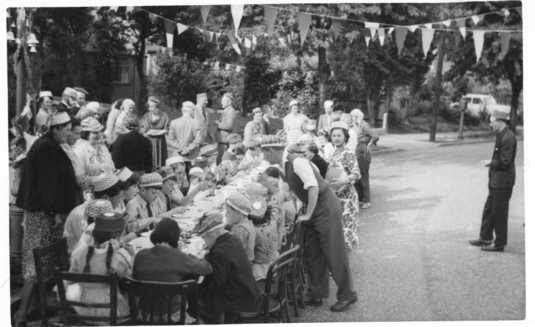
The below two images of a Sunday School outing to Ramsgate / Margate has been kindly donated by Barbara Houlton. Can anyone identify any of the group who were obviously having a good time ? Can anyone identify which year ? Please contact us if you can.
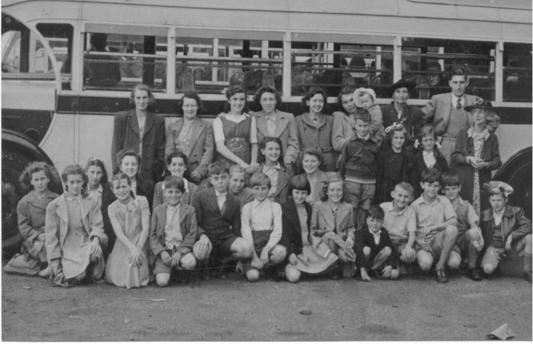
Barbara Houlton (take two housepoints !) remembers the names above and below as -
The photograph which has a sidelong view of the coach is as follows:
Back: Mrs. Stockford, Mrs. Purkiss, Audrey Houlton, Jean Perkins, Mrs. Parker from Beaconsfield Road, lady unknown, lady unknown, gentleman unknown. Lady in front of tall gentleman, Mrs. Whibley (organiser)
Middle row, kneeling: Pat Davies, Joyce Stockford, Sonia Windmill, Betty Cruikshank, Pam Wright, Marion Parker, Jean Peacock, ?Mary Snowdon, Thelma Purkiss.
Front: Pat Flett, Margaret Snowdon, Barry Collins, Derek Bottomley(or March), Stanley Snowdon, Barbara Houlton, Betty Collins, Barry Bedwell, Michael Master, Stephen Parker, ?, Brian Parker (Beaconsfield Road).
The date is either 1947 or 1948.
The picture which has Grundon's Coach face-on is of:
Back: Mr. Beck, Mrs. Houlton, Vera Houlton, ?Barbara May, Mrs. May, Mrs. Proudfoot, Mr. Proudfoot (holding Mavis), Mrs. Flett, Lady unknown, ?Mrs. Collins, Mrs. Challis.
In the middle, behind their respective children, are Mrs. Windmill and Mrs. Beck
Front: David Tucker, Martin Whibley, Angela Whibley, Maureen Whible, Nigel Windmill, Sheila Houlton, Nancy Beck, William Beck, Denise Flett, Edwin Flett, Donald Collins, Norman Challis.
The photograph would have been summer 1946 as my mother was holding Vera's baby daughter Janet, who was born in the previous October, 1945.
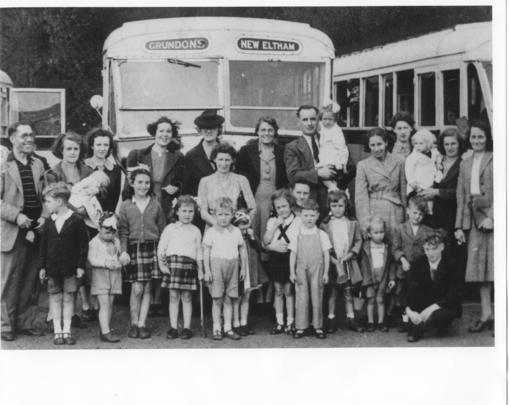
---------------------------------------------------------------------------------------------------------------
Same photo as one above the one above from Steve Parker with names added
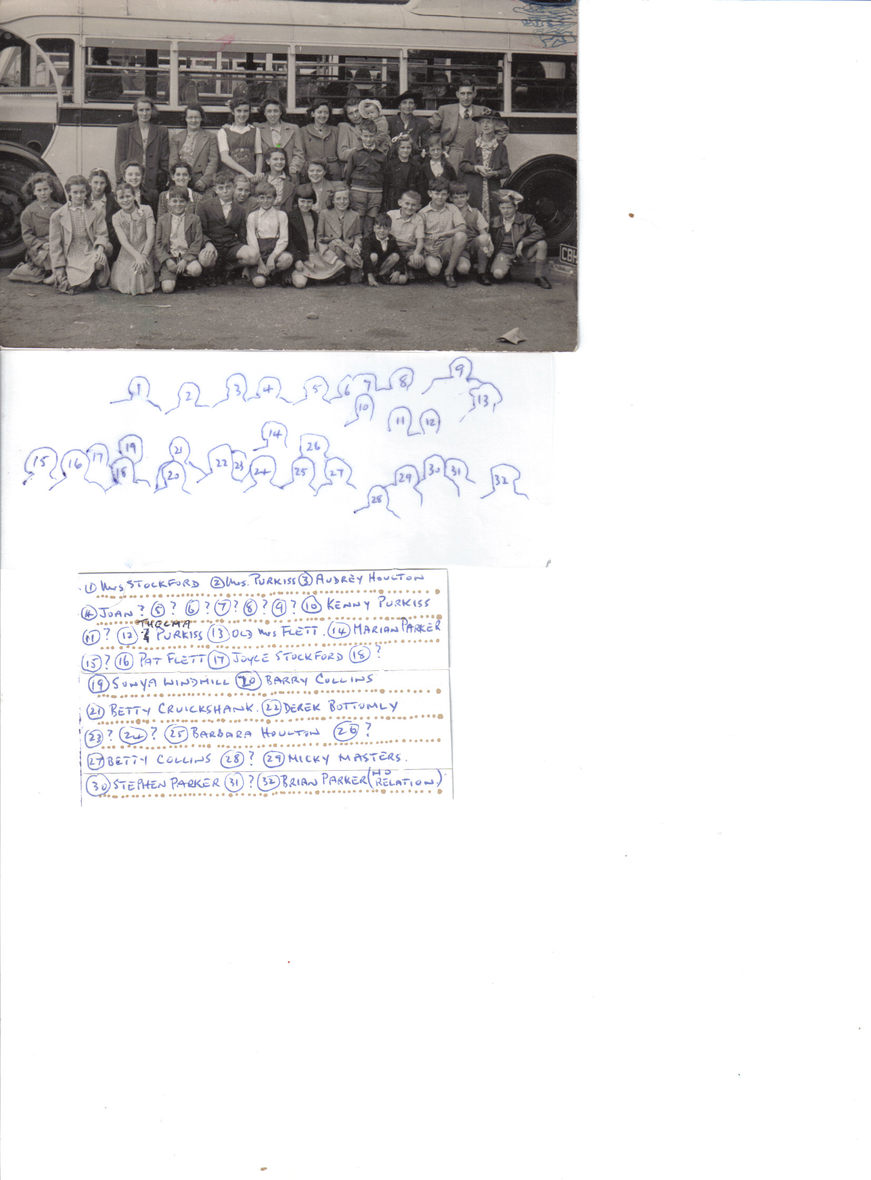
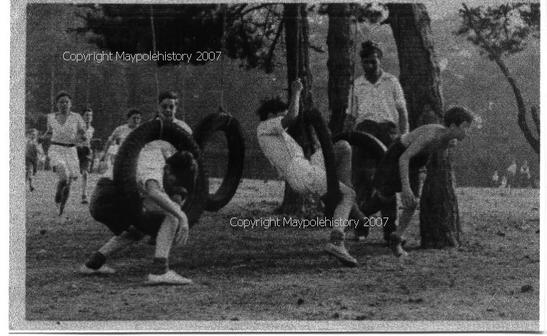
Cross country Broomhills c1955 ?. Believe man standing is 'Buster' from Denton Terrace.
Can you identify any others ?
and as it looks in 2008 . . . . .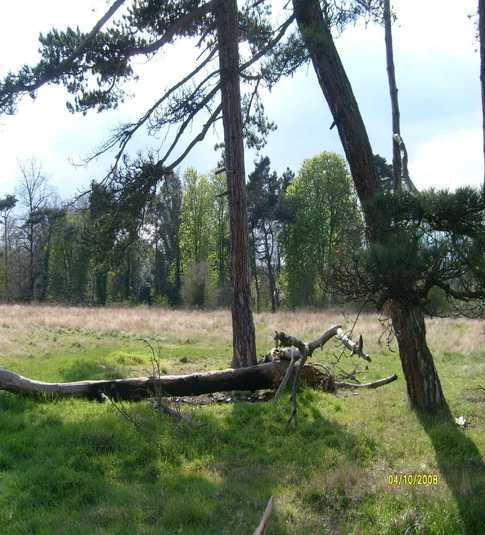
and below as in 2018 . . . . . .
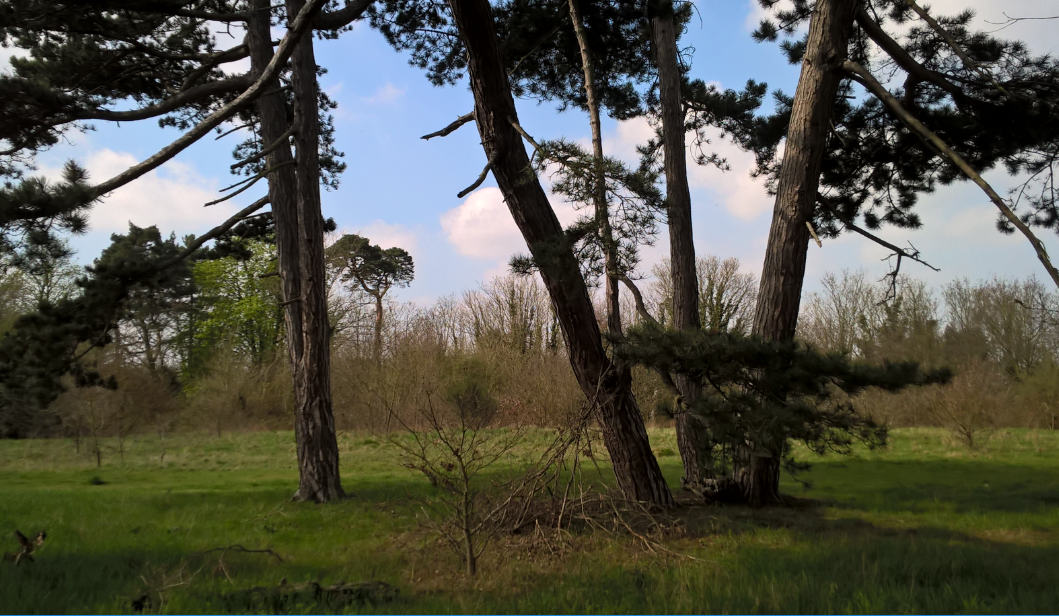
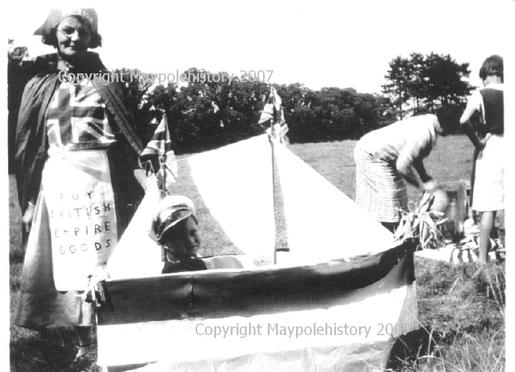
Above - the Fete 1935 in Broomhills
Courtesy of the late Gordon Lennox - he is sitting in the boat.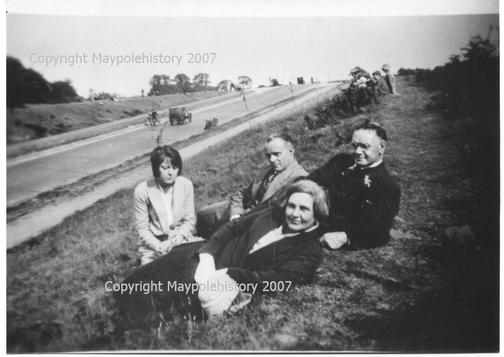
Watching the traffic - a common Sunday pastime - on the Rochester Way junction with Denton Road c1935. Sitting at the back on the right is Mr Edwin BLACKMAN who lived at 12 Denton Terrace (father of Winnie Blackman ) He became Mayor of Dartford in-between the Second World War years. Can anyone identify the make of car in the photograph ?
Image Courtesy of the late Winnie Blackman.
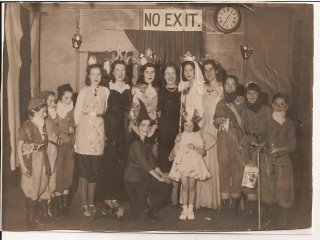
Above
cl947 when we had a pantomime (Snow White and the Seven Dwarfs) at the Institute Hut in Baldwyns Road. It was the highlight of our lives then, and all put together by Joan Houlton. I will list the "actors" right to left.
Nancy Beck, Dorothy Whitehead, Barbara Whithhead, Pat Flett, Sonia Windmill, Audrey Houlton, Joan Houlton, Marion Parker (Stephen NZ sister) Betty Cruickshank, Pat Richardson (me) Barbara Houlton, Janice Scott (dec'd)
FRONT ROW Roberta Cruickshank and Sheila Houlton.
Courtesy of Pat Richardson
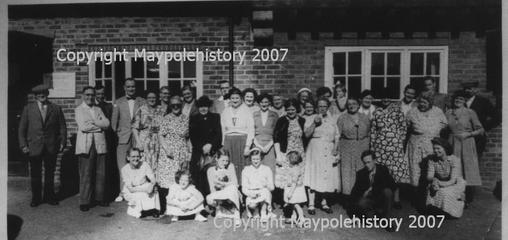
An outing for some residents of the estate c early 1950s ? Can anyone recognize any of the participants ?
Image courtesy of the late Wendy Saunders.
Sheila Houlton can take a housepoint - no - two house points for the below !
Back, L to R. Mr. Beck, Mr. Whitehead, Mr. Proudfoot, Mrs. Proudfoot, Mrs. Proudfoot's sister, Mr. Miles (from shoe shop) Mrs. Barrett, Mrs. Miles, Mrs. Saunders, Mrs. Thornton (holding child) Mrs. Curdling, Can't place the gentleman in open shirt)
Front standing: Mrs. May, don't know the next one, Mrs. Roberts (in coat and hat) Mrs. Colegate, Mrs. Colegate's daughter, Mrs. Lott, Mrs. Perkis, Mrs. Turner, Mrs. Winscombe, ?Mrs. Stokes or Mrs. Blackman. Can't see to end of row.
Front, crouching: Mrs. Whitehead, Christine Miles, Mavis Proudfoot, Evelyn Lott, unknown small child but could be Jeannie Parker?, Derek Lott.
This is from a print-out of the photograph I was sent by Evelyn a couple of years ago. I will need to go back into the website to look at the photo and see if I can make out who is at the end and I will show it to my brother, Dennis, who may indeed know the ones I can't remember.
Hope this is helpful and if I have guessed wrongly, I hope someone else can correct?
Regards,
Sheila (Houlton)
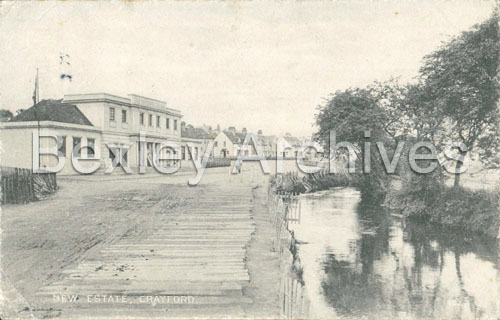
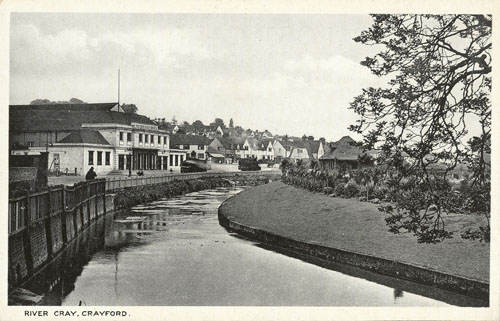
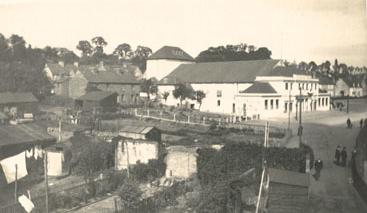
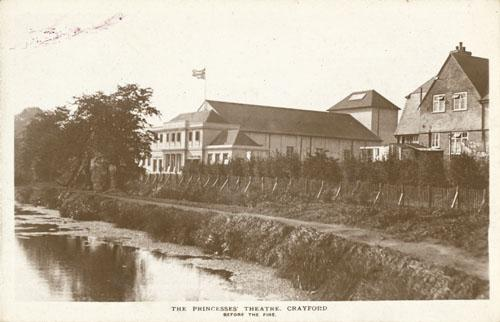
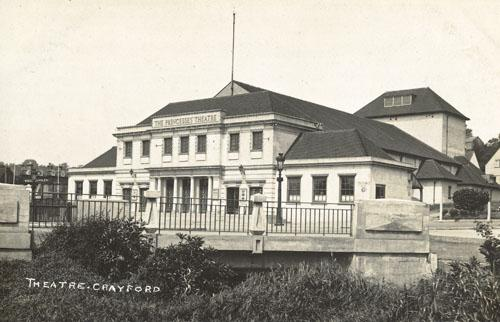
Above Princess' Cinema / Theatre Crayford - courtesy of Bexley Archive who have the copyright.
Date 1916 Description The Princesses Theatre by the Waterside at Crayford. Just beyond the theatre is the beginning of Crayford Way. The Princesses Theatre was built by Vickers but in 1921 it was leased by Sidney Bacon to become a cinema with occasional music hall artistes appearing there. Correspondence and stamp on reverse of postcard.
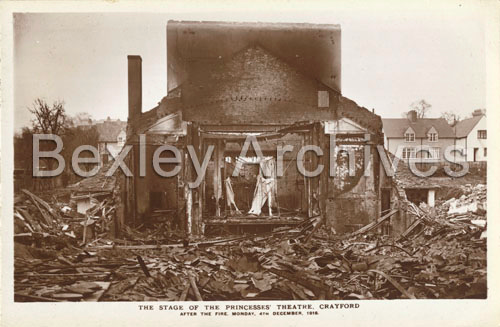
After the fire 1916
courtesy of the Bexley Archive who own the copyright
The Princesses Theatre after the fire on 4 December 1916. Only the entrance hall and stage areas survived. The ornate auditorium was completely destroyed. The theatre was subsequently rebuilt and reopened in 1919.
Photo's Transport of bygone years
The AFS fire engine. It was housed on land belonging to the Institute Hut and heath End Road between the wars.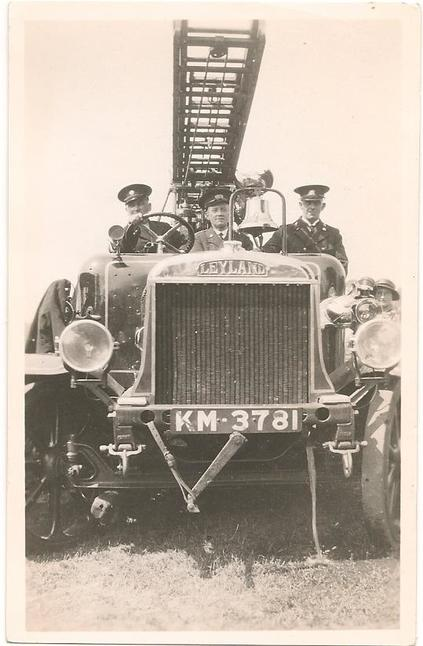
Below photo of the Railway Station courtesy of Dartford Borough Museum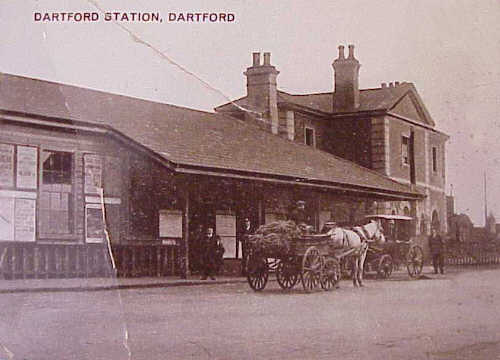
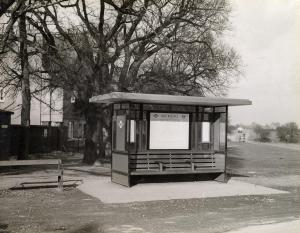
No, this is not transport - it is where transport stopped outside Maypole School in 1935
Courtesy of London Transport Museum
Below to the left - trolley bus c 1950s and to the right RT c 1970s - both in Market St, Dartford

Below the trolley buses which ran from Dartford to Woolwich - taken Broadway Bexleyheath c1950s
(Courtesy Bexley Archive)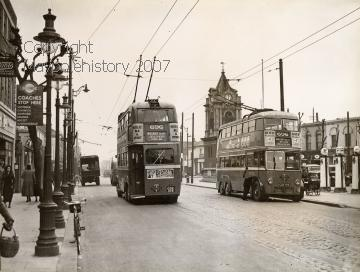
Before everyone had several phones. The sometimes 'dreaded' GPO Telegram motorcycle - occasional good news but mainly bad. Courtesy of Alan Oaten from the facebook group 'Dartford Remembered'.
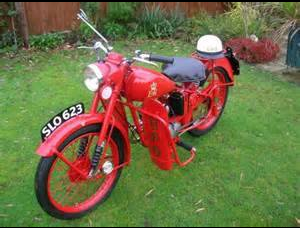
Just for fun . . . . Kim Button (Maypoleman) in his 1946 Anglia racing - ever so slowly - along the lanes of Eynsford 17.2.08
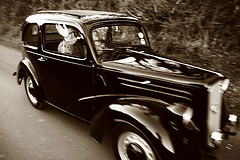
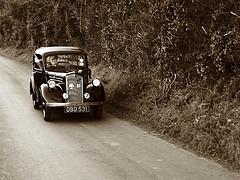
Steam Train Bexley Station c 1910 taken from Bexley Archives website - they have copyright
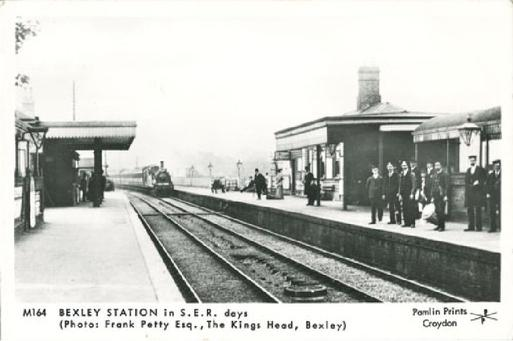
Below the 401 Bus - plying the route c1940s-1970s
Image taken Farningham courtesy of Ians Bus Stop
http://freespace.virgin.net/ian.smith/buses/index.htm#stop
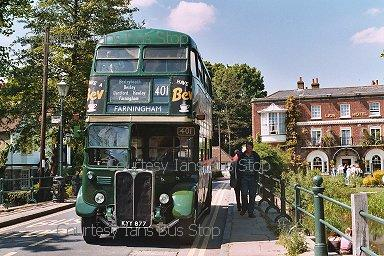
Below (possibly mother of Wendy Saunders on motorcycle combination) - in rear alley of Baldwyns Road c1920s
Courtesy of Wendy Saunders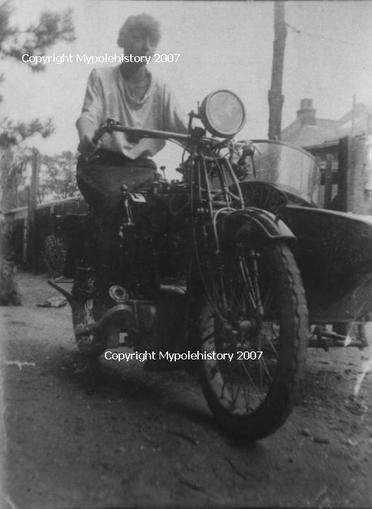
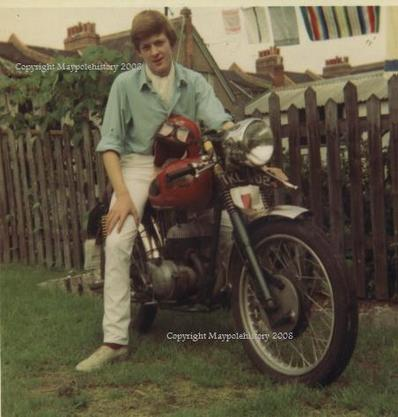
Above 'Wally of the week' Maypoleman on his Excelsior 250cc Talisman Summer 1968
Below what an Excelsior Talisman should have looked like prior to being butchered
Below 'Poser' Perran Newman on his 'lookalike' Goldstar mid 1960s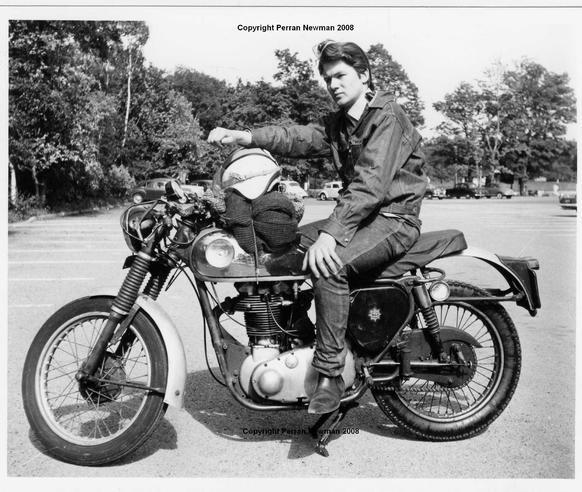
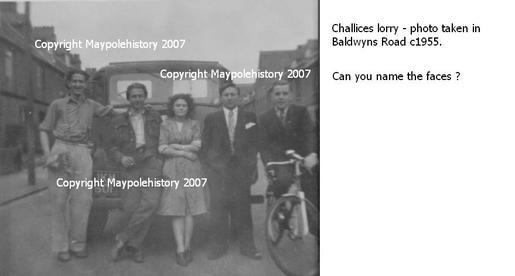
Above
From Sheila Lusher nee Houlton - she suspects the above culprits to be
"We concluded that the chap on the bike is David Cruikshank. Left to right, we think they are: Ernie Gosling, Mosie Challice, Rose Challice (wife), Jackie Challice and David C. I am happy to be corrected by another reader, as this input is from my brother, although he seems very certain. Not many of 'em left, I don't suppose?
Had a lovely afternoon, reminiscing with Den".
Regards,
Sheila (16th. December 2007)
----------------------------------------------------------------------------------------
Below type of fire engines from the Kent Fire Brigade attending heath fires c 50s/60s
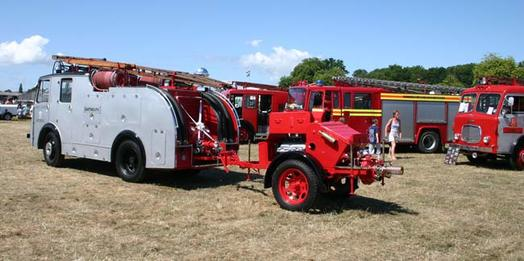
Photo's - random persons
Below - photo of William Smith standing in the grounds that later became the Rolex Car Park and now under a rear garden in new housing.
(Heath End Road junction with Denton Road) 1940s looking towards the direction of The Dell and Crayford. It was on land just left of Owen Gemmell in the picture immediately below.
William Smith is the son of the William Smith who lived at the bottom of Beaconsfield Road junction with Heath End Road and kept donkeys

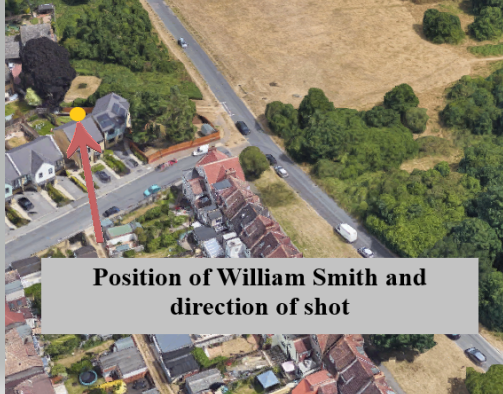
Below - Heathend Road c1964 - unmade and a glorious puddle every time it rained !
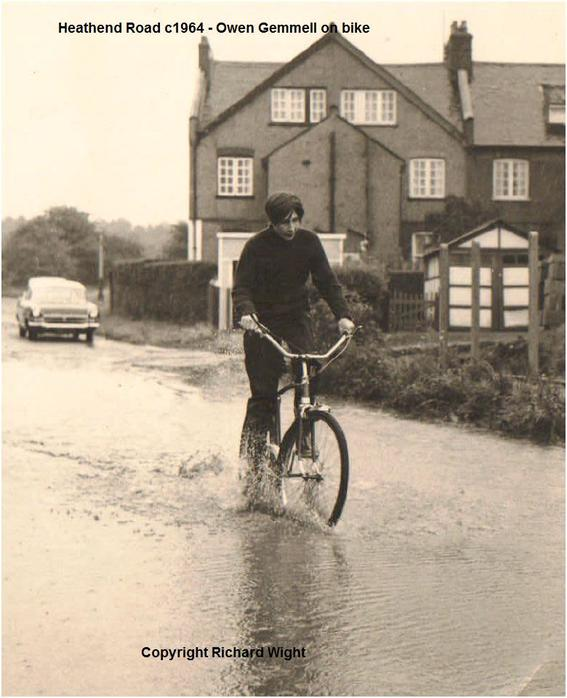
and then another shot of the same location about 10 years later
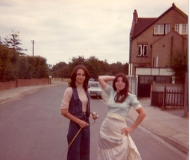
The eight immediately below donated by Clare FITZSIMONS nee MORAND
Below was taken in 1964 in Beaconsfield Road; in the picture is Jeffery Raine, Clare Morand
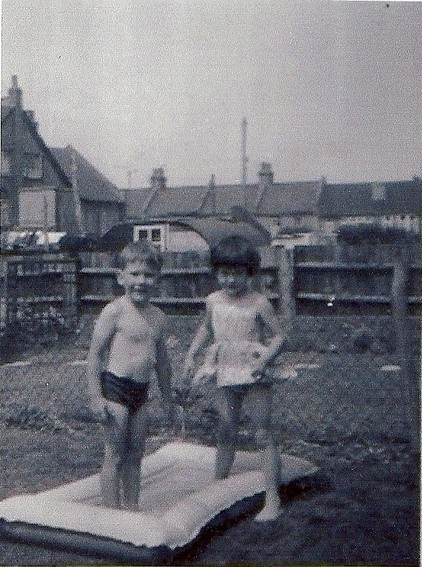
Below was taken in 1967 in Beaconsfield Road, in the back garden, in the picture is Michael, Valerie, Clare Morand
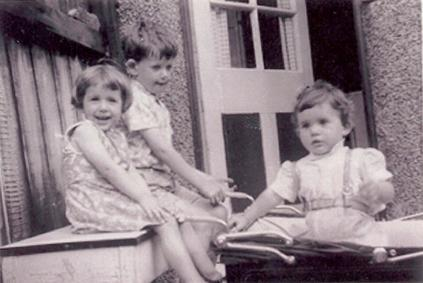
Below three show Julie Smith and Elizabeth Blackman Heathend Road
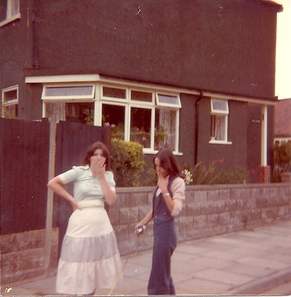
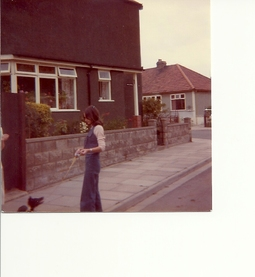
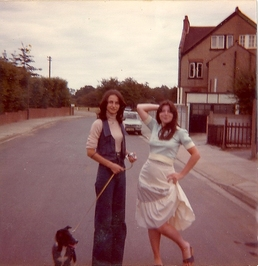
Below picture was taken in 1976 in Beaconsfield Road, Maypole Estate of Valerie Morand from the right, next Clare Morand then Julie Humphreys and then Janet Humphreys on the left, going on a night out on the town looking for good looking boys Joke?
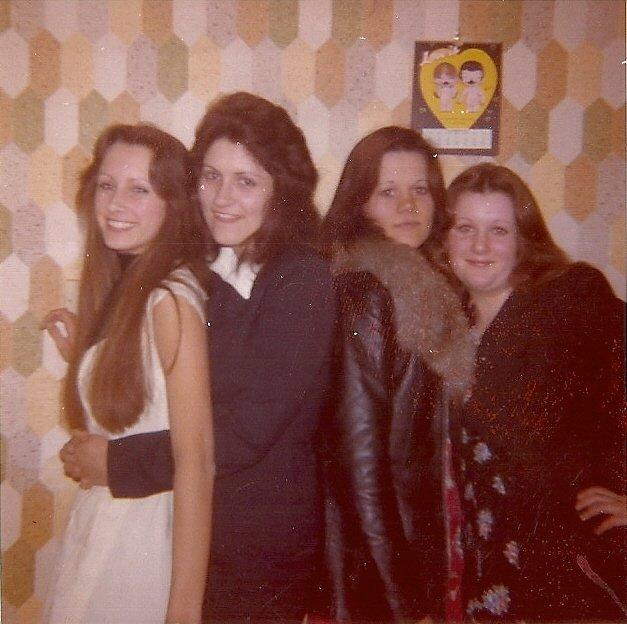
Below
1st Picture - the late Michael Morand with Clare, Valerie Morand on the Maypole Heath
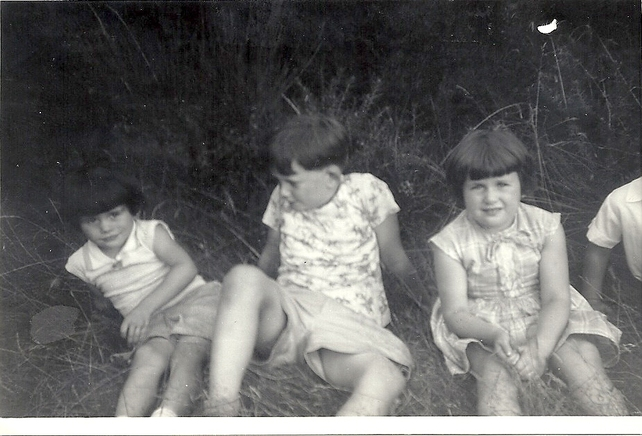
2nd Picture (c1961) Julie Smith, Ronnie Gosling, the late Michael Morand, Clare Morand, Valerie Morand, Jeffery Raine, with Ronnie’s Guinea pigs back drop are the rear of the houses in Baldwyns Road - children in garden of Beaconsfield Road - probably Clares garden.
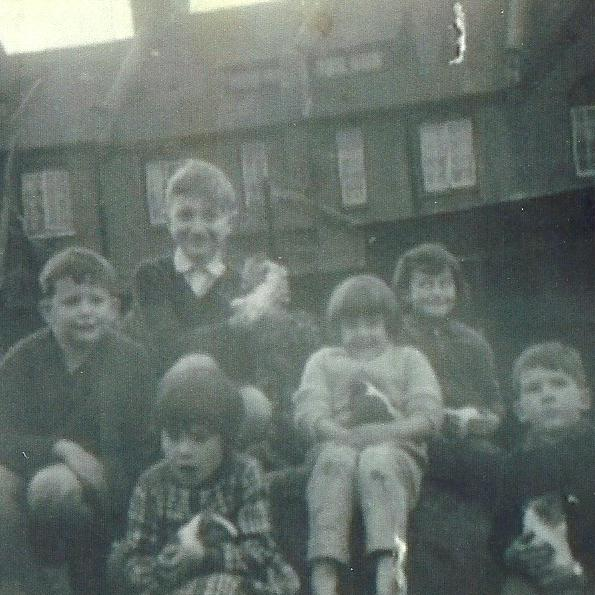
The below (donated by William Beck) was taken around 1953/54.
From left to right: don't know, Nancy Beck, Denise Flett, Edwin Flett.
Nancy dressed in mother's silk dressing gown with chrysanthemums in her hair, Denise wearing a pillow-case labeled 'Lavender bag'
and Edwin, with the best available sign of: Good old Maypole ~ nothing changes, we are still celebrating, Good old Maypole.
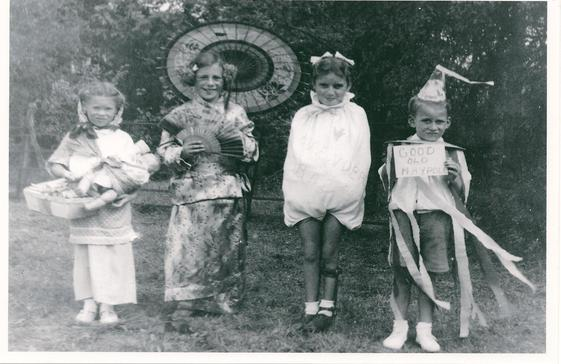
Hi Kim,
Have been looking through the updates and seen the picture sent in by Will Beck, the unknown girl is my neice Carole Smith.
Four little girls in carnival dress. I really enjoyed the reunion on the heath and look forward to the next one.
The history of the Maypole is so interesting and very special to all of the "old timers" Thank you.
Best wishes, Pat Page nee Davies
Below photo (courtesy of 'William') showing the Institute Hut, Baldwyns Road - 1922.
Info from Nancy Beck re below photo dated 26th May 2013
"Lovely to speak to you having had splendid hour or two searching the maypole. Photo dated 1922 greetings from WM LEONARD does show my grandparents & my mum. Vera Nancy Saunders is seated centre front long hair over each shoulder. Her parents Jimmy & Annie at the right end of the second row standing. Grandmother with granddad's head behind her left shoulder. She died in this1932 & he in1972".

Below - William and Nancy Beck in uniforms at the Baptist Church. Nancy Beck appears in photos of the latest 2011 Reunion
Below - info from Nancy Beck dated 26th May 2013, "My brother & I were members of thee THE BOYS BRIGADE & What is now called THE GIRLS BRIGADE formerly The Girls Life Brigade".
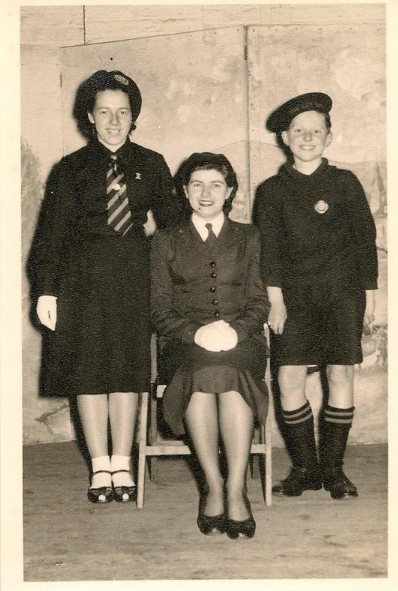
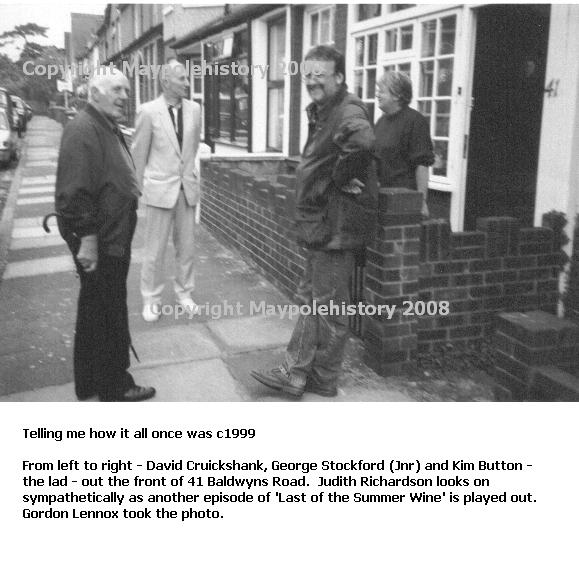
Above - we are informed that, sadly, Gordon Lennox and George Stockford (Jnr) are now deceased.
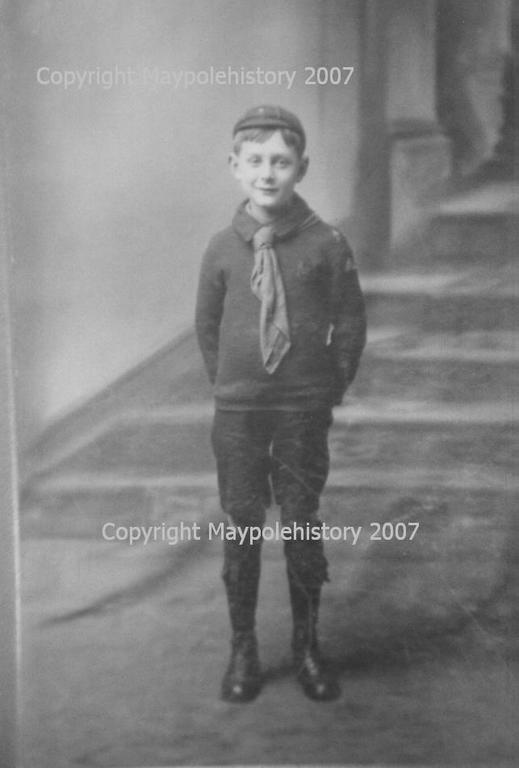
Above - the late Jack Roome c 1922 in Scout outfit
Image courtesy of the late Kitty Roome
Below - Jack's sister - the late Kitty Roome (undated) in Maypole School playground - note that Beaconsfield Road ended before the later bungalows had been built. Kitty was a local historian.
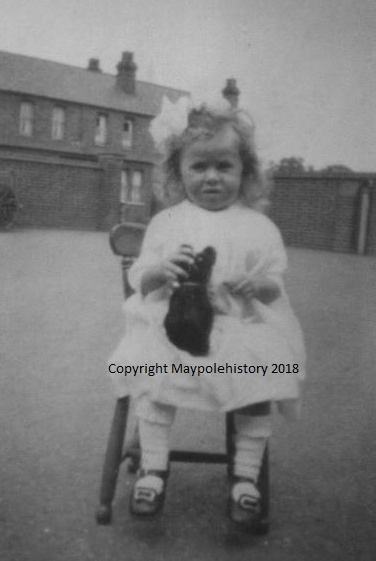
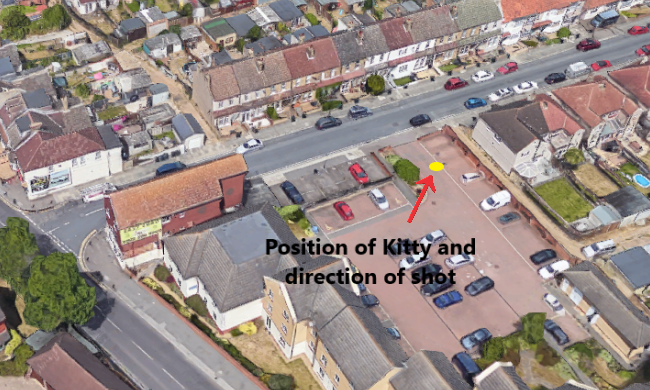
Below, another of the late Kitty Roome (sister of Jack) in Dartford Girls Grammar school uniform c 1920s - first day at school - doesn't she look proud ! Taken in rear garden of 16 Denton Terrace and in background looking towards what was the Rolex and Maypole House property (the Daisy Meadow occupied land upon which the Rolex factory had been built c1959 and where is now the site of a row of houses)

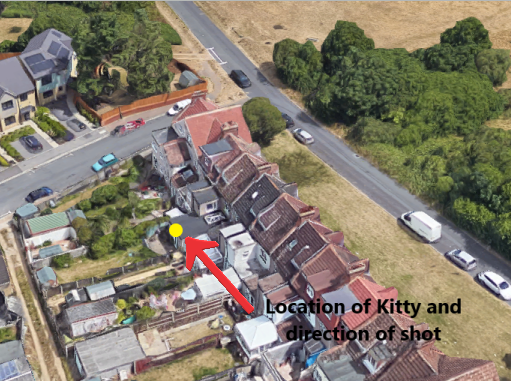
Below is her father - image courtesy Bexley Archives
Title John H E Roome, R.F.R Date c.1900 Description John Hector Edward Roome, father of Miss Kitty Roome, local Bexley historian. Her father first joined the Royal Navy in 1896. He later became a Painter and Decorator at Bexley Hospital. He was born at Sidcup in August 1880 and died in Bexley in December 1945.
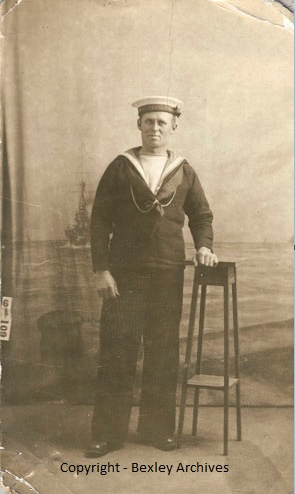
Below - the late Frank Blackman (Son of Edwin and brother of Winnie) c 1930 in his rear garden in Denton Terrace - near location and same aspect as Kitty above, wearing a Seascout uniform ? - rear towards 'The Daisy Meadow'. This meadow was the local name given to land where, latterly, Rolex watch factory was built. This is now demolished to make way for new houses.
Courtesy of the late Winnie Blackman
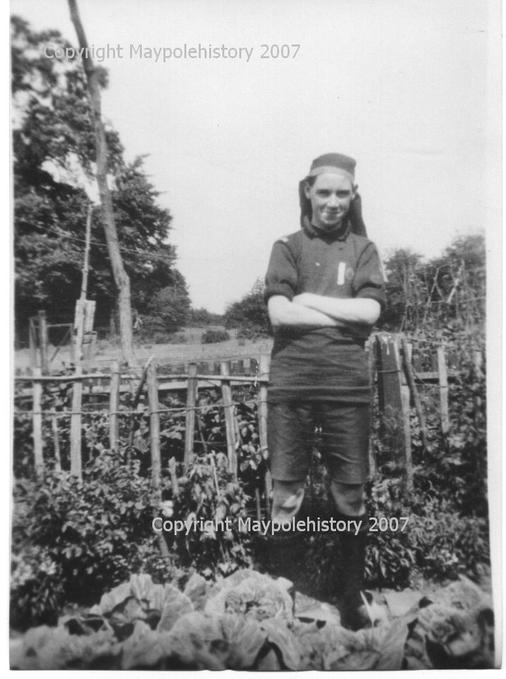
Below - the late Gordon Lennox wearing the Cameron 'Tartan' Scout uniform c early 1940s ? This special scarf was authorised by the Scouting Movement at the request of Mr Cameron of Broomhills.
Courtesy of Gordon Lennox
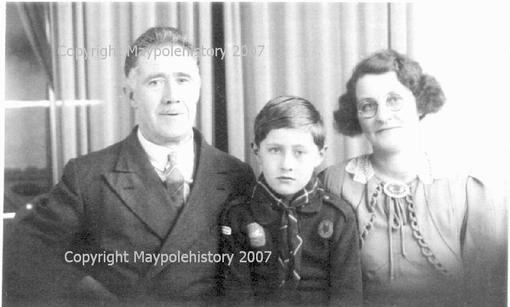
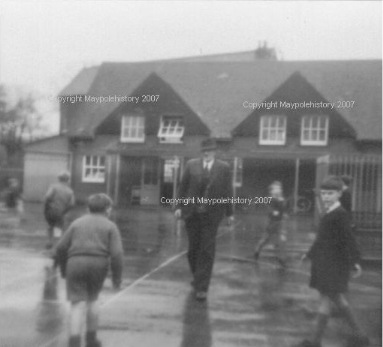
Above - the late George Stockford (Snr) sometimes referred to as STOTFORD - Caretaker c1960-1965 Maypole School
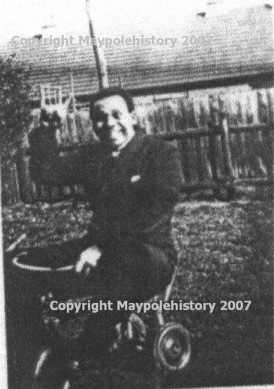
Above - the late Charlie Lawrence - a black boy - (born 28/4/1919) taken in rear garden of George Stockford's house in Baldwyns Road c1937. He was a pupil at Maypole School. The school register shows he started school on 24th March 1924. Has been described by the late George Stockford (Jnr) as a great friend and convivial boy. He lived at 14 Ivy Villas (Next to the Post Office) with his widowed mother. Her husband was killed in WWI when HMS Hogue was sunk by the Germans (20/09/1914).
Archives from the HMS Hogue Roll of Honour - LAWRENCE, Leading Stoker, WILLIAM, 297574. (RFR/CH/B/9794). Royal Navy. . Age 31. Son of John Lawrence; husband of Elizabeth Lawrence, of 14, Ivy Villas, Maypole Estate, Bexley, Kent.
During WWII it was believed that Charlie joined the RAF. Records now show he was a soldier in the Queens Own Royal West Kent Regiment.
Below photograph supplied by Dr. Mike Still, curator of the Dartford Museum
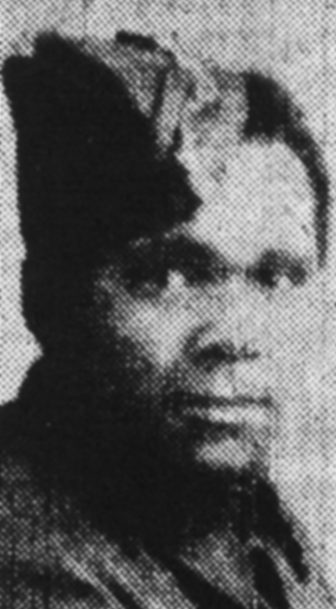
Dr Still has discovered the death registration online (on Ancestry). He indicates:-
The registrar of the local town seems to have insisted on registering every death at the local prisoner of war camp as if the inmates were local residents! Even though the camp was local, the registrar’s information was supplied from Berlin so we can’t know how true it is, but the cause of death is given as jaundice, so presumably Charlie had contracted hepatitis.
A woman with the same maiden name is certainly on his birth certificate but his adoptive mother may just have been pretending to the registrar that she was the birth mother when Charlie’s birth was registered in Strood (although he is said to have been born in Gravesend). Alternatively, the maiden name may even have referred correctly to a sister of hers, whose illegitimate child she then adopted. Further research is needed on this point to obtain a first name to go with the maiden name.
Charlie also found out that his mother died in early 1940 and he then moved out of 14 Ivy Villas and in with the Stockford family at 48 Baldwyn’s Road, shortly before heading off for France with the Army.
Below is record from Military Records
Death Date:Number:Birth Place:Residence:Regiment at Enlistment:Branch at Enlistment:Theatre of War:Regiment at Death:Branch at Death:
| Private |
| 2 Nov 1941 |
| 6346102 |
| Kent |
| Kent |
| 7th Battalion Queen's Own Royal West Kent Regiment |
| Infantry |
| Western Europe Campaign, 1944/45 |
| 7th Battalion Queen's Own Royal West Kent Regiment |
| Infantry |
When he became a German POW. George Stockford (Jnr) proudly remembered collecting food for red cross parcels for him. After all, his dear mate was safe. Not for long.In November 1941 Charlie died. There were two stories floating around as to his death 1) he was shot - we are told whilst trying to escape - that was the usual reason, wasn't it - mmmmmm ? and 2) died of pneumonia after being worked down salt mines. Either way, we suppose this was nothing to do with his colour ? The rumours about his death are in conflict with Dr. Stills entry - the official cause of death.
He is buried in Poland. Two generations lost to enemy fire.
Mentioned on the Commomwealth War Graves Commission - see below - the Poznan Old Garrison Cemetery is where the remains of the 50 Prisoners of War who were shot after the 'Great Escape' by the Germans now lie.
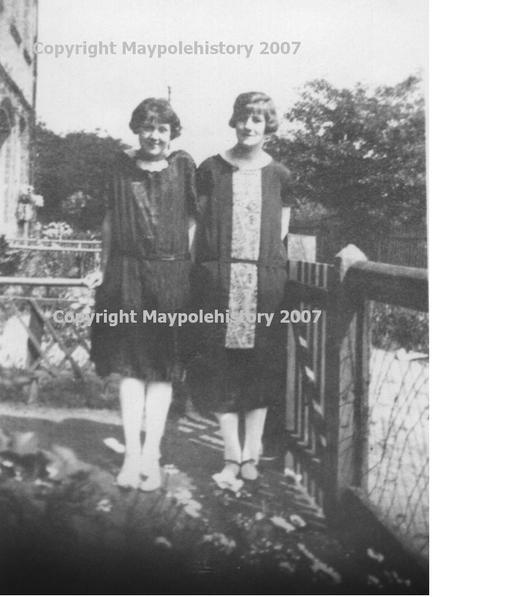
Above . . . . .
All dressed up and nowhere to go . . . . .
Happier times - Alice Blackman (Sister of Winne and Frank and daughter of Edwin) and friend outside front of 12 Denton Terrace c 1920s
Courtesy of the late Winnie Blackman
. . . . and duplicated from the transport page below is Challices greengrocers lorry
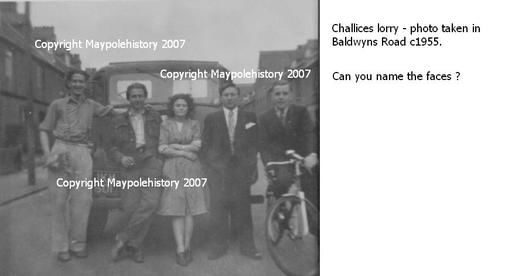
Above
From Sheila Lusher nee Houlton - she suspects the above culprits to be
"We concluded that the chap on the bike is David Cruikshank. (He appears in photo above, some 60 years on !) Left to right, we think they are: Ernie Gosling, Mosie Challice, Rose Challice (wife), Jackie Challice and David C. I am happy to be corrected by another reader, as this input is from my brother, although he seems very certain. Not many of 'em left, I don't suppose?
Had a lovely afternoon, reminiscing with Den".
Regards,
Sheila (16th. December 2007)
----------------------------------------------------------------------------------------
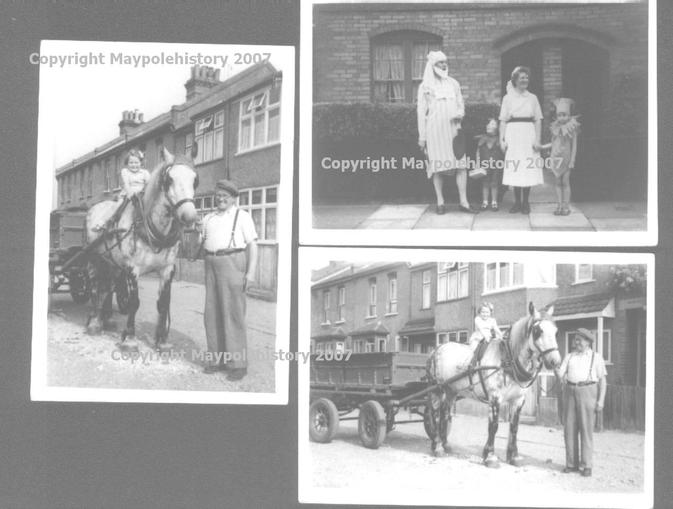
I'm the strawberry holding Mrs Potter's hand looking up at the man who later became my father in law. Also I am the girl on Mr Popes horse..I was three at the time. Lesley Smith nee Williams
Above - and for the special memories of Sheila Lusher - Mr Pope and his horse, Heath End Road. We thought it was beaconsfield Road but Steve Parker put us right ! The other photo is of Mr Smith - Penny Smiths dad in Fancy Dress in Baldwyns Road, for one of the procession 1950s. Standing next to him is Mrs Potter - already featured in another photograph of the same procession.
Photo courtesy of Penny Smith
---------------------------------------------------------------------------------------------------------
Below (Courtesy of Steve Parker) - Bill & Lou Proudfoot having just received trophies for indoor sports, Bexley Hosp. Sports & Social Club, mid 1970s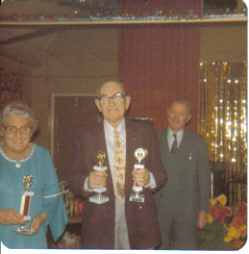
Below left to right - the late David Richardson (West Lodge, Bexley Hospital) Alan MacLean (East Lodge, Bexley Hospital) and Kim Button - see photo of him in one of the above images 'Telling me how it all once was c1999' taken some 30 years on. Photo taken in rear garden of 2 Beaconsfield Road 1967. Army surplus was all the rage then. Fashion was nowhere to be seen !
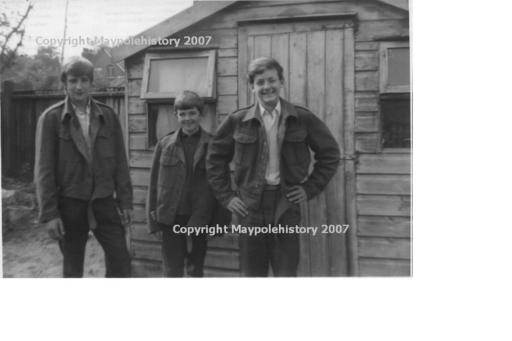
Photo's the journey from Bexley village
Most of the below 'old' images are from the Bexley Archive and the copyright belongs to them.
Notes from Audrey HUGHES nee JACKSON
Bexley Local Studies & Archive Centre
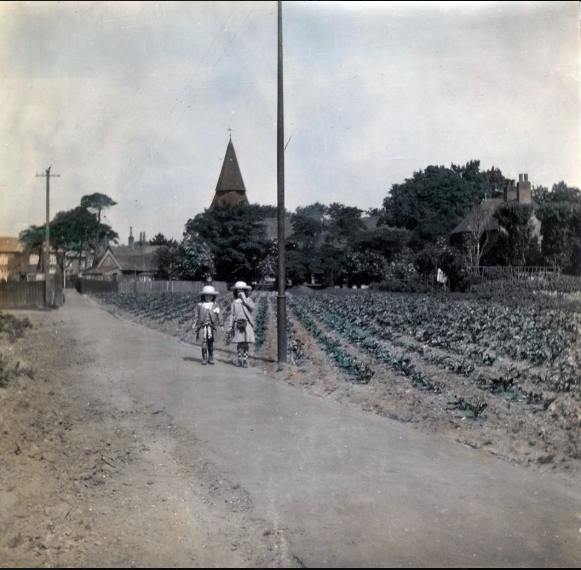
Above courtesy of Peter Austin - Facebook group Crayford, Bexleyheath and Surrounding areas
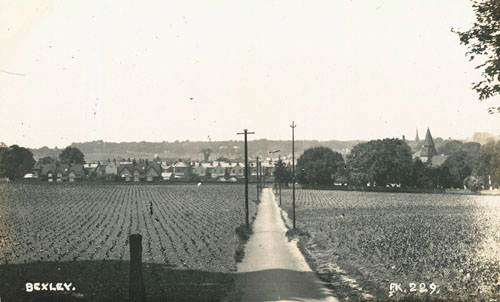
Above - the path from Wansunt / St Marys Roads towards Bexley Village
below as it looked c 1994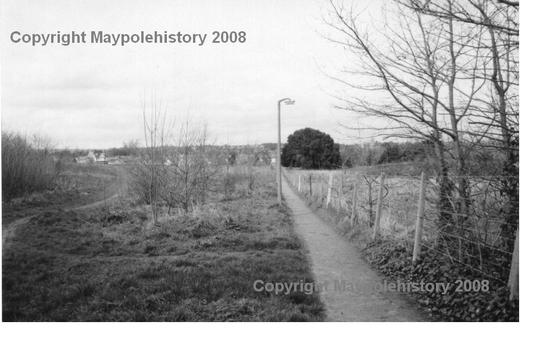
and how it looks today . . . . . .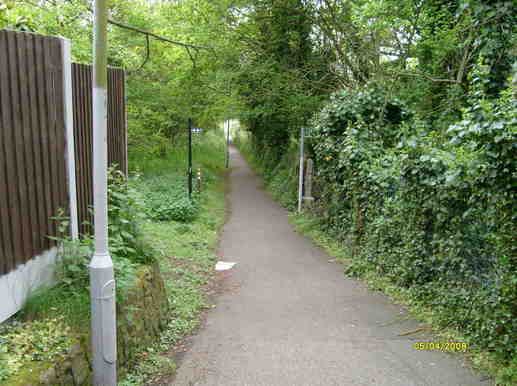
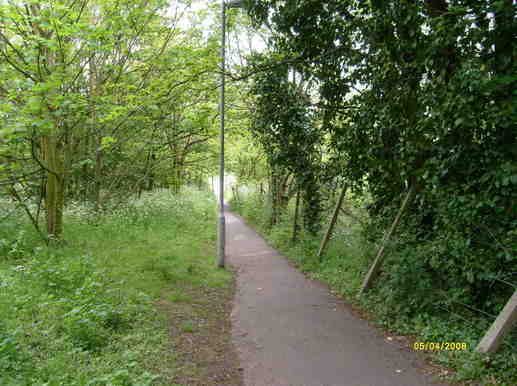
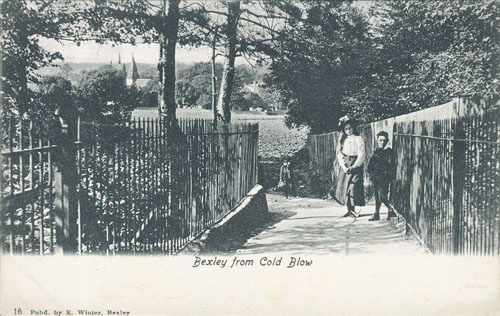
Above - the path from St Marys Road where it joined the path from Wansunt Road - looking towards Bexley. This has been known as 'The Snicket' (Perran Newman) and the 'Chicken Run' (Local name c 1950s)
and how it looks today . . . . . . .
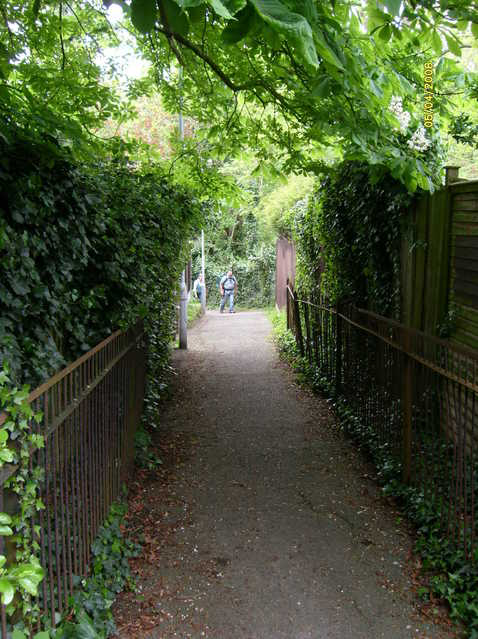
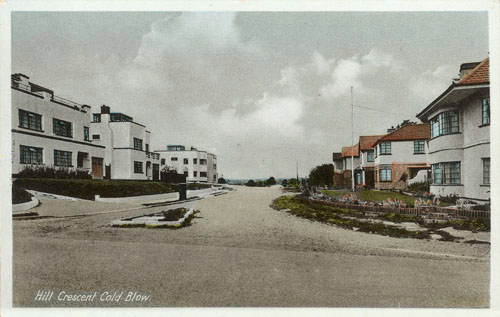
Above - Date c.1936 Description Hill Crescent is at the top of Vicarage Road, Bexley where it meets the Dartford Road
Below - Dartford Road c1900 junction with St Marys and Wansunt. We are informed that the odd looking construction to the left was to do with gas regulation and was a type of 'sub station / valve'.
Also, enlarging the new Wansunt / St Marys development sign doesn't really make the content any clearer - sadly.
and below c1994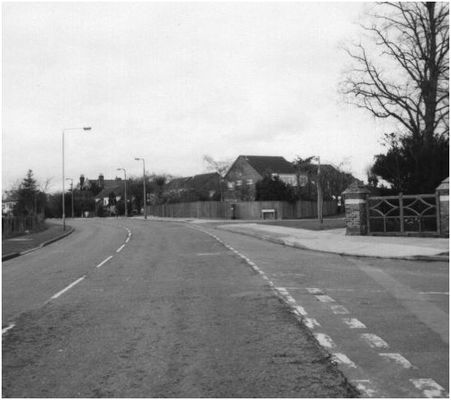
and below May 2010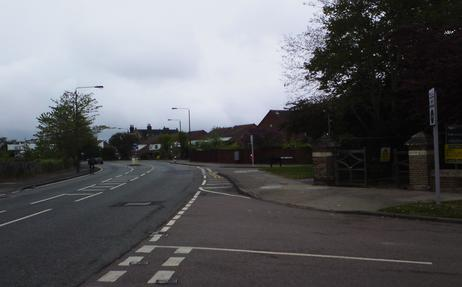
Below c1906
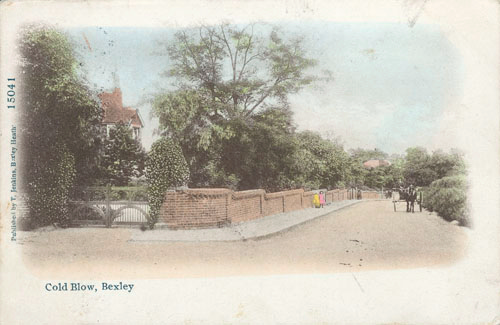
Above - Date 1906 Description Dartford Road, Bexley. 'Mount Eagle' behind the gates ? The area is known as Cold Blow. The view is taken from Wansunt Road (immediately on the left) looking along Dartford Road towards Baldwyns and Dartford Mental Hospital. Children and pony and trap in the road. Correspondence and stamp on reverse of coloured copy postcard. The wall facing the road in the above is the same wall as seen in the below two pictures.
Below how it looked c 1994
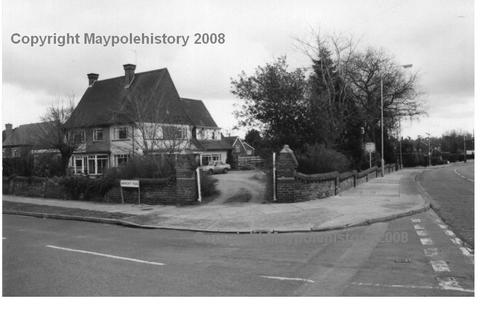
and below - a third building May 2010 - original wall !
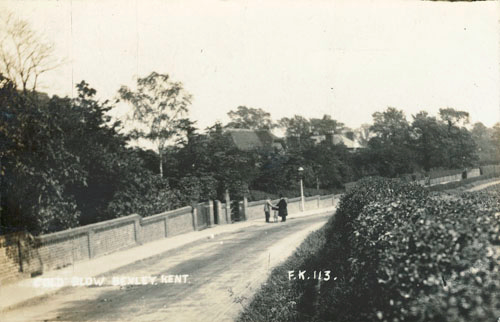
Above - Date 1906 Description Dartford Road, Bexley. The area is known as Cold Blow. The view is looking towards Baldwyns and Bexley Mental Hospital. Correspondence and stamp on reverse of both copies.
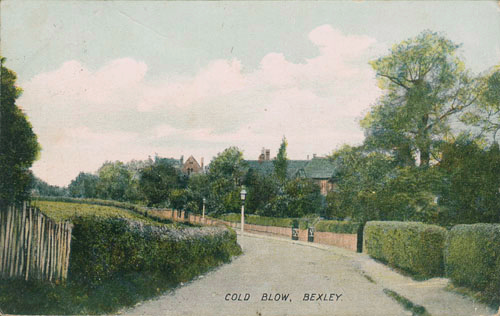
Above - same view as below.
Below - Date 1908 Description Dartford Road, Bexley. The area is known as Cold Blow. The view is taken looking towards Bexley Village. Two small children, policeman and pony and trap in the road. Correspondence and stamp on reverse of postcard.
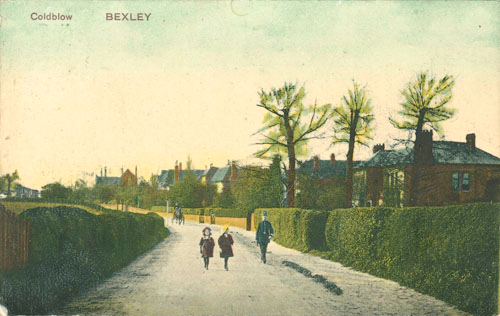
Below c 1994 . . . . .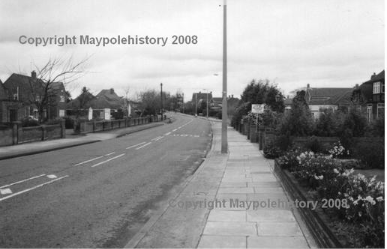
Below - the 'Dip' c early 1950s
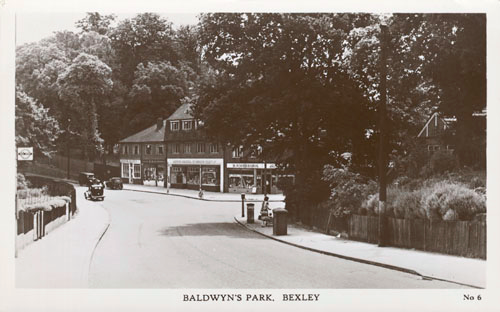
Below - the 'Dip' towards Bexley Hospital
Date 1913 Description The Dip, Near Bexley.
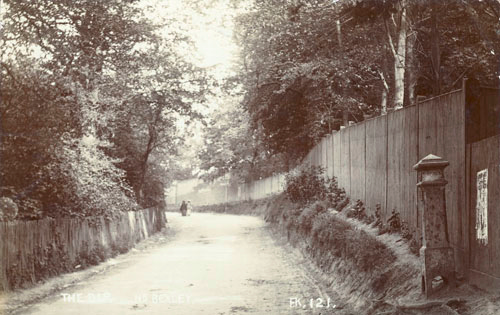
and as it looks now . . . . .
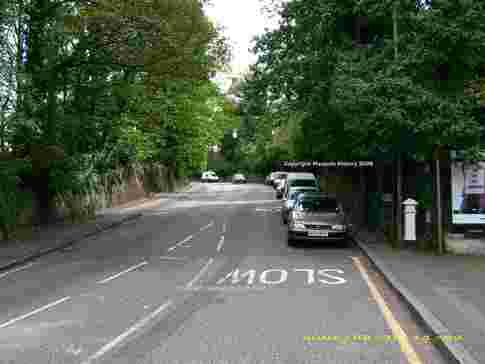
Below - the shops c 1955
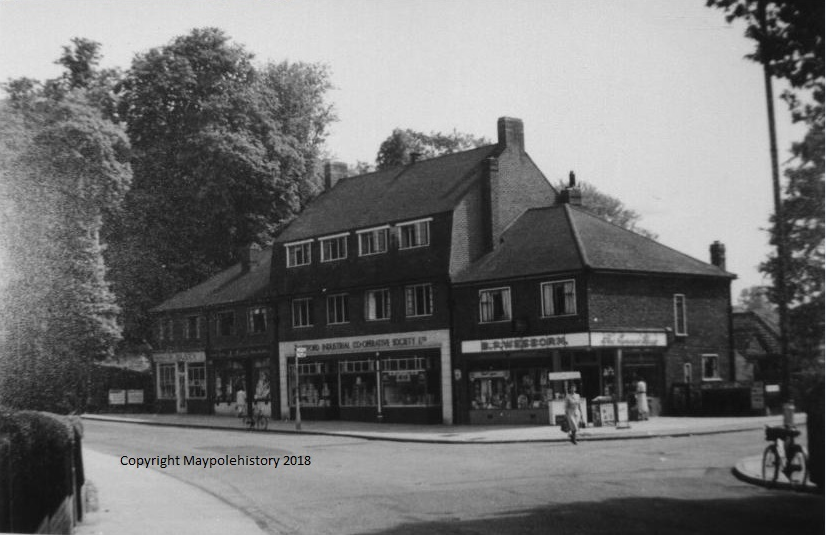
Below - Title Dartford Road, Bexley Date c.1950 Description Dartford Road looking towards Cold Blow and Bexley village. Baldwyns Park is the road to the left.
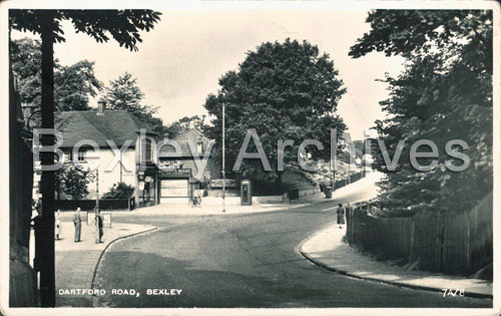
Coal Tax Posts - as seen in the above three images . . . .
Courtesy of Wikipedia . . . . . .
Coal sold in the City of London had been taxed since mediaeval times and, as it was all brought in by sea to one or two riverside wharfs, the collection of the duty had been relatively easy. A similar duty was collected on all wine landed in London. By the nineteenth century, however, there was increasing trade by canal and rail, and various acts of parliament extended the catchment area to a radius of about twenty miles from London. The City is a small (one square mile) but influential part of London and in 1851 an Act was passed specifying the points, far beyond its boundaries, where the collections could be made. Marker posts, inscribed with this legal authority, were erected. About two hundred have survived. Following enlargement of the Metropolitan Police District (which, paradoxically, did not include the City of London) in 1861 a further Act was passed and new marker posts were set to show the boundary inside which the duty was payable. Most of these later posts survive.
Not all of the points were staffed by tax collectors but on well-used routes with a heavy coal traffic, such as on the Grand Union Canal at Grove Park, Hertfordshire, permanent toll houses were built. [1][2] In other cases local coal merchants or, after the bulk of the traffic had passed to the railway, the railway companies calculated the sums due and passed the money to the Corporation. The railway companies were allowed to offset the coal they used for their engines, but only when employed on coal trains.
The erection of these posts was very much a last ditch attempt to retain the tax in the face of growing opposition. The tax had been running for at least two hundred years but within twenty years of the posts going up it was abolished. The Industrial Revolution was in full swing, London was expanding rapidly. The outer suburbs were becoming towns and their residents beginning to resent paying a tax which had very little direct benefit for them. One extreme case is Caterham which lay (and still lies) outside the Metropolitan Police District (MPD) but if coals were to be brought there by rail they had to pass through the MPD and presumably were subject to the tax.
The powers to extract these taxes were abolished in 1889, notwithstanding the City had fought against the abolition moves with some underhand tactics: a parliamentary select committee sitting in 1887 found that signatures on a petition in support of keeping the tax had been forged.[3]
Road to Bexley - Notes from Audrey Hughes nee Jackson
Notes on “The Journey from Bexley”
Looking through these photographs again, I found myself remembering quite a lot more than what I sent in after first seeing them. I apologise for the one or two items I have repeated, but hope the stories add to the most interesting accounts I have read so far. I have listed the relevant photos in the order in which they appear before each paragraph.
1 I often walked my two cairn terriers, Mac and Susie, across the fields here and also sinfully crossed the field on the right on horseback, returning to the stables at Eltham by way of the A2, after an eventful ride on Dartford Heath. My grandparents are buried in the churchyard at St. Mary’s in the background, but overcrowding has made it very difficult to find the plot.
2, 3&4 No more farming takes place here I see.
5&6 I had no name for the rough path to Wansunt Road, but I remember Dorothy Squires, the singer, who lived near the end of it and owned two giant poodles. She took them to swim in Chislehurst ponds and would then bring them to the kennels shop for a bath and trim. This was my pocket-money job and I also exercised the kennels dogs for the owner, Mary Porterfield, from Maryfield in Joydens Wood Road, from where I learned a number of interesting routes across Dartford Heath. The little shop was once a shoe menders, nearly opposite St. Mary’s, at the start of North Cray Road. I had a couple of school-friends in Baldwins Park, Summerhouse Drive. There was Clare Hayes whose bicycle was the first I fell off and Sylvia Gyselman (not sure about the spelling) in whose house we held a school class when there were too many children evacuated to open the Maypole School. The path to Coldblow we called the Tinkly Path because of the metallic echo from footsteps.
7 Hill Crescent – the house on the left was demolished by a high explosive bomb around 1940. Another school friend, Helen Bower (who became a doctor) lived further along on the right.
8,9,10,11 I think the house (Mount Eagle) was also demolished, this time by a flying bomb (V2). I’m amazed the wall survived. Luckily I believe no-one was hurt in either incident. My friend in Wansunt Road was Megan Foster.
14 The Dip and another wartime memory. “One of ours” was shot down and crashed into the front garden of a house on the left at the top of the hill, almost opposite Michael Walker’s house. The plane damaged the house a bit where it landed, but it was repaired. The pilot parachuted into Joydens Wood – it was said he was caught up in a tree. For some reason I used to have recurrent nightmares about this spot except there was also a train running down the road!
15&16 On the right behind the fence was a sweet chestnut tree. We used to get through the fence for the nuts. There was a serious accident on the Maypole side at the top of the hill, when a wheel came off a tractor and hit a passer by.
Audrey Hughes (Jacko at that time)
Photo's - random places
Below photograph Baldwyns Road C 1910
Courtesy Brian PORTER on Dartford Remembered - Facebook
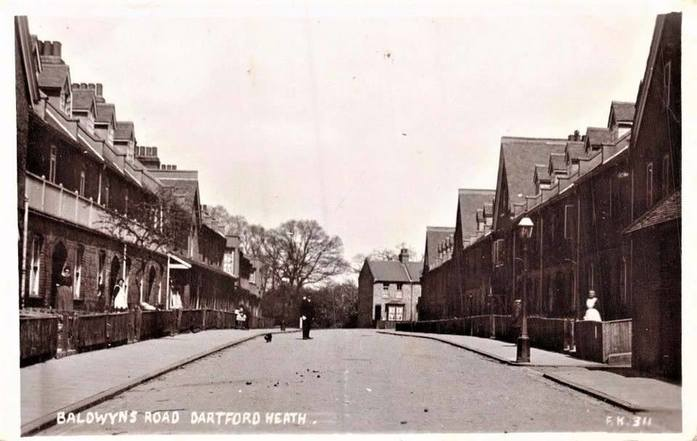
Below two photos (Courtesy of Steve Parker)
Photo 1 - multi. Various views of the estate c1978
(Top left outside front of No. 6 Baldwyns and below that rear of No. 6)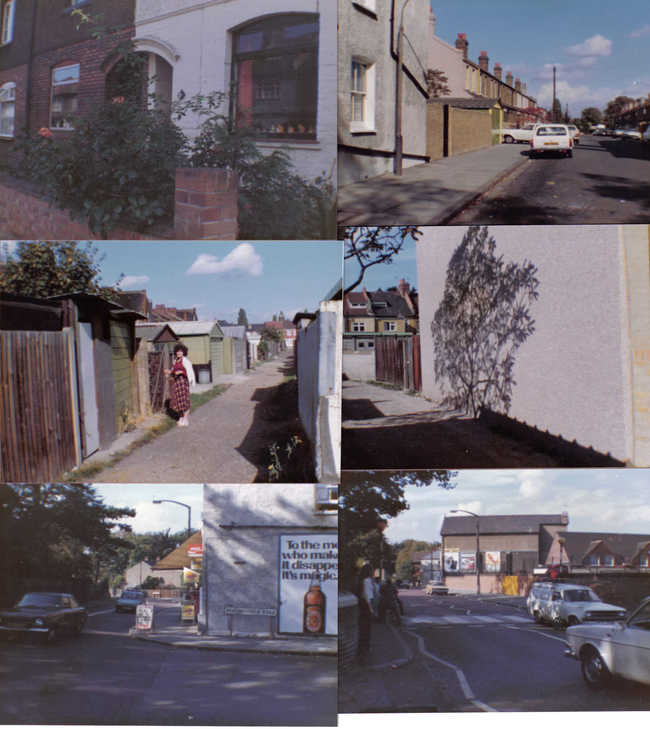
Photo 2
Heath fire - painted by the late George Stockford (Snr) - once a resident of Baldwyns Road -
notice the Hospital Tower and roof of the nurses quarters. The view would have been from the site of the 'Camp Hole'.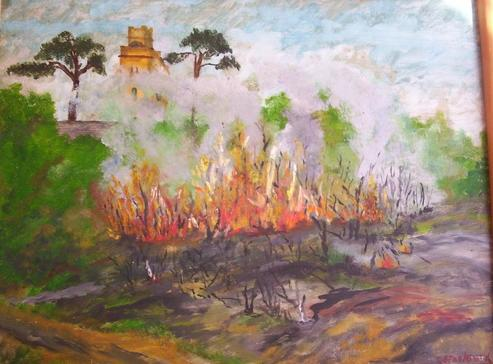
Below the view of the hospital gates
Approaching from the Leyton Cross side . . . .
Below in three stages - keep your eye on the gates . . . .
1946 . . .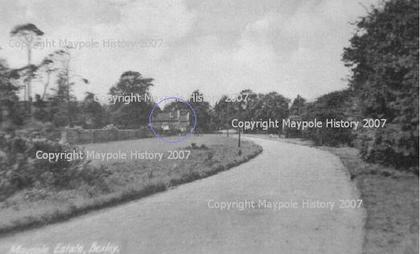
Next c1994 . . .
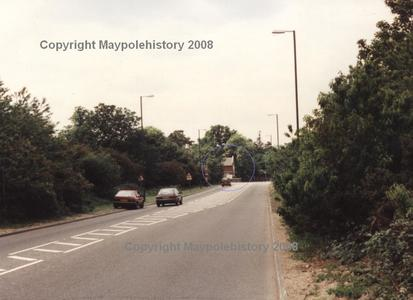
Next c2005 . . . . .
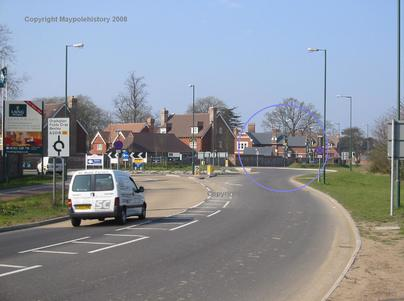
Below - various scenes from the area - courtesy of Steve Parker in NZ.
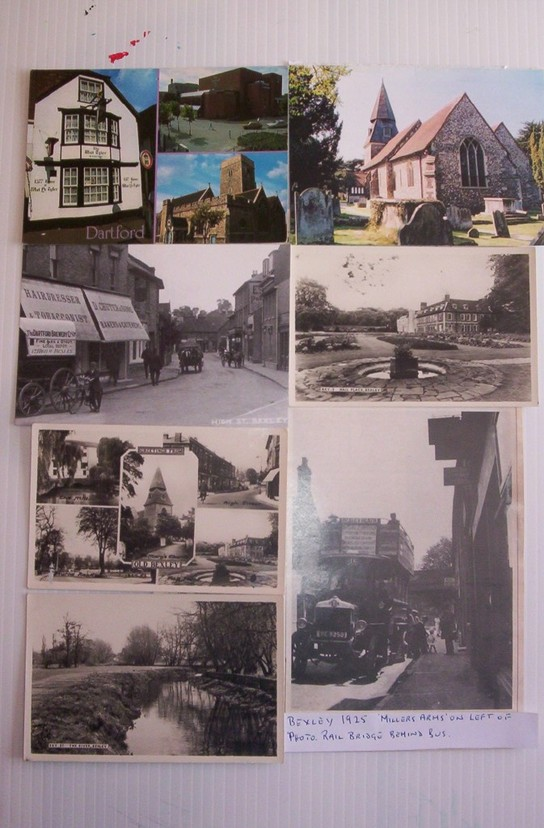
Below - views of Bexley - courtesy of Steve Parker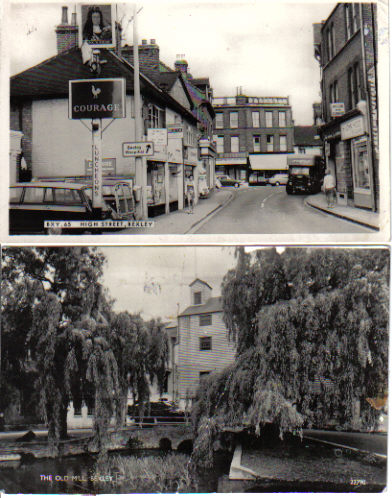
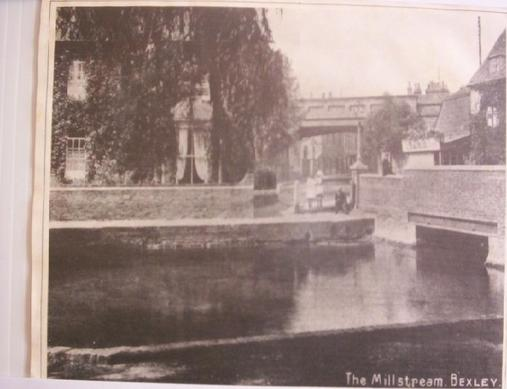 A
A
Above - Bexley Mill courtesy, Steve Parker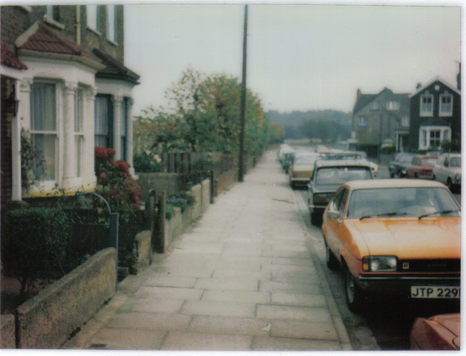
Above c1970s courtesy Steve Parker and below 2008 - Heathend Road
Below Heathend Road junction with Denton Road - courtesy Steve Parker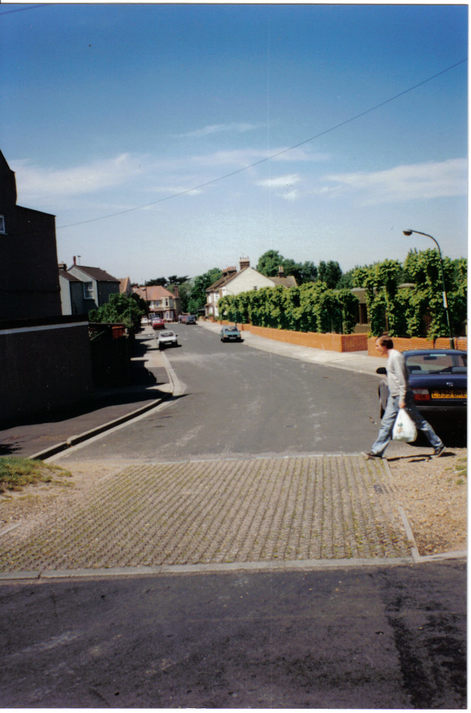
Below same location April 2005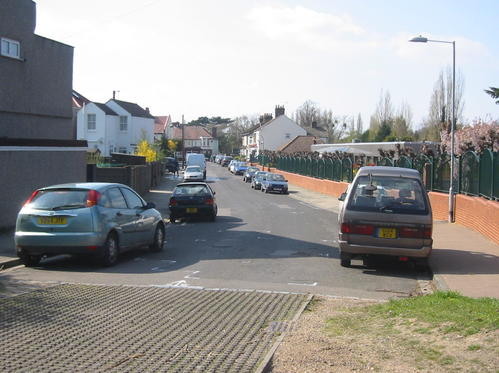
Below - Storm 1987 - Old Bexley Lane
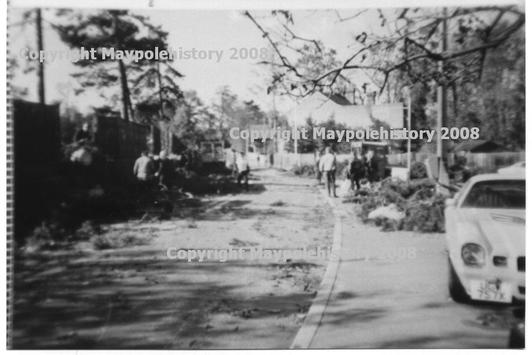
Below . . .
The Dell c 1920
The Dell looking towards the direction of Coldblow and the 'style' crossing the stream. Notice how devoid of trees it all is. Photographer standing on the hill where the houses of the Dell would have been to the left and the small track leading to the sandy road to Heathwood would have been to the right.
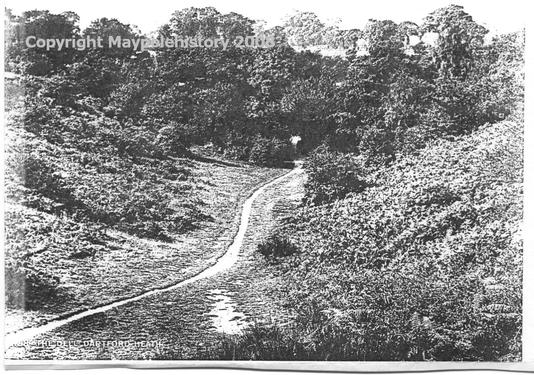
'Dick Turpins' Cave c1890.
This was situated along the Birchwood Road on the left as you tavelled from Leyton Cross towards Swanley - on land opposite the junction with Birchwood Drive. The late Winnie Blackman explained that they would be taken by their teacher on a nature walk to this cave c1920. She stated that it was high enough to take a double decker bus. Didn't believe her until I found this photograph. See the man circled at the mouth to it. This has now been filled in.

Below - The 'Moles Hole' Dartford Heath
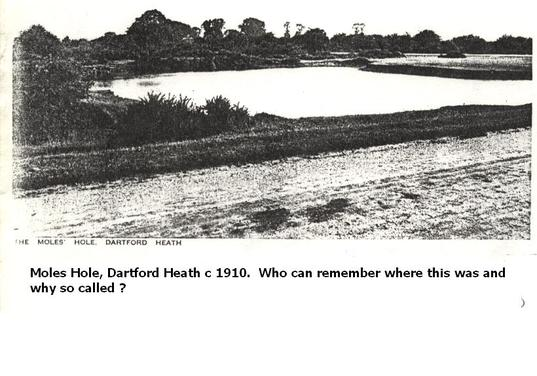
Below - Rochester Way c 1953 looking towards Bexley - Gun Club on right hand side.
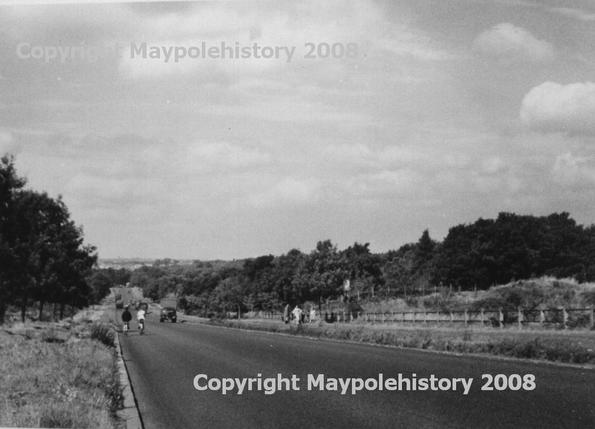
Below shot (A2) taken from virtually same location but looking the other way towards Dartford. Denton Road forms a junction at the top of the hill.
c 1935
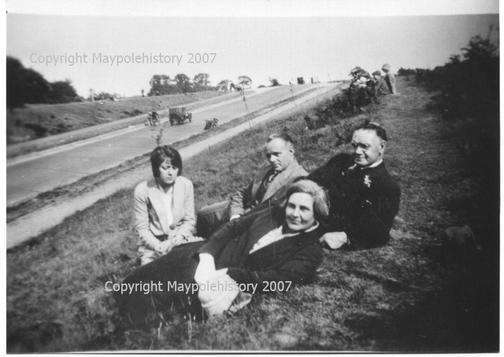
Joydens Wood Area
With the advent of Facebook and various social media sites it has become apparent that we just can't ignore the Joydens Wood area any longer ! So, we intend to fill this page up with information, memories, images and much trivia to acknowledge the importance of Joydens Wood to the history of the area. Information will be gleaned from social media sites (with permission, of course) and any other sources of information readily to hand. There will be pages dedicated to individuals, areas, events and the like and each subject will have it's own page for ease of reference. For these pages please look at the panel on the left hand side of the screen towards the top.
Below maps of Joydens Wood submitted by Karen Dell on Facebook - Joydens Wood Remembered.
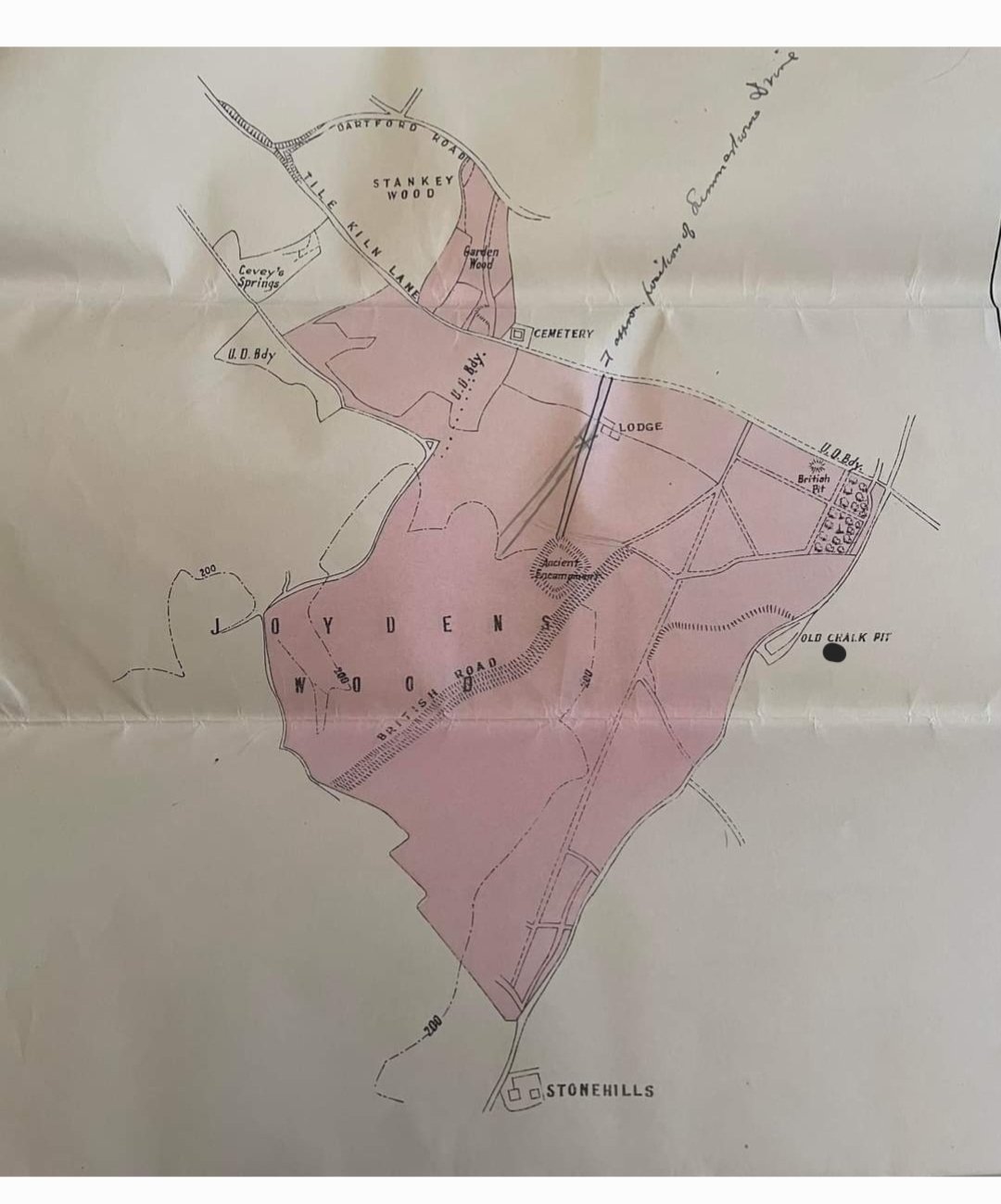
Below dated 1894
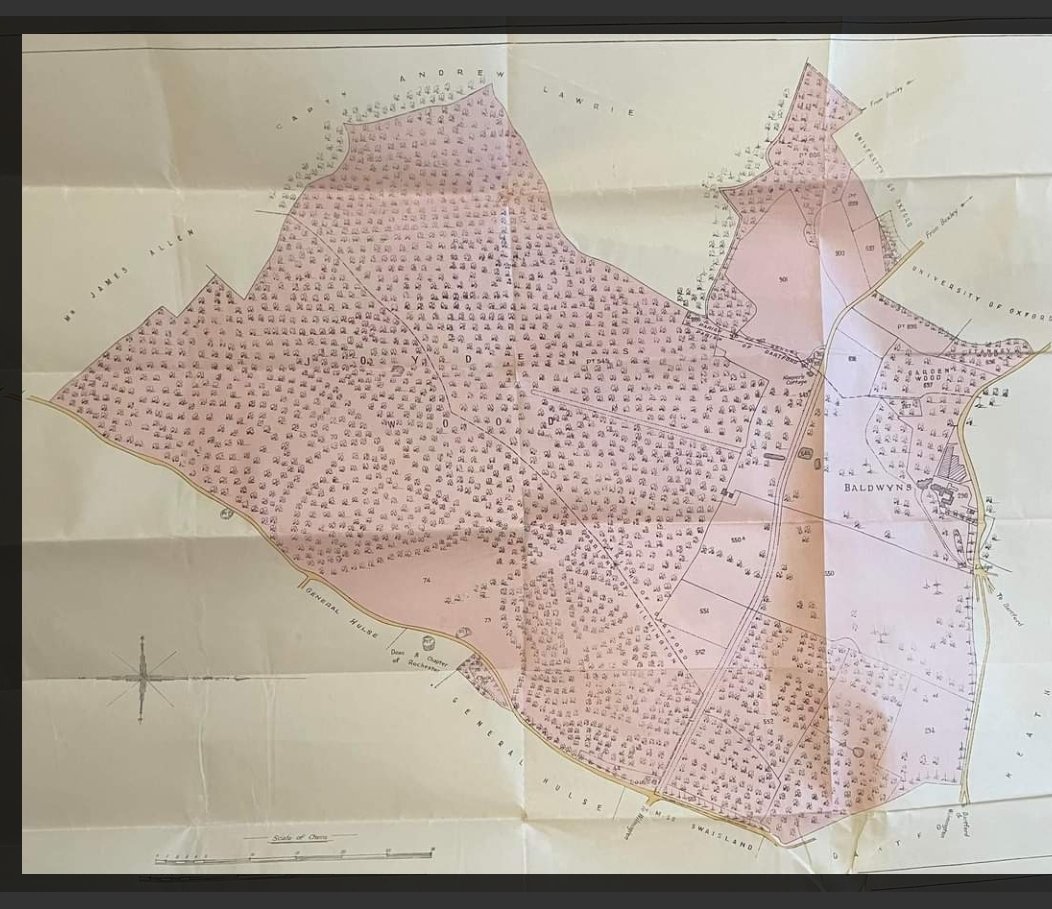

We invite anyone who wishes to contribute to send their information on an E Mail to maypolehistory2.wikifoundry.com
The history of the woodland known as Joydens Wood - click on link and it will take you to the Woodland Trust web-site.
We start with the Memories of:
Joydens Wood - memories of Bill Young
MEMORIES OF BILL YOUNG
My father and uncle were builders.Young & Young Dartford they bought 20 acres of woodland and orchard adjoining 100 Summerhouse drive.. My family moved into 100 in 1948 long before the hill was paved and S H Drive terminated at No 100. A new government threatened to put a land tax on forcing the sale of the orchard and part of the woods, now known as Woodlands Park. During 1962/3 100 was demolished and the garage built and run by my sister and her husband. After a family feud my father and mother ran the business until ill health forced it's sale. So, I was in Joydens Wood during all the developments and can pretty well tell you who did what. Please don't hesitate to ask.
I was about 13 at the time and very friendly with a boy, Ray Spencer who lived at , I think 91 SHD. Ray was about 18 months older than me and dad always said he was a bad influence on me. Behind Ray's house deep in the woods was a house belonging to Miss Nugent and her sister. They were an old couple and somehow trusted Ray. In front of their house was a lovely lawn but it became a home for a family of moles. Miss Nugent asked Ray if he could clear them and Ray, being an experimental type, agreed. In those days one could buy Calcium Carbide in small rock pieces. I remember it came in a tube similar to Pringles. When mixed with water it gave off an obnoxious smelling gas. The boys at the Maypole school used to put it in the urinal channel for a laugh. Well, Ray and I put a load of this chemical down the mole holes and let it filter through. Then Ray had the bright idea to see if it was flammable not knowing that the gas was Acetylene. Of course it lit to the great amusement of us both. When a gas and air reach equal quantities it is an explosive mixture. The moles were no more and repairs to the lawn were required. Ray went on to blow up cans and allsorts I had no further part in his escapades.
I did say I would tell you about Nov.5th at 100 Summerhouse Drive (SHD) when I was 11-14. The clear patch behind of the dog (Rusty) near the shed, is about where the gardens of 110-112 SHD are now.
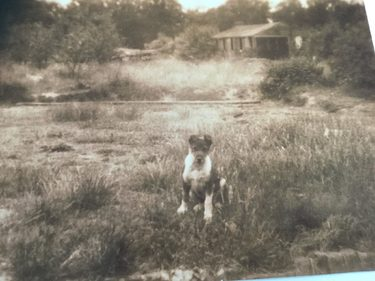
The morning of 5th was hectic as my elder brother and myself would cut down a Silver Birch about 10-15ft high, de-branch it, dig a hole and plant it as the centre of the bon fire. Then stack the branches (From my years logging) around it ready for the evening. We did this to ensure there was no wild life in the dead branches. My father (A builder) had either constructed or extended Dartford Cardboard Box Factory who supplied Wells fireworks with packaging, say no more! Mr Martin from the pig farm, now Norfield Road, used to bring a suckling pig which dad had to clean in our kitchen (what a stink) and we'd roast it on a sort of Bar-B-Q dad made. This was always ready by the time the bonfire was at its lowest and the fireworks were done. Crust rolls and hot pork, devine. My elder sister was friendly with the football team from Oakfield park and they used to walk to our 5th party (every body was fit then) Many residents of SHD attended and it was always a great evening. The pig was roasted over chippings from my years logging and bark that had come off the logs when they were split. Do I wish I could turn back the clock?
This is sadly the last picture I have, maybe my sister can come up with some more, I hope so. It was taken from the rear garden of No102 SHD looking up towards 116-118 SHD. The large shed was roughly in the back garden of 105 Woodlands Park. The shed housed a large one cylinder horizontal petrol driven saw bench with a blade around three feet in diameter. It was my job to cut down the trees with an axe, de-branch them and haul them into the shed for Dad to log. Then I splitthem, loaded them onto a large two wheeled cart and lugged them to the shed attached to the house. No wonder I was the biggest chap in the school! In the clear patch we used to have our Nov. 5 bonfire from the branches. I'll tell about that another time. On the left of the Shed as you look at it here there was a massive bomb crater, yes Nos'116 & 117 you would have been blown to Kingdom Come. The mounds of clay that were blown up were Red, Yellow and Blue pastel shades. Oh yes, the dog is Rusty
Baldwyns Park shops as I knew them. 1948-61 Lau's Kitchen=Fish and chips and wet fish. Cuave=wool one side and hairdresser the other, Modern screws=Co-Op groceries, VTS=Co-Op Butchers, Wines & Beers= Papers & Sweets, Top Notch (Built by my fathers co.) = Groceries, Beauty Box=Not there when I was. On the other corner was an Off licence come Grocers. Remember there were no Supermarkets then hence the number of Grocers. I did my paper round from this news agents.
This pic below was taken from the back garden of 100 SHD looking down past the front of the house to the top of the hill. This was truly living in Joydens Wood.
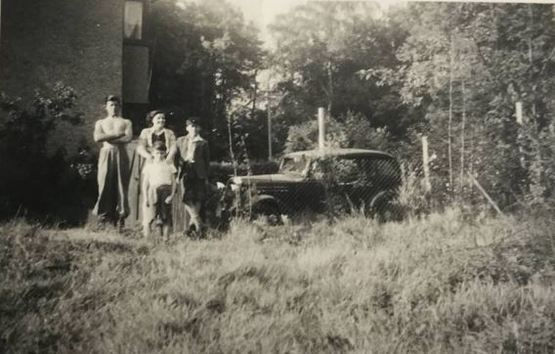
This picture below is the start of Woodlands Park. 100 SHD is in the background and it depicts the grubbing out of roots to make the road wider before the main drain was installed.My sisters are standing where now is the corner of SHD and Woodlands Park. My tall sister Diane has her back to Woodlands Park and the house is now the garage. Hope this is clear.
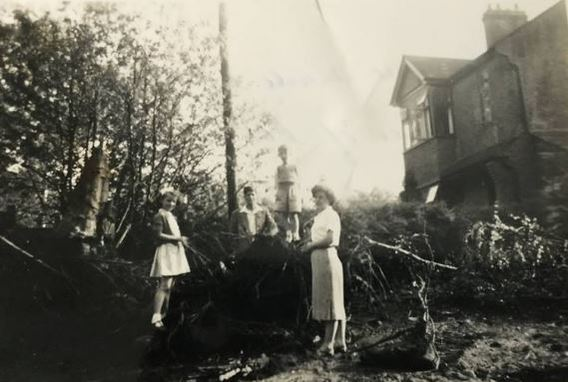
Young'sfamily photo below. My father on the right, his brother on the left holding the child. These two men are responsible for the development of Woodlands Park leading to the development of what is now the Joydens Wood Estate that all residents enjoy. I am on the extreme left.This pic was taken at the rear of 100 SHD where now stands the garage. Before the building of Woodlands there was no main drainage from Ferndell up the hill. All were on septic tanks or cess pits. It was only when the main drain was brought up the hill that enabled the remaining development.
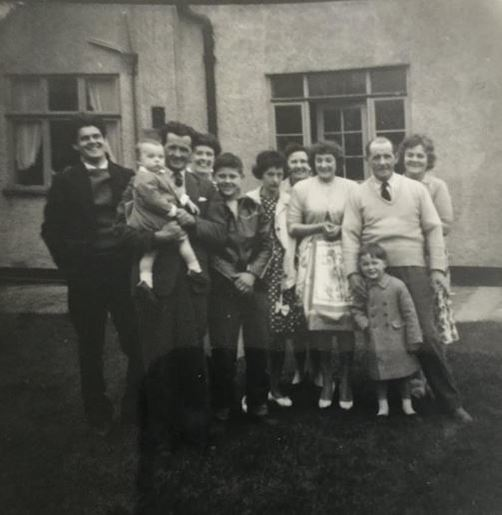
Before I left school there was a fire in Joydens Wood at the far end of what is now Eden Road deep into the wood. The Fire Brigade had their hose connected to a hydrant outside No 91 SH Drive. My mother at No 100 was trying to get dinner for us 7 kids and my dad when the water went off due to the Fire hose taking it all. She moaned and I went to the Hydrant and turned it off for a short while. Boy was I in Hot water when the Fire Chief came running to see why they had no water.
This photo below was taken outside No 100 SHDrive, now the garage looking towards what is now No105 SHDrive This was the end of SHD on the right of the pic were the gates that went to the pig farm now Norfield Road.
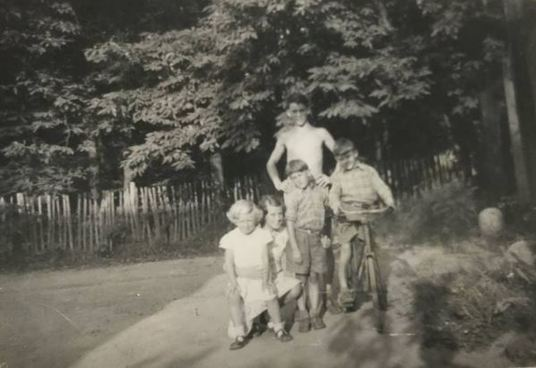
This is a photo below of the drive entrance to "Hill Crest" now I believe is 77 Spurrel Avenue. It is where Greenwood Road meets S H Drive.
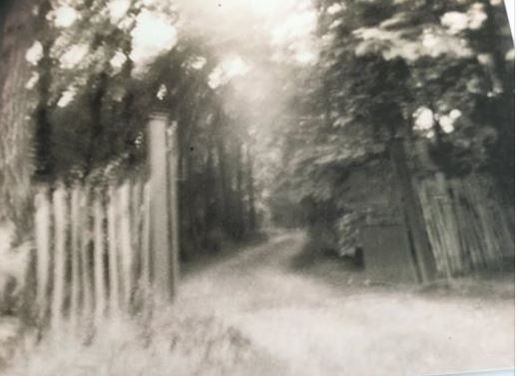
"Driving Miss Nugent" The following couldn't happen today but let me take you back to 1951 and emphasize the remoteness of Joydens wood in those Halcyon days. As I told you before, the Nugent sisters lived in a house deep in the woods behind which I think is No.91 SHD. My friend Ray lived at No 91, his father sold the Nugent sisters an old Morris car. All I can remember of this car was that it had four hydraulic jacks, one on each wheel, for changing the wheel. A good idea that has been lost I believe. Neither of the sisters could drive and so Ray said he would teach them. Bearing in mind that Ray was no more than 14 and a half. Somehow I got rowed into this nonsense. It went like this. We would start at the Nugents house with one of them driving, after a few lessons we would get out onto SHD with me in the front and Ray in the back seat. Down SHD and into Joydens Wood Road which was as I recall like a cinder track. Ray would indicate to me by putting up the appropriate number of fingers which gear Miss Nugent should change into. I know not how long this went on for or whether either one past their driving test, Suffice to say my father got wind of it.
Joydens Wood - Silver Birch Close
The below from Joydens Wood Remembered - on Facebook
Joydens Wood map from Karen Dell - undated.
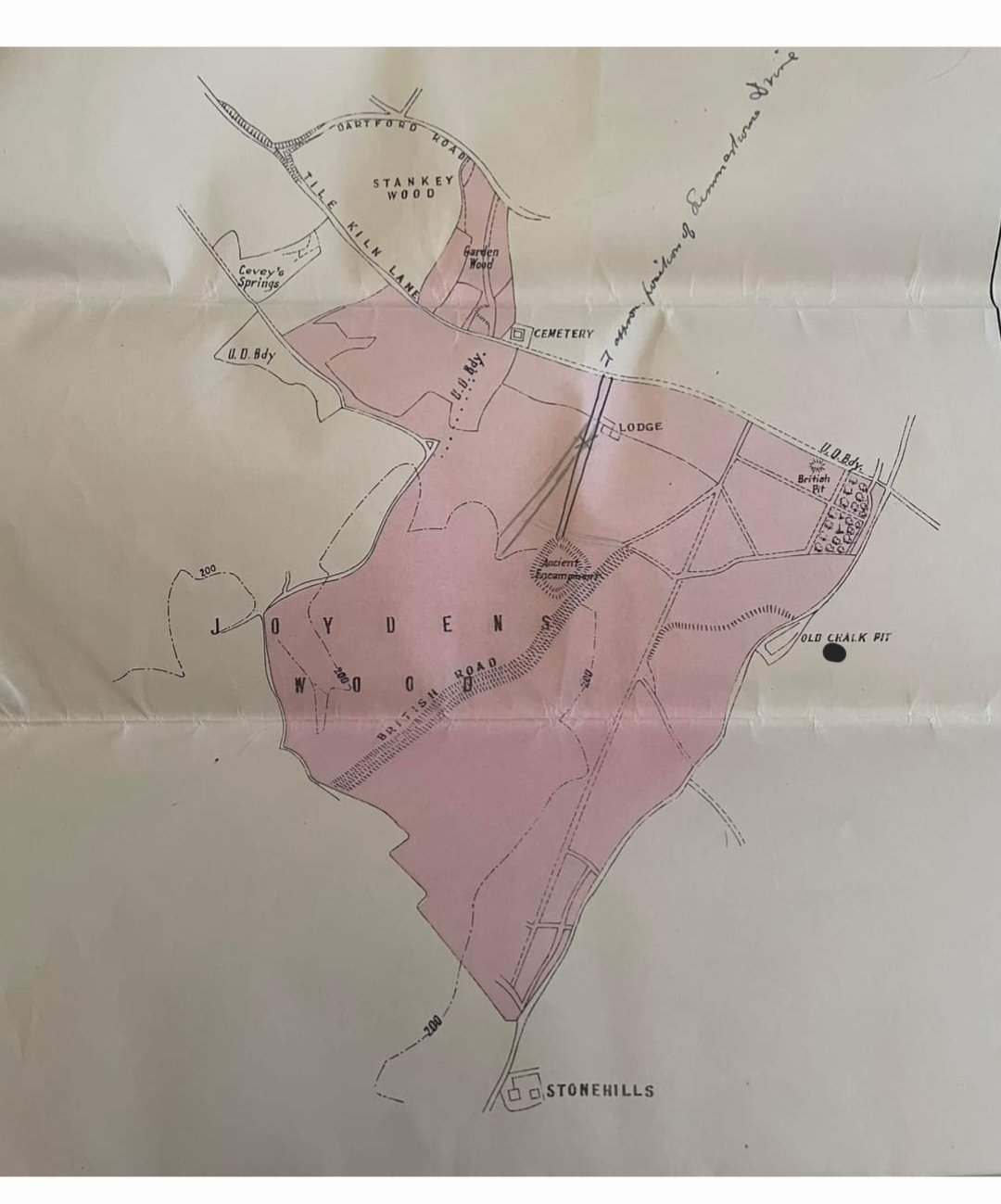
From Sue Westpfel Lane Construction work with self build group in Silver Birch close 1955 /1956. My father digging main trench for sewers, and brick laying with Bill Adams.
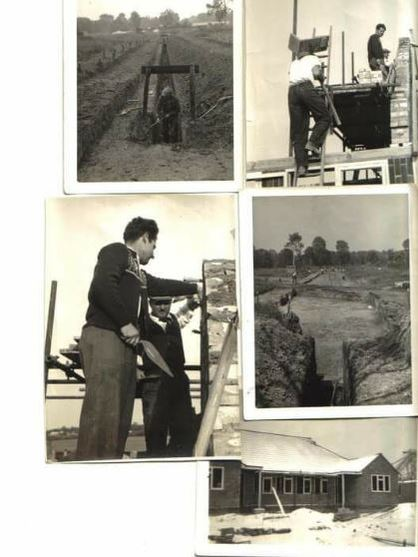
The below from Jill Marks.
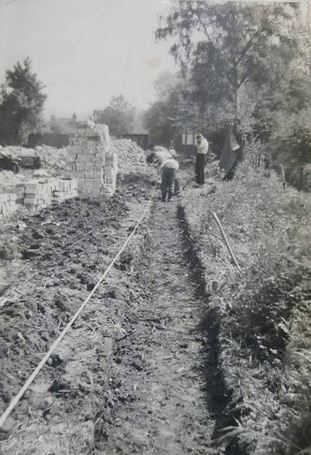
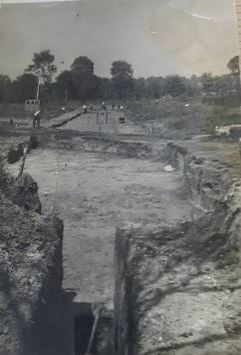
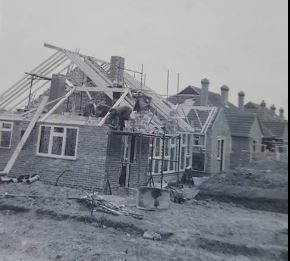
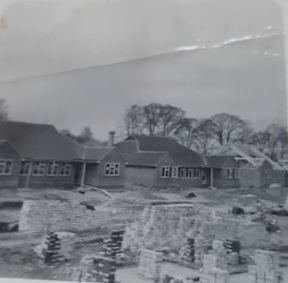
Joydens Wood - Rosewood
From Lloyd Marks - John marks (in rear) and Charlie Dryden on right at rosewood self build group.
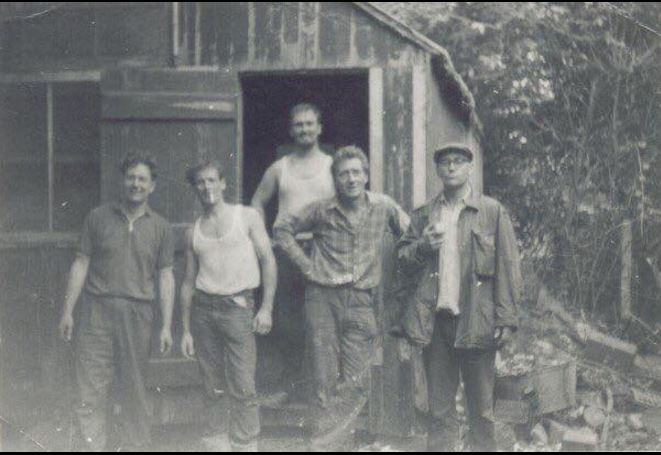
Joydens Wood - Birchwood drive
From Rhona Lee - Birchwood Drive in 1961 taken from the top of The Chenies, looking towards Birchwood Road.
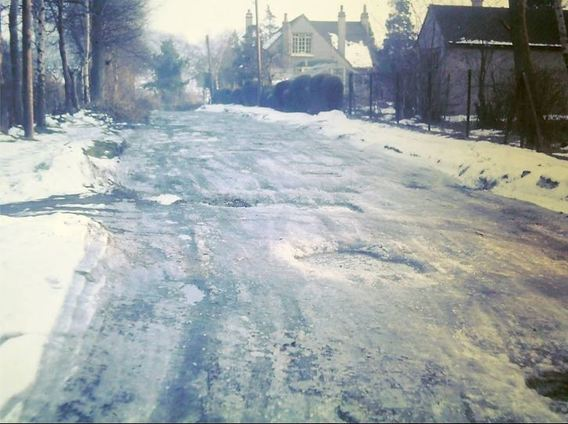
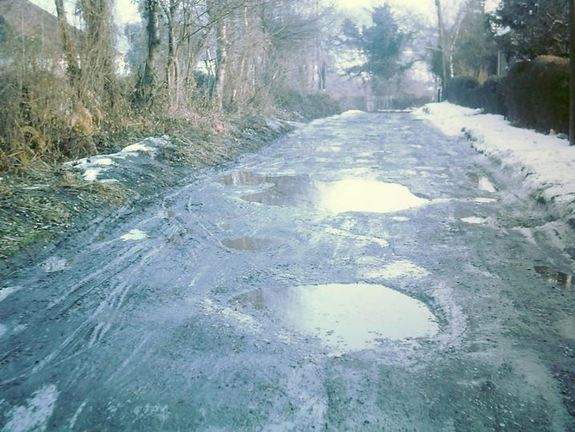
Joydens Wood - Joydens Wood Road
From Shirley Sargeant - Joydens Wood Road, Summerhouse Drive end - undated. Poss c1963 ? There was once a small shop in the building under the pylon.
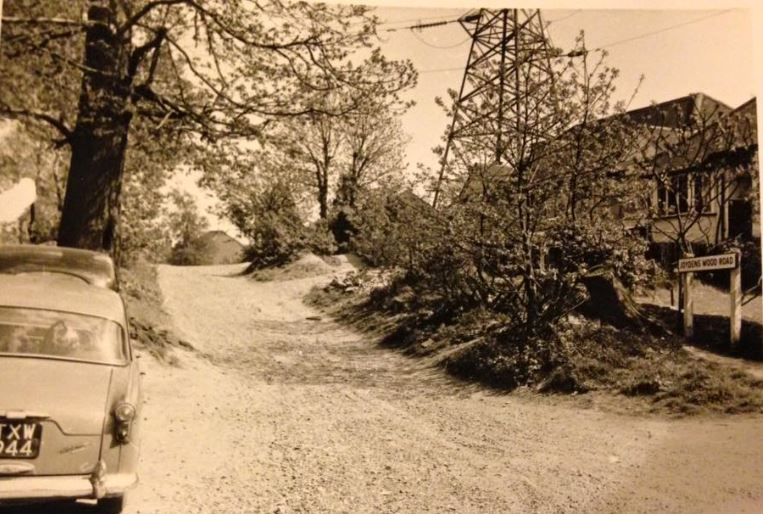
Below - further down
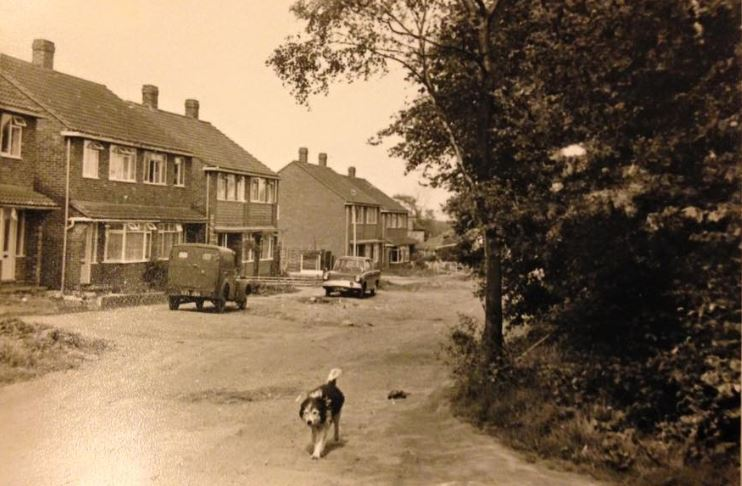
Again - similar location
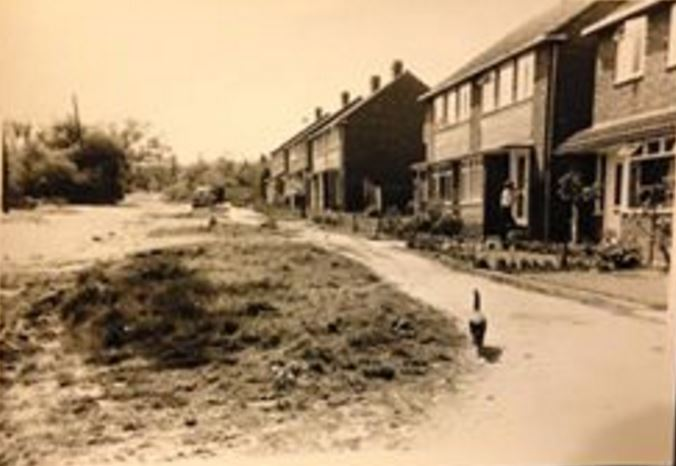
Joydens Wood - The Summerhouse
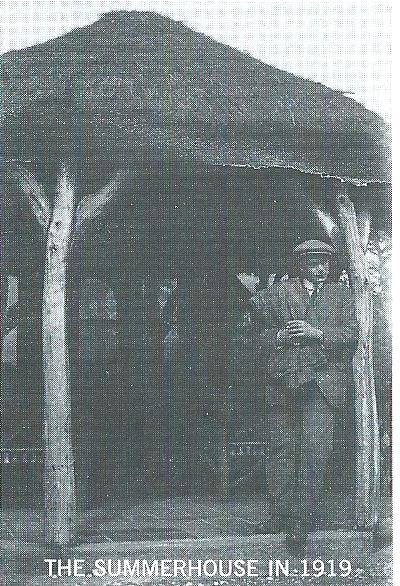
Below - image of a summerhouse located somewhere in Joydens Wood - undated. Source unknown.
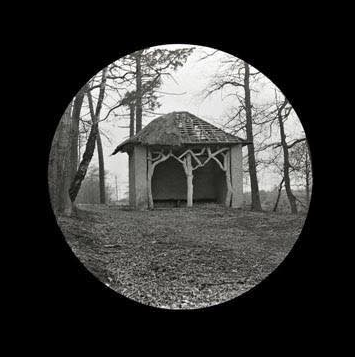
Thanks to Rhona LEE for the information below
The Summerhouse, Joydens Wood in 1919
Photo and following description taken from Ian Hammertons booklet 'A Wood On Our Doorstep Joyden's Wood' published in 1998.
'Some elderly people remember as children on Sunday afternoon walks visiting a curious structure near the top of the hill in Summerhouse Drive. It may have been simply a shelter for those enjoying a day's shooting in the woods - there was evidence of iron rings in the walls for the tethering of animals while the owners partook of a collation, but there is reference to a structure in the 1600s.'
Bexley Covenantors - Richard Wight
BEXLEY COVENANTERS
This Bible study group was led by the infamous Mr Cook who lived in Baldwyns Park and met every Tuesday in the St. Barnabas Church Hall. Every Sunday morning you would be expected to attend morning service at St Mary`s in the village followed by a prayer meeting in the institute opposite.
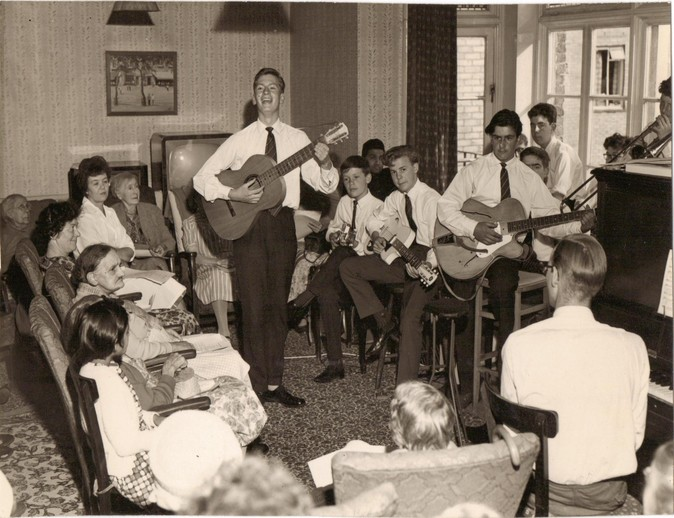
The chap standing and singing is Alan Goodall, ex Dartford Grammar School and St.Mary's choir.
Seated behind him is my good self and next to me is Alan Parnell of Vicarage Road, ex Maypole school.
Standing, holding my old guitar is the late Dave Connelly ex St Mary's bell ringer and to soon become bass player of the Driftbeats !!!! re the photo of their first' booking' at the Maypole Institute 'Hut'.
He lived in one of those cottages opposite the Old Mill in the village where we would rehearse in secret from the Covenantor band !!! now with the ace drummer from Vox,Derek Harris.
Behind him is Eric Hales of Wansent Road and the chap on drums, I can't quite remember although his name is Peter and he was in the St. Mary's choir and next to him seated is Peter Noy who lived in the bungalow at the bottom of Baldwyns Park nearest the shops.
The chap on trombone is Alan Goodall's brother who's name escapes me and the gentleman on piano was Alan ......?
The Maypolians I remember who were members of this outfit are – Derek Harris – Red Lodge Road Nigel Wilson – Tile Kiln Lane Eric Hales, Peter Noy, Owen Gemmell, Richard Wight - Baldwyns ParkRonnie Potter - Baldwyns Road Paul Hayward – Cold Blow Cresent Anthony Wilkinson – Cold Blow Cresent Alan Parnell – Vicarage Road The meetings were sometimes held at Mr Cook`s home in Baldwyns Park where we would play table tennis (sometimes with cake !!)and watch Z cars !!! play chess and muck around.
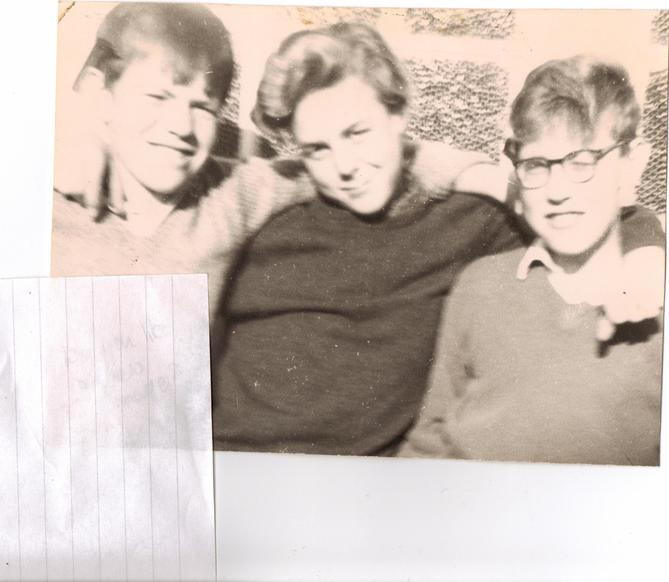
The meetings at St. Barnabas were great fun where playing round the clock darts would revert to .....just that !!! They organised some interesting outings and the ones I remember were – Stratford railway works The Model Railway exhibition at Westminster Hall Cross Country Runs Sports Day at Crystal Palace Athletics Stadium Mr Cook worked in Shell House at London Bridge and would take us to use the swimming pool housed in the basement !!
When Derek Harris was in Hospital following a road accident, old Cookie pinned the covenanter badge to his pyjamas. All in all, We had a fun time and were enlisted into the Covenantor`s beat group which called itself the Messengers !!! We would play gentle occasions such as old peoples homes and the Freemantle Hall in the village, where word would come down from on high, No Girls !! What a laugh we had with this caper, trombone,piano,drums,percussion( a triangle) various guitars and the leader was a chap I remember named Alan Goodall. His brother played the trombone. Well after a while we got fed up with the boys only rule and decided to branch out on our own acquiring the St Mary`s school in Bourne Road for rehearsals together with Alan Parnell`s attic which was heaven with as many girls we could cram in !!
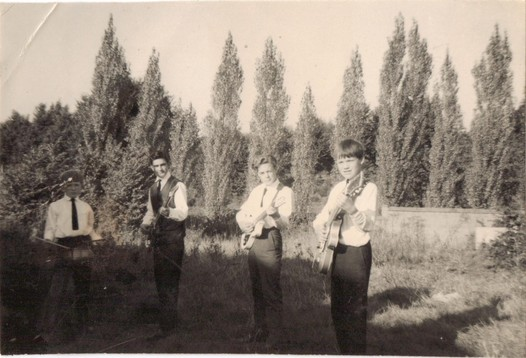
Our first date ! Was a childrens party at the Maypole Institute at the bottom of Baldwyns Road. We charged the lady £5 and my mother declined to comment !! So the group now consisted of Derek Harris on drums whose father would drive us to and fro the better youth club dates. Alan Parnell would be on lead guitar, Dave Connelly on bass who lived in a cottage opposite the old mill in Bexley and sadly got killed on his motor bike. He also was a bell ringer at St Marys`. Which left me on lead vocals and rhythm guitar. We would meet up at Music Land, the Vox shop by Bexleyheath Clock Tower to oggle the latest amps and guitars. Derek Harris worked for Vox so we had a contact on the inside !! he would set up visits to our rehearsals in the attic of people who were in real bands and could point us in the right direction. Our policy now was Girls only, plying a terrific, well worn path from Our Ladies High School on West Hill down to the rehearsal attic at the bottom of Vicarage Road.
We used to play between the films at Dartford Granada where the front rows would be full of Dartford West reprobates who took great delight in throwing things at us !!! So the Bexley Covenantors had done it`s part in starting us out on the band trail that has blighted our lives ever since and been such good fun.
Memories from old Maypolians
Memories of the below is still being 'tweeked'(13/03/2023) and is almost 95% complete..... If yours is not there and want to add or re-send then please contact us via the E Mail on the Homepage. Thank you - Maypoleman.
List of memories in this order:-
David Fergusson
Kim Button
Susan Kirby
Audrey Jackson
Tony Helyar
Ann Martin
Pat Richardson
Sheila Houltan
Perran Newman
Barbara Houlton
Frankie Gemmell
Janet Lee
Bernard Lodge
Stuart Grieve
Steven Parker
David Bainbridge
Peter Walker
Barbara Thomas
Margaret Cadman
Michael Jennings
Alfred Peters
Barbara Ireland
Derek Lott
John Burton
Edmund Wainer
Ronnie Potter
Lee Smith
Robin Healey
Richard Wight
Barbara Rivers
Ron Evans
Jerry Wilkins
Janet Cushion
Nicholas Milsum
Susan Smith
Antony Wilkinson
Charlotte Grimshaw
Dorothy Grimshaw
Mary Relf
Sandra Webb
Memories of David Fergusson
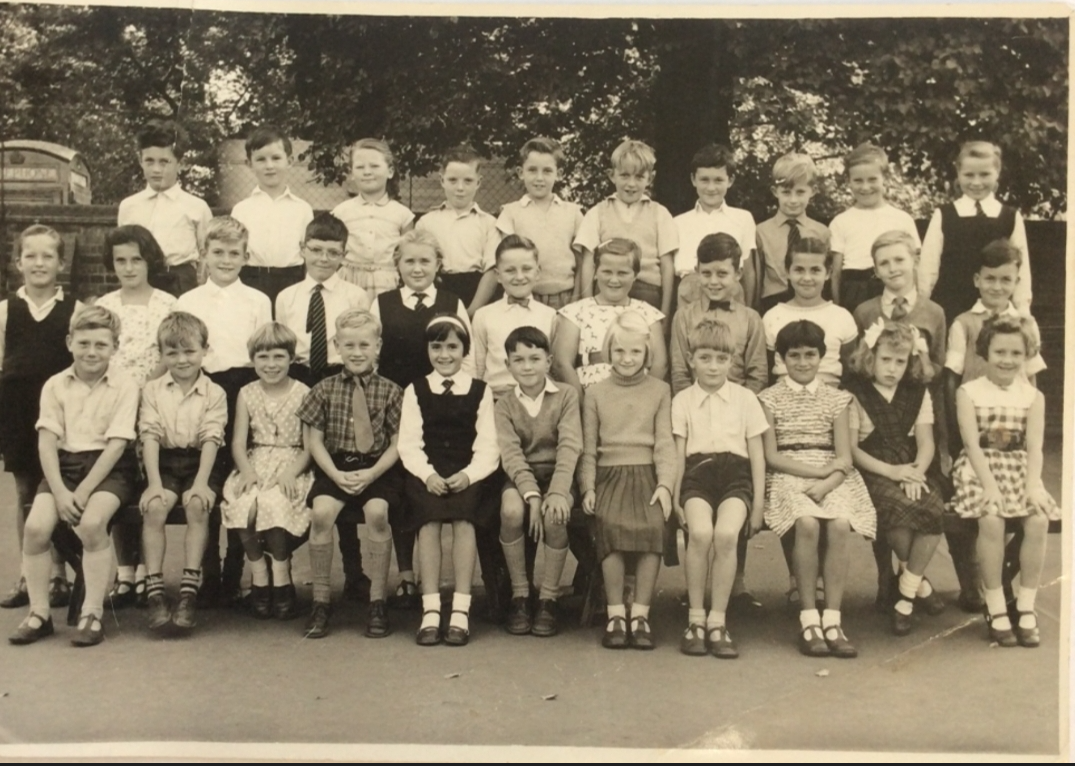
I was fascinated to read your website and it brought back so many happy memories of my time at The Maypole School and of living in the area where incidentally I still live. I found the above picture of our class of 1956 to 1962 amongst my mothers papers when she passed and thought that it might be of interest to any of my old classmates with whom I lost contact many years ago. To my recollection the photo shows us in our final year and was taken in the summer of 1962 when our teacher was Mr Rawlins and Headmistress Mrs Chambers. Their names as far as I can remember are as follows but apologies if my memory is not quite right for some of them and very possibly the spelling! :-
Back Row from Left to Right
Malcolm Wall, Nicholas Higham, Susan (HIckman?), Malcolm Crosby, Murray Chick, Michael Millard, me - David Fergusson, Vincent Cross, Vernon Wilkie, Rosemary ?
Second Row from Left to Right
David Truscott (standing) , Marilyn Price, Ian Sims, Robert Rivett, Christine ?, Peter Goodfellow, Carol Moss, Malcolm Benson, Mary Webb, Stephen Earl, John Elliman,
Front Row from Left to Right
Michael Newby, Jim Crawford, Denise Barker, Richard Ward, Caroline ?, Ian Davies, Carol Morgan, Ian Smith, Rosamund Hall, Wendy Blackwell, Nina Hatch.
Also in our class and not shown in the photo were:-
Tubs (sorry cannot remember his name as he was always known as “tubs”) Taylor, Adrian Upchurch, John Walker, Peter Davies and Christopher ?.
Good to see the memories and many of the names from my era which I remember and particularly Frankie Gemmell’s recollections as she was one of my Cub Mistresses at the 1st Baldwyns Park Scout Group which met at the Baldwyns Park Pavilion until they acquired their own premises in Eden Road.
Needless to say, it would be great to hear from any of my old classmates and chums generally.
David Fergusson
Memories of Kim Button
The first memories of my life on Maypole Estate I have start at about the age of 4 years old, in the latter half of the 1950s. I lived in Beaconsfield Road. The alley way behind the houses was our playground. Although we would be in earshot of our mothers (who, incidentally in those days seldom went to work, but stayed at home to look after us) we had our very own world away from the grown ups. We played Cowboys and Indians, pilots of rockets to the moon or we could be anything or anyone we wanted to be. It was such a safe environment. This is a far cry from the way I am having to bring up my children in today’s world.
My first friends were Keith Hawkes and Penny Smith from Baldwyns Road. We would occasionally go to the back alley of Baldwyns Road where I met Alan Booth who lived in one of the houses there. He became my next ‘best friend’. As we grew older we would be allowed to play ‘out of earshot’ of our mothers - but always within two or three minutes of our own alley. I rode my first bike down our alley and also ran hell for leather there in my first American Baseball ankle type canvass shoes pretending I was Batman.
As a treat we would occasionally be given some money to buy sweets from 'Vines' the Post Office or 'Barretts' shop. I can remember ‘Jamboree Bags’. These were bags containing a mixture of sweets and small plastic toys. On hot summer days we would buy ‘Jubbly’s’ These were triangular shaped cartons containing orange flavoured ice - if you rubbed them up and down you would end up with a very cold and refreshing orange drink. Sadly, the shape would occasionally mean losing the ice as it popped out of the carton and into the dirt. We also bought ‘Black Jacks’. These were small liquorice toffee sweets costing 4 for a 1d so they were great value. The next favourite purchase was ‘Wagon Wheels’. These were ginormous circular chocolate coated biscuits. They were 4d and we could only get these from the café and mum didn’t really like us going in there because there were Teddy Boys who smoked and played Rock and Roll on the jukebox ! One must remember that our pocket money was only 6d a week so Wagon Wheels were a real treat. We would occasionally buy ‘transfers’ which we would wet and stick on our arms. We enjoyed this because they looked like tattoos.
We played ‘fag cards’. They were picture cards in cigarette packets and we would place one on the ground then drop one of ours on to it. If it landed on it we would pick them both up. If not the next child would drop one of theirs and if it landed on the two they would pick all of them up - and so it went on. A favourite cheap toy was a water whistle. Rather like a Sherlock Holmes pipe made out of plastic you would add water in the bowl and blow. The sound was a warbling whistle - rather like bird song. Talking of ‘fag cards’ we would find old cigarette packets, fold them up and attach them on the forks of a bike with a clothes peg. We would then place the other end into the spokes so as we rode down Baldwyns Road (The only 'made up' road in the interior of the estate) we thought we sounded like motorbikes. Not a computer or TV in sight. TV’s only really came in a bit later - and then for only a portion of the day.
We eventually ventured on to the heath. This is where my imagination was allowed to explode. What adventures we had over there. The ferns were taller than us and the trees were hundreds of feet high - well that’s how it seemed. You know when you smell the earth or damp leaves or grass it takes you way back. Most of these smells and sensations take me back to the heath. The smells of late autumn, the mist shrouded, dampness in the valley of the Dell. The sensation of running through piled up leaves down the Paddock near the A2. The sound of broom seed sacks popping open in the heat of summer. The magical feeling upon hearing your first real cuckoo in a copse a mile off. The aching thirst after running around in the sun for a whole morning. Hearing the first crack of thunder in the outside world away from the protection of your parents. The glorious feeling of snow up to your waste. The sight of the first daffodils in Spring growing wild in the valley of Heathwood and the pride of producing some picked ones to your mum. The feeling of being in a ‘Hansel and Grettle’ forest in the silver birches near the Sandpits towards Leyton Cross. I can remember the first time I saw mist, in layers, over where the swings used to be and where the camp hole is. It was magical. Like horizontal curtains of chiffon where your head would be above and your feet below and you could only just see them. All of my earliest perceptions started here and on the Maypole Estate. I have carried these through my entire life. This is why I am so very, very fond of the dear old Maypole Estate.
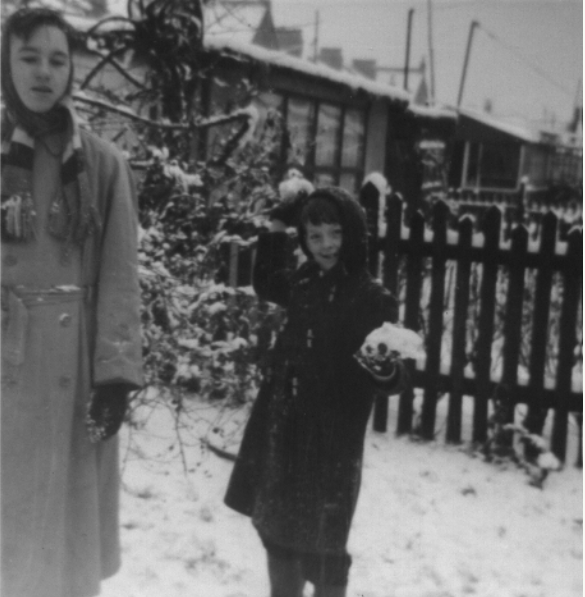
As we became older and more adventurous, so we started taking risks. Not so much risks of health and safety as in today’s society - more a risk of being caught ! The lure and sense of mystery over that fence or behind those locked gates kick started the magnetism of 'civil trespass' in me when I was about 8. It happens to all of us at some stage. My first incursion was into the Broomhills Field, with some mates to stroke the cows. So innocent and so trivial. It was my first positive and pre-emptied wrongdoing. I can remember the cowman shouting at us as we ran away - and my heart pounding as I went back to him. I thought I was going to be sent to Borstal (Homes for delinquent kids) and my family would be shamed for evermore. I was only slightly scolded and, in fact, praised for returning whilst my mates buggered off - leaving me to it. No Borstal.
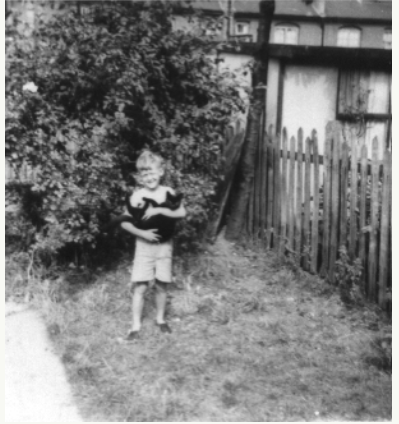
Maypoleman with cat - Tim - rear garden in Beaconsfield Road c1960
Afterwards I always made preparations for escape - coupled with an excuse if I ever got caught. You see, in those days, Maypole Estate was surrounded by fenced and gated places. Boys have a fascination with climbing, digging, holes, caves, water, trees, birds nests, catapults, bows and arrows and so on. It is in our genes and I knew there would be times when it would be impossible to resist. The next incursion was into the rear of Broomhills by the old Institute Hut. There was an air raid shelter we had heard about from the bigger boys and this challenge incorporated most of the aforementioned activities. Instead of climbing the fence behind Baldwyns Road we decided a safer approach was from the stream by the allotments, that ran form the dip to the A2. We could then go through the bushes along the boundary with Maypole House, past the Cowshed (Nissan Hut) behind Broomhills and along. The journey was fraught with difficulties - the first and foremost for me was cowardice. The fear of being caught still pervaded. I had promised the cowman I would never do it again. Then, I thought, it is not actually his field I am going back to. Simple in a child’s mind and this, I am sure, is the experience of many of us. You see, I had excused myself already. I had stifled and delayed that all important alarm bell in our heads. We did not venture on to Maypole House property as we knew Mr Stockford would catch us and take us to Mr Winter who had a gun and we would be shot. Much safer being told off by the Nurses from Broomhills. The cow parsley was high and shielded us most of the way. The nettles stung us the rest. We eventually came to this magnificent manmade cave. It was like a holy shrine to our achievement. None of us actually went in the first time as we didn’t have a torch and there must be dead bodies in there from the war. Such is the imagination of kids. The smell of nettles, cow parsley and the sound of buzzing insects always takes me back to this one escapade.
Below - view from my rear bedroom window at 2 Beaconsfield Road - I looked out from here c1964-1982. Taken 2006 - just before my father sold the house.
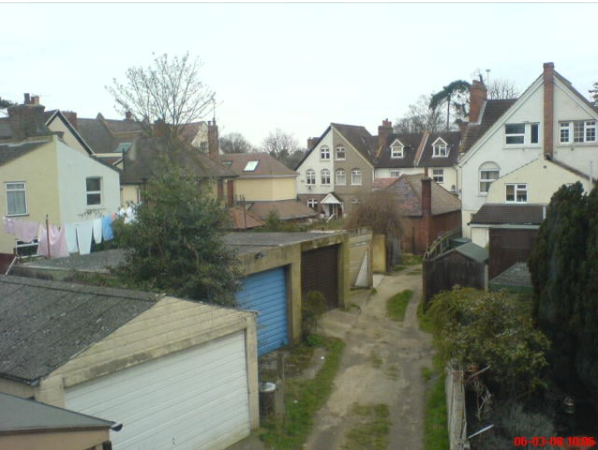
Below - contemporary sketch by Maypoleman 1967 of the air raid shelter entrance. The figures are not using it as a urinal but Kim anda friend entering ! It was known by us lads as the 'Skull' as the two doors were dark and like a pair of eyes.
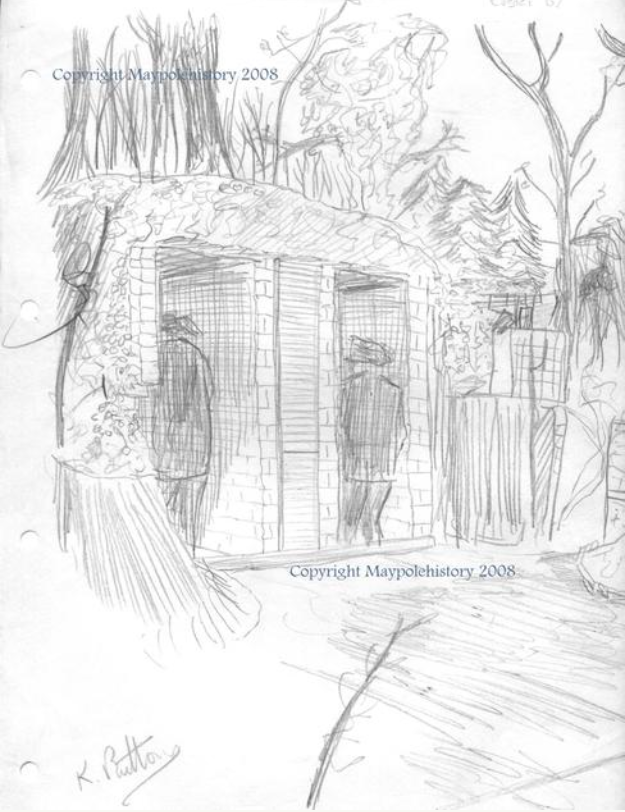
Below:- David Richardson (West Lodge Bexley Hospital, Alan MacLean (East Lodge Bexley Hospital) and Kim Button. Photo taken in 1967 in rear garden of Beaconsfield Road. We thought we looked so 'macho' !
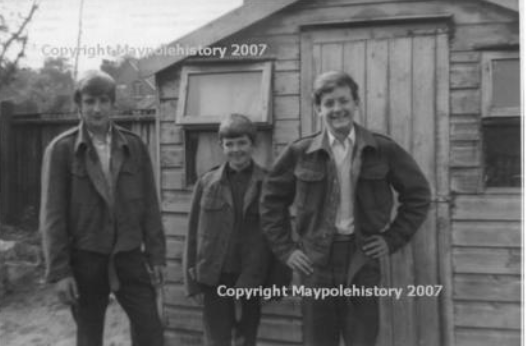
Not to be 'outdone' by Perran Newman . . . . .
Me on the Excelsior Talisman Summer 1968
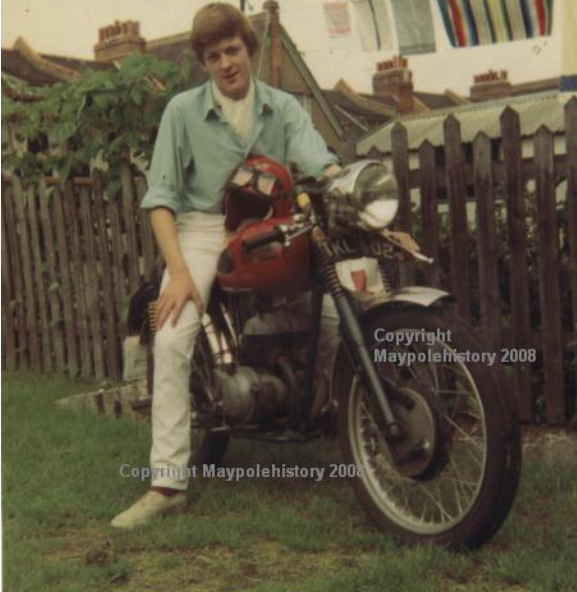
To be continued . . . . .
Original Recollections
My earliest recollections of the estate (c1957-1965) are
- Playing in the back alley of Beaconsfield Road with my first friends Keith Hawkes and Penny Smith. The back alley was our little world when we were small.
- Childrens games. Amongst the games we played were ‘Peep behind the curtain’ and ‘Cowboys and Indians’. I first learned to ride my bike when I was about 5 down the same alley. I thought dad was still holding me up as we trundled along. I turned round, he wasn’t - and I promptly fell off !
- My first day at the Maypole School. It was miserable - cried most of the first morning.
- The smell of coal burning from the fires in peoples houses in winter. Carrying a bow saw to collect wood over Dartford Heath with my dad. The smell of the damp leaves down the Dell and the fogs which always seemed to persist in those winters.
- Seeing Tom Gosling who lived in Baldwyns Road. He walked up and down the alley several times a day, every day, for what seemed years . He spoke with an impediment and wore very thick glasses. Would always say to us boys, ‘You allright boys ?’. He was a happy soul most of the time - always cheerily going about his errands.
- Piano lessons. Hated them. Went to a very large and ‘posh’ house in the Dell for this particularly brutal form of punishment.
- Playing with mud made in the old galvanised tin bath in my rear garden with Keith Hawkes. I remember it hung at the back of the house near the coal bunker - we all had those !
- Sundays. Hated them as well. Boring. Having to attend Sunday School at the Baptist Church along Dartford Road. Having to hang around all day whilst mum got the dinner ready. If I wasn’t in ear shot when it was ready there would be hell to pay.
- Teddy Boys. Was frightened of them.
- Playing in the long ferns over the heath and making camps in them.
- A horse being owned by Mr Pope - or was it Piper ? Big thing which pulled a cart. Don't know where he kept it. Rag and bone men on horse and cart shouting in a loud voice, 'Lumber, Lumber'.
- The Salvation Army coming round playing carols at Christmas.
- The Esso Blue Man. (Or was he the Esso Blee Dooler ?)
- Don the veg man who came round in a van
- The man from the Pru - collecting weekly insurance subscriptions - in cash !
- The annual Sports Day in the summer in Broomhills / St Barnabas
- Collecting wood / garden waste from residents for the annual bonfire on trolleys - and getting up to half a crown for doing it. This went towards our fireworks. Can remember knocking on doors asking if they wanted any rubbish taken over. Can remember the delight of counting out the coppers at the end of a fruitful Saturday.
- Neighbours collecting money for wreaths for any neighbour who had died.
- Watching traffic on the old A2 as a passtime on Dartford Heath
- Standing / sitting on the pavement outside the cafe waiting for cars so we could collect 'car numbers'.
My recollections of Maypole school (1958-1964)
- The smell of pencils, crayons, wax and that ghastly floor varnish after the summer holidays.
- George Stockford - the caretaker. Grumpy but kind. Always wore a trilby hat. I remember being chased out of Maypole House grounds by him a couple of times. He worked there as well. He seemed to be everywhere to catch us out!
- The Institute Hut in Baldwyns Road which acted as an ennexe to the school. Miss Hunt who taught there. The smell of the gas fires which hung on the side walls. The creeky steps to the kitchen at the back.
- Fractions and how Miss Alley was there when they finally clicked.
- Teachers - Miss Janet Lee, Miss Tozer, Miss Alley, Mr Deer, Mr Hembury, Miss Tilyard ?, Mrs Cridge, the Headmistress Mrs Chambers.
- Playing ‘British Bulldog 1-2-3’ and ‘It’ in the playground.
- Racing matchbox cars down the straight behind Barratts shop.
- My classmates, David Richardson, Philip Read, Penny Smith, Michael McKeogh, Jeremy Stevenson, Brian Hunt, Ann Martin, Stephen Cooper, Jacqueline Grossman and Terry Warner just to name a few.
- The bad winter of 1963 - school closed for several weeks.
- The clay bins in the cloakrooms and the glorious feel of fresh clay between the fingers.
- Milk - being placed on radiators in winter to defreeze them. Aaaagh.
- Nature Walks on Dartford Heath.
- Country dancing to an old gramaphone - double Aaaagh.
- Listening to teachers reading to us - bliss.
Later recollections from childhood / adolescence c1965-1970
- Heath fires, fire engines and that peculiar damp, earthy, smokey smell as it was being extinguished.
- Heathwood Lodge and Mr Whitehead who always wore a beret and always had a bike with him. Going down the deep well at the side of the old house when he had moved out in the summer of 1967.
- The long creeper vines in the Dell. We tried smoking them - makes me shudder now.
- The incredibly high rope swings attached to one or two trees down the Dell. Fantastic. The older boys - Ronny Potter and co. put them up there. I always thought they were so brave. Remnants of the ropes still exist high in the boughs, after nearly 50 yrs !
- Broomhills and it’s frog ponds to the side, the field with the cows to the front, the Cow Shed and air raid shelter to the rear. Daring each other to see how far up the private drive we could go without being caught by the nurses. Collecting conkers after school which we dislodged by throwing sticks - this became an art after a while.
- The first sodium street lights along Old Bexley Lane on the way to Coldblow Crescent c1961.
- My Mums Coop Divi number (20592 ?) which I had to give to Mr Chipperfield at the Butchers in the Dip.
- Building a dam in the stream at the bottom of Broomhills field, opposite the shops at the 'Dip' and being told off my the ladies hairdresser, Mr Sweet ?c1963
- The annual Bonfire over the heath and the ceremonial lighting of it by ‘Buster’ from Denton Terrace.
- The tragic news of Steven Parker from Beaconsfield Road being killed on his motorbike (c1965?) . This hit hard at us younger kids who thought the older ones were invincible.
- The café and the ‘pinball’ machines. The jukebox and records of the time being played to death.
- Catching lizards, grasshoppers and slow worms over the heath.
- The sound of the single bell tolling on a Sunday at St Barnabas Church.
- The sound of the hooter from Bexley Hospital which wailed once a week - a fire alarm but we kids thought it was a warning that a patient had escaped.
- The 401 bus running every half hour and costing children 3d to go to Dartford. The red buses from London on Sunday which used to bring visitors to the Hospital. They would park 3 at a time on the heath waiting to return.
- Heathkeepers in their uniforms and the glory bumps and sandpits over the heath where we used to ride our bikes. The old buildings at Leyton Cross on Dartford Heath where the gun implacements used to be.
- Other mates from those times - Alan Booth, Tony Smith, Michael Morand, Karen Smith, Ronnie Gosling, Alan MacLean, Peter Walker, Peter Garman, Chris Giles, Robert Hogan, Johnny Barrett, Edward Ginn, Deborah Battleman, Steve Judd, Chris Richardson, Paul Richardson, Philip Hayward and many more.
Memories of Susan Kirby
My memories of my school days in late 1940's are of having to sit a test every Friday. Your seating position for the following week was based on this. The highest scorers sat at the back. One week I was away for the test and had to sit in the front row, instead of my normal back row seat! The shame still haunts me! Goodness knows what it must have been like for those who normally felt total failures.
Memories of Audrey Jackson
Maypole School 1939-1945 Audrey Jackson (now Hughes)
I lived in North Cray Road, Bexley and my parents obviously preferred the Maypole School to the village one (where I might have become accepted by my peers rather than "stuck up’ which took some surviving!) I should have started school after Christmas, but whooping cough kept me home until Easter, so I had just one term in school before the war started. My first day is fairly vague, except the teacher seemed rather elderly and rather distant and the boy next to me made a puddle on his chair - what kind of a place was this!
After some six weeks in North Wales at the tiny cottage of Auntie Mae in Penmorfa, we decided the invasion scare was a myth and the family returned to Bexley, where my parents became fire-watchers, we acquired a displaced person for a lodger, then mother went to work for the Ministry of Food and father eventually went away to police Avonmouth Docks. The Anderson shelter arrived and was soon full of water and frogs (we used the cupboard under the stairs instead). Air raids became commonplace, most of our window glass was replaced at least twice and my shrapnel collection grew. At school numbers had fallen because of evacuation and for some months about a dozen of us met for a few days a week at the house of Sylvia Guiselman in Baldwins Park for our lessons.
Eventually children returned and school reopened with an underground shelter in the playground and an overground one behind the hall. I see it is still there as a store. I was then in Miss Cousins’ class and seemed to be there for ever. Perhaps it was more than a year because of the disruption of evacuation.
I suspect it was here I realised I hated needlework. It must have been only one afternoon a week, but seemed endless. My dishcloth knitting improved, however, and I still remember the stitch, so impossible to rescue if you made a mistake. Here my ability to drink large quantities of very cold milk increased, as I surreptitiously consumed that which others hated.. I was really looking forward to moving up a class to where one could play on the other side of the coal hole, as "chasing" was my favourite game (my skipping was indifferent, but improved later). Poor little round, worried-looking Miss Cousins, she seemed so serious and hardworking, then she would walk both ways to and from school, much further than I went on the bus (a penny fare, I remember, on the 401). Just occasionally I would walk home for lunch with my grandmother, but blotted my copybook seriously when I stopped to play on a sandhill near the gardens of Hill Crescent with Ursula Ayscough and was extremely late.
We also used to walk down the dip to catch the bus at Baldwins Park instead of at the Hospital, when the game was to keep ones feet off the pavement all the way and this entailed walking along the sloping top of the wall on the right. I remember seeing a wheel from a tractor which had fallen off and hit a pedestrian (possibly fatally) and the retribution that fell when I lied to my mother about throwing Hugh Hawes’ hat in the road when there was a car coming and Alan Coast reported me – I guess I deserved my regular smackings!
At last I moved up to Miss Burr’s class and I was very happy and comfortable there. I’m fairly sure she lost her fiancé during the war, but I believe she only took one day off. Finally it was the top class with Miss Gaspar, our fierce headmistress, she of the heavy hand, ruler and cane for our misdemeanours. I must have been a great disappointment to her, as I was regularly "top of the class" and, just as regularly, smacked for talking too much, for shaking Norman by the hair for letting our team down in PT and a good many other sins.
I remember wearing a school uniform of brown gymslip and beret with brown lisle stockings in winter, well darned at the knee because of my occasional weak ankles. I remember being fairly cold in class in winter and sometimes sitting in our coats – sitting on the radiators would have produced some terrible unmentionable disease! I remember school concerts where I usually ended up reciting poetry wearing some unsuitable costume I had begged from a friend – I still blush at the thought of the fairy – definitely not me. Each year I seemed to catch the going "bug", measles, chicken pox, mumps and finally german measles, but none of them were particularly bad and just gave one a boring four weeks at home.
In school I remember the crowded cloakrooms, one at each end of the building and the smelly outside toilets, where you could watch the boys "perform" if you were so inclined, as there was a wide gap opposite their urinal area. The back playground was always shaded and damp and we never used it. We drank our milk on the verandah (open air then) and in the top class we took turns to make tea for the teachers. Playing chasing or release-oh, I managed to fall and cut my chin on the wire round the air-raid shelter (I still bear the scar), but there didn’t seem to be many accidents. We were very well drilled in filing out of class and down the steps when the warning sounded and often we would hear the anti-aircraft guns open up from the other end of Dartford Heath. One day from home we saw a plane crash out of a dogfight and hoped it was "one of theirs", but it wasn’t and on the way to school next day we could see the wreckage in the garden of a house near Baldwins Park junction. The pilot parachuted safely, but was caught up in a tree in Joydens Wood for a while.
Towards the end of the top year we went to the County School to "do the Scholarship". After the Maths, English and General Knowledge papers, a group of us walked back from Shepherds Lane to the Maypole, calling in at John Sharman’s house on the way for a drink of squash. I told my mother about it afterwards and she was surprised I was so unruffled by the experience, but we had so many tests, it did not seem much more than a day out. After I knew I’d passed, however, it must have gone to my head, as I was caned or spanked every day for the next fortnight!
I remember quite a lot of names from my class, Peter Lane, who was always top boy and, I heard, went to South Africa, Beverley Thompson, a clever girl, a year ahead of her age group, who came to Dartford Grammar School for Girls (the name had changed by then) a year after me. Michael Walker was the only one faster than I was, Clare Hayes and Megan Foster came to DCS with me, Ian Hellyer, John Sharman and John Charman, Hugh Hawes, Ursula Ayscough, George Clack, a Neil, a Norman , an Elsie and a Hazel (I think) also just a few older and younger ones, but it was all a long time ago……….
Mum later worked in the stores department of Bexley Hospital for a while and bought a bicycle for me from a colleague after my scholarship. I still have the letter from father agreeing it was a good idea. This started my interest in cycling, first with dad, then with the Cyclists’ Touring Club and it is still my chief hobby after 50 years.
The Maypole (and most of Bexley) seems to have shrunk since I attended school here. I’m sorry it has been demolished, but it is much too cramped for the number of children it serves now, so I wish its successor a great future.
A Path I Remember
We would walk towards St. Mary’s church from my house, Hawthorn, in North Cray Road, just up from the Coach and Horses with its big Sandemans advert, which looked just like our vicar in his wide brimmed hat, and where I learned to ride my neighbour’s bike in anti-clockwise circles. Our house was opposite the fields at the more respectable end of the road, above the labourer’s cottages, next door to a canon and his wife, who had a cook and a housemaid pre-war, but below the big detached houses. Opposite to, but near the church was the shop; nowadays we might call it a poodle parlour; where my doggy friend would bath and trim the local poodles, including two huge ones belonging to Dorothy Squires, who would let them swim in Chislehurst ponds. Here I would also collect a dog or two for walking before I was upgraded to part-time, poorly paid, weekend kennel maid.
Turning right at the church I would take the path between houses to parallel the boundary of the churchyard, where I guess granny and granpa Jackson still rest, though now sadly crowded by the later additions. Where the path then crossed open fields there was a left turn footpath to the bypass, where I once sinfully rode a horse because it ran away with me! The path continued to a fork. Left was rough and led to Wansunt Road, I think, coming out by the home of the aforementioned poodles. Right was the "Tinkly Path" – I don’t know if anyone else called it that or if it was a family name, but it describes exactly the echo made by footsteps on the tarmac suface between high walls.
From here there was a stretch of road, possibly Heath Road now, close to a private school (St. Michaels?) with which we had a continual cold war and leading to an orchard, where we often purchased fruit in season (and regularly searched vainly for holes in its fences in order to scrump). There followed another open field path across to the woods, at the edge of which was a stile. Sitting here it was possible to get a most successful echo across the slight valley and we spent a happy half hour one evening doing just that. Next morning at school we were hauled over the coals once more for disturbing the patients at the nursing home at Coldblow by our shouting and screaming and generally unladylike behaviour – life was pretty unfair in those days….
On a good day, however, we would continue up into the Dell and over Denton Road onto Dartford Heath with its endless amusements, house-building amongst the heather, riding over the Glory Bumps and very rarely glimpsing some unfortunate inhabitant of the Asylum, allowed to take the air on the Heath and actually removing most of their clothes to do so. We were a pretty hardy lot in those days and didn’t seem to come to much harm from our freedom. How different from our mollycoddled grandchildren! Anyway after this long walk it was obviously time to catch the 401 bus home. Where I now live there is probably one bus a day. Then we had a half-hourly service – so much for progress!
Audrey
More links to Audrey
http://www.bbc.co.uk/ww2peopleswar/user/08/u1507408.shtml
Memories of Tony Helyar
This is an edited extract from my autobiography
On the edge of Dartford Heath, across the road from Bexley Mental Hospital, known to all in those days as the lunatic asylum, was The Maypole School. At the time a modern primary school with large, airy, well lit classrooms, an assembly hall and cloakrooms all interconnected by means of a veranda running the whole length of the building. The toilets however were across the playground and on rainy days you got wet, the boys more so since their urinals were not favoured with a roof. This establishment was run with meticulous efficiency by the head mistress Miss Gaspar and I joined the infant's class at the age of five. I think I enjoyed the school, I can't remember ever thinking I would rather not be there. We walked of course, in my case about a mile but some much further, and home for the midday meal. Plenty of opportunities to get wet but the classrooms were well heated, in the winter we thawed out our daily milk on the radiators.
One day, running into the road to retrieve a toy glider, I went under the hooves and wheels of Mr.Chalice the greengrocer’s horse and cart. I wasn't badly damaged and when I realised that the worried Mr. Chalice was carrying me into the lunatic asylum for attention I beat him so furiously round the head that he was forced to drop me and I ran all the way home. On another occasion I was not so lucky. I ran out of a classroom, completely against the rules, head down, straight into one of the iron girders supporting the veranda. My mother took me, swathed in bandages, on the bus to the Woolwich War Memorial Hospital at the top of Shooter's Hill where I was gassed into unconsciousness for the insertion of five stitches.
In 1941 having reached the age of eleven I joined the top class at the Maypole School, taught by the redoubtable Miss Gaspar herself. She was marvellous, she was the school, and it ran like oiled silk. She was a portly lady and always wore a modesty but she took us out onto Dartford Heath to play football occasionally, girls and boys. I remember once during morning assembly an irate mother stormed in to the hall and started shouting about some injustice done to her child. Before anyone had time to think Miss Gaspar set sail across the room, swept up the angry parent and ushered her out. Nothing was permitted to upset morning assembly and All Things bright and Beautiful never missed a beat. In her class at the end of each week all the marks were added up and the class positions announced and everyone moved to their place. I never got higher than seventh.
The walk home from school was over the puddles at Beaconsfield Road, which was unmade at that time, past Vines Post Office, where if your Mum had come to meet you she could sometimes be persuaded to buy you a halfpenny ice cream cornet, on past the little row of shops with Chalice’s the greengrocers, and an electrical shop where in later years I bought parts for wireless sets and where I first came across the Radiospares catalogue which then had a hole in the top left hand corner so it could be hung on a convenient nail (it is now in six thick volumes and weighs the best part of 20 lbs.), past the red railings soon to be removed to turn into tanks, down the hill and over the road into Baldwyn’s Park where I lived at No. 44.
There were a few shops at the end of Baldwyns Park, where it joined the main Dartford Road, and these could supply most of the community’s day-to-day needs. Baldwyns Stores was a grocer's where bacon was sliced, butter was patted, and sugar was weighed into blue bags. Biscuits were displayed in their glass-topped boxes along the front of the counter and there were a couple of bentwood chairs for the lady customers. On the opposite corner was Wesborn's, a franchise of the Fourbuoys confectionery firm. Mr. And Mrs. Wesborn sold chocolates, sweets, newspapers, magazines, and tobacco and ran a small lending library. They also operated an accumulator charging service.
Although almost all the properties in the neighbourhood were connected to the mains electricity supply there were still some folks using battery powered wireless sets and these required accumulators, a 2 volt battery cell in a thick glass container filled with an acid electrolyte and with two screw terminals on the top to allow connection to the relatively high current filament or heater circuits of the wireless valves. These accumulators required charging every week or so and it was common practice for a local shop to provide this service for a few pence a time. The high-tension supply for the wireless was supplied by a large 120-volt dry battery that had to be replaced occasionally. Some of these battery powered wireless sets used valves which required a third power source, a grid bias battery. This was a small dry battery with tappings at 1.5, 3, 4.5, 6, 7.5, and 9 volts; the particular voltage required being specified by the wireless manufacturer. Usually, when an area was connected to the electricity supply, these battery wirelesses disappeared quite quickly since mains operated sets were cheaper to run. However for people who did not wish to purchase a new mains operated set there was an alternative, the mains eliminator. This was a mains powered unit which provided low and high tension outputs which could be connected to the wireless in place of the battery and accumulator connections thus achieving the benefits of mains operation without the necessity of buying a new set.
Next to Wesborn’s was a branch of the Dartford Industrial Co-operative Society that comprised both a butcher's and a grocer's. Mr. Chipperfield and his wife ran the butcher's. Mr. Chipperfield was a big round man and you could tell he was a butcher because he wore a blue striped apron and a straw hat and he had only three fingers on his left hand, the fourth lost in his sausage making machine so the story went. There was always plenty of clean sawdust on the floor of his shop and when you paid the bill he put the money into a pot that fitted on to an overhead wire and when he pulled the handle the pot flew through a hole in the wall to the cashier in her glass cubicle in the grocer's next door. After a while the pot came back with your change and a cheque for the 'divi'. Next to the Co-op was a small draper's and haberdasher's and last in the row was a shop which was bricked up and strengthened to be an air raid shelter during the war but afterwards was converted to a fish shop by Mr. and Mrs. Elsey.
I remember many names from the Maypole School top class in 1941: Kenneth McCauley, Geoffrey Mayer, Alan Coast, Norman Brooks , Sheila Hamer, Joy Linsdell, John Chalice, David Cruickshank, John Chipperfield, Gordon Lennox, Marie Walpole (who eventually became my wife), Sheila Cone (emigrated to Australia), Clive Kidd, Joan Rivers, Derek Wise, Colin Hayes, Irene Turner, Bob Bailey, Jennifer Bell. Post Maypole I played tennis at weekends with Colin Hayes, we used to get down to the courts in Bexley very early in the morning so getting in an hour or so before the groundsman arrived demanding money. Colin sadly died whilst still in his teens. Following on from the Maypole reunion in July 2002 I received a long letter from Gordon Lennox in New Zealand and he subsequently did a lot of genealogical research on my ancestors – it was easier for him to get to the family history centre in Christchurch NZ than it was for me to get to the UK centre in Islington! We exchanged many memories via the Internet, he sent me a photo of the Leyton Cross Football Club 1947-48 which includes many names from my list above. Very sadly Gordon died in 2004.
My wife and I occasionally passed by the school on the way to visit friends in Bexley and apart from the traffic nothing appeared to have changed very much. On our next visit we will be saddened to see that the school has gone.
Memories of Ann Martin
My memories
First day thought school was OK but hated the fact that my mother left me in the playground completely on my own and I just did not know what to do! The next day I cried as I did not want to go to school everyday. I enjoyed school until I was in Mrs Cridges class and I did not like the way she shouted at me and told me I was stupid (which I am not!) I have very fond memoreis of Miss Alley and Miss Tozer who made school more happy. There was also a nice male teacher who remembered me at the re-union.
I remember Kim (BUTTON) as being one of the boys who actually talked to you and Philip (READ) who was going to make me a necklace from sugar crystals! It was lovely to work with Kim on the re-union and to meet up with Philip again. I had my first girlish crush on Mark Bradley as did a lot of the girls as not only was he good looking but nice to the girls! Life moves on but I will never forget the good teachers and the lovely friends I made like Shelagh Russell and Nell Axon. More recently some of us have met up from time to time which has been nice.
Memories of Pat Richardson
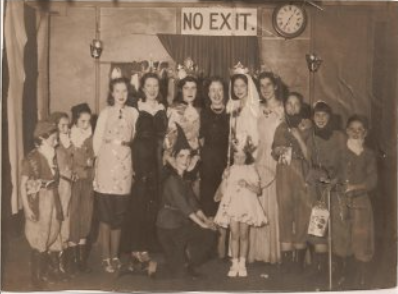
I still am having a wonderful time browsing thru' the Maypole web-site. I found this photo that I thought you may like to use. (It's a bit the worse for wear, but the people are still recognisable. It was taken approx l947 when we had a pantomime (Snow White and the Seven Dwarfs) at the Institute Hut in Baldwyns Road. It was the highlight of our lives then, and all put together by Joan Houlton. I will list the "actors" left to right.
Nancy Beck, Dorothy Whitehead, Barbara Whithhead, Pat Flett, Sonia Windmill, Audrey Houlton, Joan Houlton, Marion Parker (Stephen NZ sister) Betty Cruickshank, Pat Richardson (me) Barbara Houlton, Janice Scott (dec'd)
FRONT Row Roberta Cruickshank and Sheila Houlton.
Kindest regards and best wishes
Pat (Richardson) Bromham
Memories of Sheila Houlton
The memories of my childhood always contain trees. Slippery Jack was a challenge to all. I was determined I should get up the trunk of this hawthorn tree - just as well as Barry Collins! It took me a great deal of effort but I did it. Whoever invented the pastime of climbing to the highest possible branch, easing oneself out to clear the trunk and then - dropping! - ? We spent many hours over "The Action" which was a clearing between the 'middle road' and the road to Leyton Cross. There were many trees, to cater for all abilities, there. The eighth elm, in The Dell, was hollow and on occasions there were as many as half a dozen of us kids, swarming all over it. If our parents had seen us, especially looking into the water-filled hollow, they would have had heart attacks. I also remember going with my sister Barbara over to the Penny Royal (Glory Bumps) and catching newts. We never had a bike, so couldn't go flying over the Bumps but still, it was lovely just to spend the day wandering over the Heath.
I remember the winter of 1947. I was five years old and really wanted to go out to play with the other children, although Mum said it was too cold and I wouldn't like it. I did get out there and there was a 'slide' of ice outside Carlton Ball's Dad's garage. This was about ten feet long and was really something! My brother Dennis took our bookcase out, down the Dell, for tobogganing. He took the doors off it and the boys carried it up onto the Heath. He couldn't have damaged it, surprisingly, because I remember it there, after the War.
Does anyone remember the patients from Bexley Hospital? "Sunshine" always had a cardboard attache case stuffed with comics and we kids would clamour round him and find a spot - usually the pit near The Dell, to sit and swap comics with each other. Lovely, lovely days.
In 2002, the Maypole School had its last reunion and I was absolutely delighted to meet up with 'boys' and 'girls' I had last seen in 1952. We left the Maypole to go to Dartford in October that year and I hadn't seen most of them in 50 years. They came from all over the country and even Canada and Australia. It was wonderful to reminisce that afternoon in the Black Prince lounge. Later, in the School, we met up with other long-lost school friends. The Maypole holds many memories for my older sisters and the photograph of the pantomime, produced by my big sister Joan, brings back wonderful feelings. We were a community, knowing everyone and caring for all.
Sheila Lusher (nee Houlton)
ex of Baldwins Road
More memories of Sheila Houlton (Updated 18/12/07)![]()
I remember all your contact in 2002 when we had the final school reunion. I met up with people (girls I remember in short skirts and white socks, and boys in short trousers!) who had all grown into lovely people and had come from all over to meet up with old school friends. I am in touch with Evelyn Lott, Eileen and Jean Rivers, Pat Richardson, Pat Davies, Edward Wooldridge and met Carol Slade and Donald Collins at the reunion.
My sister's friend in Tankerton sent the details of your site to her, and to another friend of hers, and they passed it on to me. My Maypole years were wonderful and a more idyllic childhood I couldn't have wished for! We were such a community in those days of wartime and into the 50s that it would be sad for it all to be forgotten. Mrs. Wibley, dear lady that she was, organized a trip to Margate or Ramsgate every year and it was the highlight of our lives.
There are so many memories I have. I went to school with Tony Winter; a very kind and 'gentlemanly' boy, even as a child. Will Beck said that Tony's chauffeur-driven car would take him to school each morning and called for Will (on Denton Terrace, not 100 yards away) to give him a lift to school, too! I moved away at the age of 10. The picture shows which used to be put on in "The Hut" were always joyfully received but I can remember being told when one was due and I said, "Will there be Laurel and Hardy?" Only to be told, enthusiastically that this was so. I was terrifiedof them! They always got into such scrapes that I would sit through it all in absolute agony.
I believe my niece's (almost) daughter-in-law's mother lives in one of the bungalows at the bottom of Beaconsfield Road right now. How strange, the connection as our family, just prior to my birth in 1942, lived in the same bungalow! Maypole House was a beautiful old house and we were all sad when it was pulled down. My sisters and brother used to work on the market gardens which belonged to the Winter family, and picked bushels of tomatoes, etc. Mum went to work at Rolex as their Cook when the new factory opened. Mrs. Rivers and Mrs. Ball also worked with her in the kitchen. I believe these ladies are now all gone.
I wonder if anyone out there remembers a dark-haired, shy girl who was brought into our classroom (those born in 1942) one day, and we were told her name was Elizabeth (Chapman, I think) who had come from Singapore. We'd not heard of Singapore - well, most of us hadn't - and certainly the significance of it was lost on us. Elizabeth lived at Coldblow and we were asked to be very kind to her. I remember her as being a brief interlude in my life. I wasn't asked to look after her as I lived on the Maypole but she was with us for only a brief period and then disappeared. What happened to Elizabeth?
Anyway, I do hope the site is visited by many people. Long may it continue, and thank you for your efforts. Best regards, Sheila Lusher
Another memory is of taking eggs (camouflaged inside a woolly jumper wrapped around them) to Mrs. Challice - and braving the large alsation chained in the yard - and she would give me a packet of something equally disguised, to take back to my mother. The package contained tea, which was rationed, of course, and since we had chickens and they had more tea than they wanted, it was a straight swap! This happened quite often and I suppose I was chosen to do the errand as I was little (born 1942) and wouldn't draw too much attention. I didn't know about black market rules in those days and when I did hear the words, I visualised everyone in black clothes, under black awnings, with scarves over their faces! Innocent help between neighbours seemed much less intriguing.
Does anyone remember Mr. Pope with his dapple-grey horse going up the middle alleyway between Beaconsfield (where they lived) and Baldwyns Roads? Sylvia, the second daughter, used to whistle her way all up and down the alleyway and would drive my Dad mad. It was when she started to yodel that he nearly blew a gasket. Happy days!
A memory which is in the depths of my mind is that of someone called Granddad Fielder. He used to 'charm' warts away and honest injun, he charmed one of mine into disappearing. I can remember Mum taking me to see him and he chanted over it something like, "When the moon fades, your wart will fade." I can't have been any more than 3 or 4. I remember his funeral (I think it was his) and there was a black carriage with glass sides, drawn by black horses. I can see it in my mind's eye, passing the end of the alleyway, going along Heathend Road.
More added 28th January 2008 -
My Maypole years are stored in a 'rosy' pocket of my memory. I'm sure no other children had as good a time as we did, isolated as we seemed to be from the surrounding big towns of Dartford and Bexleyheath. It was an adventure to go down the 'dip' to Old Bexley and stamp our feet along the alleyway from Coldblow to the cemetary of St. Mary's Church in Bexley to buy fivestones but I had to be six years old before I was allowed to go with Eileen Rivers (3 years my senior). I remember walking over the Heath to Crayford Dog Track with my Mum and Dad once or twice (and I would have been about four years old). One night a thick fog had come down before we returned home. We used to have a treat of fish and chips from the shop in Crayford and were glad of the warmth of the chips in our hands. Dad was worried about finding our way home and I, being quite certain of our safety, said, "Don't worry, Daddy; Jesus will guide us home." I didn't understand the silence and the choking which followed, until I was quite grown-up!
E mail received on the maypolehistory website April 2008
It's so lovely to be in touch. I'm also in constant touch with Fran Gemmell (known to all of us as Frankie back then) who also came to the reunion. I was enjoying Fran's memories of Baldwyns Park and the shops 'down the dip' and remember the fish-shop people, the Co-op (Mr. Chip in the Butchery section) and the Hendersons who had the newspaper/sweet shop which grew into a large emporium in the early 50s. In the first bungalow past the off licence lived Michael Bean. His father, I believe, was in the diplomatic service and I never saw him but Michael and I used to play after school in his back garden, in which there was a dene hole. We were very careful to avoid that. I have an absolute hatred of going below ground and avoid the underground railways in London. There was an air-raid shelter outside the school gates when I was a child. We used to enter down a few steps and it wasn't deep - in fact the ground was mounded up over it. It always smelled so horrible and although I was the first up a tree, I always hovered around the entrance of that place. Do you remember the air-raid shelter? There were some large trees there, as well. I don't know when it was all levelled.
19.4.08 Taken from Sheila's profile
I was born in 1942 and had the most wonderful childhood, with Dartford Heath being an extension of my back garden. I married John in 1961 at the age of 19 and we had almost 46 years of marriage which was cut short last year by his death. I live in the house we moved into as newly-weds and will do so until I can no longer cope with the D.I.Y. indoors and out. Mum and Dad had a mobile cafe on the Heath for about four years. Does anyone remember the day an Army battalion arrived for refreshments at Dad's cafe, and blocked up the whole of the road from Denton Terrace to the A2? I was the youngest of 6, having four older sisters and a brother. The oldest of my sisters died in 2002. That was Joan, who produced the 1947 pantomime Snow White. Audrey (sis) was the Principal Boy, Barbara (sis) one of the dwarfs and I (only 5) was the fairy who opened the production. Happy days!
More added 26th May 2008
Having read Stuart Grieve's memories of the school, he mentions Miss Torrey. She became Mrs. Hinckley. Mrs. Poole was my first teacher, with her prematurely white hair and her blue suit, I loved her. Miss Bean was next in the chain and did, indeed, have a whiskery chin. She wore her hair in a tight little bun and wore a navy striped costume (suit) with a long skirt. Miss Butler came next. She was tiny and blonde and we we all romanticised about her marrying Mr. Davies as they used to ride off on their bikes across the Heath, on the way home. Mr. Davies was a wonderful teacher: best ever, I thought. He brought Worzel Gummidge and Saucy Nancy to life for us, with his readings. He was a giant of a man (to we little-uns) but so kind and fair. Mr. Davies' classroom was next to Miss Butler's. Then came Mr. Rees. He was a small Welshman and quite vicious. He would throw chalk, books, the board eraser, a shoe - anything which came to hand if he thought someone wasn't paying attention. He once kept me in at lunchtime because I had committed the sin of needing the toilet during a lesson! My father arrived at five past twelve and told Mr. Rees what he thought of the situation! We won't go into that. Then, there was Miss Burr in the top class. She was Miss Gaspar's friend and they were very much a team. She was very strict indeed and every week, we had a test to determine our class position. Miss Gaspar I avoided! When I left at the age of 10 to move to Dartford, I was most surprised to find out that I had 'passed the prelim' which was the first part of the 11+ but had not known I was doing it! The weekly tests at the Maypole had prepared me well. However, no Grammar School for me; I went to Dartford West and then the Tec, where I was very happy. Some teachers make schooldays enjoyable but we all remember those who don't!
The Tea Stall on the Heath
When I was seven years old, Mum and Dad dragged me all the way to Upper Norwood to look at a cafe which was unoccupied and which they hoped to turn into the cafe of their dreams. It was horrible and after Dartford Heath (my own back garden!) I hated London. Fortunately we didn't go and they then had a small caravan with a hatch opening and set up business on the corner of the Heath near Bexley Hosp. They'd only been open a couple of weeks when I got chicken pox and Dad wheeled me home in a (wooden) wheelbarrow so no-one would see me, as it was discovered whilst I was at the cafe with Mum. They sold tea and cakes, pasties and pies ALL HOME-MADE and did a roaring trade, especially on Saturday and Sunday visiting times. After about a year, Dad acquired a bigger van - a refurbished and customised ex-Army lorry. They added a wooden lean-to so that lorry-drivers could sit in shelter. Tea was tuppence- hapenny a cup and Dad insisted it was good and strong, so I don't know what the profit was on that!
The whole family were dragged in to help with washing up and serving and Mrs. Beck (Will's Mum) came to help as well. Unfortunately, she contracted TB and had to go away for about a year. The lorry was by this time parked almost opposite the Dell, just in front of one of the large craters. I remember going up Heathend Road on summer mornings, just as the sun was rising over the trees, to have a fried-egg sandwich for breakfast, before going to school. What bliss! The day the Army arrived, we were so excited! (of course, poor Mum had to do baking the whole of the preceding day so it wasn't exciting for her!)
On one occasion, we were broken into and sweets, cigarettes and drinks were stolen. My brother found the culprits - an A.W.O.L. soldier and his girlfriend, who were canoodling on the bench up the Middle Road, opposite "The Action." They'd left sweet papers and other debris, so it was easy to identify them as the thieves. Don't know what happened to them. We used to have an Anderson shelter which Dad resurrected from beneath the back garden, and used it as a shed. In this shed, which was UNLOCKED, believe it or not, we had a large freezer from which we sold ice-creams. We sold Papa's icecream and the ice lollies and choc-ices were wonderful. Choc-ices were 6d. and the lollies were 3d. The freezing was done with Cardice which came in large flat blocks which we were warned not to touch. No electricity used to power that freezer.
Mrs. Challis was not a well lady and my Mum used to send me to her with eggs (from our chickens) in return for tea (for the cafe) as Dad insisted in a strong cuppa for the lorry-drivers. They were proud of their 'produce' and of their service with a smile. Everything had to end, in 1951/2 when the owner of our house at Baldwins Road wanted to have the house sold without sitting tenants, so we moved to Dartford on 1st October 1952. I thought my life had ended. Dartford hadn't got half the joy of the Maypole Estate!
Memories of Perran Newman
Wansunt Road and Maypole School Memories
January 2008
Now that the Christmas rush with families has passed I thought I’d put ‘pen to paper’ and submit some of my own memories about the Maypole School and growing up in Cold Blow, Bexley. I was born in 1946 and so I left the Maypole in 1957.
One never forgets one’s first day at school and my abiding memories include, never seeing so many children in one room, the kindness of teachers trying to make everyone feel at home and trying to keep close to some of the children one already new.
Later on the smell of milk became a strong memory and the anguish of having to eat everything at school dinner. Various subterfuges were employed like hiding bits of gristle under the knife, dropping things on the floor and waiting until one of the kinder helpers was taking away plates. I so disliked the taste of liver that I didn’t eat it for perhaps the next twenty years. Now of course, with an adult palate it is very acceptable !
I can remember learning to write ‘joined up’ writing. The particular time that I can vividly recall, I was sitting in the canteen (was this an overflow classroom), with a metal knibbed pen and an inkwell, forming long lines of joined up f’s and g’s. This visual memory is so strong that I can feel the sun coming through the window and smell the ink.
Other classroom memories include reciting the ‘times tables’ which hung on the wall and the sheer enjoyment of ‘art’ when the powder paints were handed out.
Learning to read is something I still remember and this was in the main hall, standing beside the teacher at her desk whilst I read to her from a Beacon Reader book as her finger moved along the words. That same hall was where I sat my 11+ exams with all it’s strange questions which included matching shapes with unusual orientations. I’m worried to say that I didn’t pass the exam to the standard necessary for Grammar School entry but was directed towards the Dartford Tech. At this point my parents decided to dig deep and I went into the private system, attending prep school at Merton Court in Knoll Road, Sidcup. Suffice to say that I was somewhat of a ‘late bloomer’ eventually making it to University and an Engineering Honours Degree.
Playtime is never forgotten – we started off in the smaller playground with the seemingly immense wall that formed the end of the shops. Later we graduated to the big playground and I can still see the soft red brick wall with it’s carved names. The pain of falling on one’s knees on the playground surface, playing marbles and winning a beautiful multicoloured red which I kept for years. Dinky toys – the racing car models in particular, Talbot-Lago and Copper-Bristol are names that come to mind being ‘scooted’ across the playground surface.
On one occasion I was sent to see the headmistress, Miss Gaspar, for a silly game, which involved chasing girls with a pretend movie camera. I never repeated that particular trick after a few stern words ("not be so silly") from that formidable lady.
Although I had an elder sister and a younger brother at the school, I have absolutely no recollections of any shared school activities with either of them. I suppose at that age a couple of years difference in age is a vast chasm.
We walked to school from Wansunt Road, Cold Blow, a short distance but this is the activity where the memories survive, presumably because it was both fun and a new learning experience. Fragments include, my first puff on a cigarette, which landed on the pavement in front of me, thrown from a passing lorry window on the slope up from Baldwyns Park shops. The concrete retaining wall and how easy it was to walk along the top leaning onto the fence, only to find that very soon you were a scary distance above the pavement.
The shops near the school were very important and here I once spent the smallest amount ever, a farthing, for a single ‘chew’, probably a ‘black jack’. I also spent the princely sum of 2/6d on a water pistol in bright, almost dayglow yellow. A bubble gum machine stood on the pavement outside the Café and it was in the place that I experienced the dramatic effect of a ‘sherbet saucer’ literally exploding into life inside the mouth.
I know that Kim has an interest in transport – you can tell by browsing the site, so he might like to share a strong memory I have of gazing in awe at a particular car, parked against the kerb close to the entrance to the air-raid shelter, which was outside the school gate. The car was a Mercedes Benz 300 SL, a fabulous vehicle with gull-wing doors. What was it doing there and how did I identify it ??
Moving further afield and sticking with the transport theme, I see myself being lifted up to look over a metal fence at the top corner of the gun club land near the crossing of the Rochester Way. Down below me were parked hundreds (probably dozens) of army lorries.
The Gun Club was a fascinating place and with friends we would creep in to gather used shotgun cartridge cases. We found the big spring loaded traps for firing the clay pidgeons into the air and could hear the firing of the guns close by. I also entered these ground officially with my father on expeditions to collect caterpillars. My father was a lepidopterist and had a most unusual business in Bexley, breeding and selling butterflies.
More on that subject at another time perhaps, but these expeditions involved pushing through the beds of nettles to locate the broods of ‘small tortoiseshell" and "peacock" caterpillars. Getting stung was a real hazard and I seem to remember that short trousers were still worn. There were sheer faces of stratified rubbish and I have since learned that this area was a well known dumpsite for London rubbish, brought in by train on the Dartford Loop line. This also explained the nettle beds as these plants like a high nitrogen content in the soil and are good indicators of hidden rubbish tips. I’ve enjoyed digging on such Victorian tips in later life and can recall the first time I ever dug up any sort of treasure.
In the woods between Cold Blow and Bexley (Churchfield Woods), close to the Rochester Way, were the remains of buildings, which my research tells me were probably part of Wansunt Farm, after which our road was named. For some reason, together with my friends Jason Hails, Karl Newman and brother Brian, we started digging in the soft ground at the edge of the field. Maybe we had seen something sticking out, but soon we were extracting beautiful little brown glazed pots, which we happily carried home and gave as presents to our Mums. With hindsight, this was probably part of the domestic refuse from the old farm.
Up in the same wood were the decaying remains of a steel tower. We called it the watchtower and it probably only stood, twenty or so feet high, but one could tell from the dimensions that it was once very tall. Many years later when I revisited the area with my own three boys, I walked through the woods starting at the junction of the two footpaths that run down from Wansunt Road to Bexley. I suppose I wanted to share my memories of the fun ‘our gang’ had playing in the woods, but the bluebells had gone and everything looked diminished. I managed to locate the four concrete bases of the tower – does anyone know what it was for ? (See Memories of Ed WAINER)
On this same little excursion, a memorable family ‘incident’ occurred that none of us will ever forget. We looped through the wood intending to exit on the edge of the field through which a track ran to ‘Meditation Corner’. From there one could easily get back onto the end of Wansunt Road. As we came through the wood towards the field edge I stepped onto a leaf covered surface and immediately dropped into a pit of cow slurry about 18 inches deep. I turned back to the boys to warn them but my memory cannot tell me what happened next. Sufficient to say that I was the worst effected. I discarded my shoes and we walked, hurried, hobbled back through the wood to the car parked in Wansunt Road. Here I abandoned my sodden socks and also removed my jeans which stunk of the slurry. We were en-route to stay with my parents in Hythe and the journey and it’s accompanying smells and recriminations remain with me to this day !
I have since returned on a number of occasions to the scenes of my childhood. Something keeps drawing me back and a couple of years ago after a long search I found one of my best friends and ex-Maypole student, Karl Newman (no relation) who now lives on the far side of the Heath. We had a reunion, joined by my brother Brian and we cycled all around the area. We all agreed it was a wonderfully nostalgic experience and that the general area of our childhood had changed relatively little in 50 years.
(See 'Wheels' by perran Newman)
Note from Maypoleman - A British team has completed a gruelling trek to the North Pole to discover how quickly the Arctic sea-ice is melting. Renowned Arctic explorer Pen Hadow and two companions were dropped onto the ice by plane some 1,700km (670 miles) north of Canada. During their 1,000km journey they took measurements of the thickness of the ice. It will be the most detailed survey of its kind this season. Perran created / devised / manufactured comms equipment for the team.
WHEELS
It was pointed out to me some years ago by my children, that I have an unnatural interest in wheels. I hadn’t realised this before, but upon reflection must admit that it is true. As this particular memory is about my childhood in Cold Blow, Bexley, I have decided to try and recall the extent and possible origins of this ‘interest’ by recounting some childhood tales. I must however warn some readers that this is very much a boy’s story as I don’t believe that girls have any interest in this subject !
I can remember myself, aged about 5 years old pushing a Dinky Toy backwards and forwards, on a window sill close to my face, so that I could see the individual segments of the rubber tyres moving in a magic way around the periphery. It was as if the tyre was laying a continuous narrow carpet for itself but at the same time, rewinding itself around the wheel. A sort of optical illusion I suppose but very hypnotic at the same time.
I had a wooden (steam) engine that I could sit on and scoot along but the first real wheels were on a child’s tricycle. Just as the bicycle was a great liberating device for women in the late Victorian period, my tricycle opened up endless opportunities for me as a small boy. The ability to start moving away from the immediate vicinity of our house at 7 Wansunt Road, down safe pavements and endless manouvers testing steering and brakes, gaining in confidence all the time. However, small boys soon realise that a tricycle is just a step on the road to the real thing – the bicycle.
My mother had a traditional bike with shopping basket over the front wheel and a child’s seat on the rear and I can convince myself that I remember the odd trip down the ‘snikket’, past the churchyard to Bexley. I can feel the sensation of being moved along by an invisible and powerful force – my mother’s thigh muscles. It was on this bike that I learnt to ride a two wheeler. Being a ladies bike, it was possible to stand on the pedals and on our back lawn I made progress, proceeding in wobbly circles, rising up and down with the pedals whilst hanging on and steering at the same time. It sounds very improbable and dangerous but this memory is very real.
Having learnt to ride, my first bike was something very second hand but it was magic all the same. Together with my best friends Karl and Jason, the extent of territory suddenly extended enormously. I don’t recall any lessons in road-craft or safety but we must have been taught the rudiments a s we were soon riding round Wansunt Road and venturing down to the Dell. The streets were very quiet in those days and lots of pavement riding also occurred. Boys and bikes are just such a natural combination. Competitive riding was never far away and helped hone the necessary skills. Slow speed without putting your foot down, standing up on the seat, riding without hands on the bars – "look Mum – no hands……(later)….look Mum – no teeth !" Of course, out and out speed was also attempted but generally just short sprints. Kim talked about the clothes peg and cardboard to make a goodly noise on the spokes and we all did that of course.
We ventured as far as the ‘Glory Bumps’ at Leyton Cross where the anti-aircraft guns were located. This area was also used by model aircraft enthusiasts and it was the first time that I had seen a ‘radio controlled’ model. They were fairly large in those days as the radio equipment was valves with large batteries. I was enthralled, little realising that I would earn my living designing low power radio systems, but this must have been a seminal career moment. We observed the tragedy of a crash, when a beautiful high wing monoplane was destroyed in an earthward plunge. The distraught owner handed us some remnants as we crowded round the crash site, and tried to share in his anquish.
None of us had any gears on our bikes until Karl had a wonderful Christmas present – not just drop handlebars but a 5 speed Sturmey Archer. We all had a go and couldn’t believe the magic effect of these gears. Strangely around this time, and I think it was probably earlier than Karl’s present, we had independently discovered the Sturmey Archer hub gear. It came about as we carried back an old bicycle wheel from one of our expeditions in Churchfield Woods. Jason had two elder brothers – much elder and into Morgan 3 wheelers – but more about that later. They must have suggested that we could take apart this hub gear and examine the insides. Tools were loaned and spokes were cut out. With some help (presumably) the retaining ring was unscrewed and the still oily contents could be extracted. This seemingly complex device could be taken apart with the minimum of tools and we quickly learned how to assemble and dissemble it, eventually having timed races. As we had cleaned the gears completely, we could do this indoors on the carpet whilst watching television although no ‘grown-up’ saw this activity.
Bicycle wheels were also important to our local ‘gentleman of the road’ – Smokey Joe. He wandered the area, pushing a bike with his worldly possessions hanging from the handle bars. He drunk tea from a bottle which would be topped up by local shopkeepers in Bexley. As boys we came across him in the woods where he had a sort of camp. He had a fire going and an old bike wheel lying across the fire. It turned out that this was his way of removing the unnecessary tyre rather than struggling with non-existent tyre levers.
When I was 11 years old my Dad bought me a brand new Hercules Courier bike as I was by then cycling to Sidcup where I was starting at a new school. I soon persuaded him that gears were essential to get to school on time and a three speed derailleur gear was added at a bike shop in Sidcup. The ‘open’ nature of these gears where all the workings could be seen increased my enthusiasm for ‘mechanisms’, although these early derailleur gears were vulnerable to damage if the bike was dropped to the ground on the wrong side.
I have already mentioned Jason’s older brothers – Jasper and Jeremy. They were sometimes interested in some of our activities and their readily available toolkits and knowledge were wonderful opportunities for learning through play. Both brothers had Morgan 3 wheelers – Jasper’s had a JAP engine and Jeremy’s was a Matchless. The open valve gear on the top of these beautiful V-twin engines was fascinating to watch and although we must have often got in the way, they indulged our interests whilst telling us when we should ‘go off and play’. On one occasion I had my foot run over by the front wheel, not too painful and amply made up for by a ride up past the Maypole, and down the Rotchester Way, then back through Bexley. The sensation of speed, the noise, the constant adjustment of the steering wheel mounted throttle lever, are all abiding memories. I must have spent most of the time looking out of the side, as I was surely too small to sit in the passenger seat and look over the scuttle.
It was Jason’s older brother’s who gave us three boys, a wheeled device that was better that any other kart in the neighbourhood. I have already talked about my child’s tricycle and it was by sacrificing this that Jeremy and Jasper were able to build the ultimate ‘kart’. I’ll try and describe it…….The chassis was a piece of scaffold planking with the usual centre pivoted piece of wood at the front that carried a pram axle and wheels. It was at the back end that the ‘special engineering’ occurred. Taking my old child’s tricycle, they cut off the front wheel and attached the rest to the plank so that the pedals could be operated by hand, by a second lad standing up at the back. So we had a two-man kart, with ‘pedal’ drive and pump-up tyres at the rear. There was a basic friction brake that operated against one of the rear tyres and a seat back to protect the front man from the mechanism.
We had immense fun with this kart and immediately started embellishing it with gizmos. An early addition was a smoke generator. An old tin can with holes in the top and bottom, containing a smouldering piece of rag was clipped under the plank. Forward motion would keep the cloth glowing and a steady stream of smoke made it all seem much more realistic. Cycle lamps were attached and night time sorties along Wansunt Road made us feel very special. The most frightening aspect of these type of simple karts was maintaining accurate steering a speed. At the tender age of 10, I didn’t know about Ackerman steering and castor angles although Jason’s brothers surely did. A ‘beam axle’ has no natural self centering, and once moved off ‘straight ahead’ can start to generate forces that are difficult to control. When we proceeded down the slope of the ‘snikket’ towards Bexley, high speeds could easily be achieved and it took skill and strength to hold the beam axle steady with ones feet by applying equal force from both feet and bracing one’s legs to prevent any steering wobble. I don’t remember any high speed spills but perhaps that’s because we were aware of the possible damage that might result to the kart, rather than to ourselves !
I’d dearly love to have a photograph of that kart but in this case, memories must suffice.
My interest in wheels prompts other Cold Blow memories. The track between our gangland and the Dell passed through a beautiful orchard. The smell of apples takes me back to that time and place. The aroma was particularly strong in the storage area and packing shed that was on the left as you entered the orchard track.
In one of these sheds three inquisitive boys came across a young man building what would now be called a ‘special’. To us it was a beautiful sports car but in reality it was probably just a fibreglass body on a Ford chassis. We used to hang around watching progress although I don’t remember ever seeing it run.
The orchard was torn down and turned into a cul-de-sac of bungalows when I was about 8 years old. This must have been shocking for ‘grownups’ but to us kids it was just an opportunity to watch lots of interesting machinery in action. This was the first time that I had seen a dumper truck in action. I watched it being started by hand, a feverish amount of work on the handle to get the flywheel up to speed before the decompression lever was released. The cloud of smoke as its single cylinder engine fired up and the bellowing noise all impressed me greatly. I dreamed of making a model of this fascinating machine.
This same building site gave me my first glimpse of gear wheels in action. A ‘mechanical shovel’ was being used to dig drains. I could see a large diameter fixed cog wheel on the chassis and had a Eureka moment when I saw how the single small meshing cog on the upper section allowed this upper part which included the shovel to rotate about the lower tracked section. It was all so obvious. Rotate the small cog and it runs around the periphery of the fixed cog. These seminal moments of engineering insight have remained with me and were key stages in my eventual choice of career.
Other peoples ‘Maypole Memories, have spoken about sitting and watching the traffic on the Rotchester (Rotty) Way. We would do the same when we weren’t exploring the gun club or roaming the field boundaries and hedges looking for ‘stuff’. Sitting and watching wasn’t really enough and given the element of ‘wheels’ we soon wanted to learn more about the heavier traffic. There was a lay-by and maybe even a transport café halfway up the hill on the gun club side. We would wander amongst the parked lorries, savouring the smells, and admiring the sheer size of them and the interesting names. This was the first time that I had examined the radiator of a Guy lorry, close-up. The radiator cap was a beautiful metal red-Indian in full headdress with the motto –‘Feathers in our cap’. We had to start collecting……not radiator caps but the next best thing…..number plates. Armed with little red notebooks we started learning. Straight away we recorded not only the number plate, but also the make of the lorry. Initially we didn’t get things exactly right but close-up examination in the lorry parks soon gave us the correct spelling.
By an amazing piece of luck, I recently came across a single sheet from one of these early notebooks, hidden between the pages of a book. It shows some errors in the recording of the lorry names but is a rare remnant from my childhood that I will treasure.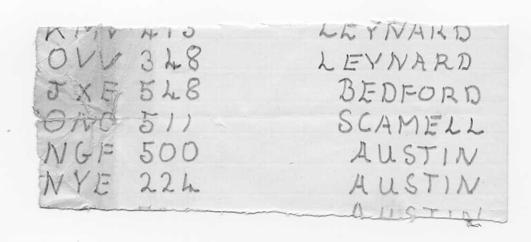
Watching the traffic for hours we soon began to see trends and patterns. The massive rolls of newsprint being carried up to Fleet Street on red Bowater flatbed lorries – Mammoth Majors. The green Fodens belonging to the Reed paper group based at Aylesford. The London Brick Company in red and black livery with their logo – a bricklayer holding a hod. Occasionally a prewar lorry would trundle by – usually a Leyland with the characteristic prewar number plate format comprising two\letters and four numbers. I think that I can claim full membership of the ‘nerds’ club if I now recall from memory the lorry makes in alphabetical order: AEC, Albion, Atkinson, Austin, Bedford, Commer, Dennis, Dodge, ERF, Foden, Guy, Jensen, Karrier, Leyland, Maudsley, Morris Commercial, Scammell, Seddon, Sentinel, Thorneycroft, Trojen, Vulcan
To finish this rather lengthy piece on the theme of wheels, I want to describe a sad event and the spinoff that became a defining moment in my own future career direction. Bexley probably had several taxi firms, but one was located close to the station. Some sort of ‘incident’ occurred which involved a fire in the Station Road office and the subsequent dumping of at least one taxi on a piece of land by the cricket club at the bottom of Salisbury Road. Our gang soon noticed the taxi, which was a large pre-war black Packard. I know this because amongst the many parts that I removed from the taxi was the beautiful enamel badge that was the ‘horn’ button in the centre of the steering wheel. Having carefully preserved this remnant for about 50 years, I found it a good home back in the USA via Ebay a couple of years ago.
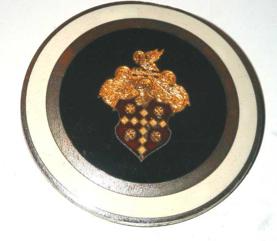
Packard Emblem
I mentioned a defining moment in my choice of career and it was the elaborate ‘flashing indicator’ mechanism that I retrieved from the Packard that caused this change. Up until then I was an embryonic ‘mechanical’ engineer but when I carefully unscrewed the device from the roof right above the drivers left hand, and took it home to examine, I was soon to become a budding ‘electrical’ engineer. The device in question was a clockwork mechanism that was wound up via a knob, turned either clockwise or counter-clockwise, depending on which was the required direction of turn to be indicated. The spring mechanism then ran back down, and whilst doing so, repeatedly opened and closed a pair of contacts that would control the flashing indicator lamps on the car. The clever part was the additional pair of contacts that ‘steered’ the signal to feed either left or right hand side indicators.
I discovered this intricacy by careful examination. You might think that I should have become a clock maker, but when I had wired up a battery, and bulbs on a wooden panel and had the original ‘flashing indicator’ scheme from the Packard working again, I was hooked on a career path that eventually led to the Sinclair C5 – but that’s another story !
We moved from Bexley in 1958 to Westerham and our house was located on the famous hill, where a long unmade road called ‘the avenue’ loops right round from the top to the bottom. This was a perfect place to ride motorcycles without tax and insurance – no helmets in those days. My father, seeing my interest in Engineering arranged for me to work at the garage in the middle of Bexley, by the fishmongers, and under their supervision, repair a BSA Bantam as my first motorbike. My dad was still travelling back to Bexley each day whilst he continued at his butterfly business in Salisbury Road, so I came with him. After many weeks, the bike was declared fit to ride and with "L" plates displayed I made my way via Orpington, Pratts Bottom and Knockholt to Westerham Hill. I avoided the hill itself on this first occasion by going around the previously mentioned ‘avenue’ and arrived in one piece, elated at the experience and obvious freedom that two wheels supplemented by an engine can give.
The Bantam was soon chopped and hacked to it’s bare bones with alloy mudguards, a racing seat and ‘Ace’ bars. Having past my test I was able to move up to bigger machines and a 350cc BSA on sale in Biggin Hill immediately caught my eye. To me at that time, it was the most handsome machine in the world and when I owned it and could polish and cherish it, the feelings it engendered can be invoked again at any time I want by thinking back to those days. I soon learned that in the world of BSA’s and indeed ‘café racers’ of all ages, the BSA Gold Star was the ultimate machine but beyond the reach of most. The closest most could get was to customise the ‘cooking’ version, the B31 with the usual bits and pieces, but in particular with that beautiful swept back exhaust pipe and silencer, the latter capable of emitting a unique ‘twitter’ on the over-run.
EARTH
by
Perran Newman
I firmly believe that man needs to have a real and literal connection to his roots and when I say roots, I mean the sort that grow in the soil. There is something very basic about our connection to the land and I feel sorry for those who cannot experience this primeval link with our past.
I am lucky to have had a mother who was a trained horticulturist and a large garden in which to safely explore the world as I grew up. We were encouraged to cultivate a small patch for ourselves and were given seeds to plant. I recall certain impatience, typical of a child, at the time it took for them to germinate. Carefully tending and weeding the seedlings was something I enjoyed and to this day, I find the chore of weeding anything but a chore – more an opportunity to get really close to the earth.
Our garden was a wonderful mixture of spaces, some dedicated to the growing of vegetables and fruit and others partially wild where we children could indulge our whims. The farthest corner was known as ‘China’ and my mother used to let the road sweeper empty his electric ‘dustcart’ here, to add variety to the leaf mould based compost that was religiously cultivated in this far corner.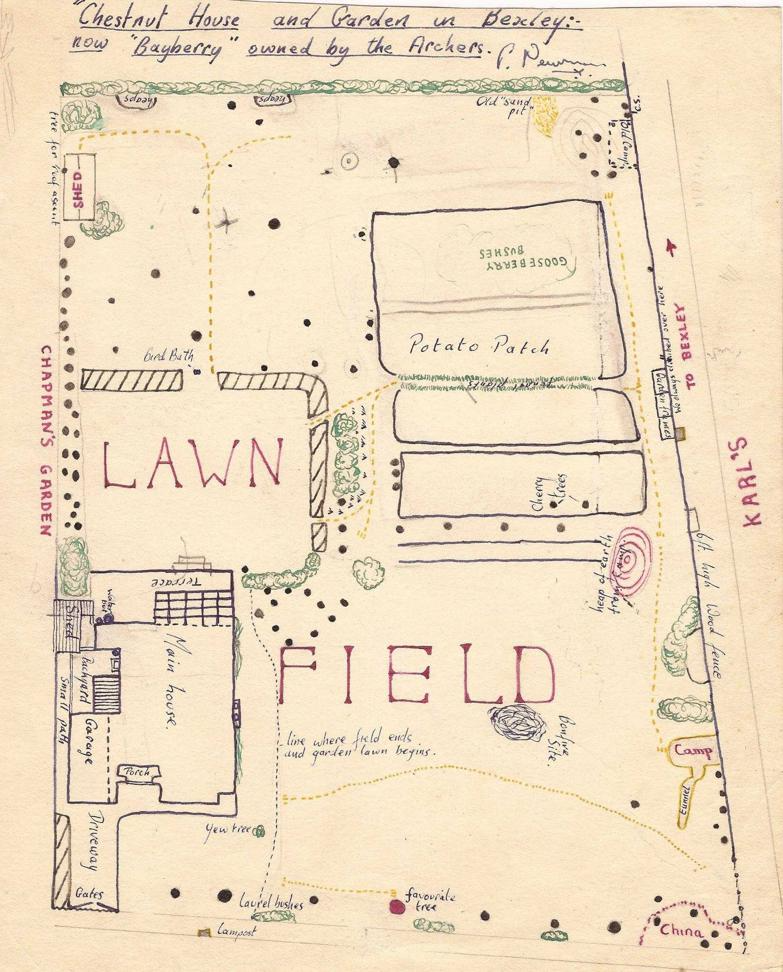
A wooden fence ran the length of the garden, separating us from a public footpath or ‘snicket’. On the other side of the path was the garden of the singer Dorothy Squires (Say it with Flowers) and her husband, (Ivanhoe), the young Roger Moore. This was just a typical middle class suburban road between Old Bexley and Dartford Heath and we didn’t consider that having ‘stars’ in our midst was anything very special.
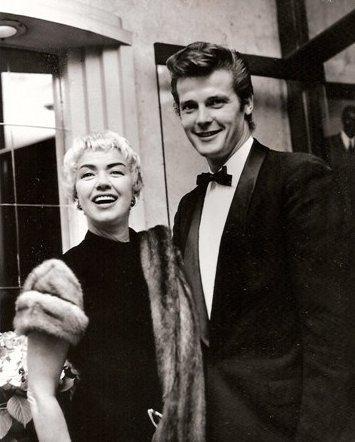
Of my two best friends, Karl lived in the converted stable block of this house, his mother being Dorothy’s childhood friend.
I’m not entirely sure where the inspiration for digging an underground camp came from. Maybe it was watching the earthmoving equipment that was ripping the lovely old orchard apart to build the road now called Cold Blow Crescent. As we were not allowed to enter the orchard, its loss to progress didn’t effect us. Instead we could watch a ‘mechanical excavator’ and ‘dump truck’ re-landscaping the environment. I was particularly taken with these two machines, the first I had seen close up. I was able to work out that the excavator rotated about its stationary caterpillar tracks by driving a small pinion cog that meshed with an enormous fixed cog. The clever simplicity of this appealed to the embryonic engineer with me.
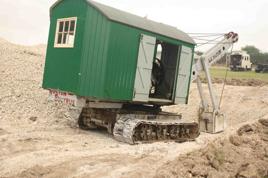
Likewise, I watched as the single cylinder engine of the dumper was started. A muscle bulging, initially slow rotation of the starting handle, getting faster and faster as the speed of the flywheel was increased and then a handle was released (the decompression lever ?) and the pepper pot cap on the exhaust bellowed into life. The individual explosions within the single cylinder, fighting their way to freedom as sooty mushroom clouds. Oh, the power and the glory – to misquote a description of the German Grand Prix cars at Donnington before the war.
It was Jason who provided the vital tool that enabled us to start work on making an underground camp. The tool was a beautiful pickaxe. It was the full size implement with a green and cream coloured wooden shaft. It was double headed with a wide spade-like end on one side and a blunt spike on the other. I suppose we were 9 or 10 years old and mother must have indicated the general area where we could have our camp. It was close to both China and the snicket fence.
There is no doubt that digging the camp kept us occupied for at least a couple of years. It also required the use of spades and a wheelbarrow as the extracted soil had to be moved some way from the hole that we were making. It must also have helped us develop physically – the digging, lifting, and barrowing requiring much exertion. I don’t recall much discussion about the form that the camp would take but as the hole in the ground became tangible we all agreed that it should be covered over so that it became invisible from above. The covering was made from pieces of timber and boarding and from somewhere a hatch was found that was in reality, a cupboard door on a small frame.
One big problem with holes in the ground is that they tend to fill with water when it rains. The covering described above made a vast difference and so did the stove. In Karl’s garden was an old air-raid shelter and from here the stove and its pipe were taken and installed in our ‘camp’. It was made of cast iron, had a grate and two small doors. It must have been fairly small as we managed to move it without too much trouble. The warmth it provided and the curl of smoke from the chimney poking out of the ground were exciting benefits.
Inside the ‘camp’ for this is what we called our den, we had a pair of earth benches made by digging a deep foot-well. There was a genuine effort to make the ‘camp’ and its surroundings neat and tidy. We awarded badges to each other for sterling work in this respect. Just what we got up to in the ‘camp’ remain as fairly hazy memories. We certainly smoked our first cigarettes – Matinee, bought at Baldwyns Park for ‘uncle’, a bare-faced lie told with some trepidation as if this was a major crime ! We tried cooking food on the stove with very little success. It was much easier on an open fire. I guess we liked the idea of having made our own little home in the earth, but it was a tight squeeze when myself, Jason, Karl and younger brother Brian were all inside.
During one of our many brainstorming sessions about challenges to undertake, things to do, things to make, places to go to, people to annoy and so on, a bold idea was put forward and rapidly accepted by everyone. We should build a tunnel to allow us to enter our underground camp from some distance away. The only practical way to make a tunnel was by ‘cut and cover’ and work was soon underway. More boarding was needed to cover the trench, soil being heaped on top to make it secure and ‘secret’. Crawling through the completed tunnel, I experienced true claustrophobia for the first time. You know you cannot go backwards, it is almost pitch black, it is damp, cold and a very tight fit. My memory tells me that the tunnel was seldom used although a triumphant addition to our glorious camp.
As Karl’s garden was just the other side of the footpath from the camp, and fired up by the success of our last construction project, it was decided to dig a true tunnel under the footpath to reach Karl’s. Work progressed rapidly as we were digging horizontally this time. We were soon under the fence and about a foot under the path when our naivety was exposed. Working at a depth of about 6 inches, the path above began to sag and even our enthusiasm was halted by the reality of the situation.
We moved away from Wansunt Road when I was 12. Three more houses were subsequently built in the garden. We never filled in the camp but threw the old metal milk crates that we used as seats into the hole along with other assorted items of rubbish. I do regret that I don’t have any photographs of the ‘camp’, particularly as father had taken pictures of a fishing trip with my friends a few years before and this was published in ‘The Farmers Weekly’.
These early episodes, scrabbling in the soil returned in my middle years when I started digging ‘bottle dumps’. One always aspired to digging an old site with no clear glass, or one where the glass had not been made ‘sick’ by the presence of the ash from coal fires. Most popular sites looked like first world war battlefields with heaps and mounds and debris everywhere. What had once been neatly buried and covered was now scattered everywhere and they became real eyesores.
The claustrophic feeling returned a few years after leaving Bexley. We moved to Westerham and in getting to know the area and its hidden attractions, a few friends and I, ‘discovered’ the abandoned Kentish Ragstone mines on Hosey Heath. We didn’t have the Internet to tell us about the site and we entered through a hole in the ground to discover a labyrinth of tunnels, some big enough to drive a lorry through. We used a ball of string to guide us back and I can still recall that awful feeling as I squeezed through a narrow slot, following our leader, and felt the weight of tons of material in the centre of my back, waiting for perhaps just that moment to crush me to pulp.
Recent pictures taken inside the caves by members of KURG
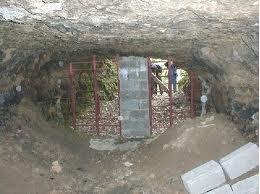
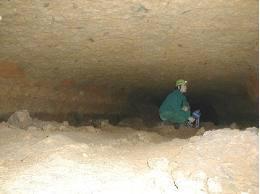
I was married in Leicester, a Roman town with a small section of Roman wall still standing. At that time, an area near the centre of Leicester was being completely redeveloped, with new roads being driven through. I volunteered to work with archeologists in rescue work ahead of the roads. The Roman levels were in some places 20 feet below present day levels, attributed to the steady piling of rubbish and ash over the centuries.
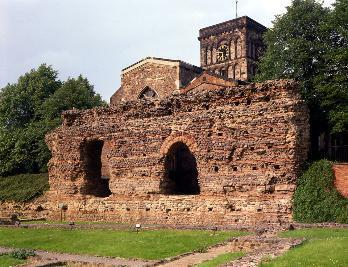
I dug in a rubbish pit and was rewarded with that special thrill of uncovering artefacts, seeing the light of day again after more than a thousand years. Finding a (broken) Roman oil lamp was a most memorable moment and gave me a lifelong interest in archaeology.
I sometimes wonder if Tony Robinson and Time Team went back to Wansunt Road, what they would make of the site of our camp. I suppose the buried milk crates would be a dead giveaway !
FIRE by Perran Newman
The satisfaction that I still feel when I am tending a good bonfire is something that has been with me for most of my life. I am intrigued by it’s origins and have no doubt that our distant ancestors must have felt the same way. For them fire was probably also associated with the act of cleansing. Living on the edge of Dartmoor with a host of Bronze Age settlements, stone rows and circles I have read that large fires were made within the stone circles. I like to imagine that this was their way of cleansing the corruption of a dead tribal member.
I grew up in 7 Wansunt Road, in an area of Bexley known as ‘Cold Blow’ and we were lucky to have about an acre of garden. My mother was a trained horticulturist and the garden not only supplied much of our fruit and vegetables but provided plenty of corners for our ‘gang’ of small boys to make their dens. A garden of this size produces plenty of material that is easier to burn than compost and as a child, I watched as these bonfires were assembled, lit, fed, controlled and finally allowed to die.
I’m sure we must have poked the embers the following day and discovered that under a seemingly dead layer of ash, the heart of the fire lived on and could be revitalised by feeding with suitable small dry twigs and lots of blowing. Getting this close and personal with fire was neither encouraged nor discouraged. The smell or some say ‘reek’ of bonfire smoke must have permeated our clothes and hair so mother was well aware of our activities but did not chastise us.
The concept that a flame lives on, even though one is not attending to it is brought back vividly by a memory. I am sitting on the windowsill in our upstairs bedroom looking out over a dark garden but focussed on a single flickering flame under one of the gooseberry bushes. I know exactly what it is, but am excited all the same. Earlier with parental help I had placed a candle in a jam jar under the bush. It is signalling to me that all is well and after an eternity and getting cold I climb into bed knowing that something I did carries on ‘living’ whilst I sleep.
Not really a ‘den’ more a sort of Red Indian Tipi was a structure built from long bean sticks and dried grass in which my younger brother played, blissfully unaware of events about to unfold. I must have been old enough to have a box of matches or was it a ‘camp fire’ in the corner by the ‘snicket’ that provided the deadly flame. However it was started, it was definitely me that did it and the dried grass caught extremely rapidly. Brian was able to get out without harm and the tears that flowed had no effect on the flames that consumed the structure in less than a minute. I do not recall a punishment but would be amazed if I wasn’t sanctioned in some way for such an early act of vandalism. I have to say, almost 60 years later that it might have been jealousy but my memory tells me that I wanted to see how well it would burn.
As children we soon learned that a fire could be encouraged by more than just blowing till one felt faint. I poured some of the contents of a tin of ‘Bluebell’ polish on one small twig fire – it roared in approval, but where on earth did the idea come from ?
In the 1950s and later many homes had paraffin based heaters. A specialised delivery lorry would regularly do the rounds. It had a large tank of the fuel on the back and the driver would dispense into spouted containers brought out by householders. Our gang got to know ‘Dan, Dan the Paraffin Man’ as we called him. Without much persuading he would give us small quantities of the ‘magic liquid’ in containers that we supplied. Modern attitudes would perhaps say that we were being ‘groomed’ for something more sinister but I remember him as a happy, open kind man who enjoyed hearing our tales. This paraffin was used carefully to help along fires that were struggling because the wood was wet. I remember that it gave off an unpleasant smell as it burned and was no substitute for a properly prepared fire.
Fire building is something of an art form and we honed our skills with competitions, learning in the process to build a structure in which the air could easily enter. The wigwam shape with a small bundle of paper in the centre, a cone of thin, very dry twigs followed by further layers of sticks getting increasingly thicker as one built outwards. The heat from the inner layers was capable of drying damp sticks so that they too were ready to burn after a while.
The idea of trying to make a miniature fire alighted in our midst seemingly from nowhere but was probably triggered by an article in the ‘Scout’ magazine to which my father contributed the occasional Natural History article. A miniature fire needs to be contained in some way and we used a tin – Lyles Golden Syrup being ideal. A fire door was cut in the bottom front using a hacksaw (under supervisions from Jason’s elder brother) and a chimney made from an offcut of copper water pipe was jammed into a hole formed in the lid. It was then possible to light and keep burning a truly miniature stove with smoke pouring realistically from the chimney, fuel of small dry twigs being fed down the same. Some forty years later when I had rediscovered my childhood friend Jason, now living on a smallholding in the Peak District National Park, I was amused and delighted to see a full size version of our stove being used to prepare pig swill !
Now that I am nudging my 65th year, I still enjoy a bonfire and the challenge of burning dampish material through the heat generated by having a good solid fire going underneath. I no longer feel faint from blowing but have discovered that it pays to wait for a strong south-westerly wind to do the work. Staring into those flames and leaning on a pitchfork invokes a mental state that is relaxing, pensive and nostalgic all at the same time. I am back in the Bronze Age and dreaming of inventing the chimney. Anyone who plays with fire can see the principle in action if they watch and ponder the dancing, spiralling, twisting movement of the flames. So why did it take man 2000 years before he found the solution ?
WATER by Perran Newman
They say that man has a natural affinity for water, his ancestors having crawled out of the primeval soup, millions of years ago. I must admit to a lack of confidence when it comes to intimate contact with water, having been life saved whilst going under for the classic third time in the school swimming pool aged 13 years old.
However, water has featured in many of my favourite childhood activities and now as a near ‘senior citizen’ I find myself offering to plan and install a micro-hydro plant for a friend on the edge of the moor, so water has now become my business.
I grew up in the village of ‘Old Bexley’, mentioned in the Doomsday Book. Once an attractive village but now almost absorbed into the sprawling tentacles of Greater London. The River Cray, which runs through Bexley drove many mills and paper making was one of the activities of this corner of Kent. As a small boy, with an equally small net on the end of a bamboo stick, I fished for Sticklebacks in the Bexley Mill pond. A few years later, for I moved away from Bexley when I was 12, our gang comprising Karl, Jason, myself and sometimes my younger brother Brian, discovered a true island in the Cray, only a short distance downstream from the mill.
It was hidden from view and I remember to reach it, we had to creep into the grounds of the Vicarage, half crawl behind the shrubbery along the boundary wall and then over a partly collapsed section of wall to reach this magic spot. We believed that only we knew of its existence and I‘m at a loss to remember how we found it. The only clue might be my attendance, on my own, at the Church Fete held in the Vicarage gardens. This was my first time for many activities including putting my hand in a Bran Tub, trying to hit the rat with a stick as it slid out of a tube and buying a metal cigarette case on the White Elephant Stall. Maybe it was whilst I puzzled over a silver sixpence I had been given in my change, that I espied the island in the river.
We visited our island many times – it was only a yard wide and perhaps six long, and a stunted tree grew on it – but the Cray flowed both sides and we could stand on it and claim it as our own. We tried to dam the river on the side where it was narrowest. Moving stones already in the water to better positions introduced me to Archimedes principle – that stones were definitely lighter whilst under the surface of the water.
All boys like to fish and I was no exception. I had sampled the simplicity of catching perch in my mother’s native Finland. One only had to lower a worm on a large hook using a cork float and a bite would be obtained within seconds. The River Cray was less fecund, pollution no doubt playing a role. My father, never one to miss a photo based opportunity for a story captured one of our fishing trips for posterity in an article published in the ‘Farmers Weekly’, treasured images of childhood that I still have.
Mention of Finland brings back the sights, sounds and smells of island holidays, which we took every couple of years to allow my mother to be with her family again. The house stood a hundred yards back from and above the brackish waters of the Baltic. Beds of tall reeds fringed the shore and a traditional wooden rowing boat smelling of ‘Stockholm Tar’ in the sunshine was where I spent many hours. Peering down into the water the shoals of perch could be clearly seen even though their cunning zigzag camouflage was effective. The water was usually calm and we noticed the long time interval between a passing boat, maybe a quarter of a mile away and the moment when small waves would break and break again upon our piece of shore.
Back in Bexley, although we had a large garden in which we built an impressive ‘underground’ camp, Jason’s garden had features with excellent ‘play value’. An old sand pit was located at the end of a shrubbery and close enough to the house to enable a hosepipe to be used to generate a continuous stream, wending it’s way through the falling shrubbery to end up in the sandpit. The game we enjoyed most was building a dam to try and hold back the stream. Jason used to sing ‘June is busting out all over’ for some unaccountable reason and he generously called this play area – the boglands of Sir Perran Newman !
One toy, which would probably be considered too dangerous today was the water powered rocket. Made of a soft plastic, you half filled it with water then pressurised it using a special pump which doubled up as the launch pad. Crouching beside the distended rocket – for we always pumped it more than it said we should in the instructions, you pressed the toggle and the rocket shot skywards on a column of water, spraying you in the process and then falling to ground, usually in the neighbours garden. It was Keith Glover who had this toy, not a gang member but invited to birthday parties. In my forties, having read that he was a Professor at Cambridge University I arranged to meet him on the steps of Engineering Department. Two figures paced back and forth for a while before realising they were once childhood friends. Recognition was almost non existent, but I did learn that Keith’s dad had built their ‘television’ with its magnifying lens himself, using some parts from a wartime aircraft radar set. That was an impressive but not totally uncommon feat.
I digress somewhat so I’ll wander even further though there is a water connection. As children we became interested in maps. We decided to record our large garden, with every feature carefully annotated, the artwork being undertaken by my elder sister. I still have this coloured memento of childhood and its continued existence owes much to my ongoing fascination with maps. I only wish that I had discovered the older OS maps sooner as these would have naturally led me to explore the history of our environs.
As it was, I had a fairly ordinary fold-out map in the ‘Guide to Bexley’ that I had bought. With the freedom that a bicycle gives I set off to explore the River Shuttle, a rather grand name for a stream that joins the Cray. Tracing it backwards, peeping through gaps in fences, climbing on the saddle of my bike to peer over walls, I got immense satisfaction from tracking this stream towards its source although I never actually got very far back. Years later, the fascination still with me, I made a specific detour to see the official source of the Thames, which dribbled from a carved stone amongst undergrowth in Gloucestershire.
Coming to live in Devon some 15 years ago, I discovered the wonders of Dartmoor with its extensive industrial remains. The lure of old water courses was hard to resist and I have and will continue to spend happy hours tracing the course of long abandoned and mostly dried up leat beds that criss-cross the moor. One in particular, The Southill leat was the main subject of a talk that I gave to the History Society. It can be dated precisely to 1480 and runs for about 5 miles from Teignhead to a tin blowing mill at Southill near Chagford. Abandoned after a relatively short life, when tin processing declined at the time of the Civil War, I was privileged to be able to excavate and record a cross section of this leat. Working under supervision from archeologists who were examining the reaves which cross the moor, this experience perfectly encapsulated the multiple threads of water, maps and history that have been part of my makeup since childhood in Bexley.
Memories of Barbara Houlton
Herewith a few of my memories of 'Life on the Maypole'
The thing I remember about the winter of 47 was a group of us having to take our 11+. There was so much snow on the roads the buses weren't running so we had to walk across Dartford Heath to get to the Girl's Grammar School. Needless to say, we played snowballs on the way, got there late and I don't think any of the group passed. We didn't want to go to the Grammar anyway, so none of us were really bothered.
It was always so cold in our house - we used to sit around the fire (which was built up the back of the flue) until dad came in and took shovels-full off. He was always worried about fires. We used to go to bed in thick socks with overcoats on the bed and hot water bottles. Ugh.
My most vivid memories are of the war. We used to share our shelter with some neighbours - Mr. Mason, Mr and Mrs Windmill and their two children. Mrs. Windmill always put her woolly hat on as soon as the bombs started falling, and took it off again when it got quiet. All the kids used to laugh like mad and when I met Mrs. W. many years later and reminded her of this, she also had a good laugh. I remember the first doodlebug coming over - I was playing with Joyce Stockford, next door, in her garden and heard this awful noise. I looked up and saw this weird craft and called out to Mr. Stockford - he took one look and pushed us both into their shelter. I don't suppose he knew exactly what it was but obviously was very worried.
Regarding the school - I remember Miss Burr taking us for nature walks across the heath. We went up the road towards Crayford one day and she showed us a spindleberry tree - the first I had ever seen. It was really beautiful with bright red berries surrounded by an orange skin. We also used to go to the penny royal, the glory bombs and down the 'Dell' . Many autumn days were spent blackberrying on the heath and sometimes we were lucky enough to find a few mushrooms.
Does anyone remember how we queued up on the verandah to get our spoonful of malt?
From the age of about 9 I was in the choir at St. Barnabas Church. That meant choir practice on Sunday morning, followed by morning service at about 10.00am. Sunday school was at 3.0p,m and this was followed by evensong at 6.30 so our Sundays were quite busy. If I was really good I was allowed to ring the bells before evensong and if I was really really good I was allowed to snuff out the candles at the end of the service. On one occasion I remember I got the giggles and had to leave the choir stalls through the organ area and was sent home in disgrace.
Memories of Frankie Gemmell
My name is Fran Marsh, nee Frankie Gemmell, I lived in Baldwyns Park from early 1943 to 1965 when I got married, but my Parents lived there until losing my Father in 1990. I attended Maypole Primary/Junior school from 1947 to 1952. I remember the Pavilion in Baldwyns Park where a crowd of us used to spend Saturday evenings with a few drinks and dancing. I remember walking across Dartford Heath in front of the school one day when a balloon and basket landed on the heath, who was in the basket and why it landed I do not know. When it snowed there was a hill along from Denton Terrace, on the left - the name of "road" escapes me, which made a good slide. I had piano lessons in a house along this un-made road. The hospital fence ran at the bottom of the houses opposite to where I lived and sometimes the siren would go off warning that a dangerous patient had escaped. Weekends were used walking in Joyens Woods before the Estate was built, deneholes in the area, in fact one Sunday morning a friend of mine woke up to find a denehole outside her back door. I remember St.Barnabas church being built which I attended on a regular basis.
At the end of Baldwyns Park was a parade of shops which stayed under the same ownership for sometime, the fish mongers, hairdressers which also sold materials and wool, Cooperative store & butchers, the papershop, where myself and a couple of friends used to do paper rounds, help in the shop and then across the road was an off licence. Outside the off licence used to be a stall selling fresh vegetables.
I thoroughly enjoyed living in the Baldwyns/Maypole area and remember the names of people who lived in the Maypole, Baldwyns Park, Dartford Road, Tile Kiln Lane and Summerhouse Drive areas as people didn't move around as much then as we do now or as far afield.
I went to the Maypole Reunion held in or around 2000 and what a special day that was meeting up with people I had not seen since either leaving the school or leaving the area and several I am still in contact with since that day.
People I remember from Baldwyn's Park area are, Mary & Richard Wight, Patricia & Terence Palmer, Carole & David Fox, 2 Williams girls who moved to Brazil, Gatehouse family, McManus family, Sheila Miles, cannot remember names of several others. Other people from the Tile Kiln Lane and Summerhouse Drive and then new Joydens Wood Estate, I remember are, Pat Vass, Doreen Hurren, Sue Nye, Sheila Peckham, Russel Pettifer, John Griggs who had a twin brother, Cliff Young (deceased) and family, David Bainbridge, John Parker, Ken Webb, Trevor Moseley, Tony Turner, Terry Seagust, Terry Deegan (had a Monkey Puzzle tree in front garden - lovely), Anthony Gillies, Carole Slade, John Houghton, Roger Fisher, also Carole from Baldwyns Road & Sheila (now Lusher) I am in contact with, both lived on the Maypole but I cannot remember surnames, there were others but I cannot remember the names - if and when they come to me I will e-mail them to you. There was also a round house with a thatched roof, top of Baldwyn's Park just over on the left in Tile Kiln Lane, cannot remember names of people who lived there or the house next door, dont know if round house still there?? After starting work met up with two or three people from the Footscray/Sidcup area who also used to come to the Pavilion in Baldwyns Park on a Saturday evening, Roger Smith, Roger Hogg and "Taffy" but not really connected with the Maypole and area.
A couple more names for you Rob Merriman, Keebles, Nigel Wilson, Tony Barton, Rob Jevons (friend of Owen's). I understand Peter Walker moved into Terry Deegans's house which had the Monkey Puzzle tree in the garden. Note from Maypoleman - Peter Walker is now deceased.
Information from the late Janet Lee
Information re Maypole School . . . . .
Janet was a teacher at the school.
Thought you might like some info on the staff who were with Mrs. Chambers.
1 Mr Roy Beresford (deputy) became head of a school in Footscray. Died many years ago.
2Mr. John Rawlins was at Goldsmiths'College with me, he came to the reunion, lives in Oxford shire. (Christmas card.)
3 Mr Brian Tagell, very musical. Became head at Barming School. Lives in Deal. (c.c.) i.e. as above!Retired.
4 Mrs. Hunt elderly teacher who had no formal training.
5Miss Alley moved to Hertfordshire. (c.c.) Retired.
6Mrs. Cridge married a Polish prisoner of war and he took her maiden name .They are heading towards their 90s.(c.c.)
7Miss West became Mrs. Relf had a son and a daughter.Lives in Hempstead. Retired from full time but does testing.(c.c.)
8 Miss Starbuck became Mrs. Hawken, had 2 daughters. Lived in Footscray. Died 10 years ago.
9Miss Tozer became Mrs Stafford, had 2 sons and a daughter lives in Crockham Hill.(c.c.)
10Miss Tilyard became Mrs Beak , had 2 daughters. Lives in Cheshire.(c.c.) Retired.
11Mrs. Hinkley had 2 daughters and 1 son. Moved to Sussex. Died 15 years ago.
12 Mrs Hartley taught music. Had a son and a daughter, lives in Lancashire. (c.c.)
13Miss Lee, stayed at Maypole with Miss Clarke for a year and then moved to aTonbridge School. Spent last 16 years of teaching at Joydens wood.
14 Mr Hembury , He moved to a Headship at Hoathly Common. (c.c.)
With Miss Clarke.
Miss ? became Mrs Ward had 2 children. Retired.
Miss Hamilton from New Zealand became Mrs. Mason has 2 daughters and a son. Lives in Timaru.
When I joined there was a Mrs. Phillips who livedin Crayford and taught Juniors.
Mrs. Smith taught Infants. Moved to Yorkshire.
Mrs .Hares " ". Her children Janice and Graham were also at school.
Mr Deer went with Mrs Chambers to start Joydens Wood. Eventually got a Headship in Chelsfield. Lives in Goudhurst.
Brian, John ,June and I came to the reunion..I drove Mary, Meryl and John to Epworth for a celebration meal with Mrs. Chambers, she was 90 and living with her daughter .She died 2years later.When I walked in she said "You haven't changed a bit!"
Memories of Bernard Lodge
Dartford High Street Market 1900.
Extract taken from Dartford Archives Bernard Lodge was the Godfather to 'Maypoleman'.
About 1900, the Market consisted of several stalls of all shapes and sizes, belonging to the stall holders, mostly local people, who brought and erected them each Saturday at about 6 am., in readiness for the business of the day. They were all covered by canvas awnings and adapted for the special trade carried on, and stood on the south side of the High Street. The Market lasted all day until nearly midnight, although Teddy Upton, the Market Keeper rang the old 'Market Bell' at 10 pm...At dusk the stalls were illuminated by flaring paraffin gravity and pressure lamps that not only gave light and heat but smoke and smell.The stalls varied in their trade or business. The first one was run by Johnny Bacon, a greengrocer of Hythe Street. Next was a sweet stall...Then there were Levi Turrell, a fishmonger, another fishmonger by the name of Clarke, who sold shell fish such as cockles and mussels at 1d a plate, shrimps, winkles and sometimes stewed eels. Then there was another Dartford fishmonger, Alf Slater, and another, Billy Manning.
Next was old David Bacon, a greengrocer...when it came to closing time he used to hold a kind of auction, selling off bunches of grapes and hands of bananas to the highest bidder...Next was a butcher from London named Wood and, from him at the end of the day, one could get quite a good joint cheaply...Then there was a stall occupied by a Jewish lady selling clothes and haberdashery...Next was old Preddy selling plants and flowers from his smallholding off Instone Road. A choice stall was the baked potato man with his 'tater engine' with a lovely coke fire, selling baked potatoes at 1d each and, in season, choice baked chestnuts at 1d a bag. Sometimes a stall was taken by a man selling birds such as canaries, linnets and bullfinches etc. in cages.
On Market Days the street was crowded and good business was done. What with the cries of the stallholders extolling their wares, the banter and general good humour, the Market was an entertaining place.
In the afternoon and evening, the High Street was devoid of traffic except for the occasional horse-drawn cart...the streets were the promenade ground for all the local 'bloods' and their girls, from the Church to the top of Hythe Street and back again. We called it 'The Monkey Parade'.
Close to midnight the stallholders removed their remaining stock and the stalls, and carted all away on the old-fashioned costers' barrows...The Market site was washed down and the Market was over for another week.
PERSONAL REMINISCENCES OF BERNARD LODGE (DARTFORD)
DARTFORD HISTORICAL AND ANTIQUARIAN SOCIETY NEWSLETTER NO.11, 1974.
Memories of Stuart Grieve
I attended Maypole CPS between 1945 & 1951. Like many children I recall the first day as being rather traumatic. Then, as others have recalled, Miss Gaspar was the head with her deputy Miss Burr. There was a Miss Bean, a late middle aged person who always wore what we took to be a tea cosy on her head. There was also a Miss Torrie whose marriage to another teacher, Mr Davis, I attended as a choir boy at Christ Church Dartford. There was also Mr Rees, a small amiable Welshman, who often seemed hard -pressed.What surprises me in retrospect is that, apart from occasional nature study, we were rarely taken on to the heath for sport.
Something which sticks out in my mind is the PE in the playground which was supervised by female students from Madame Osterberg's Physical Education College in Oakfield Lane,Dartford. Madame Osterberg was in the forefront of educational innovation in the late 19th century & had initially come to England at the invitation of the London School Board. The college she set up was where netball was first introduced into the country. The girls who taught us were turned out in airtex shirts & maroon, heavy duty skirts & put us through a routine with bean bags & hoops. We once attended a party at the college which architecturally must have been a model of its kind & had spacious well-kept grounds.
There was one particularly painful memory, which was the visits to the school dentist, I believe at West Hill Hospital.Three successive Fridays I had to undergo drilling without anaesthetic from this large bald man with steel spectacles & I was deterred from visiting the dentist for some years afterwards.
As I lived at the top of Station Road, Crayford approaching the school across the heath I could always clearly see the chimney of Bexley Hospital & the sad fact is that the topicality of Nazi atrocities caused we children to discuss whether they were burning patients' corpses if we saw the chimney smoking. As pupils we did once make a social visit to the hospital,when a Christmas party was held for us.All I recall was that the blue -iced cakes were the best I've tasted.
Every Christmas there was the Nativity play & as a choir boy I often had a singing role & for that & 'general progress' I once received a school prize, a book entitled 'African Adventure'. Miss Gaspar did on another occasion give me an award in the cloakroom with a cane. Generally corporal punishment consisted of a smack on the back of the leg, which was painful.
I've been back to the area a few times since leaving nearly forty years ago. The motorway has wrecked Dartford Heath & presumably no children travel to the new school from Crayford & indeed the links which used to exist between Crayford , the Maypole & Bexley must have ceased , not least the gang fights which ranged across the heath.
Further addition added by Stuart 26/10/2008
I just noticed a reference to the gun club in the intro to the web site & it reminded me that I & a friend trespassed there in the mid fifties occasionally. On one occasion we took possession of an elevated position for firing the clay pigeons & were quite happily firing them off when I lent forward at the wrong time & the return action of the sling mechanism caught me full in the face & knocked me flat. At this point an inquisitive & slightly aggressive alsation dog appeared & forced us to roll down the hill thro' tall ferns. I reached the bottom by a stony track on hands & knees & peered out to see my friend being seized by a large man.I'm ashamed to say that my first reaction was to lie doggo but my intentions were foiled by the dog confronting me face to face & thus we were both marched to the exit with severe warnings. I returned home with face streaming with blood & a broken nose & had to pretend to my parents that I'd fallen off my bike.
Further added 5/12/09 - re the Army Camp at Leyton Cross, Dartford Heath
After the war the army camp was used to house POWs, both Germans & Italians, who were distinguished by insignias on their sleeves. I seem to recall one such was a red diamond shape. Living at the top of Station Rd. Crayford I used to see them passing the house as they were eventually allowed out. I particularly remember playing cowboys & indians one day when a German POW pointed at my silver revolver & asked what it was. As though he didn't know! At a later stage still,I suppose, British troops who were still stationed at the camp on a couple of occasions gave me & friends a lift home in bren gun carriers in which they were roaming about tearing up the tarmac on Denton Road.
Further added 23/7/10
Your comments (made by Maypoleman on a thread by Stuart) triggered memories of the sandpit adjacent to the gun club & opposite my parents' house in Station Rd., Crayford. One day during the war I was climbing through barbed wire surrounding the sandpit in order to see a barrage balloon which had come down in the night . I ripped my leg & had my first encounter with iodine, which most children of my generation dreaded. I didn't see the balloon. But the sandpit was a great playground where you could see sandpipers nesting in the sides of the pit & occasionally adders. In the early '50s there were tipping trucks on the railway line which ran through the pit although it was no longer a functioning business. Boys would construct obstacles on the track & while some clung to a truck others would push it until it gathered momentum. The last one to jump off before it hit the obstacle could brag until the next time. Sometimes we'd be chased by a watchman & the best escape route was through a tunnel which went under where Swan Lane & Denton Rd. (I think that's what they're called) join Station Rd. The other side was another sandpit which abutted Chastilian Rd. & the A2. The watchman, Mr Deemer, sometimes occupied a corrugated iron shack at the bottom of the pit. His unpopularity was such that on one occasion he was trapped in his hut by boys firing catapults & airguns from the heights. "Just like the pictures," said one of my pals.
Memories of the late Steven Parker (Member name 'Masey')
Bexley Hospital outing to Margate 1964 - courtesy of Steven Parker

This has shrunk as it has come from New Zealand ! Actually it is only 42kbites so enlargement won't help.
Most of the people in this photo have lived on the Maypole at some time or other.Back row L to R---- Mrs. Barrett Snr. with one of her grandchildren, Jessie Barrett (now in U.S.A.) Ray Wheeler, Louis Cruickshank, ( owned a pub in Eynsford but not now ) Steve Parker,Bill Barrett in shadow, Morris Bridges, lived where Houltons used to live, moved to Leyton Cross. John Borrell, ran the butcher shop down the dip for a while, now in Erith. Bill Proudfoot, Vic Mcdonald, lady on the end ?
Front row L to R--- Lou Proudfoot, two girls with children not sure, Ailene Parker, Joan Mcdonald (nee Barrett ) her daughter Mary standing behind her, Netta Wheeler (nee Cruickshank). behind her my son Neville, girl next to him not sure,Mavis Barrett (nee Proudfoot ) the boy not sure, my wife Valerie, & then ? ?. not bad after 44 yrs. Regards Steve
I was born in 1935 in Bexley, my parents moved with my sister & I in tow to Heathend Rd. 6 months after I was born, my grandparents having lived in Beaconsfield Rd. since before WW1. My great Aunt (my G/Ms sister) lived in Baldwyns Rd. in the house I bought after my marriage & lived until we emigrated to N.Z. in 1967. So had quite a long history of the Maypole & its people. We still live in N.Z. where we celebrated our 50th anniversary in April 2008.
I also was a member of the St. Barnabas choir as was my sister Marian(nee Parker) the thing we liked most about it was the threepence (3d.old money) that we got each time we attended but was saved for us & given out at Chritmas, if you attended all services & practices you could get the grand total of 13/6d. Do you remember? or was I the only mercenary. A few names I remember, you may know more! David, Betty & Roberta ( Cruickshank) Joan, Audrey & Barbara (Houlton) Marian & Stephen (Parker) Wendy & David (Saunders) Gordon Lennox, Micky Masters, Kenny Purkiss, Jean Peacock, Pat Flett, Pat & Hazel (Richardson) Angela Pope, Joyce Stockford, memory fails me for the rest. The girls in red & white the boys in black & white, how angelic we looked.
The church was @ the rear of Broomhills, churchgoers would enter the Cameron estate through a gate in the alley @ the back of Baldwyns Rd. & walk straight ahead for about 50 yds. The church hall was to the right running @ right angles from the church where we used to attend Sunday school. I don't remember much about Mr. Cameron except he was a little round man who wore wire framed specs, he had a short walk from the back of the house to the church where he played the organ. He must have been Dorothys grandfather? That can be confirmed by Dorothy, who by the way was in the choir & her mother was always @ church. My wife Valerie remembers a ladies church group being held in the hall once a month & Mrs. Cameron being a prime facilitator. After the church & hall were moved my daughter Ailene used to attend ballet classes at the hall, can't remember the teachers name but she lived in Baldwyns Park. Apart from organising a wedding reception for some friends of ours thats about all I remember.
Before we left for N.Z. 40yrs. ago Mrs. Cameron invited my wife & I & 3 children for afternoon tea, quite a delight, One room was a treasure trove of chiming clocks -- table , grandfather, cuckoo, the whole range. The kids were thrilled to bits when she set off the chimes of many, this was followed by the playing of a pianola?
David Bainbridge
Greeting to all Maypolians!!!
Hi all
Well, modern technology, whoever thought all these years on contact could be made with people so far back in time! I have been remiss in not following up on some contacts sent through to me, but unlike others who are gracefully retired, I’m still kicking on in my working life trying to earn a buck or two. I left the school in 1952 (I think), went on to Dartford West, then North Kent College of Technology, then to New York to complete my education and after graduation stayed in the States for 7 years living in Los Angeles working in the entertainment industry.
Returned to the UK late 60’s and continued in the TV/Film/Music industries ‘til now. Anyone who remembers me please get in touch, it would be amazing to catch up in more detail! A blast from the past…
dbainbridge@btconnect.com
Davidx CBM Music/DBTV-UK Limited Studio 20 Halimote Road Aldershot Hampshire GU11 1NJ T: +44(0)1252 332562 F: +44(0)1252 320475 M: +44(0)7785 900443
The late Peter Walker
In the summer of 1962 I moved to 51 Baldwins Park from a horrible little house in Sidcup , I was 10 yrs old, and my first impression of the area was of how lovely and spacious it was, I started at the Maypole school after the summer holiday and my first friend was a young chap known as Paul Richardson, I soon settled in to school life mainly because I didnt go very often, it got so bad the teachers would write the sick notes for me,Im afraid at an early stage I decided I didnt like school .
The highlights in my time at the Maypole were the visits Mr Deere would take us on,one trip I remember was to the Thames embankment somewhere in London,I cant remember what we went there for, but if it was to fill Mr Deeres volkswagen with mud we were successful. After school we would go on our bikes over to the heath, the glory bumps was a favourite place of mine,is it still there today?
In 1963 we had our first family holiday we went to a place called Allhallows,we stayed at a guesthouse run by a Mrs Edina Bucket she suffered greatly with wind, so much so you always new which part of the house she was in,also she must have given a good discount for large bookings because there were hundreds of mice staying there with us,my poor mother went in there a healthy 41 yr old and left a physical wreck with no voice (screaming),needless to say dear reader we never went there again oh no ,the next year we went to Butlins Bognor regis no mice, but lots of Rats .
The Dell was a place we could have fun, cycling down the slopes swinging from the trees getting up to general mischief,I went back there a couple of years ago and I was sorry to see how neglected it looked,but I suppose time goes on and memories dont keep up with it.
Moving on a bit I remember the Richardson bros acquiring a scooter which we would ride round the fields in the hospital grounds "great fun" and then I think it was an old Norton that we would ride around the trials track until someone trashed it for us .
Amongst other strong memories of the time I remember are the times we slept in the old air raid shelter behind Broomhills all the evenings we spent in Deborahs house @ Broomhills listening to music etc, and the scramble to get a pillion seat on the sunday outings on motorbikes, I didnt have one at the time .
Memories of Tony Helyar - Baldwyns Park Pavillion
Memories of Barbara Thomas (Now Joss)
My memories date from the years between 1957 - 1961. Our teacher in the final year was a Mr Brough. He was strict but fair. We were quite afraid of him, but respected and obeyed his direction without question. I will always remember him with fondness and admiration. We used to play British Bulldog and Kisschase in the playground.
The Eleven Plus was the big event of our last year, then most of us lost touch. I went to boarding school in Folkestone but most of my friends ended up at Dartford Grammar or West Hill. Eventually I met up with Jacky Rumble (who is mentioned on the website) at the Technical High over at Wilmington. I lived up at Joydens Wood. Somewhere in the attic I have several photos from those years at Maypole.It played an important part in my childhood.
Memories of Margaret Cadman
was born in Baldwyns Road and remember Kim's parents. I have just been reading the superb history of the Maypole it bought back many memories. I feel quite sad that the school is no more my mother, auntie and uncle, myself, brother, and my sons all went to that little school. Mr Stockford used to live next door to me at 48 I lived at 46. My grandparents lived at 14 Beaconsfield Road and I remember the Popes a few houses down. What about bonfire night on the heath? and in my very young days there was always a maypole party day normally held in Baldwyns Road as all the other roads then were not made up. Everyone contributed and tressle tables were put up and lots of food laid out and I have a photo of me as Little Bo Peep for the fancy dress. I remember all the shops along Bexley Lane and the owners the Challis family, the Miles family, Ron Barrett (had a crush on him). (Maypoleman left that bit in - just in case he reads it and makes him smile !)
I remember the tea hut on the heath the Houghton family lived 2 doors away from me on the corner of Baldwyns and Heathend Road. My mother worked in the cafe years ago and Roger Moore used to go in there for his cigarettes (before he was well known when he was married to Dorothy Squires they lived in Wansunt Road not far from us on the way to Bexley). She then worked in the hospital shop for years until she retired and I think Joan Button used to work over there at some point. I have wonderful memories of Maypole Estate where I was born and grew up and your site has made me quite emotional looking at the photos. Thank you for a wonderful insight to my childhhood years.
Oh yes Ronnie Potter and his sister Elaine, the Hunts especially David who used to where strong glasses. I remember Freddie Balcombe and brother Phillip lived in Beaconsfield and Tony Smith he lived in the first bungalow 3/4 way down Beaconsfield on your side. I remember Jean and John Parker on the other side of the road (twins) they were about 18mths older than me and John was killed on his motorbike. I can remember the "library" that Ron Barratt and I had in the shed in his garden at the end of corner shop next to the school (mentioned in your website) and I remember I used to call for Ron at his back door and his mum Vera. The Conboys at No 1 Baldwyns and Kevin had lots of girls after him. I remember the Rolex watch factory being built in Heathend Road. Also I remember my best friend then Vicki Knightsbridge she had red hair. We used to ride our bikes all around the estate. What about the cows in Broomfields field (part of the hospital) we used to see who would dare run into the field near the cows without being scared. Oh what wonderful fun filled days. No electronic games, computers i-pods etc etc. just good old fashioned fun. We were happy with a bag of sweets (jamboree bags with different things in it) and our bikes or roller skates and spending fun time on the heath building camps or climbing trees. I remember Kim's Dad used to ride a bike and his (Kim's) mum was a very cheery lady and always stopped for a chat to us kids.
I actually lived on Maypole after I was married in 1969 we rented a house believe it or not in Baldwyns Road then after a few years moved to Dartford. I am now living in Maidstone and have 3 sons, 31,35, 38 and 2 grandchildren. I did go back a couple of years ago to look around the estate but would rather remember it from the past. I remember down the "dip" as we know it where the row of shops were (again photos on the website) There was the fishmongers then Sweets the hairdressers then the Co-op groceries then the Co-op butchers and Mr Chipperfield was the butcher (he had no thumb on one hand as he chopped it off )his little wife used to help him wrap up the meat in sheets of white paper on the counter and the floor was covered in sawdust. Then there was the paper shop/sweet shop selling anything type shop called Hendersons. I used to go to Girls Brigade at the Baptist Church just a bit further on from the dip and Sunday School when I was very small in fact I still have a bible that my nan gave me in 1956 and later went to the youth club held in the church hall.
I remember the rope swing down the dell - it was tied to a tree on the slope with quite a drop underneath and all the boys used to swing out on it and see who could hold on the longest. Oh crikey I could go on and on.
I am going back into your site to read more I am really interested. Dont be surprised if you hear from me again when I remember something else to run past you.
Memories of Michael Jennings
I now live in Hampshire but returned to Maypole a couple of years before it was demolished. (I was a pupil in the late 1960's) I've written a short book about the trip, and here is an excerpt:
The redevelopment of Bexley Mental home loomed. We could see new housing being erected at speed, low cost, and with every available corner being cut to impress the latest generation of first-time homeowners. It was here that one Hiram Maxim financed and participated in what is claimed to be the first ever aeroplane flight. The year was 1894; a full nine years before the Wright brothers. Why that fact is not generally known outside of Bexley baffles me.
At the school all children had gone home and we considered it safe for a grown man to be loitering with intent to reminisce. The big gates that exposed the playground and the 1900’s building to the main road were still open as teachers gathered themselves and their classrooms into shape before departing for home.I pointed the camera and clicked hurriedly from the pavement at a mural painted wall on the far side of the playground; an oft repainted map of Kent that I’d first lent a hand to as a ten year old.
I passed along the perimeter wall upon the other side of which the sometimes banned pushing game of Squash Tomato was enacted. A simple breaktime pleasure, the origins of which could only be male, involved five or more pupils. Once a session had started numbers could easily swell into tens, all pushing each other bawling the chant: “Squash tomato, one, two, three” against one of the uprights in the wall. Inevitably, the boy sandwiched in the upright would be squeezed out to rejoin the shovers at the back, until one of the dinner ladies arbitrarily decided it was getting out of hand. Crushed rib cages, broken limbs and suffocation were, on reflection all possible, but I, as a small, somewhat frail boy, participated enthusiastically in this contact sport where movement was imperceptible, and along with others failed to see any danger, suffering none of these life-threatening problems.
As a mixed class we played kiss chase in the playground occasionally, and the feeling of shy naughtiness derived from the prospect of being kissed always outweighed the desire to offer. I stole a plastic ring from my sisters jewel box and presented it to Carole Waugh as a gift during a pause in the game. I have no recollection of what I, or she said, but I felt then what I would feel now at such a sentimental act: embarrassed. Terrible that I stole though.
Inevitably, other boisterous events of my five years at the primary school remain with me, such as the time I and a few other children were detailed P.E. monitors at the end of a gym period. This I can recall perceiving as a proud and sort-after responsibility within the class, and yet I think everyone had a turn at staying behind after the lesson to roll up green landing mats, gather coloured plastic playing balls, dismantle the jumping horse, and tidy it all away in the shed adjoining the hall. Usually this would be under the direction of the Gym teacher, but for some reason on this particular day, she was not present. Fuelled no doubt by the adrenalin of the previous workout we, upon realising the significance of being alone, ran amuck, climbing up the wall bars, swinging on the ropes, using all the vocal effects a-la-Tarzan normally stifled in the lesson. We treated the medicine balls* with disdain and subjected the plastic net balls to the sort of primeval behaviour they were never intended for, all over the room. This conduct being directly opposite to the instruction we’d hitherto been taught.
Shattering the noise with an arriving silence she was back in the hall glaring, and as every child halted as if to say nothing untoward was happening, still swinging ropes and bouncing coloured balls not subject to guilt gave us away. I, who during the melee thought it hilarious to have stuffed two plastic balls down my jumper and parade around in what I considered to be a passable female manner, stood unusually pert, unable to fold my arms around exaggerated breasts.
The punishment metered out for such a crime was clearly commensurate as I remember no more about the incident, whereas punishment I do recall for not eating all one’s school dinner was proportionately draconian. I am a little surprised that I managed to miss out on an eating disorder subsequent to that time as, for reasons that can only be guessed at, I failed to eat in a way others had ordained was “enough”. So I’d still be sat there long after my friends had vacated for the playground at a table for six, crying into the half-eaten cold meat and two veg with an exasperated teacher standing over me decrying that I could not leave; “until you have finished”. Occasionally, before events had reached this unfortunate stage, friends Trevor Walker or Peter Graves would consume parts of my dinner while I dreamed of ways to beat the system. Like John Mills in “The Great Escape” I explored the possibility of squirreling portions into small plastic bags and then placing them in my pockets for distribution through holes in the trouser linings onto the playground later, whilst whistling the whistle of the innocent. Though even at that age I could see flaws in the sketchy plan. Sometimes, relief came from a kindly dinner lady who, having been given the force-feeding responsibility after the teacher had left for their own lunch, could appreciate that an impasse had been reached, and offering a few words of comfort would let me go, dazed into the consequences.
Goodness knows why, upon leaving the school in 1968 Miss Clark, the short, old and outwardly hard headmistress presented to me my “St David” house badge with the words, written on an attached piece of card in her best calligraphic handwriting, “Courage In Spite Of Difficulty”. To this day I’m perplexed at these words in the context of my years at the school, but hey-ho one must accept any awards within the spirit they are given, and I believe the spirit was generous.
*I’m still unaware to this day why a “Medicine Ball” is called that or what its sporting purpose was. I don’t ever recall doing anything with such a heavy object except putting it away and getting it out!
Michael Jennings website
Memories of the late Alfred Peters
Alfred Peters
If you have the time please read Alfreds story - it is both amusing and touching
Mr Alfred Peters was interviewed in 1998. He agreed to write down his memoirs and, at last, it can now be published on the website. He was a kind and generous man who was very enthusiastic about telling his story from his years on the estate - for the benefit of other younger residents. We are grateful for his contribution. Sadly, Alfred has died, but we hope his abbreviated story will bring smiles to those who never knew him or were not around in his day, whilst at the same time, enhancing his memory to those who did / were. Maypoleman's 11 year old daughter spent many hours transcribing this for the site and she now knows nearly as much as her father does about the estate ! However, she earned some extra pocket money for her efforts !
My name is Alfred John Peters. Born 3-12-1914 so I am in my eighty fourth year.
My birthplace – Southall Middx, my father was a regular army man fighting the Great War, to be demobbed in 1919-20. He joined the L.F.B. Stationed in Kensington and in 1926 took up an appointment as fire officer at Bexley LCC Mental Hospital where the family occuppied West Lodge.
West Lodge is the lodge to the right in the below picture.
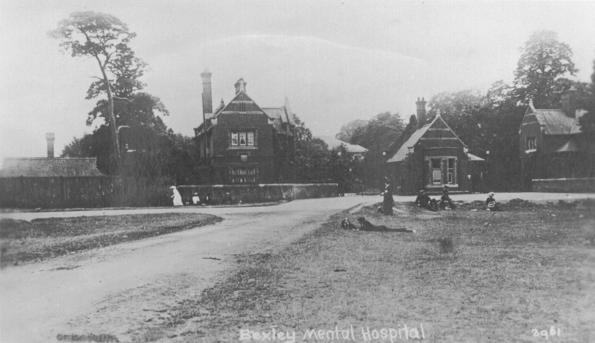
The family consisting of Father Charles, Mother Ethel, Brother Ronald, aged 3, and sister Joan, aged 18 months, and me. The hospital was an important teaching hospital until its demise so shamefully, hundreds of doctors and nurses and thousands of patients. Almost self supporting with its hundreds of pigs, herd of cattle, a resident farm bailiff and cowman, many acres of fruit and vegetables grown, and poultry, by the hundred with outside supervision.
The patients supplied the labour, and were very jealous of their occupation. I was eleven years as a boy, with my friend Len Sandford the head cowmans son, we used the farm, cricket pitch and all aspects of the hospital as a wonderful and private play area. In those days 1926 into the 30’s the hospital produced many operas and plays by their own Amateur Drama Soc run jointly by the doctors and nurses. The annual ball in the lovely hall was an event of the year and tickets were in great demand.
Patients of course had their weekly film shows and dances also their sports days. It would take a very large book to tell all of Bexley hospital in its Hey Day.
In spring of 1926 I was enrolled at the Maypole Council School and so started a period that I can look back on and say “It was smashing”.
A quick educational check placed me in standard six under Mr Wellington. There was five classes, starting with the infants, then two junior classes, taken by lady teachers, Miss Pinkney was one, I forget the other names.
Standard six was taken by Mister Wellington and Standard 7 and 7x by the headmaster Mr Snell, five really 1st class teachers. School hours were nine until 12.0 o’clock 2.0 PM until 4.0 PM with a break of 15 minutes playtime morning and afternoon.
The school day started at nine o’clock sharp when a teacher blew a whistle and everyone in the playground stood still, on the second blast we smartly moved into the hall (made by sliding a divider across two classrooms).
Mr Snell officiated, he was a deep breathing fanatic and with windows open we would on the count breathe in till about to burst, hold it and expel rapidly. Then with a pupil (Vera Saunders) on the piano he would sing the scales in two or three keys, we were now ready for the hymn and prayers by Mr Snell. Afterwards he would make any announcements affecting us. We were then marched quietly to our classrooms.
My class standard 6 under Mr Wellington comprised about 45 pupils, he was a very strict disciplinarian dealing out a vicious six of the best and impositions, “I must talk only when necessary”, to be written 100 or 200 times in your own time and to present it to him next day. I had more than my share and deserved it. He was a fine teacher of many subjects. The Bible, maths and English, drawing, drama, literature, singing, he was a good pianist, he also took gardening, geography etc.
On Monday afternoons with all the gardening tools held at the correct and safe angles we would march to the school allotments. All the boys from standard 6, 7 and 7x took part and the girls did needle work and cookery. The lots were divided into small individual lots under a pupil who would grow and experiment fruit and veg and to compare results and treatment plot by plot. A very useful and enjoyable lesson, to finish with a thorough cleaning of equipment. How those spades and forks shone!
Talking in class was forbidden and punished, Mr Snell would visit the class and say “Good morning class” the class would stand without of any noise of desks and seats say “Good morning Sir” and very quietly sit with straight backs and folded arms. At a certain age you moved to standard 7 with Mr Snell who took woodwork on Monday mornings and maths moved up to algebra etc. Mr Snell took great interest in all school activities which in those days included Empire Day (May 24th I believe), chairs would be borrowed from the hospital placed all around the play ground, the maypole was erected and ‘tilt the bucket’ frame put up. Children were dressed in National costume so there were Welsh, Scots, Irish, English (John Bull), Canadian, Zulu’s, African’s, Australians etc. We would march, sing the National songs, various tableau would be performed, the Maypole danced , Jack O the Green and a clown (me) performed, hymns suitable and the National anthems sung to end the proceedings.
Armistice day was observed by the whole school with all the sad hymns to be sung, Christmas time was so special, a play was put on or a series of sketches, chairs again borrowed and the hall filled with parents, evenings and afternoon performance.
Mr Snell was a good artist and would paint all the very large backcloths. The last I remember was a Dutch canal or sailing barge, windmills in the background, for a cantata “Jan of windmill land”.
It was a very friendly school. I never saw any bullying, play times were filled with the current seasonal games; Tops, Cigarette cards, marbles, conkers, five stones – all in their special time of year.
Football and cricket played with a tennis ball took up a lot of time and many players could join in “Seven + seven x against the rest” was the war cry. Girls of course did all the things that girls do, skipping etc and mostly seemed to be in little groups one of the most unusual customs was the use of nicknames all of which had a reason for their existence:
Bogey ELLIMAN ****** BLACKMAN Massa PETERS (me) Manny ELLIMAN Gump HENN Diddy HENN Taffy WELLSPRINGS Bessy WOOD Fatty MEACHAM Bunter MEACHAM Tiptoe FORD Glarni HOGAN Skinner BEDWELL Dinah DYSON Tongy THOMPSON (captain) Smut SMITH Eno SMITH Spadger BARRETT Sanny SANDFORD Many more which I have forgotten. Christian names were never used. In fact my best friends mother asked my mother how her “MASSA” was thinking it was my name as I had been poorly at that time.
AFTER THOUGHTS
Mr Wellington was Dooky (DUKE) Mr Snell .P.C. or Peecy He promised to track down wrongdoers like a policeman hence P.C.
I must not forget Charlie Lawrence. A Negro boy who lived with his white mother next to Vines. His father was killed in the Great War at Sea. (HMS Hogue) Charlie was the happiest lad I ever knew, a great friend of my brother and often in our house. He was conscripted in 1939.
Below - photograph of Charlie LAWRENCE taken in rear garden of Baldwyns Road (Backing on to Beaconsfield)
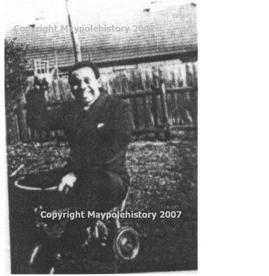
He died in a salt mine in Germany after capture I believe at Dunkirk.
He made the mistake of being black. We heard he died of pneumonia.
Footnote from Maypoleman . . . . . . . .
During WWII it was believed that Charlie joined the RAF. Records now show he was a soldier in the Queens Own Royal West Kent Regiment. He later became a German POW. George Stockford (Jnr) proudly remembered collecting food for red cross parcels for him. After all, his dear mate was safe. Not for long.
In November 1941 Charlie died. There were two stories floating around as to his death 1) he was shot - we are told whilst trying to escape - that was the usual reason, wasn't it - mmmmmm ? and 2) died of pneumonia after being worked down salt mines. Either way, we suppose this was nothing to do with his colour ?
He is buried in Poland. Two generations lost to enemy fire.
Most of these names plus those on the previous page were from one class. Class have 45 pupils
Winter with a good snowfall meant sledging. If you walk by road towards Crayford, on your left is the valley, the Dell, where we sledged. Seventy five years ago the valley was just grass, heather and some bracken. You could sledge down the end slope along the bottom to the style that is on the footpath to Bexley. Perhaps 1/3 of a mile, and people came from all over to enjoy this till quite late in the evening, some times.
The valley is now thick woodland with just a trodden path that runs through to the stile. In the summer sledging on the dry grass gave lots of fun. We were never bored, school holidays meant scrumping, stealing fruit from gardens and orchards to bake on a fire whilst we smoked “monkey chaff” a dried herb found in the Heath, rolled in newspaper, it was awful. Bows and arrows were popular also tracking games where one or two people would run off into the blue, the remainder on a given time to try to catch them. Various trees, mostly Hawthorn had names, the “Home Tree”, where games started and finished, was a very large tree the branches and foliage touched the ground to make it a big green tent. The “Action Tree” another Hawthorn whose spreading branches allowed us to jump and swing about in all sorts of action. “Slippery Jack” also a very hard tree to climb, it had a long slippery trunk with no grips. A scout group 4th Dartford was founded, a hall supplied (by the church) by Mr Cameron, a great benefactor of the Maypole Estate, he also gave us all the instruments for a drum and fife band and thus supplied a good many lads with useful pursuits.
I seem to remember girl guides being started too. Christmas time meant carol singing.
I had a very special friend John Palmer (we remained close friends all our lives) and he and I would go carolling and at the end would adjourn to the Maypole Café for hot pineapple drinks and share our takings, several shillings a lot of money in those days, it bought our Christmas presents etc.
Mr Bert Vine owned the Paper, Sweet and Tobacco shop and employed three paper boys, this job was much wanted and always had a taker ready as one boy left, my turn came, I suppose I was about 12 years old. I had to be at the shop by seven am. to mark up and sort my papers, magazines etc. When the bag was loaded it was extremely heavy and chaffed your bare knees (boys wore shorts until school leaving at fourteen). Then you had “Longuns”.
John Palmer lived in Summerhouse Drive, his house was called “In a Wood” and was the only house on the left hand side of Summerhouse Drive. I remember three large houses (one – Eltham Lodge) on the right, all the rest was virgin woodland in 1926.
My Round – Baldwyns Park, Summerhouse Drive, Tile Kiln Lane and Cold Blow. To return to shop and then do Baldwyns Rd. Seven days a week. Nobody had bicycles. Dinner Time (two hours off school 1-2pm) report to shop to do errands (1 hour)
Evening Walk to Bexley Station to collect evening papers, mark them and deliver them around Maypole Estate.
Saturday After morning round to collect paper money from that round, and if on checking the cash Bert Vine found you short it would be stopped from your wages. In the afternoon you would sit in the shop to errands until time to go to Bexley to collect and deliver evening papers (also to measure our paraffin).
Sunday Easy day just the morning delivery. s p My wages 3/6 a week and a dozen toffees.
After Thought. Vines also sold paraffin and petrol, two hand pumps in Beaconsfield Road (petrol 11 ½ d per gal) the petrol was drawn from the main tank by hand operated pump into a marked glass container, then gravity fed to your tank.
I was well pleased when in the summer holidays I was able to give my notice and take a job in Bexley at Mr Scotts High Class Grocer Delivery boy with a trade bike 15/- a week just for the holidays. I perhaps should mention that of my paper boys salary I gave my mother 2/6. and 10/- of my holiday job each week. Cricket and football has not been mentioned but played a large part in our free time activities played on the Daisy Green (where the watch factory now stands) and the Asylum Green a long wide grassy area between hospital fence and Wilmington Rd, now all trees and shrub. Girls – of course there were childish sweetheart relationships that bloomed and died all the time, nothing more. They were a pest.
After thoughts. I must mention “Mum” I forget her name, a mature lady who kept the classrooms clean and looked after the large coal fired boiler that heated the school. A much loved and friendly lady.
Other names remembered
F. James R. Tucker K. Lucas F T. Gordon D. Lucas F M. Gordon F E. Lucas F E. Smith F T. Gosling (Imbecile) E. Smith R. Gosling (cripple) R. Munday E. Gosling Q. Cole F A. Murray R. Wallis F F. Johnson R. Wallis M. Seal W. Meacham A. Elliman L. Bedwell S. Elliman L. Sandford M. Brooks F E. Thompson Captain D. King F M. Young F J. King F Ted Smith R. Cosselton F
Most of these names plus those on the previous page were from one class. Class have 45 pupils
I seem to remember girl guides being started too. Christmas time meant carol singing.
The Heath in those days was a safe place for kids to play and wander only once did a scare run through the neighbourhood, a murder was committed by the golf links 1928 I believe, the man was caught and I seem to remember he was found to have a mental history. There was a full time heath keeper who lived in a cottage with his family. The donkey pond in those days was never empty and in summer two feet deep, full of newts, frogs, tadpoles and it was there we sailed our boats. Most of the Heath was heath land. Open grass areas were plentiful, and Hills Dairy herd were taken to graze all day every day, in charge of a chap named Wickens who lived on the Maypole (Hills Dairy was in Wilmington on the Swanley Rd by Wallis’s Nursery).
The only other pond was the Penny Royal a small swampy area where the flower of that name grew.
At the end of Baldwyns Road stands the hut “The Maypole Hut” wedding receptions, whist drives, concerts and dancing all took place here. One of the major attractions was the Princesses Theatre where for 4 pence or 6 pence on a Saturday evening you could watch films which would provide a talking point for long afterwards.
At thirteen I had my first bike, in Bexley Village Bert Hall had a bicycle repair business and when he died all his bicycle bits and pieces (a lorry load) was dumped down a denehole in Joydens Wood, it was a treasure trove and I managed to get all I wanted to build a bike including a 3 speed Hub and a bundle of spokes. I assembled the lot and had a bike. I left the Maypole School in 1928 Dec, to start work, aged 14.
Ted Smith and I would go with Bill Hooks to cut the bracken for bedding for the donkeys that his father kept. The donkeys roamed the Heath, would be used for rides on fete days, so much ago.
The nature of the Heath has changed enormously, in 1926 one could stand opposite Maypole House and see nothing but bracken 4ft high right to Crayford corner. A solitary birch here and there and a clump or two of gorse, now it’s mostly covered with shrub and trees. This is evidenced in photographs on the page showing photographs 'Britain from the Air'.
Joydens Wood also was still 80% virgin woodland full of wild flowers. Bluebells, primroses, violets, lily of the valley, thick forest areas with many deneholes, and a flint lined roman well (on Brinkhurst’s land). Chestnut hazel and cobs were plentiful. Also crab apple it was
a wonderful place for boys to roam and play bracken 5’ high.
Bessie wood (I’ve mentioned him earlier) would pick bunches of these woodland flowers and sell at the hospital gate to visitors on Sunday. Also bunches of home-grown pinks, he never missed a chance and was a tough handful and works as a farm labourer. In Bexley.
The old shoemaker taught a young man (name forgotten) to repair boots and shoes and on the cobblers death made a good living doing repairs in a shed in his Badwyns Rd Garden.
Random Thoughts
Mr Edgeworth was the village bobby and had a quiet, peaceful existence. Crime on the Maypole never came to light to my knowlegde. Mrs Whibley was a person who lived in Denton Terrace, worked hard in all sorts of good causes, Sunday school, scouts and guides, it was she who arranged with a clothier shop in Bexleyheath to supply scout uniforms at a few coppers a week per person over a period. Mr Blackman also lived in Denton Terrace and was the Mayor of Dartford.
The Maypole Café has always been there, the shop next door was a boot and shoe repairers and the owner and elderly man did a good job and was well patronized on Maypole and in the hospital (1927). He was knocked down and killed by a motorcycle outside Westlodge in the hospital. The driver W.Boyce of Bexley was not to blame and the shop was taken over by the Cooperative Stores, Mr Bedwell manager.
After thoughts
Mr CURDLING (General Store) He would allow nurses to run up monthly bills for stockings, etc and very often was the loser by his kindness as the nurses would leave unpaid bills many times. Their work was hard and they were poorly paid. Mr Curdlings Shop was a special feature of the Estate. It was the biggest building on the estate embodied shop and two flats above.
The shop was long, dark, supporting pillars along it’s length – and sold everything tobacco and cigs, clothes, lengths of cloth, cold meats and grocery etc, etc. He, Mr Curdling, also run a car hire service.
He was the reincarnation of Mr Pickwick, stout, red-faced, jovial, a very special Maypole character. He held his 50th wedding anniversary in the Maypole hut. I remember him singing “My Old Dutch”.
He lived in a big old house that lays back from the Denton Rd, right opposite Crayford Corner football area, his daughter Joan still lives there, she must be in her advanced eighties and still very active.
These jottings take me from 1926 to 1929 when I left school donned ‘longens’ and went to work.
My intimate connections with the Maypole started to decline as new horizons beckoned but the Maypole Estate and its environs will always be very special to me. I got married from West Lodge in 1938, to a wonderful girl from Yorkshire, Anne.
Fin. Not quite! He said carry on.
Jan 1929 - July 1938
In Jan 1929 aged 14 I started work in engineering and tool room dept. of the Siluminate Insulating Company. My uncle was works manager so I started at an enhanced salary of 17/6 per week of 47 hours(7/6 for me 10/-. Mum).
I had my first new bicycle an Armstrong paid for weekly by my parents(cost around £3.10) so I rode to the factory at Erith alongside the Thames five miles. I was of course the shop boy, sweeping, cleaning, and making tea, several tin tea cans on a long pole, each with its screw of tea sugar and condensed milk, to be filled with hot water at the canteen.
Invitation to the industry consisting of an assault by several and the application of black grease to the private parts this was common place in those days.
A favourite past time in the 1920’s to 30’s was on a Sunday afternoon in the summer to walk the crossroad made by Princes Rd and Denton Rd and to sit on the grass and watch an almost endless stream of activities on the road. A column of hikers 50 strong
striding along packs upon their backs and often singing away. Cycling clubs 50-100 strong, 2 deep wheeling away to coast or where ever. Motorcyclists on so many different British made bikes – Norton, BSA, Ariel, Vellocette, Matchless, New Hudson, Francis Barnet, Scot, Ascot Pullin, to name just a few, Rudge Whitworth.
Coaches packed with outings and cars of many makes all British used to give us pleasure to just sit and watch. I eventually graduated to the operation of simple jobs on radial drill, milling machines, etc.
Finally bandsaw doctor, responsible for the sharpening setting and the brazing of broken saw bands. At 14 this was quite a responsibilty as saws were soon broken cutting 1” thick asbestos sheet, and a badly brazed join would play havoc.
In March 1930 this firm closed and moved to Manchester, I was unemployed. I applied to Hall’s and I obtain a job on inspection and burring benches, where I believe my talents were noted and I was transferred to the fitting shop, there to serve an indentured apprenticeship.
J and E Halls was a world famous engineering firm specialising in refridgeration, lifts, escalators, and much more.
After thoughts. Bicyles were the transport in my young days and one chap S. Ogilvy, cycled everyday to J and E Halls (where he was apprenticed) from Catford. Others from Farningham, Sidcup, Woolwich, were common place.
I should mention that at this period I bought for £3.10s my friends fathers motor cycle 250cc BSA Circa 1926 rode it for six months and bought a racing bike from the proceeds of its sale.
My starting wage at 16 was 11 shillings a week, I got half a crown pocket money or 1/6 I forget. My best friend John Palmer also started in apprenticeship as a plumber with OM Keevil of Dartford.
So we were both tied with little cash for five long years. With night school, three nights 7-9pm and one full day at Dartford Tech College. Never the less we saved up and bought a small tent, cycled with all our gear for a fortnight at Leysdown Isle of Sheppy. We did this in 1930 or 31 our annual holidays.
We decided at 17 to join the territorial army 5 Batt Queens own royal West Kents. C. Coy stationed at Dartford drill hall now council offices by park entrance in Lowfield St. The termination of this would coincide with our apprenticeship finishing.
This solved our cash shortage and catered for our annual holiday. In camp or Barracks we were paid 14/- a week (full army pay for a private 2/- per day) and our firm also gave us full pay for army camp. We were millionaires. You signed for four years.
We were both crack shots with the 303 short Lee Enfield, a marvellous rifle, a possible at a 1000 yrds quite often. We were battalion champions in turn and this fetched a few more bob in weekend shoots. We were both keen fisherman and cycled to Yalding many times on a Saturday cycling home to have an evening st the Princesses. We also belonged to Dartford Harriers Cross Country and track, more to keep fit than break records. Cycling was second nature Hastings and back one Sunday.
The Terriers had a boxing club and so began an additional interest I was Battalion and Division Champion for my four yrs service boxing at 9.9 and 10.7 lightweight and welter. Halls also started a boxing club and became well known as one of the best around. As a leading light I was then boxing six rounds, not done now.
As you can see our time was full and we were happy with our lot. Dressed to kill in our Sunday best made to measure 37/6, 47/4 with waistcoat, we were content until. –
We had three months to go to the completion of apprenticeship and army service and John Palmer said when I was arranging our Saturday, “Oh, by the way I’m taking a girl to the pictures Sat evening” this was a bombshell as we were always too busy to bother with girls.
So started his courtship and eventual marriage to Lilian Brown, John died in 1991 after a career with the Local Council ending as chief building inspector and quality control. A smashing chap and took infinate pains in anything he did if it was perfect it was near enough.
A few weeks later I met the girl I was to marry, Anne Arundel a sweet Yorkshire girl, a nurse at the hospital. At this time my pocket money was 5/- per week and would be spent thus on many occasions between Anne and me. 6d bus fare to Bexley Heath from the Maypole, two seats at the Regal cinema 3/-, 1/- for ½d of milk
tray chocolates and 6d bus home total 5/- all gone until next Friday. About this time 1935-6 I had left my employment on the outside staff of J+E Hall Installing refrigerator plants in ships, hotels, shops and fruit farms (I had a motorcycle).
I joined Fraser v Chalmers a well known heavy engineering concern steam engines for pit heads, turbines, coal crusher, conveyer and hoists for air craft carriers, really heavy stuff.
I loved it.
I now had a 500cc motor cycle so no more pedalling, and I was saving very hard to get married. I left Frasers and joined Vickers Crayford, engaged on highly skilled admiralty fire control gear, predicting gear for high angle guns, pompom predictors, torpedo calculators, where .0001” was a large lump. The Spanish was had ended Hitler helped by chamberlain and co was heading for war. Engineers were in demand and I took home £7-8 pounds per week av. Wage at that time £2-10s - £3, so I saved, got married 31st July 1938, and left West Lodge for 106 Chastilian Rd.
“That’s me lot”
Notes
Maypole Café Already there in 1926 and a kids meeting point to discuss the merits of all the many varieties of toffee bars etc etc. A cosy place for warmth and hot drinks in the winter. Ran by a Miss or Mrs Brooks if my memory serves me rightly.
Penny Royal A small swampy pond so named because it was home to a small blue flower ‘The Penny Royal’
Donkey Pond A pond always full in my young days. The donkeys drank there. (They were kept on the Heath by Mr Smith of the Maypole Estate).
Anti-aircraft guns at Leyton Cross A very large encampment with concrete roads, shelters and 3.7 inch guns were established on the Heath. Gravel pit cottages Two small cottages on the Denton Rd opposite Crayford Corner and were occupied by Gravel pit empolyees. One cottage now demolished and a much larger house instead built after the war.
Heath Keeper He had a cottage on the Heath. A family of wife and two daughters who attended the Maypole School.
The Maypole Itself (1926) Was errected in the school playground and Mr Snell (headmaster in my time). Would supervise all the dances.
Mr Blackman First Mayor of Dartford. Winnie daughter I believe, son still resides on the Maypole Estate.
Bowmans Lodge Now sadly demolished and should have been a listed building. Bowmen would meet there to hold their competitions on what is now Crayford Corner. It was Tudor origin and was lived in until the 1930-39 period. It served as a tea and refreshment place.
Broomhills Lodge At the entrance to Broomhills (the Cameron Estate) Mr Elliman and his family lived in the lodge. He was groundsman, keeper, he had two sons Arthur and Sydney also a daughter. The lodge is now demolished and replaced.
Memories of Barbara Ireland
My memories date from the years between 1957 - 1961. Our teacher in the final year was a Mr Brough. He was strict but fair. We were quite afraid of him, but respected and obeyed his direction without question. I will always remember him with fondness and admiration. We used to play British Bulldog and Kisschase in the playground.
The Eleven Plus was the big event of our last year, then most of us lost touch. I went to boarding school in Folkestone but most of my friends ended up at Dartford Grammar or West Hill. Eventually I met up with Jacky Rumble (who is mentioned on the website) at the Technical High over at Wilmington. I lived up at Joydens Wood. Somewhere in the attic I have several photos from those years at Maypole.It played an important part in my childhood.
Memories of Derek LOTT
My First Memories of the Maypole
Would be around 1942 about a year after moving there from Station Road Crayford. My sister Evelyn was born that year in the nursing home in Wansant Road. My dad along with Misters Pope, May, Perkins and a few others who for one reason or another were not called up to fight were part of the Home guard and did fire watch duties at night around the area. They used to meet in the public air raid shelter by the bus stop up by the school. This was also the place we all had to go to to collect our gas mask, young children were given Mickey mouse shaped ones in a cardboard box with a piece of string attached to hang it around our necks. Bexley Hospital was bombed several times by incendiary and other bombs, I remember standing watching as the planes tried to avoid the search lights and the shells from the mobile pom pom gun that the anti aircraft gunners from the army camp at Leyton Cross drove around chasing the enemy.
My dad was exempt from call up as he was to valuable to Vickers making guns, where he invented a couple of ways to speed up production of same. In July 1942 my mother gave birth to my sister Evelyn the same name as herself. As previously mentioned Evelyn was born at a nursing home in Wansant Road Bexley, while mum was there a German plane crashed just over the road in a field and the young pilot was brought into the nursing home. The nurses and young mothers felt sorry for the young pilot when the police came and took him away, as yet they did not know of his doings only a short time before the
rash. He had been shooting at school children in and around Dartford West as they came out of school. One young lad had his bottom shot off by machine gun fire while cleaning his mother’s windows.
Later at the age of four I was to attend St. Michael College also in Wansant Road as a day pupil. Soon after this the school was renamed “The London Choir School”. While there I lost a friend who on the way home from school crossed the road and was knocked down by a laundry lorry and killed instantly. I was off sick that day or I would have most probably have been with him, as we often crossed there together to buy a penny bun from the off-license come grocer shop down the dip (Baldwyns Park) as it was known.
Soon after this Hitler started sending over the V1 rockets commonly known as the doodlebugs, these eerie sounding rockets had short wings and a tail with an engine fixed to the top of it from which exhaust flames could be seen . When the fuel ran out and the engine stopped. Every one would huddle in a corner and wait for the inevitable bang; if you heard it you knew it wasn’t your turn this time. I remember laying in bed one night with mum (dad was on air raid warden duty or nights at Vickers, when a doodle bug came over so low that we could see the flames from the engine as it passed over our roof. It was that low that it took the chimney pot off the roof of a neighbour across the road, before running out of fuel and landing in the allotments just 300 yards away, being so low it hit the earth softly and we were able to see the engine intact the next day. Shortly after that Hitler started sending the V2 rockets that were even more frightening, you would hear nothing until they hit their target.
I can remember watching a dog fight over toward the Joydons wood area and seeing the loser bail out and watching as his parachute opened. One also fell in the nursery of the Maypole House. The Winters who owned the Maypole house used to sell products to us from their nursery; where now stands the Rolex watch factory. Mr Winter was a director of the Co. Tony Winter would have been the youngest boy: A tragic family, three off whom committed suicide.
Mr Pope was later to to keep his horses in the Winters field. Mr Pope used to sell logs from his horse and cart, many a day I would have helped Alan, Ian and George Pope saw up logs for their father; sometimes by the light of an oil lantern.
During the war everyone had to carry an identity card with them where ever they went. I can remember that a police man would get on the bus and check them, he usually got on just where the bus came off the heath and entered Shepherds Lane. On one occasion Mum was questioned at length (much to her embarrassment) on the bus and this was later followed up by a home visit from the police. We later learned that a German P.O.W. Had escaped and had taken on the identity of a Dutch Pilot using the name Van Lott. A book was later written about him and called “The One Who Got Away” as he was the only German P.O.W. To escape from this country.
After leaving St Michaels Collage I went Yorkshire to live with my old great aunt for around nine months on my return I went to school at the Maypole Primary. Miss Gaspar was the head teacher who had taught my Mother at St Albans Road school Dartford, and did not like my mum for reasons that I will not go into here. She immediately took a dislike to me and bullied me all through school, I was caned often and can honestly say that I had never committed the offence for which I was punished. I was stood in front of all the teachers during my first week there and she told them to keep an eye on me as I was trouble; *****. She also would not allow me to sit the eleven plus.
In my class there were Allen Pope, Lindsey Fisher, Anthony Hancock, John Morgan, Peter Howard, Howard Rogers, George Govier? Janice Scott, David Bainbridge, ??? white, Maureen Green, Christine Harper, Brian Coleman, Anita Web, Judith ???, Barry Miskin, Averal Hunt and about ten more. I think I have done well seeing as I can not remember last w???.
Having not been allowed to take the eleven plus I ended up at Dartford West Secondary (no regrets), I did reasonably well there and held the record for bowling at cricket until the school closed some fifty or so years later.
Do you remember Curdling's Shop at the end of my Road (Beaconsfield), that nice smell of a small grocers shop where they cut, slice and weighed every thing by hand. Sugar weighed into a brown bag, sweets and lemon powder poured into a cone made of news paper, butter and cheese sliced and wrapped in grease proof paper; very little came pre-packed and the smell of the cheeses, fresh bacon, bread and other items all mingling to give that unique smell that I can smell even now. Mrs Turner worked there before Mrs Roberts Mrs Vera Barrett and Iris was it who married a G.I.?. Talking of smell I used to like the smell of leather and polish in Mr. Miles the cobblers shop.
Dad and Mum used to keep chickens and Rabbits to subsidise the meat and egg rations as many others did. Not like David Saunders and family who some time after the war ate all the pigeons I had sold to him. I think his Parents conned him into eating them as they did not like him keeping them in the garden.
Evelyn and I sang in the choir at St Barnabas, I until my voice broke. We received 3d a week if we attended choir practice and the Sunday service, this we would receive around Christmas time.
The post office was owned by Mr. Vine who used to sing and could often be heard on workers playtime; 247 medium wave, light program lunchtime radio. I can still see the face of the lady who worked behind the counter (ginger hair and glasses head always tilted to one side) selling sweets and cigarettes but can not recall her name. The other lady behind the post office was Mrs Vine. In those days every one was given the title of Mr. Master. Mrs. or Miss. Sir or Madam, no Ms. in those days.
Does anyone remember the winkle man coming round on a Sunday afternoon ringing a bell, Grooms baker and hills milk being delivered by horse and cart and the rag and bone man totting with his horse and cart? The only time a car came up the road was when the Doctor was making a visit or some wealthy visitor came by taxi even the local constabulary came on a bicycle. Mr Waterman the postman in Beaconsfield was the first to buy a car on the maypole I believe, and Mr. Pope and my Father were later to buy motorcycles and side-car.
As others have mentioned we had the maypole institute which was used for all
manner of things, youth club, ladies institute, dances, plays and other forms of entertainment. Members would have an annual outing to the seaside usually Margate or Ramsgate and occasionally to Herne Bay in a Grundens charabanc (coach). Of course there was the annual fancy dress show followed by sports, where we that won races were disqualified from ever running in amateur races as we would receive financial reward 2s 6d for first prize if I remember correctly. Of course non of us new at that time of things like that, it was all so innocent.
I joined the merchant navy on my sixteenth birthday and sailed to Australia via the Canary Islands and South Africa, returning via Aden, Suez and Bruge. We were one of the last ships to pass through the Suez canal before President Nasser closed it. I was a terrible sailor and within a year of returning to these shores I joined the RAF as a regular, In 1963 I married an Irish girl named Mary and in 65 moved into No. 30 Baldwyns Road which had been the house of the Hogan's. One of the Hogans remained in the house as we were later to find out. When any of our four children that slept in the top rooms fell ill she would visit them and stroke them. We told the late Mrs. Perkins about this and when Mary described the old lady who visited, Mrs Perkins said that it was indeed Granny Hogan. She dressed all in black and wore long black lace gloves and this was exactly how the two children that had seen her described her. We never told the children what the other had seen, yet both described the same woman. My Mother was first to say on visiting the attic bedrooms that it felt haunted and my dogs would not go to the attic floor.
Children I remember from my childhood on the Maypole would be:
Denton Terrace; Barbara May, Busters daughter who died so young, Willie and Nancy Beck, Dorothy and Barbara Taylor, Pat Flett, Robin Hunt? Barry and John Collins, Carol Slade, Averal Hunt, Pam Wright and Derek and Basil Bedwell.
Beaconsfield; Kim and ?? Button, Fred, Jean Perkins, Angie, Sylvia, Alan, Ian George Pope, Raymond, Beryl, Brenda Wibley, Valerie Eynon, Iris and Pat Connelly,Tony Smith, Janice Scott, Pat, Gill? Richardson Carlton Ball, Colin and Robin Wickens, Stan, Margaret, Jim, Pearl, Elsie Snowdens, Dickie Balcomb, Tony, Yvonne Clark, Brain John and Jean Parker, Maureen Green.
Dartford Road; Jackie Smith, Veronica Taylor, Jack, Norman, Moses Chalice. Christine Miles.
Heath End; 2 , Sonia & Nigel Windmill, Eileen, Barbara Jean Rivers,Steven, Marion Parker.
Baldwyns; Sheila, Audrey, Barbara, Joan Haulton, Joyce Stockford, Peter, Margaret Cadman, ?? Tucker, Christine, Ann, Joan Potter, Billy Fowler, Lee Smith, Mick & June Hogan, Tom Gosling, Gordon Lennox, David & Eddie Wooldridge, Willie, Stan, Molly Barrett, Angela Wibley, David Ann Mosses Mavis Proudfoot, David, Wendy Saunders, Mavis & ? Warwick, Roberta & David Cruickshanks, Michael Masters, Ken & Thelma Perkis. Dorothy Piper.
The Whitehead Girls I believe lived over in the cottage at Capt. James. Earl Read, Bob & Marion Shaw. Lived At The Hospital Gate.
Apologies for those I can not remember and for those who's names I have misspelt.
Memories of John BURTON
I used to visit and stay at Heath wood lodge as my schoolboy friend Edmond (Eddie ) Wainer lived There with his parents and elder sister he was in my class at the Maypole so must have been same age, or like. I can remember Mr. James a rather stern old man which we used to hide from as he used to tell us off, no doubt for doing things we shouldn't like going up the tower as it was falling down. The Scouts used the grounds as there camp site, during the summer and we used to stay with them as well. I remember a big lawn at the front of the house. Eddie and family moved to Wansant road First house on left by the bend, where i also used to stay, that was in the days of Dorothy squires being there his garden had an orchard along the back and we used to creep down and look through the hedge at the going's on at the swimming pool, I lost touch with Eddie when i was about 12 i.e. about 1950 as he went on to a private school I am sure he must have some photos of the house that you are keen to get hold of . Those were the days Regards John Burton
Memories of Edmund Wainer and Heathwood
Ed's recollections of his time at Heathwood . . . . . . and also the tower in the woods . . . . .
It started with a bang - quite literally. My father fought and was disabled in the First World War. He was not actually discharged from military hospital until 1920 and consequently took little part in the second. He was, however, because of his disability, allowed the use of a car and it was in this car, a very battered Hillman, that he collected us from rural Cheshire in the winter of 1944 to bring us down to live with him again at Heathwood. We had spent most of the war years apart as he had been transferred by his company to the factory in Erith and felt it too dangerous for us to accompany him whilst the bombing was still on. We had spent those years oblivious of the sights and sounds of the fighting. When we were approaching the heath, we encountered a very thick fog which got worse and worse the closer we got.; Eventually it became too dangerous to drive any further and we pulled into a pub for some refreshment and to decide what to do next. I remember it vividly as it was my first experience of bottled lemonade! When the bottle was opened I marveled at the stream of bubbles coming to the surface and the taste to me was exquisite. My mother was all for staying overnight at the pub but my father's will prevailed and we started out on foot with a suitcase of overnight things.
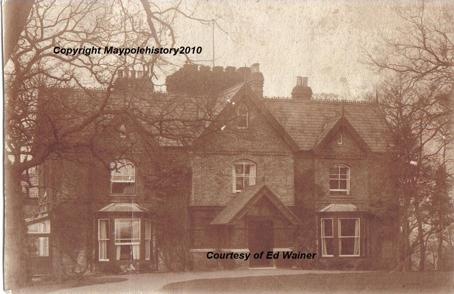
I wonder that he found his way at all as the fog was so thick but eventually we moved on a path over some heath, passed though some big white gates and along a gravel drive until we were suddenly overshadowed by what appeared, to a small boy, to be the most enormous building. Though the porch and the front door and into the cold dark house.
We were getting undressed to go to bed when it happened. The most enormous explosion that rattled the windows fit to bursting. We children were really scared as it came totally without warning and was something previously unknown to us. My father explained that it must have been one of the new V2's which arrived totally unannounced. There was nothing more, so we went to bed.
My father returned to the pub the next morning only to discovered where the thing had landed. The car was only superficially damaged but the pub much more so. Perhaps it was a happy omen for the contented years at Heathwood which followed.
We didn't own the property. It was actually owned by Captain James and his wife who retained part of the house for their own use. The Jameses were very private people and to tell the truth we hardly knew they were there. I was discouraged from playing on what must have been the west side of the house (where the conservatory was) but this was no problem at all as there
were fourteen acres of woodland altogether. There used to be more I had been told, but the old Dartford by-pass trimmed some of it off. I can recall visiting the James's side of the house on only two occasions - the first to the conservatory, which had a black and white squared marble floor at the time, and the second time to their kitchen which was warm and cosy as there was an Aga installed.
There was a lodge and a garage in addition to the house. The lodge was occupied by another couple. I don't remember their names for certain but Whitehead seems to ring a bell. I was never without an air gun at that time. First a Diana, which was quite tiny and suited my size at the time. after, I graduated to a BSA Major; a real air rifle and my pride an joy. As you can imagine, I spent a lot of time outside. I remember all the squirrels drays, the smell of the gorse on the heath during the summer and the annual fires where kindly firemen allowed us to "help" and hang around the fire engines. One of my most exciting memories were the Bren gun carriers which appeared from time to time and the one occasions we were given a ride by the soldiers!
There was also a sort of grassy bank on which the scouts used to camp every year. We used to visit whilst we were there. Whether that encouraged my later joining the local cub pack, I can't recall. I do remember on one occasion they were stirring what appeared to be custard in a big pot over the fire. It tuned out to be scrambled egg!
We were at Heathwood for VE Day. Great excitement with a bonfire and my cousin, who was staying with us, managed to get hold of some fireworks; the first I'd ever seen. We were also there for the winter of 1947. What a brilliant winter that was. Snow feet deep on the ground for months. A man at my father's factory made us a toboggan. Very professional looking with gave us hours of fun. Less fun for my parents, I'm afraid. When the thaw did come all the pipes had burst. They were mainly lead and offered little resistance to freezing. The bathroom was up in the tower and we had no water there for days.
It was in 1974 that I took my wife and kids to see the fantastic house I used to live in. I warned them that it was likely to be derelict as it hadn't been lived in for years. Imagine my surprise when it wasn't there at all. All that was there was a very large cutting carrying the new road - a great disappointment.
The below is an extract of E Mails sent by Ed regards a strange tower in Churchfield Woods . . . .
The tower as I remember it was isolated in the woods; no other structures around and nowhere near the road. It was built entirely of steel in concrete footings - no brickwork that I can recall. The framework was a lattice work of girders similar to electricity pylons and the platform at the top was an open box of flat galvanized iron sheet in a metal frame. Access was by ladder through a hole in the floor. If I were to guess where it would be on the map, I would put it slightly lower than the 'Chu' of Churchfield. We used to walk to it from the Southernmost tip of the wood, just past the junction of the two footpaths coming down from Wansunt Road.
The map is fascinating as it shows both Heathwood and our house at Wansunt Road. All of the houses are represented as if they were terraced blocks whereas, as far as I can remember, all were detached properties. There were only four between the two footpaths; we were at No 1, next door were the Osborn's, who had a furniture retail shop in Bexleyheath, next was Mrs. Chapman, a widow I presumed, who used to send me to buy cigarettes for her - Du Maurier Cork Tipped as I recall. The last house before the next footpath belonged to L. Hugh Newman who was an expert in butterflies. The fruit trees in his garden had branches frequently covered in fine netting; not to keep the caterpillars out but to keep them IN! You will note that there is a gap beyond his house before the entrance to the second footpath. The former owner of all the property enclose between Wansunt Road and the two footpaths to the West, was resident in the small manor house on the southern junction of Wansunt and Heath roads. When he sold the property for the building of the four houses, he imposed a covenant preventing the building of anything on that stretch of land to the North of Newman's house or on the triangle of orchard garden belonging to us. This was to preserve his uninterrupted view of St Mary's Church in Bexley village from the windows of his house! The covenant must have been subsequently overturned leading to the proliferation of new houses as seen today.
Interestingly, the house on the other side of that footpath had a swimming pool and was the home of Dorothy Squires and her husband Roger Moore - yes, the Roger Moore of 'The Saint' and 'James Bond' fame. I remember being in the butcher's shop in the village when my mother gave me a friendly nudge and whispered, "That's Dorothy Squires husband". I looked up to see a tall, extremely good looking, tanned young man - not yet famous in his own right but only as being the husband of a well-known singer!
Memories of Ronnie Potter
My first memory is of Mrs Rivers pushing me down Baldwyns Road in a pram. There are flags and bunting strung across the road so it must be some kind of street party. The only party we had at about that time was for the Coronation. My mum says I was too young to remember anything at two or three years old, but I do. Thereafter I don't remember anything until my first day at school. I recall sitting mid-way down the left hand side of the classroom and being told that dinner wouldn't be too long. It ruddy well was! I remember that, and I lost a little respect for the teaching profession that day. If you can't trust them to bring your dinner along when they say they will, what chance have they got of convincing you that there was a battle in Hastings in 1066? I reckon it could have been anytime between 1060 and 1070, and that's giving them the benefit of the doubt. I began to question things from about that time. "Today we're going to learn about the Hundred Years War." "I say it was seventy five. Any advance on seventy five?" "Ronald Potter, go and stand in the corner." That's my third memory. And fourth. And fifth.
The corners of various classrooms in the Maypole County Primary School. Later, and I mean much later, I found out why I don't remember much of my early years. One of my teachers, concerned about this apparently serene youngster in the class who had no interest in the blackboard or what the teacher was doing out there in front of him, asked my mother if I had problems with my sight. My mother said "Of course not! Not my little boy," but anyway, she took me to an opticians where it was discovered that I had abysmal vision in my left eye, and not too bright in the right either. From that day I've worn glasses. I was dragged from my reverie, that delightful dream world of dismembered voices and hazy shapes into the stark world of sharp images and 20/20ish vision and the sad realisation that voices came from people and not out of the ether. Wearing glasses was never the traumatic experience that people think it should be. I don't think any of the children noticed to be quite honest. We all accepted things without prejudice. It was not until I was in my teens that I realised that you had to learn prejudice, it's not a thing you're born with. For example, Richard Wight had contracted Polio at some stage and wore leg-irons. The only difference that that made to us was that we learned very quickly to get out of his way during the games of football we played with a tennis ball in the school playground. He would come charging stiff-legged through the middle of us all and God help anyone who got in his way. His legs were supported either side by metal rods and this made tackling him extremely dangerous. He was always picked first when it came to team-picking time.
The biggest problem with wearing glasses was that they got broken every week. There were several stages in the life of a pair of schoolboy glasses. The first things to go were the arms. This was an easy job to fix. Sellotape! Don't ask me why it had to be Sellotape for the arms, but Sellotape it was. It normally lasted for two or three days until the sticky started to wear off, and then it needed some more. This continued until the glasses were sticking out an inch from your head and the Sellotape started sticking in your hair. In those days we all had short back and sides, with a quiff hanging down the front. Or in my case, having wavy hair, kiss curls. When the hair got stuck in your glasses you swept it out of the way and inevitably knocked the glasses off your head and smashed the left lens on the floor. Always the left, thank goodness. The right and I would have been blind. The only way to fix broken lenses is, of course, pink Elastoplast! And that is how you walked around for about three weeks of every month, for that is how long it took to get replacement glasses. You had a great ball of hair-covered Sellotape sticking out of the side of your head and a junior version of Blackbeard's patch in pink over one eye. It was so commonplace as to arouse no comment. Any more than your front teeth falling out and making you talk with a lisp. Can you imagine what you'd feel like as an adult if all these things happened to you at the same time? You'd be afraid to go out of the house and face your peers.
Life at Maypole County Primary School was never very stressful as I remember. Lots of playtimes and swimming lessons at Hextable. School sports days where none of the children cared who won or lost. We'd all had numerous races in the playground and knew who were the best runners, jumpers or throwers. Richard Wight was in great demand for the Three-Legged race, for obvious reasons, and always won, whosoever was strapped to his port side leg-iron. The able-legged person was the one who had the greatest problem, trying to keep up with the expert. Opposite the school was Bexley Mental Hospital, another great influence on my life. Life on our estate revolved around the Hospital. A lot of the mothers did cleaning jobs during school hours to help make ends meet. The patients themselves were all relatively harmless, the violent ones being locked in closed wards. We soon got to know the regulars. There was the Black Widow. Always dressed in black, she had taken a shine to blond, angelic Simon. Every time she saw him she would give him sixpence. He was a little scared at the fact that he had been picked out from the rest of us and tried to hide down the alley when he saw her. We, on the other hand, would keep an eye out for her and drag Simon up to her so's he could get his tanner Then it was toffee chews all round. Poor Simon had to spend the money as he would got a clip around the ear if his Mum and Dad found out he was taking money, "Off a Patient." That is what they were called. Patients. There was never a case that I can remember from the children or the parents of cruelty concerning the Patients. They were a part of life and accepted as such. Even when one shat on the doormat I can remember my sister Anne saying, "I'll clear it up Mum. It was only one of the Patients." Mind you, Anne always was a little saintly and later went to Africa as a missionary.
There were times when the Patients did things which did reflect a bit on the community. The worst case didn't affect the Maypole Estate kids, but the kids being brought to school by bus. There was a Patient without a name but known to all the kids because she often wore a wedding dress. Rumour had it that she had been jilted at the altar and that that had turned her. This particular morning at about ten to eight, resplendent in her wedding dress, she dived under the school bus and the wheels ran over her head. There was a lot of screaming and puking, mainly by the adults, and none of the teachers would talk about it at school. We all knew, of course, because the kids on the bus had been sent home for the day and there were empty places in the classroom. We all rushed out at the end of school to see the blood, but the Fire Brigade had hosed it all away. That made it even more spooky. We began to wonder if it had really happened, and became a little jealous when the kids who had seen it came to school the following day and told us all about it. One of them said he had been thrown in the air and had landed in the aisle when the wheels ran over her head, but I'm not sure I believed him. In retrospect, I suppose the most dangerous of the lot were the Patients with sexual problems.
The Hospital and indeed the school bordered onto Dartford Heath, and these Patients used to wander the Heath exposing themselves to the children. The first time it happened to me was scary because I'd never seen a mature erect penis. I thought the poor bloke was deformed or had had an accident. I remember crawling into bed with my Mum later that night and her consoling me and explaining that they were Patients and that they didn't know what they were doing. She told me that I should run away if it happened again. I became a very good runner after that. There was one Patient who used to expose himself to the school bus bringing the older kids home from the Secondary Schools in Dartford. He used to leap out from behind the same bush every afternoon. The police used to nick him every so often, but he was a Patient so they couldn't do much about it. I did hear one of the parents say that he should, "Be bound over to keep the piece in his trousers," but I didn't get the joke at the time. Dartford Heath was good fun. We had a gang, me and David McKeough, Richard Wight, Paul Elliman and his brother John, the Conboy brothers, Richard and Kevin, (Kevin smoked!) And John Warwick came along later. We would play Commandos and build swings down the Dell. These swings were built on the side of a hill and you could swing out to about thirty feet above the ground. The Heathkeepers used to come around every so often and catch us if they were quick enough and tell us off and cut down the swing. Once in a while one of us would fall off the swing and break something. This gave you a great deal of status, of course, and you could boast about how much it hurt and what it was like to have an X-ray and how brave everyone had said you had been. Never mind the fact that you'd screamed like a stuck pig when it happened, so much so that all your friends had run away at first, in case you died and they got a belting for playing on the swing.
Mr. Winter owned Maypole House, a big castellated house to one side of the estate. He had large grounds to the house and the whole was protected by hedges or high fences or walls. Mr. Stotford was his groundsman and he lived a few doors down from us. He had lived all his life on the estate and knew all of us and all of our parents. The problem with the Winter grounds were that they were between the Maypole Estate and the best playing areas of the Dell and the Dip. So we used to climb over the wall at the back of Dave McKeough's house and run the hundred yards or so to the chain link fence at the other side of a shallow valley, clamber over this and make our way into the woods and down into the Dell. At first Old Stottie couldn't catch us. And then he got a Power Mower. The first time that he came roaring out from his shed and down the valley, we all froze. It must have been hilarious to watch. We all ran in different directions howling at the top of our voices. Richard got caught because he couldn't get over the wall with his calipers on, and none of us stayed around to help him. Later that day Mr Stotford came round to all our houses told our parents that we had been trespassing and that next time it would be the Police. Richard had been taken to his house by Mr Stotford and Mrs Wight kept him in for the weekend. We all thought that Mr Stotford had tortured Richard to get our names and then buried him in the grounds. Stottie had been in the Army during the war and wore a thick leather belt with Regimental cap-badges studded all round it, so he knew how to kill people. You can imagine our relief when Richard turned up for school on Monday. I was always a bit wary of old Mr Stotford after that, though. He looked like he would have liked to kill or torture us when he was charging down the valley astride his motor-mower, like a motorised member of The Light Brigade. We weren't really naughty, just adventurous and full of life. Sometimes we would overstep the mark and the Police got involved. The first involved a scrumping expedition into the orchards of the Hospital. We kicked in a couple of fence palings, climbed through and filled our jumpers with cherry-plums. Then we moved along to the apple orchards. I had no more room up my jumper and was a bit scared so I told the others I would wait outside and keep watch. It couldn't have been two minutes later that the Police drove past and saw me lurking guiltily next to the hole in the fence. They stopped and came across and I came close to peeing in my pants.
My Dad had been a copper and I knew what would happen to me when I got home. They indicated that I should get in the car without saying a word and settled down to wait for the others. As each of them came out of the hole in the fence they were lifted by the collar and stood to one side of the hole out of sight of those still inside. When we were all out they bundled us into the car and took us to the porters gate at the entrance to the Hospital, where the porters took our names and addresses which they used to send our parents bills for the repair of the fence and for the stolen fruit. Of course none of us told our parents what had happened, and about three or four days later and two minutes after the postman had been, what sounded like air-raid sirens could be heard from half a dozen houses on the estate. It was, of course, each of us wailing after being slapped or belted by our parents. Three shillings and ninepence was the bill. When my sisters heard about it I got another telling-off and poking me they said, "You're supposed to be a boy. We never got caught when we went scrumping." My mother wanted to know where the fruit was. I told her that I had been too scared to bring it home in case she found out. She then did something I'll never forget. She sent me out to "Get three shillings and ninepence worth of fruit and don't get caught this time!" I don't think any of the other kids got these instructions because this time I carried out a lone mission. I was terrified in case I got caught by the Police again or even worse, by a Patient. No-one has ever hopped over a fence and filled his jumper full of cherry-plums so quickly in their life. And all the time sobbing, with my eyes filling up with tears. It did the job though, and I never scrumped in the Hospital after that. We targeted the orchard next to St Mary’s Graveyard instead, where it was quieter and the Police didn't drive past. We discovered it when we were covering for the choir in the St Mary's, who were away camping. We all belonged to the local choir at St Barnabas Church. Every Wednesday evening we would turn up for choir practice, except for the Conboy brothers who were Catholics, whatever that meant. As soon as practice was finished we would go down to the fish and chip shop at the bottom of the Dip and get fourpen'th of chips and some crackling. Then we would walk back up the hill to the Estate climbing the lampposts and swinging on the cross-trees at the top. Dave McKeough did the best impression of a monkey, especially with a bag of chips in his hand. The road was badly lit and ran past the Hospital which had a high wall and a fence atop it. On the other side of the road was an annexe to the Hospital, which was in fact a convalescent home for minor mental cases like nervous breakdowns or alcoholics with DT's. The Annexe had a cowfield around it into which St Barnabas protruded. Every time the organ played in the church the cows would come and lean over the barbed wire fence at the back and gently chew the cud and low. That was until we came charging out of the vestry after choir practice or a service and shooed them all away. Luckily they were only heifers or goodness knows what damage we would have caused. The cowfield was a useful short-cut to the allotments if Stottie was about in the Winter's garden. It was a longer way round and you had to run the gauntlet of the cows and the staff of the convalescent home. There was a bit of dead ground you could use though, and this was fun to crawl along. The allotments had a stream running through them. It wasn't really a stream, it was a ditch for the run-off water from the roadside gutters in the Dip. We used to dam it and get our socks wet and get covered in mud and have a great time there. Only if our Dads weren't working on the allotments though.
On a Sunday one of us in our family would have to take Dad his Sunday dinner to the allotments. Mum would serve it out onto his plate and it would be covered with another plate and wrapped in tea-towels. A pint of tea would be put into a milk bottle and that would be wrapped in tea towels too. Then whoever had been chosen to take it down, usually Anne, would have to get to the allotments as quickly as possible. Dad had two plots, one with fruit bushes and one with vegetables. He used to spend all day Sunday there, whether to get away from us or not I don't know. We lived well from the allotments, always plenty of veg in season and loads of different types of jam. Mum was good at jam. But not at chips. Dad worked for Barclays Bank; District, Colonial and Overseas, in London. He was a messenger and went off to work at six thirty every morning in a navy blue suit with silver buttons and a bowler hat and umbrella. He was always immaculate for work with his starched detachable collar and black tie. It was lucky that he did work for the Bank, for we were one of the first ones in the street to have our own house, bought and paid for. It cost £1100. When Mum blew the roof out of the scullery whilst cooking chips, Dad was able to borrow money from the bank and we had the scullery knocked down and an extension put on the back of the house with a kitchen downstairs and a bathroom and toilet above. It cost £800 to build. Before we had this luxury, we had had an outside loo, which Dad had brought into the dry by building a lean-to conservatory onto the back of the house. Baths had been taken in a tin bath for the grown-ups, or in the scullery sink for the kids. We heated the water in a copper boiler, and this was also used for boiling the sheets once a week, or for making spotted dick. We also had a number of sheds. Dad liked building sheds, so we had one for the bikes and Dad's tools, a coal shed and a back shed which was always full of things for the garden, like spades and forks, and for the clothes props. You had to climb over everything to get at whatever you wanted, because whatever it was, it was always at the back. I used to use the clothes props for pole-vaulting off of the shed roof and into the garden. My Mum used to go frantic and said I'd break my leg, but I never did.
Memories of Lee Smith
t's time to add my recollections to the Maypole website, as I have enjoyed reliving some of my life there through other contibutions.
First, some background to my family connections on the Maypole Estate.
I was born in June 1945 at West Hill Hospital, to Alfred and Joyce Smith, and called Lee. We lived at first with my Grandparents, Henry [Uncle Sun], and Annie[Aunt Nan], Bearcroft at number 28 Baldwyns Road. My Great Aunt, Lottie[Aunt Lott] Hoath, Annie's sister and her husband Frank, lived at number 22. The nicknames in brackets seem to be the names they were known by to residents of the Estate. Another Great aunt, Winifred Flett , another of Annie's sisters , and her husband, Walt, lived at 5 Denton Terrace, with their 4 children, Pat, Janet, Denise and Eddie. Eddie is a year older than me, and we were playmates while at school.
When I was about 5, we moved down the road to number 40, I remember being involved in the move, in particular having to carry the chamberpot down the street, with instructions not to drop it. It was empty, I hasten to add. My Grandfather had retired early due to poor health, from work in Bexley Hospital, where he was a stoker, a job he knew from service in the Royal Navy. I think at the time, my Uncle Dennis, Mums brother, worked there too, in a similar capacity. Dad also worked there as a plumbers mate, until the early 1950's.
My sister, Penny, was born in July 1953, and it was a regular job of mine to push her pram from the front garden to the back, or vice versa. The house always seemed to be so big, with its 3 stories, and when Penny came along, I was moved from the back bedroom to the attic. This was a big room right up in the roof, with sloping ceilings almost down to the floor. It also had a little cupboard under the eaves at the rear that my sister believed housed ghosts and monsters. I well remember laying in bed and hearing fluttering noises that kept me awake in fear of the unknown. Birds or bats, no doubt.
In 1950 Keith and Betty Williams, and their daughter Lesley, moved in to number 44 Baldwyns Road. Lesley and I used to shout insults at each other over the back gardens. Little did I know that we would marry in 1968, and move in to number 36 for a couple of years, until I joined the RAF. Keith and Betty later moved out in 1968 to Birchwood Road, near Puddledock Lane.
When we moved in to number 40, there was a brick and concrete air raid shelter in the back garden . Dad dismantled it and buried it, laying grass over it. I helped him[well, at least I was there] to cut down a tall tree, and that probably got used for fire wood. It was a good house to live in. and I have a great deal to thank my parents for in the way that they brought me up, and the happy childhood that it had.
My friends included George Pope, Louis Cruikshank, Roger Dyson, Tony Clark, Philip Balcombe, Billy Lynn, Johnny Parker and more. Poor Johnny died in a motorcycle accident on the A2 on the far side of the heath, at the age of 18 or 19, coming home from evening classes in Dartford. We were the Maypole Gang. Their were rival gangs, in particular, the Crayford Gang, who we had a caterpult fight with on one occasion, across the valley in the Dell. I don't remember anyone being hit by a missile, no doubt because the caterpults didn't have the range. The Dell was one of the most visited areas, mainly because of the rope swing. We also took our bikes and carts there, and rode them down the sides of the Dell, to see how far up the other side we could get. We used to go up the footpath, over the field, to the apple orchard on Cold Blow, and go scrumping. We were chased by a man with a shovel on one occasion, but we got away. If you turned right along the edge of the field before going in to Cold Blow, there was a wood about 1/4 mile away, on the top of a rise. In this wood, adjacent to the A2, there was a hollow with a shed in it. We thought a man lived in it, and we would go and spy on him. I don't remember ever seeing him, though. I would have been 11 or 12 at the time. There were far less constraints on the activities of children then. We just had to be home for tea.
As previously mentioned, my Grandfather was a stoker at Bexley Hospital, and was employed there during WW11. There was an often repeated tale in the family, of when Grandad was keeping the fires going overnight during an air-raid, but he carried on stoking until morning, when he looked up and saw a hole in the roof. Soon after, he was tending the boiler, when he saw a dud bomb lying in the embers. Now, my Grandad was a great story teller and exaggerator, so it may have been another of his tales, of which he had many.
My Mum wanted to be a Land Girl, but as she was working off Tile Kiln Lane somewhere looking after two elderly sisters, she was told that she couldn't. She told us that she was riding her bike to work one morning, along Tile Kiln Lane, when a German bomber flew over very low. The rear gunner fired his machine gun at her, but thankfully missed completely. She said that she was so petrified that she couldn't even get off the bike to hide in a ditch. Seems I'm lucky to be here. She also told us that she had to do a turn fire watching[ARP?] with Mr George Stockford several times a week. She said she used to be more frightened of Mr Stockford than the air-raids. She would have only been about 18 at the time.
Some time ago, my wife and I took a short holiday in West Sussex, to research a church and graveyard at Ditchling that has links to a branch of her family. While we were there we visited a Museum that has old buildings from around the country that were dismantled and then rebuilt there. We were surprised and pleased to find a 15th century building that used to be in North Cray. It was dismantled and kept when North Cray Road was widened in the late 1960's, with the intention of rebuilding it in the area, but this never happened. Subsequently it was given to the Weald and Downland Open Air Museum for reconstruction. There is a website which has details of this building that some may find interesting.
Much has already been said about trees on the heath that we gave names to. I only ever managed to climb the Slippery Jack a couple of times. A favourite tree when I was about 10 was the Action Tree, which I also knew as the Helicopter Tree. I don't know why, perhaps because of a particular game that we played. This tree was between Leyton Cross Road and the Middle Road, about 300 or 400 yards from the Hospital gates. I always thought in inches, feet and yards then, so it seems appropriate to use them now. George Pope could swing upside down, by his legs, like an acrobat, from a branch on this tree. When I tried it I couldn't get back up onto the branch again, and had to drop to the ground. It seemed such a long way up then, and of course, none of my mates would help me. They just laughed. The broken neck soon healed[only joking].
About the same distance from the Hospital gates, on the other side of Leyton Cross Road, were the cherry plum trees, which always tasted so good that we ended up with bad tummies. We got in through a loose fence panel usually, but were not averse to getting a leg up over the fence. We would post lookouts and stuff pockets and shirts with as many as we could, then share them out later. We were chased, half heartedly, sometimes, but never got caught. I took some home once, and Mum knew where they had come from, but said nothing. No doubt she had been involved in the same escapades in her childhood. In the 1960's, and probably before, the Hospital farm was run by a Mr Read. I was an apprentice motor mechanic at John C. Beadle, in Dartford, with his son Roger, who later emigrated to New Zealand. There was another son, Earl, who was a year or two older. I don't remember it being a very productive farm at that time, but I heard a lot about it in previous times, when it provided much of the food for the hospital.
Having played on the heath for all of my childhood, I came to know it very well, like the back of my hand as they say. But when I first started to venture out, at about the age of 7 or 8, often we didn't know which way was home. After getting home late one day, we realised we needed some method of finding out where we were. It must have been an older playmate who told us to climb a tree, and look for the hospital chimney. At that time it was visible from most of the heath. We all must remember the heath's landmarks, like the trees, the Penny Royal, the Donkey Pond, the Glory Bumps, the Army Camp, etc. etc. I would still like to know what the Glory Bumps were for. We didn't have the luxury of mountain bikes. We used whatever we had, sometimes cobbling something together from parts, mostly without mudguards and brakes, and rode these contraptions everywhere. The Glory Bumps were especially exciting when negotiated on a bike with dropped handlebars.
There was an occasion when Johnny Parker and I were in the Dell, when we found some older boys, who we didn't know, constructing a take-off ramp in a gully that led downhill, past the swing tree. When they had completed it, it was about 18 inches high. They had a racing bike with them, and were goading each other to ride over it. After a while, and several aborted attempts, I said I would do it. The bike was too big for me, but I did it without falling off. I gained much kudos for that, at least for the day.
As a last item for now, does anyone remember that Mr Pope was a bus driver. He often drove on the 401 route, and I remember waving to him in his cab when I boarded his bus. In acknowledgement he would lift only one finger from the steering wheel. On a visit back to the Maypole in the 1980's, I saw him in his front garden, and just said 'Hello, Mr Pope'. He said 'Do I know you?' Mrs Pope came out and recognised me immediately. They were nice people.
Here's me as a teenager, in our back garden, no. 40 Baldwyns Road, holding our dog, Chippy, with the backs of no. 44, 46 and 48 shown. The other photo shows me in a nappy, about 1946, 47, probably in the back garden of the Hogan's, no 30 Baldwyns Road, with June Hogan, my Godmother. In the background you can see the Pope's house on the right, and I think, the Wibberleys next door, on Beaconsfield Road.
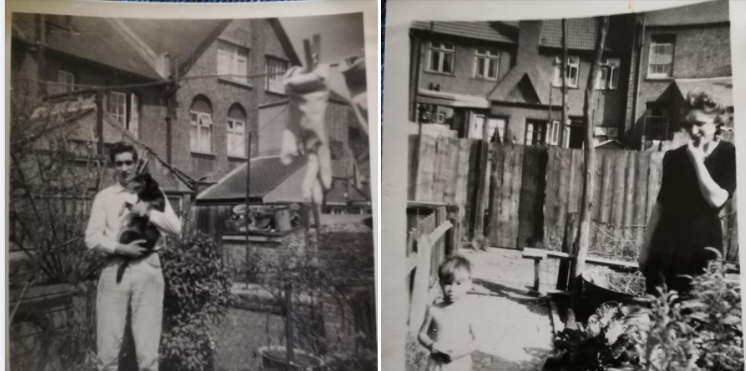
Below photos are of my Dad, Alfred William Smith. He joined the Army in 1938, was sent to France 1939, and was wounded in May 1940. He is the chap with his left arm in a sling, in the last photo. He was medically discharged from the Army, and spent the latter part of the war as a mikman in London somewhere. We lived at 28 Baldwyns Road with mum's parents, the Bearcrofts, until I was five, when we moved to no. 40.
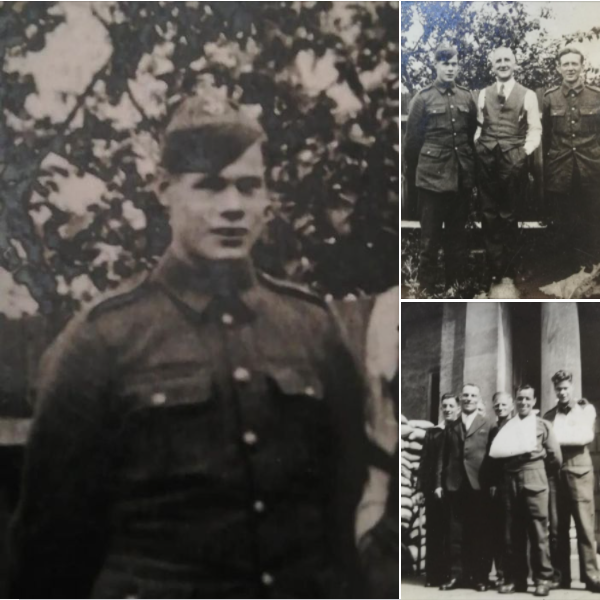
More later.
When I was still at school, at the age of 12 until I was 15(1957 to 1960), I had a Saturday job with Challis's Greengrocers. I would be there for 7.30 am to help load the Fordson lorry with Norman, and about 8.30 we would be off to Crayford, delivering veg all over the town. There was another lorry, a.Bedford, which was driven by Dez West, with help from another lad. They delivered to Bexley and Blackfen.
There were delivery rounds to other locations on alternate days.
The Challises organised a boat trip one summer, and poor Dez fell in and drowned. He was a smashing bloke.
When Dez died, Norman's brother, Phil, came back into the family firm, and took over his delivery round.
The day usually finished at about 7 pm, for which I think I got 10 shillings in 1960. Tips often made it up to a pound.
It wasn't unusual to call in to the Horse and Groom, at Leyton Cross at the end of the day for a couple. I couldn't go in of course, but in the winter especially, an arrowroot biscuit and a ginger wine would be passed out of the off licence door to me.
Although it was a long day, we never asked to use customers toilets, but drove onto Dartford Heath and peed in the bushes.
At the back of the shop, next to the kitchen, was the scullery, which had a.gas fired brick built, tub boiler for the washing. This was often used to boil a hundred weight(50 kg) bag of beetroot overnight. Then it was cleaned out ready for the washing.
Mr Phil Challis was still alive when I started there, but he had died before I left. He looked after the shop, and had help from a lad from Bexley, called Ernie. He sadly had a mental age of about 5, although he was in his 20s. Ernie was immensely strong, and would carry a 50 kg bag of potatoes at arms length into the shop, from the yard.
A Mrs Smith helped to serve in the shop, and did the housework and the cooking. Mrs Challis had passed away some time previously.
The lorries were usually parked in the ally between the back of the shops.and No 2 Baldwyns Road. There was a hump in the middle where oil dripped from the engine.
There was a poor old arthritic alsation dog, called Tony, chained up in the back yard. I felt sorry for him as he never got a walk.
There was also a very early 1930s Morris.car, possibly an Isis, that was rusting away.
I have to amend my story of the Challises. Phil Challis was the eldest, I think, and had his own business. It was Phil who came round on a Saturday with winkles, shrimps and cockles.
It was John who took over the delivery round.
Lee
From the Maypolehistory team - can't wait !
Memories of Robin Healey - nephew of the late Dennis Healey MP
Kim, you must have been an exact contemporary of mine at Maypole School. I was there from 1957 - 63. Of the teachers you list, I recall most of those , but do you remember Mr Tadgell, who taught music and who played Schubert on the piano at improvised lunchtime concerts ? Also, Mr Beresford. Mrs Chambers seemed very old and wrinkled to us. Did she retire before 1960 ? Do you recall she or another teacher warning us not to accpt sweets from the mental patients who would wander into the playground sometimes ?
Also, I recall the huge cans containing school dinners that were piled up near the canteen. My favourite dishes were gypsy tart and corned beef with beetroot and mashed potatoes. Worst dish---stew with lumps of fat and gristle ----uuuuurgh.
What about throwing sticks at the conker trees at Broomfield in the autumn. On the heath at playtime I used to pretend I was a tube train and stopped at bushes, which acted as stations. One day the freezer in the sweet shop at Baldwyn's Parade broke down and the shopkeeper gave away all the ice creams in it--must have been around 1961
Did you propel Dinky and Corgi racing cars on the playground at break ? My school mates included Philip Devey, John Fergusson, Martin McKim, and Richard Shears.
I moved to Wiltshire in 1963. I now live in S Cambs, but have returned to Maypole a few times in the last 30 years and was at the Reunion in 2002(?) , where I met Mr Tadgell again.
Robin Healey (b 1952)
Memories of Richard Wight
Memories of the Maypole County Primary School mid 50`s
Richard Wight enrolled September 1955
Headmistress - Mrs Chambers
Teachers - Miss Cridge, Miss West/Ralph, Mr Tagell, Mr Rawlings, Mr Beresford, Miss Phillips.
Playground Supervisors - Mrs Conboy & Mrs Rattie
Caretaker - Mr Stockford
Miss Cridge was good fun and obviously attractive as the male Teachers would blush at her low cut tops . Miss West was a blonde, 20 something who married whilst at the Maypole.
Mr Rawlings taught the top class in the portable building that housed the staff room, two teaching rooms, a cloakroom that separated them and doubled as an impromptu library! We sculpted from blocks of salt at Christmas and there was raffia at the back of the classroom for the less able. People don`t believe it when I tell them that when I started school I used a slate and sort of Brillo pad to rub out with !!If you were trouble you got the job of washing all the slates after class in a bucket of filthy water. PE and country dancing for a good measure of extra curricular activity was hilarious. Bean bag tossing, jumping canes at various heights, running on the spot was a favourite with identifiable coloured sashes not to mention hula hoops which pre- dated plastic and were made of cane. Music for country dancing was played on the school record player set up inside next to an open window overlooking the playground where we had to dance. Boys fell about at the sight of their friends making fools of themselves high stepping and light footed prancing.
We had tests for everything in those days, almost everything. From sight to singing, from spelling to tables, from running and jumping to reading and table etiquette. Let`s not forget the nit – nurse with her comb submerged in an enamel bowl of Detol. School swimming lessons took the form of a coach trip to Hextable school whose pool was a treat once or twice a term !!! The only cultural trip that I went on was to the Festival Hall to hear Handel`s Messiah when the Shot Tower was still standing on the now sited Queen Elizabeth Hall. The football match between Maypole and Oakfield Lane that we played on their strange hill-side pitch and Simon Ferrari`s winning goal. (Editorial - Simon was the brother of Nick Ferrari - broadcaster) Doug Cotterill was still smarting from that defeat when I met him some years later at Dartford West.
Mrs Chambers tried in vain to have me expelled from the Maypole when wearing leg irons, I copied the other children by inching around the railings that surrounded the entrance to the coal cellar steps. I had to be taken by my mother to the Education Office at Crook Log for a dressing down of my behaviour at the Maypole. Apparently the report from Chambers stated that I had climbed onto the veranda roof and that the school couldn`t hold responsibility any more. Well, that was a red rag to a bull for my mum and I was allowed to stay but on one condition. I would not attend playtimes anymore.......This led to chaos, with the other children constantly banging on the windows during the freezing cold as I made myself comfortable next to a radiator with a bottle of milk and latest copy of the Beano !!
Mr Tagell.......My Hero who smoked endless roll-ups and sported a brown cord jacket. He played the piano beautifully, wore round specs and camel desert boots.He was so inspirational to my interest in music and singing that continues to this day.Both Ronnie Potter and myself sang solos at the leaving concert that year.c1961 the song that I was chosen to sing was “Who is Sylvia?” and I can still hear Mr Tagell`s superbly played introduction. Ronnie and I both sang in the local St Barnabus church choir where we both had sisters in attendance which meant we had to behave. The Choir members I remember from the Maypole area were - David McQue (Head Chorister )Paul & John Ellingham,Ronnie Potter, Richard Conboy, Paul Hayward, David Hunt, Anthony Wilkinson and Malcom McDonald. Anne,Elaine & Christine Potter, Mary Wight. Choir practise on Wednesday evenings when we would be scolded for the previous Sundays sodding about followed by six of chips from Elsies shop in the Dip.
I had a paper round at Henderson`s and my responsibility was Tile Kiln Lane. John Parker had Baldwyns Park, Terry Young SummerHouse Drive, Owen Gemmell Coldblow and beyond, Ronnie Potter had the Maypole and Buster would set up the tables outside the shop in all weathers and lay out the papers ready for us to “mark-up” when we arrived at six, they were still warm !!!
Stan rode a moped and I seem to remember he lived in either Summer House or Red Lodge. He used to screen old cini films in the Hut/institute at the bottom of Baldwyns Road. The projector would always break down at the good bits leaving us to walk home dejected but hey........thanks Stan, this was all before Television !!! Tom`s cafe on the corner opposite the Conboy`s home where Kevin was a dab-hand at tilting the pinball machine to his advantage whilst knocking the ash off his cigarette with his little finger !!He had loads of horse brasses which adorned his leather jacket....
No school pool, cinema or even television, what did we get up to ? Lunchtime concerts were introduced by Mr Tagell and he would collar other staff to perform for us. Girls became an interest and many young couples would parade round the playground. Peter Hooten was assigned to carry me around when I had the irons on and we would often collapse in a heap admist tears of laughter. Funny thing was that when I moved into 56 Court Road Eltham whose smiling face met me at the door one day ? yes, rootin`, tootin` Hootin` He had only moved in next door !!! As my leg improved and came the day for me to walk iron-less, my mum had me enrolled in the disabled swimming class at Madam Osterburg`s across the heath. I became the envy of the school when on a hot summer`s day I would leave classes to cycle over the heath to the college and their lovely pool !!! And girls, one of which turned out to be Mary Rand !!!
and some more . . . . .
I have spoken to Owen Gemmell recently who remembers a couple of friendly patients who would give us money for sweets or fags. One I remember was called Harry the Fish and would do a dance for us throwing his cap in the air. He used to keep two, one pint beer bottles in each jacket pocket and two oranges which he would set up on each side of the road, wherever he wished to cross.
A bottle on each side with an orange stuck on top.......and hey presto, an instant do it yourself " Bolisha Beacon ". We used to laugh and point and I think it encouraged him.
Another torment was to follow poor old Eiddi as she would be shuffling across the footpath towards St Mary`s. My mother said she wasn`t all there and we were to be kind to her !!!
Derek Harris used to shout French ? to her which would confuse matters even more. " Vou lez Pas ", he would say which had us alll in stiches and no real harm was done. Don`t ask me what it meant.
On the subject of that footpath I can remember some funny times like creeping round the garden of Ridgelands Bible College with Ronnie Potter and pinching soft drinks from the garage where we had stored them after a Bible College Fete !!! Owen and myself had to attend the Sunday afternoon classes that were run by missionaries so we knew the place inside out and would dare each other to creep around hoping not to be seen.
I think they knew all the time what we were up to and left us to God`s rath.
We would go carol singing at Christmas with various choirs and so have an idea to the respectable organisations that people would feel obliged to donate......this prompted sprees to the areas of the community that didn`t benefit from the legitimate carol singers !!! I always remember that Hill Crescent as a great one for this which would have us choristers belting out the favourites and spending the proceeds on whatever. On some occasions we would get the giggles and have to scarpa before people could reward us.......shame.
The St Barnabus Church choir were invited to join forces with St Mary`s for their Summer Camps !!! These were really great fun and we would all meet up at St Mary`s with our kit bags and set off in a removal lorry to places as far flung as Dorking, Abinger Hammer and New Milton in Hampshire. They would last ten days or so and we would have great times and it was real camping, no ***** footing for us. We had to make an oven, a shower, chop fire wood, dig toilets, sing at the local churches, help with food preperation as well as sleep under canvas for the duration, not to mention the Mid-night Hikes !!! All of us have great memories of the days with people such as Ronnie Potter, Nigel Wilson, Steven Wilson who was one of the leaders, David Benge the choir master who married Anne Potter and various other great names I fail to recall. Thank you all so much.
When I used to get home my mum would dump me straight in the bath !!!
and yet nore . . . .
I have met with Anthony Wilkinson recently who lived at Coldblow and he also jogged my memory to a few occasions when as lads we would sleep out on the heath in a tent and take alarm clocks with us as we all had paper rounds to do !!!
How many of you remember the drinking fountain, situated on the corner of the playground on the cloakroom wall ? Many a hot afternoon we would get refreshment there until a certain bloody Peter Barber rammed my head down onto the spout chipping one of my teeth !!! He was the boy with a hearing aid that had one of those pink curly leads going from the aid in his ear down inside his jumper into his sky pocket that would house the battery. So what did I do....just diconnect him .....and what a noise it used to make, like a patient had escaped !!!
Whatever, I have many memories of all of us either on the Heath or at the Pavilion in Baldwyns Park which were, lets face, our domain.
Some terrific football and cricket matches would ensue and passing teachers like Mr Marchant from Dartford West, would stop and eyes a gogle would shout encouragement.
He once knocked on our door when my dad was ill and offered to take me to Mote Park to watch Kent Play. What a nice gesture you might think but what was I going to tell them at school?
However much I protested, I was to go, so keeping my head down I was driven to Maidstone by Mr Marchant and a great day at the cricket it was, but I kept my mouth shut afterwards !!
Where did you learn to flight a ball Wight? he would say. And not knowing what he was talking about I would reply, My Father Sir !!!
Those days proved quite valuble and after all the trauma of the irons I went on to play for the 1st eleven at Central St Martins where our training pitch was at Islington and used by the Arsenal.
Owen Gemmell, Derek Harris, Alan Parnell, Tony Wilkinson & Ronnie Potter have remained friends through out and only recently told me that they were told not to play with me as you never know , you may catch something ???
What a laugh, we never spoke about it and I was always made more than welcome in their homes, I was even best man for Owen In Edinbough in 1974 !!
So to all of you who made me laugh and feel equal look at Ronnies memories re. we are taught prejudice !! Thanks again,
Richard
Memories of Barbara Rivers
In answer to the enquiry regarding the shops on the Maypole. The cafe used to be a general shop selling many items including sweeties on ration for us kids, can you remember getting blackjacks with farthings & sherbert dabs.Next to the cafe was Mr & Mrs Miles with their daughter Christine, I think Mr Miles used to mend shoes & general repairs while Mrs Miles sold habadashery wools & cottons. Next to them was Filmers electrical store & glass. they later moved to Dartford Road near West Hill.Next to them was Chalices a greengrocers they had a few lorries im!e not sure what they used them for but they occasionally stored one on the spare ground in Heathend Road (the bungalow is their now) we used to love climbing over them. Across the road from the post office was another general store owned by the Roberts family we remember Vera Roberts who took over when her parents died.Hope this is useful .information. When my sister Eileen comes up in August we will try to write down our memories of the maypole & the happy times we had. Barbara Ashby (nee Rivers)
Memories of Ron Evans
Hi , my name is Ron Evans,
How I found this site was I was messing around on the google site and typed in maypole . Why I did that was because I spent all of my young days there. I'm so thrilled to find this great site. What everyone talks about here and the photo's I've seen and know it all. Let me explain, My grand parents, Bert Hampshire and Flo Hampshire lived at 14 Beaconsfield Rd.
My mother Gladys Hampshire was born there and went to school there, I notice her name is on the school list on this site so is her sister Ivy and brother Ray. My mother married Percy Evans from Crayford,when their house got bombed in Princes Rd, Dartford in the war, they moved to a bungarlow house in Beaconsfield Rd, down near the end.
Mum's sister lived in Baldwyns Rd .I forget which number but it was next door to the Stockfords. I was born in Wansunt Road, Bexley in a nursing home there. My mother died only about nine months ago she was 92. My father worked in Vickers , he was in the home guard in the war, he was always on the night shift firing the guns on Dartford Heath at the planes coming over to bomb Vickers.
I have a brother, Ray, who was always around the Maypole as well. I've been living in Australia since 1973 ,married with two boys and two girls. Mum And dad and brother and his family all came out here to live in 1984. Aunt Ivy's two children Pete Cadman and Marg live in Maidstone now. I still have contact with them.
They were good times at the Maypole, I remember jumping out on the swing at the Dell, the birches, and the bikes on the glory bumps, Always every year the bonfire on the corner of the heath, they were always massive fires, they had put a swing near there one year, there used to be a tree about 50 yards from it and one year in the dark all the boys put bon fire over the tree, hoping the heath keeper did,nt notice it, he did'nt, it was very well done, hundreds of people came. Got to go . . . .
Memories of Jerry Wilkins
I lived with my Mum and Dad at 29 Dartford Road, opposite Coldblow Cresent from about 1962 to 1971. I went to Maypole School from 1966 until we moved to the West Country in the Summer of 1971, so I left the school a year early. My Dad worked at the National Provincial Bank, in Bexley, long since become the NatWest! The building is now a trendy bar!.
I recall Maypole School with very fond memories. Looking at your list of pupils I remember a good friend Geoffrey Raine, I used to round his house. Also remember Sharon Matthews, Deborah Potter and Stephanie Shanley. What happened to these people? Miss Clarke was the headteacher, she used to walk about the school in her tweed skirt with golden retreiver 'Tosca' following. I remember Mr Popplewell, who would give you a thick ear for talking in class! Can't do that now...
I now live with my family and work in rural Wiltshire.. At some point I'll write a few random memories for you to include as well...Hendersons Shop..wow thats a blast from the past, I used to go there with my Mum when she needed bits and pieces, if I'd been good I might of got a sherbet fountain! There was a fish and chip shop at the end of the row too, every so often Dad would go and get the fish and chips for supper. Across the junction was an Off Licence, now a private house I think. I remember a boy a bit older than me - lived opposite the shops, can't remember his name but he went to Maypole. He banged his head in a swimming pool? and sadly died.
If you want to add my name to the class of '66 please do..Sad that the school was demolished but I suppose that's progress!
Memories of Janet Cushion (nee Winter)
Harold and Constance Winter owned Maypole House from c. 1937. I understand he was a jeweller in Birmingham, where my father Harold Oscar (Bunny) was born. I am not sure at what point he started up the UK arm of Rolex with a chap called Wilsdorf. They brought up four children: Margaret, Robert, Richard and Harold Oscar. Richard was also a Director of Rolex. All four children pre-deceased their parents. Margaret had a daughter Janice who lives in the Midlands. Robert had epilepsy and lived much of his life in a Leonard Cheshire Home. Richard and Dorothy had three children: Richard Anthony, Michael and Christine. Bunny had four children: Janet, Colin, Peter and Derek.
Christine now lives in Norfolk, and Richard Anthony (Tony) lives in East Sussex. Michael suffered a tragic accident at a party when he was 17. I do not know the circumstances. Margaret died in Belgium; Robert had epilepsy and finally died of cancer in his 50's; Richard died in the grounds of Maypole House, and my father died of leukaemia aged 51. Dorothy died in 1997. She was living in Bexley having left Maypole House prior to its demolition.
My knowledge of Maypole House is sketchy, because my father took us to America twice - 1949 to 1951 and 1955 to 1962 and our visits in between those times were confined to Christmases and other family occasions. I did however find my name on the Maypole School register c. 1951 - just after we returned from America the first time. Tony went to school in Kent but also went to Maypole School in 1947. When we returned from America in 1951 we very briefly lived in the flat above what were originally the stables at Maypole House. Most of my memories are of greenhouses smelling of tomatoes, the cricket pavilion and the orchards. My father married Valerie Kennard, and her brother Derek was for many years the Sales Director at Rolex. My father's work at the Foreign Office took us to America in 1949 and then to the Cotswolds and GCHQ in c. 1953. Then we emigrated to California in 1955, returning to England in 1962. I still have a framed photograph of Maypole House on my wall and in its heyday it was a magical place. Maypole House is a very mixed bag of emotions and memories.
Memories of Nicholas Milsum
Hi Kim. I found you web site most interesting. I lived in the Maypole area some 20 years before you but our lives have followed a similar path. I attended the Maypole all of my primary school years except for a period of evacuation during the war. Mrs Gaspar was the headmistress during my time there, My older brother Michael attended the school before me. I lived at 6 Baldwyns Park Road and of course walked to school. I remember the shop in your website. We used to buy lemondade powder there during sweet rationing. I then went to Bexleyheath Secondary Modern for two years and then I went briefly to Dartford Tech. Then my family moved to Canterbury. When I left School I joined the Metropolitan Police as a cadet before serviong my National Service. I then went farming for a couple of years and then emigrated to New Zealand on my own. After two years working on farms I joined the Police. I served 30 years and have been retired for nearly 19 years. I returned to England two years ago when my bother had a fatal illness. I met up with Vincent LEEK who was my boyhood friend. He was 1 year younger than me but also lived in B.P. Rd and attended the Maypole and Bexleyheath S.S. He used to do a paper round in the B.P.A. area and when I met up with him I found he had a much better memory of the old area than I did. We used to play in the Joydens woods - up and down the dene holes - no ropes for us. It was a smashing area to be brought up. I loved Dartford Heath. Also the old mill pond in Bexley Village (catching newts and tadpoles). Vincent and I went over all our old haunts. We visited the new Maypole School. We tried to get access to the school roles during our time but they claimed they could not find them I got the feeling they did not want to go to the trouble of looking. We did however find something that may interest you. I remember high on a wall of the Maypole School there was a crest of the Kent Incta (a horse standing on it's hind legs). Anyway we had a look through a container outside the school office and we found this very same crest You may want to follow this up. We had a look a Joydens Woods and it was all fenced in. I was unable to view the deneholes which still mean a lot to me. Had a look at the pavilion in the park at B.P.R. After our trip I appreciated that I was brouught up at the best time. I did not find one person I knew from the old days.
Memories of Susan SMITH (Now DRAPER)
Hi Kim. I found you web site most interesting. I lived in the Maypole area some 20 years before you but our lives have followed a similar path. I attended the Maypole all of my primary school years except for a period of evacuation during the war. Mrs Gaspar was the headmistress during my time there, My older brother Michael attended the school before me. I lived at 6 Baldwyns Park Road and of course walked to school. I remember the shop in your website. We used to buy lemondade powder there during sweet rationing. I then went to Bexleyheath Secondary Modern for two years and then I went briefly to Dartford Tech. Then my family moved to Canterbury. When I left School I joined the Metropolitan Police as a cadet before serviong my National Service. I then went farming for a couple of years and then emigrated to New Zealand on my own. After two years working on farms I joined the Police. I served 30 years and have been retired for nearly 19 years. I returned to England two years ago when my bother had a fatal illness. I met up with Vincent LEEK who was my boyhood friend. He was 1 year younger than me but also lived in B.P. Rd and attended the Maypole and Bexleyheath S.S. He used to do a paper round in the B.P.A. area and when I met up with him I found he had a much better memory of the old area than I did. We used to play in the Joydens woods - up and down the dene holes - no ropes for us. It was a smashing area to be brought up. I loved Dartford Heath. Also the old mill pond in Bexley Village (catching newts and tadpoles). Vincent and I went over all our old haunts. We visited the new Maypole School. We tried to get access to the school roles during our time but they claimed they could not find them I got the feeling they did not want to go to the trouble of looking. We did however find something that may interest you. I remember high on a wall of the Maypole School there was a crest of the Kent Incta (a horse standing on it's hind legs). Anyway we had a look through a container outside the school office and we found this very same crest You may want to follow this up. We had a look a Joydens Woods and it was all fenced in. I was unable to view the deneholes which still mean a lot to me. Had a look at the pavilion in the park at B.P.R. After our trip I appreciated that I was brouught up at the best time. I did not find one person I knew from the old days.
Memories of 'Smudger Smith'
When I was a lad, way back in the 30's I lived in Heathview Crescent on the East side of the Heath.
My great grandfather was Thomas Smith the owner of the brickfields where we all rode over the Glory Bumps! Our 'gang' included Derek Taylor, Roy Osborne, Roland Shakespeare, Alan Ryder, my neighbour Peter Holland, my best mate Philip (Piri) Rootes and no doubt one or two others I've forgotten to name. One of our activities was smoothing the inside of the bomb craters until we could cycle round them as virtual 'Walls of Death'.
Memories about Antony Wilkinson R.I.P
Antony Wilkinson
by
Richard Wight
Antony Wilkinson was a high profile member of the Baldwyns band of friends that stretched from the Maypole down to Alan Parnell's house at the bottom of Vicarage Hill and St Mary's church.
The photograph I have enclosed reads from left to right, back row, Robert Merriman -Tile kiln Lane. Maypole/Dartford Grammar. Owen Gemmell-BaldwynsPark - Maypole/Dartford Grammar. Richard Wight - Baldwyns Park. Maypole/Dartford West.
Front Row - Ronnie Potter -Baldwyns Road. Maypole/Dartford Grammar. Antony Wilkinson - Coldblow Cresent. Maypole/Dartford West.
Nigel Wilson - Tile Kiln Lane. Maypole/Bexley Erith Tech.
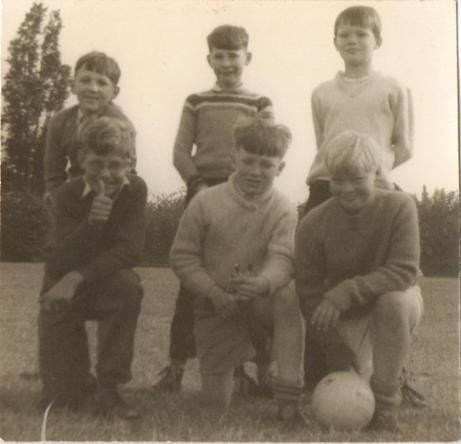
Antony lived at the far end of Cold Blow that backs onto the fields that lead to the Dell. He had very amiable parents and a large black dog, named Bruce. His father drove a Hillman Huskey and took Tony and myself one day to Stanford Bridge to watch Chelsea play. In the days of Peter Bonettii ( the cat ) and Peter Osgood etc.
Tony's sister Anne took us to see West Side Story in London when the film first came out. Probably Leicester Square Odeon or The Pavilion.
We grew up amidst the Shadows and then Beatles and then.......The Rolling Stones. We wore our hair as long as possible without getting letters home from Dartford West. Tab collar shirts and collar less jackets ( Beatle jackets ).
I remember Tony at Dartford West very well as we would very often sit next to each other on the bus and in class. He was not very artistic and I was less academically. So we had this mutual agreement, I would help him in the art lessons and he would me during those boring Maths sessions.
Cross Country Runs at Dartford West were fun but a hard seven miles. All over Dartford Heath and through the Sandpits in Shepherds Lane.
A quick ciggy benind the Boys Brigade Hut in Heath Lane and down to the Salutation and home.
The masters would check that you wore no underpants before you left and no shirt so that you wouldn't stop in the SNOW !!!
Well, that's what they said but we had our suspicions !!!
After school it was back to evening local paper rounds on a Thursday or a game of football or cricket depending on that dread - homework.
When I left Dartford West, Tony was made up to a prefect he told me and played football for the Kent senior team.
He was a good mate of ours and we had such good fun staying out as late as possible, camping on the heath or at the Pavilion in Baldwyns park.
He was very fast as a winger and a tough tackle could be used to great effect.
As far as the drumming went, I don't seem to remember it going much further than a snare drum, and that belonged to the Covenanters !!!
Richard Wight
Memories of Charlotte Eliza Grimshaw and Reginald Grimshaw
Charlotte Eliza Grimshaw, nee Hutton
by Celia Webber (Grandaughter of Charlotte)
22/5/12
Charlotte or Lottie was a grandmother to me who, sadly, I never knew. She died when my mother was only 17, leaving an invalid husband and second daughter aged 10. I would be proud to say that I have inherited just a few of her exceptional talents passed down from her ancestors, the Huttons who were at the very heart of their Moravian community in Fulneck.
Lottie was born in 1881, the youngest of eleven children. Her father Daniel was a key member of the Moravian community in Fulneck and her mother was, reputedly, a force to contend with.
Lottie followed a number of her sisters into school teaching, training at Ripon College. She married Reginald Carleton Grimshaw in 1909 and the following year my mother was born. Reg was a fitter at the local iron works and would have lived close to Fulneck. I don’t know how they met but, apparently, a union between them was against the wishes of Lottie’s mother. They married in Fulneck but moved to Oldham shortly afterwards. Reg had suffered from asthma all his life and the polluted factory air of Oldham didn’t suit him. Within a few years of moving there, and after my mother was born, they moved south to Bexley in Kent.
Initially they lived above the shops in the Maypole estate before moving to a rented house in Baldwyns Road. Their second daughter, Kathleen Mary, was born in 1917. Reg’s work involved climbing long ladders and, sadly, he had a fall that weakened his system even more and made it impossible for him to continue to work. Lottie took over the role of breadwinner and, contrary to the accepted role of women at the time, worked full-time as a school teacher.
With her involvement in the local community, she realised its short-comings. On this fairly new estate there was no church or meeting place. Lottie arranged for Sunday meetings to be held in one of the flats above the local shops but, in time, they became so popular that people were standing on the stairs to try and join in. She approached the local land owner, Mr Cameron of Broomhills, to see if he would allow meetings to be held on his land. Once she had persuaded him, he funded a temporary hut and, in time, and in memory of his son killed in WW1, rallied enough support to get the Church of St Barnabas built on his land. Charlotte always gave to her community. She organised plays, entertainment, after school clubs, clinics and everything else that would serve the community. Even today, 90 years after her premature death, she is remembered on Maypole Estate website as someone who gave her all to the community.
Charlotte, then Headmistress of the infants school infants school in Bourne Road, Bexley, died in 1928, aged 47, from a stroke.
Her gravestone is shared with her husband Reg’s, who lived until 1943. The community made a collection to commemorate them and the family were able to purchase a processional cross for them both which is still in use today.
Memories of Dorothy Grimshaw and Sidney Riches
Dorothy Grimshaw and Sidney James Riches
My wonderful parents ..... by Celia Webber
22/5/12
Growing up, we were told of their romantic meeting. As it is now a long time since they both died, I would like to record what I remember being told.
My father, born in 1903, had lived a rather solitary life. He was the only child of strict parents with his mother being particularly ambitious for him. In his early teens, he had showed a talent for music and had been trained as a concert pianist which meant many hours of practice and little association with the lads out in the street. This had left him sadly lacking in the confidence and skills to communicate easily.
After a few attempts at some rather varied lines of work, he made a career for himself by playing on the Atlantic liners going to and from England to New York. He would work hard during the voyage, dismiss himself when he reached the States and then go on tour until the money ran out. This became his life for many years.
In the meantime my mother (born 1910) had trained as a teacher. She had excelled in music and was a good pianist in her own right. To earn extra cash to support her widowed father (who was an invalid) and young sister, she took on a part-time evening job in the Devonia Cafe, entertaining the customers with her piano playing (£1 a week for 3½ hours a night). My father must have been staying in the area and had been told of this young, glamorous pianist and stopped by at the cafe to find out more. He must have overcome his shyness and his brusque manner because they began to get to know one another. My mother was very popular with the local lads and was stringing along a few of them and so she added Dad to the list.
A while after their relationship had started my mother became seriously ill. The house she lived in was 3-storeys high and she had one of the attic rooms. It was unheated and, in wintertime, bitterly cold. When he heard that she was ill, my father bought her a state-of-the-art electric fire. This kindness was the key to her decision to accept his proposal of marriage over and above the others she had received.
My mother brought out the best in Dad. They married in 1934 and, until mother’s death in 1971, lived a happy life together with music playing an important part, albeit rather confusing for us youngsters. Mum would play the soppy, romantic stuff (getting completely carried away) and Dad would play the heavy classical dirges and death marches to accompany himself singing (which was not quite so sympathetically received by my sister and I being, to our young ears, too loud and rather monotonous). With all this piano playing, we were overwhelmed. So much so, that we both refused to learn this skill .... which I now deeply regret.
Happy times!
Memories of Vince Cross
Memories of Mrs Mary Relf - nee West - teacher at Maypole School 1960-1962
I taught at the Maypole School from January 1960 to December 1962 for two very happy years, both in my personal life and in my career. We were a happy staff, nearly all under 30 years of age, led by Mrs Hilda Chambers, an able and modern head for that time.
The school was bursting at the seems and so I spent one year in “The hut”, a structure at the end of Heath End Road. The building is still there but in a much altered state. Then it consisted of one long room with a tiny kitchen at the rear, accessed by teo or three steps. This area also housed an ancient toilet used by staff and children. The entire building was in a poor state of repair and I arrived back after Easter break to find a gaping hole in the roof and debris all around my desk and the only cupboard covered in plaster and dust. All the exercise books inside were in a dreadful state so for a few days we were forced to use cloakrooms in the main school as classrooms, moving into any vacant rooms when those children were doing P.E. in the playground. We were just relieved that the event happened when the children were on holiday.
There was no playground so break times were spent alongside the hut on a strip of rough ground, the only toilet being round the back. I made a pot of tea each afternoon playtime (before the days of tea bags) and the children took it in turns to empty the tea pot on the ground outside. At home time one day a particularly precise little girl went to put on her hat and ended up with the tea leaves in her hair. The monitor had emptied the pot in her hat !
Memories of Sandra Webb re the Hogans of Baldwyns Road
ome of you may just may remember the Hogans..
Bill Hogan was born in Crayford in1906 (my granddad), a few years later he moved in to no 30 , his dad died in approx. 1920, granddad had an older brother Thomas born 1904 he died in 1919 of TB.
Kathleen was born in 1908 she attended the Maypole school and in 1919 also recorded as died of TB.
Horace ( Jim) was born in 1911, he married a Scottish lady and they had 2 boys, he died in Scotland in 1946. (throat infection)
Ernest was born in 1913, he was in the army when he died in 1940 (also with a throat infection) not married.
Christine was the last child to be born in1917 but alas died in 1920 of TB.
Grandads mum died about 1928 of TB also. Grandad had married my nan Grace, they had Cyril 1927 , Daphne (mum)1928 June 1929 and Michael, all are still with us.
Mum has lots of memorys as does aunt June . The dell sledging, Edgwothy the police man. Mr Curdling .aunt nan next door, the Colegates, the Hut, Barretts and of course Charlie Lawrence, he was a good friend of granddads, they both loved motor bikes!!!!
Grandad was at first with the home guards, he was put on the big gun Betha he called it) on the heath and shot down a plane ( well that's what he told us ) ? he was as Charlie conscripted and went to the desert where he became a staff sargent and was mechanic on the lorrys, there. mum went into the land army and june the wrafs.Cyril went into the army all at the end of the war. I also have some very happy memorys too of the maypole, going down the hut, playing around the air raid shelter in the back garden the outside toilet(no bathroom then) the shop up the top of the road, and the starlings used to make so much noise in the evenings, and so much more ........
From the Maypolehostory team . . . . .
Records on the School Register show the following:-
Katherine HOGAN entered Maypole School on 2/6/1913. Father shown as Thomas. A record dated 6/4/1914 shows deceased.
Horace Arthur HOGAN entered Maypole School on 4/5/1914. Father shown as Thomas. Left the school on 9/4/1925 through age.
Willie HOGAN entered Maypole School on 7/9/1914. Father shown as Thomas. Left the school on 29/7/1920 through age.
Ernest HOGAN entered Maypole School on 7/5/1917. Father shown as Thomas. Left the school on 20/12/1917 withdrawn for time.
Cyril HOGAN entered Maypole School on 7/9/1931. Father shown as William Edward. Left the school 29/7/1938 to go to West Central.
Daphne HOGAN entered Maypole School on 13/6/1932. Father shown as William Edward. Left the school on 4/8/1939 to go to West Central.
June HOGAN entered Maypole School on 18/9/1933. Father shown as William. Left the school on 2/8/1940 to go to Dartford West central for girls.
Michael HOGAN entered Maypole School on 15/9/1941. Father shown as William Edward. Left the school on 1/8/1947 to Dartford Modren for Boys.
Grace Ethel HOGAN and William Edward HOGAN are shown in the voters register of 1937 and 1958 as living at 30 Baldwyns Road
A Messr J HOGAN (presumably Horace ?) and an F HOGAN are shown in a newspaper cutting of 1914 "MAYPOLE DAY FUN AND FROLIC LET LOOSE" as taking part. This can be found on the page entitled - "The annual procession and sports day."
The below copied from that cutting
25 yards boys, 1, P Ivy; 2, S. Burt; 3, L. Colegate; 4, J. Hogan.
25 yards girls, 1, C. Elliman; 2, N. Thompson; 3, Jessie Taylor; 4, D. Barber.
Three legged race, 1. Cliff. Rose and Clem. Burt;2, F. Hogan and P. Skevington; 3, C. Jibb and Rex Baxter.
The HOGANS were well remembered and mentioned by the late Gordon LENNOX.
A photograph of the Maypole Institute Football team of 1922 shows a Mr HOGAN in the line up. This photo can be found on the page entitled "Maypole Institute (Hut!)"
Memories of the King family who once lived for 80 years in Beaconsfield Road - currently the file is missing and attempts are being made to recover it.
Further memories - currently under construction (19/4/2020) so of no use at the present.
Memories of old Maypolians
The construction / migration from an original site http://maypolehistory.wikifoundry.com was nearly complete. That site has now been decommissioned by the providers. The next stage is to now reconstitute information lost on that site to this site. Links to information on that site have now been disabled, as it no longer exists.
21.6.2021
This page will have to be re-created and added to as and when . . . . .
The below were the first.
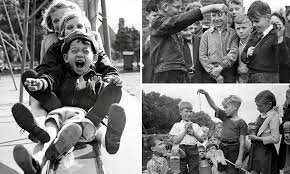
"This was the time of our lives" We felt special - we were from The Maypole !
More memories of Audrey Jackson
More memories of Sheila Houlton
Memories of Perran Newman (Further additions last updated 07/03/2011)
Wheels - by Perran Newman Memories of Frankie Gemmell
Information from Janet Lee (Teacher at Maypole School)
Sheila Houlton - the Tea Stall on the heath
Memories of Tony Helyar - Baldwyns Pavillion updated 21/6/08
Memories of Barbara Thomas (Now Joss)
Memories of the late Alfred Peters - long but interesting
Memories of Ed Wainer and Heathwood and a strange tower in Churchfield Woods
Memories of Janet Cushion (nee Winter)
Memories of Susan Smith (Now Draper)
Memories about Antony Wilkinson R.I.P.
Memories of Dorothy Grimshaw and Sidney James RICHES
Memories of Charlotte Grimshaw nee Hutton
More memories of Sheila HOULTON
Memories of Mary Relf nee West - teacher at Maypole School 1960-1962
Memories of Bill Young - Joydens Wood, the early years
Memories of the King family of 6 Beaconsfield Road spanned 80 years
Memories of the late Alfred Peters (Firemans son Bexley Hospital)
E Mail we have sent to a contributor . . . . .
Fantastic to have your E Mail. Thank you for your kind comments about our efforts on the internet. It will grow. You are opening up exactly what we want to know about. These are the most precious facts and anecdotes which go to make up our ever evolving history of the Maypole.
A few years ago one of our team was lucky enough to meet a man called Alfred Peters who was the firemans son who lived in West Lodge, Bexley Hospital. He has sadly now passed away. He was very kind and wrote a 'book' for him about his childhood years and he mentioned the places he played and the friends he once had. He mentioned the 'Aeroplane' - which he described as a row of trees in the Dell. He mentioned 'Slippery Jack' - a tree they once found great difficulty in climbing opposite Denton Terrace. He also mentioned the 'Action Tree' - not sure where that was. He went on to describe his days at Maypole School and the jobs he had as errand boy for Mr Vine and working for DENNIS the Butchers in Bexley. He described the petrol pumps in the rear garden of the Post Office which he used to operate to serve petrol to passing cars. Although too brief (aren't they always) his memoirs give life to the names of families who once lived on the estate. He went on to mention names of those in his gang including Eno SMITH and enlightened him to some of the nick names they had bestowed on them. Eno was known as Spadge Barrett, Glarni HOGAN, Diddy HENN, Gump HENN, Fatty MEACHAM - Bunty MEACHAM, Bogey ELLIMAN, Bessie WOOD, Massa PETERS, Nanny ELLIMAN, Skinner BEDWELL, Smut SMITH, Tongy THOMPSON, Tiptoe FORD, Monkey CHAFF, Taffy WELLSPRING and many more. None of these names were meant or intended to cause offence - and we hope they don't !
He went on to describe the tradesmen and the shops including the Boot Repairers and the Coop - just like you have mentioned.
His story is just one of the records we have about how life once was on the estate. Told through the eyes of a child his stories gave a highly perceptive feel about everyday life back in the 30s and 40s. We hope one day they will be shared by others when we finally produce a readable book / document. As we have stated we will always go to the enth degree to never make public anything which would cause offence. Luckily all our contributors have been helpful, kind and dignified. We may possibly mention little games they once played and some goings on designed to annoy the grown ups ! One of these described by Alfred was his little gang playing a rather dreadful game of 'knock down ginger' with a twist ! All that happened 60 years ago and can only now be seen as true school boy antics. No crimes - just wholly inappropriate pre adolescent fun !
We also have memories of persons from that era including those of David CRUICKSHANK, Phillip RUMBELOW, George STOCKFORD Jnr, Wendy SAUNDERS, Miss SKEVINGTON, Gordon LENNOX, Ruth ENTWHISTLE and many others. God bless them all.
We are keenly interested in the obscure - including any information in particular on the black boy who lived next to the Post Office called Charlie LAWRENCE. I have a photo of him taken in the back garden of George STOCKFORD. He went on to serve in the last war and met an untimely death in a POW camp in Poland.
We have so much information that it is difficult to express most of it in writing. Only so many pieces of information mean so much to so few at a time. A few years either side of a particular childhood and they mean little / nothing to the next generation or the one before. For instance one of our team grew up in the 50s and 60s and his memories are confined to that era. He remembers Sports Days in Broomhills, the Bonfire being llit by Buster, being chased by George STOCKFORD from the gardens of Maypole House, going down an old air raid shelter at the back of the institute hut in the grounds of Broomhills and making it their HQ for the summer of 1967. Being caught in the old farm at Bexley Hospital and exploring the old derelict house called Heathwood and being chased off by Mr WHITEHEAD who lived in the cottage next door. Some of us, too, have been chased from the old gun club as well ! Catching lizards on hot, lazy summer days on the heath and making camps in the bracken and fern which were so abundant in those days.
Once again - thank you for taking the time to write and impart with what you have written already.
Look forward to hearing from you again.
Kindest regards to you and your family.
Memories of those from bygone times
Currently attempting to reconstruct from original site which has just been decommissioned by the owners.
Memories of Kim Button
Memories of Susan Kirby
Memories of Audrey Jackson
More memories of Audrey Jackson
Memories of Tony Helyar
Memories of Ann Martin
Memories of Pat Richardson
Memories of Sheila Houlton
More memories of Sheila Houlton
Memories of Perran Newman
Memories of Barbara Houlton
Wheels - Perran Newman
Memories of Frankie Gemmell
Information from Janet Lee
Memories of Bernard Lodge
Memories of Stuart Grieve
The Tea Stall on the heath - Sheila Houlton
Memories of Steven Parker (Member name 'Masey')
David Bainbridge
Peter Walker
Memories of Tony Helyar - Baldwyns Park Pavillion
Memories of Barbara Thomas (Now Joss)
Memories of Margaret Cadman
Memories of Michael Jennings
Memories of the late Alfred Peters
Memories of Barbara Ireland
Memories of Derek LOTT
Memories of John BURTON
Memories of Edmund Wainer and Heathwood
Memories of Ronnie Potter
Memories of Lee Smith
Memories of Robin Healey
Memories of Richard Wight
Memories of Barbara Rivers
Memories of Ron Evans
Memories of Jerry Wilkins
Memories of Janet Cushion (nee Winter)
Memories of Nicholas Milsum
Memories of Susan SMITH (Now DRAPER)
Memories of 'Smudger Smith'
Memories about Antony Wilkinson R.I.P
Memories of Charlotte Eliza Grimshaw and Reginald Grimshaw
Memories of Dorothy Grimshaw and Sidney Riches
Memories of Vince Cross
More memories of Sheila Houlton 50 Baldwyns Road
Memories of Mrs Mary Relf - nee West - teacher at Maypole School 1960-1962Memories of Sandra Webb re the Hogans of Baldwyns Road
Memories of the King family who once lived for 80 years in Beaconsfield Road
Memories of the late Alfred Peters (Firemans son Bexley Hospital)
Further memories - currently under construction (19/4/2020) so of no use at the present.
